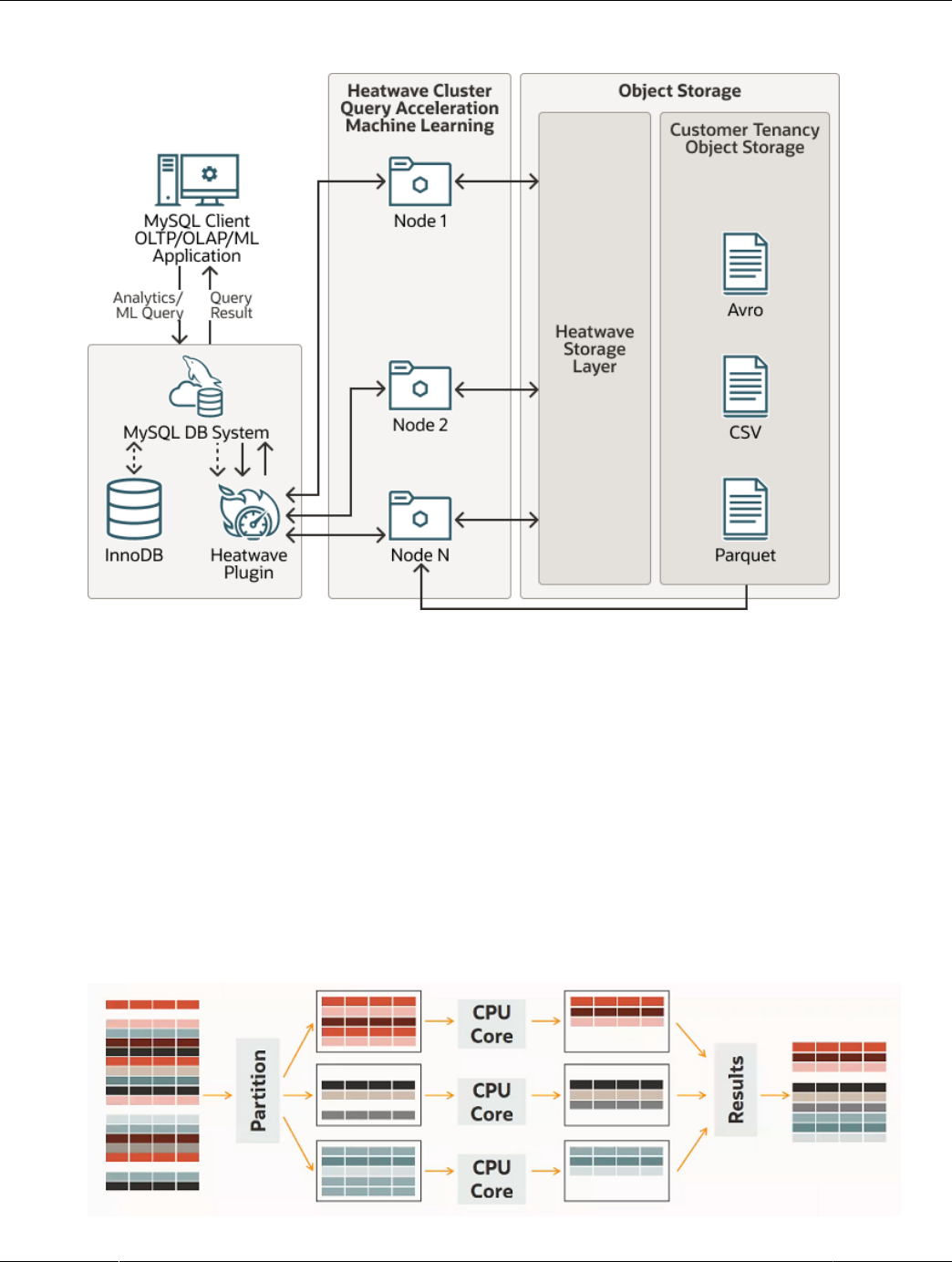HeatWave User Guide

Abstract
This document describes how to use HeatWave. It covers how to load data, run queries, optimize analytics workloads,
and use HeatWave machine learning capabilities.
For information about creating and managing a HeatWave Cluster on Oracle Cloud Infrastructure (OCI), see
HeatWave on OCI Service Guide.
For information about creating and managing a HeatWave Cluster on Amazon Web Services (AWS), see HeatWave
on AWS Service Guide.
For information about creating and managing a HeatWave Cluster on Oracle Database Service for Azure (ODSA),
see HeatWave for Azure Service Guide.
For MySQL Server documentation, refer to the MySQL Reference Manual.
For information about the latest HeatWave features and updates, refer to the HeatWave Release Notes.
For legal information, see the Legal Notices.
For help with using MySQL, please visit the MySQL Forums, where you can discuss your issues with other MySQL
users.
Document generated on: 2024-09-02 (revision: 79499)

Table of Contents
Preface and Legal Notices ................................................................................................................. ix
1 Overview ......................................................................................................................................... 1
1.1 HeatWave Architectural Features .......................................................................................... 1
1.2 HeatWave MySQL ................................................................................................................ 3
1.3 HeatWave AutoML ............................................................................................................... 3
1.4 HeatWave GenAI ................................................................................................................. 4
1.5 HeatWave Lakehouse ........................................................................................................... 4
1.6 HeatWave Autopilot .............................................................................................................. 4
1.7 MySQL Functionality for HeatWave ....................................................................................... 7
2 HeatWave MySQL .......................................................................................................................... 9
2.1 Before You Begin ............................................................................................................... 11
2.2 Loading Data to HeatWave MySQL ..................................................................................... 11
2.2.1 Prerequisites ............................................................................................................ 12
2.2.2 Loading Data Manually ............................................................................................ 13
2.2.3 Loading Data Using Auto Parallel Load ..................................................................... 15
2.2.4 Monitoring Load Progress ........................................................................................ 24
2.2.5 Checking Load Status .............................................................................................. 24
2.2.6 Data Compression ................................................................................................... 25
2.2.7 Change Propagation ................................................................................................ 25
2.2.8 Reload Tables ......................................................................................................... 26
2.3 Running Queries ................................................................................................................ 27
2.3.1 Query Prerequisites ................................................................................................. 27
2.3.2 Running Queries ...................................................................................................... 28
2.3.3 Auto Scheduling ...................................................................................................... 29
2.3.4 Auto Query Plan Improvement ................................................................................. 30
2.3.5 Dynamic Query Offload ............................................................................................ 30
2.3.6 Debugging Queries .................................................................................................. 30
2.3.7 Query Runtimes and Estimates ................................................................................ 32
2.3.8 CREATE TABLE ... SELECT Statements .................................................................. 33
2.3.9 INSERT ... SELECT Statements ............................................................................... 33
2.3.10 Using Views ........................................................................................................... 33
2.4 Modifying Tables ................................................................................................................ 34
2.5 Unloading Data from HeatWave MySQL .............................................................................. 35
2.5.1 Unloading Tables ..................................................................................................... 35
2.5.2 Unloading Partitions ................................................................................................. 36
2.5.3 Unloading Data Using Auto Unload .......................................................................... 36
2.5.4 Unload All Tables .................................................................................................... 40
2.6 Table Load and Query Example .......................................................................................... 41
2.7 Workload Optimization for OLAP ......................................................................................... 43
2.7.1 Encoding String Columns ......................................................................................... 43
2.7.2 Defining Data Placement Keys ................................................................................. 45
2.7.3 HeatWave Autopilot Advisor Syntax .......................................................................... 46
2.7.4 Auto Encoding ......................................................................................................... 48
2.7.5 Auto Data Placement ............................................................................................... 51
2.7.6 Auto Query Time Estimation ..................................................................................... 55
2.7.7 Unload Advisor ........................................................................................................ 58
2.7.8 Advisor Command-line Help ..................................................................................... 58
2.7.9 Autopilot Report Table ............................................................................................. 59
2.7.10 Advisor Report Table ............................................................................................. 60
2.8 Workload Optimization for OLTP ......................................................................................... 61
2.8.1 Autopilot Indexing .................................................................................................... 61
iii

HeatWave User Guide
2.9 Best Practices .................................................................................................................... 64
2.9.1 Preparing Data ........................................................................................................ 64
2.9.2 Provisioning ............................................................................................................. 65
2.9.3 Importing Data into the MySQL DB System ............................................................... 66
2.9.4 Inbound Replication ................................................................................................. 66
2.9.5 Loading Data ........................................................................................................... 66
2.9.6 Auto Encoding and Auto Data Placement ................................................................. 68
2.9.7 Running Queries ...................................................................................................... 68
2.9.8 Monitoring ................................................................................................................ 73
2.9.9 Reloading Data ........................................................................................................ 73
2.10 Supported Data Types ...................................................................................................... 74
2.11 Supported SQL Modes ..................................................................................................... 75
2.12 Supported Functions and Operators .................................................................................. 75
2.12.1 Aggregate Functions .............................................................................................. 75
2.12.2 Arithmetic Operators .............................................................................................. 78
2.12.3 Cast Functions and Operators ................................................................................ 79
2.12.4 Comparison Functions and Operators ..................................................................... 79
2.12.5 Control Flow Functions and Operators .................................................................... 80
2.12.6 Data Masking and De-Identification Functions ......................................................... 80
2.12.7 Encryption and Compression Functions ................................................................... 81
2.12.8 JSON Functions ..................................................................................................... 81
2.12.9 Logical Operators ................................................................................................... 82
2.12.10 Mathematical Functions ........................................................................................ 83
2.12.11 String Functions and Operators ............................................................................ 84
2.12.12 Temporal Functions .............................................................................................. 86
2.12.13 Window Functions ................................................................................................ 89
2.13 SELECT Statement ........................................................................................................... 89
2.14 String Column Encoding Reference ................................................................................... 92
2.14.1 Variable-length Encoding ........................................................................................ 92
2.14.2 Dictionary Encoding ............................................................................................... 93
2.14.3 Column Limits ........................................................................................................ 94
2.15 Troubleshooting ................................................................................................................ 94
2.16 Metadata Queries ............................................................................................................. 97
2.16.1 Secondary Engine Definitions ................................................................................. 97
2.16.2 Excluded Columns ................................................................................................. 98
2.16.3 String Column Encoding ......................................................................................... 98
2.16.4 Data Placement ..................................................................................................... 99
2.17 Bulk Ingest Data to MySQL Server .................................................................................. 100
2.18 HeatWave MySQL Limitations ......................................................................................... 102
2.18.1 Change Propagation Limitations ............................................................................ 102
2.18.2 Data Type Limitations ........................................................................................... 102
2.18.3 Functions and Operator Limitations ....................................................................... 103
2.18.4 Index Hint and Optimizer Hint Limitations .............................................................. 105
2.18.5 Join Limitations .................................................................................................... 105
2.18.6 Partition Selection Limitations ............................................................................... 106
2.18.7 Variable Limitations .............................................................................................. 106
2.18.8 Bulk Ingest Data to MySQL Server Limitations ....................................................... 107
2.18.9 Other Limitations .................................................................................................. 108
3 HeatWave AutoML ...................................................................................................................... 111
3.1 HeatWave AutoML Features ............................................................................................. 112
3.1.1 HeatWave AutoML Supervised Learning ................................................................. 112
3.1.2 HeatWave AutoML Ease of Use ............................................................................. 112
3.1.3 HeatWave AutoML Workflow .................................................................................. 113
3.1.4 Oracle AutoML ....................................................................................................... 114
iv

HeatWave User Guide
3.2 Before You Begin ............................................................................................................. 114
3.3 Getting Started ................................................................................................................. 115
3.4 Preparing Data ................................................................................................................. 115
3.4.1 Labeled Data ......................................................................................................... 115
3.4.2 Unlabeled Data ...................................................................................................... 116
3.4.3 General Data Requirements ................................................................................... 117
3.4.4 Example Data ........................................................................................................ 117
3.4.5 Example Text Data ................................................................................................ 119
3.5 Training a Model .............................................................................................................. 119
3.5.1 Advanced ML_TRAIN Options ................................................................................ 120
3.6 Training Explainers ........................................................................................................... 121
3.7 Predictions ....................................................................................................................... 123
3.7.1 Row Predictions ..................................................................................................... 123
3.7.2 Table Predictions ................................................................................................... 124
3.8 Explanations ..................................................................................................................... 124
3.8.1 Row Explanations .................................................................................................. 125
3.8.2 Table Explanations ................................................................................................. 126
3.9 Forecasting ....................................................................................................................... 127
3.9.1 Training a Forecasting Model ................................................................................. 127
3.9.2 Using a Forecasting Model ..................................................................................... 128
3.10 Anomaly Detection .......................................................................................................... 130
3.10.1 Training an Anomaly Detection Model ................................................................... 131
3.10.2 Using an Anomaly Detection Model ...................................................................... 132
3.11 Recommendations .......................................................................................................... 134
3.11.1 Training a Recommendation Model ....................................................................... 135
3.11.2 Using a Recommendation Model .......................................................................... 137
3.12 HeatWave AutoML and Lakehouse .................................................................................. 148
3.13 Managing Models ............................................................................................................ 151
3.13.1 The Model Catalog ............................................................................................... 151
3.13.2 ONNX Model Import ............................................................................................. 156
3.13.3 Loading Models .................................................................................................... 162
3.13.4 Unloading Models ................................................................................................ 163
3.13.5 Viewing Models .................................................................................................... 163
3.13.6 Scoring Models .................................................................................................... 164
3.13.7 Model Explanations .............................................................................................. 165
3.13.8 Model Handles ..................................................................................................... 165
3.13.9 Deleting Models ................................................................................................... 166
3.13.10 Sharing Models .................................................................................................. 166
3.14 Progress tracking ............................................................................................................ 167
3.15 HeatWave AutoML Routines ............................................................................................ 172
3.15.1 ML_TRAIN ........................................................................................................... 172
3.15.2 ML_EXPLAIN ....................................................................................................... 178
3.15.3 ML_MODEL_IMPORT .......................................................................................... 180
3.15.4 ML_PREDICT_ROW ............................................................................................ 181
3.15.5 ML_PREDICT_TABLE .......................................................................................... 185
3.15.6 ML_EXPLAIN_ROW ............................................................................................. 189
3.15.7 ML_EXPLAIN_TABLE .......................................................................................... 191
3.15.8 ML_SCORE ......................................................................................................... 193
3.15.9 ML_MODEL_LOAD .............................................................................................. 195
3.15.10 ML_MODEL_UNLOAD ........................................................................................ 196
3.15.11 Model Types ...................................................................................................... 196
3.15.12 Optimization and Scoring Metrics ........................................................................ 198
3.16 Supported Data Types .................................................................................................... 202
3.17 HeatWave AutoML Error Messages ................................................................................. 203
v

HeatWave User Guide
3.18 HeatWave AutoML Limitations ......................................................................................... 225
4 HeatWave GenAI ........................................................................................................................ 227
4.1 Overview .......................................................................................................................... 227
4.2 Getting Started with HeatWave GenAI ............................................................................... 228
4.2.1 Requirements ........................................................................................................ 228
4.2.2 Quickstart: Setting Up a Help Chat ......................................................................... 229
4.3 Generating Text-Based Content ........................................................................................ 232
4.3.1 Generating New Content ........................................................................................ 232
4.3.2 Summarizing Content ............................................................................................. 233
4.4 Performing a Vector Search .............................................................................................. 234
4.4.1 HeatWave Vector Store Overview ........................................................................... 234
4.4.2 Setting Up a Vector Store ...................................................................................... 234
4.4.3 Updating the Vector Store ...................................................................................... 237
4.4.4 Running Retrieval-Augmented Generation ............................................................... 238
4.5 Running HeatWave Chat ................................................................................................... 241
4.5.1 Running HeatWave GenAI Chat ............................................................................. 241
4.5.2 Viewing Chat Session Details ................................................................................. 242
4.6 HeatWave GenAI Routines ............................................................................................... 243
4.6.1 ML_GENERATE .................................................................................................... 244
4.6.2 VECTOR_STORE_LOAD ....................................................................................... 246
4.6.3 ML_RAG ................................................................................................................ 247
4.6.4 HEATWAVE_CHAT ................................................................................................ 249
4.7 Troubleshooting Issues and Errors .................................................................................... 251
5 HeatWave Lakehouse .................................................................................................................. 255
5.1 Overview .......................................................................................................................... 255
5.1.1 External Tables ...................................................................................................... 256
5.1.2 Lakehouse Engine ................................................................................................. 256
5.1.3 Data Storage ......................................................................................................... 256
5.2 Loading Structured Data to HeatWave Lakehouse .............................................................. 256
5.2.1 Prerequisites .......................................................................................................... 256
5.2.2 Lakehouse External Table Syntax ........................................................................... 257
5.2.3 Loading Data Manually ........................................................................................... 262
5.2.4 Loading Data Using Auto Parallel Load ................................................................... 263
5.2.5 How to Load Data from External Storage Using Auto Parallel Load ........................... 266
5.2.6 Lakehouse Incremental Load .................................................................................. 271
5.3 Loading Unstructured Data to HeatWave Lakehouse .......................................................... 272
5.4 Access Object Storage ..................................................................................................... 272
5.4.1 Pre-Authenticated Requests ................................................................................... 272
5.4.2 Resource Principals ............................................................................................... 273
5.5 External Table Recovery ................................................................................................... 274
5.6 Data Types ....................................................................................................................... 274
5.6.1 Parquet Data Type Conversions ............................................................................. 274
5.7 HeatWave Lakehouse Limitations ...................................................................................... 277
5.7.1 Lakehouse Limitations for all File Formats ............................................................... 277
5.7.2 Lakehouse Limitations for the Avro Format Files ...................................................... 280
5.7.3 Lakehouse Limitations for the CSV File Format ....................................................... 281
5.7.4 Lakehouse Limitations for the JSON File Format ..................................................... 281
5.7.5 Lakehouse Limitations for the Parquet File Format .................................................. 281
5.8 HeatWave Lakehouse Error Messages .............................................................................. 281
6 System and Status Variables ....................................................................................................... 287
6.1 System Variables .............................................................................................................. 287
6.2 Status Variables ............................................................................................................... 291
7 HeatWave Performance and Monitoring ........................................................................................ 295
7.1 HeatWave MySQL Monitoring ........................................................................................... 295
vi

HeatWave User Guide
7.1.1 HeatWave Node Status Monitoring ......................................................................... 295
7.1.2 HeatWave Memory Usage Monitoring ..................................................................... 296
7.1.3 Data Load Progress and Status Monitoring ............................................................. 296
7.1.4 Change Propagation Monitoring .............................................................................. 297
7.1.5 Query Execution Monitoring .................................................................................... 298
7.1.6 Query History and Statistics Monitoring ................................................................... 299
7.1.7 Scanned Data Monitoring ....................................................................................... 300
7.2 HeatWave AutoML Monitoring ........................................................................................... 301
7.3 HeatWave Performance Schema Tables ............................................................................ 302
7.3.1 The rpd_column_id Table ....................................................................................... 302
7.3.2 The rpd_columns Table .......................................................................................... 303
7.3.3 The rpd_exec_stats Table ...................................................................................... 303
7.3.4 The rpd_nodes Table ............................................................................................. 304
7.3.5 The rpd_preload_stats Table .................................................................................. 305
7.3.6 The rpd_query_stats Table ..................................................................................... 306
7.3.7 The rpd_table_id Table .......................................................................................... 307
7.3.8 The rpd_tables Table ............................................................................................. 307
8 HeatWave Quickstarts ................................................................................................................. 311
8.1 HeatWave Quickstart Prerequisites .................................................................................... 311
8.2 tpch Analytics Quickstart ................................................................................................... 311
8.3 AirportDB Analytics Quickstart ........................................................................................... 320
8.4 Iris Data Set Machine Learning Quickstart ......................................................................... 324
vii

viii

Preface and Legal Notices
This is the user manual for HeatWave.
Legal Notices
Copyright © 1997, 2024, Oracle and/or its affiliates.
License Restrictions
This software and related documentation are provided under a license agreement containing restrictions
on use and disclosure and are protected by intellectual property laws. Except as expressly permitted
in your license agreement or allowed by law, you may not use, copy, reproduce, translate, broadcast,
modify, license, transmit, distribute, exhibit, perform, publish, or display any part, in any form, or by any
means. Reverse engineering, disassembly, or decompilation of this software, unless required by law for
interoperability, is prohibited.
Warranty Disclaimer
The information contained herein is subject to change without notice and is not warranted to be error-free.
If you find any errors, please report them to us in writing.
Restricted Rights Notice
If this is software, software documentation, data (as defined in the Federal Acquisition Regulation), or
related documentation that is delivered to the U.S. Government or anyone licensing it on behalf of the U.S.
Government, then the following notice is applicable:
U.S. GOVERNMENT END USERS: Oracle programs (including any operating system, integrated
software, any programs embedded, installed, or activated on delivered hardware, and modifications
of such programs) and Oracle computer documentation or other Oracle data delivered to or accessed
by U.S. Government end users are "commercial computer software," "commercial computer software
documentation," or "limited rights data" pursuant to the applicable Federal Acquisition Regulation and
agency-specific supplemental regulations. As such, the use, reproduction, duplication, release, display,
disclosure, modification, preparation of derivative works, and/or adaptation of i) Oracle programs (including
any operating system, integrated software, any programs embedded, installed, or activated on delivered
hardware, and modifications of such programs), ii) Oracle computer documentation and/or iii) other Oracle
data, is subject to the rights and limitations specified in the license contained in the applicable contract.
The terms governing the U.S. Government's use of Oracle cloud services are defined by the applicable
contract for such services. No other rights are granted to the U.S. Government.
Hazardous Applications Notice
This software or hardware is developed for general use in a variety of information management
applications. It is not developed or intended for use in any inherently dangerous applications, including
applications that may create a risk of personal injury. If you use this software or hardware in dangerous
applications, then you shall be responsible to take all appropriate fail-safe, backup, redundancy, and other
measures to ensure its safe use. Oracle Corporation and its affiliates disclaim any liability for any damages
caused by use of this software or hardware in dangerous applications.
Trademark Notice
Oracle, Java, MySQL, and NetSuite are registered trademarks of Oracle and/or its affiliates. Other names
may be trademarks of their respective owners.
ix

Documentation Accessibility
Intel and Intel Inside are trademarks or registered trademarks of Intel Corporation. All SPARC trademarks
are used under license and are trademarks or registered trademarks of SPARC International, Inc. AMD,
Epyc, and the AMD logo are trademarks or registered trademarks of Advanced Micro Devices. UNIX is a
registered trademark of The Open Group.
Third-Party Content, Products, and Services Disclaimer
This software or hardware and documentation may provide access to or information about content,
products, and services from third parties. Oracle Corporation and its affiliates are not responsible for and
expressly disclaim all warranties of any kind with respect to third-party content, products, and services
unless otherwise set forth in an applicable agreement between you and Oracle. Oracle Corporation and its
affiliates will not be responsible for any loss, costs, or damages incurred due to your access to or use of
third-party content, products, or services, except as set forth in an applicable agreement between you and
Oracle.
Use of This Documentation
This documentation is NOT distributed under a GPL license. Use of this documentation is subject to the
following terms:
You may create a printed copy of this documentation solely for your own personal use. Conversion to other
formats is allowed as long as the actual content is not altered or edited in any way. You shall not publish
or distribute this documentation in any form or on any media, except if you distribute the documentation in
a manner similar to how Oracle disseminates it (that is, electronically for download on a Web site with the
software) or on a CD-ROM or similar medium, provided however that the documentation is disseminated
together with the software on the same medium. Any other use, such as any dissemination of printed
copies or use of this documentation, in whole or in part, in another publication, requires the prior written
consent from an authorized representative of Oracle. Oracle and/or its affiliates reserve any and all rights
to this documentation not expressly granted above.
Documentation Accessibility
For information about Oracle's commitment to accessibility, visit the Oracle Accessibility Program website
at
http://www.oracle.com/pls/topic/lookup?ctx=acc&id=docacc.
Access to Oracle Support for Accessibility
Oracle customers that have purchased support have access to electronic support through My Oracle
Support. For information, visit
http://www.oracle.com/pls/topic/lookup?ctx=acc&id=info or visit http://www.oracle.com/pls/topic/
lookup?ctx=acc&id=trs if you are hearing impaired.
x

Chapter 1 Overview
Table of Contents
1.1 HeatWave Architectural Features .................................................................................................. 1
1.2 HeatWave MySQL ........................................................................................................................ 3
1.3 HeatWave AutoML ....................................................................................................................... 3
1.4 HeatWave GenAI ......................................................................................................................... 4
1.5 HeatWave Lakehouse ................................................................................................................... 4
1.6 HeatWave Autopilot ...................................................................................................................... 4
1.7 MySQL Functionality for HeatWave ............................................................................................... 7
HeatWave is a massively parallel, high performance, in-memory query accelerator that accelerates MySQL
performance by orders of magnitude for analytics workloads, mixed workloads, and machine learning.
HeatWave can be accessed through Oracle Cloud Infrastructure (OCI), Amazon Web Services (AWS), and
Oracle Database Service for Azure (ODSA).
HeatWave consists of a MySQL DB System and HeatWave nodes. Analytics queries that meet certain
prerequisites are automatically offloaded from the MySQL DB System to the HeatWave Cluster for
accelerated processing. With a HeatWave Cluster, you can run online transaction processing (OLTP),
online analytical processing (OLAP), and mixed workloads from the same MySQL database without
requiring extract, transfer, and load (ETL), and without modifying your applications. For more information
about the analytical capabilities of HeatWave, see Chapter 2, HeatWave MySQL.
The MySQL DB System includes a HeatWave plugin that is responsible for cluster management, query
scheduling, and returning query results to the MySQL DB System. The HeatWave nodes store data in
memory and process analytics and machine learning queries. Each HeatWave node hosts an instance of
the HeatWave query processing engine (RAPID).
Enabling a HeatWave Cluster also provides access to HeatWave AutoML, which is a fully managed,
highly scalable, cost-efficient, machine learning solution for data stored in MySQL. HeatWave AutoML
provides a simple SQL interface for training and using predictive machine learning models, which can be
used by novice and experienced ML practitioners alike. Machine learning expertise, specialized tools, and
algorithms are not required. With HeatWave AutoML, you can train a model with a single call to an SQL
routine. Similarly, you can generate predictions with a single CALL or SELECT statement which can be
easily integrated with your applications.
1.1 HeatWave Architectural Features
The HeatWave architecture supports OLTP, OLAP and machine learning.
1

In-Memory Hybrid-Columnar Format
Figure 1.1 HeatWave Architecture
In-Memory Hybrid-Columnar Format
HeatWave stores data in main memory in a hybrid columnar format. The HeatWave hybrid approach
achieves the benefits of columnar format for query processing, while avoiding the materialization and
update costs associated with pure columnar format. Hybrid columnar format enables the use of efficient
query processing algorithms designed to operate on fixed-width data, and permits vectorized query
processing.
Massively Parallel Architecture
The HeatWave massively parallel architecture uses internode and intranode partitioning of data. Each
node within a HeatWave Cluster, and each CPU core within a node, processes the partitioned data in
parallel. HeatWave is capable of scaling to thousands of cores. This massively parallel architecture,
combined with high-fanout, workload-aware partitioning, accelerates query processing.
Figure 1.2 HeatWave Massively Parallel Architecture
2

Push-Based Vectorized Query Processing
Push-Based Vectorized Query Processing
HeatWave processes queries by pushing vector blocks (slices of columnar data) through the query
execution plan from one operator to another. A push-based execution model avoids deep call stacks and
saves valuable resources compared to tuple-based processing models.
Scale-Out Data Management
When analytics data is loaded into HeatWave, the HeatWave Storage Layer automatically persists the
data for pause and resume of the HeatWave Cluster and for fast recovery in case of a HeatWave node or
cluster failure. Data is automatically restored by the HeatWave Storage Layer when the HeatWave Cluster
resumes after a pause or recovers a failed node or cluster. This automated, self-managing storage layer
scales to the size required for your HeatWave Cluster and operates independently in the background.
HeatWave on OCI persists the data to OCI Object Storage. HeatWave on AWS persists the data to AWS
S3.
Native MySQL Integration
Native integration with MySQL provides a single data management platform for OLTP, OLAP, mixed
workloads, and machine learning. HeatWave is designed as a pluggable MySQL storage engine, which
enables management of both the MySQL and HeatWave using the same interfaces.
Changes to analytics data on the MySQL DB System are automatically propagated to HeatWave nodes
in real time, which means that queries always have access to the latest data. Change propagation is
performed automatically by a light-weight algorithm.
Users and applications interact with HeatWave through the MySQL DB System using standard tools and
standard-based ODBC/JDBC connectors. HeatWave supports the same ANSI SQL standard and ACID
properties as MySQL and the most commonly used data types. This support enables existing applications
to use HeatWave without modification, allowing for quick and easy integration.
1.2 HeatWave MySQL
Analytics and machine learning queries are issued from a MySQL client or application that interacts with
the HeatWave Cluster by connecting to the MySQL DB System. Results are returned to the MySQL DB
System and to the MySQL client or application that issued the query.
The number of HeatWave nodes required depends on data size and the amount of compression that is
achieved when loading data into the HeatWave Cluster. A HeatWave Cluster in Oracle Cloud Infrastructure
(OCI) or Oracle Database Service for Azure (ODSA) supports up to 64 nodes. On Amazon Web Services
(AWS), a HeatWave Cluster supports up to 128 nodes.
On Oracle Cloud Infrastructure (OCI), data that is loaded into HeatWave is automatically persisted to OCI
Object Storage, which allows data to be reloaded quickly when the HeatWave Cluster resumes after a
pause or when the HeatWave Cluster recovers from a cluster or node failure.
HeatWave network traffic is fully encrypted.
1.3 HeatWave AutoML
With HeatWave AutoML, data and models never leave HeatWave, saving you time and effort while
keeping your data and models secure. HeatWave AutoML is optimized for HeatWave shapes and scaling,
and all HeatWave AutoML processing is performed on the HeatWave Cluster. HeatWave distributes
ML computation among HeatWave nodes, to take advantage of the scalability and massively parallel
3

HeatWave GenAI
processing capabilities of HeatWave. For more information about the machine learning capabilities of
HeatWave, see Chapter 3, HeatWave AutoML.
1.4 HeatWave GenAI
The HeatWave GenAI feature of HeatWave lets you communicate with unstructured data in HeatWave
using natural language queries. It uses large language models (LLMs) to enable natural language
communication and provides an inbuilt vector store that you can use to store enterprise-specific proprietary
content to perform vector searches. HeatWave GenAI also includes HeatWave Chat which is a chatbot
that extends the generative AI and vector search functionalities to let you ask multiple follow-up questions
about a topic in a single session. HeatWave Chat can even draw its knowledge from documents ingested
by the vector store.
See: Chapter 4, HeatWave GenAI.
1.5 HeatWave Lakehouse
The Lakehouse feature of HeatWave enables query processing on data resident in Object Storage. The
source data is read from Object Storage, transformed to the memory optimized HeatWave format, stored in
the HeatWave persistence storage layer in Object Storage, and then loaded to HeatWave cluster memory.
• Provides in-memory query processing on data resident in Object Storage.
• Data is not loaded into the MySQL InnoDB storage layer.
• Supports structured and semi-structured relational data in the following file formats:
• Avro.
• CSV.
• JSON.
As of MySQL 8.4.0, Lakehouse supports Newline Delimited JSON.
• Parquet.
• With this feature, users can now analyse data in both InnoDB and an object store using familiar SQL
syntax in the same query.
See: Chapter 5, HeatWave Lakehouse. To use Lakehouse with HeatWave AutoML, see: Section 3.12,
“HeatWave AutoML and Lakehouse”.
1.6 HeatWave Autopilot
HeatWave Autopilot automates many of the most important and often challenging aspects of achieving
exceptional query performance at scale, including cluster provisioning, loading data, query processing, and
failure handling. It uses advanced techniques to sample data, collect statistics on data and queries, and
build machine learning models to model memory usage, network load, and execution time. The machine
learning models are used by HeatWave Autopilot to execute its core capabilities. HeatWave Autopilot
makes the HeatWave query optimizer increasingly intelligent as more queries are executed, resulting in
continually improving system performance.
System Setup
• Auto Provisioning
4

Data Load
Estimates the number of HeatWave nodes required by sampling the data, which means that manual
cluster size estimations are not necessary.
• For HeatWave on OCI, see Generating a Node Count Estimate in the HeatWave on OCI Service
Guide.
• For HeatWave on AWS, see Estimating Cluster Size with HeatWave Autopilot in the HeatWave on
AWS Service Guide.
• For HeatWave for Azure, see Provisioning HeatWave Nodes in the HeatWave for Azure Service
Guide.
• Auto Shape Prediction
For HeatWave on AWS, the Auto Shape Prediction feature in HeatWave Autopilot uses MySQL statistics
for the workload to assess the suitability of the current shape. Auto Shape Prediction provides prompts
to upsize the shape and improve system performance, or to downsize the shape if the system is under-
utilized. See: Autopilot Shape Advisor in the HeatWave on AWS Service Guide.
Data Load
• Auto Parallel Load
Optimizes load time and memory usage by predicting the optimal degree of parallelism for each table
loaded into HeatWave. See: Section 2.2.3, “Loading Data Using Auto Parallel Load”.
• Auto Schema Inference
Lakehouse Auto Parallel Load extends Auto Parallel Load with Auto Schema Inference that can analyze
the data, infer the external table structure, and create the database and all tables. It can also use header
information from the external files to define the column names. See: Section 5.2.4.1, “Lakehouse Auto
Parallel Load Schema Inference”.
• Autopilot Indexing
Autopilot Indexing can make secondary index suggestions to improve workload performance. See:
Section 2.8.1, “Autopilot Indexing”
• Auto Encoding
Determines the optimal encoding for string column data, which minimizes the required cluster size and
improves query performance. See: Section 2.7.4, “Auto Encoding”.
• Auto Data Placement
Recommends how tables should be partitioned in memory to achieve the best query performance, and
estimates the expected performance improvement. See: Section 2.7.5, “Auto Data Placement”.
• Auto Data Compression
HeatWave and HeatWave Lakehouse can compress data stored in memory using different compression
algorithms. To minimize memory usage while providing the best query performance, auto compression
dynamically determines the compression algorithm to use for each column based on its data
characteristics. Auto compression employs an adaptive sampling technique during the data loading
process, and automatically selects the optimal compression algorithm without user intervention.
Algorithm selection is based on the compression ratio and the compression and decompression rates,
5

Query Execution
which balance the memory needed to store the data in HeatWave with query execution time. See:
Section 2.2.6, “Data Compression”.
• Unload Advisor
Unload Advisor can recommend tables to unload to reduce HeatWave memory usage. See:
Section 2.7.7, “Unload Advisor”.
• Auto Unload
Auto Unload can automate the process of unloading data from HeatWave. See: Section 2.5.3,
“Unloading Data Using Auto Unload”.
Query Execution
• Auto Query Plan Improvement
Collects previously executed queries and uses them to improve future query execution plans. See:
Section 2.3.4, “Auto Query Plan Improvement”.
• Adaptive Query Execution
Adaptive query optimization automatically improves query performance and memory consumption, and
mitigates skew-related performance issues as well as out of memory errors. It uses various statistics
to adjust data structures and system resources after query execution has started. It independently
optimizes query execution for each HeatWave node based on actual data distribution at runtime. This
helps improve the performance of ad hoc queries by up to 25%. The HeatWave optimizer generates a
physical query plan based on statistics collected by Autopilot. During query execution, each HeatWave
node executes the same query plan. With adaptive query execution, each individual HeatWave
node adjusts the local query plan based on statistics such as cardinality and distinct value counts of
intermediate relations collected locally in real-time. This allows each HeatWave node to tailor the data
structures that it needs, resulting in better query execution time, lower memory usage, and improved
data skew-related performance.
• Auto Query Time Estimation
Estimates query execution time to determine how a query might perform without having to run the query.
See: Section 2.7.6, “Auto Query Time Estimation”.
• Auto Change Propagation
Auto Change Propagation intelligently determines the optimal time when changes to data on the MySQL
DB System should be propagated to the HeatWave Storage Layer. Only available for HeatWave on OCI.
• Auto Scheduling
Prioritizes queries in an intelligent way to reduce overall query execution wait times. See: Section 2.3.3,
“Auto Scheduling”.
• Auto Thread Pooling
Provides sustained throughput during high transaction concurrency. Where multiple clients are
running queries concurrently, Auto Thread Pooling applies workload-aware admission control
to eliminate resource contention caused by too many waiting transactions. Auto Thread Pooling
automatically manages the settings for the thread pool control variables thread_pool_size,
thread_pool_max_transactions_limit, and thread_pool_query_threads_per_group. For
details of how the thread pool works, see Thread Pool Operation.
6

Failure Handling
Failure Handling
• Auto Error Recovery
For HeatWave on OCI, Auto Error Recovery recovers a failed node or provisions a new one and reloads
data from the HeatWave storage layer when a HeatWave node becomes unresponsive due to a software
or hardware failure. See: HeatWave Cluster Failure and Recovery in the HeatWave on OCI Service
Guide.
For HeatWave on AWS, Auto Error Recovery recovers a failed node and reloads data from the MySQL
DB System when a HeatWave node becomes unresponsive due to a software failure.
1.7 MySQL Functionality for HeatWave
The following items provide additional functionality for MySQL that is only available with HeatWave
MySQL:
• Section 2.17, “Bulk Ingest Data to MySQL Server”.
• See Section 2.12.1, “Aggregate Functions” for the HLL() function.
• See Section 2.12.1.1, “GROUP BY Modifiers” for the CUBE modifier.
• See Section 2.13, “SELECT Statement” for the QUALIFY and TABLESAMPLE clauses.
7

8

Chapter 2 HeatWave MySQL
Table of Contents
2.1 Before You Begin ....................................................................................................................... 11
2.2 Loading Data to HeatWave MySQL ............................................................................................. 11
2.2.1 Prerequisites .................................................................................................................... 12
2.2.2 Loading Data Manually .................................................................................................... 13
2.2.3 Loading Data Using Auto Parallel Load ............................................................................. 15
2.2.4 Monitoring Load Progress ................................................................................................ 24
2.2.5 Checking Load Status ...................................................................................................... 24
2.2.6 Data Compression ........................................................................................................... 25
2.2.7 Change Propagation ........................................................................................................ 25
2.2.8 Reload Tables ................................................................................................................. 26
2.3 Running Queries ........................................................................................................................ 27
2.3.1 Query Prerequisites ......................................................................................................... 27
2.3.2 Running Queries .............................................................................................................. 28
2.3.3 Auto Scheduling .............................................................................................................. 29
2.3.4 Auto Query Plan Improvement ......................................................................................... 30
2.3.5 Dynamic Query Offload .................................................................................................... 30
2.3.6 Debugging Queries .......................................................................................................... 30
2.3.7 Query Runtimes and Estimates ........................................................................................ 32
2.3.8 CREATE TABLE ... SELECT Statements .......................................................................... 33
2.3.9 INSERT ... SELECT Statements ....................................................................................... 33
2.3.10 Using Views ................................................................................................................... 33
2.4 Modifying Tables ........................................................................................................................ 34
2.5 Unloading Data from HeatWave MySQL ...................................................................................... 35
2.5.1 Unloading Tables ............................................................................................................. 35
2.5.2 Unloading Partitions ......................................................................................................... 36
2.5.3 Unloading Data Using Auto Unload .................................................................................. 36
2.5.4 Unload All Tables ............................................................................................................ 40
2.6 Table Load and Query Example .................................................................................................. 41
2.7 Workload Optimization for OLAP ................................................................................................. 43
2.7.1 Encoding String Columns ................................................................................................. 43
2.7.2 Defining Data Placement Keys ......................................................................................... 45
2.7.3 HeatWave Autopilot Advisor Syntax .................................................................................. 46
2.7.4 Auto Encoding ................................................................................................................. 48
2.7.5 Auto Data Placement ....................................................................................................... 51
2.7.6 Auto Query Time Estimation ............................................................................................. 55
2.7.7 Unload Advisor ................................................................................................................ 58
2.7.8 Advisor Command-line Help ............................................................................................. 58
2.7.9 Autopilot Report Table ..................................................................................................... 59
2.7.10 Advisor Report Table ..................................................................................................... 60
2.8 Workload Optimization for OLTP ................................................................................................. 61
2.8.1 Autopilot Indexing ............................................................................................................ 61
2.9 Best Practices ............................................................................................................................ 64
2.9.1 Preparing Data ................................................................................................................ 64
2.9.2 Provisioning ..................................................................................................................... 65
2.9.3 Importing Data into the MySQL DB System ...................................................................... 66
2.9.4 Inbound Replication ......................................................................................................... 66
2.9.5 Loading Data ................................................................................................................... 66
9

2.9.6 Auto Encoding and Auto Data Placement ......................................................................... 68
2.9.7 Running Queries .............................................................................................................. 68
2.9.8 Monitoring ....................................................................................................................... 73
2.9.9 Reloading Data ................................................................................................................ 73
2.10 Supported Data Types .............................................................................................................. 74
2.11 Supported SQL Modes ............................................................................................................. 75
2.12 Supported Functions and Operators .......................................................................................... 75
2.12.1 Aggregate Functions ...................................................................................................... 75
2.12.2 Arithmetic Operators ...................................................................................................... 78
2.12.3 Cast Functions and Operators ........................................................................................ 79
2.12.4 Comparison Functions and Operators ............................................................................. 79
2.12.5 Control Flow Functions and Operators ............................................................................ 80
2.12.6 Data Masking and De-Identification Functions ................................................................. 80
2.12.7 Encryption and Compression Functions .......................................................................... 81
2.12.8 JSON Functions ............................................................................................................. 81
2.12.9 Logical Operators ........................................................................................................... 82
2.12.10 Mathematical Functions ................................................................................................ 83
2.12.11 String Functions and Operators .................................................................................... 84
2.12.12 Temporal Functions ...................................................................................................... 86
2.12.13 Window Functions ........................................................................................................ 89
2.13 SELECT Statement ................................................................................................................... 89
2.14 String Column Encoding Reference ........................................................................................... 92
2.14.1 Variable-length Encoding ................................................................................................ 92
2.14.2 Dictionary Encoding ....................................................................................................... 93
2.14.3 Column Limits ................................................................................................................ 94
2.15 Troubleshooting ........................................................................................................................ 94
2.16 Metadata Queries ..................................................................................................................... 97
2.16.1 Secondary Engine Definitions ......................................................................................... 97
2.16.2 Excluded Columns ......................................................................................................... 98
2.16.3 String Column Encoding ................................................................................................. 98
2.16.4 Data Placement ............................................................................................................. 99
2.17 Bulk Ingest Data to MySQL Server .......................................................................................... 100
2.18 HeatWave MySQL Limitations ................................................................................................. 102
2.18.1 Change Propagation Limitations ................................................................................... 102
2.18.2 Data Type Limitations ................................................................................................... 102
2.18.3 Functions and Operator Limitations ............................................................................... 103
2.18.4 Index Hint and Optimizer Hint Limitations ...................................................................... 105
2.18.5 Join Limitations ............................................................................................................ 105
2.18.6 Partition Selection Limitations ....................................................................................... 106
2.18.7 Variable Limitations ...................................................................................................... 106
2.18.8 Bulk Ingest Data to MySQL Server Limitations ............................................................... 107
2.18.9 Other Limitations .......................................................................................................... 108
When a HeatWave Cluster is enabled, queries that meet certain prerequisites are automatically offloaded
from the MySQL DB System to the HeatWave Cluster for accelerated processing.
Queries are issued from a MySQL client or application that interacts with the HeatWave Cluster by
connecting to the MySQL DB System. Results are returned to the MySQL DB System and to the MySQL
client or application that issued the query.
Manually loading data into HeatWave involves preparing tables on the MySQL DB System and executing
load statements. See Section 2.2.2, “Loading Data Manually”. The Auto Parallel Load utility facilitates the
process of loading data by automating required steps and optimizing the number of parallel load threads.
See Section 2.2.3, “Loading Data Using Auto Parallel Load”.
10

Before You Begin
For HeatWave on AWS, load data into HeatWave using the HeatWave Console. See Manage Data in
HeatWave with Workspaces in the HeatWave on AWS Service Guide.
For HeatWave for Azure, see Importing Data to HeatWave in the HeatWave for Azure Service Guide.
When HeatWave loads a table, the data is sharded and distributed among HeatWave nodes. After a table
is loaded, DML operations on the tables are automatically propagated to the HeatWave nodes. No user
action is required to synchronize data. For more information, see Section 2.2.7, “Change Propagation”.
On Oracle Cloud Infrastructure, OCI, data loaded into HeatWave, including propagated changes,
automatically persists in the HeatWave Storage Layer to OCI Object Storage for fast recovery in case of a
HeatWave node or cluster failure. For HeatWave on AWS, data is recovered from the MySQL DB System.
After running a number of queries, use the HeatWave Autopilot Advisor to optimize the workload.
Advisor analyzes the data and query history to provide string column encoding and data placement
recommendations. See Section 2.7, “Workload Optimization for OLAP”.
2.1 Before You Begin
Before you begin using HeatWave, the following is assumed:
• An operational MySQL DB System, and able to connect to it using a MySQL client. If not, refer to the
following procedures:
• For HeatWave on OCI, see Creating a DB System, and Connecting to a DB System in the HeatWave
on OCI Service Guide in the HeatWave on OCI Service Guide.
• For HeatWave on AWS, see Creating a DB System, and Connecting from a Client in the HeatWave on
AWS Service Guide.
• For HeatWave for Azure, see Provisioning HeatWave and Connecting to HeatWave in the HeatWave
for Azure Service Guide.
• The MySQL DB System has an operational HeatWave Cluster. If not, refer to the following procedures:
• For HeatWave on OCI, see Adding a HeatWave Cluster in the HeatWave on OCI Service Guide.
• For HeatWave on AWS, see Creating a HeatWave Cluster in the HeatWave on AWS Service Guide.
• For HeatWave for Azure, see Provisioning HeatWave in the HeatWave for Azure Service Guide.
2.2 Loading Data to HeatWave MySQL
This section describes how to load data into HeatWave. The following methods are supported:
• Loading data manually. This method loads one table at a time and involves executing multiple
statements for each table. See Section 2.2.2, “Loading Data Manually”.
• Loading data using Auto Parallel Load. This HeatWave Autopilot enabled method loads one or more
schemas at a time and facilitates loading by automating manual steps and optimizing the number of
parallel load threads for a faster load. See Section 2.2.3, “Loading Data Using Auto Parallel Load”.
• For users of HeatWave on AWS, load data using the HeatWave Console. This GUI-based and
HeatWave Autopilot enabled method loads selected schemas and tables using an optimized number of
parallel load threads for a faster load. See Manage Data in HeatWave with Workspaces in the HeatWave
on AWS Service Guide.
11

Prerequisites
HeatWave loads data with batched, multi-threaded reads from InnoDB. HeatWave then converts the data
into columnar format and sends it over the network to distribute it among HeatWave nodes in horizontal
slices. HeatWave partitions data by the table primary key, unless the table definition includes data
placement keys. See Section 2.7.2, “Defining Data Placement Keys”.
Concurrent DML operations and queries on the MySQL node are supported while a data load operation
is in progress; however, concurrent operations on the MySQL node can affect load performance and vice
versa.
After tables are loaded, changes to table data on the MySQL DB System node are automatically
propagated to HeatWave. For more information, see Section 2.2.7, “Change Propagation”.
For each table that is loaded in HeatWave, 4MB of memory (the default heap segment size) is allocated
from the root heap. This memory requirement should be considered when loading a large number of
tables. For example, with a root heap of approximately 400GB available to HeatWave, loading 100K tables
would consume all available root heap memory (100K x 4GB = 400GB). As of MySQL 8.0.30, the default
heap segment size is reduced from 4MB to a default of 64KB per table, reducing the amount of memory
that must be allocated from the root heap for each loaded table.
As of MySQL 8.0.28-u1, HeatWave compresses data as it is loaded, which permits HeatWave nodes to
store more data at a minor cost to performance. If you do not want to compress data as it is loaded in
HeatWave, you must disable compression before loading data. See Section 2.2.6, “Data Compression”.
Note
Before MySQL 8.0.31, DDL operations are not permitted on tables that are loaded
in HeatWave. In those releases, to alter the definition of a table, you must unload
the table and remove the SECONDARY_ENGINE attribute before performing the DDL
operation. See Section 2.4, “Modifying Tables”.
For related best practices, see Section 2.9, “Best Practices”.
2.2.1 Prerequisites
Before loading data, ensure that you have met the following prerequisites:
• The data you want to load must be available on the MySQL DB System. For information about importing
data into a MySQL DB System, refer to the following instructions:
• For HeatWave on OCI, see Importing and Exporting Databases in the HeatWave on OCI Service
Guide.
• For HeatWave on AWS, see Importing Data in the HeatWave on AWS Service Guide.
• For HeatWave for Azure, see Importing Data to HeatWave in the HeatWave for Azure Service Guide.
Tip
For an OLTP workload that resides in an on-premise instance of MySQL Server,
inbound replication is recommended for replicating data to the MySQL DB
System for offload to the HeatWave Cluster. See Section 2.9, “Best Practices”
and Replication in the HeatWave on OCI Service Guide.
• The tables you intend to load must be InnoDB tables. You can manually convert tables to InnoDB using
the following ALTER TABLE statement:
mysql> ALTER TABLE tbl_name ENGINE=InnoDB;
12

Loading Data Manually
• The tables you intend to load must be defined with a primary key. You can add a primary key using the
following syntax:
mysql> ALTER TABLE tbl_name ADD PRIMARY KEY (column);
Adding a primary key is a table-rebuilding operation. For more information, see Primary Key Operations.
Primary key columns defined with column prefixes are not supported.
Load time is affected if the primary key contains more than one column, or if the primary key column
is not an INTEGER column. The impact on MySQL performance during load, change propagation, and
query processing depends on factors such as data properties, available resources (compute, memory,
and network), and the rate of transaction processing on the MySQL DB System.
• Identify all of the tables that your queries access to ensure that you load all of them into HeatWave.
If a query accesses a table that is not loaded into HeatWave, it will not be offloaded to HeatWave for
processing.
• Column width cannot exceed 65532 bytes.
• The number of columns per table cannot exceed 1017. Before MySQL 8.0.29, the limit was 900.
2.2.2 Loading Data Manually
As of MySQL 8.4.0, HeatWave supports InnoDB partitions. Selectively loading and unloading partitions
will reduce memory requirements. The use of partition information can allow data-skipping and accelerate
query processing.
As of MySQL 8.2.0, HeatWave Guided Load uses HeatWave Autopilot to exclude schemas, tables, and
columns that cannot be loaded, and define RAPID as the secondary engine. To load data manually, follow
these steps:
1. Optionally, applying string column encoding and data placement workload optimizations. For more
information, see Section 2.7, “Workload Optimization for OLAP”.
2. Loading tables or partitions using ALTER TABLE ... SECONDARY_LOAD statements. See
Section 2.2.2.3, “Loading Tables” and Section 2.2.2.4, “Loading Partitions”.
Before MySQL 8.2.0, to load data manually, follow these steps:
1. Excluding columns with unsupported data types. See Section 2.2.2.1, “Excluding Table Columns”.
2. Defining RAPID as the secondary engine for tables you want to load. See Section 2.2.2.2, “Defining the
Secondary Engine”.
3. Optionally, applying string column encoding and data placement workload optimizations. For more
information, see Section 2.7, “Workload Optimization for OLAP”.
4. Loading tables using ALTER TABLE ... SECONDARY_LOAD statements. See Section 2.2.2.3,
“Loading Tables”.
2.2.2.1 Excluding Table Columns
Before loading a table into HeatWave, columns with unsupported data types must be excluded; otherwise,
the table cannot be loaded. For a list of data types that HeatWave supports, see Section 2.10, “Supported
Data Types”.
13

Loading Data Manually
Optionally, exclude columns that are not relevant to the intended queries. Excluding irrelevant columns is
not required but doing so reduces load time and the amount of memory required to store table data.
To exclude a column, specify the NOT SECONDARY column attribute in an ALTER TABLE or CREATE
TABLE statement, as shown below. The NOT SECONDARY column attribute prevents a column from being
loaded into HeatWave when executing a table load operation.
mysql> ALTER TABLE tbl_name MODIFY description BLOB NOT SECONDARY;
mysql> CREATE TABLE orders (id INT, description BLOB NOT SECONDARY);
Note
If a query accesses a column defined with the NOT SECONDARY attribute, the query
is executed on the MySQL DB System by default.
To include a column that was previously excluded, refer to the procedure described in Section 2.4,
“Modifying Tables”.
2.2.2.2 Defining the Secondary Engine
For each table that you want to load into HeatWave, you must define the HeatWave query processing
engine (RAPID) as the secondary engine for the table. To define RAPID as the secondary engine, specify
the SECONDARY_ENGINE table option in an ALTER TABLE or CREATE TABLE statement:
mysql> ALTER TABLE tbl_name SECONDARY_ENGINE = RAPID;
mysql> CREATE TABLE orders (id INT) SECONDARY_ENGINE = RAPID;
2.2.2.3 Loading Tables
To load a table into HeatWave, specify the SECONDARY_LOAD clause in an ALTER TABLE statement.
mysql> ALTER TABLE tbl_name SECONDARY_LOAD;
The SECONDARY_LOAD clause has these properties:
• Data is read using the READ COMMITTED isolation level.
2.2.2.4 Loading Partitions
As of MySQL 8.4.0, HeatWave supports InnoDB partitions, see Partition Selection. To load partitions into
HeatWave, specify the SECONDARY_LOAD clause in an ALTER TABLE statement.
mysql> ALTER TABLE tbl_name SECONDARY_LOAD PARTITION (p0, p1, ..., pn);
The SECONDARY_LOAD PARTITION clause is valid if the table has been loaded to HeatWave or not. For
example:
mysql> ALTER TABLE t1 SECONDARY_LOAD;
mysql> ALTER TABLE t1 ADD PARTITION (PARTITION p4 VALUES LESS THAN (2002));
mysql> ALTER TABLE t1 SECONDARY_LOAD PARTITION (p4);
The SECONDARY_LOAD clause has these properties:
• Data is read using the READ COMMITTED isolation level.
See: Section 2.18.6, “Partition Selection Limitations”.
14

Loading Data Using Auto Parallel Load
2.2.3 Loading Data Using Auto Parallel Load
Auto Parallel Load facilitates the process of loading data into HeatWave by automating many of the steps
involved, including:
• Excluding schemas, tables, and columns that cannot be loaded.
• Defining RAPID as the secondary engine for tables that are to be loaded.
• Verifying that there is sufficient memory available for the data.
• Optimizing load parallelism based on machine-learning models.
• Loading data into HeatWave.
Auto Parallel Load, which can be run from any MySQL client or connector, is implemented as a stored
procedure named heatwave_load, which resides in the MySQL sys schema. Running Auto Parallel
Load involves issuing a CALL statement for the stored procedure, which takes schemas and options as
arguments; for example, this statement loads the tpch schema:
mysql> CALL sys.heatwave_load(JSON_ARRAY("tpch"),NULL);
2.2.3.1 Auto Parallel Load Requirements
• The user must have the following MySQL privileges:
• The PROCESS privilege.
• The EXECUTE privilege on the sys schema.
• The SELECT privilege on the Performance Schema.
• To run Auto Parallel Load in normal mode, the HeatWave Cluster must be active.
2.2.3.2 Auto Parallel Load Syntax
MySQL 9.0.0 adds support for Lakehouse Incremental Load with the refresh_external_tables
option, see: Section 5.2.6, “Lakehouse Incremental Load”.
mysql> CALL sys.heatwave_load (input_list,[options]);
input_list: {
JSON_ARRAY(input [,input] ...)
}
options: {
JSON_OBJECT("key","value"[,"key","value"] ...)
"key","value": {
["mode",{"normal"|"dryrun"|"validation"}]
["output",{"normal"|"compact"|"silent"|"help"}]
["sql_mode","sql_mode"]
["policy",{"disable_unsupported_columns"|"not_disable_unsupported_columns"}]
["set_load_parallelism",{true|false}]
["auto_enc",JSON_OBJECT("mode",{"off"|"check"})]
["refresh_external_tables",{true|false}]
}
}
input: {
'db_name' | db_object
}
15

Loading Data Using Auto Parallel Load
db_object: {
JSON_OBJECT("key","value"[,"key","value"] ...)
"key","value": {
"db_name": "db_name",
["tables": JSON_ARRAY(table [, table] ...)]
["exclude_tables": JSON_ARRAY(table [, table] ...)]
}
}
table: {
'table_name' | table_object
}
table_object: {
JSON_OBJECT("key","value"[,"key","value"] ...)
"key","value": {
"table_name": "table_name",
['engine_attribute': engine_attribute_object],
['columns': JSON_ARRAY('column_name' [, 'column_name', ...]}],
['exclude_columns': JSON_ARRAY('column_name' [, 'column_name', ...]}]
}
}
engine_attribute_object: {
JSON_OBJECT("key","value"[,"key","value"] ...)
"key","value": {
"sampling": true|false,
"dialect": {dialect_section},
"file": JSON_ARRAY(file_section [, file_section]...),
}
}
MySQL 8.4.0 adds support for the following:
• An input_list JSON array replaces the db_list JSON array. This adds an include list to exactly
specify the tables and columns to load for a set of queries. It is no longer necessary to include a
complete schema, and exclude unnecessary tables and columns.
input_list is backwards compatible with db_list.
• A validation mode for external files.
As of MySQL 8.4.0, do not use the external_tables option. It will be deprecated in a future release.
Use db_object with tables or exclude_tables instead.
mysql> CALL sys.heatwave_load (input_list,[options]);
input_list: {
JSON_ARRAY(input [,input] ...)
}
options: {
JSON_OBJECT("key","value"[,"key","value"] ...)
"key","value": {
["mode",{"normal"|"dryrun"|"validation"}]
["output",{"normal"|"compact"|"silent"|"help"}]
["sql_mode","sql_mode"]
["policy",{"disable_unsupported_columns"|"not_disable_unsupported_columns"}]
["set_load_parallelism",{true|false}]
["auto_enc",JSON_OBJECT("mode",{"off"|"check"})]
}
}
input: {
'db_name' | db_object
16

Loading Data Using Auto Parallel Load
}
db_object: {
JSON_OBJECT("key","value"[,"key","value"] ...)
"key","value": {
"db_name": "db_name",
["tables": JSON_ARRAY(table [, table] ...)]
["exclude_tables": JSON_ARRAY(table [, table] ...)]
}
}
table: {
'table_name' | table_object
}
table_object: {
JSON_OBJECT("key","value"[,"key","value"] ...)
"key","value": {
"table_name": "table_name",
['engine_attribute': engine_attribute_object],
['columns': JSON_ARRAY('column_name' [, 'column_name', ...]}],
['exclude_columns': JSON_ARRAY('column_name' [, 'column_name', ...]}]
}
}
engine_attribute_object: {
JSON_OBJECT("key","value"[,"key","value"] ...)
"key","value": {
"sampling": true|false,
"dialect": {dialect_section},
"file": JSON_ARRAY(file_section [, file_section]...),
}
}
MySQL 8.0.33-u3 adds support for HeatWave Lakehouse with external_tables, see: Chapter 5,
HeatWave Lakehouse:
mysql> CALL sys.heatwave_load (db_list,[options]);
db_list: {
JSON_ARRAY(["schema_name","schema_name"] ...)
}
options: {
JSON_OBJECT("key","value"[,"key","value"] ...)
"key","value": {
["mode",{"normal"|"dryrun"}]
["output",{"normal"|"compact"|"silent"|"help"}]
["sql_mode","sql_mode"]
["policy",{"disable_unsupported_columns"|"not_disable_unsupported_columns"}]
["exclude_list",JSON_ARRAY(schema_name_1, schema_name_2.table_name_1, schema_name_3.table_name_2.column_name_1, ...)]
["set_load_parallelism",{true|false}]
["auto_enc",JSON_OBJECT("mode",{"off"|"check"})]
["external_tables",JSON_ARRAY(db_object [, db_object]... )]
}
}
db_object: {
JSON_OBJECT("key","value"[,"key","value"] ...)
"key","value": {
"db_name": "name",
"tables": JSON_ARRAY(table [, table] ...)
}
}
table: {
JSON_OBJECT("key","value"[,"key","value"] ...)
17

Loading Data Using Auto Parallel Load
"key","value": {
"table_name": "name",
"sampling": true|false,
"dialect": {dialect_section},
"file": JSON_ARRAY(file_section [, file_section]...),
}
}
Before MySQL 8.0.33-u3:
mysql> CALL sys.heatwave_load (db_list,[options]);
db_list: {
JSON_ARRAY(["schema_name","schema_name"] ...)
}
options: {
JSON_OBJECT("key","value"[,"key","value"] ...)
"key","value": {
["mode",{"normal"|"dryrun"}]
["output",{"normal"|"compact"|"silent"|"help"}]
["sql_mode","sql_mode"]
["policy",{"disable_unsupported_columns"|"not_disable_unsupported_columns"}]
["exclude_list",JSON_ARRAY(schema_name_1, schema_name_2.table_name_1, schema_name_3.table_name_2.column_name_1, ...)]
["set_load_parallelism",{true|false}]
["auto_enc",JSON_OBJECT("mode",{"off"|"check"})]
}
}
As of MySQL 8.4.0 use input_list to define what to load. input_list is a JSON array and requires
one or more valid input which can be either a valid schema name or a db_object. An empty array
is permitted to view the Auto Parallel Load command-line help, see Section 2.2.3.5, “Auto Parallel Load
Command-Line Help”. This is backwards compatible with db_list.
Before MySQL 8.4.0, db_list specifies the schemas to load. The list is a JSON array and requires one or
more valid schema names. An empty array is permitted to view the Auto Parallel Load command-line help.
Use key-value pairs in JSON format to specify parameters. HeatWave uses the default setting if there is no
option setting. Use NULL to specify no arguments.
For syntax examples, see Section 2.2.3.6, “Auto Parallel Load Examples”.
Auto Parallel Load options is a JSON object literal that includes:
• mode: Defines the Auto Parallel Load operational mode. Permitted values are:
• normal: The default. Generates and executes the load script.
• dryrun: Generates a load script only. Auto Parallel Load executes in dryrun mode automatically if
the HeatWave Cluster is not active.
• validation: Only use with Lakehouse. validation performs the same checks as dryrun and
also validates external files before loading. It follows all the options and the load configuration, for
example column information, sql_mode, is_strict_mode and allow_missing_files, but does
not load any tables. It uses schema inference and might modify the schema, see: Section 5.2.4.1,
“Lakehouse Auto Parallel Load Schema Inference”. validation is faster than a full load, particularly
for large tables. The memory requirement is similar to running a full load.
Note
validation requires created tables.
18

Loading Data Using Auto Parallel Load
• output: Defines how Auto Parallel Load produces output. Permitted values are:
• normal: The default. Produces summarized output and sends it to stdout and to the
heatwave_autopilot_report table. See Section 2.7.9, “Autopilot Report Table”. Before MySQL
8.0.32, it sends it to the heatwave_load_report table. See Section 2.2.3.7, “The Auto Parallel
Load Report Table”.
• silent: Sends output to the heatwave_autopilot_report table only. See Section 2.7.9,
“Autopilot Report Table”. Before MySQL 8.0.32, it sends it to the heatwave_load_report table.
See Section 2.2.3.7, “The Auto Parallel Load Report Table”. The silent output type is useful if
human-readable output is not required; when the output is consumed by a script, for example. For an
example of a stored procedure with an Auto Parallel Load call that uses the silent output type, see
Section 2.2.3.6, “Auto Parallel Load Examples”.
• compact: Produces compact output.
• help: Displays Auto Parallel Load command-line help. See Section 2.2.3.5, “Auto Parallel Load
Command-Line Help”.
• sql_mode: Defines the SQL mode used while loading tables. Auto Parallel Load does not support the
MySQL global or session sql_mode variable. To run Auto Parallel Load with a non-oci-default SQL
mode configuration, specify the configuration using the Auto Parallel Load sql_mode option as a string
value. If no SQL modes are specified, the default OCI SQL mode configuration is used.
For information about SQL modes, see Server SQL Modes.
• policy: Defines the policy for handling of tables containing columns with unsupported data types.
Permitted values are:
• disable_unsupported_columns: The default. Disable columns with unsupported data types and
include the table in the load script. Columns that are explicitly pre-defined as NOT SECONDARY are
ignored (they are neither disabled or enabled).
Auto Parallel Load does not generate statements to disable columns that are explicitly defined as NOT
SECONDARY.
• not_disable_unsupported_columns: Exclude the table from the load script if the table contains a
column with an unsupported data type.
A column with an unsupported data type that is explicitly defined as a NOT SECONDARY column does
not cause the table to be excluded. For information about defining columns as NOT SECONDARY, see
Section 2.2.2.1, “Excluding Table Columns”.
• exclude_list: Defines a list of schemas, tables, and columns to exclude from the load script. Names
must be fully qualified without backticks.
Do not use as of MySQL 8.4.0. Use db_object with tables, exclude_tables, columns or
exclude_columns instead. exclude_list will be deprecated in a future release.
Auto Parallel Load automatically excludes database objects that cannot be offloaded, according to
the default policy setting. These objects need not be specified explicitly in the exclude list. System
schemas, non-InnoDB tables, tables that are already loaded in HeatWave, and columns explicitly
defined as NOT SECONDARY are automatically excluded.
• set_load_parallelism: Enabled by default. Optimizes load parallelism based on machine-learning
models by optimizing the innodb_parallel_read_threads variable setting before loading each
table.
19

Loading Data Using Auto Parallel Load
• auto_enc: Checks if there is enough memory for string column encoding. Settings include:
• mode: Defines the auto_enc operational mode. Permitted values are:
• off: Disables the auto_enc option. No memory checks are performed.
• check: The default. Checks if there is enough memory on the MySQL node for dictionary-encoded
columns and if there is enough root heap memory for variable-length column encoding overhead.
Dictionary-encoded columns require memory on the MySQL node for dictionaries. For each loaded
table, 4MB of memory (the default heap segment size) must be allocated from the root heap for
variable-length column encoding overhead. As of MySQL 8.0.30, the default heap segment size
is reduced from 4MB to a default of 64KB per table. If there is not enough memory, Auto Parallel
Load executes in dryrun mode and prints a warning about insufficient memory. The auto_enc
option runs check mode if it is not specified explicitly and set to off. For more information, see
Section 2.2.3.4, “Memory Estimation for String Column Encoding”.
• refresh_external_tables: Only use with Lakehouse. Set to true to refresh external tables. See:
Section 5.2.6, “Lakehouse Incremental Load”.
Set to false, the default setting, to only load new tables, unloaded tables, and not refresh external
tables.
This option only works with mode set to normal. All other mode settings ignore this option.
• external_tables: non-InnoDB tables which do not store any data, but refer to data stored externally.
For the external_tables syntax, see: Section 5.2.4.2, “Lakehouse Auto Parallel Load with the
external_tables Option”.
Do not use as of MySQL 8.4.0. Use db_object with tables or exclude_tables instead. It will be
deprecated in a future release.
The db_object is a JSON object literal that includes:
• db_name: The name of the database to load.
• Use one or other of the following, but not both. The use of both parameters will throw an error.
• tables: An optional JSON array of table to include in the load.
• exclude_tables: As of MySQL 8.4.0, an optional JSON array of table to exclude from the load.
• table: Either a valid table name or a table_object.
• As of MySQL 8.4.0, table_object is a JSON object literal that includes:
• table_name: The name of the table to load.
• engine_attribute: A JSON object literal that includes:
• sampling: Only use with Lakehouse. If set to true, the default setting, Lakehouse Auto Parallel
Load samples the data to infer the schema and collect statistics.
If set to false, Lakehouse Auto Parallel Load performs a full scan to infer the schema and collect
statistics. Depending on the size of the data, this can take a long time.
Auto Parallel Load uses the inferred schema to generate CREATE TABLE statements. The statistics
are used to estimate storage requirements and load times. See: Section 5.2.4.1, “Lakehouse Auto
Parallel Load Schema Inference”.
20

Loading Data Using Auto Parallel Load
• For dialect and file, see: Section 5.2.2, “Lakehouse External Table Syntax”.
• Use one or other of the following, but not both. The use of both parameters will throw an error.
• columns: An optional JSON array of column_name to include in the load.
• exclude_columns: An optional JSON array of column_name to exclude from the load.
2.2.3.3 Running Auto Parallel Load
Run Auto Parallel Load in dryrun mode first to check for errors and warnings and to inspect the generated
load script. To load a single schema in dryrun mode:
mysql> CALL sys.heatwave_load(JSON_ARRAY("tpch"), JSON_OBJECT("mode","dryrun"));
In dryrun mode, Auto Parallel Load sends the load script to the heatwave_autopilot_report
table only. See Section 2.7.9, “Autopilot Report Table”. Before MySQL 8.0.32, it sends it to the
heatwave_load_report table. It does not load data into HeatWave.
If Auto Parallel Load fails with an error, inspect the errors with a query to the
heatwave_autopilot_report table. Before MySQL 8.0.32, query the heatwave_load_report table.
mysql> SELECT log FROM sys.heatwave_autopilot_report
WHERE type="error";
When Auto Parallel Load finishes running, query the heatwave_autopilot_report table to check for
warnings. Before MySQL 8.0.32, query the heatwave_load_report table.
mysql> SELECT log FROM sys.heatwave_autopilot_report
WHERE type="warn";
Issue the following query to inspect the load script that was generated. Before MySQL 8.0.32, query the
heatwave_load_report table.
mysql> SELECT log->>"$.sql" AS "Load Script"
FROM sys.heatwave_autopilot_report
WHERE type = "sql" ORDER BY id;
Once you are satisfied with the Auto Parallel Load CALL statement and the generated load script, reissue
the CALL statement in normal mode to load the data into HeatWave. For example:
mysql> CALL sys.heatwave_load(JSON_ARRAY("tpch"), JSON_OBJECT("mode","normal"));
Note
Retrieve DDL statements in a table or use the following statements to produce a
list of DDL statements to easily copy and paste. Before MySQL 8.0.32, query the
heatwave_load_report table.
mysql> SET SESSION group_concat_max_len = 1000000;
mysql> SELECT GROUP_CONCAT(log->>"$.sql" SEPARATOR ' ')
FROM sys.heatwave_autopilot_report
WHERE type = "sql" ORDER BY id;
The time required to load data depends on the data size. Auto Parallel Load provides an estimate of the
time required to complete the load operation.
Tables are loaded in sequence, ordered by schema and table name. Load-time errors are reported as they
are encountered. If an error is encountered while loading a table, the operation is not terminated. Auto
Parallel Load continues running, moving on to the next table.
21

Loading Data Using Auto Parallel Load
When Auto Parallel Load finishes running, it checks if tables are loaded and shows a summary with the
number of tables that were loaded and the number of tables that failed to load.
2.2.3.4 Memory Estimation for String Column Encoding
The auto_enc option is run in check mode by default to ensure that there is enough memory for string
column encoding.
The following example uses the auto_enc option in check mode, if you want to ensure that there is
sufficient memory for string column encoding before attempting a load operation. Insufficient memory can
cause a load failure.
mysql> CALL sys.heatwave_load(JSON_ARRAY("tpch"),
JSON_OBJECT("mode","dryrun","auto_enc",JSON_OBJECT("mode","check")));
Note
The auto_enc option runs in check mode regardless of whether it is specified
explicitly in the Auto Parallel Load call statement.
Look for capacity estimation data in the Auto Parallel Load output. The results indicate whether there is
sufficient memory to load all tables.
2.2.3.5 Auto Parallel Load Command-Line Help
To view Auto Parallel Load command-line help, issue the following statement:
mysql> CALL sys.heatwave_load(JSON_ARRAY(),JSON_OBJECT("output","help"));
The command-line help provides usage documentation for the Auto Parallel Load utility.
2.2.3.6 Auto Parallel Load Examples
• Load a single schema with default options.
mysql> CALL sys.heatwave_load(JSON_ARRAY("tpch"),NULL);
• Load multiple schemas with default options.
mysql> CALL sys.heatwave_load(JSON_ARRAY("tpch","airportdb","employees","sakila"),NULL);
• Load multiple schemas with the not_disable_unsupported_columns policy, which causes tables
with unsupported columns to be excluded from the load operation. Unsupported columns are those with
unsupported data types.
mysql> CALL sys.heatwave_load(JSON_ARRAY("tpch","airportdb","employees","sakila"),
JSON_OBJECT("policy","not_disable_unsupported_columns"));
• Load multiple schemas, excluding specified tables and a particular column:
mysql> CALL sys.heatwave_load(JSON_ARRAY("tpch","airportdb"),
JSON_OBJECT("exclude_list",JSON_ARRAY("tpch.orders","airportdb.employee.salary")));
• Load tables that begin with an “hw” prefix from a schema named schema_customer_1.
mysql> SET @exc_list = (SELECT JSON_OBJECT('exclude_list',
JSON_ARRAYAGG(CONCAT(table_schema,'.',table_name)))
FROM information_schema.tables
WHERE table_schema = 'schema_customer_1'
AND table_name NOT LIKE 'hw%');
mysql> CALL sys.heatwave_load(JSON_ARRAY('schema_customer_1'), @exc_list);
• Load all schemas with tables that start with an “hw” prefix.
22

Loading Data Using Auto Parallel Load
mysql> SET @db_list = (SELECT json_arrayagg(schema_name) FROM information_schema.schemata);
mysql> SET @exc_list = (SELECT JSON_OBJECT('exclude_list',
JSON_ARRAYAGG(CONCAT(table_schema,'.',table_name)))
FROM information_schema.tables
WHERE table_schema NOT IN
('mysql','information_schema', 'performance_schema','sys')
AND table_name NOT LIKE 'hw%');
mysql> CALL sys.heatwave_load(@db_list, @exc_list);
You can check db_list and exc_list using SELECT JSON_PRETTY(@db_list); and SELECT
JSON_PRETTY(@exc_list);
• Call Auto Parallel Load from a stored procedure:
DROP PROCEDURE IF EXISTS auto_load_wrapper;
DELIMITER //
CREATE PROCEDURE auto_load_wrapper()
BEGIN
-- AUTOMATED INPUT
SET @db_list = (SELECT JSON_ARRAYAGG(schema_name) FROM information_schema.schemata);
SET @exc_list = (SELECT JSON_ARRAYAGG(CONCAT(table_schema,'.',table_name))
FROM information_schema.tables WHERE table_schema = "db0");
CALL sys.heatwave_load(@db_list, JSON_OBJECT("output","silent","exclude_list",
CAST(@exc_list AS JSON)));
-- CUSTOM OUTPUT
SELECT log as 'Unsupported objects' FROM sys.heatwave_autopilot_report WHERE type="warn"
AND stage="VERIFICATION" and log like "%Unsupported%";
SELECT Count(*) AS "Total Load commands Generated"
FROM sys.heatwave_autopilot_report WHERE type = "sql" ORDER BY id;
END //
DELIMITER ;
CALL auto_load_wrapper();
Before MySQL 8.0.32, use heatwave_load_report.
2.2.3.7 The Auto Parallel Load Report Table
MySQL 8.0.32 deprecates the heatwave_load_report table, and replaces it with the
heatwave_autopilot_report table in the sys schema. A future release will remove it. See
Section 2.7.9, “Autopilot Report Table”.
When MySQL runs Auto Parallel Load, it sends output including execution logs and a generated load script
to the heatwave_load_report table in the sys schema.
The heatwave_load_report table is a temporary table. It contains data from the last execution of Auto
Parallel Load. Data is only available for the current session and is lost when the session terminates or
when the server is shut down.
Auto Parallel Load Report Table Query Examples
Query the heatwave_load_report table after MySQL runs Auto Parallel Load, as in the following
examples:
• View error information in case Auto Parallel Load stops unexpectedly:
mysql> SELECT log FROM sys.heatwave_load_report WHERE type="error";
• View warnings to find out why tables cannot be loaded:
23

Monitoring Load Progress
mysql> SELECT log FROM sys.heatwave_load_report WHERE type="warn";
• View the generated load script to see commands that would be executed by Auto Parallel Load in
normal mode:
mysql> SELECT log->>"$.sql" AS "Load Script"
FROM sys.heatwave_load_report
WHERE type = "sql" ORDER BY id;
• View the number of load commands generated:
mysql> SELECT Count(*) AS "Total Load Commands Generated"
FROM sys.heatwave_load_report
WHERE type = "sql" ORDER BY id;
• View load script data for a particular table:
mysql> SELECT log->>"$.sql"
FROM sys.heatwave_load_report
WHERE type="sql" AND log->>"$.schema_name" = "db0" AND log->>"$.table_name" = "tbl"
ORDER BY id;
• Concatenate Auto Parallel Load generated DDL statements into a single string to copy and
paste for execution. The group_concat_max_len variable sets the result length in bytes
for the GROUP_CONCAT() function to accommodate a potentially long string. (The default
group_concat_max_len setting is 1024 bytes.)
mysql> SET SESSION group_concat_max_len = 1000000;
mysql> SELECT GROUP_CONCAT(log->>"$.sql" SEPARATOR ' ')
FROM sys.heatwave_load_report
WHERE type = "sql" ORDER BY id;
2.2.4 Monitoring Load Progress
The time required to load a table depends on data size. You can monitor load progress by issuing the
following query, which returns a percentage value indicating load progress.
mysql> SELECT VARIABLE_VALUE
FROM performance_schema.global_status
WHERE VARIABLE_NAME = 'rapid_load_progress';
+----------------+
| VARIABLE_VALUE |
+----------------+
| 100.000000 |
+----------------+
Note
If necessary, you can halt a load operation using Ctrl-C.
2.2.5 Checking Load Status
You can check if tables are loaded by querying the LOAD_STATUS data from HeatWave Performance
Schema tables. For example:
mysql> USE performance_schema;
mysql> SELECT NAME, LOAD_STATUS
FROM rpd_tables,rpd_table_id
WHERE rpd_tables.ID = rpd_table_id.ID;
+------------------------------+---------------------+
| NAME | LOAD_STATUS |
+------------------------------+---------------------+
| tpch.supplier | AVAIL_RPDGSTABSTATE |
24

Data Compression
| tpch.partsupp | AVAIL_RPDGSTABSTATE |
| tpch.orders | AVAIL_RPDGSTABSTATE |
| tpch.lineitem | AVAIL_RPDGSTABSTATE |
| tpch.customer | AVAIL_RPDGSTABSTATE |
| tpch.nation | AVAIL_RPDGSTABSTATE |
| tpch.region | AVAIL_RPDGSTABSTATE |
| tpch.part | AVAIL_RPDGSTABSTATE |
+------------------------------+---------------------+
The AVAIL_RPDGSTABSTATE status indicates that the table is loaded. For information about load
statuses, see Section 7.3.8, “The rpd_tables Table”.
2.2.6 Data Compression
As of MySQL 8.0.28-u3, HeatWave compresses data as it is loaded, which permits HeatWave nodes
to store more data. More data per node reduces costs by minimizing the size of the HeatWave Cluster
required to store your data.
While data compression results in a smaller HeatWave Cluster, decompression operations that occur as
data is accessed affect performance to a small degree. Specifically, decompression operations have a
minor effect on query runtimes, on the rate at which queries are offloaded to HeatWave during change
propagation, and on recovery time from Object Storage.
If data storage size is not a concern, disable data compression by setting the rapid_compression
session variable to OFF before loading data:
mysql> SET SESSION rapid_compression=OFF;
As of MySQL 8.3.0, the default option is AUTO which automatically chooses the best compression
algorithm for each column.
2.2.7 Change Propagation
After tables are loaded into HeatWave, data changes are automatically propagated from InnoDB tables on
the MySQL DB System to their counterpart tables in the HeatWave Cluster.
DML operations, INSERT, UPDATE, and DELETE, on the MySQL DB System do not wait for changes to be
propagated to the HeatWave Cluster; that is, DML operations on the MySQL DB System are not delayed
by HeatWave change propagation.
Data changes on the MySQL DB System node are propagated to HeatWave in batch transactions. Change
propagation is initiated as follows:
• Every 200ms.
• When the change propagation buffer reaches its 64MB capacity.
• When data updated by DML operations on the MySQL DB System are read by a subsequent HeatWave
query.
A change propagation failure can cause tables in HeatWave to become stale, and queries that access
stale tables are not offloaded to HeatWave for processing.
Tables that have become stale due to change propagation failures resulting from out-of-code errors are
automatically reloaded. A check for stale tables is performed periodically when the HeatWave Cluster is
idle.
If change propagation failure has occurred for some other reason causing a table to become stale, you
must unload and reload the table manually to restart change propagation for the table. See Section 2.5.1,
“Unloading Tables”, and Section 2.2, “Loading Data to HeatWave MySQL”.
25

Reload Tables
To check if change propagation is enabled globally, query the rapid_change_propagation_status
variable:
mysql> SELECT VARIABLE_VALUE
FROM performance_schema.global_status
WHERE VARIABLE_NAME = 'rapid_change_propagation_status';
+----------------+
| VARIABLE_VALUE |
+----------------+
| ON |
+----------------+
To check if change propagation is enabled for individual tables, query the POOL_TYPE data in HeatWave
Performance Schema tables. RAPID_LOAD_POOL_TRANSACTIONAL indicates that change propagation is
enabled for the table. RAPID_LOAD_POOL_SNAPSHOT indicates that change propagation is disabled.
mysql> SELECT NAME, POOL_TYPE
FROM rpd_tables,rpd_table_id
WHERE rpd_tables.ID = rpd_table_id.ID AND SCHEMA_NAME LIKE 'tpch';
+---------------+-------------------------------+
| NAME | POOL_TYPE |
+---------------+-------------------------------+
| tpch.orders | RAPID_LOAD_POOL_TRANSACTIONAL |
| tpch.region | RAPID_LOAD_POOL_TRANSACTIONAL |
| tpch.lineitem | RAPID_LOAD_POOL_TRANSACTIONAL |
| tpch.supplier | RAPID_LOAD_POOL_TRANSACTIONAL |
| tpch.partsupp | RAPID_LOAD_POOL_TRANSACTIONAL |
| tpch.part | RAPID_LOAD_POOL_TRANSACTIONAL |
| tpch.customer | RAPID_LOAD_POOL_TRANSACTIONAL |
+---------------+-------------------------------+
See Section 2.18.1, “Change Propagation Limitations”.
2.2.8 Reload Tables
As of MySQL 8.3.0-u2, HeatWave can reload all tables.
mysql> CALL sys.heatwave_reload ([options]);
options: {
JSON_OBJECT("key","value"[,"key","value"] ...)
"key","value": {
["only_user_loaded_tables",{true|false}]
["output",{"normal"|"silent"}]
}
}
Use key-value pairs in JSON format to specify options. HeatWave uses the default setting if there is no
defined option. Use NULL to specify no arguments.
The options include:
• only_user_loaded_tables: Enabled by default. The procedure only reloads user tables. If false,
the procedure reloads user and system tables.
• output: Defines where to send the output. Permitted values are:
• normal: The default. Produces summarized output and sends it to stdout and to the
heatwave_autopilot_report table. See Section 2.7.9, “Autopilot Report Table”.
• silent: Sends output to the heatwave_autopilot_report table only. See Section 2.7.9,
“Autopilot Report Table”. The silent output type is useful if human-readable output is not required;
when the output is consumed by a script, for example.
26

Running Queries
Syntax Examples
• Reload all tables with default options:
mysql> CALL sys.heatwave_reload (NULL);
mysql> CALL sys.heatwave_reload (JSON_OBJECT());
• Reload all user and system tables:
mysql> CALL sys.heatwave_reload (JSON_OBJECT("only_user_loaded_tables",false));
• Reload user tables with the silent option:
mysql> CALL sys.heatwave_reload (JSON_OBJECT("output","silent"));
• Reload all user and system tables with the silent option:
mysql> CALL sys.heatwave_reload (JSON_OBJECT("only_user_loaded_tables",false,"output","silent"));
2.3 Running Queries
When HeatWave is enabled and the data you want to query is loaded, queries that qualify are
automatically offloaded from the MySQL DB System to HeatWave for accelerated processing. No special
action is required. Simply run the query from a client, application, or interface that is connected to the
MySQL DB System associated with the HeatWave Cluster. After HeatWave processes a query, results are
sent back to the MySQL DB System and to the client, application, or interface that issued the query.
As of MySQL 8.4.0, HeatWave supports InnoDB partitions. Query processing in HeatWave can access
partitions with standard syntax.
For information about connecting to a MySQL DB System on HeatWave Service:
• For HeatWave on OCI see Connecting to a DB System in the HeatWave on OCI Service Guide.
• For HeatWave on AWS, see Connecting from a Client in the HeatWave on AWS Service Guide.
For related best practices, see Section 2.9, “Best Practices”.
2.3.1 Query Prerequisites
The following prerequisites apply for offloading queries to HeatWave:
• The query must be a SELECT statement. INSERT ... SELECT and CREATE TABLE ... SELECT
statements are supported, but only the SELECT portion of the statement is offloaded to HeatWave.
See Section 2.3.8, “CREATE TABLE ... SELECT Statements”, and Section 2.3.9, “INSERT ... SELECT
Statements”.
• All tables accessed by the query must be defined with RAPID as the secondary engine. See
Section 2.2.2.2, “Defining the Secondary Engine”.
• All tables accessed by the query must be loaded in HeatWave. See Section 2.2, “Loading Data to
HeatWave MySQL”.
• autocommit must be enabled. If autocommit is disabled, queries are not offloaded and execution is
performed on the MySQL DB System. To check the autocommit setting:
mysql> SHOW VARIABLES LIKE 'autocommit';
+---------------+-------+
27

Running Queries
| Variable_name | Value |
+---------------+-------+
| autocommit | ON |
+---------------+-------+
• Queries must only use supported functions and operators. See Section 2.12, “Supported Functions and
Operators”.
• Queries must avoid known limitations. See Section 2.18, “HeatWave MySQL Limitations”.
If any prerequisite is not satisfied, the query is not offloaded and falls back to the MySQL DB System for
processing by default.
2.3.2 Running Queries
Before running a query, you can use EXPLAIN to determine if the query will be offloaded to HeatWave for
processing. If so, the Extra column of EXPLAIN output shows: “Using secondary engine RAPID”.
mysql> EXPLAIN SELECT O_ORDERPRIORITY, COUNT(*) AS ORDER_COUNT
FROM orders
WHERE O_ORDERDATE >= DATE '1994-03-01'
GROUP BY O_ORDERPRIORITY
ORDER BY O_ORDERPRIORITY;
*************************** 1. row ***************************
id: 1
select_type: SIMPLE
table: orders
partitions: NULL
type: ALL
possible_keys: NULL
key: NULL
key_len: NULL
ref: NULL
rows: 14862970
filtered: 33.33
Extra: Using where; Using temporary; Using filesort; Using secondary
engine RAPID
If Using secondary engine RAPID does not appear in the Extra column, the query will not be
offloaded to HeatWave. To determine why a query will not offload, refer to Section 2.15, “Troubleshooting”,
or try debugging the query using the procedure described in Section 2.3.6, “Debugging Queries”.
After using EXPLAIN to verify that the query can be offloaded, run the query and note the execution time.
mysql> SELECT O_ORDERPRIORITY, COUNT(*) AS ORDER_COUNT
FROM orders
WHERE O_ORDERDATE >= DATE '1994-03-01'
GROUP BY O_ORDERPRIORITY
ORDER BY O_ORDERPRIORITY;
+-----------------+-------------+
| O_ORDERPRIORITY | ORDER_COUNT |
+-----------------+-------------+
| 1-URGENT | 2017573 |
| 2-HIGH | 2015859 |
| 3-MEDIUM | 2013174 |
| 4-NOT SPECIFIED | 2014476 |
| 5-LOW | 2013674 |
+-----------------+-------------+
5 rows in set (0.04 sec)
To compare HeatWave query execution time with MySQL DB System execution time, disable the
use_secondary_engine variable and run the query again to see how long it takes to run on the MySQL
DB System.
28

Auto Scheduling
mysql> SET SESSION use_secondary_engine=OFF;
mysql> SELECT O_ORDERPRIORITY, COUNT(*) AS ORDER_COUNT
FROM orders
WHERE O_ORDERDATE >= DATE '1994-03-01'
GROUP BY O_ORDERPRIORITY
ORDER BY O_ORDERPRIORITY;
+-----------------+-------------+
| O_ORDERPRIORITY | ORDER_COUNT |
+-----------------+-------------+
| 1-URGENT | 2017573 |
| 2-HIGH | 2015859 |
| 3-MEDIUM | 2013174 |
| 4-NOT SPECIFIED | 2014476 |
| 5-LOW | 2013674 |
+-----------------+-------------+
5 rows in set (8.91 sec)
Note
Concurrently issued queries are prioritized for execution. For information about
query prioritization, see Section 2.3.3, “Auto Scheduling”.
2.3.3 Auto Scheduling
HeatWave MySQL uses a workload-aware, priority-based, automated scheduling mechanism to schedule
concurrently issued queries for execution. The scheduling mechanism prioritizes short-running queries
but considers wait time in the queue so that costlier queries are eventually scheduled for execution. This
scheduling approach reduces query execution wait times overall.
Concurrency queues queries within a HeatWave Cluster, and is not the same as replication.
When a HeatWave Cluster is idle, an arriving query is immediately scheduled for execution. It is not
queued. A query is queued only if the HeatWave Cluster is running a preceding query.
A light-weight cost estimate is performed for each query at query compilation time.
Queries cancelled via Ctrl-C are removed from the scheduling queue.
To view the HeatWave query history including query start time, end time, and wait time in the scheduling
queue, see Section 7.1, “HeatWave MySQL Monitoring”.
MySQL 9.0.0 introduces a novel scheduler that a HeatWave Cluster uses to run multiple concurrent
queries before placing further queries on the queue. The scheduler can interleave queries inside each
HeatWave node within a HeatWave Cluster to achieve the following scheduling improvements:
• Maximise query processing throughput.
• Make the query wait time proportional to the query execution time.
• Ensure that queries only receive an out of memory error if they would also receive an out of memory
error when they run in isolation. If a query does raise an out of memory error, the scheduler will run the
query a second time in isolation.
The scheduler can run up to 12 concurrent queries within a HeatWave Cluster. The actual number of
concurrent queries depends upon the predicted memory requirements, and available memory.
The scheduler runs HeatWave AutoML, HeatWave GenAI, HeatWave Lakehouse and data load queries
one at a time.
• The scheduler can run multiple analytical queries if there is no more than one data load query running.
29

Auto Query Plan Improvement
• The scheduler can run multiple data load queries if there is no more than one analytical query running.
2.3.4 Auto Query Plan Improvement
The Auto Query Plan Improvement feature collects and stores query plan statistics in a statistics cache
when a query is executed in HeatWave. When a new query shares query execution plan nodes with
previously executed queries, the statistics collected from previously executed queries are used instead of
estimated statistics, which improves query execution plans, cost estimations, execution times, and memory
efficiency.
Each entry in the cache corresponds to a query execution plan node. A query execution plan may have
nodes for table scans, JOIN, GROUP BY and other operations.
The statistics cache is an LRU structure. When cache capacity is reached, the least recently used
entries are evicted from the cache as new entries are added. The number of entries permitted in the
statistics cache is 65536, which is enough to store statistics for 4000 to 5000 unique queries of medium
complexity. The maximum number of statistics cache entries is defined by the MySQL-managed
rapid_stats_cache_max_entries setting.
2.3.5 Dynamic Query Offload
Before MySQL 9.0.0, HeatWave MySQL uses a query cost threshold to choose the execution engine for
the query.
As of MySQL 9.0.0, HeatWave MySQL uses dynamic query offload to choose the optimal execution engine
for queries based on query and execution engine characteristics, which achieves improved performance.
Dynamic query offload analyses the query characteristics and execution engine static and dynamic
characteristics to choose the best engine for the query, given the current system state. This includes the
following:
• Secondary engine change propagation.
• Secondary engine query queue.
• The presence of indexes on the primary engine.
Dynamic query offload introduces a minimal overhead for fast queries. The overhead for more complex
queries is also minimal, compared to the time required for query optimisation and subsequent execution.
2.3.6 Debugging Queries
This section describes how to debug queries that fail to offload to HeatWave for execution.
Query debugging is performed by enabling MySQL optimizer trace and querying the
INFORMATION_SCHEMA.OPTIMIZER_TRACE table for the failure reason.
1. To enable MySQL optimizer trace, set the optimizer_trace and optimizer_trace_offset
variables as shown:
mysql> SET SESSION optimizer_trace="enabled=on";
mysql> SET optimizer_trace_offset=-2;
2. Issue the problematic query using EXPLAIN. If the query is supported by HeatWave, the Extra column
in the EXPLAIN output shows the following text: “Using secondary engine RAPID”; otherwise,
that text does not appear. The following query example uses the TIMEDIFF() function, which is
currently not supported by HeatWave:
mysql> EXPLAIN SELECT TIMEDIFF(O_ORDERDATE,'2000:01:01 00:00:00.000001')
30

Debugging Queries
FROM orders;
*************************** 1. row ***************************
id: 1
select_type: SIMPLE
table: ORDERS
partitions: NULL
type: ALL
possible_keys: NULL
key: NULL
key_len: NULL
ref: NULL
rows: 1488248
filtered: 100
Extra: NULL
1 row in set, 1 warning (0.0011 sec)
3. Query the INFORMATION_SCHEMA.OPTIMIZER_TRACE table for a failure reason. There are two trace
markers for queries that fail to offload:
• Rapid_Offload_Fails
• secondary_engine_not_used
To query for the Rapid_Offload_Fails trace marker, issue this query:
mysql> SELECT QUERY, TRACE->'$**.Rapid_Offload_Fails'
FROM INFORMATION_SCHEMA.OPTIMIZER_TRACE;
To query for the secondary_engine_not_used trace marker, issue this query:
mysql> SELECT QUERY, TRACE->'$**.secondary_engine_not_used'
FROM INFORMATION_SCHEMA.OPTIMIZER_TRACE;
Note
If the optimizer trace does not return all of the trace information, increase the
optimizer trace buffer size. For more information, see Section 2.9.7, “Running
Queries”.
For the TIMEDIFF() query example used above, querying the Rapid_Offload_Fails marker
returns the reason for the failure:
mysql> SELECT QUERY, TRACE->'$**.Rapid_Offload_Fails'
FROM INFORMATION_SCHEMA.OPTIMIZER_TRACE;
+---------------------------------------------------+--------------------------------------+
| QUERY | TRACE->'$**.Rapid_Offload_Fails' |
+---------------------------------------------------+--------------------------------------+
| EXPLAIN SELECT |[{"Reason": "Function timediff is not |
| TIMEDIFF(O_ORDERDATE,'2000:01:01 00:00:00.000001')| yet supported"}] |
| FROM ORDERS | |
+---------------------------------------------------+--------------------------------------+
The reason reported for a query offload failure depends on the issue or limitation encountered. For
common issues, such as unsupported clauses or functions, a specific reason is reported. For undefined
issues or unsupported query transformations performed by the optimizer, the following generic reason is
reported:
mysql> [{"Reason": "Currently unsupported RAPID query compilation scenario"}]
For a query that does not meet the query cost threshold for HeatWave, the following reason is reported:
mysql> [{"Reason": "The estimated query cost does not exceed secondary_engine_cost_threshold."}]
31

Query Runtimes and Estimates
The query cost threshold prevents queries of little cost from being offloaded to HeatWave. For information
about the query cost threshold, see Section 2.15, “Troubleshooting”.
For a query that attempts to access a column defined as NOT SECONDARY, the following reason is
reported:
mysql> [{"Reason": "Column risk_assessment is marked as NOT SECONDARY."}]
Columns defined as NOT SECONDARY are excluded when a table is loaded into HeatWave. See
Section 2.2.2.1, “Excluding Table Columns”.
2.3.7 Query Runtimes and Estimates
To view HeatWave query runtimes and runtime estimates use HeatWave Autopilot Advisor
Auto Query Time Estimation, see: Section 2.7.6, “Auto Query Time Estimation”, or query the
performance_schema.rpd_query_stats table. Runtime data is useful for query optimization,
troubleshooting, and estimating the cost of running a particular query or workload.
HeatWave query runtime data includes:
• Runtimes for successfully executed queries
• Runtime estimates for EXPLAIN queries
• Runtime estimates for queries cancelled using Ctrl+C
• Runtime estimates for queries that fail due to an out-of-memory error
Runtime data is available for queries in the HeatWave query history, which is a non-persistent store of
information about the last 1000 executed queries.
To use Auto Query Time Estimation:
• To view runtime data for all queries in the HeatWave history:
mysql> CALL sys.heatwave_advisor(JSON_OBJECT("query_insights", true));
• To view runtime data for queries executed by the current session only:
mysql> CALL sys.heatwave_advisor(JSON_OBJECT("query_insights", true,
"query_session_id", JSON_ARRAY(connection_id())));
See: Section 2.7.6, “Auto Query Time Estimation”.
To use the rpd_query_stats table:
• To view runtime data for all queries in the HeatWave query history:
mysql> SELECT query_id,
JSON_EXTRACT(JSON_UNQUOTE(qkrn_text->'$**.sessionId'),'$[0]') AS session_id,
JSON_EXTRACT(JSON_UNQUOTE(qkrn_text->'$**.accumulatedRapidCost'),'$[0]') AS time_in_ns,
JSON_EXTRACT(JSON_UNQUOTE(qexec_text->'$**.error'),'$[0]') AS error_message
FROM performance_schema.rpd_query_stats;
• To view runtime data for a particular HeatWave query, filtered by query ID:
mysql> SELECT query_id,
JSON_EXTRACT(JSON_UNQUOTE(qkrn_text->'$**.sessionId'),'$[0]') AS session_id,
JSON_EXTRACT(JSON_UNQUOTE(qkrn_text->'$**.accumulatedRapidCost'),'$[0]') AS time_in_ns,
JSON_EXTRACT(JSON_UNQUOTE(qexec_text->'$**.error'),'$[0]') AS error_message
FROM performance_schema.rpd_query_stats
WHERE query_id = 1;
32

CREATE TABLE ... SELECT Statements
• EXPLAIN output includes the query ID. You can also query the
performance_schema.rpd_query_stats table for query IDs:
mysql> SELECT query_id, LEFT(query_text,160)
FROM performance_schema.rpd_query_stats;
2.3.8 CREATE TABLE ... SELECT Statements
The SELECT query of a CREATE TABLE ... SELECT statement is offloaded to HeatWave for execution,
and the table is created on the MySQL DB System. Offloading the SELECT query to HeatWave reduces
CREATE TABLE ... SELECT execution time in cases where the SELECT query is long running and
complex. SELECT queries that produce large result sets do not benefit from this feature due to the large
number of DML operations performed on the MySQL DB System instance.
The SELECT table must be loaded in HeatWave. For example, the following statement selects data from
the orders table on HeatWave and inserts the result set into the orders2 table created on the MySQL
DB System:
mysql> CREATE TABLE orders2 SELECT * FROM orders;
The SELECT portion of the CREATE TABLE ... SELECT statement is subject to the same HeatWave
requirements and limitations as regular SELECT queries.
2.3.9 INSERT ... SELECT Statements
The SELECT query of an INSERT ... SELECT statement is offloaded to HeatWave for execution, and
the result set is inserted into the specified table on the MySQL DB System. Offloading the SELECT query
to HeatWave reduces INSERT ... SELECT execution time in cases where the SELECT query is long
running and complex. SELECT queries that produce large result sets do not benefit from this feature due to
the large number of DML operations performed on the MySQL DB System instance.
The SELECT table must be loaded in HeatWave, and the INSERT table must be present on the MySQL
DB System. For example, the following statement selects data from the orders table on tHeatWave and
inserts the result set into the orders2 table on the MySQL DB System:
mysql> INSERT INTO orders2 SELECT * FROM orders;
Usage notes:
• The SELECT portion of the INSERT ... SELECT statement is subject to the same HeatWave
requirements and limitations as regular SELECT queries.
• Functions, operators, and attributes deprecated by MySQL Server are not supported in the SELECT
query.
• The ON DUPLICATE KEY UPDATE clause is not supported.
• INSERT INTO some_view SELECT statements are not offloaded. Setting
use_secondary_engine=FORCED does not cause the statement to fail with an error in this case. The
statement is executed on the MySQL DB System regardless of the use_secondary_engine setting.
• See Section 2.3.1, “Query Prerequisites” and Section 2.18.9, “Other Limitations”.
2.3.10 Using Views
HeatWave supports querying views. The table or tables upon which a view is created must be loaded in
HeatWave. Queries executed on views are subject to the same offload prerequisites and limitations as
queries executed on tables.
33

Modifying Tables
In the following example, a view is created on the orders table, described in Section 2.6, “Table Load and
Query Example”. The example assumes the orders table is loaded in HeatWave.
mysql> CREATE VIEW v1 AS SELECT O_ORDERPRIORITY, O_ORDERDATE
FROM orders;
To determine if a query executed on a view can be offloaded to HeatWave for execution, use EXPLAIN. If
offload is supported, the Extra column of EXPLAIN output shows “Using secondary engine RAPID”, as in
the following example:
mysql> EXPLAIN SELECT O_ORDERPRIORITY, COUNT(*) AS ORDER_COUNT
FROM v1
WHERE O_ORDERDATE >= DATE '1994-03-01'
GROUP BY O_ORDERPRIORITY
ORDER BY O_ORDERPRIORITY;
*************************** 1. row ***************************
id: 1
select_type: SIMPLE
table: ORDERS
partitions: NULL
type: ALL
possible_keys: NULL
key: NULL
key_len: NULL
ref: NULL
rows: 1488248
filtered: 33.32999801635742
Extra: Using where; Using temporary; Using filesort; Using secondary engine RAPID
2.4 Modifying Tables
Before MySQL 8.0.31, DDL operations are not permitted on tables that are loaded in HeatWave, with
SECONDARY_ENGINE = RAPID. In those releases, to alter the definition of a table, you must unload the
table and remove the SECONDARY_ENGINE attribute before performing the DDL operation, then reload the
table. As of MySQL 8.0.31, you do not need to do this, and can change the table without unloading it.
Before MySQL 8.0.31, follow this procedure to modify a table that is loaded in HeatWave:
1. Unload the table from HeatWave; for example:
mysql> ALTER TABLE orders SECONDARY_UNLOAD;
2. Set the SECONDARY_ENGINE attribute to NULL; for example:
mysql> ALTER TABLE orders SECONDARY_ENGINE = NULL;
3. Modify the table. The following examples demonstrate adding a previously excluded column, modifying
or removing a column encoding, and modifying or removing a data placement key. Examples are based
on the orders table describes in Section 2.6, “Table Load and Query Example”.
• Adding a previously excluded column
Columns are excluded by specifying the NOT SECONDARY column attribute in a CREATE TABLE or
ALTER TABLE statement; for example:
mysql> ALTER TABLE orders MODIFY `O_COMMENT` varchar(79) NOT NULL NOT SECONDARY;
To include a previously excluded column the next time the table is loaded, modify the column
definition to remove the NOT SECONDARY column attribute; for example:
mysql> ALTER TABLE orders MODIFY `O_COMMENT` varchar(79) NOT NULL;
34

Unloading Data from HeatWave MySQL
• Modifying or removing a column encoding
String column encoding is defined by specifying the RAPID_COLUMN=ENCODING={SORTED|
VARLEN} keyword string in a column comment; for example:
mysql> ALTER TABLE orders MODIFY `O_COMMENT` VARCHAR(79) COLLATE utf8mb4_bin NOT NULL
COMMENT 'RAPID_COLUMN=ENCODING=SORTED';
To modify the column encoding, alter the column comment; for example:
mysql> ALTER TABLE orders MODIFY `O_COMMENT` VARCHAR(79) COLLATE utf8mb4_bin NOT NULL
COMMENT 'RAPID_COLUMN=ENCODING=VARLEN';
To remove a column encoding, remove the RAPID_COLUMN=ENCODING={SORTED|VARLEN}
keyword string from the column comment. The next time the table is loaded, the string column
encoding defaults to VARLEN encoding, which is the default string column encoding.
The following example removes the column comment entirely, but if there are other column
comments that you want to keep, you need only remove the encoding keyword string.
mysql> ALTER TABLE orders MODIFY `O_COMMENT` VARCHAR(79)
COLLATE utf8mb4_bin NOT NULL;
• Modifying or removing a data placement key
A data placement key is defined by specifying the RAPID_COLUMN=DATA_PLACEMENT_KEY=N
keyword string in a column comment; for example:
mysql> ALTER TABLE orders MODIFY `O_ORDERDATE` DATE NOT NULL
COMMENT 'RAPID_COLUMN=DATA_PLACEMENT_KEY=1';
To modify a data placement key, modify the data placement keyword string:
mysql> ALTER TABLE orders MODIFY `O_ORDERDATE` DATE NOT NULL
COMMENT 'RAPID_COLUMN=DATA_PLACEMENT_KEY=2';
To remove a data placement key, modify the column comment to remove the
RAPID_COLUMN=DATA_PLACEMENT_KEY=N keyword string. The following example removes the
column comment entirely, but if there are other column comments that you want to keep, you need
only remove the data placement keyword string.
mysql> ALTER TABLE orders MODIFY `O_ORDERDATE` DATE NOT NULL;
4. After making the desired changes to the table, set the SECONDARY_ENGINE attribute back to RAPID;
for example:
mysql> ALTER TABLE orders SECONDARY_ENGINE = RAPID;
5. Reload the table; for example:
mysql> ALTER TABLE orders SECONDARY_LOAD;
2.5 Unloading Data from HeatWave MySQL
2.5.1 Unloading Tables
Unloading a table from HeatWave may be necessary to replace an existing table, to reload a table, to free
up memory, or simply to remove a table that is no longer used.
35

Unloading Partitions
To unload a table from HeatWave, specify the SECONDARY_UNLOAD clause in an ALTER TABLE
statement:
mysql> ALTER TABLE tbl_name SECONDARY_UNLOAD;
Data is removed from HeatWave only. The table contents on the MySQL DB System are not affected.
2.5.2 Unloading Partitions
As of MySQL 8.4.0, HeatWave supports InnoDB partitions. To unload partitions from HeatWave, specify
the SECONDARY_UNLOAD clause in an ALTER TABLE statement.
mysql> ALTER TABLE tbl_name SECONDARY_UNLOAD PARTITION (p0, p1, ..., pn);
If a partition unload fails, the table becomes stale.
See: Section 2.18.6, “Partition Selection Limitations”.
2.5.3 Unloading Data Using Auto Unload
MySQL 8.0.33 introduces Auto Unload, which facilitates the process of unloading data from HeatWave by
automating many of the steps involved, including:
• Excluding schemas and tables that cannot be unloaded.
• Removes the secondary engine flag for tables that are to be unloaded.
• Unloading data from HeatWave.
Auto Unload, which can be run from any MySQL client or connector, is implemented as a stored procedure
named heatwave_unload, which resides in the MySQL sys schema. Running Auto Unload involves
issuing a CALL statement for the stored procedure, which takes schemas and options as arguments; for
example, this statement unloads the tpch schema:
mysql> CALL sys.heatwave_unload(JSON_ARRAY("tpch"),NULL);
2.5.3.1 Auto Unload Syntax
MySQL 8.4.0 adds an input_list JSON array that replaces the db_list JSON array. This adds an
include list to exactly specify the tables to unload. It is no longer necessary to include a complete schema,
and exclude unnecessary tables. input_list is backwards compatible with db_list.
mysql> CALL sys.heatwave_unload (input_list,[options]);
input_list: {
JSON_ARRAY(input [,input] ...)
}
options: {
JSON_OBJECT("key","value"[,"key","value"] ...)
"key","value": {
["mode",{"normal"|"dryrun"}]
["output",{"normal"|"silent"|"help"}]
}
}
input: {
'db_name' | db_object
}
db_object: {
JSON_OBJECT("key","value"[,"key","value"] ...)
"key","value": {
36

Unloading Data Using Auto Unload
"db_name": "db_name",
["tables": JSON_ARRAY(table [, table] ...)]
["exclude_tables": JSON_ARRAY(table [, table] ...)]
}
}
table: {
'table_name'
}
Before MySQL 8.4.0:
mysql> CALL sys.heatwave_unload (db_list,[options]);
db_list: {
JSON_ARRAY(["schema_name","schema_name"] ...)
options: {
JSON_OBJECT("key","value"[,"key","value"] ...)
"key","value": {
["mode",{"normal"|"dryrun"}]
["output",{"normal"|"silent"|"help"}]
["exclude_list",JSON_ARRAY(schema_name_1, schema_name_2.table_name_1, ...)]
}
As of MySQL 8.4.0 use input_list to define what to unload. input_list is a JSON array and requires
one or more valid input which can be either a valid schema name or a db_object. An empty array is
permitted to view the Auto Unload command-line help, see Section 2.5.3.3, “Auto Unload Command-Line
Help”. This is backwards compatible with db_list.
Before MySQL 8.4.0, db_list specifies the schemas to unload. The list is a JSON array and requires one
or more valid schema names. An empty array is permitted to view the Auto Unload command-line help.
Use key-value pairs in JSON format to specify parameters. HeatWave uses the default setting if there is no
option setting. Use NULL to specify no arguments.
For syntax examples, see Section 2.5.3.4, “Auto Unload Examples”.
Auto Unload options include:
• mode: Defines the Auto Unload operational mode. Permitted values are:
• normal: The default. Generates and executes the unload script.
• dryrun: Generates an unload script only. Auto Unload executes in dryrun mode automatically if the
HeatWave Cluster is not active.
• output: Defines how Auto Unload produces output. Permitted values are:
• normal: The default. Produces summarized output and sends it to stdout and to the
heatwave_autopilot_report table. See Section 2.7.9, “Autopilot Report Table”.
• silent: Sends output to the heatwave_autopilot_report table only. See Section 2.7.9,
“Autopilot Report Table”. The silent output type is useful if human-readable output is not required;
when the output is consumed by a script, for example. For an example of a stored procedure with an
Auto Unload call that uses the silent output type, see Section 2.5.3.4, “Auto Unload Examples”.
• help: Displays Auto Unload command-line help. See Section 2.5.3.3, “Auto Unload Command-Line
Help”.
• exclude_list: Defines a list of schemas and tables to exclude from the unload script. Names must be
fully qualified without backticks.
37

Unloading Data Using Auto Unload
Do not use as of MySQL 8.4.0. Use db_object with tables or exclude_tables instead.
exclude_list will be deprecated in a future release.
Auto Unload automatically excludes tables that are loading, unloading or in recovery. This is when
the load_status is one of the following: NOLOAD_RPDGSTABSTATE, LOADING_RPDGSTABSTATE,
UNLOADING_RPDGSTABSTATE or INRECOVERY_RPDGSTABSTATE.
The db_object is a JSON object literal that includes:
• db_name: The name of the database to load.
• Use one or other of the following, but not both. The use of both parameters will throw an error.
• tables: An optional JSON array of table to include in the load.
• exclude_tables: As of MySQL 8.4.0, an optional JSON array of table to exclude from the load.
• table: A valid table name.
2.5.3.2 Running Auto Unload
Run Auto Unload in dryrun mode first to check for errors and warnings and to inspect the generated
unload script. To unload a single schema in dryrun mode:
mysql> CALL sys.heatwave_unload(JSON_ARRAY("tpch"), JSON_OBJECT("mode","dryrun"));
In dryrun mode, Auto Unload sends the unload script to the heatwave_autopilot_report table only.
See Section 2.7.9, “Autopilot Report Table”.
If Auto Unload fails with an error, inspect the errors with a query to the heatwave_autopilot_report
table.
mysql> SELECT log FROM sys.heatwave_autopilot_report
WHERE type="error";
When Auto Unload finishes running, query the heatwave_autopilot_report table to check for
warnings.
mysql> SELECT log FROM sys.heatwave_autopilot_report
WHERE type="warn";
Issue the following query to inspect the unload script that was generated.
mysql> SELECT log->>"$.sql" AS "Unload Script"
FROM sys.heatwave_autopilot_report
WHERE type = "sql" ORDER BY id;
Once you are satisfied with the Auto Unload CALL statement and the generated unload script, reissue the
CALL statement in normal mode to unload the data into HeatWave. For example:
mysql> CALL sys.heatwave_unload(JSON_ARRAY("tpch"), JSON_OBJECT("mode","normal"));
Note
Retrieve DDL statements in a table or use the following statements to produce a list
of DDL statements to easily copy and paste.
mysql> SET SESSION group_concat_max_len = 1000000;
mysql> SELECT GROUP_CONCAT(log->>"$.sql" SEPARATOR ' ')
FROM sys.heatwave_autopilot_report
WHERE type = "sql" ORDER BY id;
38

Unloading Data Using Auto Unload
The time required to unload data depends on the data size.
Tables are unloaded in sequence, ordered by schema and table name. Unload-time errors are reported as
they are encountered. If an error is encountered while unloading a table, the operation is not terminated.
Auto Unload continues running, moving on to the next table.
When Auto Unload finishes running, it checks if tables are unloaded and shows a summary with the
number of tables that were unloaded and the number of tables that failed to unload.
2.5.3.3 Auto Unload Command-Line Help
To view Auto Unload command-line help, issue the following statement:
mysql> CALL sys.heatwave_unload(JSON_ARRAY(),JSON_OBJECT("output","help"));
The command-line help provides usage documentation for the Auto Unload utility.
2.5.3.4 Auto Unload Examples
• Unload a single schema with default options.
mysql> CALL sys.heatwave_unload(JSON_ARRAY("tpch"),NULL);
• Unload multiple schemas with default options.
mysql> CALL sys.heatwave_unload(JSON_ARRAY("tpch","airportdb","employees","sakila"),NULL);
• Unload multiple schemas, excluding specified tables:
mysql> CALL sys.heatwave_unload(JSON_ARRAY("tpch","airportdb"),
JSON_OBJECT("exclude_list",JSON_ARRAY("tpch.orders")));
• Unload tables that begin with an “hw” prefix from a schema named schema_customer_1.
mysql> SET @exc_list = (SELECT JSON_OBJECT('exclude_list',
JSON_ARRAYAGG(CONCAT(table_schema,'.',table_name)))
FROM performance_schema.rpd_table_id
WHERE schema_name = 'schema_customer_1'
AND table_name NOT LIKE 'hw%');
mysql> CALL sys.heatwave_unload(JSON_ARRAY('schema_customer_1'), @exc_list);
• Unload all schemas with tables that start with an “hw” prefix.
mysql> SET @db_list = (SELECT JSON_ARRAYAGG(unique_schemas)
FROM (SELECT DISTINCT(schema_name) as unique_schemas
FROM performance_schema.rpd_table_id)
AS loaded_schemas);
mysql> SET @exc_list = (SELECT JSON_OBJECT('exclude_list',
JSON_ARRAYAGG(CONCAT(table_schema,'.',table_name)))
FROM performance_schema.rpd_table_id
WHERE table_name NOT LIKE 'hw%');
mysql> CALL sys.heatwave_unload(@db_list, @exc_list);
Check db_list and exc_list with SELECT JSON_PRETTY(@db_list); and SELECT
JSON_PRETTY(@exc_list);
• Call Auto Unload from a stored procedure:
DROP PROCEDURE IF EXISTS auto_unload_wrapper;
DELIMITER //
CREATE PROCEDURE auto_unload_wrapper()
BEGIN
-- AUTOMATED INPUT
39

Unload All Tables
SET @db_list = (SELECT JSON_ARRAYAGG(unique_schemas) FROM (SELECT DISTINCT(schema_name) as unique_schemas FROM performance_schema.rpd_table_id) AS loaded_schemas);
SET @exc_list = (SELECT JSON_ARRAYAGG(CONCAT(schema_name,'.',table_name))
FROM performance_schema.rpd_table_id
WHERE table_name NOT LIKE 'hw%');
CALL sys.heatwave_unload(@db_list, JSON_OBJECT("output","silent","exclude_list",
CAST(@exc_list AS JSON)));
-- CUSTOM OUTPUT
SELECT log as 'Warnings' FROM sys.heatwave_autopilot_report WHERE type="warn";
SELECT Count(*) AS "Total Unload commands Generated"
FROM sys.heatwave_autopilot_report WHERE type = "sql" ORDER BY id;
END //
DELIMITER ;
CALL auto_unload_wrapper();
2.5.4 Unload All Tables
As of MySQL 8.3.0-u2, HeatWave can unload all tables.
mysql> CALL sys.heatwave_unload_all ([options]);
options: {
JSON_OBJECT("key","value"[,"key","value"] ...)
"key","value": {
["only_user_loaded_tables",{true|false}]
["output",{"normal"|"silent"}]
}
}
Use key-value pairs in JSON format to specify options. HeatWave uses the default setting if there is no
defined option. Use NULL to specify no arguments.
The options include:
• only_user_loaded_tables: Enabled by default. The procedure only unloads user tables. If false,
the procedure unloads user and system tables.
• output: Defines where to send the output. Permitted values are:
• normal: The default. Produces summarized output and sends it to stdout and to the
heatwave_autopilot_report table. See Section 2.7.9, “Autopilot Report Table”.
• silent: Sends output to the heatwave_autopilot_report table only. See Section 2.7.9,
“Autopilot Report Table”. The silent output type is useful if human-readable output is not required;
when the output is consumed by a script, for example.
Syntax Examples
• Unload all tables with default options:
mysql> CALL sys.heatwave_unload_all (NULL);
mysql> CALL sys.heatwave_unload_all (JSON_OBJECT());
• Unload all user and system tables:
mysql> CALL sys.heatwave_unload_all (JSON_OBJECT("only_user_loaded_tables",false));
• Unload user tables with the silent option:
mysql> CALL sys.heatwave_unload_all (JSON_OBJECT("output","silent"));
40

Table Load and Query Example
• Unload all user and system tables with the silent option:
mysql> CALL sys.heatwave_unload_all (JSON_OBJECT("only_user_loaded_tables",false,"output","silent"));
2.6 Table Load and Query Example
The following example demonstrates preparing and loading a table into HeatWave manually and executing
a query.
It is assumed that HeatWave is enabled and the MySQL DB System has a schema named tpch with a
table named orders. The example shows how to exclude a table column, encode string columns, define
RAPID as the secondary engine, and load the table. The example also shows how to use EXPLAIN to
verify that the query can be offloaded, and how to force query execution on the MySQL DB System to
compare MySQL DB System and HeatWave query execution times.
1. The table used in this example:
mysql> USE tpch;
mysql> SHOW CREATE TABLE orders;
*************************** 1. row ***************************
Table: orders
Create Table: CREATE TABLE `orders` (
`O_ORDERKEY` int NOT NULL,
`O_CUSTKEY` int NOT NULL,
`O_ORDERSTATUS` char(1) COLLATE utf8mb4_bin NOT NULL,
`O_TOTALPRICE` decimal(15,2) NOT NULL,
`O_ORDERDATE` date NOT NULL,
`O_ORDERPRIORITY` char(15) COLLATE utf8mb4_bin NOT NULL,
`O_CLERK` char(15) COLLATE utf8mb4_bin NOT NULL,
`O_SHIPPRIORITY` int NOT NULL,
`O_COMMENT` varchar(79) COLLATE utf8mb4_bin NOT NULL,
PRIMARY KEY (`O_ORDERKEY`)
) ENGINE=InnoDB DEFAULT CHARSET=utf8mb4 COLLATE=utf8mb4_bin
2. Exclude columns that you do not want to load, such as columns with unsupported data types:
mysql> ALTER TABLE orders MODIFY `O_COMMENT` varchar(79) NOT NULL NOT SECONDARY;
3. Encode individual string columns as necessary. For example, apply dictionary encoding to string
columns with a low number of distinct values. Variable-length encoding is the default if no encoding is
specified.
mysql> ALTER TABLE orders MODIFY `O_ORDERSTATUS` char(1) NOT NULL
COMMENT 'RAPID_COLUMN=ENCODING=SORTED';
mysql> ALTER TABLE orders MODIFY `O_ORDERPRIORITY` char(15) NOT NULL
COMMENT 'RAPID_COLUMN=ENCODING=SORTED';
mysql> ALTER TABLE orders MODIFY `O_CLERK` char(15) NOT NULL
COMMENT 'RAPID_COLUMN=ENCODING=SORTED';
4. Define RAPID as the secondary engine for the table.
mysql> ALTER TABLE orders SECONDARY_ENGINE RAPID;
5. Verify the table definition changes:
mysql> SHOW CREATE TABLE orders;
*************************** 1. row ***************************
Table: orders
Create Table: CREATE TABLE `orders` (
`O_ORDERKEY` int NOT NULL,
`O_CUSTKEY` int NOT NULL,
41

Table Load and Query Example
`O_ORDERSTATUS` char(1) COLLATE utf8mb4_bin NOT NULL COMMENT
'RAPID_COLUMN=ENCODING=SORTED',
`O_TOTALPRICE` decimal(15,2) NOT NULL,
`O_ORDERDATE` date NOT NULL,
`O_ORDERPRIORITY` char(15) COLLATE utf8mb4_bin NOT NULL COMMENT
'RAPID_COLUMN=ENCODING=SORTED',
`O_CLERK` char(15) COLLATE utf8mb4_bin NOT NULL COMMENT 'RAPID_COLUMN=ENCODING=SORTED',
`O_SHIPPRIORITY` int NOT NULL,
`O_COMMENT` varchar(79) COLLATE utf8mb4_bin NOT NULL NOT SECONDARY,
PRIMARY KEY (`O_ORDERKEY`)
) ENGINE=InnoDB DEFAULT CHARSET=utf8mb4 COLLATE=utf8mb4_bin SECONDARY_ENGINE=RAPID
6. Load the table into HeatWave.
mysql> ALTER TABLE orders SECONDARY_LOAD;
7. Use EXPLAIN to determine if a query on the orders table can be offloaded. Using secondary
engine RAPID in the Extra column indicates that the query can be offloaded.
mysql> EXPLAIN SELECT O_ORDERPRIORITY, COUNT(*) AS ORDER_COUNT
FROM orders
WHERE O_ORDERDATE >= DATE '1994-03-01'
GROUP BY O_ORDERPRIORITY
ORDER BY O_ORDERPRIORITY;
*************************** 1. row ***************************
id: 1
select_type: SIMPLE
table: orders
partitions: NULL
type: ALL
possible_keys: NULL
key: NULL
key_len: NULL
ref: NULL
rows: 14862970
filtered: 33.33
Extra: Using where; Using temporary; Using filesort; Using secondary
engine RAPID
1 row in set, 1 warning (0.00 sec)
8. Execute the query and note the execution time:
mysql> SELECT O_ORDERPRIORITY, COUNT(*) AS ORDER_COUNT
FROM orders
WHERE O_ORDERDATE >= DATE '1994-03-01'
GROUP BY O_ORDERPRIORITY
ORDER BY O_ORDERPRIORITY;
+-----------------+-------------+
| O_ORDERPRIORITY | ORDER_COUNT |
+-----------------+-------------+
| 1-URGENT | 2017573 |
| 2-HIGH | 2015859 |
| 3-MEDIUM | 2013174 |
| 4-NOT SPECIFIED | 2014476 |
| 5-LOW | 2013674 |
+-----------------+-------------+
5 rows in set (0.04 sec)
9. To compare HeatWave query execution time with MySQL DB System execution time, disable
use_secondary_engine and run the query again to see how long it takes to run on the MySQL DB
System
mysql> SET SESSION use_secondary_engine=OFF;
mysql> SELECT O_ORDERPRIORITY, COUNT(*) AS ORDER_COUNT
FROM orders
42

Workload Optimization for OLAP
WHERE O_ORDERDATE >= DATE '1994-03-01'
GROUP BY O_ORDERPRIORITY
ORDER BY O_ORDERPRIORITY;
+-----------------+-------------+
| O_ORDERPRIORITY | ORDER_COUNT |
+-----------------+-------------+
| 1-URGENT | 2017573 |
| 2-HIGH | 2015859 |
| 3-MEDIUM | 2013174 |
| 4-NOT SPECIFIED | 2014476 |
| 5-LOW | 2013674 |
+-----------------+-------------+
5 rows in set (8.91 sec)
2.7 Workload Optimization for OLAP
Workload optimization for online analytical processing, OLAP, includes using dictionary encoding for
certain string columns and defining data placement keys to optimize for JOIN and GROUP BY query
performance. Apply these optimizations manually, or use HeatWave Autopilot Advisor, which includes the
following:
• Auto Encoding recommends string column encodings that minimize the required cluster size and
improve query performance.
• Auto Data Placement recommends data placement keys that optimize JOIN and GROUP BY query
performance.
• Auto Query Time Estimation provides runtime information for successfully executed queries and runtime
estimates for EXPLAIN queries, queries cancelled with Ctrl+C, and queries that fail due to out of
memory errors. Runtime data is useful for query optimization, troubleshooting, and estimating the cost of
running a particular query or workload.
• Unload Advisor
Recommends tables to unload, that will reduce HeatWave memory usage. The recommendations are
based upon when the tables were last queried.
Advisor is workload-aware and provides recommendations based on machine learning models, data
analysis, and HeatWave query history. Advisor analyzes the last 1000 successfully executed HeatWave
queries.
Advisor is implemented as a stored procedure named heatwave_advisor, which resides in the MySQL
sys schema.
To run Advisor for OLAP workloads, the HeatWave Cluster must be active, and the user must have the
following MySQL privileges:
• The PROCESS privilege.
• The EXECUTE privilege on the sys schema.
• The SELECT privilege on the Performance Schema.
2.7.1 Encoding String Columns
Encoding string columns helps accelerate the processing of queries that access those columns. HeatWave
supports two string column encoding types:
• Variable-length encoding (VARLEN)
• Dictionary encoding (SORTED)
43

Encoding String Columns
When tables are loaded into HeatWave, variable-length encoding is applied to CHAR,
VARCHAR, and TEXT type columns by default. To use dictionary encoding, you must define the
RAPID_COLUMN=ENCODING=SORTED keyword string in a column comment before loading the table. The
keyword string must be uppercase; otherwise, it is ignored.
You can define the keyword string in a CREATE TABLE or ALTER TABLE statement, as shown:
mysql> CREATE TABLE orders (name VARCHAR(100)
COMMENT 'RAPID_COLUMN=ENCODING=SORTED');
mysql> ALTER TABLE orders MODIFY name VARCHAR(100)
COMMENT 'RAPID_COLUMN=ENCODING=SORTED';
If necessary, you can specify variable-length encoding explicitly using the
RAPID_COLUMN=ENCODING=VARLEN keyword string.
Note
Other information is permitted in column comments. For example, it is permitted for
a column description to be specified alongside a column encoding keyword string:
COMMENT 'column_description RAPID_COLUMN=ENCODING=SORTED'
Tip
For string column encoding recommendations, use HeatWave Autopilot Advisor
after loading tables into HeatWave and running queries. For more information, see
Section 2.7, “Workload Optimization for OLAP”.
To modify or remove a string column encoding, refer to the procedure described in Section 2.4, “Modifying
Tables”.
Encoding Type Selection
If you intend to run JOIN operations involving string columns or use string functions and operators,
variable-length encoding is recommended. Variable-length encoding provides more expression, filter,
function, and operator support than dictionary encoding. Otherwise, select the encoding type based on the
number of distinct values in the string column relative to the cardinality of the table.
• Variable-length encoding (VARLEN) is best suited to columns with a high number of distinct values, such
as “comment” columns.
• Dictionary encoding (SORTED) is best suited to columns with a low number of distinct values, such as
“country” columns.
Variable-length encoding requires space for column values on the HeatWave nodes. Dictionary encoding
requires space on the MySQL DB System node for dictionaries.
The following table provides an overview of encoding type characteristics:
Table 2.1 Column Encoding Type Characteristics
Encoding Type Expression, Filter,
Function, and Operator
Support
Best Suited To Space Required On
Variable-length
(VARLEN)
Supports JOIN
operations, string
functions and operators,
and LIKE predicates.
See Section 2.14.1,
Columns with a high
number of distinct values
HeatWave nodes
44

Defining Data Placement Keys
Encoding Type Expression, Filter,
Function, and Operator
Support
Best Suited To Space Required On
“Variable-length
Encoding”.
Dictionary (SORTED) Does not support JOIN
operations, string
functions and operators,
or LIKE predicates.
Columns with a low
number of distinct values
MySQL DB System node
For additional information about string column encoding, see Section 2.14, “String Column Encoding
Reference”.
2.7.2 Defining Data Placement Keys
When data is loaded into HeatWave, it is partitioned by the table primary key and sliced horizontally for
distribution among HeatWave nodes by default. The data placement key feature permits partitioning data
by JOIN or GROUP BY key columns instead, which can improve JOIN or GROUP BY query performance by
avoiding costs associated with redistributing data among HeatWave nodes at query execution time.
Generally, use data placement keys only if partitioning by the primary key does not provide adequate
performance. Also, reserve data placement keys for the most time-consuming queries. In such cases,
define data placement keys on the most frequently used JOIN keys and the keys of the longest running
queries.
Tip
For data placement key recommendations, use HeatWave Autopilot Advisor after
loading tables into HeatWave and running queries. For more information, see
Section 2.7, “Workload Optimization for OLAP”.
Defining a data placement key requires adding a column comment with the data placement keyword string:
$> RAPID_COLUMN=DATA_PLACEMENT_KEY=N
where N is an index value that defines the priority order of data placement keys.
• The index must start with 1.
• Permitted index values range from 1 to 16, inclusive.
• An index value cannot be repeated in the same table. For example, you cannot assign an index value of
2 to more than one column in the same table.
• Gaps in index values are not permitted. For example, if you define a data placement key column with an
index value of 3, there must also be two other data placement key columns with index values of 1 and 2,
respectively.
You can define the data placement keyword string in a CREATE TABLE or ALTER TABLE statement:
mysql> CREATE TABLE orders (date DATE
COMMENT 'RAPID_COLUMN=DATA_PLACEMENT_KEY=1');
mysql> ALTER TABLE orders MODIFY date DATE
COMMENT 'RAPID_COLUMN=DATA_PLACEMENT_KEY=1';
The following example shows multiple columns defined as data placement keys. Although a primary key is
defined, data is partitioned by the data placement keys, which are prioritized over the primary key.
45

HeatWave Autopilot Advisor Syntax
mysql> CREATE TABLE orders (
id INT PRIMARY KEY,
date DATE COMMENT 'RAPID_COLUMN=DATA_PLACEMENT_KEY=1',
price FLOAT COMMENT 'RAPID_COLUMN=DATA_PLACEMENT_KEY=2');
When defining multiple columns as data placement keys, prioritize the keys according to query
cost. For example, assign DATA_PLACEMENT_KEY=1 to the key of the costliest query, and
DATA_PLACEMENT_KEY=2 to the key of the next costliest query, and so on.
Note
Other information is permitted in column comments. For example, it is permitted to
specify a column description alongside a data placement keyword string:
mysql> COMMENT 'column_description RAPID_COLUMN=DATA_PLACEMENT_KEY=1'
To modify or remove a data placement key, refer to the procedure described in
Section 2.4, “Modifying Tables”.
Usage notes:
• JOIN and GROUP BY query optimizations are only applied if at least one of the JOIN or GROUP BY
relations has a key that matches the defined data placement key.
• If a JOIN operation can be executed with or without the JOIN and GROUP BY query optimization, a
compilation-time cost model determines how the query is executed. The cost model uses estimated
statistics.
• A data placement key cannot be defined on a dictionary-encoded string column but are permitted on
variable-length encoded columns. HeatWave applies variable-length encoding to string columns by
default. See Section 2.7.1, “Encoding String Columns”.
• A data placement key can only be defined on a column with a supported data type. See Section 2.10,
“Supported Data Types”.
• A data placement key column cannot be defined as a NOT SECONDARY column. See Section 2.2.2.1,
“Excluding Table Columns”.
• For related metadata queries, see Section 2.16, “Metadata Queries”.
2.7.3 HeatWave Autopilot Advisor Syntax
mysql> CALL sys.heatwave_advisor ([options]);
options: {
JSON_OBJECT('key','value'[,'key','value'] ...)
'key','value':
['output',{'normal'|'silent'|'help'}]
['target_schema',JSON_ARRAY({'schema_name'[,'schema_name']}]
['exclude_query',JSON_ARRAY('query_id'[,'query_id'] ...)]
['query_session_id',JSON_ARRAY('query_session_id'[,'query_session_id'] ...)]
['query_insights',{true|false}]
['auto_enc',JSON_OBJECT(auto_enc_option)]
['auto_dp',JSON_OBJECT(auto_dp_option)]
['auto_unload',JSON_OBJECT(auto_unload_option)]
}
auto_enc_option: {
['mode',{'off'|'recommend'}]
['fixed_enc',JSON_OBJECT('schema.tbl.col',{'varlen'|'dictionary'}
[,'schema.tbl.col',{'varlen'|'dictionary'}] ...]
46

HeatWave Autopilot Advisor Syntax
}
auto_dp_option: {
['benefit_threshold',N]
['max_combinations',N]
}
auto_unload_option: {
['mode',{'off'|'recommend'}]
['exclude_list',JSON_ARRAY(schema_name_1, schema_name_2.table_name_1, ...)]
['last_queried_hours',N]
['memory_gain_ascending',{true|false}]
['limit_tables',N]
}
Advisor options are specified as key-value pairs in JSON format. Options include:
• output: Defines how Advisor produces output. Permitted values are:
• normal: The default. Produces summarized output and sends it to stdout and to the
heatwave_autopilot_report table. See Section 2.7.9, “Autopilot Report Table”. Before MySQL
8.0.32, it sends it to the heatwave_advisor_report table. See Section 2.7.10, “Advisor Report
Table”.
• silent: Sends output to the heatwave_autopilot_report table only. See Section 2.7.9,
“Autopilot Report Table”. Before MySQL 8.0.32, it sends it to the heatwave_advisor_report table.
See Section 2.7.10, “Advisor Report Table”. The silent output type is useful if human-readable
output is not required; when the output is consumed by a script, for example.
• help: Displays Advisor command-line help. See Section 2.7.8, “Advisor Command-line Help”.
• target_schema: Defines one or more schemas for Advisor to analyze. The list is specified as a JSON
array. If a target schema is not specified, Advisor analyzes all schemas in the HeatWave Cluster. When
a target schema is specified, Advisor generates recommendations for tables belonging to the target
schema. For the most accurate recommendations, specify one schema at a time. Only run Advisor on
multiple schemas if the queries access tables in multiple schemas.
• exclude_query: Defines the IDs of queries to exclude when Advisor analyzes query statistics. To
identify query IDs, query the performance_schema.rpd_query_stats table. For a query example,
see Section 2.7.5.2, “Auto Data Placement Examples”.
• query_session_id: Defines session IDs for filtering queries by session ID. To identify session
IDs, query the performance_schema.rpd_query_stats table. For a query example, see
Section 2.7.6.3, “Auto Query Time Estimation Examples”.
• query_insights: Provides runtime information for successfully executed queries and runtime
estimates for EXPLAIN queries, queries cancelled using Ctrl+C, and queries that fail due to an out-of-
memory error. See: Section 2.7.6, “Auto Query Time Estimation”. The default setting is false.
auto_enc: Defines settings for Auto Encoding, see Section 2.7.4, “Auto Encoding”. Options include:
• mode: Defines the operational mode. Permitted values are:
• off: The default. Disables Auto Encoding.
• recommend: Enables Auto Encoding.
• fixed_enc: Defines an encoding type for specified columns. Use this option if you know the encoding
you want for a specific column and you are not interested in an encoding recommendation for that
column. Only applicable in recommend mode. Columns with a fixed encoding type are excluded from
47

Auto Encoding
encoding recommendations. The fixed_enc key is a fully qualified column name without backticks
in the following format: schema_name.tbl_name.col_name. The value is the encoding type; either
varlen or dictionary. Multiple key-value pairs can be specified in a comma-separated list.
auto_dp: Defines settings for Data Placement, which recommends data placement keys. See:
Section 2.7.5, “Auto Data Placement”. Options include:
• benefit_threshold: The minimum query performance improvement expressed as a
percentage value. Advisor only suggests data placement keys estimated to meet or exceed the
benefit_threshold. The default value is 0.01 (1%). Query performance is a combined measure of all
analyzed queries.
• max_combinations: The maximum number of data placement key combinations Advisor considers
before making recommendations. The default is 10000. The supported range is 1 to 100000. Specifying
fewer combinations generates recommendations more quickly but recommendations may not be optimal.
auto_unload: Defines settings for Unload Advisor, which recommends tables to unload. See:
Section 2.7.7, “Unload Advisor”. Options include:
• mode: Defines the operational mode. Permitted values are:
• off: The default. Disables Unload Advisor.
• recommend: Enables Unload Advisor.
• exclude_list: Defines a list of schemas and tables to exclude from Unload Advisor. Names must be
fully qualified without backticks.
• last_queried_hours: Recommend unloading tables that were not queried in the past
last_queried_hours hours. Minimum: 1, maximum 744, default: 24.
• memory_gain_ascending: Whether to rank the unload table suggestions in ascending or descending
order based on the table size. Default: false.
• limit_tables: A limit to the number of unload table suggestions, based on the order imposed by
memory_gain_ascending. The default is 10.
2.7.4 Auto Encoding
Auto Encoding recommends string column encodings. Using the right string column encodings can
reduce the amount of memory required on HeatWave nodes and improve query performance. HeatWave
supports two string column encoding types: variable-length and dictionary. HeatWave applies variable-
length encoding to string columns by default when data is loaded. Auto Encoding generates string column
encoding recommendations by analyzing column data, HeatWave query history, query performance data,
and available memory on the MySQL node. For more information about string column encoding, see
Section 2.7.1, “Encoding String Columns”.
2.7.4.1 Running Auto Encoding
To enable Auto Encoding, specify the auto_enc option in recommend mode. See Section 2.7.3,
“HeatWave Autopilot Advisor Syntax”.
Note
To run Advisor for both encoding and data placement recommendations, run Auto
Encoding first, apply the recommended encodings, rerun the queries, and then run
Auto Data Placement. This sequence allows data placement performance benefits
48

Auto Encoding
to be calculated with string column encodings in place, which provides for greater
accuracy from Advisor internal models.
For Advisor to provide string column encoding recommendations, tables must be loaded in HeatWave and
a query history must be available. Run the queries that you intend to use or run a representative set of
queries. Failing to do so can affect query offload after Auto Encoding recommendations are implemented
due to query constraints associated with dictionary encoding. For dictionary encoding limitations, see
Section 2.14.2, “Dictionary Encoding”.
In the following example, Auto Encoding is run in recommend mode, which analyzes column data, checks
the amount of memory on the MySQL node, and provides encoding recommendations intended to reduce
the amount of space required on HeatWave nodes and optimize query performance. There is no target
schema specified, so Auto Encoding runs on all schemas loaded in HeatWave
mysql> CALL sys.heatwave_advisor(JSON_OBJECT('auto_enc',JSON_OBJECT('mode','recommend')));
The fixed_enc option can be used in recommend mode to specify an encoding for specific columns.
These columns are excluded from consideration when Auto Encoding generates recommendations.
Manually encoded columns are also excluded from consideration. (For manual encoding instructions, see
Section 2.7.1, “Encoding String Columns”.)
mysql> CALL sys.heatwave_advisor(JSON_OBJECT('auto_enc',JSON_OBJECT('mode','recommend','fixed_enc',
JSON_OBJECT('tpch.CUSTOMER.C_ADDRESS','varlen'))));
Advisor output provides information about each stage of Advisor execution, including recommended
column encodings and estimated HeatWave Cluster memory savings.
mysql> CALL sys.heatwave_advisor(JSON_OBJECT('target_schema',JSON_ARRAY('tpch_1024'),
'auto_enc',JSON_OBJECT('mode','recommend')));
+-------------------------------+
| INITIALIZING HEATWAVE ADVISOR |
+-------------------------------+
| Version: 1.12 |
| |
| Output Mode: normal |
| Excluded Queries: 0 |
| Target Schemas: 1 |
| |
+-------------------------------+
6 rows in set (0.01 sec)
+---------------------------------------------------------+
| ANALYZING LOADED DATA |
+---------------------------------------------------------+
| Total 8 tables loaded in HeatWave for 1 schemas |
| Tables excluded by user: 0 (within target schemas) |
| |
| SCHEMA TABLES COLUMNS |
| NAME LOADED LOADED |
| ------ ------ ------ |
| `tpch_1024` 8 61 |
| |
+---------------------------------------------------------+
8 rows in set (0.15 sec)
+-------------------------------------------------------------------------------------------+
| ENCODING SUGGESTIONS |
+-------------------------------------------------------------------------------------------+
| Total Auto Encoding suggestions produced for 21 columns |
| Queries executed: 200 |
| Total query execution time: 28.82 min |
| Most recent query executed on: Tuesday 8th June 2021 14:42:13 |
| Oldest query executed on: Tuesday 8th June 2021 14:11:45 |
| |
49

Auto Encoding
| CURRENT SUGGESTED |
| COLUMN COLUMN COLUMN |
| NAME ENCODING ENCODING |
| ------ -------- --------- |
| `tpch_1024`.`CUSTOMER`.`C_ADDRESS` VARLEN DICTIONARY |
| `tpch_1024`.`CUSTOMER`.`C_COMMENT` VARLEN DICTIONARY |
| `tpch_1024`.`CUSTOMER`.`C_MKTSEGMENT` VARLEN DICTIONARY |
| `tpch_1024`.`CUSTOMER`.`C_NAME` VARLEN DICTIONARY |
| `tpch_1024`.`LINEITEM`.`L_COMMENT` VARLEN DICTIONARY |
| `tpch_1024`.`LINEITEM`.`L_SHIPINSTRUCT` VARLEN DICTIONARY |
| `tpch_1024`.`LINEITEM`.`L_SHIPMODE` VARLEN DICTIONARY |
| `tpch_1024`.`NATION`.`N_COMMENT` VARLEN DICTIONARY |
| `tpch_1024`.`NATION`.`N_NAME` VARLEN DICTIONARY |
| `tpch_1024`.`ORDERS`.`O_CLERK` VARLEN DICTIONARY |
| `tpch_1024`.`ORDERS`.`O_ORDERPRIORITY` VARLEN DICTIONARY |
| `tpch_1024`.`PART`.`P_BRAND` VARLEN DICTIONARY |
| `tpch_1024`.`PART`.`P_COMMENT` VARLEN DICTIONARY |
| `tpch_1024`.`PART`.`P_CONTAINER` VARLEN DICTIONARY |
| `tpch_1024`.`PART`.`P_MFGR` VARLEN DICTIONARY |
| `tpch_1024`.`PARTSUPP`.`PS_COMMENT` VARLEN DICTIONARY |
| `tpch_1024`.`REGION`.`R_COMMENT` VARLEN DICTIONARY |
| `tpch_1024`.`REGION`.`R_NAME` VARLEN DICTIONARY |
| `tpch_1024`.`SUPPLIER`.`S_ADDRESS` VARLEN DICTIONARY |
| `tpch_1024`.`SUPPLIER`.`S_NAME` VARLEN DICTIONARY |
| `tpch_1024`.`SUPPLIER`.`S_PHONE` VARLEN DICTIONARY |
| |
| Applying the suggested encodings might improve query performance and cluster memory usage.|
| Estimated HeatWave Cluster memory savings: 355.60 GiB |
| |
+-------------------------------------------------------------------------------------------+
35 rows in set (18.18 sec)
+-------------------------------------------------------------------------------------------+
| SCRIPT GENERATION |
+-------------------------------------------------------------------------------------------+
| Script generated for applying suggestions for 8 loaded tables |
| |
| Applying changes will take approximately 1.64 h |
| |
| Retrieve script containing 61 generated DDL commands using the query below: |
| SELECT log->>"$.sql" AS "SQL Script" FROM sys.heatwave_advisor_report WHERE type = "sql"|
| ORDER BY id; |
| |
| Caution: Executing the generated script will alter the column comment and secondary engine|
| flags in the schema |
| |
+-------------------------------------------------------------------------------------------+
9 rows in set (18.20 sec)
To inspect the load script, which includes the DDL statements required to implement the recommended
encodings, query the heatwave_autopilot_report table. Before MySQL 8.0.32, query the
heatwave_advisor_report table.
mysql> SELECT log->>"$.sql" AS "SQL Script"
FROM sys.heatwave_autopilot_report
WHERE type = "sql"
ORDER BY id;
To concatenate generated DDL statements into a single string that can be copied and pasted for
execution, issue the statements that follow. The group_concat_max_len variable sets the result
length in bytes for the GROUP_CONCAT() function to accommodate a potentially long string. (The default
group_concat_max_len setting is 1024 bytes.)
mysql> SET SESSION group_concat_max_len = 1000000;
mysql> SELECT GROUP_CONCAT(log->>"$.sql" SEPARATOR ' ')
FROM sys.heatwave_advisor_report
50

Auto Data Placement
WHERE type = "sql"
ORDER BY id;
Usage Notes:
• Auto Encoding analyzes string columns (CHAR, VARCHAR, and TEXT type columns) of tables that are
loaded in HeatWave. Automatically or manually excluded columns, columns greater than 65532 bytes,
and columns with manually defined encodings are excluded from consideration. Auto Encoding also
analyzes HeatWave query history to identify query constraints that preclude the use of dictionary
encoding. Dictionary-encoded columns are not supported in JOIN operations, with string functions and
operators, or in LIKE predicates. For dictionary encoding limitations, see Section 2.14.2, “Dictionary
Encoding”.
• The time required to generate encoding recommendations depends on the number of queries to be
analyzed, the number of operators, and the complexity of each query.
• Encoding recommendations for the same table may differ after changes to data or data statistics.
For example, changes to table cardinality or the number of distinct values in a column can affect
recommendations.
• Auto Encoding does not generate recommendations for a given table if existing encodings do not require
modification.
• Auto Encoding only recommends dictionary encoding if it is expected to reduce the amount of memory
required on HeatWave nodes.
• If there is not enough MySQL node memory for the dictionaries of all columns that would benefit from
dictionary encoding, the columns estimated to save the most memory are recommended for dictionary
encoding.
• Auto Encoding uses the current state of tables loaded in HeatWave when generating recommendations.
Concurrent change propagation activity is not considered.
• Encoding recommendations are based on estimates and are therefore not guaranteed to reduce the
memory required on HeatWave nodes or improve query performance.
2.7.4.2 Auto Encoding Examples
• Running Auto Encoding to generate string column encoding recommendations for the tpch schema:
mysql> CALL sys.heatwave_advisor(JSON_OBJECT('target_schema',JSON_ARRAY('tpch'),
'auto_enc',JSON_OBJECT('mode','recommend')));
• Running Auto Encoding with the fixed_enc option to force variable-length encoding for the
tpch.CUSTOMER.C_ADDRESS column. Columns specified by the fixed_enc option are excluded from
consideration by the Auto Encoding feature.
mysql> CALL sys.heatwave_advisor(JSON_OBJECT('target_schema',JSON_ARRAY('tpch'),
'auto_enc',JSON_OBJECT('mode','recommend','fixed_enc',
JSON_OBJECT('tpch.CUSTOMER.C_ADDRESS','varlen'))));
2.7.5 Auto Data Placement
Auto Data Placement generates data placement key recommendations. Data placement keys are used
to partition table data among HeatWave nodes when loading tables. Partitioning table data by JOIN and
GROUP BY key columns can improve query performance by avoiding costs associated with redistributing
data among HeatWave nodes at query execution time. The Data Placement Advisor generates data
placement key recommendations by analyzing table statistics and HeatWave query history. For more
information about data placement keys, see Section 2.7.2, “Defining Data Placement Keys”.
51

Auto Data Placement
2.7.5.1 Running Auto Data Placement
Note
To run Advisor for both encoding and data placement recommendations, run Auto
Encoding first, apply the recommended encodings, rerun the queries, and then run
Auto Data Placement. This sequence allows data placement performance benefits
to be calculated with string column encodings in place, which provides for greater
accuracy from Advisor internal models.
For Advisor to generate data placement recommendations:
• Tables must be loaded in HeatWave.
• There must be a query history with at least 5 queries. A query is counted if it includes a JOIN on tables
loaded in the HeatWave Cluster or GROUP BY keys. A query executed on a table that is no longer loaded
or that was reloaded since the query was run is not counted.
To view the query history, query the performance_schema.rpd_query_stats table. For example:
mysql> SELECT query_id, LEFT(query_text,160)
FROM performance_schema.rpd_query_stats;
For the most accurate data placement recommendations, run Advisor on one schema at a time. In the
following example, Advisor is run on the tpch_1024 schema using the target_schema option. No other
options are specified, which means that the default option settings are used.
mysql> CALL sys.heatwave_advisor(JSON_OBJECT('target_schema',JSON_ARRAY('tpch_1024')));
Advisor output provides information about each stage of Advisor execution. The data placement
suggestion output shows suggested data placement keys and the estimated performance benefit of
applying the keys.
The script generation output provides a query for retrieving the generated DDL statements for
implementing the suggested data placement keys. Data placement keys cannot be added to a table or
modified without reloading the table. Therefore, Advisor generates DDL statements for unloading the table,
adding the keys, and reloading the table.
mysql> CALL sys.heatwave_advisor(JSON_OBJECT('target_schema',JSON_ARRAY('tpch_1024')));
+-------------------------------+
| INITIALIZING HEATWAVE ADVISOR |
+-------------------------------+
| Version: 1.12 |
| |
| Output Mode: normal |
| Excluded Queries: 0 |
| Target Schemas: 1 |
| |
+-------------------------------+
6 rows in set (0.01 sec)
+---------------------------------------------------------+
| ANALYZING LOADED DATA |
+---------------------------------------------------------+
| Total 8 tables loaded in HeatWave for 1 schemas |
| Tables excluded by user: 0 (within target schemas) |
| |
| SCHEMA TABLES COLUMNS |
| NAME LOADED LOADED |
| ------ ------ ------ |
| `tpch_1024` 8 61 |
| |
52

Auto Data Placement
+---------------------------------------------------------+
8 rows in set (0.02 sec)
+----------------------------------------------------------------------+
| AUTO DATA PLACEMENT |
+----------------------------------------------------------------------+
| Auto Data Placement Configuration: |
| Minimum benefit threshold: 1% |
| Producing Data Placement suggestions for current setup: |
| Tables Loaded: 8 |
| Queries used: 189 |
| Total query execution time: 22.75 min |
| Most recent query executed on: Tuesday 8th June 2021 16:29:02 |
| Oldest query executed on: Tuesday 8th June 2021 16:05:43 |
| HeatWave cluster size: 5 nodes |
| |
| All possible Data Placement combinations based on query history: 120 |
| Explored Data Placement combinations after pruning: 90 |
| |
+----------------------------------------------------------------------+
16 rows in set (12.38 sec)
+---------------------------------------------------------------------------------------+
| DATA PLACEMENT SUGGESTIONS |
+---------------------------------------------------------------------------------------+
| Total Data Placement suggestions produced for 2 tables |
| |
| TABLE DATA PLACEMENT DATA PLACEMENT |
| NAME CURRENT KEY SUGGESTED KEY |
| ------ -------------- -------------- |
| `tpch_1024`.`LINEITEM` L_ORDERKEY, L_LINENUMBER L_ORDERKEY |
| `tpch_1024`.`SUPPLIER` S_SUPPKEY S_NATIONKEY |
| |
| Expected benefit after applying Data Placement suggestions |
| Runtime saving: 6.17 min |
| Performance benefit: 27% |
| |
+---------------------------------------------------------------------------------------+
12 rows in set (16.42 sec)
+-------------------------------------------------------------------------------------------+
| SCRIPT GENERATION |
+-------------------------------------------------------------------------------------------+
| Script generated for applying suggestions for 2 loaded tables |
| |
| Applying changes will take approximately 1.18 h |
| |
| Retrieve script containing 12 generated DDL commands using the query below: |
| SELECT log->>"$.sql" AS "SQL Script" FROM sys.heatwave_advisor_report WHERE type = "sql"|
| ORDER BY id; |
| |
| Caution: Executing the generated script will alter the column comment and secondary engine|
| flags in the schema |
| |
+-------------------------------------------------------------------------------------------+
9 rows in set (16.43 sec)
SELECT log->>"$.sql" AS "SQL Script" FROM sys.heatwave_advisor_report WHERE type = "sql"
ORDER BY id;
+-------------------------------------------------------------------------------------------+
| SQL Script |
+-------------------------------------------------------------------------------------------+
| SET SESSION innodb_parallel_read_threads = 48; |
| ALTER TABLE `tpch_1024`.`LINEITEM` SECONDARY_UNLOAD; |
| ALTER TABLE `tpch_1024`.`LINEITEM` SECONDARY_ENGINE=NULL; |
| ALTER TABLE `tpch_1024`.`LINEITEM` MODIFY `L_ORDERKEY` bigint NOT NULL COMMENT |
53

Auto Data Placement
| 'RAPID_COLUMN=DATA_PLACEMENT_KEY=1'; |
| ALTER TABLE `tpch_1024`.`LINEITEM` SECONDARY_ENGINE=RAPID; |
| ALTER TABLE `tpch_1024`.`LINEITEM` SECONDARY_LOAD; |
| SET SESSION innodb_parallel_read_threads = 48; |
| ALTER TABLE `tpch_1024`.`SUPPLIER` SECONDARY_UNLOAD; |
| ALTER TABLE `tpch_1024`.`SUPPLIER` SECONDARY_ENGINE=NULL; |
| ALTER TABLE `tpch_1024`.`SUPPLIER` MODIFY `S_NATIONKEY` int NOT NULL COMMENT |
| 'RAPID_COLUMN=DATA_PLACEMENT_KEY=1'; |
| ALTER TABLE `tpch_1024`.`SUPPLIER` SECONDARY_ENGINE=RAPID; |
| ALTER TABLE `tpch_1024`.`SUPPLIER` SECONDARY_LOAD; |
+-------------------------------------------------------------------------------------------+
12 rows in set (0.00 sec)
Usage Notes:
• If a table already has data placement keys or columns are customized before running Advisor, Advisor
may generate DDL statements for removing previously defined data placement keys.
• Advisor provides recommendations only if data placement keys are estimated to improve query
performance. If not, an information message is returned and no recommendations are provided.
• Advisor provides data placement key recommendations based on approximate models.
Recommendations are therefore not guaranteed to improve query performance.
2.7.5.2 Auto Data Placement Examples
• Invoking Advisor without any options runs the Data Placement Advisor with the default option settings.
mysql> CALL sys.heatwave_advisor(NULL);
• Running Advisor with only the target_schema option runs the Data Placement Advisor on the
specified schemas with the default option settings.
mysql> CALL sys.heatwave_advisor(JSON_OBJECT("target_schema",JSON_ARRAY("tpch","employees")));
• Run Advisor with the data placement max_combinations and benefit_threshold parameters. For
information about these options, see Section 2.7.3, “HeatWave Autopilot Advisor Syntax”.
mysql> CALL sys.heatwave_advisor(JSON_OBJECT("auto_dp",
JSON_OBJECT("max_combinations",100,"benefit_threshold",20)));
• The following example shows how to view the HeatWave query history by querying the
performance_schema.rpd_query_stats table, and how to exclude specific queries from Data
Placement Advisor analysis using the exclude_query option:
mysql> SELECT query_id, LEFT(query_text,160)
FROM performance_schema.rpd_query_stats;
mysql> CALL sys.heatwave_advisor(JSON_OBJECT("target_schema",
JSON_ARRAY("tpch"),"exclude_query",JSON_ARRAY(1,11,12,14)));
• This example demonstrates how to invoke the Data Placement Advisor with options specified in a
variable:
mysql> SET @options = JSON_OBJECT(
"target_schema", JSON_ARRAY("analytics45","sample_schema"),
"exclude_query", JSON_ARRAY(12,24),
"auto_dp", JSON_OBJECT(
"benefit_threshold", 12.5,
"max_combinations", 100
));
mysql> CALL sys.heatwave_advisor( @options );
54

Auto Query Time Estimation
• This example demonstrates how to invoke Advisor in silent output mode, which is useful if the output
is consumed by a script, for example. Auto Data Placement is run by default if no option such as
auto_enc or query_insights is specified.
mysql> CALL sys.heatwave_advisor(JSON_OBJECT("output","silent"));
2.7.6 Auto Query Time Estimation
Auto Query Time Estimation provides:
• Runtimes for successfully executed queries
• Runtime estimates for EXPLAIN queries.
• Runtime estimates for queries cancelled using Ctrl+C.
• Runtime estimates for queries that fail due to an out-of-memory error.
Runtime data can be used for query optimization, troubleshooting, or to estimate the cost of running a
particular query or workload on HeatWave.
2.7.6.1 Run Auto Query Time Estimation
For Auto Query Time Estimation to provide runtime data, a query history must be available. Auto Query
Time Estimation can provide runtime data for up to 1000 queries, which is the HeatWave query history
limit. To view the current HeatWave query history, query the performance_schema.rpd_query_stats
table:
mysql> SELECT query_id, LEFT(query_text,160)
FROM performance_schema.rpd_query_stats;
The following example shows how to retrieve runtime data for the entire query history using Auto Query
Time Estimation. In this example, there are three queries in the query history: a successfully executed
query, a query that failed due to an out of memory error, and a query that was cancelled using Ctrl+C.
For an explanation of Auto Query Time Estimation data, see Section 2.7.6.2, “Auto Query Time Estimation
Data”.
mysql> CALL sys.heatwave_advisor(JSON_OBJECT('query_insights', true));
+-------------------------------+
| INITIALIZING HEATWAVE ADVISOR |
+-------------------------------+
| Version: 1.12 |
| |
| Output Mode: normal |
| Excluded Queries: 0 |
| Target Schemas: All |
| |
+-------------------------------+
6 rows in set (0.01 sec)
+---------------------------------------------------------+
| ANALYZING LOADED DATA |
+---------------------------------------------------------+
| Total 8 tables loaded in HeatWave for 1 schemas |
| Tables excluded by user: 0 (within target schemas) |
| |
| SCHEMA TABLES COLUMNS |
| NAME LOADED LOADED |
| ------ ------ ------ |
| `tpch128` 8 61 |
| |
+---------------------------------------------------------+
55

Auto Query Time Estimation
8 rows in set (0.02 sec)
+-------------------------------------------------------------------------------------+
| QUERY INSIGHTS |
+-------------------------------------------------------------------------------------+
| Queries executed on Heatwave: 4 |
| Session IDs (as filter): None |
| |
| QUERY-ID SESSION-ID QUERY-STRING EXEC-RUNTIME COMMENT |
| -------- ---------- ------------ ------------ ------- |
| 1 32 SELECT COUNT(*) |
| FROM tpch128.LINEITEM 0.628 |
| 2 32 SELECT COUNT(*) |
| FROM tpch128.ORDERS 0.114 (est.) Explain. |
| 3 32 SELECT COUNT(*) |
| FROM tpch128.ORDERS, |
| tpch128.LINEITEM 5.207 (est.) Out of memory |
| error during |
| query execution |
| in RAPID. |
| 4 32 SELECT COUNT(*) |
| FROM tpch128.SUPPLIER, |
| tpch128.LINEITEM 3.478 (est.) Operation was |
| interrupted by |
| the user. |
| TOTAL ESTIMATED: 3 EXEC-RUNTIME: 8.798 sec |
| TOTAL EXECUTED: 1 EXEC-RUNTIME: 0.628 sec |
| |
| |
| Retrieve detailed query statistics using the query below: |
| SELECT log FROM sys.heatwave_advisor_report WHERE stage = "QUERY_INSIGHTS" AND |
| type = "info"; |
| |
+-------------------------------------------------------------------------------------+
mysql> SELECT log FROM sys.heatwave_advisor_report
WHERE stage = "QUERY_INSIGHTS"
AND type = "info";
+--------------------------------------------------------------------------------------+
| log |
+--------------------------------------------------------------------------------------+
| {"comment": "", "query_id": 1, "query_text": "SELECT COUNT(*) FROM tpch128.LINEITEM",|
| "session_id": 32, "runtime_executed_ms": 627.6099681854248, |
| "runtime_estimated_ms": 454.398817} |
| |
| {"comment": "Explain.", "query_id": 2, "query_text": "SELECT COUNT(*) |
| FROM tpch128.ORDERS", "session_id": 32, "runtime_executed_ms": null, |
| "runtime_estimated_ms": 113.592768} |
| |
| {"comment": "Out of memory error during query execution in RAPID.", "query_id": 3, |
| "query_text": "SELECT COUNT(*) FROM tpch128.ORDERS, tpch128.LINEITEM", |
| "session_id": 32, "runtime_executed_ms": null, "runtime_estimated_ms": 5206.80822} |
| |
| {"comment": "Operation was interrupted by the user.", "query_id": 4, |
| "query_text": "SELECT COUNT(*) FROM tpch128.SUPPLIER, tpch128.LINEITEM", |
| "session_id": 32, "runtime_executed_ms": null, "runtime_estimated_ms": 3477.720953} |
+--------------------------------------------------------------------------------------+
4 rows in set (0.00 sec)
2.7.6.2 Auto Query Time Estimation Data
Auto Query Time Estimation provides the following data:
• QUERY-ID
The query ID.
56

Auto Query Time Estimation
• SESSION-ID
The session ID that issued the query.
• QUERY-STRING
The query string. EXPLAIN, if specified, is not displayed in the query string.
• EXEC-RUNTIME
The query execution runtime in seconds. Runtime estimates are differentiated from actual runtimes by
the appearance of the following text adjacent to the runtime: (est.). Actual runtimes are shown for
successfully executed queries. Runtime estimates are shown for EXPLAIN queries, queries cancelled by
Ctrl+C, and queries that fail with an out-of-memory error.
• COMMENT
Comments associated with the query. Comments may include:
• Explain: The query was run with EXPLAIN.
• Operation was interrupted by the user: The query was successfully offloaded to
HeatWave but was interrupted by a Ctrl+C key combination.
• Out of memory error during query execution in RAPID: The query was successfully
offloaded to HeatWave but failed due to an out-of-memory error.
• TOTAL-ESTIMATED and EXEC-RUNTIME
The total number of queries with runtime estimates and total execution runtime (estimated).
• TOTAL-EXECUTED and EXEC-RUNTIME
The total number of successfully executed queries and total execution runtime (actual).
• Retrieve detailed statistics using the query below
The query retrieves detailed statistics from the heatwave_autopilot_report table. Before MySQL
8.0.32, it retrieves from the heatwave_advisor_report table. For an example of the detailed
statistics, see Section 2.7.6.1, “Run Auto Query Time Estimation”.
Auto Query Time Estimation data is available in machine readable format for use in scripts. Auto
Query Time Estimation data is also available in JSON format or SQL table format with queries to the
heatwave_autopilot_report table. See Section 2.7.9, “Autopilot Report Table”. Before MySQL
8.0.32, query the heatwave_advisor_report table. See Section 2.7.10, “Advisor Report Table”.
2.7.6.3 Auto Query Time Estimation Examples
• To view runtime data for all queries in the HeatWave query history for a particular schema:
mysql> CALL sys.heatwave_advisor(JSON_OBJECT('target_schema',JSON_ARRAY('tpch'),
'query_insights',true));
• To view runtime data for queries issued by the current session:
mysql> CALL sys.heatwave_advisor(JSON_OBJECT('query_insights',true,
'query_session_id', JSON_ARRAY(connection_id())));
• To view runtime data for queries issued by a particular session:
57

Unload Advisor
mysql> CALL sys.heatwave_advisor(JSON_OBJECT('query_insights', true,
'query_session_id', JSON_ARRAY(8)));
• This example demonstrates how to invoke the Auto Query Time Estimation in silent output mode, which
is useful if the output is consumed by a script, for example.
mysql> CALL sys.heatwave_advisor(JSON_OBJECT('query_insights',true,'output','silent'));
2.7.7 Unload Advisor
Unload Advisor recommends tables to unload, that will reduce HeatWave memory usage. The
recommendations are based upon when the tables were last queried.
2.7.7.1 Running Unload Advisor
For Advisor to recommend tables to unload, the tables must be loaded in HeatWave and a query history
must be available.
To enable Unload Advisor, specify the auto_unload option in recommend mode. See Section 2.7.3,
“HeatWave Autopilot Advisor Syntax”.
Use the exclude_list option to define a list of schemas and tables to exclude from Unload Advisor.
Use the last_queried_hours option to only recommend unloading tables that were not queried during
this past number of hours. The default is 24 hours.
Set memory_gain_ascending to true to rank the unload table suggestions in ascending order based
on the table size. The default is false.
Use the limit_tables option to limit the number of unload table suggestions, based on the order
imposed by memory_gain_ascending. The default is 10.
2.7.7.2 Unload Advisor Examples
• To view recommendations for tables to unload, for a particular schema:
mysql> CALL sys.heatwave_advisor(JSON_OBJECT('auto_unload',JSON_OBJECT('mode','recommend')));
+----------------------------------------------------------------------------------------------------------------------------------------------------------+
| HEATWAVE UNLOAD ADVISOR |
+----------------------------------------------------------------------------------------------------------------------------------------------------------+
| This feature is in Preview Mode. |
| Using: |
| "last_queried_hours": 24 |
| "memory_gain_ascending": false |
| "limit_tables": 10 |
| Number of excluded tables: 0 |
| |
| SCHEMA TABLE MEMORY GAIN MEMORY GAIN |
| NAME NAME REASON (HEATWAVE NODES) (HOST) |
| ------ ----------- --------------------------------------------- ------------------------------ ------------------- |
| `tpch128` `LINEITEM` LAST QUERIED ON '2022-09-12 15:30:40.538585' 10 GiB 0 GiB |
| `tpch128` `CUSTOMER` LAST QUERIED ON '2022-09-12 15:30:40.538585' 10 GiB 5 GiB |
| |
| |
| Storage consumed by base relations after unload: 100 GiB |
+----------------------------------------------------------------------------------------------------------------------------------------------------------+
2.7.8 Advisor Command-line Help
The command-line help provides usage documentation for the Advisor. To view Advisor command-line
help:
58

Autopilot Report Table
mysql> CALL sys.heatwave_advisor(JSON_OBJECT('output','help'));
2.7.9 Autopilot Report Table
MySQL 8.0.32 deprecates the heatwave_advisor_report and heatwave_load_report tables, and
replaces them with the heatwave_autopilot_report table in the sys schema. A future release will
remove them.
Before MySQL 8.0.32, use the heatwave_advisor_report or heatwave_load_report table. See
Section 2.7.10, “Advisor Report Table” or Section 2.2.3.7, “The Auto Parallel Load Report Table”.
When Advisor or Auto Parallel Load run, they send detailed output to the heatwave_autopilot_report
table in the sys schema. This includes execution logs and generated load scripts.
The heatwave_autopilot_report table is a temporary table. It contains data from the last execution
of Advisor or Auto Parallel Load. Data is only available for the current session and is lost when the session
terminates or when the server shuts down.
Autopilot Report Table Query Examples
Query the heatwave_autopilot_report table after calls to Advisor or Auto Parallel Load, as in the
following examples:
• View warning information:
mysql> SELECT log FROM sys.heatwave_autopilot_report WHERE type="warn";
• View error information if Advisor or Auto Parallel Load stop unexpectedly:
mysql> SELECT log FROM sys.heatwave_autopilot_report WHERE type="error";
• View the generated DDL statements for Advisor recommendations, or to see the commands that would
be executed by Auto Parallel Load in normal mode:
mysql> SELECT log->>"$.sql" AS "SQL Script"
FROM sys.heatwave_autopilot_report
WHERE type = "sql"
ORDER BY id;
• Concatenate Advisor or Auto Parallel Load generated DDL statements into a single string to
copy and paste for execution. The group_concat_max_len variable sets the result length in
bytes for the GROUP_CONCAT() function to accommodate a potentially long string. The default
group_concat_max_len setting is 1024 bytes.
mysql> SET SESSION group_concat_max_len = 1000000;
mysql> SELECT GROUP_CONCAT(log->>"$.sql" SEPARATOR ' ')
FROM sys.heatwave_autopilot_report
WHERE type = "sql"
ORDER BY id;
• For Advisor, retrieve Auto Query Time Estimation data in JSON format:
mysql> SELECT log
FROM sys.heatwave_autopilot_report
WHERE stage = "QUERY_INSIGHTS" AND type = "info";
• For Advisor, retrieve Auto Query Time Estimation data in SQL table format:
mysql> SELECT log->>"$.query_id" AS query_id,
log->>"$.session_id" AS session_id,
59

Advisor Report Table
log->>"$.query_text" AS query_text,
log->>"$.runtime_estimated_ms" AS runtime_estimated_ms,
log->>"$.runtime_executed_ms" AS runtime_executed_ms,
log->>"$.comment" AS comment
FROM sys.heatwave_autopilot_report
WHERE stage = "QUERY_INSIGHTS" AND type = "info"
ORDER BY id;
• For Auto Parallel Load, view the number of load commands generated:
mysql> SELECT Count(*) AS "Total Load Commands Generated"
FROM sys.heatwave_autopilot_report
WHERE type = "sql" ORDER BY id;
• For Auto Parallel Load, view load script data for a particular table:
mysql> SELECT log->>"$.sql"
FROM sys.heatwave_autopilot_report
WHERE type="sql" AND log->>"$.schema_name" = "db0" AND log->>"$.table_name" = "tbl"
ORDER BY id;
2.7.10 Advisor Report Table
MySQL 8.0.32 deprecates the heatwave_advisor_report table, and replaces it with the
heatwave_autopilot_report table in the sys schema. A future release will remove it. See
Section 2.7.9, “Autopilot Report Table”.
When MySQL runs Advisor, it sends detailed output to the heatwave_advisor_report table in the sys
schema.
The heatwave_advisor_report table is a temporary table. It contains data from the last execution of
Advisor. Data is only available for the current session and is lost when the session terminates or when the
server is shut down.
Advisor Report Table Query Examples
Query the heatwave_advisor_report table after MySQL runs Advisor, as in the following examples:
• View Advisor warning information:
mysql> SELECT log FROM sys.heatwave_advisor_report WHERE type="warn";
• View error information if Advisor stops unexpectedly:
mysql> SELECT log FROM sys.heatwave_advisor_report WHERE type="error";
• View the generated DDL statements for Advisor recommendations:
mysql> SELECT log->>"$.sql" AS "SQL Script"
FROM sys.heatwave_advisor_report
WHERE type = "sql"
ORDER BY id;
• Concatenate Advisor generated DDL statements into a single string to copy and paste for execution. The
group_concat_max_len variable sets the result length in bytes for the GROUP_CONCAT() function to
accommodate a potentially long string. The default group_concat_max_len setting is 1024 bytes.
mysql> SET SESSION group_concat_max_len = 1000000;
mysql> SELECT GROUP_CONCAT(log->>"$.sql" SEPARATOR ' ')
FROM sys.heatwave_advisor_report
WHERE type = "sql"
ORDER BY id;
60

Workload Optimization for OLTP
• Retrieve Auto Query Time Estimation data in JSON format:
mysql> SELECT log
FROM sys.heatwave_advisor_report
WHERE stage = "QUERY_INSIGHTS" AND type = "info";
• Retrieve Auto Query Time Estimation data in SQL table format:
mysql> SELECT log->>"$.query_id" AS query_id,
log->>"$.session_id" AS session_id,
log->>"$.query_text" AS query_text,
log->>"$.runtime_estimated_ms" AS runtime_estimated_ms,
log->>"$.runtime_executed_ms" AS runtime_executed_ms,
log->>"$.comment" AS comment
FROM sys.heatwave_advisor_report
WHERE stage = "QUERY_INSIGHTS" AND type = "info"
ORDER BY id;
2.8 Workload Optimization for OLTP
Online transaction processing, OLTP, does not require a HeatWave Cluster, nor the secondary engine.
OLTP only requires the MySQL InnoDB primary engine.
2.8.1 Autopilot Indexing
As of MySQL 9.0.0, HeatWave Autopilot Advisor includes Autopilot Indexing that can make secondary
index suggestions to improve workload performance.
Autopilot Indexing obtains workloads from the statement digest history stored in the Performance Schema,
evaluates them, and identifies potential indexes that can help improve workload performance.
Indexes can improve the query performance of SELECT statements, but index management can increase
the overhead of DML operations, INSERT, UPDATE, and DELETE. Autopilot Indexing can generate
secondary index recommendations that optimize the overall workload performance.
Autopilot Indexing generates recommendations to add and drop indexes and also includes:
• An estimate of the overall workload performance benefit,
• An estimate of the overall storage footprint impact.
• A DDL statement, an explanation, and an estimated storage impact for each index recommendation.
• An estimate of the index creation time and the estimated performance gain of the top 5 queries of each
create index recommendation.
To run Autopilot Indexing for OLTP workloads, the user must have the following MySQL privileges:
• The PROCESS privilege.
• The EXECUTE privilege on the sys schema.
• The SELECT privilege on the Performance Schema.
2.8.1.1 Autopilot Indexing Syntax
Autopilot Indexing uses the following syntax:
mysql> CALL sys.autopilot_index_advisor ([options]);
options: {
JSON_OBJECT('key','value'[,'key','value'] ...)
61

Autopilot Indexing
'key','value':
['output',{'normal'|'silent'|'help'}]
['target_schema',JSON_ARRAY({'schema_name'[,'schema_name']}]
}
Autopilot Indexing options are specified as key-value pairs in JSON format. Options include:
• output: Defines how Autopilot Indexing produces output. Permitted values are:
• normal: The default. Produces summarized output and sends it to stdout and to the
autopilot_index_advisor_report table. See Section 2.8.1.5, “Autopilot Index Advisor Report
Table”.
• silent: Sends output to the autopilot_index_advisor_report table only. See Section 2.8.1.5,
“Autopilot Index Advisor Report Table”. The silent output type is useful if human-readable output is
not required; when the output is consumed by a script, for example.
• help: Displays Autopilot Indexing command-line help. See Section 2.8.1.4, “Autopilot Indexing
Command-line Help”.
• target_schema: Defines one or more schemas for Advisor to analyze. The list is specified as a JSON
array. If a target schema is not specified, Advisor analyzes all user defined schemas. When a target
schema is specified, Advisor generates recommendations for tables belonging to the target schema.
For the most accurate recommendations, specify one schema at a time. Only run Advisor on multiple
schemas if the queries access tables in multiple schemas.
2.8.1.2 Running Autopilot Indexing
Autopilot Indexing provides recommendations for schemas with a representative workload that has at least
five queries in the SQL statement digest history in the Performance Schema.
Autopilot Indexing only evaluates SQL statements in the SQL statement digest history that access existing
tables. Autopilot Indexing does evaluate past SQL statements that access a table that has been dropped
and recreated.
When the workload changes, invoke Autopilot Indexing again to update index recommendations.
Autopilot Indexing recommends indexes to create and drop. Rather than drop the suggested indexes,
make them invisible first, and then drop them later after confirmation that there is no impact to any user
queries. For instance, if a query uses an index hint, and that index is dropped, then the query will fail to
execute. This includes FORCE INDEX, USE INDEX, and IGNORE INDEX, see Index Hints.
Autopilot Indexing does not evaluate the following:
• System schemas.
• Small InnoDB tables, with innodb_page_size less than 16KB, or less than 1,000 rows.
• Statements executed from stored routines and prepared statements.
• Columns with the following data types:
• BINARY
• VARBINARY
• TINYBLOB
• BLOB
62

Autopilot Indexing
• MEDIUMBLOB
• LONGBLOB
• JSON
• TEXT
• TINYTEXT
• MEDIUMTEXT
• LONGTEXT
Autopilot Indexing does not make recommendations for the following:
• The creation of primary keys.
• Indexes that enforce foreign key constraints.
• Functional indexes.
• Indexes on partitioned tables.
• Indexes that speed up LIKE predicates.
2.8.1.3 Autopilot Indexing Examples
To evaluate all user defined schemas:
mysql> CALL sys.autopilot_index_advisor(NULL);
To evaluate selected schemas:
mysql> CALL sys.autopilot_index_advisor(JSON_OBJECT('target_schema',JSON_ARRAY('schema1','schema2', ...)));
An example of the output that includes the following information:
• New indexes to create.
• Existing indexes to drop.
• The reason, expected storage footprint, and performance impact of each suggestion.
• The overall expected performance benefit and expected change to the storage footprint
+---------------------------------------------------------------------------------------------------------+
| INDEX SUGGESTIONS |
+---------------------------------------------------------------------------------------------------------+
| Total Index suggestions: 2 |
| Statements analyzed: 5323 |
| |
| SUGGEST TABLE INDEXED REASON ESTIMATED ESTIMATED |
| ACTION NAME COLUMNS SUGGESTED FOOTPRINT PERF IMPACT |
| ------- ----- ------- --------- --------- ----------- |
| CREATE `world`.`city` `Population` Missing Index 68.96 KiB + LOW |
| DROP `world`.`countrylanguage` `CountryCode` Unused Index 64.00 KiB - -- |
| |
| Expected performance benefit after applying all Index suggestions: 1.4% |
| Expected storage footprint after applying all Index suggestions: + 4.96 KiB |
| 64.00 KiB freed up by dropping indexes. |
| 68.96 KiB required for creating indexes. |
| NOTE: Indexes will be stored efficiently at time of creation. |
63

Best Practices
| To accommodate efficient future inserts, size may double. |
| |
+---------------------------------------------------------------------------------------------------------+
To clear the statement digest in the Performance Schema and start collecting statements for a new
workload:
mysql> CALL sys.ps_truncate_all_tables(FALSE);
See Section 2.8.1.5, “Autopilot Index Advisor Report Table”.
2.8.1.4 Autopilot Indexing Command-line Help
The command-line help provides usage documentation for Autopilot Indexing. To view Autopilot Indexing
command-line help:
mysql> CALL sys.autopilot_index_advisor(JSON_OBJECT('output','help'));
2.8.1.5 Autopilot Index Advisor Report Table
When Autopilot Indexing runs, it sends detailed output to the autopilot_index_advisor_report
table in the sys schema. This includes execution logs and generated load scripts.
The autopilot_index_advisor_report table is a temporary table that contains data from the last
execution of Autopilot Indexing. Data is only available for the current session and is lost when the session
terminates or when the server shuts down.
Index Advisor Report Table Query Examples
Query the autopilot_index_advisor_report table after calls to Autopilot Indexing, as in the
following examples:
• To view the DDL statements for the index suggestions:
mysql> SELECT log->>"$.sql" AS "SQL Script" FROM sys.autopilot_index_advisor_report WHERE type = "sql" ORDER BY id;
Then execute the script to implement the suggestions.
• To view explanations for Autopilot Indexing recommendations:
mysql> SELECT JSON_PRETTY(log) AS "Explanations" FROM sys.autopilot_index_advisor_report WHERE type = "explain" ORDER BY id;
The explanation includes the top 5 queries that benefit from the index, together with the reason and
estimated gain of each query. It also includes the estimated time to create the index.
2.9 Best Practices
2.9.1 Preparing Data
The following practices are recommended when preparing data for loading into HeatWave:
• Instead of preparing and loading tables into HeatWave manually, consider using the Auto Parallel Load
utility. See Section 2.2.3, “Loading Data Using Auto Parallel Load”.
• To minimize the number of HeatWave nodes required for your data, exclude table columns that are not
accessed by your queries. For information about excluding columns, see Section 2.2.2.1, “Excluding
Table Columns”.
• To save space in memory, set CHAR, VARCHAR, and TEXT type column lengths to the minimum length
required for the longest string value.
64

Provisioning
• Where appropriate, apply dictionary encoding to CHAR, VARCHAR, and TEXT type columns. Dictionary
encoding reduces memory consumption on the HeatWave Cluster nodes. Use the following criteria when
selecting string columns for dictionary encoding:
1. The column is not used as a key in JOIN queries.
2. Your queries do not perform operations such as LIKE, SUBSTR, CONCAT, etc., on the column.
Variable-length encoding supports string functions and operators and LIKE predicates; dictionary
encoding does not.
3. The column has a limited number of distinct values. Dictionary encoding is best suited to columns
with a limited number of distinct values, such as “country” columns.
4. The column is expected to have few new values added during change propagation. Avoid dictionary
encoding for columns with a high number of inserts and updates. Adding a significant number of a
new, unique values to a dictionary encoded column can cause a change propagation failure.
The following columns from the TPC Benchmark™ H (TPC-H) provide examples of string columns that
are suitable and unsuitable for dictionary encoding:
• ORDERS.O_ORDERPRIORITY
This column is used only in range queries. The values associated with column are limited.
During updates, it is unlikely for a significant number of new, unique values to be added. These
characteristics make the column suitable for dictionary encoding.
• LINEITEM.L_COMMENT
This column is not used in joins or other complex expressions, but as a comment field, values are
expected to be unique, making the column unsuitable for dictionary encoding.
When in doubt about choosing an encoding type, use variable-length encoding, which is applied
by default when tables are loaded into HeatWave, or use Auto Encoding to obtain encoding
recommendations. See Section 2.7.4, “Auto Encoding”.
• Data is partitioned by the table primary key when no data placement keys are defined. Only consider
defining data placement keys if partitioning data by the primary key does not provide suitable
performance.
Reserve the use of data placement keys for the most time-consuming queries. In such cases, define
data placement keys on:
• The most frequently used JOIN keys.
• The keys of the longest running queries.
Consider using Auto Data Placement for data placement recommendations. See Section 2.7.5, “Auto
Data Placement”.
2.9.2 Provisioning
To determine the appropriate HeatWave Cluster size for a workload, you can estimate the required
cluster size. Cluster size estimates are generated by the HeatWave Auto Provisioning feature, which
uses machine learning models to predict the number of required nodes based on node shape and data
sampling. For instructions:
• For HeatWave on OCI, see Generating a Node Count Estimate in the HeatWave on OCI Service Guide.
65

Importing Data into the MySQL DB System
• For HeatWave on AWS, see Estimating Cluster Size with HeatWave Autopilot in the HeatWave on AWS
Service Guide.
• For HeatWave for Azure, see Provisioning HeatWave Nodes in the HeatWave for Azure Service Guide.
Perform a cluster size estimate:
• When adding a HeatWave Cluster to a MySQL DB System, to determine the number of nodes required
for the data you intend to load.
• Periodically, to ensure that you have an appropriate number of HeatWave nodes for your data.
Over time, data size may increase or decrease, so it is important to monitor the size of your data by
performing cluster size estimates.
• When encountering out-of-memory errors while running queries. In this case, the HeatWave Cluster may
not have sufficient memory capacity.
• When the data growth rate is high.
• When the transaction rate (the rate of updates and inserts) is high.
2.9.3 Importing Data into the MySQL DB System
MySQL Shell is the recommended utility for importing data into the MySQL DB System. MySQL Shell
dump and load utilities are purpose-built for use with MySQL DB Systems; useful for all types of exports
and imports. MySQL Shell supports export to, and import from, Object Storage. The minimum supported
source version of MySQL is 5.7.9.
• For HeatWave on OCI, see Importing and Exporting Databases in the HeatWave on OCI Service Guide.
• For HeatWave on AWS, see Importing Data in the HeatWave on AWS Service Guide.
• For HeatWave for Azure, see Importing Data to HeatWave in the HeatWave for Azure Service Guide.
2.9.4 Inbound Replication
• Replicating DDL operations: Before a table is loaded into HeatWave, RAPID must be defined as the
table secondary engine; for example:
mysql> ALTER TABLE orders SECONDARY_ENGINE = RAPID;
Before MySQL 8.0.31, DDL operations are not permitted on tables defined with a secondary engine. In
those releases, before replicating a DDL operation from an on-premise instance to a table on the MySQL
DB System that is defined with a secondary engine, you must set the SECONDARY_ENGINE option to
NULL; for example:
mysql> ALTER TABLE orders SECONDARY_ENGINE = NULL;
Setting the SECONDARY_ENGINE option to NULL removes the SECONDARY_ENGINE option from the
table definition and unloads the table from HeatWave. To reload the table into HeatWave after the DDL
operation is replicated, specify the SECONDARY_LOAD option in an ALTER TABLE statement.
mysql> ALTER TABLE orders SECONDARY_LOAD;
2.9.5 Loading Data
Instead of preparing and loading tables into HeatWave manually, consider using the Auto Parallel Load
utility. See Section 2.2.3, “Loading Data Using Auto Parallel Load”. Users of HeatWave on AWS also have
66

Loading Data
the option of loading data from the HeatWave Console. See Manage Data in HeatWave with Workspaces
in the HeatWave on AWS Service Guide.
The loading of data into HeatWave can be classified into three types: Initial Bulk Load, Incremental Bulk
Load, and Change Propagation.
• Initial Bulk Load: Performed when loading data into HeatWave for the first time, or when reloading data.
The best time to perform an initial bulk load is during off-peak hours, as bulk load operations can affect
OLTP performance on the MySQL DB System.
• Incremental Bulk Load: Performed when there is a substantial amount of data to load into tables that are
already loaded in HeatWave. An incremental bulk load involves these steps:
1. Performing a SECONDARY_UNLOAD operation to unload a table from HeatWave. See Section 2.5.1,
“Unloading Tables”.
2. Importing data into the table on the MySQL DB System node.
3. Performing a SECONDARY_LOAD operation to reload the table into HeatWave. See Section 2.2,
“Loading Data to HeatWave MySQL”.
Depending on the amount of data, an incremental bulk load may be a faster method of loading new data
than waiting for change propagation to occur. It also provides greater control over when new data is
loaded. As with initial build loads, the best time to perform an incremental bulk load is during off-peak
hours, as bulk load operations can affect OLTP performance on the MySQL DB System.
• Change Propagation: After tables are loaded into HeatWave, data changes are automatically
propagated from InnoDB tables on the MySQL DB System to their counterpart tables in HeatWave. See
Section 2.2.7, “Change Propagation”.
Use the following strategies to improve load performance:
• Increase the number of read threads
For medium to large tables, increase the number of read threads to 32 by setting the
innodb_parallel_read_threads variable on the MySQL DB System.
mysql> SET SESSION innodb_parallel_read_threads = 32;
If the MySQL DB System is not busy, you can increase the value to 64.
Tip
The Auto Parallel Load utility automatically optimizes the number of parallel read
threads for each table. See Section 2.2.3, “Loading Data Using Auto Parallel
Load”. For users of HeatWave on AWS, the number of parallel read threads is
also optimized when loading data from the HeatWave Console. See Manage
Data in HeatWave with Workspaces in the HeatWave on AWS Service Guide.
• Load tables concurrently
If you have many small and medium tables (less than 20GB in size), load tables from multiple sessions:
Session 1:
mysql> ALTER TABLE supplier SECONDARY_LOAD;
Session 2:
mysql> ALTER TABLE parts SECONDARY_LOAD;
67

Auto Encoding and Auto Data Placement
Session 3:
mysql> ALTER TABLE region SECONDARY_LOAD;
Session 4:
mysql> ALTER TABLE partsupp SECONDARY_LOAD;
• Avoid or reduce conflicting operations
Data load operations share resources with other OLTP DML and DDL operations on the MySQL DB
System. To improve load performance, avoid or reduce conflicting DDL and DML operations. For
example, avoid running DDL and large DML operations on the LINEITEM table while executing an
ALTER TABLE LINEITEM SECONDARY_LOAD operation.
2.9.6 Auto Encoding and Auto Data Placement
Advisor analyzes the data and HeatWave query history to provide string column encoding and data
placement key recommendations. Run Advisor again for updated recommendations when queries change,
when data changes significantly, and after reloading modified tables.
In all cases, run the queries again before running Advisor. See Section 2.7, “Workload Optimization for
OLAP”.
2.9.7 Running Queries
The following practices are recommended when running queries:
• If a query fails to offload and you cannot identify the reason, enable tracing and query the
INFORMATION_SCHEMA.OPTIMIZER_TRACE table to debug the query. See Section 2.3.6, “Debugging
Queries”.
If the optimizer trace does not return all of the trace information, increase the optimizer
trace buffer size. The MISSING_BYTES_BEYOND_MAX_MEM_SIZE column of the
INFORMATION_SCHEMA.OPTIMIZER_TRACE table shows how many bytes are missing from a trace.
If the column shows a non-zero value, increase the optimizer_trace_max_mem_size setting
accordingly. For example:
SET optimizer_trace_max_mem_size=1000000;
• If an INFORMATION_SCHEMA.OPTIMIZER_TRACE query trace indicates that a subquery is not yet
supported, try unnesting the subquery. For example, the following query contains a subquery and is not
offloaded as indicated by the EXPLAIN output, which does not show “Using secondary engine”.
mysql> EXPLAIN SELECT COUNT(*)
FROM orders o
WHERE o_totalprice> (SELECT AVG(o_totalprice)
FROM orders
WHERE o_custkey=o.o_custkey);
*************************** 1. row ***************************
id: 1
select_type: PRIMARY
table: o
partitions: NULL
type: ALL
possible_keys: NULL
key: NULL
key_len: NULL
ref: NULL
rows: 14862970
filtered: 100.00
Extra: Using where
*************************** 2. row ***************************
68

Running Queries
id: 2
select_type: DEPENDENT SUBQUERY
table: orders
partitions: NULL
type: ALL
possible_keys: NULL
key: NULL
key_len: NULL
ref: NULL
rows: 14862970
filtered: 10.00
Extra: Using where
2 rows in set, 2 warnings (0.00 sec)
This query can be rewritten as follows to unnest the subquery so that it can be offloaded.
mysql> EXPLAIN SELECT COUNT(*)
FROM orders o, (SELECT o_custkey, AVG(o_totalprice) a_totalprice
FROM orders
GROUP BY o_custkey)a
WHERE o.o_custkey=a.o_custkey AND o.o_totalprice>a.a_totalprice;
• By default, SELECT queries are offloaded to HeatWave for execution and fall back to the MySQL DB
System if that is not possible. To force a query to execute on HeatWave or fail if that is not possible, set
the use_secondary_engine variable to FORCED. In this mode, a SELECT statement returns an
error if it cannot be offloaded. The use_secondary_engine variable can be set as shown:
• Using a SET statement before running queries:
mysql> SET SESSION use_secondary_engine = FORCED;
• Using a SET_VAR optimizer hint when issuing a query:
mysql> SELECT /*+ SET_VAR(use_secondary_engine = FORCED) */ ... FROM ...
• If you encounter out-of-memory errors when running queries:
1. Avoid or rewrite queries that produce a Cartesian product. In the following query, a JOIN predicated
is not defined between the supplier and nation tables, which causes the query to select all rows
from both tables:
mysql> SELECT s_nationkey, s_suppkey, l_comment FROM lineitem, supplier, nation
WHERE s_suppkey = l_suppkey LIMIT 10;
ERROR 3015 (HY000): Out of memory in storage engine 'Failure detected in RAPID; query
execution cannot proceed'.
To avoid the Cartesian product, add a relevant predicate between the supplier and nation tables
to filter out rows:
mysql> SELECT s_nationkey, s_suppkey, l_comment
FROM lineitem, supplier, nation
WHERE s_nationkey = n_nationkey AND s_suppkey = l_suppkey LIMIT 10;
2. Avoid or rewrite queries that produce a Cartesian product introduced by the MySQL optimizer. Due to
lack of quality statistics or non-optimal cost decisions, MySQL optimizer may introduce one or more
Cartesian products in a query even if a query has predicates defined among all participating tables.
For example:
mysql> SELECT o_orderkey, c_custkey, l_shipdate, s_nationkey, s_suppkey, l_comment
FROM lineitem, supplier, nation, customer, orders
WHERE c_custkey = o_custkey AND o_orderkey = l_orderkey
AND c_nationkey = s_nationkey AND c_nationkey = n_nationkey AND c_custkey < 3000000
LIMIT 10;
69

Running Queries
ERROR 3015 (HY000): Out of memory in storage engine 'Failure detected in RAPID;
query execution cannot proceed'.
The EXPLAIN plan output shows that there is no common predicate between the first two table
entries (NATION and SUPPLIER).
mysql> EXPLAIN SELECT o_orderkey, c_custkey, l_shipdate, s_nationkey, s_suppkey, l_comment
FROM lineitem, supplier, nation, customer, orders
WHERE c_custkey = o_custkey AND o_orderkey = l_orderkey AND c_nationkey = s_nationkey
AND c_nationkey = n_nationkey AND c_custkey < 3000000 LIMIT 10;
*************************** 1. row ***************************
id: 1
select_type: SIMPLE
table: supplier
partitions: NULL
type: ALL
possible_keys: NULL
key: NULL
key_len: NULL
ref: NULL
rows: 99626
filtered: 100.00
Extra: Using secondary engine RAPID
*************************** 2. row ***************************
id: 1
select_type: SIMPLE
table: nation
partitions: NULL
type: ALL
possible_keys: NULL
key: NULL
key_len: NULL
ref: NULL
rows: 25
filtered: 10.00
Extra: Using where; Using join buffer (hash join); Using secondary engine RAPID
*************************** 3. row ***************************
id: 1
select_type: SIMPLE
table: customer
partitions: NULL
type: ALL
possible_keys: NULL
key: NULL
key_len: NULL
ref: NULL
rows: 1382274
filtered: 5.00
Extra: Using where; Using join buffer (hash join); Using secondary engine RAPID
*************************** 4. row ***************************
id: 1
select_type: SIMPLE
table: orders
partitions: NULL
type: ALL
possible_keys: NULL
key: NULL
key_len: NULL
ref: NULL
rows: 14862970
filtered: 10.00
Extra: Using where; Using join buffer (hash join); Using secondary engine RAPID
*************************** 5. row ***************************
id: 1
select_type: SIMPLE
table: lineitem
70

Running Queries
partitions: NULL
type: ALL
possible_keys: NULL
key: NULL
key_len: NULL
ref: NULL
rows: 56834662
filtered: 10.00
Extra: Using where; Using join buffer (hash join); Using secondary engine RAPID
To force a join order so that there are predicates associated with each pair of tables, add a
STRAIGHT_JOIN hint. For example:
mysql> EXPLAIN SELECT o_orderkey, c_custkey, l_shipdate, s_nationkey, s_suppkey, l_comment
FROM SUPPLIER STRAIGHT_JOIN CUSTOMER STRAIGHT_JOIN NATION STRAIGHT_JOIN ORDERS
STRAIGHT_JOIN LINEITEM WHERE c_custkey = o_custkey and o_orderkey = l_orderkey
AND c_nationkey = s_nationkey AND c_nationkey = n_nationkey AND c_custkey < 3000000
LIMIT 10;
*************************** 1. row ***************************
id: 1
select_type: SIMPLE
table: supplier
partitions: NULL
type: ALL
possible_keys: NULL
key: NULL
key_len: NULL
ref: NULL
rows: 99626
filtered: 100.00
Extra: Using secondary engine RAPID
*************************** 2. row ***************************
id: 1
select_type: SIMPLE
table: customer
partitions: NULL
type: ALL
possible_keys: NULL
key: NULL
key_len: NULL
ref: NULL
rows: 1382274
filtered: 5.00
Extra: Using where; Using join buffer (hash join); Using secondary engine RAPID
*************************** 3. row ***************************
id: 1
select_type: SIMPLE
table: nation
partitions: NULL
type: ALL
possible_keys: NULL
key: NULL
key_len: NULL
ref: NULL
rows: 25
filtered: 10.00
Extra: Using where; Using join buffer (hash join); Using secondary engine RAPID
*************************** 4. row ***************************
id: 1
select_type: SIMPLE
table: orders
partitions: NULL
type: ALL
possible_keys: NULL
key: NULL
key_len: NULL
71

Running Queries
ref: NULL
rows: 14862970
filtered: 10.00
Extra: Using where; Using join buffer (hash join); Using secondary engine RAPID
*************************** 5. row ***************************
id: 1
select_type: SIMPLE
table: lineitem
partitions: NULL
type: ALL
possible_keys: NULL
key: NULL
key_len: NULL
ref: NULL
rows: 56834662
filtered: 10.00
Extra: Using where; Using join buffer (hash join); Using secondary engine RAPID
3. Avoid or rewrite queries that produce a very large result set. This is a common cause of out of
memory errors during query processing. Use aggregation functions, a GROUP BY clause, or a LIMIT
clause to reduce the result set size.
4. Avoid or rewrite queries that produce a very large intermediate result set. In certain cases, large
result sets can be avoided by adding a STRAIGHT_JOIN hint, which enforces a join order in a
decreasing of selectiveness.
5. Check the size of your data by performing a cluster size estimate. If your data has grown
substantially, the HeatWave Cluster may require additional nodes.
• For HeatWave on OCI, see Generating a Node Count Estimate in the HeatWave on OCI Service
Guide.
• For HeatWave on AWS, see Estimating Cluster Size with HeatWave Autopilot in the HeatWave on
AWS Service Guide.
• For HeatWave for Azure, see Provisioning HeatWave Nodes in the HeatWave for Azure Service
Guide.
6. HeatWave optimizes for network usage by default. Try running the query with the
MIN_MEM_CONSUMPTION strategy by setting by setting rapid_execution_strategy to
MIN_MEM_CONSUMPTION. The rapid_execution_strategy variable can be set as shown:
• Using a SET statement before running queries:
mysql> SET SESSION rapid_execution_strategy = MIN_MEM_CONSUMPTION;
• Using a SET_VAR optimizer hint when issuing a query:
mysql> SELECT /*+ SET_VAR(rapid_execution_strategy = MIN_MEM_CONSUMPTION) */ ... FROM ...
• Unloading tables that are not used. These tables consume memory on HeatWave nodes
unnecessarily. See Section 2.5.1, “Unloading Tables”.
• Excluding table columns that are not accessed by your queries. These columns consume memory
on HeatWave nodes unnecessarily. This strategy requires reloading data. See Section 2.2.2.1,
“Excluding Table Columns”.
7. After running queries, consider using HeatWave Autopilot Advisor for encoding and data placement
recommendations. See Section 2.7, “Workload Optimization for OLAP”.
72

Monitoring
2.9.8 Monitoring
The following monitoring practices are recommended:
• For HeatWave on OCI, monitor operating system memory usage by setting an alarm to notify you when
memory usage on HeatWave nodes remains above 450GB for an extended period of time. If memory
usage exceeds this threshold, either reduce the size of your data or add nodes to the HeatWave Cluster.
For information about using metrics, alarms, and notifications, refer to Metrics in the HeatWave on OCI
Service Guide.
• For HeatWave on AWS, you can monitor memory usage on the Performance tab of the HeatWave
Console. See Performance Monitoring in the HeatWave on AWS Service Guide.
• For HeatWave for Azure, select Metrics on the details page for the HeatWave Cluster to access
Microsoft Azure Application Insights. See About Oracle Database Service for Azure.
• Monitor change propagation status. If change propagation is interrupted and tables are not automatically
reloaded for some reason, table data becomes stale. Queries that access tables with stale data are not
offloaded to HeatWave for processing. For instructions, see Section 2.2.7, “Change Propagation”.
2.9.9 Reloading Data
Reloading data is recommended in the following cases:
• After resizing the cluster by adding or removing nodes. Reloading data distributes the data among all
nodes of the resized cluster.
• After a maintenance window. Maintenance involves a DB System restart, which requires that you reload
data into HeatWave. On OCI, consider setting up a HeatWave Service event notification or Service
Connector Hub notification to let you know when an update has occurred. For information about MySQL
DB System maintenance:
• For HeatWave on OCI, see Maintenance in the HeatWave on OCI Service Guide.
For HeatWave on AWS, see Maintenance in the HeatWave on AWS Service Guide.
For HeatWave for Azure, see the Oracle Database Service for Azure documentation.
• For information about HeatWave Service events, see Managing a DB System in the HeatWave on OCI
Service Guide.
• For information about Service Connector Hub, see Service Connector Hub.
• For table load instructions, see Section 2.2, “Loading Data to HeatWave MySQL”.
Tip
Instead of loading data into HeatWave manually, consider using the Auto
Parallel Load utility, which prepares and loads data for you using an optimized
number of parallel load threads. See Section 2.2.3, “Loading Data Using Auto
Parallel Load”.
• When the HeatWave Cluster is restarted due to a DB System restart. Data in the HeatWave Cluster is
lost in this case, requiring reload.
73

Supported Data Types
2.10 Supported Data Types
HeatWave supports the following data types. Columns with unsupported data types must be excluded, and
defined as NOT SECONDARY before loading a table. See Section 2.2.2.1, “Excluding Table Columns”.
• Numeric data types:
• BIGINT
• BOOL
• DECIMAL
• DOUBLE
• FLOAT
• INT
• INTEGER
• MEDIUMINT
• SMALLINT
• TINYINT
• Temporal data types:
• DATE
• DATETIME
• TIME
• TIMESTAMP
• YEAR
Temporal types are only supported with strict SQL mode. See Strict SQL Mode.
For limitations related to TIMESTAMP data type support, see Section 2.18.2, “Data Type Limitations”.
• String and text data types:
• CHAR
• VARCHAR
• TEXT
• TINYTEXT
• MEDIUMTEXT
• LONGTEXT
• VECTOR
74

Supported SQL Modes
For string and text data type limitations, see Section 2.18.2, “Data Type Limitations”.
• ENUM
For ENUM limitations, see Section 2.18.2, “Data Type Limitations”.
• JSON
The JSON data type is supported as of MySQL 8.2.0-u1.
As of MySQL 9.0.0, the JSON data type supports the following functions and operators:
• Cast-functions and operators, see: Section 2.12.3, “Cast Functions and Operators”.
• COALESCE() and IN(), see: Section 2.12.4, “Comparison Functions and Operators”.
• Flow control functions and operators, see: Section 2.12.5, “Control Flow Functions and Operators”.
• Mathematical functions, see: Section 2.12.10, “Mathematical Functions”.
• String functions and operators, see: Section 2.12.11, “String Functions and Operators”.
2.11 Supported SQL Modes
Default MySQL DB System SQL modes are supported, which include ONLY_FULL_GROUP_BY,
STRICT_TRANS_TABLES, NO_ZERO_IN_DATE, NO_ZERO_DATE, ERROR_FOR_DIVISION_BY_ZERO, and
NO_ENGINE_SUBSTITUTION. See Server SQL Modes.
In addition, the following SQL modes are supported:
• ANSI_QUOTES
• HIGH_NOT_PRECEDENCE
• IGNORE_SPACE
• NO_BACKSLASH_ESCAPES
• REAL_AS_FLOAT
• TIME_TRUNCATE_FRACTIONAL
Temporal types are supported only with strict SQL mode. See Strict SQL Mode.
2.12 Supported Functions and Operators
This section describes functions and operators supported by HeatWave.
2.12.1 Aggregate Functions
The following table shows supported aggregate functions. The VARLEN Support column identifies
functions that support variable-length encoded string columns. See Section 2.7.1, “Encoding String
Columns”.
75

Aggregate Functions
Table 2.2 Aggregate (GROUP BY) Functions
Name VARLEN Support Description
AVG() Return the average value of the
argument
COUNT() Yes Return a count of the number of
rows returned
COUNT(DISTINCT) Return the count of a number of
different values
GROUP_CONCAT() Yes Return a concatenated string. See
Section 2.18.3, “Functions and
Operator Limitations”.
HLL() Yes Only available in HeatWave
MySQL. Similar to
COUNT(DISTINCT), but faster
and with user defined precision.
Supported as of MySQL 8.3.0.
JSON_ARRAYAGG() Return result set as a single JSON
array. Supported as of MySQL
9.0.0.
JSON_OBJECTAGG() Return result set as a single JSON
object literal. Supported as of
MySQL 9.0.0.
MAX() Yes Return the maximum value
MIN() Yes Return the minimum value
STD() Return the population standard
deviation
STDDEV() Return the population standard
deviation
STDDEV_POP() Return the population standard
deviation
STDDEV_SAMP() Return the sample standard
deviation
SUM() Return the sum
VAR_POP() Return the population standard
variance
VAR_SAMP() Return the sample variance
VARIANCE() Return the population standard
variance
• HLL(expr,[expr...], precision)
Returns an approximate count of the number of rows with different non-NULL expr values. 4 ≤
precision ≤ 15. The default value is 10.
If there are no matching rows, HLL() returns 0.
76

Aggregate Functions
As of MySQL 8.4.0, HyperLogLog, HLL(), is available in the HeatWave primary and secondary engines.
As of MySQL 8.3.0, HyperLogLog, HLL(), is only available in the HeatWave secondary engine. It is
similar to COUNT(DISTINCT), but with user defined precision.
HLL() is faster than COUNT(DISTINCT). The greater the precision, the greater the accuracy, and
the greater the amount of memory required.
For each GROUP, HLL() requires 2
precision
bytes of memory. The default value of 10 requires 1KiB of
memory per GROUP.
An example with precision set to 8 that uses 256 bytes of memory per GROUP:
mysql> SELECT HLL(results, 8) FROM student;
2.12.1.1 GROUP BY Modifiers
As of MySQL 8.3.0, and only available in the HeatWave secondary engine, the GROUP BY clause permits a
CUBE modifier in addition to the ROLLUP modifier. See: GROUP BY Modifiers for the ROLLUP modifier.
The ROLLUP modifier generates aggregated results that follow the hierarchy for the selected columns. The
CUBE modifier generates aggregated results for all possible combinations of the selected columns. For a
single column the results are the same.
A ROLLUP modifier example:
mysql> SELECT
IF(GROUPING(year), 'All years', year) AS year,
IF(GROUPING(country), 'All countries', country) AS country,
IF(GROUPING(product), 'All products', product) AS product,
SUM(profit) AS profit
FROM sales
GROUP BY ROLLUP (year, country, product);
+-----------+---------------+--------------+--------+
| year | country | product | profit |
+-----------+---------------+--------------+--------+
| 2000 | Finland | Computer | 1500 |
| 2000 | Finland | Phone | 100 |
| 2000 | Finland | All products | 1600 |
| 2000 | India | Calculator | 150 |
| 2000 | India | Computer | 1200 |
| 2000 | India | All products | 1350 |
| 2000 | USA | Calculator | 75 |
| 2000 | USA | Computer | 1500 |
| 2000 | USA | All products | 1575 |
| 2000 | All countries | All products | 4525 |
| 2001 | Finland | Phone | 10 |
| 2001 | Finland | All products | 10 |
| 2001 | USA | Calculator | 50 |
| 2001 | USA | Computer | 2700 |
| 2001 | USA | TV | 250 |
| 2001 | USA | All products | 3000 |
| 2001 | All countries | All products | 3010 |
| All years | All countries | All products | 7535 |
+-----------+---------------+--------------+--------+
A CUBE modifier example that uses the same data:
mysql> SELECT
IF(GROUPING(year), 'All years', year) AS year,
IF(GROUPING(country), 'All countries', country) AS country,
IF(GROUPING(product), 'All products', product) AS product,
SUM(profit) AS profit
FROM sales
77

Arithmetic Operators
GROUP BY CUBE (year, country, product);
+-----------+---------------+--------------+--------+
| year | country | product | profit |
+-----------+---------------+--------------+--------+
| 2001 | USA | Computer | 2700 |
| 2000 | USA | Computer | 1500 |
| 2000 | India | Calculator | 150 |
| 2001 | USA | TV | 250 |
| 2000 | USA | Calculator | 75 |
| 2000 | Finland | Phone | 100 |
| 2001 | Finland | Phone | 10 |
| 2000 | Finland | Computer | 1500 |
| 2001 | USA | Calculator | 50 |
| 2000 | India | Computer | 1200 |
| All years | All countries | All products | 7535 |
| 2001 | All countries | All products | 3010 |
| 2000 | All countries | All products | 4525 |
| All years | India | All products | 1350 |
| All years | Finland | All products | 1610 |
| All years | USA | All products | 4575 |
| 2001 | USA | All products | 3000 |
| 2000 | India | All products | 1350 |
| 2000 | Finland | All products | 1600 |
| 2000 | USA | All products | 1575 |
| 2001 | Finland | All products | 10 |
| All years | All countries | TV | 250 |
| All years | All countries | Computer | 6900 |
| All years | All countries | Phone | 110 |
| All years | All countries | Calculator | 275 |
| 2001 | All countries | Computer | 2700 |
| 2000 | All countries | Phone | 100 |
| 2000 | All countries | Calculator | 225 |
| 2001 | All countries | Phone | 10 |
| 2001 | All countries | TV | 250 |
| 2001 | All countries | Calculator | 50 |
| 2000 | All countries | Computer | 4200 |
| All years | Finland | Computer | 1500 |
| All years | USA | Calculator | 125 |
| All years | USA | TV | 250 |
| All years | USA | Computer | 4200 |
| All years | India | Calculator | 150 |
| All years | Finland | Phone | 110 |
| All years | India | Computer | 1200 |
+-----------+---------------+--------------+--------+
2.12.2 Arithmetic Operators
The following table shows supported arithmetic operators. Before MySQL 8.0.32, arithmetic operators are
not supported with variable-length encoded string columns. See Section 2.7.1, “Encoding String Columns”.
MySQL 8.0.32 removed these restrictions.
Table 2.3 Arithmetic Operators
Name Description
DIV Integer division
/ Division operator
- Minus operator
%, MOD Modulo operator
+ Addition operator
* Multiplication operator
- Change the sign of the argument
78

Cast Functions and Operators
2.12.3 Cast Functions and Operators
The following operations are supported with the CAST() function.
• CAST() from and to all the HeatWave supported numeric, temporal, string and text data types. See
Section 2.10, “Supported Data Types”.
• CAST() of ENUM columns to CHAR, DECIMAL, FLOAT, and to SIGNED and UNSIGNED numeric values.
CAST() operates on the ENUM index rather than the ENUM values.
See Section 2.18.3, “Functions and Operator Limitations”.
2.12.4 Comparison Functions and Operators
The following table shows supported comparison functions and operators. The VARLEN Support column
identifies functions and operators that support variable-length encoded string columns. See Section 2.7.1,
“Encoding String Columns”.
Table 2.4 Comparison Functions and Operators
Name VARLEN Support Description
BETWEEN ... AND ... Yes Check whether a value is within a
range of values
COALESCE() Yes Return the first non-NULL
argument. Not supported as a
JOIN predicate.
= Yes Equal operator
<=> NULL-safe equal to operator
> Yes Greater than operator
>= Yes Greater than or equal operator
GREATEST() Yes Return the largest argument.
MySQL 8.0.30 includes support
for temporal types with the
exception of the YEAR data type.
MySQL 8.3.0 includes support for
the YEAR data type.
IN() Yes Check whether a value is within a
set of values.
expr IN (value,...)
comparisons where the
expression is a single value and
compared values are constants of
the same data type and encoding
are optimized for performance.
For example, the following IN()
comparison is optimized:
SELECT * FROM Customers
WHERE Country IN
('Germany', 'France',
'Spain');
IS Test a value against a boolean
79

Control Flow Functions and Operators
Name VARLEN Support Description
IS NOT Test a value against a boolean
IS NOT NULL Yes NOT NULL value test
IS NULL Yes NULL value test
ISNULL() Test whether the argument is
NULL
LEAST() Yes Return the smallest argument.
MySQL 8.0.30 includes support
for temporal types with the
exception of the YEAR data type.
MySQL 8.3.0 includes support for
the YEAR data type.
< Yes Less than operator
<= Yes Less than or equal operator
LIKE Yes Simple pattern matching
NOT BETWEEN ... AND ... Yes Check whether a value is not
within a range of values
!=, <> Yes Not equal operator
NOT IN() Yes Check whether a value is not
within a set of values
NOT LIKE Yes Negation of simple pattern
matching
STRCMP() Yes Compare two strings.
2.12.5 Control Flow Functions and Operators
The following table shows supported control flow operators. The VARLEN Support column identifies
functions and operators that support variable-length encoded string columns. See Section 2.7.1, “Encoding
String Columns”.
Table 2.5 Control Flow Functions and Operators
Name VARLEN Support Description
CASE Yes Case operator
IF() Yes If/else construct
IFNULL() Yes Null if/else construct
NULLIF() Yes Return NULL if expr1 = expr2
2.12.6 Data Masking and De-Identification Functions
The following table shows data masking and de-identification functions supported by HeatWave as of
MySQL 8.0.30.
Table 2.6 Data Masking and De-Identification Functions
Name Description
gen_range() Generate random number within range
gen_rnd_email() Generate random email address
80

Encryption and Compression Functions
Name Description
gen_rnd_pan() Generate random payment card Primary Account
Number
gen_rnd_ssn() Generate random US Social Security number
gen_rnd_us_phone() Generate random US phone number
mask_inner() Mask interior part of string
mask_outer() Mask left and right parts of string
mask_pan() Mask payment card Primary Account Number part
of string
mask_pan_relaxed() Mask payment card Primary Account Number part
of string
mask_ssn() Mask US Social Security number
2.12.7 Encryption and Compression Functions
The following table shows supported encryption and compression functions. Encryption and compression
functions are supported with variable-length columns. These functions are not supported with dictionary-
encoded columns.
Table 2.7 Encryption and Compression Functions
Name Description
COMPRESS() Return the result as a binary string.
MD5() Calculate the MD5 checksum.
RANDOM_BYTES() Return a random byte vector.
SHA(), SHA1() Calculate an SHA-1 160-bit checksum.
SHA2() Calculate an SHA-2 checksum.
UNCOMPRESS() Uncompress a compressed string.
UNCOMPRESSED_LENGTH() Return the length of a string before compression.
2.12.8 JSON Functions
JSON functions are supported as of MySQL 8.2.0-u1.
Table 2.8 JSON Functions
Name Description
-> Return value from JSON column after evaluating
path; equivalent to JSON_EXTRACT().
->> Return value from JSON column after evaluating
path and unquoting the result; equivalent to
JSON_UNQUOTE(JSON_EXTRACT()).
JSON_ARRAY() Create JSON array
JSON_CONTAINS() Whether JSON document contains specific object at
path. Supported as of MySQL 9.0.0.
JSON_CONTAINS_PATH() Whether JSON document contains any data at path.
Supported as of MySQL 9.0.0.
81

Logical Operators
Name Description
JSON_DEPTH() Maximum depth of JSON document
JSON_EXTRACT() Return data from JSON document
JSON_KEYS() Array of keys from JSON document. Supported as
of MySQL 9.0.0.
JSON_LENGTH() Number of elements in JSON document
JSON_OBJECT() Create JSON object literal
JSON_OVERLAPS() Compares two JSON documents, returns TRUE (1)
if these have any key-value pairs or array elements
in common, otherwise FALSE (0). Supported as of
MySQL 9.0.0.
JSON_PRETTY() Print a JSON document in human-readable format.
Supported as of MySQL 9.0.0.
JSON_QUOTE() Quote JSON document. Supported as of MySQL
9.0.0.
JSON_SEARCH() Path to value within JSON document. Supported as
of MySQL 9.0.0.
JSON_STORAGE_FREE() Freed space within binary representation of JSON
column value following partial update. Supported as
of MySQL 9.0.0.
JSON_STORAGE_SIZE() Space used for storage of binary representation of a
JSON document. Supported as of MySQL 9.0.0.
JSON_TYPE() Type of JSON value. Supported as of MySQL 9.0.0.
JSON_UNQUOTE() Unquote JSON value
JSON_VALID() Whether JSON value is valid. Supported as of
MySQL 9.0.0.
JSON_VALUE() Extract value from JSON document at location
pointed to by path provided; return this value as
VARCHAR(512) or specified type. Supported as of
MySQL 9.0.0.
MEMBER OF() Returns TRUE (1) if first operand matches any
element of JSON array passed as second operand,
otherwise returns FALSE (0). Supported as of
MySQL 9.0.0.
2.12.9 Logical Operators
The following table shows supported logical operators.
Table 2.9 Logical Operators
Name Description
AND, && Logical AND
NOT, ! Negates value
||, OR Logical OR
XOR Logical XOR
82

Mathematical Functions
2.12.10 Mathematical Functions
The following table shows supported mathematical functions. These are not supported with dictionary-
encoded columns. Before MySQL 8.0.32, mathematical functions are not supported with variable-length or
dictionary-encoded columns. MySQL 8.0.32 removed the variable-length restriction.
Table 2.10 Mathematical Functions
Name Description
ABS() Return the absolute value.
ACOS() Return the arc cosine.
ASIN() Return the arc sine.
ATAN() Return the arc tangent.
ATAN2(), ATAN() Return the arc tangent of the two arguments
CEIL() Return the smallest integer value not less than the
argument. The function is not applied to BIGINT
values. The input value is returned. CEIL() is a
synonym for CEILING().
CEILING() Return the smallest integer value not less than the
argument. The function is not applied to BIGINT
values. The input value is returned. CEILING() is a
synonym for CEIL().
COS() Return the cosine.
COT() Return the cotangent.
CRC32() Compute a cyclic redundancy check value.
DEGREES() Convert radians to degrees.
EXP() Raise to the power of.
FLOOR() Return the largest integer value not greater than the
argument. The function is not applied to BIGINT
values. The input value is returned.
LN() Return the natural logarithm of the argument.
LOG() Return the natural logarithm of the first argument.
LOG10() Return the base-10 logarithm of the argument.
LOG2() Return the base-2 logarithm of the argument.
MOD() Return the remainder.
PI() Return the value of pi
POW() Return the argument raised to the specified power
POWER() Return the argument raised to the specified power.
RADIANS() Return argument converted to radians.
RAND() Return a random floating-point value.
ROUND() Round the argument.
SIGN() Return the sign of the argument.
SIN() Return the sine of the argument.
SQRT() Return the square root of the argument.
83

String Functions and Operators
Name Description
TAN() Return the tangent of the argument.
TRUNCATE() Truncate to specified number of decimal places.
2.12.11 String Functions and Operators
The following table shows supported string functions and operators. With the exception of the FORMAT()
function, string functions and operators described in the following table are supported with variable-length
encoded columns. Dictionary encoded columns are not supported.
Table 2.11 String Functions and Operators
Name Description
ASCII() Return numeric value of left-most character
BIN() Return a string containing binary representation of a
number. Supported as of MySQL 8.2.0.
BIT_LENGTH() Return length of argument in bits. Supported as of
MySQL 8.2.0.
CHAR_LENGTH() Return number of characters in argument
CONCAT() Return concatenated string
CONCAT_WS() Return concatenated with separator
ELT() Return string at index number. Supported as of
MySQL 8.2.0.
EXPORT_SET() Return a string such that for every bit set in the
value bits, it returns an on string (and for every
unset bit, it returns an off string). Supported as of
MySQL 8.2.0.
FIELD() Index (position) of first argument in subsequent
arguments. Supported as of MySQL 8.2.0.
FIND_IN_SET() Index (position) of first argument within second
argument
FORMAT() Return a number formatted to specified number of
decimal places. Does not support variable-length-
encoded columns.
FROM_BASE64() Decode base64 encoded string and return result
GREATEST() Return the largest argument. MySQL 8.0.30
includes support for temporal types with the
exception of the YEAR data type. MySQL 8.3.0
includes support for the YEAR data type.
HEX() Hexadecimal representation of decimal or string
value
INSERT() Return the index of the first occurrence of substring
INSTR() Return the index of the first occurrence of substring
LEAST() Return the smallest argument. MySQL 8.0.30
includes support for temporal types with the
exception of the YEAR data type. MySQL 8.3.0
includes support for the YEAR data type.
84

String Functions and Operators
Name Description
LEFT() Return the leftmost number of characters as
specified
LENGTH() Return the length of a string in bytes
LIKE Simple pattern matching
LOCATE() Return the position of the first occurrence of
substring
LOWER() Return the argument in lowercase
LPAD() Return the string argument, left-padded with the
specified string
LTRIM() Remove leading spaces
MAKE_SET() Return a set of comma-separated strings that
have the corresponding bit in bits. Supported as of
MySQL 8.2.0.
MID() Return a substring starting from the specified
position
NOT LIKE Negation of simple pattern matching
OCTET_LENGTH() Synonym for LENGTH()
ORD() Return character code for leftmost character of the
argument
POSITION() Synonym for LOCATE()
QUOTE() Escape the argument for use in an SQL statement
REGEXP Whether string matches regular expression
REGEXP_INSTR() Starting index of substring matching regular
expression
REGEXP_LIKE() Whether string matches regular expression
REGEXP_REPLACE() Replace substrings matching regular expression.
Supports up to three arguments.
REGEXP_SUBSTR() Return substring matching regular expression.
Supports up to three arguments.
REPEAT() Repeat a string the specified number of times
REPLACE() Replace occurrences of a specified string
REVERSE() Reverse the characters in a string
RIGHT() Return the specified rightmost number of characters
RLIKE Whether string matches regular expression
RPAD() Append string the specified number of times
RTRIM() Remove trailing spaces
SOUNDEX() Return a soundex string
SPACE() Return a string of the specified number of spaces
STRCMP() Compare two strings
SUBSTR() Return the substring as specified
SUBSTRING() Return the substring as specified
85

Temporal Functions
Name Description
SUBSTRING_INDEX() Return a substring from a string before the specified
number of occurrences of the delimiter
TO_BASE64() Return the argument converted to a base-64 string
TRIM() Remove leading and trailing spaces
UNHEX() Return a string containing hex representation of a
number
UPPER() Convert to uppercase
WEIGHT_STRING() Return the weight string for a string
2.12.12 Temporal Functions
The following table shows supported temporal functions.
As of MySQL 8.4.0, HeatWave supports named time zones such as MET or Europe/Amsterdam for
CONVERT_TZ(). For a workaround before MySQL 8.4.0, see Section 2.18.3, “Functions and Operator
Limitations”.
As of MySQL 8.3.0, all functions support variable-length encoded string columns. See Section 2.7.1,
“Encoding String Columns”.
Before MySQL 8.3.0, the VARLEN Support column identifies functions that support variable-length
encoded string columns.
Table 2.12 Temporal Functions
Name VARLEN Support Description
ADDDATE() Add time values (intervals) to a
date value
ADDTIME() Yes Add time
CONVERT_TZ() Convert from one time zone to
another.
CURDATE() Return the current date
CURRENT_DATE(),
CURRENT_DATE
Synonyms for CURDATE()
CURRENT_TIME(),
CURRENT_TIME
Synonyms for CURTIME()
CURRENT_TIMESTAMP(),
CURRENT_TIMESTAMP
Synonyms for NOW()
CURTIME() Return the current time
DATE() Yes Extract the date part of a date or
datetime expression
DATE_ADD() Yes Add time values (intervals) to a
date value
DATE_FORMAT() Yes Format date as specified
DATE_SUB() Subtract a time value (interval)
from a date
DATEDIFF() Subtract two dates
86

Temporal Functions
Name VARLEN Support Description
DAY() Yes Synonym for DAYOFMONTH()
DAYNAME() Yes Return the name of the weekday
DAYOFMONTH() Yes Return the day of the month (0-31)
DAYOFWEEK() Return the weekday index of the
argument
DAYOFYEAR() Yes Return the day of the year (1-366)
EXTRACT() Extract part of a date
FROM_DAYS() Convert a day number to a date.
Supported as of MySQL 8.0.30.
FROM_UNIXTIME() Format Unix timestamp as a date
GET_FORMAT() Return a date format string.
Supported as of MySQL 8.1.0.
HOUR() Yes Extract the hour
LAST_DAY() Yes Return the last day of the month
for the argument
LOCALTIME(), LOCALTIME Synonym for NOW()
LOCALTIMESTAMP,
LOCALTIMESTAMP()
Synonym for NOW()
MAKEDATE() Create a date from the year and
day of year. Supports FLOAT,
DOUBLE, INTEGER, and YEAR
data types.
MAKETIME() Create time from hour, minute,
second. Supported as of MySQL
8.1.0.
MICROSECOND() Yes Return the microseconds from
argument
MINUTE() Yes Return the minute from the
argument
MONTH() Yes Return the month from the date
passed
MONTHNAME() Yes Return the name of the month
NOW() Return the current date and time
PERIOD_ADD() Add a period to a year-month.
Supported as of MySQL 8.1.0.
PERIOD_DIFF() Return the number of months
between periods. Supported as of
MySQL 8.1.0.
QUARTER() Yes Return the quarter from a date
argument
SEC_TO_TIME() Converts seconds to 'HH:MM:SS'
format. Supported as of MySQL
8.1.0.
87

Temporal Functions
Name VARLEN Support Description
SECOND() Return the second (0-59)
STR_TO_DATE() Yes Convert a string to a date
SUBDATE() Synonym for DATE_SUB() when
invoked with three arguments.
Supported as of MySQL 8.1.0.
SUBTIME() Yes Subtract times. Supported as of
MySQL 8.1.0.
SYSDATE() Return the time at which the
function executes. Supported as
of MySQL 8.1.0.
TIME() Yes Extract the time portion of the
expression passed
TIME_FORMAT() Yes Format as time.
TIME_TO_SEC() Return the argument converted to
seconds
TIMEDIFF() Subtract time. Supported as of
MySQL 8.1.0.
TIMESTAMP() Yes With a single argument, this
function returns the date or
datetime expression; with two
arguments, the sum of the
arguments
TIMESTAMPADD() Add an interval to a datetime
expression
TIMESTAMPDIFF() Yes Subtract an interval from a
datetime expression
TO_DAYS() Yes Return the date argument
converted to days
TO_SECONDS() Yes Return the date or datetime
argument converted to seconds
since Year 0
UNIX_TIMESTAMP() Return a Unix timestamp
UTC_DATE() Return the current UTC date.
Supported as of MySQL 8.1.0.
UTC_TIME() Return the current UTC time.
Supported as of MySQL 8.1.0.
UTC_TIMESTAMP() Return the current UTC date and
time. Supported as of MySQL
8.1.0.
WEEK() Yes Return the week number.
Restrictions apply. See
Section 2.18.3, “Functions and
Operator Limitations”
WEEKDAY() Return the weekday index
88

Window Functions
Name VARLEN Support Description
WEEKOFYEAR() Return the calendar week of the
date (1-53)
YEAR() Yes Return the year
YEARWEEK() Return the year and week
2.12.13 Window Functions
This section describes HeatWave window function support. For optimal performance, window functions in
HeatWave utilize a massively parallel, partitioning-based algorithm. For general information about window
functions, see Window Functions, in the MySQL Reference Manual.
HeatWave window function support includes support for:
• WINDOW and OVER clauses in conjunction with PARTITION BY, ORDER BY, and WINDOW frame
specifications.
• Nonaggregate window functions supported by MySQL Server, as described in Window Function
Descriptions.
• The following aggregate functions used as window functions:
• AVG()
• COUNT()
• MIN()
• MAX()
• STD(). Supported as of MySQL 8.3.0.
• STDDEV(). Supported as of MySQL 8.3.0.
• STDDEV_POP(). Supported as of MySQL 8.3.0.
• STDDEV_SAMP(). Supported as of MySQL 8.3.0.
• SUM()
• VAR_POP(). Supported as of MySQL 8.3.0.
• VAR_SAMP(). Supported as of MySQL 8.3.0.
• VARIANCE(). Supported as of MySQL 8.3.0.
2.13 SELECT Statement
SELECT statement clauses that are only available in the HeatWave secondary engine.
As of MySQL 8.2.0-u1, the SELECT statement includes the QUALIFY clause. This is between the WINDOW
clause and the ORDER BY clause:
SELECT
[ALL | DISTINCT | DISTINCTROW ]
[HIGH_PRIORITY]
[STRAIGHT_JOIN]
89

SELECT Statement
[SQL_SMALL_RESULT] [SQL_BIG_RESULT] [SQL_BUFFER_RESULT]
[SQL_NO_CACHE] [SQL_CALC_FOUND_ROWS]
select_expr [, select_expr] ...
[into_option]
[FROM table_references
[PARTITION partition_list]]
[WHERE where_condition]
[GROUP BY {col_name | expr | position}, ... [WITH ROLLUP]]
[HAVING where_condition]
[WINDOW window_name AS (window_spec)
[, window_name AS (window_spec)] ...]
[QUALIFY qualify_condition]
[ORDER BY {col_name | expr | position}
[ASC | DESC], ... [WITH ROLLUP]]
[LIMIT {[offset,] row_count | row_count OFFSET offset}]
[into_option]
[FOR {UPDATE | SHARE}
[OF tbl_name [, tbl_name] ...]
[NOWAIT | SKIP LOCKED]
| LOCK IN SHARE MODE]
[into_option]
into_option: {
INTO OUTFILE 'file_name'
[CHARACTER SET charset_name]
export_options
| INTO DUMPFILE 'file_name'
| INTO var_name [, var_name] ...
}
For a full explanation of the SELECT syntax, see: SELECT Statement.
In addition to constraints similar to the HAVING clause, the QUALIFY clause can also include predicates
related to a window function.
Similar to the HAVING clause, the QUALIFY clause can refer to aliases mentioned in the SELECT list.
The QUALIFY clause requires the inclusion of at least one window function in the query. The window
function can be part of any one of the following:
• The SELECT column list.
• A filter predicate of the QUALIFY clause.
The following query uses SUM() as a window function:
mysql> SELECT
year, country, product, profit,
SUM(profit) OVER() AS total_profit,
SUM(profit) OVER(PARTITION BY country) AS country_profit
FROM sales
ORDER BY country, year, product, profit;
+------+---------+------------+--------+--------------+----------------+
| year | country | product | profit | total_profit | country_profit |
+------+---------+------------+--------+--------------+----------------+
| 2000 | Finland | Computer | 1500 | 7535 | 1610 |
| 2000 | Finland | Phone | 100 | 7535 | 1610 |
| 2001 | Finland | Phone | 10 | 7535 | 1610 |
| 2000 | India | Calculator | 75 | 7535 | 1350 |
| 2000 | India | Calculator | 75 | 7535 | 1350 |
| 2000 | India | Computer | 1200 | 7535 | 1350 |
| 2000 | USA | Calculator | 75 | 7535 | 4575 |
| 2000 | USA | Computer | 1500 | 7535 | 4575 |
| 2001 | USA | Calculator | 50 | 7535 | 4575 |
| 2001 | USA | Computer | 1200 | 7535 | 4575 |
90

SELECT Statement
| 2001 | USA | Computer | 1500 | 7535 | 4575 |
| 2001 | USA | TV | 100 | 7535 | 4575 |
| 2001 | USA | TV | 150 | 7535 | 4575 |
+------+---------+------------+--------+--------------+----------------+
The same query, but now with a QUALIFY clause that only returns results where country_profit is
greater than 1,500:
mysql> SELECT
year, country, product, profit,
SUM(profit) OVER() AS total_profit,
SUM(profit) OVER(PARTITION BY country) AS country_profit
FROM sales
QUALIFY country_profit > 1500
ORDER BY country, year, product, profit;
+------+---------+------------+--------+--------------+----------------+
| year | country | product | profit | total_profit | country_profit |
+------+---------+------------+--------+--------------+----------------+
| 2000 | Finland | Computer | 1500 | 7535 | 1610 |
| 2000 | Finland | Phone | 100 | 7535 | 1610 |
| 2001 | Finland | Phone | 10 | 7535 | 1610 |
| 2000 | USA | Calculator | 75 | 7535 | 4575 |
| 2000 | USA | Computer | 1500 | 7535 | 4575 |
| 2001 | USA | Calculator | 50 | 7535 | 4575 |
| 2001 | USA | Computer | 1200 | 7535 | 4575 |
| 2001 | USA | Computer | 1500 | 7535 | 4575 |
| 2001 | USA | TV | 100 | 7535 | 4575 |
| 2001 | USA | TV | 150 | 7535 | 4575 |
+------+---------+------------+--------+--------------+----------------+
As of MySQL 8.3.0-u2, the SELECT statement includes the TABLESAMPLE clause, which only applies to
base tables:
SELECT
select_expr [, select_expr] ...
[into_option]
FROM table_references
[PARTITION partition_list]
TABLESAMPLE { SYSTEM | BERNOULLI } ( sample_percentage )
into_option: {
INTO OUTFILE 'file_name'
[CHARACTER SET charset_name]
export_options
| INTO DUMPFILE 'file_name'
| INTO var_name [, var_name] ...
}
The TABLESAMPLE clause retrieves a sample of the data in a table with the SYSTEM or BERNOULLI
sampling method.
The sample_percentage can be an integer, decimal or float numeric value.
SYSTEM sampling samples chunks, and each chunk has a random number. Bernoulli sampling
samples rows, and each row has a random number. If the random number is less than or equal to the
sample_percentage, the chunk or row is chosen for subsequent processing.
A TABLESAMPLE example that counts the number of rows from a join of a 10% sample of the LINEITEM
table with a 10% sample of the ORDERS table. It applies TABLESAMPLE with the SYSTEM sampling method
to both base tables.
mysql> SELECT COUNT(*)
FROM LINEITEM TABLESAMPLE SYSTEM (10), ORDERS TABLESAMPLE SYSTEM (10)
WHERE L_ORDERKEY=O_ORDERKEY;
91

String Column Encoding Reference
2.14 String Column Encoding Reference
HeatWave supports two string column encoding types:
• Section 2.14.1, “Variable-length Encoding”
• Section 2.14.2, “Dictionary Encoding”
String column encoding is automatically applied when tables are loaded into HeatWave. Variable-length
encoding is the default.
To use dictionary encoding, you must define the encoding type explicitly for individual string columns. See
Section 2.7.1, “Encoding String Columns”.
2.14.1 Variable-length Encoding
Variable-length (VARLEN) encoding has the following characteristics:
• It is the default encoding type. No action is required to use variable-length encoding. It is applied to string
columns by default when tables are loaded with the exception of string columns defined explicitly as
dictionary-encoded columns.
• It minimizes the amount of data stored for string columns by efficiently storing variable length column
values.
• It is more efficient than dictionary encoding with respect to storage and processing of string columns with
a high number of distinct values relative to the cardinality of the table.
• It permits more operations involving string columns to be offloaded than dictionary encoding.
• It supports all character sets and collation types supported by the MySQL DB System. User defined
character sets are not supported.
• VARLEN columns can be declared as NULL.
2.14.1.1 VARLEN Supported Expressions, Filters, Functions, and Operators
For supported functions and operators, refer to Section 2.12, “Supported Functions and Operators”.
VARLEN Supported Filters
• Column-to-column filters, excluding the <=> filter.
Before MySQL 8.3.0, both columns must be VARLEN encoded and column-to-column filters must use
columns that are encoded with the same character set and collation.
• Column-to-constant filters, excluding the <=> filter.
Before MySQL 8.3.0, the character set and collation of the constant variable must match the character
set and collation of the constant.
VARLEN Supported Relational Operators
• GROUP BY
• JOIN
• LIMIT
• ORDER BY
92

Dictionary Encoding
2.14.1.2 VARLEN Encoding Limits
• For information about HeatWave column limits and how they relate to VARLEN encoded columns, see
Section 2.14.3, “Column Limits”.
• Only expressions with non-boolean types are supported.
2.14.1.3 VARLEN Column Memory Requirements
• For HeatWave nodes, a VARLEN encoded column value requires enough memory for the data plus two
bytes for length information. Internal fragmentation or headers can affect the actual amount of memory
required.
• There is no memory requirement on the MySQL DB System node, apart from a small memory footprint
for metadata.
2.14.1.4 VARLEN Encoding and Performance
• The presence of VARLEN encoded VARCHAR or CHAR columns does not affect table load performance.
• Table load and change propagation operations perform more slowly on VARLEN encoded TEXT type
columns than on VARLEN encoded VARCHAR columns.
• There are two main differences with respect to HeatWave result processing for variable-length encoding
compared to dictionary encoding:
• A dictionary decode operation is not required, which means that fewer CPU cycles are required.
• Because VARLEN encoded columns use a larger number of bytes than dictionary-encoded columns,
the network cost for sending results from HeatWave to the MySQL DB System is greater.
2.14.2 Dictionary Encoding
Dictionary encoding (SORTED) has the following characteristics:
• Best suited to string columns with a low number of distinct values relative to the cardinality of the table.
Dictionary encoding reduces the space required for column values on the HeatWave nodes but requires
space on the MySQL DB System node for dictionaries.
• Supports GROUP BY and ORDER BY operations on string columns.
• Supports only a subset of the operations supported by variable-length encoding such as LIKE with
prefix expressions, and comparison with the exact same column. Dictionary-encoded columns cannot be
compared in any way with other columns or constants, or with other dictionary-encoded columns.
• Does not support JOIN operations.
• Does not support operations that use string operators. Queries that use string operators on dictionary-
encoded string columns are not offloaded.
• Does not support LIKE predicates.
• Does not support comparison with variable-length encoded columns.
• The dictionaries required to decode dictionary-encoded string columns must fit in MySQL DB System
node memory. Dictionary size depends on the size of the column and the number of distinct values.
Load operations for tables with dictionary-encoded string columns that have a high number of distinct
values can fail if there is not enough available memory on the MySQL DB System node.
93

Column Limits
2.14.3 Column Limits
HeatWave has the following column limits:
• The maximum column width is 65532 bytes.
• The column limit for base relations, tables as loaded into HeatWave, is 1017. Before MySQL 8.0.29, the
limit was 900.
• The column limit for intermediate relations (intermediate tables used by HeatWave when processing
queries) is 1800.
• The actual column limit when running queries depends on factors such as MySQL limits, protocol limits,
the total number of columns, column types, and column widths. For example, for any HeatWave physical
operator, the maximum number of 65532-byte VARLEN encoded columns is 31 if the query only uses
VARLEN encoded columns. On the other hand, HeatWave can produce a maximum of 1800 VARLEN
encoded columns that are less than 1024 bytes in size if the query includes only VARLEN encoded
columns. If the query includes only non-string columns such as DOUBLE, INTEGER, DECIMAL, and so
on, 1800 columns are supported.
2.15 Troubleshooting
• Problem: Queries are not offloaded.
• Solution A: Your query contains an unsupported predicate, function, operator, or has encountered
some other limitation. See Section 2.3.1, “Query Prerequisites”.
• Solution B: Query execution time is less than the query cost threshold.
HeatWave is designed for fast execution of large analytic queries. Smaller, simpler queries, such as
those that use indexes for quick lookups, often execute faster on the MySQL DB System. To avoid
offloading inexpensive queries to HeatWave, the optimizer uses a query cost estimate threshold value.
Only queries that exceed the threshold value on the MySQL DB System are considered for offload.
The query cost threshold unit value is the same unit value used by the MySQL optimizer for query
cost estimates. The threshold is 100000.00000. The ratio between a query cost estimate value and
the actual time required to execute a query depends on the type of query, the type of hardware, and
MySQL DB System configuration.
To determine the cost of a query on the MySQL DB System:
1. Disable use_secondary_engine to force MySQL DB System execution.
mysql> SET SESSION use_secondary_engine=OFF;
2. Run the query using EXPLAIN.
mysql> EXPLAIN select_query;
3. Query the Last_query_cost status variable. If the value is less than 100000.00000, the query
cannot be offloaded.
mysql> SHOW STATUS LIKE 'Last_query_cost';
• Solution C: The table you are querying is not loaded. You can check the load status of a table in
HeatWave by querying LOAD_STATUS data from HeatWave Performance Schema tables. For
example:
94

Troubleshooting
mysql> USE performance_schema;
mysql> SELECT NAME, LOAD_STATUS FROM rpd_tables,rpd_table_id
WHERE rpd_tables.ID = rpd_table_id.ID;
+------------------------------+---------------------+
| NAME | LOAD_STATUS |
+------------------------------+---------------------+
| tpch.supplier | AVAIL_RPDGSTABSTATE |
| tpch.partsupp | AVAIL_RPDGSTABSTATE |
| tpch.orders | AVAIL_RPDGSTABSTATE |
| tpch.lineitem | AVAIL_RPDGSTABSTATE |
| tpch.customer | AVAIL_RPDGSTABSTATE |
| tpch.nation | AVAIL_RPDGSTABSTATE |
| tpch.region | AVAIL_RPDGSTABSTATE |
| tpch.part | AVAIL_RPDGSTABSTATE |
+------------------------------+---------------------+
For information about load statuses, see Section 7.3.8, “The rpd_tables Table”.
Alternatively, run the following statement:
mysql> ALTER TABLE tbl_name SECONDARY_LOAD;
The following error is reported if the table is already loaded:
mysql> ERROR 13331 (HY000): Table is already loaded.
• Solution D: The HeatWave Cluster has failed. To determine the status of the HeatWave Cluster, run
the following statement:
mysql> SHOW GLOBAL STATUS LIKE 'rapid_plugin_bootstrapped';
+---------------------------------+------------+
| Variable_name | Value |
+---------------------------------+------------+
| rapid_plugin_bootstrapped | YES |
+---------------------------------+------------+
See Chapter 6, System and Status Variables for rapid_plugin_bootstrapped status values.
If the HeatWave Cluster has failed, restart it in the HeatWave Console and reload the data if
necessary. The HeatWave recovery mechanism should reload the data automatically.
• Problem: You cannot alter the table definition to exclude a column, define a string column encoding, or
define data placement keys.
Solution: Before MySQL 8.0.31, DDL operations are not permitted on tables defined with a secondary
engine. In those releases, column attributes must be defined before or at the same that you define a
secondary engine for a table. If you need to perform a DDL operation on a table that is defined with a
secondary engine in those releases, remove the SECONDARY_ENGINE option first:
mysql> ALTER TABLE orders SECONDARY_ENGINE = NULL;
For more information, see Section 2.4, “Modifying Tables”.
95

Troubleshooting
• Problem: You have encountered an out-of-memory error when executing a query.
Solution: HeatWave optimizes for network usage rather than memory. If you encounter out of memory
errors when running a query, try running the query with the MIN_MEM_CONSUMPTION strategy by setting
rapid_execution_strategy before executing the query:
mysql> SET SESSION rapid_execution_strategy = MIN_MEM_CONSUMPTION;
Also consider checking the size of your data by performing a cluster size estimate. If your data has
grown substantially, you may require additional HeatWave nodes.
• For HeatWave on OCI, see Generating a Node Count Estimate in the HeatWave on OCI Service
Guide.
• For HeatWave on AWS, see Estimating Cluster Size with HeatWave Autopilot in the HeatWave on
AWS Service Guide.
• For HeatWave for Azure, see Provisioning HeatWave Nodes in the HeatWave for Azure Service
Guide.
Avoid or rewrite queries that produce a Cartesian product. For more information, see Section 2.9.7,
“Running Queries”.
• Problem: A table load operation fails with “ERROR HY000: Error while running parallel scan.”
Solution: A TEXT type column value larger than 65532 bytes is rejected during SECONDARY_LOAD
operations. Reduce the size of the TEXT type column value to less than 65532 bytes or exclude the
column before loading the table. See Section 2.2.2.1, “Excluding Table Columns”.
• Problem: Change propagation fails with the following error: “Blob/text value of n bytes was encountered
during change propagation but RAPID supports text values only up to 65532 bytes.”
Solution: TEXT type values larger than 65532 bytes are rejected during change propagation. Reduce
the size of TEXT type values to less than 65532 bytes. Should you encounter this error, check the
change propagation status for the affected table. If change propagation is disabled, reload the table. See
Section 2.2.7, “Change Propagation”.
• Problem: A warning was encountered when running Auto Parallel Load.
Solution: When Auto Parallel Load encounters an issue that produces a warning, it automatically
switches to dryrun mode to prevent further problems. In this case, the load statements generated by
the Auto Parallel Load utility can still be obtained using the SQL statement provided in the utility output,
but avoid those load statements or use them with caution, as they may be problematic.
• If a warning message indicates that the HeatWave Cluster or service is not active or online, this
means that the load cannot start because a HeatWave Cluster is not attached to the MySQL DB
System or is not active. In this case, provision and enable a HeatWave Cluster and run Auto Parallel
Load again.
• If a warning message indicates that MySQL host memory is insufficient to load all of the tables, the
estimated dictionary size for dictionary-encoded columns may be too large for MySQL host memory.
Try changing column encodings to VARLEN to free space in MySQL host memory.
• If a warning message indicates that HeatWave Cluster memory is insufficient to load all of the tables,
the estimated table size is too large for HeatWave Cluster memory. Try excluding certain schemas or
tables from the load operation or increase the size of the cluster.
96

Metadata Queries
• If a warning message indicates that a concurrent table load is in progress, this means that another
client session is currently loading tables into HeatWave. While the concurrent load operation is
in progress, the accuracy of Auto Parallel Load estimates cannot be guaranteed. Wait until the
concurrent load operation finishes before running Auto Parallel Load.
• Problem: During retrieval of the generated Auto Parallel Load or Advisor DDL statements,
an error message indicates that the heatwave_autopilot_report table or the
heatwave_advisor_report table or the heatwave_load_report table does not exist. For
example:
mysql> SELECT log->>"$.sql" AS "SQL Script"
FROM sys.heatwave_autopilot_report
WHERE type = "sql"
ORDER BY id;
ERROR 1146 (42S02): Table 'sys.heatwave_autopilot_report' does not exist
mysql> SELECT log->>"$.sql" AS "SQL Script"
FROM sys.heatwave_advisor_report
WHERE type = "sql"
ORDER BY id;
ERROR 1146 (42S02): Table 'sys.heatwave_advisor_report' does not exist
mysql> SELECT log->>"$.sql" AS "SQL Script"
FROM sys.heatwave_load_report
WHERE type = "sql"
ORDER BY id;
ERROR 1146 (42S02): Table 'sys.heatwave_load_report' does not exist
Solution: This error can occur when querying a report table from a different session. Query the report
table using the same session that issued the Auto Parallel Load or Advisor CALL statement. This error
also occurs if the session used to call Auto Parallel Load or Advisor has timed out or was terminated. In
this case, run Auto Load or Advisor again before querying the report table.
2.16 Metadata Queries
This section provides Information Schema and Performance Schema queries that you can use to retrieve
HeatWave metadata.
Note
For queries that monitor HeatWave node status, memory usage, data loading,
change propagation, and queries, see Section 7.1, “HeatWave MySQL Monitoring”.
2.16.1 Secondary Engine Definitions
To identify tables on the MySQL DB System that are defined with a secondary engine, query the
CREATE_OPTIONS column of the INFORMATION_SCHEMA.TABLES table. The CREATE_OPTIONS column
shows the SECONDARY_ENGINE clause, if defined. Tables with SECONDARY_ENGINE="RAPID" are
loaded into HeatWave, and changes to them are automatically propagated to their counterpart tables in the
HeatWave Cluster.
mysql> SELECT TABLE_SCHEMA, TABLE_NAME, CREATE_OPTIONS
FROM INFORMATION_SCHEMA.TABLES
WHERE CREATE_OPTIONS LIKE '%SECONDARY_ENGINE%' AND TABLE_SCHEMA LIKE 'tpch';
+--------------+------------+--------------------------+
| TABLE_SCHEMA | TABLE_NAME | CREATE_OPTIONS |
+--------------+------------+--------------------------+
97

Excluded Columns
| tpch | customer | SECONDARY_ENGINE="RAPID" |
| tpch | lineitem | SECONDARY_ENGINE="RAPID" |
| tpch | nation | SECONDARY_ENGINE="RAPID" |
| tpch | orders | SECONDARY_ENGINE="RAPID" |
| tpch | part | SECONDARY_ENGINE="RAPID" |
| tpch | partsupp | SECONDARY_ENGINE="RAPID" |
| tpch | region | SECONDARY_ENGINE="RAPID" |
| tpch | supplier | SECONDARY_ENGINE="RAPID" |
+--------------+------------+--------------------------+
You can also view create options for an individual table using SHOW CREATE TABLE.
Note
Before MySQL 8.0.31, it may be necessary to exclude the SECONDARY ENGINE
option from CREATE TABLE statements when creating a dump file, as DDL
operations cannot be performed on tables defined with a secondary engine in those
releases. You can use the show_create_table_skip_secondary_engine
variable to exclude the SECONDARY ENGINE clause from SHOW CREATE TABLE
output, and from CREATE TABLE statements dumped by the mysqldump utility.
mysqldump also provides a --show-create-skip-secondary-engine option
that enables the show_create_table_skip_secondary_engine system
variable for the duration of the dump operation.
2.16.2 Excluded Columns
To identify table columns defined as NOT SECONDARY on the MySQL DB System, query the EXTRA
column of the INFORMATION_SCHEMA.COLUMNS table. Columns defined with the NOT SECONDARY
column attribute are not loaded into HeatWave when executing a table load operation.
mysql> SELECT COLUMN_NAME, EXTRA
FROM INFORMATION_SCHEMA.COLUMNS
WHERE TABLE_NAME LIKE 't1' AND EXTRA LIKE '%NOT SECONDARY%';
+-------------+---------------+
| COLUMN_NAME | EXTRA |
+-------------+---------------+
| O_COMMENT | NOT SECONDARY |
+-------------+---------------+
You can also view columns defined as NOT SECONDARY for an individual table using SHOW CREATE
TABLE.
2.16.3 String Column Encoding
• To identify explicitly encoded string columns in tables on the MySQL DB System, query the
COLUMN_COMMENT column of the INFORMATION_SCHEMA.COLUMNS table. For example:
mysql> SELECT COLUMN_NAME, COLUMN_COMMENT
FROM INFORMATION_SCHEMA.COLUMNS
WHERE TABLE_NAME LIKE 'orders' AND COLUMN_COMMENT LIKE '%ENCODING%';
+-----------------+------------------------------+
| COLUMN_NAME | COLUMN_COMMENT |
+-----------------+------------------------------+
| O_CLERK | RAPID_COLUMN=ENCODING=SORTED |
| O_ORDERPRIORITY | RAPID_COLUMN=ENCODING=SORTED |
| O_ORDERSTATUS | RAPID_COLUMN=ENCODING=SORTED |
| O_CLERK | RAPID_COLUMN=ENCODING=SORTED |
| O_ORDERPRIORITY | RAPID_COLUMN=ENCODING=SORTED |
| O_ORDERSTATUS | RAPID_COLUMN=ENCODING=SORTED |
+-----------------+------------------------------+
98

Data Placement
You can also view explicitly defined column encodings for an individual table using SHOW CREATE
TABLE.
• To view the dictionary size for dictionary-encoded columns, in bytes:
mysql> USE performance_schema;
mysql> SELECT rpd_table_id.TABLE_NAME, rpd_columns.COLUMN_ID, rpd_columns.DICT_SIZE_BYTES
FROM rpd_table_id, rpd_columns
WHERE rpd_table_id.ID = rpd_columns.TABLE_ID AND rpd_columns.DICT_SIZE_BYTES > 0
ORDER BY rpd_table_id.TABLE_NAME;
------------+-----------+-----------------+
| TABLE_NAME | COLUMN_ID | DICT_SIZE_BYTES |
+------------+-----------+-----------------+
| orders | 3 | 25165912 |
+------------+-----------+-----------------+
2.16.4 Data Placement
• To identify columns defined as data placement keys in tables on the MySQL DB System, query the
COLUMN_COMMENT column of the INFORMATION_SCHEMA.COLUMNS table. For example:
mysql> SELECT COLUMN_NAME, COLUMN_COMMENT
FROM INFORMATION_SCHEMA.COLUMNS
WHERE TABLE_NAME LIKE 'orders' AND COLUMN_COMMENT LIKE '%DATA_PLACEMENT_KEY%';
+-----------------+-----------------------------------+
| COLUMN_NAME | COLUMN_COMMENT |
+-----------------+-----------------------------------+
| O_CUSTKEY | RAPID_COLUMN=DATA_PLACEMENT_KEY=1 |
+-----------------+-----------------------------------+
You can also view data placement keys for an individual table using SHOW CREATE TABLE.
• To identify columns defined as data placement keys in tables that are loaded in HeatWave, query the
DATA_PLACEMENT_INDEX column of the performance_schema.rpd_columns table for columns
with a DATA_PLACEMENT_INDEX value greater than 0, which indicates that the column is defined as a
data placement key. For example:
mysql> SELECT TABLE_NAME, COLUMN_NAME, DATA_PLACEMENT_INDEX
FROM performance_schema.rpd_columns r1
JOIN performance_schema.rpd_column_id r2 ON r1.COLUMN_ID = r2.ID
WHERE r1.TABLE_ID = (SELECT ID FROM performance_schema.rpd_table_id
WHERE TABLE_NAME = 'orders') AND r2.TABLE_NAME = 'orders'
AND r1.DATA_PLACEMENT_INDEX > 0 ORDER BY r1.DATA_PLACEMENT_INDEX;
+------------+--------------+----------------------+
| TABLE_NAME | COLUMN_NAME | DATA_PLACEMENT_INDEX |
+------------+--------------+----------------------+
| orders | O_TOTALPRICE | 1 |
| orders | O_ORDERDATE | 2 |
| orders | O_COMMENT | 3 |
+------------+--------------+----------------------+
For information about data placement key index values, see Section 2.7.2, “Defining Data Placement
Keys”.
• To determine if data placement partitions were used by a JOIN or GROUP BY query, you can query the
QEP_TEXT column of the performance_schema.rpd_query_stats table to view prepart data.
(prepart is short for “pre-partitioning”.) The prepart data for a GROUP BY operation contains a single
value; for example: "prepart":#, where # represents the number of HeatWave nodes. A value greater
than 1 indicates that data placement partitions were used. The prepart data for a JOIN operation
has two values that indicate the number of HeatWave nodes; one for each JOIN branch; for example:
"prepart":[#,#]. A value greater than 1 for a JOIN branch indicates that the JOIN branch used
99

Bulk Ingest Data to MySQL Server
data placement partitions. (A value of "prepart":[1,1] indicates that data placement partitions were
not used by either JOIN branch.) prepart data is only generated if a GROUP BY or JOIN operation is
executed. To query QEP_TEXT prepart data for the last executed query:
mysql> SELECT CONCAT( '"prepart":[', (JSON_EXTRACT(QEP_TEXT->>"$**.prepart", '$[0][0]')),
"," ,(JSON_EXTRACT(QEP_TEXT->>"$**.prepart", '$[0][1]')) , ']' )
FROM performance_schema.rpd_query_stats
WHERE query_id = (select max(query_id)
FROM performance_schema.rpd_query_stats);
+-----------------------------------------------------------------------------+
| concat( '"prepart":[', (JSON_EXTRACT(QEP_TEXT->>"$**.prepart", '$[0][0]')), |
|"," ,(JSON_EXTRACT(QEP_TEXT->>"$**.prepart", '$[0][1]')) , ']' ) |
+-----------------------------------------------------------------------------+
| "prepart":[2,2] |
+-----------------------------------------------------------------------------+
2.17 Bulk Ingest Data to MySQL Server
MySQL 8.1.0 introduces a bulk load extension to the LOAD DATA statement which is only available in
HeatWave MySQL. It adds the following features:
• The optimized loading of data sorted by primary key.
• The optimized loading of unsorted data.
• The optimized loading of data from an object store.
• The optimized loading of data from a series of files.
mysql> LOAD DATA
[LOW_PRIORITY | CONCURRENT]
[FROM]
INFILE | URL | S3 'file_prefix' [COUNT N]
[IN PRIMARY KEY ORDER]
INTO TABLE tbl_name
[CHARACTER SET charset_name]
[{FIELDS | COLUMNS}
[TERMINATED BY 'string']
[[OPTIONALLY] ENCLOSED BY 'char']
[ESCAPED BY 'char']
]
[LINES
[TERMINATED BY 'string']
]
[IGNORE number {LINES | ROWS}]
[PARALLEL = number]
[MEMORY = M]
[ALGORITHM = BULK]
The additional LOAD DATA clauses are:
• FROM: Makes the statement more readable.
• URL: The Oracle Cloud Infrastructure file location.
This requires a pre-authenticated request, PAR. See: Section 5.4.1, “Pre-Authenticated Requests”. It
also requires the user privilege LOAD_FROM_URL.
See: Section 2.18.8, “Bulk Ingest Data to MySQL Server Limitations”.
• S3: The AWS S3 file location.
This requires the user privilege LOAD_FROM_S3.
100

Syntax Examples
See: Section 2.18.8, “Bulk Ingest Data to MySQL Server Limitations”.
• COUNT: The number of files in a series of files.
For COUNT 5 and file_prefix set to data.csv., the five files would be: data.csv.1,
data.csv.2, data.csv.3, data.csv.4, and data.csv.5.
• IN PRIMARY KEY ORDER: Use when the data is already sorted. The values should be in ascending
order within the file.
For a file series, the primary keys in each file must be disjoint and in ascending order from one file to the
next.
• PARALLEL: The number of concurrent threads to use. A typical value might be 16, 32 or 48. The default
value is 16.
PARALLEL does not require CONCURRENT.
• MEMORY: The amount of memory to use. A typical value might be 512M or 4G. The default value is 1G.
• ALGORITHM: Set to BULK for bulk load. The file format is CSV.
LOAD DATA with ALGORITHM=BULK does not support these clauses:
LOAD DATA
[LOCAL]
[REPLACE | IGNORE]
[PARTITION (partition_name [, partition_name] ...)]
]
[LINES
[STARTING BY 'string']
]
[(col_name_or_user_var
[, col_name_or_user_var] ...)]
[SET col_name={expr | DEFAULT}
[, col_name={expr | DEFAULT}] ...]
LOAD DATA with ALGORITHM=BULK supports the following data types:
• INT, SMALLINT, TINYINT, and BIGINT
• CHAR and BINARY.
• VARCHAR and VARBINARY. The record must fit in the page. There is no large data support.
• NUMERIC and DECIMAL.
• UNSIGNED NUMERIC and DECIMAL.
• DOUBLE and FLOAT.
• DATE and DATETIME.
For the data types that HeatWave supports, see: Section 2.10, “Supported Data Types”
See: Section 2.18.8, “Bulk Ingest Data to MySQL Server Limitations”.
Syntax Examples
• An example that loads unsorted data from AWS S3 with 48 concurrent threads and 4G of memory.
mysql> GRANT LOAD_FROM_S3 ON *.* TO load_user@localhost;
101

HeatWave MySQL Limitations
mysql> LOAD DATA FROM S3 's3-us-east-1://innodb-bulkload-dev-1/lineitem.tbl'
INTO TABLE lineitem
FIELDS TERMINATED BY "|"
OPTIONALLY ENCLOSED BY '"'
LINES TERMINATED BY '\n'
PARALLEL = 48
MEMORY = 4G
ALGORITHM=BULK;
• An example that loads eight files of sorted data from AWS S3. The file_prefix ends with a period.
The files are lineitem.tbl.1, lineitem.tbl.2, ... lineitem.tbl.8.
mysql> GRANT LOAD_FROM_S3 ON *.* TO load_user@localhost;
mysql> LOAD DATA FROM S3 's3-us-east-1://innodb-bulkload-dev-1/lineitem.tbl.' COUNT 8
IN PRIMARY KEY ORDER
INTO TABLE lineitem
FIELDS TERMINATED BY "|"
OPTIONALLY ENCLOSED BY '"'
LINES TERMINATED BY '\n'
ALGORITHM=BULK;
2.18 HeatWave MySQL Limitations
This section lists functionality that is not supported by HeatWave. It is not an exhaustive list with respect
to data types, functions, operators, and SQL modes. For data types, functions, operators, and SQL modes
that are supported by HeatWave, see Section 2.10, “Supported Data Types”, Section 2.12, “Supported
Functions and Operators”, and Section 2.11, “Supported SQL Modes”. If a particular data type, function,
operator, or SQL mode does not appear in those tables and lists, it should be considered unsupported.
2.18.1 Change Propagation Limitations
• Cascading changes triggered by a foreign key constraint.
2.18.2 Data Type Limitations
• Spatial data types. See Spatial Data Types.
• String and text data types::
• BINARY
• VARBINARY
• Decimal values with a precision greater than 18 in expression operators, with the exception of the
following:
• Arithmetic operators, see: Section 2.12.2, “Arithmetic Operators”.
• CAST()
• COALESCE()
• CASE
• IF()
• NULLIF()
102

Functions and Operator Limitations
• ABS()
• CEILING()
• FLOOR()
• ROUND()
• TRUNCATE()
• GREATEST()
• LEAST()
• ENUM type columns as part of a UNION, EXCEPT, EXCEPT ALL, INTERSECT, or INTERSECT ALL
SELECT list or as a JOIN key, except when used inside a supported expression.
• ENUM type columns as part of a non-top level UNION ALL SELECT list or as a JOIN key, except when
used inside a supported expression.
• ENUM type support is limited to:
• Comparison with string or numeric constants, and other numeric, non-temporal expressions (numeric
columns, constants, and functions with a numeric result).
• Comparison operators (<, <=, <=>, =, >=, >, and BETWEEN) with numeric arguments.
• Comparison operators (=, <=>, and <>) with string constants.
• enum_col IS [NOT] {NULL|TRUE|FALSE}
• The IN() function in combination with numeric arguments (constants, functions, or columns) and
string constants.
• COUNT(), SUM(), and AVG() aggregation functions on ENUM columns. The functions operate on the
numeric index value, not the associated string value.
• CAST(enum_col AS {[N]CHAR [(X)]|SIGNED|UNSIGNED|FLOAT|DOUBLE|DECIMAL
[(M,N)]}). The numeric index value is cast, not the associated string value.
• CAST(enum_col) AS {[N]CHAR} is supported only in the SELECT list and when it is not nested in
another expression.
• Temporal types are supported only with strict SQL mode. See Strict SQL Mode.
2.18.3 Functions and Operator Limitations
• Bit functions and operators.
• COALESCE() as a JOIN predicate.
• CONVERT_TZ() with named time zones before MySQL 8.4.0. Only datetime values are supported.
Rewrite queries that use named time zones with equivalent datetime values. For example:
mysql> SELECT CONVERT_TZ(O_ORDERDATE, 'UTC','EST') FROM tpch.orders;
Rewrite as:
103

Functions and Operator Limitations
mysql> SELECT CONVERT_TZ(O_ORDERDATE, '+00:00','-05:00') FROM tpch.orders;
• Only UNIX_TIMESTAMP() and FROM_UNIXTIME() functions support a timezone value specified as
an offset from UTC in the form of [H]H:MM and prefixed with a + or -. For example:
mysql> SET time_zone = timezone;
For information about time zone offsets, see MySQL Server Time Zone Support.
• COUNT(NULL) in cases where it is used as an input argument for non-aggregate operators.
• All known limitations for COUNT(DISTINCT) also apply to HLL().
• Full-text search functions.
• XML, Spatial, and other domain specific functions.
• The following JSON functions:
• JSON_ARRAY_APPEND()
• JSON_ARRAY_INSERT()
• JSON_INSERT()
• JSON_MERGE()
• JSON_MERGE_PATCH()
• JSON_MERGE_PRESERVE()
• JSON_REMOVE()
• JSON_REPLACE()
• JSON_SCHEMA_VALID()
• JSON_SCHEMA_VALIDATION_REPORT()
• JSON_SET()
• JSON_TABLE()
• Loadable Functions.
• GROUP_CONCAT() with:
• Dictionary-encoded string columns, RAPID_COLUMN=ENCODING=SORTED. See Section 2.14.2,
“Dictionary Encoding”.
• WITH ROLLUP
• A CASE control flow operator or IF() function that contains columns not within an aggregation function
and not part of the GROUP BY key.
• String functions and operators on columns that are not VARLEN encoded. See Section 2.7.1, “Encoding
String Columns”.
• The AVG() aggregate function with enumeration and temporal data types.
104

Index Hint and Optimizer Hint Limitations
• The following aggregate functions with the enumeration data type:
• STD()
• STDDEV()
• STDDEV_POP()
• STDDEV_SAMP()
• SUM()
• VARIANCE()
• VAR_POP()
• VAR_SAMP()
With the exception of SUM(), the same aggregate functions within a semi-join predicate due to the
nondeterministic nature of floating-point results and potential mismatches. For example, the following
use is not supported:
mysql> SELECT FROM A WHERE a1 IN (SELECT VAR_POP(b1) FROM B);
The same aggregate functions with numeric data types other than those supported by HeatWave. See
Section 2.10, “Supported Data Types”.
• WEEK(date[,mode]) does not support the default_week_format system variable.
To use the mode argument, the mode value must be defined explicitly.
2.18.4 Index Hint and Optimizer Hint Limitations
• Index and optimizer hints. See Index Hints, and Optimizer Hints.
• Semijoin strategies other than FIRSTMATCH.
MySQL attempts to enforce the FIRSTMATCH strategy and ignores all other semijoin strategies
specified explicitly as subquery optimizer hints. However, MySQL may still select the DUPSWEEDOUT
semijoin strategy during JOIN order optimization, even if an equivalent plan could be offered using the
FIRSTMATCH strategy. A plan that uses the DUPSWEEDOUT semijoin strategy would produce incorrect
results if executed on HeatWave.
For general information about subquery optimizer hints, see Subquery Optimizer Hints.
2.18.5 Join Limitations
• Antijoins, with the exception of supported IN and EXISTS antijoin variants listed below.
• EXISTS semijoins and antijoins are supported in the following variants only:
• SELECT ... WHERE ... EXISTS (...)
• SELECT ... WHERE ... EXISTS (...) IS TRUE
• SELECT ... WHERE ... EXISTS (...) IS NOT FALSE
• SELECT ... WHERE ... NOT EXISTS (...) IS FALSE
105

Partition Selection Limitations
• SELECT ... WHERE ... NOT EXISTS (...) IS NOT TRUE
Depending on transformations and optimizations performed by MySQL, other variants of EXISTS
semijoins may or may not be offloaded.
• IN semijoins and antijoins other than the following variants:
• SELECT ... WHERE ... IN (...)
• SELECT ... WHERE ... IN (...) IS TRUE
• SELECT ... WHERE ... NOT IN (...) IS FALSE
Depending on transformations and optimizations performed by MySQL, other variants of IN semijoins
may or may not be offloaded.
• A query with a supported semijoin or antijoin condition may be rejected for offload due to how MySQL
optimizes and transforms the query.
• Semijoin and antijoin queries use the best plan found after evaluating the first 10000 possible plans, or
after investigating 10000 possible plans since the last valid plan.
The plan evaluation count is reset to zero after each derived table, after an outer query, and after each
subquery. The plan evaluation limit is required because the DUPSWEEDOUT join strategy, which is not
supported by HeatWave, may be used as a fallback strategy by MySQL during join order optimization
(for related information, see FIRSTMATCH). The plan evaluation limit prevents too much time being
spent evaluating plans in cases where MySQL generates numerous plans that use the DUPSWEEDOUT
semijoin strategy.
• Outer join queries without an equality condition defined for the two tables.
• Some outer join queries with IN ... EXISTS sub-queries (semi-joins) in the ON clause.
2.18.6 Partition Selection Limitations
Before MySQL 8.4.0, HeatWave does not support explicit partition selection.
As of MySQL 8.4.0, HeatWave supports InnoDB partitions with the following limitations:
• HeatWave cannot load partitions with Auto Parallel Load.
• HeatWave cannot load partitions from a snapshot of the database.
• HeatWave cannot load partitions from a table that contains dictionary-encoded columns.
• HeatWave maintains partition information in memory. This information is not available during a restart,
and the automatic reload on restart has to reload the entire table.
• HeatWave can unload up to 1,000 partitions in a single statement. Use additional statements to unload
more than 1,000 partitions.
• HeatWave cannot load or unload partitions during the recovery process.
2.18.7 Variable Limitations
• A group_concat_max_len session variable with a value that exceeds the maximum HeatWave
column length (65532 bytes).
106

Bulk Ingest Data to MySQL Server Limitations
• The sql_select_limit as a global variable.
It is only supported as a session variable.
• time_zone and timestamp variable settings are not passed to HeatWave when queries are offloaded.
2.18.8 Bulk Ingest Data to MySQL Server Limitations
• HeatWave on OCI does not support LOAD DATA with ALGORITHM=BULK.
• HeatWave on AWS does support LOAD DATA with ALGORITHM=BULK, but does not support the INFILE
and URL clauses.
• LOAD DATA with ALGORITHM=BULK has the following limitations:
• It locks the target table exclusively and does not allow other operations on the table.
• It does not support automatic rounding or truncation of the input data. It will fail if the input data
requires rounding or truncation in order to be loaded.
• It does not support temporary tables.
• It is atomic but not transactional. It commits any transaction that is already running. On failure the
LOAD DATA statement is completely rolled back.
• It cannot execute when the target table is explicitly locked by a LOCK TABLES statement.
• The target table for LOAD DATA with ALGORITHM=BULK has the following limitations:
• It must be empty. The state of the table should be as though it has been freshly created. If the
table has instantly added/dropped column, call TRUNCATE before calling LOAD DATA with
ALGORITHM=BULK.
• It must not be partitioned.
• It must not contain secondary indexes.
• It must be in a file_per_tablespace, and must not be in a shared tablespace.
• It must have the default row format, ROW_FORMAT=DYNAMIC. Use ALTER TABLE to make any
changes to the table after LOAD DATA with ALGORITHM=BULK.
• It must contain a primary key, but the primary key must not have a prefix index.
• It must not contain virtual or stored generated columns.
• It must not contain foreign keys.
• It must not contain CHECK constraints.
• It must not contain triggers.
• It is not replicated to other nodes.
• It must not use a secondary engine. Set the secondary engine after the after LOAD DATA with
ALGORITHM=BULK. See: Section 2.2.2.2, “Defining the Secondary Engine”.
107

Other Limitations
2.18.9 Other Limitations
• Most non-default MySQL DB System SQL modes.
For a list of supported SQL modes, see Section 2.11, “Supported SQL Modes”.
• The gb18030_chinese_ci character set and collation.
• The WITH ROLLUP modifier in GROUP BY clauses in the following cases:
• In queries that contain distinct aggregations.
• In queries that contain duplicate GROUP BY keys.
• Cursors inside stored programs are not supported before MySQL 9.0.0, see: Cursors.
• UNION ALL queries with an ORDER BY or LIMIT clause, between dictionary-encoded columns, or
between ENUM columns.
EXCEPT, EXCEPT ALL, INTERSECT, INTERSECT ALL, and UNION queries with or without an ORDER
BY or LIMIT clause, between dictionary-encoded columns, or between ENUM columns.
EXCEPT, EXCEPT ALL, INTERSECT, INTERSECT ALL, UNION and UNION ALL subqueries with or
without an ORDER BY or LIMIT clause, between dictionary-encoded columns, between ENUM columns,
or specified in an IN or EXISTS clause.
• Comparison predicates, GROUP BY, JOIN, and so on, if the key column is DOUBLE PRECISION.
• Queries with an impossible WHERE condition (queries known to have an empty result set).
For example, the following query is not offloaded:
mysql> SELECT AVG(c1) AS value FROM t1 WHERE c1 IS NULL;
• Primary keys with column prefixes.
• Virtual generated columns.
• Queries that are executed as part of a trigger.
• Queries that call a stored program.
• Queries that are executed as part of a stored program.
• Queries that are part of a multi-statement transaction.
• Materialized views.
Only nonmaterialized views are supported. See Section 2.3.10, “Using Views”.
• Partial query offload for regular SELECT queries.
If all elements of the query are supported, the entire query is offloaded; otherwise, the query is executed
on the MySQL DB System by default.
HeatWave supports CREATE TABLE ... SELECT and INSERT ... SELECT statements where only
the SELECT portion of the operation is offloaded to HeatWave. See Section 2.3, “Running Queries”.
• Named time zones are not supported before MySQL 8.4.0.
108

Other Limitations
• Row widths in intermediate and final query results that exceed 4MB in size.
A query that exceeds this row width limit is not offloaded to HeatWave for processing.
• Consecutive filter operations on derived tables.
For example, the following query is not supported:
mysql> SELECT * FROM (SELECT * FROM t1 WHERE x < 7) tt1,
(SELECT * FROM t1 WHERE x < y) tt2
WHERE tt1.x > 5 AND tt1.x = tt2.x;
The query uses a filter for table tt1 in the table scan of table t1 (x < 7) followed by a consecutive filter
on table tt1 (tt1.x > 5) in the WHERE clause.
• Recursive common table expressions.
• Operations involving ALTER TABLE such as loading, unloading, or recovering data when MySQL Server
is running in SUPER_READ_ONLY mode.
MySQL Server is placed in SUPER_READ_ONLY mode when MySQL Server disk space drops below a
set amount for a specific duration. For information about thresholds that control this behavior and how to
disable SUPER_READ_ONLY mode, see Resolving SUPER_READ_ONLY and OFFLINE_MODE Issue in
the HeatWave on OCI Service Guide.
109

110

Chapter 3 HeatWave AutoML
Table of Contents
3.1 HeatWave AutoML Features ..................................................................................................... 112
3.1.1 HeatWave AutoML Supervised Learning ......................................................................... 112
3.1.2 HeatWave AutoML Ease of Use ..................................................................................... 112
3.1.3 HeatWave AutoML Workflow .......................................................................................... 113
3.1.4 Oracle AutoML ............................................................................................................... 114
3.2 Before You Begin ..................................................................................................................... 114
3.3 Getting Started ......................................................................................................................... 115
3.4 Preparing Data ......................................................................................................................... 115
3.4.1 Labeled Data ................................................................................................................. 115
3.4.2 Unlabeled Data .............................................................................................................. 116
3.4.3 General Data Requirements ........................................................................................... 117
3.4.4 Example Data ................................................................................................................ 117
3.4.5 Example Text Data ........................................................................................................ 119
3.5 Training a Model ...................................................................................................................... 119
3.5.1 Advanced ML_TRAIN Options ........................................................................................ 120
3.6 Training Explainers ................................................................................................................... 121
3.7 Predictions ............................................................................................................................... 123
3.7.1 Row Predictions ............................................................................................................. 123
3.7.2 Table Predictions ........................................................................................................... 124
3.8 Explanations ............................................................................................................................. 124
3.8.1 Row Explanations .......................................................................................................... 125
3.8.2 Table Explanations ......................................................................................................... 126
3.9 Forecasting ............................................................................................................................... 127
3.9.1 Training a Forecasting Model ......................................................................................... 127
3.9.2 Using a Forecasting Model ............................................................................................. 128
3.10 Anomaly Detection .................................................................................................................. 130
3.10.1 Training an Anomaly Detection Model ........................................................................... 131
3.10.2 Using an Anomaly Detection Model .............................................................................. 132
3.11 Recommendations .................................................................................................................. 134
3.11.1 Training a Recommendation Model ............................................................................... 135
3.11.2 Using a Recommendation Model .................................................................................. 137
3.12 HeatWave AutoML and Lakehouse .......................................................................................... 148
3.13 Managing Models ................................................................................................................... 151
3.13.1 The Model Catalog ....................................................................................................... 151
3.13.2 ONNX Model Import ..................................................................................................... 156
3.13.3 Loading Models ............................................................................................................ 162
3.13.4 Unloading Models ........................................................................................................ 163
3.13.5 Viewing Models ............................................................................................................ 163
3.13.6 Scoring Models ............................................................................................................ 164
3.13.7 Model Explanations ...................................................................................................... 165
3.13.8 Model Handles ............................................................................................................. 165
3.13.9 Deleting Models ........................................................................................................... 166
3.13.10 Sharing Models .......................................................................................................... 166
3.14 Progress tracking .................................................................................................................... 167
3.15 HeatWave AutoML Routines .................................................................................................... 172
3.15.1 ML_TRAIN ................................................................................................................... 172
3.15.2 ML_EXPLAIN ............................................................................................................... 178
3.15.3 ML_MODEL_IMPORT .................................................................................................. 180
111

HeatWave AutoML Features
3.15.4 ML_PREDICT_ROW .................................................................................................... 181
3.15.5 ML_PREDICT_TABLE .................................................................................................. 185
3.15.6 ML_EXPLAIN_ROW ..................................................................................................... 189
3.15.7 ML_EXPLAIN_TABLE .................................................................................................. 191
3.15.8 ML_SCORE ................................................................................................................. 193
3.15.9 ML_MODEL_LOAD ...................................................................................................... 195
3.15.10 ML_MODEL_UNLOAD ............................................................................................... 196
3.15.11 Model Types .............................................................................................................. 196
3.15.12 Optimization and Scoring Metrics ................................................................................ 198
3.16 Supported Data Types ............................................................................................................ 202
3.17 HeatWave AutoML Error Messages ......................................................................................... 203
3.18 HeatWave AutoML Limitations ................................................................................................. 225
3.1 HeatWave AutoML Features
HeatWave AutoML makes it easy to use machine learning, whether you are a novice user or an
experienced ML practitioner. You provide the data, and HeatWave AutoML analyzes the characteristics
of the data and creates an optimized machine learning model that you can use to generate predictions
and explanations. An ML model makes predictions by identifying patterns in your data and applying those
patterns to unseen data. HeatWave AutoML explanations help you understand how predictions are made,
such as which features of a dataset contribute most to a prediction.
3.1.1 HeatWave AutoML Supervised Learning
HeatWave AutoML supports supervised machine learning. That is, it creates a machine learning model by
analyzing a labeled dataset to learn patterns that enable it to predict labels based on the features of the
dataset. For example, this guide uses the Census Income Data Set in its examples, where features such
as age, education, occupation, country, and so on, are used to predict the income of an individual (the
label).
Once a model is created, it can be used on unseen data, where the label is unknown, to make predictions.
In a business setting, predictive models have a variety of possible applications such as predicting customer
churn, approving or rejecting credit applications, predicting customer wait times, and so on.
HeatWave AutoML supports both classification and regression models. A classification model predicts
discrete values, such as whether an email is spam or not, whether a loan application should be approved
or rejected, or what product a customer might be interested in purchasing. A regression model predicts
continuous values, such as customer wait times, expected sales, or home prices, for example. The model
type is selected during training, with classification being the default type.
3.1.2 HeatWave AutoML Ease of Use
HeatWave AutoML is purpose-built for ease of use. It requires no machine learning expertise, specialized
tools, or algorithms. With HeatWave AutoML and a set of training data, you can train a predictive machine
learning model with a single call to the ML_TRAIN SQL routine; for example:
CALL sys.ML_TRAIN('heatwaveml_bench.census_train', 'revenue', NULL, @census_model);
The ML_TRAIN routine leverages Oracle AutoML technology to automate training of machine learning
models. For information about Oracle AutoML, see Section 3.1.4, “Oracle AutoML”.
You can use a model created by ML_TRAIN with other HeatWave AutoML routines to generate predictions
and explanations; for example, this call to the ML_PREDICT_TABLE routine generates predictions for a
table of input data:
112

HeatWave AutoML Workflow
CALL sys.ML_PREDICT_TABLE('heatwaveml_bench.census_test', @census_model,
'heatwaveml_bench.census_predictions');
All HeatWave AutoML operations are initiated by running CALL or SELECT statements, which can be easily
integrated into your applications. HeatWave AutoML routines reside in the MySQL sys schema and can
be run from any MySQL client or application that is connected to a MySQL DB System with a HeatWave
Cluster. HeatWave AutoML routines include:
• ML_TRAIN: Trains a machine learning model for a given training dataset.
• ML_PREDICT_ROW: Makes predictions for one or more rows of data.
• ML_PREDICT_TABLE: Makes predictions for a table of data.
• ML_EXPLAIN_ROW: Explains predictions for one or more rows of data.
• ML_EXPLAIN_TABLE: Explains predictions for a table of data.
• ML_SCORE: Computes the quality of a model.
• ML_MODEL_LOAD: Loads a machine learning model for predictions and explanations.
• ML_MODEL_UNLOAD: Unloads a machine learning model.
In addition, with HeatWave AutoML, there is no need to move or reformat your data. Data and machine
learning models never leave the HeatWave Service, which saves you time and effort while keeping your
data and models secure.
3.1.3 HeatWave AutoML Workflow
A typical HeatWave AutoML workflow is described below:
1. When the ML_TRAIN routine is called, HeatWave AutoML calls the MySQL DB System where the
training data resides. The training data is sent from the MySQL DB System and distributed across the
HeatWave Cluster, which performs machine learning computation in parallel. See Section 3.5, “Training
a Model”.
2. HeatWave AutoML analyzes the training data, trains an optimized machine learning model, and stores
the model in a model catalog on the MySQL DB System. See Section 3.13.1, “The Model Catalog”.
3. HeatWave AutoML ML_PREDICT_* and ML_EXPLAIN_* routines use the trained model to generate
predictions and explanations on test or unseen data. See Section 3.7, “Predictions”, and Section 3.8,
“Explanations”.
4. Predictions and explanations are returned to the MySQL DB System and to the user or application that
issued the query.
Optionally, the ML_SCORE routine can be used to compute the quality of a model to ensure that predictions
and explanations are reliable. See Section 3.13.6, “Scoring Models”.
Note
HeatWave AutoML shares resources with HeatWave. HeatWave analytics queries
are given priority over HeatWave AutoML queries. Concurrent HeatWave analytics
and HeatWave AutoML queries are not supported. A HeatWave AutoML query must
wait for HeatWave analytics queries to finish, and vice versa.
113

Oracle AutoML
3.1.4 Oracle AutoML
The HeatWave AutoML ML_TRAIN routine leverages Oracle AutoML technology to automate the process
of training a machine learning model. Oracle AutoML replaces the laborious and time consuming tasks of
the data analyst whose workflow is as follows:
1. Selecting a model from a large number of viable candidate models.
2. For each model, tuning hyperparameters.
3. Selecting only predictive features to speed up the pipeline and reduce over-fitting.
4. Ensuring the model performs well on unseen data (also called generalization).
Oracle AutoML automates this workflow, providing you with an optimal model given a time budget. The
Oracle AutoML pipeline used by the HeatWave AutoML ML_TRAIN routine has these stages:
• Data preprocessing
• Algorithm selection
• Adaptive data reduction
• Hyperparameter optimization
• Model and prediction explanations
Figure 3.1 Oracle AutoML Pipeline
Oracle AutoML also produces high quality models very efficiently, which is achieved through a scalable
design and intelligent choices that reduce trials at each stage in the pipeline.
• Scalable design: The Oracle AutoML pipeline is able to exploit both HeatWave internode and intranode
parallelism, which improves scalability and reduces runtime.
• Intelligent choices reduce trials in each stage: Algorithms and parameters are chosen based on dataset
characteristics, which ensures that the model is accurate and efficiently selected. This is achieved using
meta-learning throughout the pipeline.
For additional information about Oracle AutoML, refer to Yakovlev, Anatoly, et al. "Oracle AutoML: A Fast
and Predictive AutoML Pipeline." Proceedings of the VLDB Endowment 13.12 (2020): 3166-3180.
3.2 Before You Begin
Before you begin using HeatWave AutoML, the following is assumed:
• You have an operational MySQL DB System and are able to connect to it using a MySQL client. If not,
complete the steps described in Getting Started in the HeatWave on OCI Service Guide.
• Your MySQL DB System has an operational HeatWave Cluster. If not, complete the steps described in
Adding a HeatWave Cluster in the HeatWave on OCI Service Guide.
114

Getting Started
• The MySQL account that you will use to train a model does not have a period character (".") in its
name; for example, a user named 'joesmith'@'%' is permitted to train a model, but a user named
'joe.smith'@'%' is not. For more information about this requirement, see Section 3.18, “HeatWave
AutoML Limitations”.
• The MySQL account that will use HeatWave AutoML has been granted the following privileges:
• SELECT and ALTER privileges on the schema that contains the machine learning datasets; for
example:
mysql> GRANT SELECT, ALTER ON schema_name.* TO 'user_name'@'%';
• SELECT and EXECUTE on the MySQL sys schema where HeatWave AutoML routines reside; for
example:
mysql> GRANT SELECT, EXECUTE ON sys.* TO 'user_name'@'%';
3.3 Getting Started
Once you have access to a MySQL DB System with a HeatWave Cluster, and you have obtained the
MySQL user privileges described in Section 3.2, “Before You Begin”, you can start using HeatWave
AutoML.
Proceed through the following steps to prepare data, train a model, make predictions, and generate
explanations:
1. Prepare and load training and test data. See Section 3.4, “Preparing Data”.
2. Train a machine learning model. See Section 3.5, “Training a Model”.
3. Make predictions with test data using a trained model. See Section 3.7, “Predictions”.
4. Run explanations on test data using a trained model to understand how predictions are made. See
Section 3.8, “Explanations”.
5. Score your machine learning model to assess its reliability. See Section 3.13.6, “Scoring Models”.
6. View a model explanation to understand how the model makes predictions. See Section 3.13.7, “Model
Explanations”.
Alternatively, you can jump ahead to the Iris Data Set Machine Learning Quickstart, which provides a quick
run-through of HeatWave AutoML capabilities using a simple, well-known machine learning data set. See
Section 8.4, “Iris Data Set Machine Learning Quickstart”.
3.4 Preparing Data
HeatWave AutoML works with labeled and unlabeled data. Labeled data is used to train and score
machine learning models. Unlabeled data is required when generating predictions and explanations.
3.4.1 Labeled Data
Labeled data has feature columns and a target column (the label), as illustrated in the following diagram:
115

Unlabeled Data
Figure 3.2 Labeled Data
Feature columns contain the input variables used to train the machine learning model. The target column
contains ground truth values or, in other words, the correct answers. A labeled dataset with ground truth
values is required to train a machine learning model. In the context of this guide, the labeled dataset used
to train a machine learning model is referred as the training dataset.
A labeled dataset with ground truth values is also used to score a model (compute its accuracy and
reliability). This dataset should have the same columns as the training dataset but with a different set of
data. In the context of this guide, the labeled dataset used to score a model is referred as the validation
dataset.
3.4.2 Unlabeled Data
Unlabeled data has feature columns but no target column (no answers), as illustrated below:
Figure 3.3 Unlabeled Data
Unlabeled data is required to generate predictions and explanations. It must have exactly the same feature
columns as the training dataset but no target column. In the context of this guide, the unlabeled data used
for predictions and explanations is referred to as the test dataset. Test data starts as labeled data but the
label is removed for the purpose of trialing the machine learning model.
The “unseen data” that you will eventually use with your model to make predictions is also unlabeled data.
Like the test dataset, unseen data must have exactly the same feature columns as the training dataset but
no target column.
For examples of training, validation, and test dataset tables and how they are structured, see Section 3.4.4,
“Example Data”, and Section 8.4, “Iris Data Set Machine Learning Quickstart”.
116

General Data Requirements
3.4.3 General Data Requirements
General requirements for HeatWave AutoML data include the following:
• Each dataset must reside in a single table on the MySQL DB System. HeatWave AutoML routines such
as ML_TRAIN, ML_PREDICT_TABLE, and ML_EXPLAIN_TABLE operate on a single table.
For information about loading data into a MySQL DB System, see Importing and Exporting Databases in
the HeatWave on OCI Service Guide.
• Tables used with HeatWave AutoML must not exceed 10 GB, 100 million rows, or 1017 columns. Before
MySQL 8.0.29, the column limit was 900.
• Table columns must use supported data types. For supported data types and recommendations for how
to handle unsupported types, see Section 3.16, “Supported Data Types”.
• NaN (Not a Number) values are not recognized by MySQL and should be replaced by NULL.
• The target column in a training dataset for a classification model must have at least two distinct values,
and each distinct value should appear in at least five rows. For a regression model, only a numeric target
column is permitted.
Note
The ML_TRAIN routine ignores columns missing more than 20% of its values and
columns with the same value in each row. Missing values in numerical columns are
replaced with the average value of the column, standardized to a mean of 0 and
with a standard deviation of 1. Missing values in categorical columns are replaced
with the most frequent value, and either one-hot or ordinal encoding is used to
convert categorical values to numeric values. The input data as it exists in the
MySQL database is not modified by ML_TRAIN.
3.4.4 Example Data
Examples in this guide use the Census Income Data Set.
Dua, D. and Graff, C. (2019). UCI Machine Learning Repository [http://archive.ics.uci.edu/ml]. Irvine, CA:
University of California, School of Information.
Note
Census Income Data Set examples demonstrate classification training and
inference. HeatWave AutoML also supports regression training and inference for
datasets suited for that purpose. The ML_TRAIN task parameter defines whether
the machine learning model is trained for classification or regression.
To replicate the examples in this guide, perform the following steps to create the required schema and
tables. Python 3 and MySQL Shell are required.
1. Create the following schema and tables on the MySQL DB System by executing the following
statements:
mysql> CREATE SCHEMA heatwaveml_bench;
mysql> USE heatwaveml_bench;
mysql> CREATE TABLE census_train (
age INT, workclass VARCHAR(255),
fnlwgt INT, education VARCHAR(255),
117

Example Data
`education-num` INT,
`marital-status` VARCHAR(255),
occupation VARCHAR(255),
relationship VARCHAR(255),
race VARCHAR(255),
sex VARCHAR(255),
`capital-gain` INT,
`capital-loss` INT,
`hours-per-week` INT,
`native-country` VARCHAR(255),
revenue VARCHAR(255));
mysql> CREATE TABLE `census_test` LIKE `census_train`;
2. Navigate to the HeatWave AutoML Code for Performance Benchmarks GitHub repository at https://
github.com/oracle-samples/heatwave-ml.
3. Follow the README.md instructions to create census_train.csv and census_test.csv data files.
In summary, the instructions are:
a. Install the required Python packages:
$> pip install pandas==1.2.3 numpy==1.22.2 unlzw3==0.2.1 sklearn==1.0.2
b. Download or clone the repository, which includes the census source data and preprpocessing
script.
c. Run the preprocess.py script to create the census_train.csv and census_test.csv data
files.
$> python3 heatwave-ml/preprocess.py --benchmark census
Note
Do not run the benchmark as instructed in the README.md file. The benchmark
script removes the schema and data at the end of processing.
4. Start MySQL Shell with the --mysql option to open a ClassicSession, which is required when
using the Parallel Table Import Utility.
$> mysqlsh --mysql Username@IPAddressOfMySQLDBSystemEndpoint
5. Load the data from the .csv files into the MySQL DB System using the following commands:
MySQL>JS> util.importTable("census_train.csv",{table: "census_train",
dialect: "csv-unix", skipRows:1})
MySQL>JS> util.importTable("census_test.csv",{table: "census_test",
dialect: "csv-unix", skipRows:1})
6. Create a validation table:
mysql> CREATE TABLE `census_validate` LIKE `census_test`;
mysql> INSERT INTO `census_validate` SELECT * FROM `census_test`;
7. Modify the census_test table to remove the target `revenue` column:
mysql> ALTER TABLE `census_test` DROP COLUMN `revenue`;
118

Example Text Data
Other Example Data Sets
For other example data sets to use with HeatWave AutoML, refer to the HeatWave AutoML Code for
Performance Benchmarks GitHub repository.
3.4.5 Example Text Data
As of MySQL 8.1.0, HeatWave AutoML supports text data types. To create a sample text data set, use the
fetch_20newsgroups data set from scikit-learn. This also uses the pandas Python library.
$> from sklearn.datasets import fetch_20newsgroups
$> import pandas as pd
$> categories = ['alt.atheism', 'talk.religion.misc', 'comp.graphics', 'sci.space']
$> newsgroups_train = fetch_20newsgroups(subset='train', remove=('headers', 'footers', 'quotes'), categories=categories)
$> df = pd.DataFrame([newsgroups_train.data, newsgroups_train.target.tolist()]).T
$> df.columns = ['text', 'target']
$> targets = pd.DataFrame( newsgroups_train.target_names)
$> targets.columns=['category']
$> out = pd.merge(df, targets, left_on='target', right_index=True).drop('target', axis=1)
$> out = out[(out.text != '')] #remove empty strings
$> out.to_csv('20newsgroups_train.csv', index=False)
$> newsgroups_test = fetch_20newsgroups(subset='test', remove=('headers', 'footers', 'quotes'), categories=categories)
$> df = pd.DataFrame([newsgroups_test.data, newsgroups_test.target.tolist()]).T
$> df.columns = ['text', 'target']
$> targets = pd.DataFrame( newsgroups_test.target_names)
$> targets.columns=['category']
$> out = pd.merge(df, targets, left_on='target', right_index=True).drop('target', axis=1)
$> out = out[(out.text != '')] #remove empty strings
$> out.to_csv('20newsgroups_test.csv', index=False)
Then load the csv files into MySQL:
mysql> DROP TABLE IF EXISTS `20newsgroups_train`;
mysql> DROP TABLE IF EXISTS `20newsgroups_test`;
mysql> CREATE TABLE `20newsgroups_train` (`text` LONGTEXT DEFAULT NULL, `target` VARCHAR(255) DEFAULT NULL);
mysql> CREATE TABLE `20newsgroups_test` LIKE `20newsgroups_train`;
mysql-js> util.importTable("20newsgroups_train.csv",{table: "20newsgroups_train", dialect: "csv-unix", skipRows:1})
mysql-js> util.importTable("20newsgroups_test.csv",{table: "20newsgroups_test", dialect: "csv-unix", skipRows:1})
3.5 Training a Model
Run the ML_TRAIN routine on a training dataset to produce a trained machine learning model.
ML_TRAIN supports training of classification, regression, and forecasting models. Use a classification
model to predict discrete values. Use a regression model to predict continuous values. Use a forecasting
model to create timeseries forecasts for temporal data.
The time required to train a model can take a few minutes to a few hours depending on the number of
rows and columns in the dataset, specified ML_TRAIN parameters, and the size of the HeatWave Cluster.
HeatWave AutoML supports tables up to 10 GB in size with a maximum of 100 million rows and or 1017
columns. Before MySQL 8.0.29, the column limit was 900.
ML_TRAIN stores machine learning models in the MODEL_CATALOG table. See Section 3.13.1, “The Model
Catalog”.
For ML_TRAIN option descriptions, see Section 3.15.1, “ML_TRAIN”.
119

Advanced ML_TRAIN Options
The training dataset used with ML_TRAIN must reside in a table on the MySQL DB System. For an
example training dataset, see Section 3.4.4, “Example Data”.
The following example runs ML_TRAIN on the heatwaveml_bench.census_train training dataset:
mysql> CALL sys.ML_TRAIN('heatwaveml_bench.census_train', 'revenue',
JSON_OBJECT('task', 'classification'), @census_model);
Where:
• heatwaveml_bench.census_train is the fully qualified name of the table that contains the training
dataset (schema_name.table_name).
• revenue is the name of the target column, which contains ground truth values.
• JSON_OBJECT('task', 'classification') specifies the machine learning task type.
Specify NULL instead of JSON options to use the default classification task type.
When using the regression task type, only a numeric target column is permitted.
For the forecasting task type, see Section 3.9, “Forecasting”.
For the anomaly_detection task type, see Section 3.10, “Anomaly Detection”
For the recommendation task type, see Section 3.11, “Recommendations”
• @census_model is the name of the user-defined session variable that stores the model handle for
the duration of the connection. User variables are written as @var_name. Some of the examples in
this guide use @census_model as the variable name. Any valid name for a user-defined variable is
permitted, for example @my_model).
After ML_TRAIN trains a model, the model is stored in the model catalog. To retrieve the generated model
handle, query the specified session variable; for example:
mysql> SELECT @census_model;
+--------------------------------------------------+
| @census_model |
+--------------------------------------------------+
| heatwaveml_bench.census_train_user1_1636729526 |
+--------------------------------------------------+
Tip
While using the same connection used to execute ML_TRAIN, specify the session
variable, for example @census_model, in place of the model handle in other
HeatWave AutoML routines, but the session variable data is lost when the current
session is terminated. If you need to look up a model handle, you can do so by
querying the model catalog table. See Section 3.13.8, “Model Handles”.
The quality and reliability of a trained model can be assessed using the ML_SCORE routine. For more
information, see Section 3.13.6, “Scoring Models”. As of MySQL 8.0.30, ML_TRAIN displays the following
message if a trained model has a low score: Model Has a low training score, expect low
quality model explanations.
3.5.1 Advanced ML_TRAIN Options
The ML_TRAIN routine provides advanced options to influence model selection and training.
120

Training Explainers
• The model_list option permits specifying the type of model to be trained. If more than one type of
model specified, the best model type is selected from the list. For a list of supported model types, see
Section 3.15.11, “Model Types”. This option cannot be used together with the exclude_model_list
option.
The following example trains either an XGBClassifier or LGBMClassifier model.
mysql> CALL sys.ML_TRAIN('heatwaveml_bench.census_train', 'revenue',
JSON_OBJECT('task','classification', 'model_list',
JSON_ARRAY('XGBClassifier', 'LGBMClassifier')), @census_model);
• The exclude_model_list option specifies types of models that should not be trained. Specified
model types are excluded from consideration. For a list of model types you can specify, see
Section 3.15.11, “Model Types”. This option cannot be used together with the model_list option.
The following example excludes the LogisticRegression and GaussianNB models.
mysql> CALL sys.ML_TRAIN('heatwaveml_bench.census_train', 'revenue',
JSON_OBJECT('task','classification',
'exclude_model_list', JSON_ARRAY('LogisticRegression', 'GaussianNB')),
@census_model);
• The optimization_metric option specifies a scoring metric to optimize for. See: Section 3.15.12,
“Optimization and Scoring Metrics”.
The following example optimizes for the neg_log_loss metric.
mysql> CALL sys.ML_TRAIN('heatwaveml_bench.census_train', 'revenue',
JSON_OBJECT('task','classification', 'optimization_metric', 'neg_log_loss'),
@census_model);
• The exclude_column_list option specifies feature columns to exclude from consideration when
training a model.
The following example excludes the 'age' column from consideration when training a model for the
census dataset.
mysql> CALL sys.ML_TRAIN('heatwaveml_bench.census_train', 'revenue',
JSON_OBJECT('task','classification', 'exclude_column_list', JSON_ARRAY('age')),
@census_model);
3.6 Training Explainers
As of MySQL 8.0.31, after the ML_TRAIN routine, use the ML_EXPLAIN routine to train prediction
explainers and model explainers for HeatWave AutoML. In earlier releases, the ML_TRAIN routine trains
the default Permutation Importance model and prediction explainers.
Explanations help you understand which features have the most influence on a prediction. Feature
importance is presented as a value ranging from -1 to 1. A positive value indicates that a feature
contributed toward the prediction. A negative value indicates that the feature contributed toward a different
prediction; for example, if a feature in a loan approval model with two possible predictions ('approve' and
'reject') has a negative value for an 'approve' prediction, that feature would have a positive value for a
'reject' prediction. A value of 0 or near 0 indicates that the feature value has no impact on the prediction to
which it applies.
Prediction explainers are used when you run the ML_EXPLAIN_ROW and ML_EXPLAIN_TABLE routines to
generate explanations for specific predictions. You must train a prediction explainer for the model before
you can use those routines. The ML_EXPLAIN routine can train these prediction explainers:
121

Training Explainers
• The Permutation Importance prediction explainer, specified as permutation_importance, is the
default prediction explainer, which explains the prediction for a single row or table.
• The SHAP prediction explainer, specified as shap, uses feature importance values to explain the
prediction for a single row or table.
Model explainers are used when you run the ML_EXPLAIN routine to explain what the model learned from
the training dataset. The model explainer provides a list of feature importances to show what features the
model considered important based on the entire training dataset. The ML_EXPLAIN routine can train these
model explainers:
• The Partial Dependence model explainer, specified as partial_dependence, shows how changing
the values of one or more columns will change the value that the model predicts. When you train this
model explainer, you need to specify some additional options.
• The SHAP model explainer, specified as shap, produces global feature importance values based on
Shapley values.
• The Fast SHAP model explainer, specified as fast_shap, is a subsampling version of the SHAP model
explainer which usually has a faster runtime.
• The Permutation Importance model explainer, specified as permutation_importance, is the default
model explainer.
The model explanation is stored in the model catalog along with the machine learning model (see
Section 3.13.1, “The Model Catalog”). If you run ML_EXPLAIN again for the same model handle and model
explainer, the field is overwritten with the new result.
Before you run ML_EXPLAIN, you must load the model, for example:
mysql> CALL sys.ML_MODEL_LOAD('ml_data.iris_train_user1_1636729526', NULL);
The following example runs ML_EXPLAIN to train the SHAP model explainer and the Permutation
Importance prediction explainer for the model:
mysql> CALL sys.ML_EXPLAIN('ml_data.iris_train', 'class', 'ml_data.iris_train_user1_1636729526',
JSON_OBJECT('model_explainer', 'shap', 'prediction_explainer', 'permutation_importance'));
Where:
• ml_data.iris_train is the fully qualified name of the table that contains the training dataset
(schema_name.table_name).
• class is the name of the target column, which contains ground truth values.
• ml_data.iris_train_user1_1636729526 is the model handle for the model in the model catalog.
You can use a session variable to specify the model handle instead, written as @var_name.
• JSON is a list of key-value pairs naming the model explainer and prediction explainer that are to be
trained for the model. In this case, model_explainer specifies shap for the SHAP model explainer,
and prediction_explainer specifies permutation_importance for the Permutation Importance
model explainer.
This example runs ML_EXPLAIN to train the Partial Dependence model explainer (which requires extra
options) and the SHAP prediction explainer for the model:
mysql> CALL sys.ML_EXPLAIN('ml_data.iris_train', 'class', @iris_model,
JSON_OBJECT('columns_to_explain', JSON_ARRAY('sepal width'),
'target_value', 'Iris-setosa', 'model_explainer',
'partial_dependence', 'prediction_explainer', 'shap'));
122

Predictions
Where:
• columns_to_explain identifies the sepal width column for the explainer to explain how changing
the value in this column affects the model. You can identify more than one column in the JSON array.
• target_value is a valid value that the target column containing ground truth values (in this case,
class) can take.
For the full ML_EXPLAIN option descriptions, see Section 3.15.2, “ML_EXPLAIN”.
3.7 Predictions
Predictions are generated by running ML_PREDICT_ROW or ML_PREDICT_TABLE on unlabeled data; that
is, it must have the same feature columns as the data used to train the model but no target column.
ML_PREDICT_ROW generates predictions for one or more rows of data. ML_PREDICT_TABLE generates
predictions for an entire table of data and saves the results to an output table.
3.7.1 Row Predictions
ML_PREDICT_ROW generates predictions for one or more rows of data specified in JSON format. It is
invoked using a SELECT statement. For ML_PREDICT_ROW parameter descriptions, see Section 3.15.4,
“ML_PREDICT_ROW”.
Before running ML_PREDICT_ROW, ensure that the model you want to use is loaded; for example:
mysql> CALL sys.ML_MODEL_LOAD(@census_model, NULL);
For more information about loading models, see Section 3.13.3, “Loading Models”.
The following example runs ML_PREDICT_ROW on a single row of unlabeled data, which is assigned to a
@row_input session variable:
mysql> SET @row_input = JSON_OBJECT(
"age", 25,
"workclass", "Private",
"fnlwgt", 226802,
"education", "11th",
"education-num", 7,
"marital-status", "Never-married",
"occupation", "Machine-op-inspct",
"relationship", "Own-child",
"race", "Black",
"sex", "Male",
"capital-gain", 0,
"capital-loss", 0,
"hours-per-week", 40,
"native-country", "United-States");
mysql> SELECT sys.ML_PREDICT_ROW(@row_input, @census_model, NULL);
where:
• @row_input is a session variable containing a row of unlabeled data. The data is specified in JSON
key-value format. The column names must match the feature column names in the training dataset.
• @census_model is the session variable that contains the model handle.
ML_PREDICT_ROW returns a JSON object containing a Prediction key with the predicted value and the
features values used to make the prediction.
123

Table Predictions
You can also run ML_PREDICT_ROW on multiple rows of data selected from a table. For an example, refer
to the syntax examples in Section 3.15.4, “ML_PREDICT_ROW”.
3.7.2 Table Predictions
ML_PREDICT_TABLE generates predictions for an entire table of unlabeled data and saves the results
to an output table. Predictions are performed in parallel. For parameter and option descriptions, see
Section 3.15.5, “ML_PREDICT_TABLE”.
ML_PREDICT_TABLE is a compute intensive process. Limiting operations to batches of 10 to 100 rows
by splitting large tables into smaller tables is recommended. MySQL 8.2.0 adds batch processing with the
batch_size option. See: Section 3.14, “Progress tracking”.
Before running ML_PREDICT_TABLE, ensure that the model you want to use is loaded; for example:
mysql> CALL sys.ML_MODEL_LOAD(@census_model, NULL);
For more information about loading models, see Section 3.13.3, “Loading Models”.
The following example creates a table with 10 rows of unlabeled test data and generates predictions for
that table:
mysql> CREATE TABLE heatwaveml_bench.census_test_subset AS SELECT *
FROM heatwaveml_bench.census_test
LIMIT 10;
mysql> CALL sys.ML_PREDICT_TABLE('heatwaveml_bench.census_test_subset',
@census_model, 'heatwaveml_bench.census_predictions');
where:
• heatwaveml_bench.census_test_subset is the fully qualified name of the test dataset table
(schema_name.table_name). The table must have the same feature column names as the training
dataset but no target column.
• @census_model is the session variable that contains the model handle.
• heatwaveml_bench.census_predictions is the output table where predictions are
stored. The table is created if it does not exist. A fully qualified table name must be specified
(schema_name.table_name). If the table already exists, an error is returned.
To view ML_PREDICT_TABLE results, query the output table; for example:
mysql> SELECT * FROM heatwaveml_bench.census_predictions;
ML_PREDICT_TABLE populates the output table with predictions and the features used to make each
prediction.
3.8 Explanations
Explanations are generated by running ML_EXPLAIN_ROW or ML_EXPLAIN_TABLE on unlabeled data; that
is, it must have the same feature columns as the data used to train the model but no target column.
Explanations help you understand which features have the most influence on a prediction. Feature
importance is presented as a value ranging from -1 to 1. A positive value indicates that a feature
contributed toward the prediction. A negative value indicates that the feature contributed toward a different
prediction; for example, if a feature in a loan approval model with two possible predictions ('approve' and
'reject') has a negative value for an 'approve' prediction, that feature would have a positive value for a
124

Row Explanations
'reject' prediction. A value of 0 or near 0 indicates that the feature value has no impact on the prediction to
which it applies.
ML_EXPLAIN_ROW generates explanations for one or more rows of data. ML_EXPLAIN_TABLE generates
explanations on an entire table of data and saves the results to an output table. ML_EXPLAIN_* routines
limit explanations to the 100 most relevant features.
As of MySQL 8.0.31, after the ML_TRAIN routine, use the ML_EXPLAIN routine to train prediction
explainers and model explainers for HeatWave AutoML. You must train prediction explainers in order to
use ML_EXPLAIN_ROW and ML_EXPLAIN_TABLE. In earlier releases, the ML_TRAIN routine trains the
default Permutation Importance model and prediction explainers. See Section 3.6, “Training Explainers”.
3.8.1 Row Explanations
ML_EXPLAIN_ROW explains predictions for one or more rows of unlabeled data. It is invoked
using a SELECT statement. For ML_EXPLAIN_ROW parameter descriptions, see Section 3.15.6,
“ML_EXPLAIN_ROW”.
Before running ML_EXPLAIN_ROW, ensure that the model you want to use is loaded; for example:
mysql> CALL sys.ML_MODEL_LOAD(@census_model, NULL);
For more information about loading models, see Section 3.13.3, “Loading Models”.
The following example generates explanations for a single row of unlabeled data, which is assigned to a
@row_input session variable:
mysql> SET @row_input = JSON_OBJECT(
"age", 25,
"workclass", "Private",
"fnlwgt", 226802,
"education", "11th",
"education-num", 7,
"marital-status", "Never-married",
"occupation", "Machine-op-inspct",
"relationship", "Own-child",
"race", "Black",
"sex", "Male",
"capital-gain", 0,
"capital-loss", 0,
"hours-per-week", 40,
"native-country", "United-States");
mysql> SELECT sys.ML_EXPLAIN_ROW(@row_input, @census_model,
JSON_OBJECT('prediction_explainer', 'permutation_importance')));
where:
• @row_input is a session variable containing a row of unlabeled data. The data is specified in JSON
key-value format. The column names must match the feature column names in the training dataset.
• @census_model is the session variable that contains the model handle.
• prediction_explainer provides the name of the prediction explainer that you have trained for this
model, either the Permutation Importance prediction explainer or the SHAP prediction explainer. You
train this using the ML_EXPLAIN routine (see Section 3.6, “Training Explainers”).
ML_EXPLAIN_ROW output includes a prediction, the features used to make the prediction, and a weighted
numerical value that indicates feature importance, in the following format: "feature_attribution":
value. As of MySQL 8.0.30, output includes a Notes field that identifies features with the greatest impact
on predictions and reports a warning if the model is low quality.
125

Table Explanations
You can also run ML_EXPLAIN_ROW on multiple rows of data selected from a table. For an example, refer
to the syntax examples in Section 3.15.6, “ML_EXPLAIN_ROW”.
3.8.2 Table Explanations
ML_EXPLAIN_TABLE explains predictions for an entire table of unlabeled data and saves results to
an output table. Explanations are performed in parallel. For parameter and option descriptions, see
Section 3.15.7, “ML_EXPLAIN_TABLE”.
ML_EXPLAIN_TABLE is a compute intensive process. Limiting operations to batches of 10 to 100 rows
by splitting large tables into smaller tables is recommended. MySQL 8.2.0 adds batch processing with the
batch_size option. See: Section 3.14, “Progress tracking”.
The following example creates a table with 10 rows of data selected from the census_test dataset and
generates explanations for that table.
Before running ML_EXPLAIN_TABLE, ensure that the model you want to use is loaded; for example:
mysql> CALL sys.ML_MODEL_LOAD(@census_model, NULL);
For more information about loading models, see Section 3.13.3, “Loading Models”.
The following example creates a table with 10 rows of unlabeled test data and generates explanations for
that table:
mysql> CREATE TABLE heatwaveml_bench.census_test_subset AS SELECT *
FROM heatwaveml_bench.census_test
LIMIT 10;
mysql> CALL sys.ML_EXPLAIN_TABLE('heatwaveml_bench.census_test_subset',
@census_model, 'heatwaveml_bench.census_explanations',
JSON_OBJECT('prediction_explainer', 'shap'));
where:
• heatwaveml_bench.census_test_subset is the fully qualified name of the input table
(schema_name.table_name). The table must have the same feature column names as the training
dataset but no target column.
• @census_model is the session variable that contains the model handle.
• heatwaveml_bench.census_explanations is the table where explanation data is
stored. The table is created if it does not exist. A fully qualified table name must be specified
(schema_name.table_name). If the table already exists, an error is returned.
• prediction_explainer provides the name of the prediction explainer that you have trained for this
model, either the Permutation Importance prediction explainer or the SHAP prediction explainer. You
train this using the ML_EXPLAIN routine (see Section 3.6, “Training Explainers”).
To view ML_EXPLAIN_TABLE results, query the output table; for example:
mysql> SELECT * FROM heatwaveml_bench.census_explanations;
The ML_EXPLAIN_TABLE output table includes the features used to make the explanations, the
explanations, and feature_attribution columns that provide a weighted numerical value that
indicates feature importance.
As of MySQL 8.0.30, ML_EXPLAIN_TABLE output also includes a Notes field that identifies features with
the greatest impact on predictions. ML_EXPLAIN_TABLE reports a warning if the model is low quality.
126

Forecasting
3.9 Forecasting
To generate a forecast, run ML_TRAIN and specify a forecasting task as a JSON object literal.
ML_PREDICT_TABLE can then predict the values for the selected column. Use ML_SCORE to score the
model quality.
Create a timeseries forecast for a single column with a numeric data type. In forecasting terms, this is a
univariate endogenous variable.
MySQL 8.0.32 adds support for multivariate endogenous forecasting models, and exogenous forecasting
models.
3.9.1 Training a Forecasting Model
Run the ML_TRAIN routine to create a forecasting model, and use the following JSON options:
As of MySQL 8.1.0 ML_TRAIN does not require target_column_name for forecasting, and it can be set
to NULL.
• task: forecasting: Specifies the machine learning task.
• datetime_index: 'column' The column name for a datetime column that acts as an index for
the forecast variable. The column can be one of the supported datetime column types, DATETIME,
TIMESTAMP, DATE, TIME, and YEAR, or an auto-incrementing index.
• endogenous_variables: JSON_ARRAY('column'[,'column'] ...) The column or columns to be
forecast. One of these columns must also be specified as the target_column_name.
• exogenous_variables: JSON_ARRAY('column'[,'column'] ...) The column or columns of independent,
non-forecast, predictive variables. For example, for sales forecasting these variables might be
advertising expenditure, occurrence of promotional events, weather, or holidays.
• include_column_list: JSON_ARRAY('column'[,'column'] ...) include_column_list can include
exogenous_variables.
Before MySQL 8.0.32, use the following JSON options:
• task: forecasting: Specifies the machine learning task.
• datetime_index: 'column' The column name for a datetime column that acts as an index for
the forecast variable. The column can be one of the supported datetime column types, DATETIME,
TIMESTAMP, DATE, TIME, and YEAR, or an auto-incrementing index.
• endogenous_variables: JSON_ARRAY('column') The column to be forecast. This column must also
be specified as the target_column_name.
See Section 3.5, “Training a Model”, and for full details of all the options, see ML_TRAIN.
Syntax Examples
• An ML_TRAIN example that specifies the forecasting task type and the additional required
parameters datetime_index and endogenous_variables:
mysql> CALL sys.ML_TRAIN('ml_data.opsd_germany_daily_train', 'consumption',
JSON_OBJECT('task', 'forecasting', 'datetime_index', 'ddate',
'endogenous_variables', JSON_ARRAY('consumption')),
@forecast_model);
127

Using a Forecasting Model
3.9.2 Using a Forecasting Model
To produce a forecast, run the ML_PREDICT_TABLE routine on data with the same columns as the training
model. datetime_index must be included. exogenous_variables must also be included, if used. Any
extra columns, for example endogenous_variables, are ignored for the prediction, but included in the
return table.
For instructions to use the ML_PREDICT_TABLE and ML_SCORE routines, see Section 3.7,
“Predictions”, and Section 3.13.6, “Scoring Models”. For the complete list of option descriptions, see
ML_PREDICT_TABLE and ML_SCORE.
As of MySQL 8.1.0 ML_SCORE does not require target_column_name for forecasting, and it can be set
to NULL.
ML_PREDICT_ROW cannot be used with forecasting models.
Syntax Examples
• A forecasting example with univariate endogenous_variables. Before MySQL 8.0.32, the
ML_PREDICT_TABLE routine does not include options, and the results do not include the ml_results
column:
mysql> CALL sys.ML_TRAIN('mlcorpus.opsd_germany_daily_train', 'consumption',
JSON_OBJECT('task', 'forecasting',
'datetime_index', 'ddate',
'endogenous_variables', JSON_ARRAY('consumption')),
@forecast_model);
Query OK, 0 rows affected (11.51 sec)
mysql> CALL sys.ML_MODEL_LOAD(@forecast_model, NULL);
Query OK, 0 rows affected (1.07 sec)
mysql> CALL sys.ML_PREDICT_TABLE('mlcorpus.opsd_germany_daily_test',
@forecast_model, 'mlcorpus.opsd_germany_daily_train_predictions1');
Query OK, 0 rows affected (1.50 sec)
mysql> SELECT * FROM opsd_germany_daily_train_predictions1 LIMIT 5;
+------------+---------+--------+------------+------------+
| ddate | wind | solar | wind_solar | Prediction |
+------------+---------+--------+------------+------------+
| 2017-12-01 | 52.323 | 19.266 | 71.589 | 1528.13 |
| 2017-12-02 | 126.274 | 16.459 | 142.733 | 1333.16 |
| 2017-12-03 | 387.49 | 12.411 | 399.901 | 1276.1 |
| 2017-12-04 | 479.798 | 10.747 | 490.545 | 1602.18 |
| 2017-12-05 | 611.488 | 10.953 | 622.441 | 1615.38 |
+------------+---------+--------+------------+------------+
5 rows in set (0.01 sec)
mysql> CALL sys.ML_SCORE('mlcorpus.opsd_germany_daily_test', 'consumption',
@forecast_model, 'neg_sym_mean_abs_percent_error', @score);
Query OK, 0 rows affected (1.40 sec)
mysql> SELECT @score;
+----------------------+
| @score |
+----------------------+
| -0.07764234393835068 |
+----------------------+
1 row in set (0.00 sec)
• As of MySQL 8.0.32, a forecasting example with univariate endogenous_variables and
exogenous_variables:
128

Using a Forecasting Model
mysql> CALL sys.ML_TRAIN('mlcorpus.opsd_germany_daily_train', 'consumption',
JSON_OBJECT('task', 'forecasting',
'datetime_index', 'ddate',
'endogenous_variables', JSON_ARRAY('consumption'),
'exogenous_variables', JSON_ARRAY('wind', 'solar', 'wind_solar')),
@forecast_model);
Query OK, 0 rows affected (11.51 sec)
mysql> CALL sys.ML_MODEL_LOAD(@forecast_model, NULL);
Query OK, 0 rows affected (0.87 sec)
mysql> CALL sys.ML_PREDICT_TABLE('mlcorpus.opsd_germany_daily_test',
@forecast_model, 'mlcorpus.opsd_germany_daily_train_predictions2', NULL);
Query OK, 0 rows affected (1.30 sec)
mysql> SELECT * FROM opsd_germany_daily_train_predictions2 LIMIT 5;
+-------------------+------------+--------------------+--------------------+--------------------+--------------------+------------------------------------------------------+
| _4aad19ca6e_pk_id | ddate | consumption | wind | solar | wind_solar | ml_results |
+-------------------+------------+--------------------+--------------------+--------------------+--------------------+------------------------------------------------------+
| 1 | 2015-12-30 | 1496.9310000000005 | 578.6919999999999 | 33.549 | 612.241 | {'predictions': {'consumption': 1513.6390000000001}} |
| 2 | 2015-12-31 | 1533.091 | 586.7679999999999 | 33.653 | 620.421 | {'predictions': {'consumption': 1505.791}} |
| 3 | 2016-01-01 | 1521.9320000000002 | 385.009 | 44.772999999999996 | 429.7819999999999 | {'predictions': {'consumption': 1482.9890000000005}} |
| 4 | 2016-01-02 | 1518.605 | 283.66299999999995 | 47.09 | 330.75300000000004 | {'predictions': {'consumption': 1237.624}} |
+------------------+------------+--------------------+--------------------+--------------------+--------------------+------------------------------------------------------+
4 rows in set (0.00 sec)
mysql> CALL sys.ML_SCORE('mlcorpus.opsd_germany_daily_test', 'consumption',
@forecast_model, 'neg_sym_mean_abs_percent_error', @score);
Query OK, 0 rows affected (1.11 sec)
mysql> SELECT @score;
+----------------------+
| @score |
+----------------------+
| -0.06471854448318481 |
+----------------------+
1 row in set (0.00 sec)
• As of MySQL 8.0.32, a forecasting example with multivariate endogenous_variables and
exogenous_variables:
mysql> CALL sys.ML_TRAIN('mlcorpus.opsd_germany_daily_train', 'consumption',
JSON_OBJECT('task', 'forecasting',
'datetime_index', 'ddate',
'endogenous_variables', JSON_ARRAY('consumption', 'wind'),
'exogenous_variables', JSON_ARRAY('solar')),
@forecast_model);
Query OK, 0 rows affected (27.84 sec)
mysql> CALL sys.ML_MODEL_LOAD(@forecast_model, NULL);
Query OK, 0 rows affected (0.92 sec)
mysql> CALL sys.ML_PREDICT_TABLE('mlcorpus.opsd_germany_daily_test',
@forecast_model, 'mlcorpus.opsd_germany_daily_train_predictions3', NULL);
Query OK, 0 rows affected (2.79 sec)
mysql> SELECT * FROM opsd_germany_daily_train_predictions3 LIMIT 5;
+-------------------+------------+--------------------+--------------------+--------------------+--------------------+----------------------------------------------------------------------------------+
| _4aad19ca6e_pk_id | ddate | consumption | wind | solar | wind_solar | ml_results |
+-------------------+------------+--------------------+--------------------+--------------------+--------------------+----------------------------------------------------------------------------------+
| 1 | 2015-12-30 | 1496.9310000000005 | 578.6919999999999 | 33.549 | 612.241 | {'predictions': {'consumption': 1274.5148683837483, 'wind': 272.6302044540897}} |
| 2 | 2015-12-31 | 1533.091 | 586.7679999999999 | 33.653 | 620.421 | {'predictions': {'consumption': 1369.0922461074088, 'wind': 245.13457844192516}} |
| 3 | 2016-01-01 | 1521.9320000000002 | 385.009 | 44.772999999999996 | 429.7819999999999 | {'predictions': {'consumption': 1398.4766814573293, 'wind': 191.4273286304935}} |
| 4 | 2016-01-02 | 1518.605 | 283.66299999999995 | 47.09 | 330.75300000000004 | {'predictions': {'consumption': 1419.445174960485, 'wind': 110.31971564832713}} |
+-------------------+------------+--------------------+--------------------+--------------------+--------------------+----------------------------------------------------------------------------------+
4 rows in set (0.00 sec)
129

Anomaly Detection
mysql> CALL sys.ML_SCORE('mlcorpus.opsd_germany_daily_test', 'consumption',
@forecast_model, 'neg_sym_mean_abs_percent_error', @score);
Query OK, 0 rows affected (2.62 sec)
mysql> SELECT @score;
+----------------------+
| @score |
+----------------------+
| -0.43969136476516724 |
+----------------------+
1 row in set (0.00 sec)
• As of MySQL 8.0.32, a forecasting example with multivariate endogenous_variables,
exogenous_variables and include_column_list:
mysql> CALL sys.ML_TRAIN('mlcorpus.opsd_germany_daily_train', 'consumption',
JSON_OBJECT('task', 'forecasting',
'datetime_index', 'ddate',
'endogenous_variables', JSON_ARRAY('consumption', 'wind'),
'exogenous_variables', JSON_ARRAY('solar'),
'include_column_list', JSON_ARRAY('solar')),
@forecast_model);
Query OK, 0 rows affected (24.42 sec)
mysql> CALL sys.ML_MODEL_LOAD(@forecast_model, NULL);
Query OK, 0 rows affected (0.85 sec)
mysql> CALL sys.ML_PREDICT_TABLE('mlcorpus.opsd_germany_daily_test',
@forecast_model, 'mlcorpus.opsd_germany_daily_train_predictions4', NULL);
Query OK, 0 rows affected (3.12 sec)
mysql> SELECT * FROM opsd_germany_daily_train_predictions4 LIMIT 5;
+-------------------+------------+--------------------+--------------------+--------------------+--------------------+----------------------------------------------------------------------------------+
| _4aad19ca6e_pk_id | ddate | consumption | wind | solar | wind_solar | ml_results |
+-------------------+------------+--------------------+--------------------+--------------------+--------------------+----------------------------------------------------------------------------------+
| 1 | 2015-12-30 | 1496.9310000000005 | 578.6919999999999 | 33.549 | 612.241 | {'predictions': {'consumption': 1295.020797044712, 'wind': 257.5489875255005}} |
| 2 | 2015-12-31 | 1533.091 | 586.7679999999999 | 33.653 | 620.421 | {'predictions': {'consumption': 1393.4633924459026, 'wind': 223.59810525502292}} |
| 3 | 2016-01-01 | 1521.9320000000002 | 385.009 | 44.772999999999996 | 429.7819999999999 | {'predictions': {'consumption': 1419.49660442059, 'wind': 185.60024126155616}} |
| 4 | 2016-01-02 | 1518.605 | 283.66299999999995 | 47.09 | 330.75300000000004 | {'predictions': {'consumption': 1434.7619740666032, 'wind': 137.959271186024}} |
+-------------------+------------+--------------------+--------------------+--------------------+--------------------+----------------------------------------------------------------------------------+
4 rows in set (0.00 sec)
mysql> CALL sys.ML_SCORE('mlcorpus.opsd_germany_daily_test', 'consumption',
@forecast_model, 'neg_sym_mean_abs_percent_error', @score);
Query OK, 0 rows affected (2.73 sec)
mysql> SELECT @score;
+---------------------+
| @score |
+---------------------+
| -0.4276188611984253 |
+---------------------+
1 row in set (0.00 sec)
3.10 Anomaly Detection
MySQL 8.0.32 introduces anomaly detection, which is also known as outlier detection. Anomaly detection
is the data mining task that finds unusual patterns in data. It is particularly useful for the following
applications:
• Financial fraud detection.
• Network intrusion detection for cyber security.
130

Training an Anomaly Detection Model
• Detecting life-threatening medical conditions.
For anomaly detection, HeatWave AutoML uses Generalised kth Nearest Neighbours, GkNN, which is a
model developed at Oracle. It is a single ensemble algorithm that outperforms state-of-the-art models on
public benchmarks. It can identify common anomaly types, such as local, global, and clustered anomalies,
and can achieve an AUC score that is similar to, or better than, when identifying the following:
• Global anomalies compared to KNN, with an optimal k hyperparameter value.
• Local anomalies compared to LOF, with an optimal k hyperparameter value.
• Clustered anomalies.
Optimal k hyperparameter values would be extremely difficult to set without labels and knowledge of the
use-case.
Other algorithms would require training and comparing scores from at least three algorithms to address
global and local anomalies, ignoring clustered anomalies: LOF for local, KNN for global, and another
generic method to establish a 2/3 voting mechanism.
3.10.1 Training an Anomaly Detection Model
The GkNN anomaly detection algorithm does not require labeled data to train a model. The
target_column_name parameter must be set to NULL.
Anomaly detection introduces an optional contamination factor which represents an estimate of the
percentage of outliers in the training table.
Contamination factor := estimated number of rows with anomalies / total number of rows in the training
table
To add a contamination factor, use the contamination option.
Run the ML_TRAIN routine to create an anomaly detection model, and use the following JSON options:
• task: anomaly_detection: Specifies the machine learning task.
• contamination: 0 < contamination < 0.5. The default value is 0.01.
• model_list: not supported because GkNN is currently the only supported algorithm.
• exclude_model_list: not supported because GkNN is currently the only supported algorithm.
• optimization_metric: not supported because the GkNN algorithm does not require labeled data.
The use of model_list, exclude_model_list or optimization_metric will produce an error.
See Section 3.5, “Training a Model”, and for full details of all the options, see ML_TRAIN.
Syntax Examples
• An ML_TRAIN example that specifies the anomaly_detection task type:
mysql> CALL sys.ML_TRAIN('mlcorpus_anomaly_detection.volcanoes-b3_anomaly_train',
NULL, JSON_OBJECT('task', 'anomaly_detection',
'exclude_column_list', JSON_ARRAY('target')),
@anomaly);
Query OK, 0 rows affected (46.59 sec)
• An ML_TRAIN example that specifies the anomaly_detection task with a contamination option.
Access the model catalog metadata to check the value of the contamination option.
131

Using an Anomaly Detection Model
mysql> CALL sys.ML_TRAIN('mlcorpus_anomaly_detection.volcanoes-b3_anomaly_train',
NULL, JSON_OBJECT('task', 'anomaly_detection', 'contamination', 0.013,
'exclude_column_list', JSON_ARRAY('target')),
@anomaly_with_contamination);
Query OK, 0 rows affected (50.22 sec)
mysql> SELECT JSON_EXTRACT(model_metadata, '$.contamination')
FROM ML_SCHEMA_root.MODEL_CATALOG
WHERE model_handle = @anomaly_with_contamination;
+-------------------------------------------------+
| JSON_EXTRACT(model_metadata, '$.contamination') |
+-------------------------------------------------+
| 0.013000000268220901 |
+-------------------------------------------------+
1 row in set (0.00 sec)
3.10.2 Using an Anomaly Detection Model
Anomaly detection models produce anomaly scores, which indicate the probability that a row has an
anomaly. Anomaly detection uses a threshold to convert anomaly scores to: an anomaly, which is set to 1,
or normal, which is set to 0. There are two methods to set the threshold:
• A threshold value derived from the ML_TRAIN contamination option.
Threshold = (1 - contamination)-th percentile of all the anomaly scores.
The default contamination value is 0.01. The default threshold value based on the default
contamination value is the 0.99-th percentile of all the anomaly scores.
• Set the threshold to a specific value.
The ML_PREDICT_TABLE, ML_PREDICT_ROW, and ML_SCORE routines include a threshold option: 0
< threshold < 1.
An alternative to threshold is topk. The results include the top K rows with the highest anomaly scores.
The ML_PREDICT_TABLE and ML_SCORE routines include the topk option, which is an integer between 1
and the table length.
To detect anomalies, run the ML_PREDICT_ROW or ML_PREDICT_TABLE routines on data with the same
columns as the training model.
For ML_SCORE the target_column_name column must only contain the anomaly scores as an integer: 1:
an anomaly or 0 normal.
ML_SCORE now includes an options parameter in JSON format. The options are threshold and topk.
For instructions to use the ML_PREDICT_ROW, ML_PREDICT_TABLE, and ML_SCORE routines, see
Section 3.7, “Predictions”, and Section 3.13.6, “Scoring Models”. For the complete list of option
descriptions, see ML_PREDICT_ROW, ML_PREDICT_TABLE, and ML_SCORE.
ML_EXPLAIN, ML_EXPLAIN_ROW and ML_EXPLAIN_TABLE do not support anomaly detection. A call to
any of these routines with an anomaly detection model will produce an error.
Syntax Examples
• An anomaly detection example that uses the roc_auc metric for ML_SCORE.
mysql> CALL sys.ML_TRAIN('mlcorpus_anomaly_detection.volcanoes-b3_anomaly_train',
NULL, JSON_OBJECT('task', 'anomaly_detection',
'exclude_column_list', JSON_ARRAY('target')),
@anomaly);
132

Using an Anomaly Detection Model
Query OK, 0 rows affected (46.59 sec)
mysql> CALL sys.ML_MODEL_LOAD(@anomaly, NULL);
Query OK, 0 rows affected (3.23 sec)
mysql> CALL sys.ML_PREDICT_TABLE('mlcorpus_anomaly_detection.volcanoes-b3_anomaly_train',
@anomaly, 'mlcorpus_anomaly_detection.volcanoes-predictions',NULL);
Query OK, 0 rows affected (10.28 sec)
mysql> SELECT * FROM mlcorpus_anomaly_detection.volcanoes-predictions LIMIT 5;
+-------------------+------+------+----------+--------+----------------------------------------------------------------------------------------+
| _4aad19ca6e_pk_id | V1 | V2 | V3 | target | ml_results |
+-------------------+------+------+----------+--------+----------------------------------------------------------------------------------------+
| 1 | 128 | 802 | 0.47255 | 0 | {'predictions': {'is_anomaly': 0}, 'probabilities': {'normal': 0.95, 'anomaly': 0.05}} |
| 2 | 631 | 642 | 0.387302 | 0 | {'predictions': {'is_anomaly': 0}, 'probabilities': {'normal': 0.96, 'anomaly': 0.04}} |
| 3 | 438 | 959 | 0.556034 | 0 | {'predictions': {'is_anomaly': 0}, 'probabilities': {'normal': 0.74, 'anomaly': 0.26}} |
| 4 | 473 | 779 | 0.407626 | 0 | {'predictions': {'is_anomaly': 0}, 'probabilities': {'normal': 0.87, 'anomaly': 0.13}} |
| 5 | 67 | 933 | 0.383843 | 0 | {'predictions': {'is_anomaly': 0}, 'probabilities': {'normal': 0.95, 'anomaly': 0.05}} |
+-----+------+------+----------+--------+----------------------------------------------------------------------------------------+
5 rows in set (0.00 sec)
mysql> CALL sys.ML_SCORE('mlcorpus_anomaly_detection.volcanoes-b3_anomaly_train',
'target', @anomaly, 'roc_auc', @score, NULL);
Query OK, 0 rows affected (5.84 sec)
mysql> SELECT @score;
+--------------------+
| @score |
+--------------------+
| 0.7465642094612122 |
+--------------------+
1 row in set (0.00 sec)
• A ML_PREDICT_ROW example that uses default options.
mysql> SELECT sys.ML_PREDICT_ROW('{"V1": 438.0, "V2": 959.0, "V3": 0.556034}', @anomaly, NULL);
+----------------------------------------------------------------------------------------------------------------------------------------------------+
| sys.ML_PREDICT_ROW('{"V1": 438.0, "V2": 959.0, "V3": 0.556034}', @anomaly, NULL) |
+----------------------------------------------------------------------------------------------------------------------------------------------------+
| {"V1": 438.0, "V2": 959.0, "V3": 0.556034, "ml_results": "{'predictions': {'is_anomaly': 0}, 'probabilities': {'normal': 0.74, 'anomaly': 0.26}}"} |
+----------------------------------------------------------------------------------------------------------------------------------------------------+
1 row in set (5.35 sec)
• A ML_PREDICT_TABLE example that uses the threshold option set to 1%. All rows shown have
probabilities of being an anomaly above 1%, and are predicted to be anomalies.
mysql> CALL sys.ML_PREDICT_TABLE('mlcorpus_anomaly_detection.volcanoes-b3_anomaly_train',
@anomaly, 'mlcorpus_anomaly_detection.volcanoes-predictions_threshold',
JSON_OBJECT('threshold', 0.01));
Query OK, 0 rows affected (12.77 sec)
mysql> SELECT * FROM mlcorpus_anomaly_detection.volcanoes-predictions_threshold LIMIT 5;
+-------------------+------+------+----------+--------+----------------------------------------------------------------------------------------+
| _4aad19ca6e_pk_id | V1 | V2 | V3 | target | ml_results |
+-------------------+------+------+----------+--------+----------------------------------------------------------------------------------------+
| 1 | 128 | 802 | 0.47255 | 0 | {'predictions': {'is_anomaly': 1}, 'probabilities': {'normal': 0.95, 'anomaly': 0.05}} |
| 2 | 631 | 642 | 0.387302 | 0 | {'predictions': {'is_anomaly': 1}, 'probabilities': {'normal': 0.96, 'anomaly': 0.04}} |
| 3 | 438 | 959 | 0.556034 | 0 | {'predictions': {'is_anomaly': 1}, 'probabilities': {'normal': 0.74, 'anomaly': 0.26}} |
| 4 | 473 | 779 | 0.407626 | 0 | {'predictions': {'is_anomaly': 1}, 'probabilities': {'normal': 0.87, 'anomaly': 0.13}} |
| 5 | 67 | 933 | 0.383843 | 0 | {'predictions': {'is_anomaly': 1}, 'probabilities': {'normal': 0.95, 'anomaly': 0.05}} |
+-------------------+------+------+----------+--------+----------------------------------------------------------------------------------------+
5 rows in set (0.00 sec)
• An ML_SCORE example that uses the accuracy metric with a threshold set to 90%.
mysql> CALL sys.ML_SCORE('mlcorpus_anomaly_detection.volcanoes-b3_anomaly_train',
133

Recommendations
'target', @anomaly, 'accuracy', @score, JSON_OBJECT('threshold', 0.9));
Query OK, 0 rows affected (1.86 sec)
mysql> SELECT @score;
+--------------------+
| @score |
+--------------------+
| 0.9791129231452942 |
+--------------------+
1 row in set (0.00 sec)
• An ML_SCORE example that uses the precision_at_k metric with a topk value of 10.
mysql> CALL sys.ML_SCORE('mlcorpus_anomaly_detection.volcanoes-b3_anomaly_train',
'target', @anomaly, 'precision_at_k', @score, JSON_OBJECT('topk', 10));
Query OK, 0 rows affected (5.84 sec)
mysql> SELECT @score;
+---------------------+
| @score |
+---------------------+
| 0 |
+---------------------+
1 row in set (0.00 sec)
3.11 Recommendations
MySQL 8.0.33 introduces recommendation models which can recommend the following:
• The rating that a user will give to an item.
• The top K users that will like an item.
• The top K items that a user will like.
Recommendation models include matrix factorization models, and use Surprise algorithms, see: Surprise.
MySQL 8.1.0 adds further options for recommendation models which can now also recommend the
following:
• The top K items similar to another item.
• The top K users similar to another user.
MySQL 8.2.0 introduces recommendation models for implicit feedback. When a user interacts with an item,
the implication is that they prefer it to an item that they do not interact with. Implicit feedback uses BPR:
Bayesian Personalized Ranking from Implicit Feedback which is a matrix factorization model that ranks
user-item pairs.
Recommendation models that use explicit feedback learn and recommend ratings for users and items.
Recommendation models that use implicit feedback learn and recommend rankings for users and items.
Ratings from explicit feedback are specific values, and the higher the value, the better the rating.
Rankings are a comparative measure, and the lower the value, the better the ranking. Because A is better
than B, the ranking for A has a lower value than the ranking for B. HeatWave AutoML derives rankings
based on ratings from implicit feedback, for all ratings that are at or above the feedback threshold.
Recommendation models can now repeat existing interactions from the training table.
134

Training a Recommendation Model
3.11.1 Training a Recommendation Model
The recommendation model introduces two mandatory options: users and items.
Run the ML_TRAIN routine to create a recommendation model, and use the following JSON options:
• task: recommendation: Specifies the machine learning task.
• users: Specifies the column name corresponding to the user ids.
• items: Specifies the column name corresponding to the item ids.
• feedback: The type of feedback for a recommendation model, explicit, the default, or implicit.
• feedback_threshold: The feedback threshold for a recommendation model that uses implicit
feedback.
If the users or items column contains NULL values, the corresponding rows will be dropped and will not
be considered during training.
HeatWave AutoML does not support recommendation tasks with a text column.
See Section 3.5, “Training a Model”, and for full details of all the options, see ML_TRAIN.
Syntax Examples for Explicit Feedback
• An ML_TRAIN example that specifies the recommendation task type.
mysql> CALL sys.ML_TRAIN('table_train', 'target_column_feature',
JSON_OBJECT('task', 'recommendation',
'users', 'user_column_feature',
'items', 'item_column_feature'),
@model);
• An ML_TRAIN example that specifies the SVD model type.
mysql> CALL sys.ML_TRAIN('mlcorpus.foursquare_NYC_train', 'rating',
JSON_OBJECT('task', 'recommendation',
'users', 'user_id',
'items', 'item_id',
'model_list', JSON_ARRAY('SVD')),
@model);
Query OK, 0 rows affected (11.31 sec)
mysql> SELECT model_type FROM ML_SCHEMA_root.MODEL_CATALOG
WHERE model_handle=@model;
+------------+
| model_type |
+------------+
| SVD |
+------------+
1 row in set (0.00 sec)
• An ML_TRAIN example that specifies the SVDpp model type.
mysql> CALL sys.ML_TRAIN('mlcorpus.foursquare_NYC_train', 'rating',
JSON_OBJECT('task', 'recommendation',
'users', 'user_id',
'items', 'item_id',
'model_list', JSON_ARRAY('SVDpp')),
@model);
Query OK, 0 rows affected (13.97 sec)
135

Training a Recommendation Model
mysql> SELECT model_type FROM ML_SCHEMA_root.MODEL_CATALOG
WHERE model_handle=@model;
+------------+
| model_type |
+------------+
| SVDpp |
+------------+
1 row in set (0.00 sec)
• An ML_TRAIN example that specifies the NMF model type.
mysql> CALL sys.ML_TRAIN('mlcorpus.foursquare_NYC_train', 'rating',
JSON_OBJECT('task', 'recommendation',
'users', 'user_id',
'items', 'item_id',
'model_list', JSON_ARRAY('NMF')),
@model);
Query OK, 0 rows affected (12.28 sec)
mysql> SELECT model_type FROM ML_SCHEMA_root.MODEL_CATALOG
WHERE model_handle=@model;
+------------+
| model_type |
+------------+
| NMF |
+------------+
1 row in set (0.00 sec)
• An ML_TRAIN example that specifies three models for the model_list option.
mysql> SET @allowed_models = JSON_ARRAY('SVD', 'SVDpp', 'NMF');
mysql> CALL sys.ML_TRAIN('mlcorpus.foursquare_NYC_train', 'rating',
JSON_OBJECT('task', 'recommendation',
'users', 'user_id',
'items', 'item_id',
'model_list', CAST(@allowed_models AS JSON)),
@model);
Query OK, 0 rows affected (14.88 sec)
mysql> SELECT model_type FROM ML_SCHEMA_root.MODEL_CATALOG
WHERE model_handle=@model;
+------------+
| model_type |
+------------+
| SVD |
+------------+
1 row in set (0.00 sec)
• An ML_TRAIN example that specifies five models for the exclude_model_list option.
mysql> SET @exclude_models= JSON_ARRAY('NormalPredictor', 'Baseline', 'SlopeOne', 'CoClustering', 'SVD');
mysql> CALL sys.ML_TRAIN('mlcorpus.foursquare_NYC_train', 'rating',
JSON_OBJECT('task', 'recommendation',
'users', 'user_id',
'items', 'item_id',
'exclude_model_list', CAST(@exclude_models AS JSON)),
@model);
Query OK, 0 rows affected (14.71 sec)
mysql> SELECT model_type FROM ML_SCHEMA_root.MODEL_CATALOG
WHERE model_handle=@model;
+------------+
| model_type |
+------------+
136

Using a Recommendation Model
| SVDpp |
+------------+
1 row in set (0.00 sec)
Syntax Examples for Implicit Feedback
• An ML_TRAIN example that specifies the recommendation task with implicit feedback.
mysql> SELECT * FROM training_table LIMIT 10;
+---------+---------+--------+
| user_id | item_id | rating |
+---------+---------+--------+
| 836 | 226 | 1 |
| 3951 | 14918 | 1 |
| 1048 | 2498 | 1 |
| 4312 | 2559 | 1 |
| 4882 | 12930 | 1 |
| 3226 | 8400 | 1 |
| 3455 | 5120 | 1 |
| 830 | 12537 | 1 |
| 4525 | 791 | 1 |
| 2303 | 14243 | 1 |
+---------+---------+--------+
mysql> CALL sys.ML_TRAIN('mlcorpus.training_table', 'rating',
JSON_OBJECT('task', 'recommendation',
'users', 'user_id',
'items', 'item_id',
'feedback', 'implicit'),
@model);
Query OK, 0 rows affected (2 min 13.6415 sec)
3.11.2 Using a Recommendation Model
Recommendation models can recommend the following for explicit and implicit feedback:
• The rating or ranking that a user will give to an item.
• For known users and known items, the prediction is the model output.
• For a known user with a new item, the prediction is the global average rating or ranking. The routines
can add a user bias if the model includes it.
• For a new user with a known item, the prediction is the global average rating or ranking. The routines
can add an item bias if the model includes it.
• For a new user with a new item, the prediction is the global average rating or ranking.
• The top K users that will like an item.
• For known users and known items, the prediction is the model output.
• For a new item, and an explicit feedback model, the prediction is the global top K users who have
provided the average highest ratings.
For a new item, and an implicit feedback model, the prediction is the global top K users with the
highest number of interactions.
• For an item that has been tried by all known users, the prediction is an empty list because it is not
possible to recommend any other users. Set remove_seen to false to repeat existing interactions
from the training table.
137

Using a Recommendation Model
• The top K items that a user will like.
• For known users and known items, the prediction is the model output.
• For a new user, and an explicit feedback model, the prediction is the global top K items that received
the average highest ratings.
For a new user, and an implicit feedback model, the prediction is the global top K items with the
highest number of interactions.
• For a user who has tried all known items, the prediction is an empty list because it is not possible to
recommend any other items. Set remove_seen to false to repeat existing interactions from the
training table.
• The top K items similar to another item.
• For known items, the prediction is the model output.
• For a new item, there is no information to provide a prediction. This will produce an error.
• The predictions are expressed in cosine similarity, and range from 0, very dissimilar, to 1, very similar.
• The top K users similar to another user.
• For known users, the prediction is the model output.
• For a new user, there is no information to provide a prediction. This will produce an error.
• The predictions are expressed in cosine similarity, and range from 0, very dissimilar, to 1, very similar.
For recommendations, run the ML_PREDICT_ROW or ML_PREDICT_TABLE routines on data with the same
columns as the training model.
The options for ML_PREDICT_ROW and ML_PREDICT_TABLE include the following:
• topk: The number of recommendations to provide. The default is 3.
• recommend: Specifies what to recommend. Permitted values are:
• ratings: Use this option to predict ratings. This is the default value.
• items: Use this option to recommend items for users.
• users: Use this option to recommend users for items.
• users_to_items: This is the same as items.
• items_to_users: This is the same as users.
• items_to_items: Use this option to recommend similar items for items.
• users_to_users: Use this option to recommend similar users for users.
• remove_seen: If true, the model will not repeat existing interactions from the training table.
A table with the same name as the output table for ML_PREDICT_TABLE must not already exist.
NULL values for any row in the users or items columns will cause an error.
The options for ML_SCORE include the following:
138

Using a Recommendation Model
• threshold: The optional threshold that defines positive feedback, and a relevant sample. Only use with
ranking metrics.
• topk: The optional top K rows to recommend. Only use with ranking metrics.
• remove_seen: If true, the model will not repeat existing interactions from the training table.
ML_SCORE can use any of the recommendation metrics to score a recommendation model. Always use
the metric parameter to specify a ratings metric to use with a recommendation model that uses explicit
feedback, or a ranking metric to use with a recommendation model that uses implicit feedback. See:
Section 3.15.12, “Optimization and Scoring Metrics”.
For instructions to use the ML_PREDICT_ROW, ML_PREDICT_TABLE, and ML_SCORE routines, see
Section 3.7, “Predictions”, and Section 3.13.6, “Scoring Models”. For the complete list of option
descriptions, see ML_PREDICT_ROW, ML_PREDICT_TABLE, and ML_SCORE.
ML_EXPLAIN, ML_EXPLAIN_ROW and ML_EXPLAIN_TABLE do not support recommendation models. A
call to any of these routines with a recommendation model will produce an error.
Syntax Examples for Explicit Feedback
• A ML_PREDICT_ROW example that predicts the rating for a particular user and item. This is the default
option for recommend, with options set to NULL.
mysql> SELECT sys.ML_PREDICT_ROW('{"user_id": "836347", "item_id": "64154"}', @model, NULL);
+----------------------------------------------------------------------------------------------+
| sys.ML_PREDICT_ROW('{"user_id": "836347", "item_id": "64154"}', @model, NULL) |
+----------------------------------------------------------------------------------------------+
| {"item_id": "64154", "user_id": "836347", "ml_results": "{"predictions": {"rating": 1.0}}"} |
+----------------------------------------------------------------------------------------------+
1 row in set (0.12 sec)
• A ML_PREDICT_TABLE example that predicts the ratings for particular users and items. This is the
default option for recommend, with options set to NULL.
mysql> CALL sys.ML_PREDICT_TABLE('mlcorpus.retailrocket-transactionto_to_predict',
@model, 'mlcorpus.table_predictions', NULL);
Query OK, 0 rows affected (0.7589 sec)
mysql> SELECT * FROM table_predictions;
+-------------------+---------------+---------+---------+--------+-----------------------------------+
| _4aad19ca6e_pk_id | timestamp | user_id | item_id | rating | ml_results |
+-------------------+---------------+---------+---------+--------+-----------------------------------+
| 1 | 1436670000000 | 836347 | 64154 | 1 | {"predictions": {"rating": 1.0}} |
| 2 | 1441250000000 | 435603 | 335366 | 1 | {"predictions": {"rating": 1.04}} |
| 3 | 1439670000000 | 1150086 | 314062 | 1 | {"predictions": {"rating": 1.03}} |
+-------------------+---------------+---------+---------+--------+-----------------------------------+
3 rows in set (0.00 sec)
• This is the same as setting recommend to ratings.
mysql> CALL sys.ML_PREDICT_TABLE('mlcorpus.retailrocket-transactionto_to_predict',
@model, 'mlcorpus.table_predictions',
JSON_OBJECT("recommend", "ratings"));
Query OK, 0 rows affected (1.29 sec)
mysql> SELECT * FROM table_predictions;
+-------------------+---------------+---------+---------+--------+-----------------------------------+
| _4aad19ca6e_pk_id | timestamp | user_id | item_id | rating | ml_results |
+-------------------+---------------+---------+---------+--------+-----------------------------------+
| 1 | 1436670000000 | 836347 | 64154 | 1 | {"predictions": {"rating": 1.0}} |
| 2 | 1441250000000 | 435603 | 335366 | 1 | {"predictions": {"rating": 1.04}} |
139

Using a Recommendation Model
| 3 | 1439670000000 | 1150086 | 314062 | 1 | {"predictions": {"rating": 1.03}} |
+-------------------+---------------+---------+---------+--------+-----------------------------------+
3 rows in set (0.00 sec)
• A ML_PREDICT_ROW example that recommends the top 3 users that will like a particular item.
mysql> SELECT sys.ML_PREDICT_ROW('{"item_id": "64154"}', @model,
JSON_OBJECT("recommend", "users", "topk", 3));
+-------------------------------------------------------------------------------------------------------------------------------------+
| sys.ML_PREDICT_ROW('{"item_id": "64154"}', @model, JSON_OBJECT("recommend", "users", "topk", 3)) |
+-------------------------------------------------------------------------------------------------------------------------------------+
| {"item_id": "64154", "ml_results": "{"predictions": {"user_id": ["171718", "1167457", "1352334"], "rating": [2.08, 2.03, 1.99]}}"} |
+-------------------------------------------------------------------------------------------------------------------------------------+
1 row in set (0.34 sec)
• A ML_PREDICT_TABLE example that recommends the top 3 users that will like particular items.
mysql> CALL sys.ML_PREDICT_TABLE('mlcorpus.retailrocket-transactionto_to_predict',
@model, 'mlcorpus.table_predictions_items',
JSON_OBJECT("recommend", "users", "topk", 3));
Query OK, 0 rows affected (1.85 sec)
mysql> SELECT * FROM table_predictions_items;
+-------------------+---------------+---------+---------+--------+-----------------------------------------------------------------------------------------+
| _4aad19ca6e_pk_id | timestamp | user_id | item_id | rating | ml_results |
+-------------------+---------------+---------+---------+--------+-----------------------------------------------------------------------------------------+
| 1 | 1436670000000 | 836347 | 64154 | 1 | {"predictions": {"user_id": ["user_1", "user_2", "user_3"], "rating": [3.0, 1.0, 0.0]}} |
| 2 | 1441250000000 | 435603 | 335366 | 1 | {"predictions": {"user_id": ["user_1", "user_2", "user_3"], "rating": [3.0, 1.0, 0.0]}} |
| 3 | 1439670000000 | 1150086 | 314062 | 1 | {"predictions": {"user_id": ["user_1", "user_2", "user_3"], "rating": [3.0, 1.0, 0.0]}} |
+-------------------+---------------+---------+---------+--------+-----------------------------------------------------------------------------------------+
3 rows in set (0.0003 sec)
• A more complete example for the top 3 users that will like particular items.
mysql> SELECT * FROM train_table;
+---------+------------+--------+
| user_id | item_id | rating |
+---------+------------+--------+
| user_1 | good_movie | 5 |
| user_1 | bad_movie | 1 |
| user_2 | bad_movie | 1 |
| user_3 | bad_movie | 0 |
| user_4 | bad_movie | 0 |
+---------+------------+--------+
5 rows in set (0.00 sec)
mysql> CALL sys.ML_TRAIN('mlcorpus.train_table', 'rating',
JSON_OBJECT('task', 'recommendation', 'users', 'user_id', 'items', 'item_id'),
@model);
Query OK, 0 rows affected (11.39 sec)
mysql> CALL sys.ML_MODEL_LOAD(@model, NULL);
Query OK, 0 rows affected (0.98 sec)
mysql> SELECT * FROM items_table;
+------------+
| item_id |
+------------+
| good_movie |
| bad_movie |
| new_movie |
+------------+
3 rows in set (0.00 sec)
mysql> CALL sys.ML_PREDICT_TABLE('mlcorpus.items_table',
@model, 'mlcorpus.user_recommendation',
JSON_OBJECT("recommend", "users", "topk", 3));
140

Using a Recommendation Model
Query OK, 0 rows affected (1.21 sec)
mysql> SELECT * FROM user_recommendation;
+-------------------+------------+-------------------------------------------------------------------------------------------+
| _4aad19ca6e_pk_id | item_id | ml_results |
+-------------------+------------+-------------------------------------------------------------------------------------------+
| 1 | good_movie | {"predictions": {"user_id": ["user_2", "user_3", "user_4"], "rating": [1.84, 1.71, 1.7]}} |
| 2 | bad_movie | {"predictions": {"user_id": [], "rating": []}} |
| 3 | new_movie | {"predictions": {"user_id": ["user_1", "user_2", "user_3"], "rating": [3.0, 1.0, 0.0]}} |
+-------------------+------------+-------------------------------------------------------------------------------------------+
3 rows in set (0.0004 sec)
• A ML_PREDICT_ROW example for the top 3 users that will like a particular item with the
items_to_users option.
mysql> SELECT sys.ML_PREDICT_ROW('{"item_id": "524"}', @model,
JSON_OBJECT("recommend", "items_to_users", "topk", 3));
+---------------------------------------------------------------------------------------------------------------------+
| sys.ML_PREDICT_ROW('{"item_id": "524"}', @model, JSON_OBJECT("recommend", "items_to_users", "topk", 3)) |
+---------------------------------------------------------------------------------------------------------------------+
| {"item_id": "524", "ml_results": "{"predictions": {"user_id": ["7", "164", "894"], "rating": [4.05, 3.94, 3.91]}}"} |
+---------------------------------------------------------------------------------------------------------------------+
1 row in set (0.2808 sec)
• A ML_PREDICT_TABLE example for the top 3 users that will like particular items with the
items_to_users option.
mysql> CALL sys.ML_PREDICT_TABLE('mlcorpus.ml-100k',
@model, 'mlcorpus.item_to_users_recommendation',
JSON_OBJECT("recommend", "items_to_users", "topk", 3));
Query OK, 0 rows affected (21.2070 sec)
mysql> SELECT * FROM mlcorpus.item_to_users_recommendation LIMIT 5;
+-------------------+---------+---------+--------+-----------+---------------------------------------------------------------------------------+
| _4aad19ca6e_pk_id | user_id | item_id | rating | timestamp | ml_results |
+-------------------+---------+---------+--------+-----------+---------------------------------------------------------------------------------+
| 1 | 846 | 524 | 3 | 883948000 | {"predictions": {"user_id": ["7", "164", "894"], "rating": [4.05, 3.94, 3.91]}} |
| 2 | 138 | 474 | 5 | 879024000 | {"predictions": {"user_id": ["7", "164", "894"], "rating": [4.58, 4.47, 4.45]}} |
| 3 | 840 | 609 | 4 | 891205000 | {"predictions": {"user_id": ["7", "164", "894"], "rating": [4.25, 4.14, 4.13]}} |
| 4 | 660 | 402 | 3 | 891201000 | {"predictions": {"user_id": ["7", "164", "894"], "rating": [4.09, 3.98, 3.96]}} |
| 5 | 154 | 89 | 5 | 879139000 | {"predictions": {"user_id": ["7", "164", "151"], "rating": [4.28, 4.18, 4.15]}} |
+-------------------+---------+---------+--------+-----------+---------------------------------------------------------------------------------+
• A ML_PREDICT_ROW example for the top 3 items that a particular user will like.
mysql> SELECT sys.ML_PREDICT_ROW('{"user_id": "836347"}', @model,
JSON_OBJECT("recommend", "items", "topk", 3));
+------------------------------------------------------------------------------------------------------------------------------------+
| sys.ML_PREDICT_ROW('{"user_id": "836347"}', @model, JSON_OBJECT("recommend", "items", "topk", 3)) |
+------------------------------------------------------------------------------------------------------------------------------------+
| {"user_id": "836347", "ml_results": "{"predictions": {"item_id": ["119736", "396042", "224549"], "rating": [2.18, 1.53, 1.53]}}"} |
+------------------------------------------------------------------------------------------------------------------------------------+
1 row in set (0.31 sec)
• A ML_PREDICT_TABLE example for the top 3 items that particular users will like.
mysql> CALL sys.ML_PREDICT_TABLE('mlcorpus.retailrocket-transactionto_to_predict',
@model, 'mlcorpus.user_recommendations',
JSON_OBJECT("recommend", "items", "topk", 3));
Query OK, 0 rows affected (6.0322 sec)
mysql> SELECT * FROM user_recommendations;
+-------------------+---------------+---------+---------+--------+--------------------------------------------------------------------------------------------+
| _4aad19ca6e_pk_id | timestamp | user_id | item_id | rating | ml_results |
+-------------------+---------------+---------+---------+--------+--------------------------------------------------------------------------------------------+
| 1 | 1436670000000 | 836347 | 64154 | 1 | {"predictions": {"item_id": ["119736", "224549", "227311"], "rating": [2.23, 1.57, 1.52]}} |
141

Using a Recommendation Model
| 2 | 1441250000000 | 435603 | 335366 | 1 | {"predictions": {"item_id": ["119736", "224549", "396042"], "rating": [2.31, 1.54, 1.53]}} |
| 3 | 1439670000000 | 1150086 | 314062 | 1 | {"predictions": {"item_id": ["396042", "224549", "227311"], "rating": [1.54, 1.53, 1.51]}} |
+-------------------+---------------+---------+---------+--------+--------------------------------------------------------------------------------------------+
3 rows in set (0.0004 sec)
• A more complete example for the top 3 items that particular users will like.
mysql> SELECT * FROM train_table;
+---------+------------+--------+
| user_id | item_id | rating |
+---------+------------+--------+
| user_1 | good_movie | 5 |
| user_1 | bad_movie | 1 |
| user_2 | bad_movie | 1 |
| user_3 | bad_movie | 0 |
| user_4 | bad_movie | 0 |
+---------+------------+--------+
5 rows in set (0.00 sec)
mysql> CALL sys.ML_TRAIN('mlcorpus.train_table', 'rating',
JSON_OBJECT('task', 'recommendation', 'users', 'user_id', 'items', 'item_id'),
@model);
Query OK, 0 rows affected (11.39 sec)
mysql> CALL sys.ML_MODEL_LOAD(@model, NULL);
Query OK, 0 rows affected (0.98 sec)
mysql> SELECT * FROM users_table;
+----------+
| user_id |
+----------+
| user_1 |
| user_3 |
| new_user |
+----------+
3 rows in set (0.00 sec)
mysql> CALL sys.ML_PREDICT_TABLE('mlcorpus.users_table',
@model, 'mlcorpus.item_recommendation',
JSON_OBJECT("recommend", "items", "topk", 3));
Query OK, 0 rows affected (1.23 sec)
mysql> SELECT * FROM item_recommendation;
+-------------------+----------+---------------------------------------------------------------------------------+
| _4aad19ca6e_pk_id | user_id | ml_results |
+-------------------+----------+---------------------------------------------------------------------------------+
| 1 | user_1 | {"predictions": {"item_id": [], "rating": []}} |
| 2 | user_2 | {"predictions": {"item_id": ["good_movie"], "rating": [1.84]}} |
| 3 | new_user | {"predictions": {"item_id": ["good_movie", "bad_movie"], "rating": [5.0, 0.5]}} |
+-------------------+----------+---------------------------------------------------------------------------------+
3 rows in set (0.0004 sec)
• A ML_PREDICT_ROW example for the top 3 items that a particular user will like with the
users_to_items option.
mysql> SELECT sys.ML_PREDICT_ROW('{"user_id": "846"}', @model,
JSON_OBJECT("recommend", "users_to_items", "topk", 3));
+----------------------------------------------------------------------------------------------------------------------+
| sys.ML_PREDICT_ROW('{"user_id": "846"}', @model, JSON_OBJECT("recommend", "users_to_items", "topk", 3)) |
+----------------------------------------------------------------------------------------------------------------------+
| {"user_id": "846", "ml_results": "{"predictions": {"item_id": ["313", "483", "64"], "rating": [4.06, 4.05, 4.04]}}"} |
+----------------------------------------------------------------------------------------------------------------------+
1 row in set (0.2811 sec)
• A ML_PREDICT_TABLE example for the top 3 items that particular users will like with the
users_to_items option.
142

Using a Recommendation Model
mysql> CALL sys.ML_PREDICT_TABLE('mlcorpus.ml-100k',
@model, 'mlcorpus.user_to_items_recommendation',
JSON_OBJECT("recommend", "users_to_items", "topk", 3));
Query OK, 0 rows affected (22.8504 sec)
mysql> SELECT * FROM mlcorpus.user_to_items_recommendation LIMIT 5;
+-------------------+---------+---------+--------+-----------+----------------------------------------------------------------------------------+
| _4aad19ca6e_pk_id | user_id | item_id | rating | timestamp | ml_results |
+-------------------+---------+---------+--------+-----------+----------------------------------------------------------------------------------+
| 1 | 846 | 524 | 3 | 883948000 | {"predictions": {"item_id": ["313", "483", "64"], "rating": [4.06, 4.05, 4.04]}} |
| 2 | 138 | 474 | 5 | 879024000 | {"predictions": {"item_id": ["313", "64", "483"], "rating": [4.29, 4.29, 4.24]}} |
| 3 | 840 | 609 | 4 | 891205000 | {"predictions": {"item_id": ["313", "64", "483"], "rating": [4.24, 4.23, 4.2]}} |
| 4 | 660 | 402 | 3 | 891201000 | {"predictions": {"item_id": ["313", "64", "483"], "rating": [3.63, 3.62, 3.6]}} |
| 5 | 154 | 89 | 5 | 879139000 | {"predictions": {"item_id": ["313", "64", "483"], "rating": [4.45, 4.45, 4.4]}} |
+-------------------+---------+---------+--------+-----------+----------------------------------------------------------------------------------+
5 rows in set (0.0004 sec)
• A ML_PREDICT_ROW example for the top 3 items similar to another item.
mysql> SELECT sys.ML_PREDICT_ROW('{"item_id": "524"}', @model,
JSON_OBJECT("recommend", "items_to_items", "topk", 3));
+------------------------------------------------------------------------------------------------------------------------+
| sys.ML_PREDICT_ROW('{"item_id": "524"}', @model, JSON_OBJECT("recommend", "items_to_items", "topk", 3)) |
+------------------------------------------------------------------------------------------------------------------------+
| {"item_id": "524", "ml_results": "{"predictions": {"item_id": ["665", "633", "378"], "similarity": [1.0, 1.0, 1.0]}}"} |
+------------------------------------------------------------------------------------------------------------------------+
• A ML_PREDICT_TABLE example for the top 3 items similar to other items.
mysql> CALL sys.ML_PREDICT_TABLE('mlcorpus.ml-100k',
@model, 'mlcorpus.item_to_items_recommendation',
JSON_OBJECT("recommend", "items_to_items", "topk", 3));
Query OK, 0 rows affected (13.4530 sec)
mysql> SELECT * FROM mlcorpus.items_to_items_recommendation limit 5;
+-------------------+---------+---------+--------+-----------+----------------------------------------------------------------------------------------------+
| _4aad19ca6e_pk_id | user_id | item_id | rating | timestamp | ml_results |
+-------------------+---------+---------+--------+-----------+----------------------------------------------------------------------------------------------+
| 1 | 846 | 524 | 3 | 883948000 | {"predictions": {"item_id": ["665", "633", "378"], "similarity": [1.0, 1.0, 1.0]}} |
| 2 | 138 | 474 | 5 | 879024000 | {"predictions": {"item_id": ["414", "522", "164"], "similarity": [0.9222, 0.6713, 0.639]}} |
| 3 | 840 | 609 | 4 | 891205000 | {"predictions": {"item_id": ["208", "1071", "2"], "similarity": [0.9991, 0.9983, 0.9978]}} |
| 4 | 660 | 402 | 3 | 891201000 | {"predictions": {"item_id": ["1183", "1092", "589"], "similarity": [1.0, 0.9979, 0.9953]}} |
| 5 | 154 | 89 | 5 | 879139000 | {"predictions": {"item_id": ["480", "590", "1047"], "similarity": [0.9438, 0.2715, 0.1976]}} |
+-------------------+---------+---------+--------+-----------+----------------------------------------------------------------------------------------------+
5 rows in set (0.0003 sec)
• A ML_PREDICT_ROW example for the top 3 users similar to another user.
mysql> SELECT sys.ML_PREDICT_ROW('{"user_id": "846"}', @model,
JSON_OBJECT("recommend", "users_to_users", "topk", 3));
+--------------------------------------------------------------------------------------------------------------------------------+
| sys.ML_PREDICT_ROW('{"user_id": "846"}', @model, JSON_OBJECT("recommend", "users_to_users", "topk", 3)) |
+--------------------------------------------------------------------------------------------------------------------------------+
| {"user_id": "846", "ml_results": "{"predictions": {"user_id": ["62", "643", "172"], "similarity": [0.7413, 0.7275, 0.6709]}}"} |
+--------------------------------------------------------------------------------------------------------------------------------+
1 row in set (0.2373 sec)
• A ML_PREDICT_TABLE example for the top 3 users similar to other users.
mysql> CALL sys.ML_PREDICT_TABLE'mlcorpus.ml-100k',
@model, 'mlcorpus.user_to_users_recommendation',
JSON_OBJECT("recommend", "users_to_users", "topk", 3));
Query OK, 0 rows affected (11.2847 sec)
mysql> SELECT * FROM mlcorpus.user_to_users_recommendation limit 5 ;
+-------------------+---------+---------+--------+-----------+---------------------------------------------------------------------------------------------+
143

Using a Recommendation Model
| _4aad19ca6e_pk_id | user_id | item_id | rating | timestamp | ml_results |
+-------------------+---------+---------+--------+-----------+---------------------------------------------------------------------------------------------+
| 1 | 846 | 524 | 3 | 883948000 | {"predictions": {"user_id": ["62", "643", "172"], "similarity": [0.7413, 0.7275, 0.6709]}} |
| 2 | 138 | 474 | 5 | 879024000 | {"predictions": {"user_id": ["932", "151", "671"], "similarity": [0.9958, 0.844, 0.1993]}} |
| 3 | 840 | 609 | 4 | 891205000 | {"predictions": {"user_id": ["49", "293", "887"], "similarity": [0.9993, 0.9988, 0.9986]}} |
| 4 | 660 | 402 | 3 | 891201000 | {"predictions": {"user_id": ["532", "160", "416"], "similarity": [0.9991, 0.9978, 0.9966]}} |
| 5 | 154 | 89 | 5 | 879139000 | {"predictions": {"user_id": ["338", "562", "942"], "similarity": [0.993, 0.993, 0.7617]}} |
+-------------------+---------+---------+--------+-----------+---------------------------------------------------------------------------------------------+
5 rows in set (0.0004 sec)
• A ML_SCORE example:
mysql> CALL sys.ML_SCORE('mlcorpus.ipinyou-click_test',
'rating', @model, 'neg_mean_squared_error', @score, NULL);
Query OK, 0 rows affected (1 min 18.29 sec)
mysql> SELECT @score;
+----------------------+
| @score |
+----------------------+
| -0.23571448028087616 |
+----------------------+
1 row in set (0.00 sec)
Syntax Examples for Implicit Feedback
• A ML_PREDICT_ROW example that predicts the ranking for a particular user and item.
mysql> SELECT sys.ML_PREDICT_ROW('{"user_id": "836", "item_id": "226"}', @model, NULL);
+---------------------------------------------------------------------------------------+
| sys.ML_PREDICT_ROW('{"user_id": "836", "item_id": "226"}', @model, NULL) |
+---------------------------------------------------------------------------------------+
| {"item_id": "226", "user_id": "836", "ml_results": {"predictions": {"rating": 2.46}}} |
+---------------------------------------------------------------------------------------+
1 row in set (0.1390 sec)
• A ML_PREDICT_TABLE example that predicts the rankings for particular users and items.
mysql> CALL sys.ML_PREDICT_TABLE('mlcorpus.test_table', @model, 'mlcorpus.table_predictions', NULL);
mysql> SELECT * FROM mlcorpus.table_predictions LIMIT 10;
+-------------------+---------+---------+--------+------------------------------------+
| _4aad19ca6e_pk_id | user_id | item_id | rating | ml_results |
+-------------------+---------+---------+--------+------------------------------------+
| 1 | 1026 | 13763 | 1 | {"predictions": {"rating": 1.25}} |
| 2 | 992 | 16114 | 1 | {"predictions": {"rating": -0.15}} |
| 3 | 1863 | 4527 | 1 | {"predictions": {"rating": 0.42}} |
| 4 | 3725 | 3981 | 1 | {"predictions": {"rating": 3.11}} |
| 5 | 3436 | 5854 | 1 | {"predictions": {"rating": 0.45}} |
| 6 | 2236 | 13608 | 1 | {"predictions": {"rating": -0.35}} |
| 7 | 5230 | 1181 | 1 | {"predictions": {"rating": 1.96}} |
| 8 | 1684 | 10140 | 1 | {"predictions": {"rating": -0.42}} |
| 9 | 3438 | 8022 | 1 | {"predictions": {"rating": -0.11}} |
| 10 | 1536 | 7578 | 1 | {"predictions": {"rating": 0.1}} |
+-------------------+---------+---------+--------+------------------------------------+
10 rows in set (0.0004 sec)
• A ML_PREDICT_ROW example that recommends the top 3 users that will like a particular item.
mysql> SELECT sys.ML_PREDICT_ROW('{"item_id": "13763"}', @model, JSON_OBJECT("recommend", "users", "topk", 3));
+--------------------------------------------------------------------------------------------------------------------------+
| sys.ML_PREDICT_ROW('{"item_id": "13763"}', @model, JSON_OBJECT("recommend", "users", "topk", 3)) |
+--------------------------------------------------------------------------------------------------------------------------+
| {"item_id": "13763", "ml_results": {"predictions": {"rating": [1.26, 1.25, 1.25], "user_id": ["3929", "5255", "4583"]}}} |
+--------------------------------------------------------------------------------------------------------------------------+
1 row in set (0.3098 sec)
144

Using a Recommendation Model
• A ML_PREDICT_ROW example that recommends the top 3 users that will like a particular item and
includes existing interactions from the training table.
mysql> SELECT sys.ML_PREDICT_ROW('{"item_id": "13763"}', @model, JSON_OBJECT("recommend", "users", "topk", 3, "remove_seen", false));
+--------------------------------------------------------------------------------------------------------------------------+
| sys.ML_PREDICT_ROW('{"item_id": "13763"}', @model, JSON_OBJECT("recommend", "users", "topk", 3, "remove_seen", false)) |
+--------------------------------------------------------------------------------------------------------------------------+
| {"item_id": "13763", "ml_results": {"predictions": {"rating": [1.26, 1.26, 1.26], "user_id": ["4590", "1822", "3585"]}}} |
+--------------------------------------------------------------------------------------------------------------------------+
1 row in set (0.3098 sec)
• A ML_PREDICT_TABLE example that recommends the top 3 users that will like particular items.
mysql> CALL sys.ML_PREDICT_TABLE('mlcorpus.test_sample', @model, 'mlcorpus.table_predictions_items', JSON_OBJECT("recommend", "users", "topk", 3));
Query OK, 0 rows affected (4.1777 sec)
mysql> SELECT * FROM mlcorpus.table_predictions_items LIMIT 3;
+-------------------+---------+---------+--------+--------------------------------------------------------------------------------------+
| _4aad19ca6e_pk_id | user_id | item_id | rating | ml_results |
+-------------------+---------+---------+--------+--------------------------------------------------------------------------------------+
| 1 | 1026 | 13763 | 1 | {"predictions": {"user_id": ["3929", "5255", "4583"], "rating": [1.26, 1.25, 1.25]}} |
| 2 | 992 | 16114 | 1 | {"predictions": {"user_id": ["2671", "69", "429"], "rating": [-0.13, -0.13, -0.13]}} |
| 3 | 1863 | 4527 | 1 | {"predictions": {"user_id": ["4732", "4439", "3399"], "rating": [0.43, 0.43, 0.43]}} |
+-------------------+---------+---------+--------+--------------------------------------------------------------------------------------+
3 rows in set (0.0003 sec)
• A ML_PREDICT_ROW example that recommends the top 3 items that a particular user will like.
mysql> SELECT sys.ML_PREDICT_ROW('{"user_id": "1026"}', @model, JSON_OBJECT("recommend", "items", "topk", 3));
+-------------------------------------------------------------------------------------------------------------------+
| sys.ML_PREDICT_ROW('{"user_id": "1026"}', @model, JSON_OBJECT("recommend", "items", "topk", 3)) |
+-------------------------------------------------------------------------------------------------------------------+
| {"user_id": "1026", "ml_results": {"predictions": {"rating": [3.43, 3.37, 3.18], "item_id": ["10", "14", "11"]}}} |
+-------------------------------------------------------------------------------------------------------------------+
1 row in set (0.6586 sec)
• A ML_PREDICT_ROW example that recommends the top 3 items that a particular user will like and
includes existing interactions from the training table.
mysql> SELECT sys.ML_PREDICT_ROW('{"user_id": "1026"}', @model, JSON_OBJECT("recommend", "items", "topk", 3, "remove_seen", false));
+------------------------------------------------------------------------------------------------------------------------+
| sys.ML_PREDICT_ROW('{"user_id": "1026"}', @model, JSON_OBJECT("recommend", "items", "topk", 3, "remove_seen", false)) |
+------------------------------------------------------------------------------------------------------------------------+
| {"user_id": "1026", "ml_results": {"predictions": {"rating": [3.43, 3.37, 3.18], "item_id": ["10", "14", "11"]}}} |
+------------------------------------------------------------------------------------------------------------------------+
• A ML_PREDICT_TABLE example that recommends the top 3 items that particular users will like.
mysql> CALL sys.ML_PREDICT_TABLE('mlcorpus.test_sample', @model, 'mlcorpus.table_predictions_users', JSON_OBJECT("recommend", "items", "topk", 3));
Query OK, 0 rows affected (5.0672 sec)
mysql> SELECT * FROM mlcorpus.table_predictions_users LIMIT 3;
+-------------------+---------+---------+--------+--------------------------------------------------------------------------------+
| _4aad19ca6e_pk_id | user_id | item_id | rating | ml_results |
+-------------------+---------+---------+--------+--------------------------------------------------------------------------------+
| 1 | 1026 | 13763 | 1 | {"predictions": {"item_id": ["10", "14", "11"], "rating": [3.43, 3.37, 3.18]}} |
| 2 | 992 | 16114 | 1 | {"predictions": {"item_id": ["10", "14", "11"], "rating": [3.42, 3.38, 3.17]}} |
| 3 | 1863 | 4527 | 1 | {"predictions": {"item_id": ["10", "14", "11"], "rating": [3.42, 3.37, 3.18]}} |
+-------------------+---------+---------+--------+--------------------------------------------------------------------------------+
• A ML_PREDICT_ROW example for the top 3 items similar to another item.
mysql> SELECT sys.ML_PREDICT_ROW('{"item_id": "13763"}', @model, JSON_OBJECT("recommend", "items_to_items", "topk", 3));
+------------------------------------------------------------------------------------------------------------------------------------+
| sys.ML_PREDICT_ROW('{"item_id": "13763"}', @model, JSON_OBJECT("recommend", "items_to_items", "topk", 3)) |
+------------------------------------------------------------------------------------------------------------------------------------+
145

Using a Recommendation Model
| {"item_id": "13763", "ml_results": {"predictions": {"item_id": ["13751", "13711", "13668"], "similarity": [1.0, 0.9999, 0.9999]}}} |
+------------------------------------------------------------------------------------------------------------------------------------+
1 row in set (0.4607 sec)
• A ML_PREDICT_TABLE example for the top 3 items similar to other items.
mysql> CALL sys.ML_PREDICT_TABLE('mlcorpus.test_sample', @model, 'mlcorpus.item_to_items_recommendation', JSON_OBJECT("recommend", "items_to_items", "topk", 3));
mysql> SELECT * FROM mlcorpus.item_to_items_recommendation LIMIT 3;
+-------------------+---------+---------+--------+---------------------------------------------------------------------------------------------------+
| _4aad19ca6e_pk_id | user_id | item_id | rating | ml_results |
+-------------------+---------+---------+--------+---------------------------------------------------------------------------------------------------+
| 1 | 1026 | 13763 | 1 | {"predictions": {"item_id": ["13751", "13711", "13668"], "similarity": [1.0, 0.9999, 0.9999]}} |
| 2 | 992 | 16114 | 1 | {"predictions": {"item_id": ["14050", "16413", "16454"], "similarity": [0.8492, 0.8017, 0.7829]}} |
| 3 | 1863 | 4527 | 1 | {"predictions": {"item_id": ["6008", "1873", "1650"], "similarity": [0.8169, 0.7471, 0.7442]}} |
+-------------------+---------+---------+--------+---------------------------------------------------------------------------------------------------+
3 rows in set (0.0004 sec)
• A ML_PREDICT_ROW example for the top 3 users similar to another user.
mysql> SELECT sys.ML_PREDICT_ROW('{"user_id": "1026"}', @model, JSON_OBJECT("recommend", "users_to_users", "topk", 3));
+--------------------------------------------------------------------------------------------------------------------------+
| sys.ML_PREDICT_ROW('{"user_id": "1026"}', @model, JSON_OBJECT("recommend", "users_to_users", "topk", 3)) |
+--------------------------------------------------------------------------------------------------------------------------+
| {"user_id": "1026", "ml_results": {"predictions": {"user_id": ["2215", "1992", "4590"], "similarity": [1.0, 1.0, 1.0]}}} |
+--------------------------------------------------------------------------------------------------------------------------+
• A ML_PREDICT_TABLE example for the top 3 users similar to other users.
mysql> CALL sys.ML_PREDICT_TABLE('mlcorpus.test_sample', @model, 'mlcorpus.users_to_users_recommendation', JSON_OBJECT("recommend", "users_to_users", "topk", 3));
Query OK, 0 rows affected (3.4959 sec)
mysql> SELECT * FROM mlcorpus.users_to_users_recommendation LIMIT 3;
+-------------------+---------+---------+--------+------------------------------------------------------------------------------------------------+
| _4aad19ca6e_pk_id | user_id | item_id | rating | ml_results |
+-------------------+---------+---------+--------+------------------------------------------------------------------------------------------------+
| 1 | 1026 | 13763 | 1 | {"predictions": {"user_id": ["2215", "1992", "4590"], "similarity": [1.0, 1.0, 1.0]}} |
| 2 | 992 | 16114 | 1 | {"predictions": {"user_id": ["2092", "1809", "5174"], "similarity": [0.8576, 0.8068, 0.7533]}} |
| 3 | 1863 | 4527 | 1 | {"predictions": {"user_id": ["4895", "1405", "2972"], "similarity": [0.9845, 0.8666, 0.8623]}} |
+-------------------+---------+---------+--------+------------------------------------------------------------------------------------------------+
3 rows in set (0.0004 sec)
• ML_SCORE examples for the four metrics suitable for a recommendation model with implicit feedback,
with threshold set to 3 and topk set to 50.
mysql> CALL sys.ML_MODEL_LOAD(@model, NULL);
mysql> SET @options = JSON_OBJECT('threshold', 3, 'topk', 50);
Query OK, 0 rows affected (0.00 sec)
mysql> CALL sys.ML_SCORE('mlcorpus.recsys_item_1', 'target', @model, 'precision_at_k', @score, @options);
Query OK, 0 rows affected (21.22 sec)
mysql> SELECT @score;
+----------------------+
| @score |
+----------------------+
| 0.058855220675468445 |
+----------------------+
1 row in set (0.00 sec)
mysql> CALL sys.ML_SCORE('mlcorpus.recsys_item_1', 'target', @model, 'recall_at_k', @score, @options);
Query OK, 0 rows affected (20.93 sec)
mysql> SELECT @score;
+---------------------+
146

Using a Recommendation Model
| @score |
+---------------------+
| 0.32194915413856506 |
+---------------------+
1 row in set (0.00 sec)
mysql> CALL sys.ML_SCORE('mlcorpus.recsys_item_1', 'target', @model, 'hit_ratio_at_k', @score, @options);
Query OK, 0 rows affected (21.02 sec)
mysql> SELECT @score;
+---------------------+
| @score |
+---------------------+
| 0.31720301508903503 |
+---------------------+
1 row in set (0.00 sec)
mysql> CALL sys.ML_SCORE('mlcorpus.recsys_item_1', 'target', @model, 'ndcg_at_k', @score, @options);
Query OK, 0 rows affected (20.99 sec)
mysql> SELECT @score;
+--------------------+
| @score |
+--------------------+
| 0.1945730447769165 |
+--------------------+
1 row in set (0.00 sec)
• ML_SCORE examples for the four metrics suitable for a recommendation model with implicit feedback,
with threshold set to 3, topk set to 50 and including existing interactions from the training table with
remove_seen set to false.
mysql> CALL sys.ML_MODEL_LOAD(@model, NULL);
mysql> SET @options = JSON_OBJECT('threshold', 3, 'topk', 50, 'remove_seen', false);
Query OK, 0 rows affected (0.00 sec)
mysql> CALL sys.ML_SCORE('mlcorpus.recsys_item_1', 'target', @model, 'precision_at_k', @score, @options);
Query OK, 0 rows affected (2.03 sec)
mysql> SELECT @score;
+---------------------+
| @score1 |
+---------------------+
| 0.03488215431571007 |
+---------------------+
1 row in set (0.00 sec)
mysql> CALL sys.ML_SCORE('mlcorpus.recsys_item_1', 'target', @model, 'recall_at_k', @score, @options);
Query OK, 0 rows affected (2.35 sec)
mysql> SELECT @score;
+---------------------+
| @score |
+---------------------+
| 0.24304823577404022 |
+---------------------+
1 row in set (0.00 sec)
mysql> CALL sys.ML_SCORE('mlcorpus.recsys_item_1', 'target', @model, 'hit_ratio_at_k', @score, @options);
Query OK, 0 rows affected (2.30 sec)
mysql> SELECT @score;
+---------------------+
| @score |
+---------------------+
147

HeatWave AutoML and Lakehouse
| 0.18799902498722076 |
+---------------------+
1 row in set (0.00 sec)
mysql> CALL sys.ML_SCORE('mlcorpus.recsys_item_1', 'target', @model, 'ndcg_at_k', @score, @options);
Query OK, 0 rows affected (2.35 sec)
mysql> SELECT @score;
+---------------------+
| @score |
+---------------------+
| 0.12175655364990234 |
+---------------------+
1 row in set (0.00 sec)
3.12 HeatWave AutoML and Lakehouse
MySQL 8.1.0 adds support for HeatWave AutoML routines loading data directly from Object Storage with
Lakehouse. Lakehouse must be enabled. See Chapter 5, HeatWave Lakehouse.
ML_TRAIN, ML_MODEL_LOAD, ML_EXPLAIN ML_PREDICT_TABLE, ML_EXPLAIN_TABLE, and ML_SCORE
routines require no changes.
ML_PREDICT_ROW and ML_EXPLAIN_ROW routines cannot use a FROM clause.
Loading data from Lakehouse into HeatWave and unloading:
• If the Lakehouse table had not been loaded into HeatWave before a HeatWave AutoML command, then
the data will be unloaded after the command.
• If the Lakehouse table had been loaded into HeatWave before a HeatWave AutoML command, then the
data will remain in HeatWave after the command.
HeatWave AutoML commands operate on data loaded into HeatWave. If the original Lakehouse data in
Object Storage is deleted or modified this will not affect a HeatWave AutoML command, until the data is
unloaded from HeatWave.
Syntax Examples
The following examples use data from: Bank Marketing. The target column is y.
• A CREATE TABLE example with Lakehouse details that loads the training dataset.
mysql> CREATE TABLE bank_marketing_lakehouse_train(
age int,
job varchar(255),
marital varchar(255),
education varchar(255),
default1 varchar(255),
balance float,
housing varchar(255),
loan varchar(255),
contact varchar(255),
day int,
month varchar(255),
duration float,
campaign int,
pdays float,
previous float,
poutcome varchar(255),
y varchar(255)
)
ENGINE=LAKEHOUSE
148

Syntax Examples
SECONDARY_ENGINE=RAPID
ENGINE_ATTRIBUTE='{"dialect": {"format": "csv",
"skip_rows": 1,
"field_delimiter":",",
"record_delimiter":"\\n"}}',
"file": [{ "region": "region",
"namespace": "namespace",
"bucket": "bucket",
"prefix": "mlbench/bank_marketing_train.csv"}]'
• An ALTER TABLE example with Lakehouse details that loads the test dataset.
mysql> CREATE TABLE bank_marketing_lakehouse_train(
age int,
job varchar(255),
marital varchar(255),
education varchar(255),
default1 varchar(255),
balance float,
housing varchar(255),
loan varchar(255),
contact varchar(255),
day int,
month varchar(255),
duration float,
campaign int,
pdays float,
previous float,
poutcome varchar(255),
y varchar(255)
);
mysql> ALTER TABLE bank_marketing_lakehouse_test
ENGINE=LAKEHOUSE
SECONDARY_ENGINE=RAPID
ENGINE_ATTRIBUTE='{"dialect": {"format": "csv",
"skip_rows": 1,
"field_delimiter":",",
"record_delimiter":"\\n"}}',
"file": [{ "region": "region",
"namespace": "namespace",
"bucket": "bucket",
"prefix": "mlbench/bank_marketing_test.csv"}]';
• ML_TRAIN, ML_MODEL_LOAD, and ML_SCORE examples that use the Lakehouse data.
mysql> CALL sys.ML_TRAIN('ml_data.bank_marketing_lakehouse_train', 'y', NULL, @bank_model);
mysql> CALL sys.ML_MODEL_LOAD(@bank_model, NULL);
mysql> CALL sys.ML_SCORE('ml_data.bank_marketing_lakehouse_test', 'y', @bank_model,
'balanced_accuracy', @score, NULL);
• ML_PREDICT_TABLE, ML_EXPLAIN, and ML_EXPLAIN_TABLE examples that use the Lakehouse data.
ML_EXPLAIN_TABLE might take a long time for a large data set, but this is shape dependent.
mysql> CALL sys.ML_PREDICT_TABLE('ml_data.bank_marketing_lakehouse_test', @bank_model,
'ml_data.bank_marketing_lakehouse_test_predictions', NULL);
mysql> CALL sys.ML_EXPLAIN('ml_data.bank_marketing_lakehouse_test', 'y', @bank_model,
JSON_OBJECT('prediction_explainer', 'permutation_importance'));
mysql> CALL sys.ML_EXPLAIN_TABLE('ml_data.bank_marketing_lakehouse_test', @bank_model,
'ml_data.bank_marketing_lakehouse_test_explanations',
JSON_OBJECT('prediction_explainer', 'permutation_importance'));
149

Syntax Examples
• Examples for ML_PREDICT_ROW and ML_EXPLAIN_ROW that insert data directly, and avoid the FROM
clause.
mysql> SELECT sys.ML_PREDICT_ROW('{
"age": 37,
"job": "admin.",
"marital": "married",
"education": "unknown",
"default1": "no",
"balance": 734,
"housing": "yes",
"loan": "no",
"contact": "unknown",
"day": 21,
"month": "may",
"duration": 1106,
"campaign": 1,
"pdays": -1,
"previous": 0,
"poutcome":
"unknown",
"y": "no"}',
@bank_model, NULL);
mysql> SELECT sys.ML_EXPLAIN_ROW('{
"age": 37,
"job": "admin.",
"marital": "married",
"education": "unknown",
"default1": "no",
"balance": 734,
"housing": "yes",
"loan": "no",
"contact": "unknown",
"day": 21,
"month": "may",
"duration": 1106,
"campaign": 1,
"pdays": -1,
"previous": 0,
"poutcome":
"unknown",
"y": "no"}',
@bank_model,
JSON_OBJECT('prediction_explainer', 'permutation_importance'));
• Examples for ML_PREDICT_ROW and ML_EXPLAIN_ROW that insert data directly with a JSON object, and
avoid the FROM clause.
mysql> SET @row_input = JSON_OBJECT(
'age', 37,
'job', 'admin.',
'marital', 'married',
'education', 'unknown',
'default1', 'no',
'balance', 734,
'housing', 'yes',
'loan', 'no',
'contact', 'unknown',
'day', 21,
'month', 'may',
'duration', 1106,
'campaign', 1,
'pdays', -1,
'previous', 0,
'poutcome', 'unknown',
150

Managing Models
'y', 'no');
mysql> SELECT sys.ML_PREDICT_ROW(@row_input, @bank_model, NULL);
mysql> SELECT sys.ML_EXPLAIN_ROW(@row_input, @bank_model,
JSON_OBJECT('prediction_explainer', 'permutation_importance'));
• Examples for ML_PREDICT_ROW and ML_EXPLAIN_ROW that copies four rows to an InnoDB table, and
then uses a FROM clause.
mysql> ALTER TABLE bank_marketing_lakehouse_test SECONDARY_LOAD;
mysql> CREATE TABLE bank_marketing_lakehouse_test_innoDB
AS SELECT * from bank_marketing_lakehouse_test LIMIT 4;
mysql> SET @row_input = JSON_OBJECT(
'age', bank_marketing_lakehouse_test_innoDB.age,
'job', bank_marketing_lakehouse_test_innoDB.job,
'marital', bank_marketing_lakehouse_test_innoDB.marital,
'education', bank_marketing_lakehouse_test_innoDB.education,
'default1', bank_marketing_lakehouse_test_innoDB.default1,
'balance', bank_marketing_lakehouse_test_innoDB.balance,
'housing', bank_marketing_lakehouse_test_innoDB.housing,
'loan', bank_marketing_lakehouse_test_innoDB.loan,
'contact', bank_marketing_lakehouse_test_innoDB.contact,
'day', bank_marketing_lakehouse_test_innoDB.day,
'month', bank_marketing_lakehouse_test_innoDB.month,
'duration', bank_marketing_lakehouse_test_innoDB.duration,
'campaign', bank_marketing_lakehouse_test_innoDB.campaign,
'pdays', bank_marketing_lakehouse_test_innoDB.pdays,
'previous', bank_marketing_lakehouse_test_innoDB.previous,
'poutcome', bank_marketing_lakehouse_test_innoDB.poutcome);
mysql> SELECT sys.ML_PREDICT_ROW(@row_input, @bank_model, NULL);
FROM bank_marketing_lakehouse_test_innoDB LIMIT 4;
mysql> SELECT sys.ML_EXPLAIN_ROW(@row_input, @bank_model,
JSON_OBJECT('prediction_explainer', 'permutation_importance'))
FROM bank_marketing_lakehouse_test_innoDB LIMIT 4;
3.13 Managing Models
3.13.1 The Model Catalog
HeatWave AutoML stores machine learning models in a model catalog in MySQL. A model catalog is a
standard MySQL table named MODEL_CATALOG. HeatWave AutoML creates a model catalog for any user
that creates a machine learning model.
The MODEL_CATALOG table is created in a schema named ML_SCHEMA_user_name, where the
user_name is the name of the owning user.
When a user creates a model, the ML_TRAIN routine creates the model catalog schema and table if they
do not exist. ML_TRAIN inserts the model as a row in the MODEL_CATALOG table at the end of training.
A model catalog is accessible only to the owning user unless the user grants privileges on the model
catalog to another user. This means that HeatWave AutoML routines can only use models that are
accessible to the user running the routines. For information about granting model catalog privileges, see
Section 3.13.10, “Sharing Models”.
A database administrator can manage a model catalog table as they would a regular MySQL table.
151

The Model Catalog
3.13.1.1 The Model Catalog Table
MySQL 8.1.0 deprecates several columns, and replaces them with additional model_metadata.
MySQL 8.1.0 completes the new model_metadata for older model catalogs. As of MySQL 8.1.0,
model_metadata supports HeatWave AutoML and ONNX models.
The MODEL_CATALOG table has the following columns:
• model_id
A unique auto-incrementing numeric identifier for the model.
• model_handle
A name for the model. The model handle must be unique in the model catalog. The model handle
is generated or set by the user when the ML_TRAIN routine is executed on a training dataset. The
generated model_handle format is schemaName_tableName_userName_No, as in the following
example: heatwaveml_bench.census_train_user1_1636729526.
Note
The format of the generated model handle is subject to change.
• model_object
A string in JSON format containing the serialized HeatWave AutoML model.
• model_owner
The user who initiated the ML_TRAIN query to create the model.
• build_timestamp
A timestamp indicating when the model was created (in UNIX epoch time). A model is created when the
ML_TRAIN routine finishes executing.
MySQL 8.1.0 deprecates build_timestamp, and replaces it with build_timestamp in
model_metadata. A future release will remove it.
• target_column_name
The name of the column in the training table that was specified as the target column.
MySQL 8.1.0 deprecates target_column_name, and replaces it with target_column_name in
model_metadata. A future release will remove it.
• train_table_name
The name of the input table specified in the ML_TRAIN query.
MySQL 8.1.0 deprecates train_table_name, and replaces it with train_table_name in
model_metadata. A future release will remove it.
• model_object_size
The model object size, in bytes.
• model_type
152

The Model Catalog
The type of model (algorithm) selected by ML_TRAIN to build the model.
MySQL 8.1.0 deprecates model_type, because it is the same as algorithm_name in
model_metadata. A future release will remove it.
• task
The task type specified in the ML_TRAIN query.
MySQL 8.1.0 deprecates task, and replaces it with task in model_metadata. A future release will
remove it.
• column_names
The feature columns used to train the model.
MySQL 8.1.0 deprecates column_names, and replaces it with column_names in model_metadata. A
future release will remove it.
• model_explanation
The model explanation generated during training. See Section 3.13.7, “Model Explanations”. This
column was added in MySQL 8.0.29.
MySQL 8.1.0 deprecates model_explanation, and replaces it with model_explanation in
model_metadata. A future release will remove it.
• last_accessed
The last time the model was accessed. HeatWave AutoML routines update this value to the current
timestamp when accessing the model.
MySQL 8.1.0 deprecates last_accessed, because it is no longer used. A future release will remove it.
• model_metadata
Metadata for the model. If an error occurs during training or you cancel the training operation, HeatWave
AutoML records the error status in this column. This column was added in MySQL 8.0.31. See
Section 3.13.1.2, “Model Metadata”
• notes
Use this column to record notes about the trained model. It also records any error messages that occur
during model training.
MySQL 8.1.0 deprecates notes, and replaces it with notes in model_metadata. A future release will
remove it.
3.13.1.2 Model Metadata
Metadata for the model. It is a column in the Section 3.13.1.1, “The Model Catalog Table” and a parameter
in ML_MODEL_IMPORT. The default value for a model_metadata field is NULL.
MySQL 8.1.0 adds several fields that replace deprecated columns in the Section 3.13.1.1, “The Model
Catalog Table”. It also adds fields that support ONNX model import. See: Section 3.13.2, “ONNX Model
Import”.
153

The Model Catalog
model_metadata contains the following metadata as key-value pairs in JSON format:
• task: string
The task type specified in the ML_TRAIN query. The default is classification when used with
ML_MODEL_IMPORT. This was added in MySQL 8.1.0.
• build_timestamp: number
A timestamp indicating when the model was created, in UNIX epoch time. A model is created when the
ML_TRAIN routine finishes executing. This was added in MySQL 8.1.0.
• target_column_name: string
The name of the column in the training table that was specified as the target column. This was added in
MySQL 8.1.0.
• train_table_name: string
The name of the input table specified in the ML_TRAIN query. This was added in MySQL 8.1.0.
• column_names: JSON array
The feature columns used to train the model. This was added in MySQL 8.1.0.
• model_explanation: JSON object
The model explanation generated during training. See Section 3.13.7, “Model Explanations”. This was
added in MySQL 8.1.0.
• notes: string
The notes specified in the ML_TRAIN query. It also records any error messages that occur during
model training. This was added in MySQL 8.1.0.
• format: string
The model serialization format. HWMLv1.0 for a HeatWave AutoML model or ONNX for a ONNX model.
The default is ONNX when used with ML_MODEL_IMPORT.
• status: Creating | Ready | Error
The status of the model. The default is Ready when used with ML_MODEL_IMPORT.
• Creating
The model is still being created.
• Ready
The model is trained and active.
• Error
Either training was canceled or an error occurred during training. Any error message appears in the
notes column. As of MySQL 8.1.0, the error message also appears in model_metadata notes.
• model_quality: string
The quality of the model object. Either low or high. This was added in MySQL 8.1.0.
154

The Model Catalog
• training_time: number
The time in seconds taken to train the model.
• algorithm_name: string
The name of the chosen algorithm.
• training_score: number
The cross-validation score achieved for the model by training.
• n_rows: number
The number of rows in the training table.
• n_columns: number
The number of columns in the training table.
• n_selected_columns: number
The number of rows selected by feature selection.
• n_selected_rows: number
The number of rows selected by adaptive sampling.
• optimization_metric: string
The optimization metric used for training.
• selected_column_names: JSON array
The names of the columns selected by feature selection.
• contamination: number
The contamination factor for a model. This was added in MySQL 8.1.0.
• options: JSON object
The options specified in the ML_TRAIN query. This was added in MySQL 8.1.0.
• training_params: JSON object
Internal task dependent parameters used during ML_TRAIN. This was added in MySQL 8.1.0.
• onnx_inputs_info: JSON object
Information about the format of the ONNX model inputs. This was added in MySQL 8.1.0, and only
applies to ONNX models. See Section 3.13.2, “ONNX Model Import”.
Do not provide onnx_inputs_info if the model is not ONNX format. This will cause an error.
• data_types_map: JSON object
This maps the data type of each column to an ONNX model data type. The default value is:
JSON_OBJECT("tensor(int64)": "int64", "tensor(float)": "float32", "tensor(string)": "str_")
155

ONNX Model Import
• onnx_outputs_info: JSON object
Information about the format of the ONNX model outputs. This was added in MySQL 8.1.0, and only
applies to ONNX models. See Section 3.13.2, “ONNX Model Import”.
Do not provide onnx_outputs_info if the model is not ONNX format, or if task is NULL. This will
cause an error.
• predictions_name: string
This name determines which of the ONNX model outputs is associated with predictions.
• prediction_probabilities_name: string
This name determines which of the ONNX model outputs is associated with prediction probabilities.
• labels_map: JSON object
This maps prediction probabilities to predictions, known as labels.
3.13.2 ONNX Model Import
As of MySQL 8.0.31, HeatWave AutoML supports the upload of pre-trained models in ONNX, Open Neural
Network Exchange, format to the model catalog. Load them with the ML_MODEL_IMPORT routine. After
import, all the HeatWave AutoML routines can be used with ONNX models.
Models in ONNX format, .onnx, cannot be loaded directly into a MySQL table. They require string
serialization and conversion to Base64 encoding before you use the ML_MODEL_IMPORT routine.
HeatWave AutoML supports these types of ONNX model:
• An ONNX model that has only one input and it is the entire MySQL table.
• An ONNX model that has more than one input and each input is one column in the MySQL table.
For example, HeatWave AutoML does not support an ONNX model that takes more than one input and
each input is associated with more than one column in the MySQL table.
The first dimension of the input to the ONNX model provided by the ONNX model get_inputs() API
should be the batch size. This should be None, a string, or an integer. None or string indicate a variable
batch size and an integer indicates a fixed batch size. Examples of input shapes:
[None, 2]
['batch_size', 2, 3]
[1, 14]
All other dimensions should be integers. For example, HeatWave AutoML does not support an input shape
similar to the following:
input shape = ['batch_size', 'sequence_length']
The output of an ONNX model is a list of results. The ONNX API documentation defines the results as a
numpy array, a list, a dictionary or a sparse tensor. HeatWave AutoML only supports a numpy array, a list,
and a dictionary.
• Numpy array examples:
156

ONNX Model Import
array(['Iris-virginica', 'Iris-versicolor', 'Iris-versicolor', 'Iris-versicolor'], dtype=object)
array([0, 2, 0, 0], dtype=int64)
array([[0.8896357 , 0.11036429],
[0.28360802, 0.716392 ],
[0.9404001 , 0.05959991],
[0.5655978 , 0.43440223]], dtype=float32)
array([[0.96875435],
[1.081366 ],
[0.5736201 ],
[0.90711355]], dtype=float32)
• Simple list examples:
['Iris-virginica', 'Iris-versicolor', 'Iris-versicolor', 'Iris-versicolor']
[0, 2, 0, 0]
• List of lists examples:
[[0.8896357 , 0.110364],
[0.28360802, 0.716392],
[0.9404001 , 0.059599],
[0.5655978 , 0.434402]]
[[[0.8896357] , [0.110364]],
[[0.28360802], [0.716392]],
[[0.9404001] , [0.059599]],
[[0.5655978] , [0.434402]]]
[[0.968754],
[1.081366],
[0.573620],
[0.907113]]
[[[0.968754]],
[[1.081366]],
[[0.573620]],
[[0.907113]]]
• Dictionary examples:
{'Iris-setosa': 0.0, 'Iris-versicolor': 0.0, 'Iris-virginica': 0.999}
{0: 0.1, 1: 0.9}
• List of dictionaries examples:
[{'Iris-setosa': 0.0, 'Iris-versicolor': 0.0, 'Iris-virginica': 0.999},
{'Iris-setosa': 0.0, 'Iris-versicolor': 0.999, 'Iris-virginica': 0.0},
{'Iris-setosa': 0.0, 'Iris-versicolor': 0.589, 'Iris-virginica': 0.409},
{'Iris-setosa': 0.0, 'Iris-versicolor': 0.809, 'Iris-virginica': 0.190}]
[{0: 1.0, 1: 0.0, 2: 0.0},
{0: 0.0, 1: 0.0, 2: 1.0},
{0: 1.0, 1: 0.0, 2: 0.0},
{0: 1.0, 1: 0.0, 2: 0.0}]
[{0: 0.176, 1: 0.823},
{0: 0.176, 1: 0.823},
{0: 0.264, 1: 0.735},
{0: 0.875, 1: 0.124}]
[{0: 0.176, 1: 0.823},
157

ONNX Model Import
{0: 0.176, 1: 0.823},
{0: 0.264, 1: 0.735},
{0: 0.875, 1: 0.124}]
[{0: 0.176, 1: 0.823},
{0: 0.176, 1: 0.823},
{0: 0.264, 1: 0.735},
{0: 0.875, 1: 0.124}]
For classification and regression tasks, HeatWave AutoML only supports model explainers and scoring for
variable batch sizes.
For forecasting, anomaly detection and recommendation tasks, HeatWave AutoML does not support model
explainers and scoring. The prediction column must contain a JSON object literal of name value keys. For
example, for three outputs:
{output1: value1, output2: value2, output3: value3}
3.13.2.1 ONNX Model Metadata
For model_metadata, see: Section 3.13.1.2, “Model Metadata”. This includes onnx_inputs_info and
onnx_outputs_info.
onnx_inputs_info includes data_types_map. See Section 3.13.1.2, “Model Metadata” for the default
value.
onnx_outputs_info includes predictions_name, prediction_probabilities_name, and
labels_map.
Use the data_types_map to map the data type of each column to an ONNX model data type. For
example, to convert inputs of the type tensor(float) to float64:
data_types_map = {"tensor(float)": "float64"}
HeatWave AutoML first checks the user data_types_map, and then the default data_types_map to
check if the data type exists. HeatWave AutoML supports the following numpy data types:
Table 3.1 Supported numpy data types
str_ unicode_ int8 int16 int32 int64 int_ uint16
uint32 uint64 byte ubyte short ushort intc uintc
uint longlong ulonglong intp uintp float16 float32 float64
half single longfloat double longdoublebool_ datetime64complex_
complex64 complex128complex256csingle cdouble clongdouble
The use of any other numpy data type will cause an error.
Use predictions_name to determine which of the ONNX model outputs is associated with predictions.
Use prediction_probabilities_name to determine which of the ONNX model outputs is associated
with prediction probabilities. Use use a labels_map to map prediction probabilities to predictions, known
as labels.
For regression tasks, if the ONNX model generates only one output, then predictions_name is optional.
If the ONNX model generates more than one output, then predictions_name is required. Do not provide
prediction_probabilities_name as this will cause an error.
For classification tasks use predictions_name or prediction_probabilities_name or both.
Failure to provide at least one will cause an error. The model explainers SHAP, Fast SHAP and Partial
Dependence require prediction_probabilities_name.
158

ONNX Model Import
Only use a labels_map with classification tasks. A labels_map requires
predictions_probabilities_name. The use of a labels_map with any other task, or with
predictions_name or without predictions_probabilities_name will cause an error.
An example of a predictions_probabilities_name with a labels_map produces these labels:
predictions_probabilities_name = array([[0.35, 0.50, 0.15],
[0.10, 0.20, 0.70],
[0.90, 0.05, 0.05],
[0.55, 0.05, 0.40]], dtype=float32)
labels_map = {0:'Iris-virginica', 1:'Iris-versicolor', 2:'Iris-setosa'}
labels=['Iris-versicolor', 'Iris-setosa', 'Iris-virginica', 'Iris-virginica']
Do not provide predictions_name or prediction_probabilities_name when the task is NULL as
this will cause an error.
HeatWave AutoML adds a note for ONNX models that have inputs with four dimensions about the
reshaping of data to a suitable shape for an ONNX model. This would typically be for ONNX models that
are trained on image data. An example of this note added to the ml_results column:
mysql> CALL sys.ML_PREDICT_TABLE('mlcorpus_v5.mnist_test_temp', @model,
'mlcorpus_v5.`mnist_predictions`', NULL);
Query OK, 0 rows affected (20.6296 sec)
mysql> SELECT ml_results FROM mnist_predictions;;
+-------------------------------------------------------------------------------------------------------------------------------------------------------------------------------------------------------------------------------------------------------------------------------------------------------------------------------------+
| ml_results |
+-------------------------------------------------------------------------------------------------------------------------------------------------------------------------------------------------------------------------------------------------------------------------------------------------------------------------------------+
| {'predictions': {'prediction': 7}, 'Notes': 'Input data is reshaped into (1, 28, 28).', 'probabilities': {0: -552.7100219726562, 1: 138.27000427246094, 2: 2178.510009765625, 3: 2319.860107421875, 4: -3466.5400390625, 5: -1778.3499755859375, 6: -6441.83984375, 7: 8062.9599609375, 8: -1860.2099609375, 9: 1034.239990234375}} |
+-------------------------------------------------------------------------------------------------------------------------------------------------------------------------------------------------------------------------------------------------------------------------------------------------------------------------------------+
3.13.2.2 How to Import ONNX Models
Follow these steps to import a model in ONNX format to the model catalog:
1. Convert the .onnx file containing the model to Base64 encoding and carry out string serialization. Do
this with the Python base64 module. The following example converts the file iris.onnx:
$> python -c "import onnx; import base64;
$> open('iris_base64.onnx', 'wb').write(
$> base64.b64encode(onnx.load('iris.onnx').SerializeToString()))"
2. Connect to the MySQL DB System for the HeatWave Cluster as a client, and create a temporary table
to upload the model. For example:
mysql> CREATE TEMPORARY TABLE onnx_temp (onnx_string LONGTEXT);
3. Use a LOAD DATA INFILE statement to load the preprocessed .onnx file into the temporary table.
For example:
mysql> LOAD DATA INFILE 'iris_base64.onnx'
INTO TABLE onnx_temp
CHARACTER SET binary
FIELDS TERMINATED BY '\t'
LINES TERMINATED BY '\r' (onnx_string);
4. Select the uploaded model from the temporary table into a session variable. For example:
mysql> SELECT onnx_string FROM onnx_temp INTO @onnx_encode;
5. Call the ML_MODEL_IMPORT routine to import the ONNX model into the model catalog. For example:
159

ONNX Model Import
mysql> CALL sys.ML_MODEL_IMPORT(@onnx_encode, NULL, 'iris_onnx');
In this example, the model handle is iris_onnx, and the optional model metadata is omitted and set
to NULL. For details of the supported metadata for imported ONNX models, see ML_MODEL_IMPORT
and Section 3.13.1.2, “Model Metadata”.
After import, all the HeatWave AutoML routines can be used with the ONNX model. It is added to the
model catalog and can be managed in the same ways as a model created by HeatWave AutoML.
ONNX Import Examples
• A classification task example:
mysql> SET @model := 'sklearn_pipeline_classification_3_onnx';
Query OK, 0 rows affected (0.0003 sec)
mysql> SET @model_metadata := JSON_OBJECT('task','classification',
'onnx_outputs_info',JSON_OBJECT('predictions_name','label','prediction_probabilities_name', 'probabilities'));
Query OK, 0 rows affected (0.0003 sec)
mysql> CALL sys.ML_MODEL_IMPORT(@onnx_encode_sklearn_pipeline_classification_3, @
model_metadata, @model);
Query OK, 0 rows affected (1.2438 sec)
mysql> CALL sys.ML_MODEL_LOAD(@model, NULL);
Query OK, 0 rows affected (0.5372 sec)
mysql> CALL sys.ML_PREDICT_TABLE('mlcorpus.classification_3_predict', @model,
'mlcorpus.predictions', NULL);
Query OK, 0 rows affected (0.8743 sec)
mysql> SELECT * FROM mlcorpus.predictions;
+-------------------+----+----+-----+------------+----------------------------------------------------------------------------------------------------------+
| _4aad19ca6e_pk_id | f1 | f2 | f3 | Prediction | ml_results |
+-------------------+----+----+-----+------------+----------------------------------------------------------------------------------------------------------+
| 1 | a | 20 | 1.2 | 0 | {"predictions": {"prediction": 0}, "probabilities": {"0": 0.5099999904632568, "1": 0.49000000953674316}} |
| 2 | b | 21 | 3.6 | 1 | {"predictions": {"prediction": 1}, "probabilities": {"0": 0.3199999928474426, "1": 0.6800000071525574}} |
| 3 | c | 19 | 7.8 | 1 | {"predictions": {"prediction": 1}, "probabilities": {"0": 0.3199999928474426, "1": 0.6800000071525574}} |
| 4 | d | 18 | 9 | 0 | {"predictions": {"prediction": 0}, "probabilities": {"0": 0.5199999809265137, "1": 0.47999998927116394}} |
| 5 | e | 17 | 3.6 | 1 | {"predictions": {"prediction": 1}, "probabilities": {"0": 0.3199999928474426, "1": 0.6800000071525574}} |
+-------------------+----+----+-----+------------+----------------------------------------------------------------------------------------------------------+
5 rows in set (0.0005 sec)
mysql> CALL sys.ML_SCORE('mlcorpus.classification_3_table','target', @model,
'accuracy', @score, NULL);
Query OK, 0 rows affected (0.9573 sec)
mysql> SELECT @score;
+--------+
| @score |
+--------+
| 1 |
+--------+
1 row in set (0.0003 sec)
mysql> CALL sys.ML_EXPLAIN('mlcorpus.classification_3_table', 'target', @model,
JSON_OBJECT('model_explainer', 'shap', 'prediction_explainer', 'shap'));
Query OK, 0 rows affected (10.1771 sec)
mysql> SELECT model_explanation FROM ML_SCHEMA_root.MODEL_CATALOG
WHERE model_handle=@model;
+------------------------------------------------------+
| model_explanation |
+------------------------------------------------------+
| {"shap": {"f1": 0.0928, "f2": 0.0007, "f3": 0.0039}} |
160

ONNX Model Import
+------------------------------------------------------+
1 row in set (0.0005 sec)
mysql> CALL sys.ML_EXPLAIN_TABLE('mlcorpus.classification_3_predict', @model,
'mlcorpus.explanations_shap', JSON_OBJECT('prediction_explainer', 'shap'));
Query OK, 0 rows affected (7.6577 sec)
mysql> SELECT * FROM mlcorpus.explanations_shap;
+-------------------+----+----+-----+------------+----------------+-----------------+----------------+--------------------------------------------------------------------------------------------------------------------------------------------------------------------------------+
| _4aad19ca6e_pk_id | f1 | f2 | f3 | Prediction | f1_attribution | f2_attribution | f3_attribution | ml_results |
+-------------------+----+----+-----+------------+----------------+-----------------+----------------+--------------------------------------------------------------------------------------------------------------------------------------------------------------------------------+
| 1 | a | 20 | 1.2 | 0 | 0.116909 | 0.000591494 | -0.00524929 | {"predictions": {"prediction": 0}, "attributions": {"f1_attribution": 0.11690924863020577, "f2_attribution": 0.0005914936463038284, "f3_attribution": -0.005249293645222988}} |
| 2 | b | 21 | 3.6 | 1 | 0.0772133 | -0.00110559 | 0.00219658 | {"predictions": {"prediction": 1}, "attributions": {"f1_attribution": 0.07721325159072877, "f2_attribution": -0.0011055856943130368, "f3_attribution": 0.002196577191352772}} |
| 3 | c | 19 | 7.8 | 1 | 0.0781372 | 0.0000000913938 | -0.00324671 | {"predictions": {"prediction": 1}, "attributions": {"f1_attribution": 0.07813718219598137, "f2_attribution": 9.139378859268632e-08, "f3_attribution": -0.0032467077175776238}} |
| 4 | d | 18 | 9 | 0 | 0.115209 | -0.000592354 | 0.00639341 | {"predictions": {"prediction": 0}, "attributions": {"f1_attribution": 0.11520911753177646, "f2_attribution": -0.0005923539400101152, "f3_attribution": 0.006393408775329595}} |
| 5 | e | 17 | 3.6 | 1 | 0.0767679 | 0.00110463 | 0.00219425 | {"predictions": {"prediction": 1}, "attributions": {"f1_attribution": 0.0767679293950399, "f2_attribution": 0.0011046340068181504, "f3_attribution": 0.002194248636563534}} |
+-------------------+----+----+-----+------------+----------------+-----------------+----------------+--------------------------------------------------------------------------------------------------------------------------------------------------------------------------------+
5 rows in set (0.0005 sec)
• A regression task example:
mysql> SET @model := 'sklearn_pipeline_regression_2_onnx';
Query OK, 0 rows affected (0.0003 sec)
mysql> set @model_metadata := JSON_OBJECT('task','regression',
'onnx_outputs_info',JSON_OBJECT('predictions_name','variable'));
Query OK, 0 rows affected (0.0003 sec)
mysql> CALL sys.ML_MODEL_IMPORT(@onnx_encode_sklearn_pipeline_regression_2,
@model_metadata, @model);
Query OK, 0 rows affected (1.0652 sec)
mysql> CALL sys.ML_MODEL_LOAD(@model, NULL);
Query OK, 0 rows affected (0.5141 sec)
mysql> CALL sys.ML_PREDICT_TABLE('mlcorpus.regression_2_table',
@model, 'mlcorpus.predictions', NULL);
Query OK, 0 rows affected (0.8902 sec)
mysql> SELECT * FROM mlcorpus.predictions;
+-------------------+----+----+-----+--------+------------+-----------------------------------------------------+
| _4aad19ca6e_pk_id | f1 | f2 | f3 | target | Prediction | ml_results |
+-------------------+----+----+-----+--------+------------+-----------------------------------------------------+
| 1 | a | 20 | 1.2 | 22.4 | 22.262 | {"predictions": {"prediction": 22.262039184570312}} |
| 2 | b | 21 | 3.6 | 32.9 | 32.4861 | {"predictions": {"prediction": 32.486114501953125}} |
| 3 | c | 19 | 7.8 | 56.8 | 56.2482 | {"predictions": {"prediction": 56.24815368652344}} |
| 4 | d | 18 | 9 | 31.8 | 31.8 | {"predictions": {"prediction": 31.80000114440918}} |
| 5 | e | 17 | 3.6 | 56.4 | 55.9861 | {"predictions": {"prediction": 55.986114501953125}} |
+-----+----+----+-----+--------+------------+-----------------------------------------------------+
5 rows in set (0.0005 sec)
mysql> CALL sys.ML_SCORE('mlcorpus.regression_2_table','target', @model,
'r2', @score, NULL);
Query OK, 0 rows affected (0.8688 sec)
mysql> SELECT @score;
+--------------------+
| @score |
+--------------------+
| 0.9993192553520203 |
+--------------------+
1 row in set (0.0003 sec)
mysql> CALL sys.ML_EXPLAIN('mlcorpus.regression_2_table', 'target', @model,
JSON_OBJECT('model_explainer', 'partial_dependence',
'columns_to_explain', JSON_ARRAY('f1'), 'prediction_explainer', 'shap'));
Query OK, 0 rows affected (9.9860 sec)
161

Loading Models
mysql> SELECT model_explanation FROM ML_SCHEMA_root.MODEL_CATALOG
WHERE model_handle=@model;
+----------------------------------------------------------------------------------------------------------------------------------------------------------------------------------------------------------------------------------------------------------------------------------------------------------------------------------------------------------------------------------------------------------------------------------------------------+
| model_explanation |
+----------------------------------------------------------------------------------------------------------------------------------------------------------------------------------------------------------------------------------------------------------------------------------------------------------------------------------------------------------------------------------------------------------------------------------------------------+
| {"partial_dependence": {"f1": {"0": "a", "1": "b", "2": "c", "3": "d", "4": "e"}, "Mean": {"0": 28.996999740600582, "1": 42.09299850463867, "2": 54.59299850463867, "3": 24.51300048828125, "4": 48.58700180053711}, "Median": {"0": 30.653, "1": 43.749, "2": 56.248, "3": 26.169, "4": 50.242}, "Standard Deviation": {"0": 7.046000003814697, "1": 7.046000003814697, "2": 7.046000003814697, "3": 7.046000003814697, "4": 7.046000003814697}}} |
+----------------------------------------------------------------------------------------------------------------------------------------------------------------------------------------------------------------------------------------------------------------------------------------------------------------------------------------------------------------------------------------------------------------------------------------------------+
1 row in set (0.0005 sec)
mysql> CALL sys.ML_EXPLAIN_TABLE('mlcorpus.regression_2_predict', @model,
'mlcorpus.explanations', JSON_OBJECT('prediction_explainer', 'shap'));
Query OK, 0 rows affected (8.2625 sec)
mysql> SELECT * FROM mlcorpus.explanations;
+-------------------+----+----+-----+------------+----------------+----------------+----------------+------------------------------------------------------------------------------------------------------------------------------------------------------------------------------------------+
| _4aad19ca6e_pk_id | f1 | f2 | f3 | Prediction | f1_attribution | f2_attribution | f3_attribution | ml_results |
+-------------------+----+----+-----+------------+----------------+----------------+----------------+------------------------------------------------------------------------------------------------------------------------------------------------------------------------------------------+
| 1 | a | 20 | 1.2 | 22.262 | -10.7595 | -4.25162 | -2.48331 | {"predictions": {"prediction": 22.262039184570312}, "attributions": {"f1_attribution": -10.759506797790523, "f2_attribution": -4.251623916625977, "f3_attribution": -2.483314704895024}} |
| 2 | b | 21 | 3.6 | 32.4861 | 2.33657 | -8.50325 | -1.1037 | {"predictions": {"prediction": 32.486114501953125}, "attributions": {"f1_attribution": 2.336572837829592, "f2_attribution": -8.50324745178223, "f3_attribution": -1.1036954879760748}} |
| 3 | c | 19 | 7.8 | 56.2482 | 14.8361 | 0 | 1.65554 | {"predictions": {"prediction": 56.24815368652344}, "attributions": {"f1_attribution": 14.83612575531006, "f2_attribution": 0.0, "f3_attribution": 1.6555433273315412}} |
| 4 | d | 18 | 9 | 31.8 | -15.2433 | 4.25162 | 3.03516 | {"predictions": {"prediction": 31.80000114440918}, "attributions": {"f1_attribution": -15.243269538879392, "f2_attribution": 4.251623725891111, "f3_attribution": 3.0351623535156236}} |
| 5 | e | 17 | 3.6 | 55.9861 | 8.83008 | 8.50325 | -1.1037 | {"predictions": {"prediction": 55.986114501953125}, "attributions": {"f1_attribution": 8.830077743530275, "f2_attribution": 8.50324764251709, "f3_attribution": -1.1036954879760756}} |
+-------------------+----+----+-----+------------+----------------+----------------+----------------+------------------------------------------------------------------------------------------------------------------------------------------------------------------------------------------+
5 rows in set (0.0006 sec)
• An example with task set to NULL.
mysql> SET @model := 'tensorflow_recsys_onnx';
mysql> CALL sys.ML_MODEL_IMPORT(@onnx_encode_tensorflow_recsys, NULL, @model);
Query OK, 0 rows affected (1.0037 sec)
mysql> CALL sys.ML_MODEL_LOAD(@model, NULL);
Query OK, 0 rows affected (0.5116 sec)
mysql> CALL sys.ML_PREDICT_TABLE('mlcorpus.recsys_predict', @model,
'mlcorpus.predictions', NULL);
Query OK, 0 rows affected (0.8271 sec)
mysql> SELECT * FROM mlcorpus.predictions;
+-------------------+---------+-------------+--------------------------+-----------------------------------------------------------+
| _4aad19ca6e_pk_id | user_id | movie_title | Prediction | ml_results |
+-------------------+---------+-------------+--------------------------+-----------------------------------------------------------+
| 1 | a | A | {"output_1": ["0.7558"]} | {"predictions": {"prediction": {"output_1": ["0.7558"]}}} |
| 2 | b | B | {"output_1": ["1.0443"]} | {"predictions": {"prediction": {"output_1": ["1.0443"]}}} |
| 3 | c | A | {"output_1": ["0.8483"]} | {"predictions": {"prediction": {"output_1": ["0.8483"]}}} |
| 4 | d | B | {"output_1": ["1.2986"]} | {"predictions": {"prediction": {"output_1": ["1.2986"]}}} |
| 5 | e | C | {"output_1": ["1.1568"]} | {"predictions": {"prediction": {"output_1": ["1.1568"]}}} |
+-------------------+---------+-------------+--------------------------+-----------------------------------------------------------+
5 rows in set (0.0005 sec)
3.13.3 Loading Models
A model must be loaded from the model catalog into HeatWave before running HeatWave AutoML
routines other than ML_TRAIN. A model remains loaded and can be called repetitively by HeatWave
AutoML routines until it is unloaded using the ML_MODEL_UNLOAD routine or until the HeatWave Cluster is
restarted.
A model can only be loaded by the MySQL user that created the model. For more information, see
Section 3.13.10, “Sharing Models”.
HeatWave can load multiple models but to avoid taking up too much space in memory, limit the number of
loaded models to three.
162

Unloading Models
For ML_MODEL_LOAD parameter descriptions, see Section 3.15.9, “ML_MODEL_LOAD”.
The following example loads a HeatWave AutoML model from the model catalog:
mysql> CALL sys.ML_MODEL_LOAD(@census_model, NULL);
where:
• @census_model is the session variable that contains the model handle.
• NULL is specified in place of the user name of the model owner.
A fully qualified ML_MODEL_LOAD call that specifies the model handle and user name of the owner is as
follows:
mysql> CALL sys.ML_MODEL_LOAD('heatwaveml_bench.census_train_user1_1636729526', user1);
To look up a model handle, see Section 3.13.8, “Model Handles”.
As of MySQL 8.1.0, the user parameter is ignored. It can be set to NULL.
3.13.4 Unloading Models
The ML_MODEL_UNLOAD routine unloads a model from HeatWave AutoML. For ML_MODEL_UNLOAD
parameter descriptions, see Section 3.15.10, “ML_MODEL_UNLOAD”.
It is permitted to load multiple models but to avoid taking up too much space in memory, limit the number of
loaded models to three.
The following example unloads a model:
mysql> CALL sys.ML_MODEL_UNLOAD('heatwaveml_bench.census_train_user1_1636729526');
where:
• heatwaveml_bench.census_train_user1_1636729526 is the model handle.
To look up a model handle, see Section 3.13.8, “Model Handles”.
3.13.5 Viewing Models
To view the models in your model catalog, query the MODEL_CATALOG table; for example:
mysql> SELECT model_id, model_handle, model_owner FROM ML_SCHEMA_user1.MODEL_CATALOG;
where:
• model_id is a unique numeric identifier for the model.
• model_owner is the user that created the model.
• model_handle is the handle by which the model is called.
• ML_SCHEMA_user1.MODEL_CATALOG is the fully qualified name of the MODEL_CATALOG table. The
schema is named for the owning user.
Note
The example above retrieves data from only a few MODEL_CATALOG table columns.
For other columns you can query, see Section 3.13.1, “The Model Catalog”.
163

Scoring Models
3.13.6 Scoring Models
ML_SCORE scores a model by generating predictions using the feature columns in a labeled dataset as
input and comparing the predictions to ground truth values in the target column of the labeled dataset.
The dataset used with ML_SCORE should have the same feature columns as the dataset used to train the
model but the data sample should be different from the data used to train the model; for example, you
might reserve 20 to 30 percent of a labeled dataset for scoring.
ML_SCORE returns a computed metric indicating the quality of the model. A value of None is reported if a
score for the specified or default metric cannot be computed. If an invalid metric is specified, the following
error message is reported: Invalid data for the metric. Score could not be computed.
Models with a low score can be expected to perform poorly, producing predictions and explanations that
cannot be relied upon. A low score typically indicates that the provided feature columns are not a good
predictor of the target values. In this case, consider adding more rows or more informative features to the
training dataset.
You can also run ML_SCORE on the training dataset and a labeled test dataset and compare results to
ensure that the test dataset is representative of the training dataset. A high score on a training dataset and
low score on a test dataset indicates that the test data set is not representative of the training dataset. In
this case, consider adding rows to the training dataset that better represent the test dataset.
HeatWave AutoML supports a variety of scoring metrics to help you understand how your model performs
across a series of benchmarks. For ML_SCORE parameter descriptions and supported metrics, see
Section 3.15.8, “ML_SCORE”.
Before running ML_SCORE, ensure that the model you want to use is loaded; for example:
mysql> CALL sys.ML_MODEL_LOAD(@census_model, NULL);
For information about loading models, see Section 3.13.3, “Loading Models”.
The following example runs ML_SCORE to compute model quality using the balanced_accuracy metric:
mysql> CALL sys.ML_SCORE('heatwaveml_bench.census_validate', 'revenue',
@census_model, 'balanced_accuracy', @score);
where:
• heatwaveml_bench.census_validate is the fully qualified name of the validation dataset table
(schema_name.table_name).
• revenue is the name of the target column containing ground truth values.
• @census_model is the session variable that contains the model handle.
• balanced_accuracy is the scoring metric. For other supported scoring metrics, see Section 3.15.8,
“ML_SCORE”.
• @score is the user-defined session variable that stores the computed score. The ML_SCORE routine
populates the variable. User variables are written as @var_name. The examples in this guide use
@score as the variable name. Any valid name for a user-defined variable is permitted, for example
@my_score.
To retrieve the computed score, query the @score session variable.
mysql> SELECT @score;
164

Model Explanations
+--------------------+
| @score |
+--------------------+
| 0.8188666105270386 |
+--------------------+
3.13.7 Model Explanations
In MySQL 8.0.30, a model explanation is generated when you train a machine learning model using the
ML_TRAIN routine. As of MySQL 8.0.31, use the ML_EXPLAIN routine to train a model explainer for the
model and produce a model explanation. The model explanation is stored in the model_explanation
column in the MODEL_CATALOG table.
A model explanation helps you identify the features that are most important to the model overall. Feature
importance is presented as a numerical value ranging from 0 to 1. Higher values signify higher feature
importance, lower values signify lower feature importance, and a 0 value means that the feature does not
influence the model.
The following example retrieves the model explanation for the census model:
mysql> SELECT model_explanation FROM ML_SCHEMA_user1.MODEL_CATALOG
WHERE model_handle=@census_model;
where:
• ML_SCHEMA_user1.MODEL_CATALOG is the fully qualified name of the MODEL_CATALOG table. The
schema is named for the user that created the model.
• @census_model is the session variable that contains the model handle.
3.13.8 Model Handles
When ML_TRAIN trains a model, it generates a model handle, which is required when running other
HeatWave AutoML routines. As of MySQL 8.0.31, you can replace the generated model handle with a
model handle of your choice, which must be unique in the model catalog.
The model handle is stored temporarily in a user-defined session variable specified in the ML_TRAIN call.
In the following example, @census_model is defined as the model handle session variable:
mysql> CALL sys.ML_TRAIN('heatwaveml_bench.census_train', 'revenue', NULL, @census_model);
To use your own model handle instead of a generated one, set the value of the session variable before
calling the ML_TRAIN routine, like this:
mysql> SET @census_model = 'census_test';
mysql> CALL sys.ML_TRAIN('heatwaveml_bench.census_train', 'revenue', NULL, @census_model);
If you set a model handle that already appears in the model catalog, the ML_TRAIN routine returns an
error.
While the connection used to run ML_TRAIN remains active, that connection can retrieve the model handle
by querying the session variable; for example:
mysql> SELECT @census_model;
+--------------------------------------------------+
| @census_model |
+--------------------------------------------------+
| heatwaveml_bench.census_train_user1_1636729526 |
+--------------------------------------------------+
165

Deleting Models
Note
The format of the generated model handle is subject to change.
While the session variable remains populated with the model handle, it can be specified in place of the
model handle when running other ML_* routines. However, once the connection is terminated, the session
variable data is lost. In this case, you can look up the model handle by querying the model catalog table;
for example:
mysql> SELECT model_handle, model_owner, train_table_name
FROM ML_SCHEMA_user1.MODEL_CATALOG;
+------------------------------------------------+-------------+-------------------------------+
| model_handle | model_owner | train_table_name |
+------------------------------------------------+-------------+-------------------------------+
| heatwaveml_bench.census_train_user1_1636729526 | user1 | heatwaveml_bench.census_train |
+------------------------------------------------+-------------+-------------------------------+
You can specify the model handle in ML_ROUTINE_* calls directly; for example:
mysql> SELECT sys.ML_PREDICT_ROW(@row_input, 'heatwaveml_bench.census_train_user1_1636729526');
Alternatively, you can reassign a model handle to a session variable; for example:
• To assign a model handle to a session variable named @my_model:
mysql> SET @my_model = 'heatwaveml_bench.census_train_user1_1636729526';
• To assign a model handle to a session variable named @my_model for the most recently trained model:
mysql> SET @my_model = (SELECT model_handle FROM ML_SCHEMA_user1.MODEL_CATALOG
ORDER BY model_id DESC LIMIT 1);
The most recently trained model is the last model inserted into the MODEL_CATALOG table. It has the
most recently assigned model_id, which is a unique auto-incrementing numeric identifier.
3.13.9 Deleting Models
A model can be deleted by the owning user or users that have been granted the required privileges on the
MODEL_CATALOG table.
To delete a model from the model catalog, issue a query similar to the following:
mysql> DELETE FROM ML_SCHEMA_user1.MODEL_CATALOG WHERE model_id = 3;
where:
• ML_SCHEMA_user1.MODEL_CATALOG is the fully qualified name of the MODEL_CATALOG table. The
schema is named for the user that created the model.
• model_id = 3 is the ID of the model you want to delete.
3.13.10 Sharing Models
As of MySQL 8.1.0, a user can only load their own model, the ML_MODEL_LOAD user parameter is
ignored, and it is not possible to share a model. See Section 2.3.8, “CREATE TABLE ... SELECT
Statements” for an alternative method.
Sharing a model requires granting model catalog privileges to another user. You can only share a model
with another MySQL user on the same MySQL DB System.
To grant model catalog privileges, issue a statement similar to the following:
166

Progress tracking
mysql> GRANT SELECT, ALTER, INSERT, CREATE, UPDATE, DROP, GRANT OPTION
ON ML_SCHEMA_user1.MODEL_CATALOG
TO 'user2'@'%';
where:
• ML_SCHEMA_user1.MODEL_CATALOG is the fully qualified name of the MODEL_CATALOG table. The
schema is named for the user that created the model.
• 'user2'@'%' is the user you want to grant access to.
Note
The user that is granted model catalog privileges must also have the privileges
required to use HeatWave AutoML and the CREATE privilege on the schema where
ML_PREDICT_TABLE or ML_EXPLAIN_TABLE results are written. See Section 3.2,
“Before You Begin”.
After a model catalog is shared with another user, that user can access models in the catalog when
running ML_* routines. For example, 'user2'@'%' in the example above might assign a model
handle from the user1 model catalog to a session variable, and call that session variable from a
ML_PREDICT_TABLE routine. The model owner is responsible for loading a model shared with other users.
mysql> SET @my_model = (SELECT model_handle
FROM ML_SCHEMA_user1.MODEL_CATALOG
WHERE train_table_name LIKE '%census_train%');
mysql> SELECT @my_model;
+--------------------------------------------------+
| @my_model |
+--------------------------------------------------+
| heatwaveml_bench.census_train_user1_1648167434 |
+--------------------------------------------------+
mysql> CALL sys.ML_PREDICT_TABLE('heatwaveml_bench.census_test_subset', @my_model,
'heatwaveml_bench.census_predictions');
3.14 Progress tracking
MySQL 8.0.32 introduces progress tracking for ML_TRAIN. Use a second MySQL Client window to track
progress with calls to the performance schema.
MySQL 8.2.0 adds progress tracking for all HeatWave AutoML routines:
• ML_TRAIN.
• ML_EXPLAIN.
• ML_MODEL_IMPORT for models in ONNX format. Progress tracking does not support
ML_MODEL_IMPORT for models in HeatWave AutoML format.
• ML_PREDICT_ROW.
• ML_PREDICT_TABLE.
• ML_EXPLAIN_ROW.
• ML_EXPLAIN_TABLE.
• ML_SCORE.
167

Syntax Examples
• ML_MODEL_LOAD.
• ML_MODEL_UNLOAD.
For each of these routines, progress tracking tracks each individual operation, stages within routines, and
includes a completed percentage value.
MySQL 8.2.0 adds batch processing for ML_PREDICT_TABLE and ML_EXPLAIN_TABLE.
Syntax Examples
• As of MySQL 8.2.0, run ML_TRAIN from the first MySQL Client window:
mysql> CALL sys.ML_TRAIN('mlcorpus_v5.`titanic_train`', 'survived', NULL, @model);
Query OK, 0 rows affected (1 min 28.7369 sec)
From the second MySQL Client window, run the following successive queries:
1. At the start of the ML_TRAIN operation.
mysql> SELECT * FROM performance_schema.rpd_query_stats;
+----------+--------------+---------------+---------------+----------------------------------------------------------------------------------------------------------------------------------------------------------------------------------------------------------------------------------+-----------+----------+-------------------+
| QUERY_ID | STATEMENT_ID | CONNECTION_ID | QUERY_TEXT | QEXEC_TEXT | QKRN_TEXT | QEP_TEXT | OFFLOAD_FAIL_TEXT |
+----------+--------------+---------------+---------------+----------------------------------------------------------------------------------------------------------------------------------------------------------------------------------------------------------------------------------+-----------+----------+-------------------+
| 1 | 4294967295 | 4294967295 | ML_LOAD_TABLE | {"status": "Completed", "completedSteps": [], "completionPercentage": 100, "totalRunTime": "0.66 Seconds", "startTime": "06/15/2023, 18:55:46:833357 UTC", "progressItems": [], "details": {}} | {} | {} | |
| 2 | 4294967295 | 4294967295 | ML_TRAIN | {"options": null, "operation": "training", "user_name": "root", "table_name": "titanic_train", "schema_name": "mlcorpus_v5", "model_handle": "mlcorpus_v5.`titanic_train`_root_1686855346810", "target_column_name": "survived"} | {} | {} | |
+----------+--------------+---------------+---------------+----------------------------------------------------------------------------------------------------------------------------------------------------------------------------------------------------------------------------------+-----------+----------+-------------------+
2 rows in set (0.0005 sec)
2. During the ML_TRAIN operation.
mysql> SELECT * FROM performance_schema.rpd_query_stats;
+----------+--------------+---------------+---------------+----------------------------------------------------------------------------------------------------------------------------------------------------------------------------------------------------------------------------------------------------------------------------------------------------------------------------------------------------------------------------------------------------------------------------------------------------------------------------------------------------------------------------------------------------------------------------------------------------------------------------------------------------------------------------------------------------------------------------------------------------------------------------------------------------------------------------------------------------------------------------------------------------------------------------------------------------------------------------------------------------------------------------------------------------------------------------------------------------------------------------------------------------------------------------------------------------------------------------------------------------------------------------------------------------------------------------------------------------------------------------------------------------------------------------------------------------------------------------------------------------------------------------------------------------------------------------------------------------------------------------------------------------------------------------------------------------------------------------------------------------+-----------+----------+-------------------+
| QUERY_ID | STATEMENT_ID | CONNECTION_ID | QUERY_TEXT | QEXEC_TEXT | QKRN_TEXT | QEP_TEXT | OFFLOAD_FAIL_TEXT |
+----------+--------------+---------------+---------------+----------------------------------------------------------------------------------------------------------------------------------------------------------------------------------------------------------------------------------------------------------------------------------------------------------------------------------------------------------------------------------------------------------------------------------------------------------------------------------------------------------------------------------------------------------------------------------------------------------------------------------------------------------------------------------------------------------------------------------------------------------------------------------------------------------------------------------------------------------------------------------------------------------------------------------------------------------------------------------------------------------------------------------------------------------------------------------------------------------------------------------------------------------------------------------------------------------------------------------------------------------------------------------------------------------------------------------------------------------------------------------------------------------------------------------------------------------------------------------------------------------------------------------------------------------------------------------------------------------------------------------------------------------------------------------------------------------------------------------------------------+-----------+----------+-------------------+
| 1 | 4294967295 | 4294967295 | ML_LOAD_TABLE | {"status": "Completed", "completedSteps": [], "completionPercentage": 100, "totalRunTime": "0.66 Seconds", "startTime": "06/15/2023, 18:55:46:833357 UTC", "progressItems": [], "details": {}} | {} | {} | |
| 2 | 4294967295 | 4294967295 | ML_TRAIN | {"status": "In Progress", "completedSteps": ["Initialization", "Preprocessing"], "completionPercentage": 11, "totalRunTime": null, "startTime": "06/15/2023, 18:55:47:732187 UTC", "progressItems": [{"type": "Initialization", "status": "Completed", "lastUpdated": "06/15/2023, 18:55:54:093603 UTC", "completionPercentage": 100}, {"type": "Preprocessing", "status": "Completed", "lastUpdated": "06/15/2023, 18:55:54:137747 UTC", "completionPercentage": 100}, {"type": "Algorithm Selection", "status": "In Progress", "lastUpdated": "06/15/2023, 18:55:56:202947 UTC", "completionPercentage": 47}, {"type": "Row Sampling", "status": "Not Started", "lastUpdated": "06/15/2023, 18:55:54:088933 UTC", "completionPercentage": 0}, {"type": "Column Selection", "status": "Not Started", "lastUpdated": "06/15/2023, 18:55:54:089422 UTC", "completionPercentage": 0}, {"type": "Hyperparameter Optimization", "status": "Not Started", "lastUpdated": "06/15/2023, 18:55:54:089931 UTC", "completionPercentage": 0}, {"type": "Model Generation", "status": "Not Started", "lastUpdated": "06/15/2023, 18:55:54:090460 UTC", "completionPercentage": 0}, {"type": "Prediction Explainer", "status": "Not Started", "lastUpdated": "06/15/2023, 18:55:54:090920 UTC", "completionPercentage": 0}, {"type": "Model Explainer", "status": "Not Started", "lastUpdated": "06/15/2023, 18:55:54:091456 UTC", "completionPercentage": 0}], "details": {"trainingScore": null, "optimizationMetric": null, "options": null, "operation": "training", "user_name": "root", "table_name": "titanic_train", "schema_name": "mlcorpus_v5", "model_handle": "mlcorpus_v5.`titanic_train`_root_1686855346810", "target_column_name": "survived"}} | {} | {} | |
+----------+--------------+---------------+---------------+----------------------------------------------------------------------------------------------------------------------------------------------------------------------------------------------------------------------------------------------------------------------------------------------------------------------------------------------------------------------------------------------------------------------------------------------------------------------------------------------------------------------------------------------------------------------------------------------------------------------------------------------------------------------------------------------------------------------------------------------------------------------------------------------------------------------------------------------------------------------------------------------------------------------------------------------------------------------------------------------------------------------------------------------------------------------------------------------------------------------------------------------------------------------------------------------------------------------------------------------------------------------------------------------------------------------------------------------------------------------------------------------------------------------------------------------------------------------------------------------------------------------------------------------------------------------------------------------------------------------------------------------------------------------------------------------------------------------------------------------------+-----------+----------+-------------------+
2 rows in set (0.0005 sec)
3. When the ML_TRAIN operation is complete.
mysql> SELECT * FROM performance_schema.rpd_query_stats;
+----------+--------------+---------------+-------------------+----------------------------------------------------------------------------------------------------------------------------------------------------------------------------------------------------------------------------------------------------------------------------------------------------------------------------------------------------------------------------------------------------------------------------------------------------------------------------------------------------------------------------------------------------------------------------------------------------------------------------------------------------------------------------------------------------------------------------------------------------------------------------------------------------------------------------------------------------------------------------------------------------------------------------------------------------------------------------------------------------------------------------------------------------------------------------------------------------------------------------------------------------------------------------------------------------------------------------------------------------------------------------------------------------------------------------------------------------------------------------------------------------------------------------------------------------------------------------------------------------------------------------------------------------------------------------------------------------------------------------------------------------------------------------------------------------------------------------------------------------------------------------------------------------------------------------------------------------------------------------------------------------------------------------------+-----------+----------+-------------------+
| QUERY_ID | STATEMENT_ID | CONNECTION_ID | QUERY_TEXT | QEXEC_TEXT | QKRN_TEXT | QEP_TEXT | OFFLOAD_FAIL_TEXT |
+----------+--------------+---------------+-------------------+----------------------------------------------------------------------------------------------------------------------------------------------------------------------------------------------------------------------------------------------------------------------------------------------------------------------------------------------------------------------------------------------------------------------------------------------------------------------------------------------------------------------------------------------------------------------------------------------------------------------------------------------------------------------------------------------------------------------------------------------------------------------------------------------------------------------------------------------------------------------------------------------------------------------------------------------------------------------------------------------------------------------------------------------------------------------------------------------------------------------------------------------------------------------------------------------------------------------------------------------------------------------------------------------------------------------------------------------------------------------------------------------------------------------------------------------------------------------------------------------------------------------------------------------------------------------------------------------------------------------------------------------------------------------------------------------------------------------------------------------------------------------------------------------------------------------------------------------------------------------------------------------------------------------------------+-----------+----------+-------------------+
| 1 | 4294967295 | 4294967295 | ML_LOAD_TABLE | {"status": "Completed", "completedSteps": [], "completionPercentage": 100, "totalRunTime": "0.66 Seconds", "startTime": "06/15/2023, 18:55:46:833357 UTC", "progressItems": [], "details": {}} | {} | {} | |
| 2 | 4294967295 | 4294967295 | ML_TRAIN | {"status": "Completed", "completedSteps": ["Initialization", "Preprocessing", "Algorithm Selection", "Row Sampling", "Column Selection", "Hyperparameter Optimization", "Model Generation", "Prediction Explainer", "Model Explainer"], "completionPercentage": 100, "totalRunTime": "84.9 Seconds", "startTime": "06/15/2023, 18:55:47:732187 UTC", "progressItems": [{"type": "Initialization", "status": "Completed", "lastUpdated": "06/15/2023, 18:55:54:093603 UTC", "completionPercentage": 100}, {"type": "Preprocessing", "status": "Completed", "lastUpdated": "06/15/2023, 18:55:54:137747 UTC", "completionPercentage": 100}, {"type": "Algorithm Selection", "status": "Completed", "lastUpdated": "06/15/2023, 18:55:57:159736 UTC", "completionPercentage": 100}, {"type": "Row Sampling", "status": "Completed", "lastUpdated": "06/15/2023, 18:55:58:210754 UTC", "completionPercentage": 100}, {"type": "Column Selection", "status": "Completed", "lastUpdated": "06/15/2023, 18:56:11:007284 UTC", "completionPercentage": 100}, {"type": "Hyperparameter Optimization", "status": "Completed", "lastUpdated": "06/15/2023, 18:56:55:725475 UTC", "completionPercentage": 100}, {"type": "Model Generation", "status": "Completed", "lastUpdated": "06/15/2023, 18:57:11:779587 UTC", "completionPercentage": 100}, {"type": "Prediction Explainer", "status": "Completed", "lastUpdated": "06/15/2023, 18:57:11:951237 UTC", "completionPercentage": 100}, {"type": "Model Explainer", "status": "Completed", "lastUpdated": "06/15/2023, 18:57:12:633848 UTC", "completionPercentage": 100}], "details": {"trainingScore": -0.0774, "optimizationMetric": "neg_log_loss", "options": null, "operation": "training", "user_name": "root", "table_name": "titanic_train", "schema_name": "mlcorpus_v5", "model_handle": "mlcorpus_v5.`titanic_train`_root_1686855346810", "target_column_name": "survived"}} | {} | {} | |
| 3 | 4294967295 | 4294967295 | ML_MODEL_OBJECT | {"status": "Completed", "completedSteps": [], "completionPercentage": 100, "totalRunTime": "0.14 Seconds", "startTime": "06/15/2023, 18:57:14:500838 UTC", "progressItems": [], "details": {"operation": "model_object", "user_name": "root", "model_handle": "mlcorpus_v5.`titanic_train`_root_1686855346810"}} | {} | {} | |
| 4 | 4294967295 | 4294967295 | ML_MODEL_METADATA | {"status": "Completed", "completedSteps": [], "completionPercentage": 100, "totalRunTime": "0.09 Seconds", "startTime": "06/15/2023, 18:57:15:004316 UTC", "progressItems": [], "details": {"operation": "model_metadata", "user_name": "root", "model_handle": "mlcorpus_v5.`titanic_train`_root_1686855346810"}} | {} | {} | |
| 5 | 4294967295 | 4294967295 | ML_UNLOAD_MODEL | {"status": "Completed", "completedSteps": [], "completionPercentage": 100, "totalRunTime": "0.03 Seconds", "startTime": "06/15/2023, 18:57:15:491299 UTC", "progressItems": [], "details": {"operation": "unload_model", "user_name": "root", "model_handle": "mlcorpus_v5.`titanic_train`_root_1686855346810"}} | {} | {} | |
+----------+--------------+---------------+-------------------+----------------------------------------------------------------------------------------------------------------------------------------------------------------------------------------------------------------------------------------------------------------------------------------------------------------------------------------------------------------------------------------------------------------------------------------------------------------------------------------------------------------------------------------------------------------------------------------------------------------------------------------------------------------------------------------------------------------------------------------------------------------------------------------------------------------------------------------------------------------------------------------------------------------------------------------------------------------------------------------------------------------------------------------------------------------------------------------------------------------------------------------------------------------------------------------------------------------------------------------------------------------------------------------------------------------------------------------------------------------------------------------------------------------------------------------------------------------------------------------------------------------------------------------------------------------------------------------------------------------------------------------------------------------------------------------------------------------------------------------------------------------------------------------------------------------------------------------------------------------------------------------------------------------------------------+-----------+----------+-------------------+
5 rows in set (0.0005 sec)
• As of MySQL 8.2.0, as an example for other operations, run ML_EXPLAIN from the first MySQL Client
window:
mysql> CALL sys.ML_MODEL_LOAD(@model, NULL);
Query OK, 0 rows affected (0.5951 sec)
mysql> CALL sys.ML_EXPLAIN('mlcorpus_v5.`titanic_train`', 'survived', @model,
JSON_OBJECT('model_explainer', 'fast_shap', 'prediction_explainer', 'shap'));
Query OK, 0 rows affected (8 min 35.2447 sec)
168

Syntax Examples
From the second MySQL Client window, run the following successive queries:
1. At the start of the ML_EXPLAIN operation. The first five rows relate to the progress of ML_TRAIN.
mysql> SELECT * FROM performance_schema.rpd_query_stats;
+----------+--------------+---------------+-------------------+---------------------------------------------------------------------------------------------------------------------------------------------------------------------------------------------------------------------------------------------------------------------------------------------+-----------+----------+-------------------+
| QUERY_ID | STATEMENT_ID | CONNECTION_ID | QUERY_TEXT | QEXEC_TEXT | QKRN_TEXT | QEP_TEXT | OFFLOAD_FAIL_TEXT |
+----------+--------------+---------------+-------------------+---------------------------------------------------------------------------------------------------------------------------------------------------------------------------------------------------------------------------------------------------------------------------------------------+-----------+----------+-------------------+
| 6 | 4294967295 | 4294967295 | ML_LOAD_TABLE | {"status": "Completed", "completedSteps": [], "completionPercentage": 100, "totalRunTime": "0.54 Seconds", "startTime": "06/15/2023, 19:00:37:119521 UTC", "progressItems": [], "details": {}} | {} | {} | |
| 7 | 4294967295 | 4294967295 | ML_LOAD_TABLE | {"status": "Completed", "completedSteps": [], "completionPercentage": 100, "totalRunTime": "0.61 Seconds", "startTime": "06/15/2023, 19:01:18:392749 UTC", "progressItems": [], "details": {}} | {} | {} | |
| 8 | 4294967295 | 4294967295 | ML_EXPLAIN | {"options": {"model_explainer": "fast_shap", "prediction_explainer": "shap"}, "operation": "explain", "user_name": "root", "table_name": "titanic_train", "schema_name": "mlcorpus_v5", "model_handle": "mlcorpus_v5.`titanic_train`_root_1686855346810", "target_column_name": "survived"} | {} | {} | |
+----------+--------------+---------------+-------------------+---------------------------------------------------------------------------------------------------------------------------------------------------------------------------------------------------------------------------------------------------------------------------------------------+-----------+----------+-------------------+
8 rows in set (0.0005 sec)
2. During the ML_EXPLAIN operation.
mysql> SELECT * FROM performance_schema.rpd_query_stats;
+----------+--------------+---------------+-------------------+-------------------------------------------------------------------------------------------------------------------------------------------------------------------------------------------------------------------------------------------------------------------------------------------------------------------------------------------------------------------------------------------------------------------------------------------------------------------------------------------------------------------------------------------------------------------------------------------------------------------------------------------------------------------------------------------------------------------------------------------------------------------------------+-----------+----------+-------------------+
| QUERY_ID | STATEMENT_ID | CONNECTION_ID | QUERY_TEXT | QEXEC_TEXT | QKRN_TEXT | QEP_TEXT | OFFLOAD_FAIL_TEXT |
+----------+--------------+---------------+-------------------+-------------------------------------------------------------------------------------------------------------------------------------------------------------------------------------------------------------------------------------------------------------------------------------------------------------------------------------------------------------------------------------------------------------------------------------------------------------------------------------------------------------------------------------------------------------------------------------------------------------------------------------------------------------------------------------------------------------------------------------------------------------------------------+-----------+----------+-------------------+
| 6 | 4294967295 | 4294967295 | ML_LOAD_TABLE | {"status": "Completed", "completedSteps": [], "completionPercentage": 100, "totalRunTime": "0.54 Seconds", "startTime": "06/15/2023, 19:00:37:119521 UTC", "progressItems": [], "details": {}} | {} | {} | |
| 7 | 4294967295 | 4294967295 | ML_LOAD_TABLE | {"status": "Completed", "completedSteps": [], "completionPercentage": 100, "totalRunTime": "0.61 Seconds", "startTime": "06/15/2023, 19:01:18:392749 UTC", "progressItems": [], "details": {}} | {} | {} | |
| 8 | 4294967295 | 4294967295 | ML_EXPLAIN | {"status": "In Progress", "completedSteps": ["Prediction Explainer"], "completionPercentage": 50, "totalRunTime": null, "startTime": "06/15/2023, 19:01:19:237573 UTC", "progressItems": [{"type": "Prediction Explainer", "status": "Completed", "lastUpdated": "06/15/2023, 19:01:25:559690 UTC", "completionPercentage": 100}, {"type": "Model Explainer", "status": "In Progress", "lastUpdated": "06/15/2023, 19:01:25:589740 UTC", "completionPercentage": 0}], "details": {"options": {"model_explainer": "fast_shap", "prediction_explainer": "shap"}, "operation": "explain", "user_name": "root", "table_name": "titanic_train", "schema_name": "mlcorpus_v5", "model_handle": "mlcorpus_v5.`titanic_train`_root_1686855346810", "target_column_name": "survived"}} | {} | {} | |
+----------+--------------+---------------+-------------------+-------------------------------------------------------------------------------------------------------------------------------------------------------------------------------------------------------------------------------------------------------------------------------------------------------------------------------------------------------------------------------------------------------------------------------------------------------------------------------------------------------------------------------------------------------------------------------------------------------------------------------------------------------------------------------------------------------------------------------------------------------------------------------+-----------+----------+-------------------+
8 rows in set (0.0005 sec)
3. When the ML_EXPLAIN operation is complete.
mysql> SELECT * FROM performance_schema.rpd_query_stats;
+----------+--------------+---------------+-------------------+------------------------------------------------------------------------------------------------------------------------------------------------------------------------------------------------------------------------------------------------------------------------------------------------------------------------------------------------------------------------------------------------------------------------------------------------------------------------------------------------------------------------------------------------------------------------------------------------------------------------------------------------------------------------------------------------------------------------------------------------------------------------------------------------------------+-----------+----------+-------------------+
| QUERY_ID | STATEMENT_ID | CONNECTION_ID | QUERY_TEXT | QEXEC_TEXT | QKRN_TEXT | QEP_TEXT | OFFLOAD_FAIL_TEXT |
+----------+--------------+---------------+-------------------+------------------------------------------------------------------------------------------------------------------------------------------------------------------------------------------------------------------------------------------------------------------------------------------------------------------------------------------------------------------------------------------------------------------------------------------------------------------------------------------------------------------------------------------------------------------------------------------------------------------------------------------------------------------------------------------------------------------------------------------------------------------------------------------------------------+-----------+----------+-------------------+
| 6 | 4294967295 | 4294967295 | ML_LOAD_TABLE | {"status": "Completed", "completedSteps": [], "completionPercentage": 100, "totalRunTime": "0.54 Seconds", "startTime": "06/15/2023, 19:00:37:119521 UTC", "progressItems": [], "details": {}} | {} | {} | |
| 7 | 4294967295 | 4294967295 | ML_LOAD_TABLE | {"status": "Completed", "completedSteps": [], "completionPercentage": 100, "totalRunTime": "0.61 Seconds", "startTime": "06/15/2023, 19:01:18:392749 UTC", "progressItems": [], "details": {}} | {} | {} | |
| 8 | 4294967295 | 4294967295 | ML_EXPLAIN | {"status": "Completed", "completedSteps": ["Prediction Explainer", "Model Explainer"], "completionPercentage": 100, "totalRunTime": "511.79 Seconds", "startTime": "06/15/2023, 19:01:19:237573 UTC", "progressItems": [{"type": "Prediction Explainer", "status": "Completed", "lastUpdated": "06/15/2023, 19:01:25:559690 UTC", "completionPercentage": 100}, {"type": "Model Explainer", "status": "Completed", "lastUpdated": "06/15/2023, 19:09:51:031054 UTC", "completionPercentage": 100}], "details": {"options": {"model_explainer": "fast_shap", "prediction_explainer": "shap"}, "operation": "explain", "user_name": "root", "table_name": "titanic_train", "schema_name": "mlcorpus_v5", "model_handle": "mlcorpus_v5.`titanic_train`_root_1686855346810", "target_column_name": "survived"}}| {} | {} | |
| 9 | 4294967295 | 4294967295 | ML_MODEL_OBJECT | {"status": "Completed", "completedSteps": [], "completionPercentage": 100, "totalRunTime": "0.08 Seconds", "startTime": "06/15/2023, 19:09:53:234425 UTC", "progressItems": [], "details": {"operation": "model_object", "user_name": "root", "model_handle": "mlcorpus_v5.`titanic_train`_root_1686855346810"}} | {} | {} | |
| 10 | 4294967295 | 4294967295 | ML_MODEL_METADATA | {"status": "Completed", "completedSteps": [], "completionPercentage": 100, "totalRunTime": "0.06 Seconds", "startTime": "06/15/2023, 19:09:53:553660 UTC", "progressItems": [], "details": {"operation": "model_metadata", "user_name": "root", "model_handle": "mlcorpus_v5.`titanic_train`_root_1686855346810"}} | {} | {} | |
+----------+--------------+---------------+-------------------+------------------------------------------------------------------------------------------------------------------------------------------------------------------------------------------------------------------------------------------------------------------------------------------------------------------------------------------------------------------------------------------------------------------------------------------------------------------------------------------------------------------------------------------------------------------------------------------------------------------------------------------------------------------------------------------------------------------------------------------------------------------------------------------------------------+-----------+----------+-------------------+
10 rows in set (0.0005 sec)
• As of MySQL 8.2.0, run ML_PREDICT_ROW from the first MySQL Client window:
mysql> SELECT sys.ML_PREDICT_ROW(
JSON_OBJECT('pclass',`titanic_test`.`pclass`,
'name',`titanic_test`.`name`,
'sex',`titanic_test`.`sex`,
'age',`titanic_test`.`age`,
'sibsp',`titanic_test`.`sibsp`,
'parch',`titanic_test`.`parch`,
'ticket',`titanic_test`.`ticket`,
'fare',`titanic_test`.`fare`,
'cabin',`titanic_test`.`cabin`,
'embarked',`titanic_test`.`embarked`,
'boat',`titanic_test`.`boat`,
'body',`titanic_test`.`body`,
'home.dest',`titanic_test`.`home.dest` ),
@model, NULL) FROM `titanic_test` LIMIT 4;
+-----------------------------------------------------------------------------------------------------------------------------------------------------------------------------------------------------------------------------------------------------------------------------------------------------------------------------------------------------------------------------------------------+
| sys.ML_PREDICT_ROW(JSON_OBJECT('pclass',`titanic_test`.`pclass`,'name',`titanic_test`.`name`,'sex',`titanic_test`.`sex`,'age',`titanic_test`.`age`,'sibsp',`titanic_test`.`sibsp`,'parch',`titanic_test`.`parch`,'ticket',`titanic_test`.`ticket`,'fare',`titan |
+-----------------------------------------------------------------------------------------------------------------------------------------------------------------------------------------------------------------------------------------------------------------------------------------------------------------------------------------------------------------------------------------------+
| {"age": 20.0, "sex": "male", "boat": null, "body": 89.0, "fare": 9.2250003815, "name": "Olsvigen, Mr. Thor Anderson", "cabin": null, "parch": 0, "sibsp": 0, "pclass": 3, "ticket": "6563", "embarked": "S", "home.dest": "Oslo, Norway Cameron, WI", "Prediction": 0, "ml_results": {"predictions": {"survived": 0}, "probabilities": {"0": 0.9900000095367432, "1": 0.009999999776482582}}} |
| {"age": 4.0, "sex": "female", "boat": "2", "body": null, "fare": 22.0249996185, "name": "Kink-Heilmann, Miss. Luise Gretchen", "cabin": null, "parch": 2, "sibsp": 0, "pclass": 3, "ticket": "315153", "embarked": "S", "home.dest": null, "Prediction": 1, "ml_results": {"predictions": {"survived": 1}, "probabilities": {"0": 0.0, "1": 1.0}}} |
| {"age": 42.0, "sex": "male", "boat": null, "body": 120.0, "fare": 7.6500000954, "name": "Humblen, Mr. Adolf Mathias Nicolai Olsen", "cabin": "F G63", "parch": 0, "sibsp": 0, "pclass": 3, "ticket": "348121", "embarked": "S", "home.dest": null, "Prediction": 0, "ml_results": {"predictions": {"survived": 0}, "probabilities": {"0": 0.9900000095367432, "1": 0.009999999776482582}}} |
| {"age": 45.0, "sex": "male", "boat": "7", "body": null, "fare": 29.7000007629, "name": "Chevre, Mr. Paul Romaine", "cabin": "A9", "parch": 0, "sibsp": 0, "pclass": 1, "ticket": "PC 17594", "embarked": "C", "home.dest": "Paris, France", "Prediction": 1, "ml_results": {"predictions": {"survived": 1}, "probabilities": {"0": 0.009999999776482582, "1": 0.9900000095367432}}} |
+-----------------------------------------------------------------------------------------------------------------------------------------------------------------------------------------------------------------------------------------------------------------------------------------------------------------------------------------------------------------------------------------------+
169

Syntax Examples
4 rows in set (1.1977 sec)
From the second MySQL Client window, run the following query:
mysql> SELECT * FROM performance_schema.rpd_query_stats;
+----------+--------------+---------------+-------------------+-------------------------------------------------------------------------------------------------------------------------------------------------------------------------------------------------------------------------------------------------------------------------------------------------------------------------------------+-----------+----------+-------------------+
| QUERY_ID | STATEMENT_ID | CONNECTION_ID | QUERY_TEXT | QEXEC_TEXT | QKRN_TEXT | QEP_TEXT | OFFLOAD_FAIL_TEXT |
+----------+--------------+---------------+-------------------+-------------------------------------------------------------------------------------------------------------------------------------------------------------------------------------------------------------------------------------------------------------------------------------------------------------------------------------+-----------+----------+-------------------+
| 23 | 4294967295 | 4294967295 | ML_PREDICT_ROW | {"status": "Completed", "completedSteps": [], "completionPercentage": 100, "totalRunTime": "0.11 Seconds", "startTime": "06/15/2023, 19:44:10:248906 UTC", "progressItems": [], "details": {"options": null, "operation": "prediction_row", "user_name": "root", "model_handle": "mlcorpus_v5.`titanic_train`_root_1686855346810"}} | {} | {} | |
| 24 | 4294967295 | 4294967295 | ML_PREDICT_ROW | {"status": "Completed", "completedSteps": [], "completionPercentage": 100, "totalRunTime": "0.08 Seconds", "startTime": "06/15/2023, 19:44:10:726698 UTC", "progressItems": [], "details": {"options": null, "operation": "prediction_row", "user_name": "root", "model_handle": "mlcorpus_v5.`titanic_train`_root_1686855346810"}} | {} | {} | |
| 25 | 4294967295 | 4294967295 | ML_PREDICT_ROW | {"status": "Completed", "completedSteps": [], "completionPercentage": 100, "totalRunTime": "0.09 Seconds", "startTime": "06/15/2023, 19:44:11:171724 UTC", "progressItems": [], "details": {"options": null, "operation": "prediction_row", "user_name": "root", "model_handle": "mlcorpus_v5.`titanic_train`_root_1686855346810"}} | {} | {} | |
| 26 | 4294967295 | 4294967295 | ML_PREDICT_ROW | {"status": "Completed", "completedSteps": [], "completionPercentage": 100, "totalRunTime": "0.07 Seconds", "startTime": "06/15/2023, 19:44:11:502916 UTC", "progressItems": [], "details": {"options": null, "operation": "prediction_row", "user_name": "root", "model_handle": "mlcorpus_v5.`titanic_train`_root_1686855346810"}} | {} | {} | |
+----------+--------------+---------------+-------------------+-------------------------------------------------------------------------------------------------------------------------------------------------------------------------------------------------------------------------------------------------------------------------------------------------------------------------------------+-----------+----------+-------------------+
26 rows in set (0.0005 sec)
• As of MySQL 8.2.0, call ML_PREDICT_TABLE with a batch_size of 2 on a table with 4 rows:
mysql> CALL sys.ML_MODEL_LOAD(@model, NULL);
Query OK, 0 rows affected (0.5957 sec)
mysql> CREATE TABLE `titanic_test_temp` AS SELECT * FROM `titanic_test` LIMIT 4;
Query OK, 4 rows affected (0.0200 sec)
mysql> CALL sys.ML_PREDICT_TABLE('mlcorpus_v5.`titanic_test_temp`', @model,
'mlcorpus_v5.`titanic_predictions`', JSON_OBJECT('batch_size',2));
Query OK, 0 rows affected (3.6509 sec)
mysql> SELECT * FROM titanic_predictions;
+-------------------+--------+------------------------------------------+--------+-----+-------+-------+----------+--------+-------+----------+------+------+--------------------------+----------+------------+---------------------------------------------------------------------------+
| _4aad19ca6e_pk_id | pclass | name | sex | age | sibsp | parch | ticket | fare | cabin | embarked | boat | body | home.dest | survived | Prediction | ml_results |
+-------------------+--------+------------------------------------------+--------+-----+-------+-------+----------+--------+-------+----------+------+------+--------------------------+----------+------------+---------------------------------------------------------------------------+
| 1 | 3 | Olsvigen, Mr. Thor Anderson | male | 20 | 0 | 0 | 6563 | 9.225 | NULL | S | NULL | 89 | Oslo, Norway Cameron, WI | 0 | 0 | {"predictions": {"survived": 0}, "probabilities": {"0": 0.99, "1": 0.01}} |
| 2 | 3 | Kink-Heilmann, Miss. Luise Gretchen | female | 4 | 0 | 2 | 315153 | 22.025 | NULL | S | 2 | NULL | NULL | 1 | 1 | {"predictions": {"survived": 1}, "probabilities": {"0": 0.0, "1": 1.0}} |
| 3 | 3 | Humblen, Mr. Adolf Mathias Nicolai Olsen | male | 42 | 0 | 0 | 348121 | 7.65 | F G63 | S | NULL | 120 | NULL | 0 | 0 | {"predictions": {"survived": 0}, "probabilities": {"0": 0.99, "1": 0.01}} |
| 4 | 1 | Chevre, Mr. Paul Romaine | male | 45 | 0 | 0 | PC 17594 | 29.7 | A9 | C | 7 | NULL | Paris, France | 1 | 1 | {"predictions": {"survived": 1}, "probabilities": {"0": 0.01, "1": 0.99}} |
+-------------------+--------+------------------------------------------+--------+-----+-------+-------+----------+--------+-------+----------+------+------+--------------------------+----------+------------+---------------------------------------------------------------------------+
4 rows in set (0.0006 sec)
From the second MySQL Client window, run the following query:
mysql> SELECT * FROM performance_schema.rpd_query_stats;
+----------+--------------+---------------+-------------------+------------------------------------------------------------------------------------------------------------------------------------------------------------------------------------------------------------------------------------------------------------------------------------------------------------------------------------------------------------------------------------------------------------------------------------+-----------+----------+----------------------------+----------------------------+
| QUERY_ID | STATEMENT_ID | CONNECTION_ID | QUERY_TEXT | QEXEC_TEXT | QKRN_TEXT | QEP_TEXT | INTERNAL_OFFLOAD_FAIL_TEXT | EXTERNAL_OFFLOAD_FAIL_TEXT |
+----------+--------------+---------------+-------------------+------------------------------------------------------------------------------------------------------------------------------------------------------------------------------------------------------------------------------------------------------------------------------------------------------------------------------------------------------------------------------------------------------------------------------------+-----------+----------+----------------------------+----------------------------+
| 8 | 397099 | 10 | ML_LOAD_TABLE | {"status": "Completed", "completedSteps": [], "completionPercentage": 100, "totalRunTime": "0.54 Seconds", "startTime": "12/13/2023, 00:55:00:549849 UTC", "progressItems": [], "details": {}} | {} | {} | | |
| 9 | 397224 | 10 | ML_LOAD_TABLE | {"status": "Completed", "completedSteps": [], "completionPercentage": 100, "totalRunTime": "0.48 Seconds", "startTime": "12/13/2023, 00:55:04:780535 UTC", "progressItems": [], "details": {}} | {} | {} | | |
| 10 | 595247 | 10 | ML_PREDICT_TABLE | {"status": "Completed", "completedSteps": [], "completionPercentage": 100, "totalRunTime": "0.06 Seconds", "startTime": "12/13/2023, 00:55:05:577699 UTC", "progressItems": [], "details": {"options": {"batch_size": 2}, "operation": "prediction_table", "user_name": "root", "table_name": "0266fbec8a7fdf3b12ac766650391345", "schema_name": "mlcorpus_v5", "model_handle": "mlcorpus_v5.`titanic_train`_root_1702428631617"}} | {} | {} | | |
| 11 | 595318 | 10 | ML_LOAD_TABLE | {"status": "Completed", "completedSteps": [], "completionPercentage": 100, "totalRunTime": "0.45 Seconds", "startTime": "12/13/2023, 00:55:06:679923 UTC", "progressItems": [], "details": {}} | {} | {} | | |
| 12 | 793401 | 10 | ML_PREDICT_TABLE | {"status": "Completed", "completedSteps": [], "completionPercentage": 100, "totalRunTime": "0.06 Seconds", "startTime": "12/13/2023, 00:55:07:434696 UTC", "progressItems": [], "details": {"options": {"batch_size": 2}, "operation": "prediction_table", "user_name": "root", "table_name": "0266fbec8a7fdf3b12ac766650391345", "schema_name": "mlcorpus_v5", "model_handle": "mlcorpus_v5.`titanic_train`_root_1702428631617"}} | {} | {} | | |
+----------+--------------+---------------+-------------------+------------------------------------------------------------------------------------------------------------------------------------------------------------------------------------------------------------------------------------------------------------------------------------------------------------------------------------------------------------------------------------------------------------------------------------+-----------+----------+----------------------------+----------------------------+
12 rows in set (0.0011 sec)
• As of MySQL 8.2.0, to extract the completed percentage for the ML_TRAIN operation:
mysql> SELECT QEXEC_TEXT INTO @progress_json
FROM performance_schema.rpd_query_stats
WHERE QUERY_TEXT='ML_TRAIN'
ORDER BY QUERY_ID
DESC limit 1;
Query OK, 1 row affected (0.0009 sec)
mysql> SELECT JSON_EXTRACT(@progress_json, '$.completionPercentage');
Query OK, 1 row affected (0.0009 sec)
+--------------------------------------------------------+
| JSON_EXTRACT(@progress_json, '$.completionPercentage') |
+--------------------------------------------------------+
170

Syntax Examples
| 63 |
+--------------------------------------------------------+
1 row in set (0.0005 sec)
• As of MySQL 8.2.0, to extract the status for the ML_TRAIN operation:
mysql> SELECT QEXEC_TEXT INTO @progress_json
FROM performance_schema.rpd_query_stats
WHERE QUERY_TEXT='ML_TRAIN'
ORDER BY QUERY_ID
DESC limit 1;
Query OK, 1 row affected (0.0009 sec)
mysql> SELECT JSON_EXTRACT(@progress_json, '$.status');
Query OK, 1 row affected (0.0009 sec)
+------------------------------------------+
| JSON_EXTRACT(@progress_json, '$.status') |
+------------------------------------------+
| "In Progress" |
+------------------------------------------+
1 row in set (0.0006 sec)
• As of MySQL 8.0.32, and before MySQL 8.2.0, run ML_TRAIN from the first MySQL Client window:
mysql> CALL sys.ML_TRAIN('heatwaveml_bench.census_train', 'revenue',
JSON_OBJECT('task', 'classification'), @census_model);
From the second MySQL Client window, run the following successive queries:
1. Before ML_TRAIN has started. It might take several seconds before ML_TRAIN starts with a large
dataset.
mysql> SELECT QEXEC_TEXT FROM performance_schema.rpd_query_stats
WHERE QUERY_TEXT='ML_TRAIN'
ORDER BY QUERY_ID
DESC limit 1;
+---------------------------------------------------------------------------------------------------------------------------------------------------------------------------------------------------------------------------------------+
| QEXEC_TEXT |
+---------------------------------------------------------------------------------------------------------------------------------------------------------------------------------------------------------------------------------------+
| {"options": null, "operation": "training", "user_name": "user1", "table_name": "`census_train`", "schema_name": heatwaveml_bench", "model_handle": "heatwaveml_bench.census_train_user1_1636729526", "target_column_name": "revenue"} |
+---------------------------------------------------------------------------------------------------------------------------------------------------------------------------------------------------------------------------------------+
2. During the ML_TRAIN operation.
mysql> SELECT QEXEC_TEXT FROM performance_schema.rpd_query_stats
WHERE QUERY_TEXT='ML_TRAIN'
ORDER BY QUERY_ID
DESC limit 1;
+-------------------------------------------------------------------------------------------------------------------------------------------------------------------------------------------------------------------------------------------------------------------------------------------------------------------------------------------------------------------------------------------------------------------------------------------------------------------------------------------------------------------------------------------------------------------------------------------------------------------------------------------------------------------------------------------------------------------------------------------------------------------------------------------------------------------------------------------------------------------------------------------------------------------------------------------------------------------------------------------------------------------------------------------------------------------------------------------------------------------------------------------------+
| QEXEC_TEXT |
+-------------------------------------------------------------------------------------------------------------------------------------------------------------------------------------------------------------------------------------------------------------------------------------------------------------------------------------------------------------------------------------------------------------------------------------------------------------------------------------------------------------------------------------------------------------------------------------------------------------------------------------------------------------------------------------------------------------------------------------------------------------------------------------------------------------------------------------------------------------------------------------------------------------------------------------------------------------------------------------------------------------------------------------------------------------------------------------------------------------------------------------------------+
| {"status": "In Progress", "completedSteps": ["Initialization", "Preprocessing", "Algorithm Selection"], "elapsedRunTime": 9.716094, "startTime": "11/28/2022, 09:02:36:910865", "progressItems": [{"type": "Initialization", "status": "Completed", "timestamp": "11/28/2022, 09:02:44:662426"}, {"type": "Preprocessing", "status": "Completed", "timestamp": "11/28/2022, 09:02:44:696405"}, {"type": "Algorithm Selection", "status": "Completed", "timestamp": "11/28/2022, 09:02:46:623882"}, {"type": "Row Sampling", "status": "In Progress", "timestamp": "11/28/2022, 09:02:46:626959"}, {"type": "Column Selection", "status": "Pending", "timestamp": "11/28/2022, 09:02:44:655721"}, {"type": "Hyperparameter Optimization", "status": "Pending", "timestamp": "11/28/2022, 09:02:44:656245"}, {"type": "Model Generation", "status": "Pending", "timestamp": "11/28/2022, 09:02:44:656736"}], "options": null, "operation": "training", "user_name": "user1", "table_name": "`census_train`", "schema_name": heatwaveml_bench", "model_handle": "heatwaveml_bench.census_train_user1_1636729526", "target_column_name": "revenue"} |
+-------------------------------------------------------------------------------------------------------------------------------------------------------------------------------------------------------------------------------------------------------------------------------------------------------------------------------------------------------------------------------------------------------------------------------------------------------------------------------------------------------------------------------------------------------------------------------------------------------------------------------------------------------------------------------------------------------------------------------------------------------------------------------------------------------------------------------------------------------------------------------------------------------------------------------------------------------------------------------------------------------------------------------------------------------------------------------------------------------------------------------------------------+
3. When the ML_TRAIN operation is complete.
mysql> SELECT QEXEC_TEXT FROM performance_schema.rpd_query_stats
WHERE QUERY_TEXT='ML_TRAIN'
ORDER BY QUERY_ID
DESC limit 1;
+-------------------------------------------------------------------------------------------------------------------------------------------------------------------------------------------------------------------------------------------------------------------------------------------------------------------------------------------------------------------------------------------------------------------------------------------------------------------------------------------------------------------------------------------------------------------------------------------------------------------------------------------------------------------------------------------------------------------------------------------------------------------------------------------------------------------------------------------------------------------------------------------------------------------------------------------------------------------------------------------------------------------------------------------------------------------------------------------------------------------------------------------------------------------------------------------------------------------------------------------+
| QEXEC_TEXT |
+-------------------------------------------------------------------------------------------------------------------------------------------------------------------------------------------------------------------------------------------------------------------------------------------------------------------------------------------------------------------------------------------------------------------------------------------------------------------------------------------------------------------------------------------------------------------------------------------------------------------------------------------------------------------------------------------------------------------------------------------------------------------------------------------------------------------------------------------------------------------------------------------------------------------------------------------------------------------------------------------------------------------------------------------------------------------------------------------------------------------------------------------------------------------------------------------------------------------------------------------+
| {"status": "Completed", "completedSteps": ["Initialization", "Preprocessing", "Algorithm Selection", "Row Sampling", "Column Selection", "Hyperparameter Optimization", "Model Generation"], "elapsedRunTime": 69.678911, "startTime": "11/28/2022, 09:02:36:910865", "progressItems": [{"type": "Initialization", "status": "Completed", "timestamp": "11/28/2022, 09:02:44:662426"}, {"type": "Preprocessing", "status": "Completed", "timestamp": "11/28/2022, 09:02:44:696405"}, {"type": "Algorithm Selection", "status": "Completed", "timestamp": "11/28/2022, 09:02:46:623882"}, {"type": "Row Sampling", "status": "Completed", "timestamp": "11/28/2022, 09:02:47:252748"}, {"type": "Column Selection", "status": "Completed", "timestamp": "11/28/2022, 09:03:46:055310"}, {"type": "Hyperparameter Optimization", "status": "Completed", "timestamp": "11/28/2022, 09:03:46:055928"}, {"type": "Model Generation", "status": "Completed", "timestamp": "11/28/2022, 09:03:46:589776"}], "options": null, "operation": "training", "user_name": "user1", "table_name": "`census_train`", "schema_name": heatwaveml_bench", "model_handle": "heatwaveml_bench.census_train_user1_1636729526", "target_column_name": "revenue"} |
+-------------------------------------------------------------------------------------------------------------------------------------------------------------------------------------------------------------------------------------------------------------------------------------------------------------------------------------------------------------------------------------------------------------------------------------------------------------------------------------------------------------------------------------------------------------------------------------------------------------------------------------------------------------------------------------------------------------------------------------------------------------------------------------------------------------------------------------------------------------------------------------------------------------------------------------------------------------------------------------------------------------------------------------------------------------------------------------------------------------------------------------------------------------------------------------------------------------------------------------------+
171

HeatWave AutoML Routines
3.15 HeatWave AutoML Routines
HeatWave AutoML routines reside in the MySQL sys schema.
Examples in this section are based on the Iris Data Set. See Section 8.4, “Iris Data Set Machine Learning
Quickstart”.
3.15.1 ML_TRAIN
Run the ML_TRAIN routine on a labeled training dataset to produce a trained machine learning model.
ML_TRAIN Syntax
MySQL 8.2.0 adds recommendation models that use implicit feedback to learn and recommend rankings
for users and items.
mysql> CALL sys.ML_TRAIN ('table_name', 'target_column_name', [options], model_handle);
options: {
JSON_OBJECT('key','value'[,'key','value'] ...)
'key','value':
|'task', {'classification'|'regression'|'forecasting'|'anomaly_detection'|'recommendation'}|NULL
|'datetime_index', 'column'
|'endogenous_variables', JSON_ARRAY('column'[,'column'] ...)
|'exogenous_variables', JSON_ARRAY('column'[,'column'] ...)
|'model_list', JSON_ARRAY('model'[,'model'] ...)
|'exclude_model_list', JSON_ARRAY('model'[,'model'] ...)
|'optimization_metric', 'metric'
|'include_column_list', JSON_ARRAY('column'[,'column'] ...)
|'exclude_column_list', JSON_ARRAY('column'[,'column'] ...)
|'contamination', 'contamination factor'
|'users', 'users_column'
|'items', 'items_column'
|'notes', 'notes_text'
|'feedback', {'explicit'|'implicit'}
|'feedback_threshold', 'threshold'
}
MySQL 8.1.0 adds notes to the JSON options, the ExtraTreesClassifier classification model, and
the ExtraTreesRegressor regression model. Forecasting does not require target_column_name,
and it can be set to NULL.
mysql> CALL sys.ML_TRAIN ('table_name', 'target_column_name', [options], model_handle);
options: {
JSON_OBJECT('key','value'[,'key','value'] ...)
'key','value':
|'task', {'classification'|'regression'|'forecasting'|'anomaly_detection'|'recommendation'}|NULL
|'datetime_index', 'column'
|'endogenous_variables', JSON_ARRAY('column'[,'column'] ...)
|'exogenous_variables', JSON_ARRAY('column'[,'column'] ...)
|'model_list', JSON_ARRAY('model'[,'model'] ...)
|'exclude_model_list', JSON_ARRAY('model'[,'model'] ...)
|'optimization_metric', 'metric'
|'include_column_list', JSON_ARRAY('column'[,'column'] ...)
|'exclude_column_list', JSON_ARRAY('column'[,'column'] ...)
|'contamination', 'contamination factor'
|'users', 'users_column'
|'items', 'items_column'
|'notes', 'notes_text'
}
MySQL 8.0.33 adds support for recommendation models.
172

ML_TRAIN
mysql> CALL sys.ML_TRAIN ('table_name', 'target_column_name', [options], model_handle);
options: {
JSON_OBJECT('key','value'[,'key','value'] ...)
'key','value':
|'task', {'classification'|'regression'|'forecasting'|'anomaly_detection'|'recommendation'}|NULL
|'datetime_index', 'column'
|'endogenous_variables', JSON_ARRAY('column'[,'column'] ...)
|'exogenous_variables', JSON_ARRAY('column'[,'column'] ...)
|'model_list', JSON_ARRAY('model'[,'model'] ...)
|'exclude_model_list', JSON_ARRAY('model'[,'model'] ...)
|'optimization_metric', 'metric'
|'include_column_list', JSON_ARRAY('column'[,'column'] ...)
|'exclude_column_list', JSON_ARRAY('column'[,'column'] ...)
|'contamination', 'contamination factor'
|'users', 'users_column'
|'items', 'items_column'
}
MySQL 8.0.32 adds support for multivariate endogenous forecasting models, and exogenous forecasting
models. MySQL 8.0.32 also adds support for anomaly detection models.
mysql> CALL sys.ML_TRAIN ('table_name', 'target_column_name', [options], model_handle);
options: {
JSON_OBJECT('key','value'[,'key','value'] ...)
'key','value':
|'task', {'classification'|'regression'|'forecasting'|'anomaly_detection'}|NULL
|'datetime_index', 'column'
|'endogenous_variables', JSON_ARRAY('column'[,'column'] ...)
|'exogenous_variables', JSON_ARRAY('column'[,'column'] ...)
|'model_list', JSON_ARRAY('model'[,'model'] ...)
|'exclude_model_list', JSON_ARRAY('model'[,'model'] ...)
|'optimization_metric', 'metric'
|'include_column_list', JSON_ARRAY('column'[,'column'] ...)
|'exclude_column_list', JSON_ARRAY('column'[,'column'] ...)
|'contamination', 'contamination factor'
}
Before MySQL 8.0.32:
mysql> CALL sys.ML_TRAIN ('table_name', 'target_column_name', [options], model_handle);
options: {
JSON_OBJECT('key','value'[,'key','value'] ...)
'key','value':
|'task', {'classification'|'regression'|'forecasting'}|NULL
|'datetime_index', 'column'
|'endogenous_variables', JSON_ARRAY('column')
|'model_list', JSON_ARRAY('model'[,'model'] ...)
|'exclude_model_list', JSON_ARRAY('model'[,'model'] ...)
|'optimization_metric', 'metric'
|'exclude_column_list', JSON_ARRAY('column'[,'column'] ...)
}
Note
The MySQL account that runs ML_TRAIN cannot have a period character (".") in
its name; for example, a user named 'joesmith'@'%' is permitted to train a
model, but a user named 'joe.smith'@'%' is not. For more information about
this limitation, see Section 3.18, “HeatWave AutoML Limitations”.
The ML_TRAIN routine also runs the ML_EXPLAIN routine with the default Permutation Importance model
for prediction explainers and model explainers. See Section 3.6, “Training Explainers”. To train other
173

ML_TRAIN
prediction explainers and model explainers use the ML_EXPLAIN routine with the preferred explainer after
ML_TRAIN. MySQL 8.0.31 does not run the ML_EXPLAIN routine after ML_TRAIN.
ML_EXPLAIN does not support the anomaly_detection and recommendation tasks, and ML_TRAIN
does not run ML_EXPLAIN.
ML_TRAIN parameters:
• table_name: The name of the table that contains the labeled training dataset. The table name must be
valid and fully qualified; that is, it must include the schema name, schema_name.table_name. The
table cannot exceed 10 GB, 100 million rows, or 1017 columns. Before MySQL 8.0.29, the column limit
was 900.
• target_column_name: The name of the target column containing ground truth values.
HeatWave AutoML does not support a text target column.
Anomaly detection does not require labelled data, and target_column_name must be set to NULL.
As of MySQL 8.1.0 forecasting does not require target_column_name, and it can be set to NULL.
• model_handle: The name of a user-defined session variable that stores the machine learning model
handle for the duration of the connection. User variables are written as @var_name. Some of the
examples in this guide use @census_model as the variable name. Any valid name for a user-defined
variable is permitted, for example @my_model.
As of MySQL 8.0.31, if the model_handle variable was set to a value before calling ML_TRAIN, that
model handle is used for the model. A model handle must be unique in the model catalog.
Otherwise, HeatWave AutoML generates a model handle. When ML_TRAIN finishes executing, retrieve
the generated model handle by querying the session variable. See Section 3.13.8, “Model Handles”.
• options: Optional parameters specified as key-value pairs in JSON format. If an option is not specified,
the default setting is used. If no options are specified, you can specify NULL in place of the JSON
argument.
• task: Specifies the machine learning task. Permitted values are:
• classification: The default. Use this task type if the target is a discrete value.
• regression: Use this task type if the target column is a continuous numerical value.
• forecasting: Use this task type if the target column is a date-time column that requires a
timeseries forecast. The datetime_index and endogenous_variables parameters are
required with the forecasting task.
• anomaly_detection: Use this task type to detect anomalies.
• recommendation: Use this task type for recommendation models.
• datetime_index: For forecasting tasks, the column name for a datetime column that acts as an
index for the forecast variable. The column can be one of the supported datetime column types,
DATETIME, TIMESTAMP, DATE, TIME, and YEAR, or an auto-incrementing index.
The forecast models SARIMAXForecaster, VARMAXForecaster, and DynFactorForecaster
cannot back test, that is forecast into training data, when using exogenous_variables. Therefore,
the predict table must not overlap the datetime_index with the training table. The start date
in the predict table must be a date immediately following the last date in the training table when
174

ML_TRAIN
exogenous_variables are used. For example, the predict table has to start with year 2024 if the
training table with YEAR data type datetime_index ends with year 2023.
The datetime_index for the predict table must not have missing dates after the last date in the
training table. For example, the predict table has to start with year 2024 if the training table with
YEAR data type datetime_index ends with year 2023. The predict table cannot start with year, for
example, 2025 or 2030, because that would miss out 1 and 6 years, respectively.
When options do not include exogenous_variables , the predict table can overlap the
datetime_index with the training table. This supports back testing.
The valid range of years for datetime_index dates must be between 1678 and 2261. It will cause
an error if any part of the training table or predict table has dates outside this range. The last date in
the training table plus the predict table length must still be inside the valid year range. For example,
if the datetime_index in the training table has YEAR data type, and the last date is year 2023, the
predict table length must be less than 238 rows: 2261 minus 2023 equals 238 rows.
• endogenous_variables: For forecasting tasks, the column or columns to be forecast.
Univariate forecasting models support a single numeric column, specified as a JSON_ARRAY. This
column must also be specified as the target_column_name, because that field is required, but it is
not used in that location.
Multivariate forecasting models support multiple numeric columns, specified as a JSON_ARRAY. One
of these columns must also be specified as the target_column_name.
endogenous_variables cannot be text.
• exogenous_variables: For forecasting tasks, the column or columns of independent, non-forecast,
predictive variables, specified as a JSON_ARRAY. These optional variables are not forecast, but help
to predict the future values of the forecast variables. These variables affect a model without being
affected by it. For example, for sales forecasting these variables might be advertising expenditure,
occurrence of promotional events, weather, or holidays.
ML_TRAIN will consider all supported models during the algorithm selection stage if options includes
exogenous_variables, including models that do not support exogenous_variables.
For example, if options includes univariate endogenous_variables with
exogenous_variables, then ML_TRAIN will consider NaiveForecaster, ThetaForecaster,
ExpSmoothForecaster, ETSForecaster, STLwESForecaster, STLwARIMAForecaster, and
175

ML_TRAIN
SARIMAXForecaster. ML_TRAIN will ignore exogenous_variables if the model does not support
them.
Similarly, if options includes multivariate endogenous_variables with exogenous_variables,
then ML_TRAIN will consider VARMAXForecaster and DynFactorForecaster.
If options also includes include_column_list, this will force ML_TRAIN to only consider those
models that support exogenous_variables.
• model_list: The type of model to be trained. If more than one model is specified, the best model
type is selected from the list. See Section 3.15.11, “Model Types”.
This option cannot be used together with the exclude_model_list option, and it is not supported
for anomaly_detection tasks.
• exclude_model_list: Model types that should not be trained. Specified model types are excluded
from consideration during model selection. See Section 3.15.11, “Model Types”.
This option cannot be specified together with the model_list option, and it is not supported for
anomaly_detection tasks.
• optimization_metric: The scoring metric to optimize for when training a machine learning
model. The metric must be compatible with the task type and the target data. See Section 3.15.12,
“Optimization and Scoring Metrics”.
This is not supported for anomaly_detection tasks.
• include_column_list: ML_TRAIN must include this list of columns.
For classification, regression, anomaly_detection and recommendation tasks,
include_column_list ensures that ML_TRAIN will not drop these columns.
For forecasting tasks, include_column_list can only include exogenous_variables. If
include_column_list contains at least one exogenous_variables, this will force ML_TRAIN to
only consider those models that support exogenous_variables.
All columns in include_column_list must be included in the training table.
• exclude_column_list: Feature columns of the training dataset to exclude from consideration
when training a model. Columns that are excluded using exclude_column_list do not need to be
excluded from the dataset used for predictions.
The exclude_column_list cannot contain any columns provided in endogenous_variables,
exogenous_variables, and include_column_list.
• contamination: The optional contamination factor for use with the anomaly_detection task. 0 <
contamination < 0.5. The default value is 0.1.
• users: Specifies the column name corresponding to the user ids.
This must be a valid column name, and it must be different from the items column name.
• items: Specifies the column name corresponding to the item ids.
This must be a valid column name, and it must be different from the users column name.
• notes: Add notes to the model_metadata.
176

ML_TRAIN
• feedback: The type of feedback for a recommendation model, explicit, the default, or implicit.
• feedback_threshold: The feedback threshold for a recommendation model with implicit feedback.
All ratings at or above the feedback_threshold are implied to provide positive feedback. All ratings
below the feedback_threshold are implied to provide negative feedback. The default value is 1.
Syntax Examples
• An ML_TRAIN example that uses the classification task option implicitly (classification is the
default if not specified explicitly):
mysql> CALL sys.ML_TRAIN('ml_data.iris_train', 'class',
NULL, @iris_model);
• An ML_TRAIN example that specifies the classification task type explicitly, and sets a model
handle instead of letting HeatWave AutoML generate one:
mysql> SET @iris_model = 'iris_manual';
mysql> CALL sys.ML_TRAIN('ml_data.iris_train', 'class',
JSON_OBJECT('task', 'classification'),
@iris_model);
• An ML_TRAIN example that specifies the regression task type:
mysql> CALL sys.ML_TRAIN('employee.salary_train', 'salary',
JSON_OBJECT('task', 'regression'), @salary_model);
• An ML_TRAIN example that specifies the model_list option. This example trains either an
XGBClassifier or LGBMClassifier model.
mysql> CALL sys.ML_TRAIN('ml_data.iris_train', 'class',
JSON_OBJECT('task','classification',
'model_list', JSON_ARRAY('XGBClassifier', 'LGBMClassifier')),
@iris_model);
• An ML_TRAIN example that specifies the exclude_model_list option. In this example,
LogisticRegression and GaussianNB models are excluded from model selection.
mysql> CALL sys.ML_TRAIN('ml_data.iris_train', 'class',
JSON_OBJECT('task','classification',
'exclude_model_list', JSON_ARRAY('LogisticRegression', 'GaussianNB')),
@iris_model);
• An ML_TRAIN example that specifies the optimization_metric option.
mysql> CALL sys.ML_TRAIN('ml_data.iris_train', 'class',
JSON_OBJECT('task','classification', 'optimization_metric', 'neg_log_loss') ,
@iris_model);
• An ML_TRAIN example that specifies the exclude_column_list option.
mysql> CALL sys.ML_TRAIN('ml_data.iris_train', 'class',
JSON_OBJECT('task','classification',
'exclude_column_list', JSON_ARRAY('sepal length', 'petal length')),
@iris_model);
• An ML_TRAIN example that adds notes to the model_metadata.
mysql> CALL sys.ML_TRAIN('ml_data.iris_train', 'class',
JSON_OBJECT('task','classification', 'notes', 'testing2'),
@iris_model);
Query OK, 0 rows affected (1 min 42.53 sec)
177

ML_EXPLAIN
mysql> SELECT model_metadata FROM ML_SCHEMA_root.MODEL_CATALOG
WHERE model_handle=@iris_model;
+--------------------------------------------------------------------------------------------------------------------------------------------------------------------------------------------------------------------------------------------------------------------------------------------------------------------------------------------------------------------------------------------------------------------------------------------------------------------------------------------------------------------------------------------------------------------------------------------------------------------------------------------------------------------------------------------------------------------------------------------------------------------------------------------------------------------------------------------------------------------------------------------------------------------------------------+
| model_metadata |
+--------------------------------------------------------------------------------------------------------------------------------------------------------------------------------------------------------------------------------------------------------------------------------------------------------------------------------------------------------------------------------------------------------------------------------------------------------------------------------------------------------------------------------------------------------------------------------------------------------------------------------------------------------------------------------------------------------------------------------------------------------------------------------------------------------------------------------------------------------------------------------------------------------------------------------------+
| {"task": "classification", "notes": "testing2", "format": "HWMLv1.0", "n_rows": 105, "status": "Ready", "n_columns": 4, "column_names": "{\"0\": \"sepal length\", \"1\": \"sepal width\", \"2\": \"petal length\", \"3\": \"petal width\"}", "contamination": 0.0, "model_quality": "high", "training_time": 10.408954620361328, "algorithm_name": "RandomForestClassifier", "training_score": -0.08308402448892593, "build_timestamp": 0, "n_selected_rows": 84, "train_table_name": "mlcorpus_v5.iris_train", "training_columns": "[\"sepal length\", \"sepal width\", \"petal length\", \"petal width\"]", "model_explanation": "{\"permutation_importance\": {\"petal width\": 0.5926, \"sepal width\": 0.0, \"petal length\": 0.0423, \"sepal length\": 0.0}}", "n_selected_columns": 2, "target_column_name": "class", "optimization_metric": "neg_log_loss", "selected_column_names": "[\"petal length\", \"petal width\"]"} |
+--------------------------------------------------------------------------------------------------------------------------------------------------------------------------------------------------------------------------------------------------------------------------------------------------------------------------------------------------------------------------------------------------------------------------------------------------------------------------------------------------------------------------------------------------------------------------------------------------------------------------------------------------------------------------------------------------------------------------------------------------------------------------------------------------------------------------------------------------------------------------------------------------------------------------------------+
1 row in set (0.00 sec)
See also:
• Section 3.9.1, “Training a Forecasting Model”
• Section 3.10.1, “Training an Anomaly Detection Model”
• Section 3.11.1, “Training a Recommendation Model”
• Section 3.14, “Progress tracking”.
3.15.2 ML_EXPLAIN
Running the ML_EXPLAIN routine on a model and dataset trains a prediction explainer and model
explainer, and adds a model explanation to the model catalog.
MySQL 8.0.33 introduces recommendation models. ML_EXPLAIN does not support recommendation
models, and a call with a recommendation model will produce an error.
MySQL 8.0.32 introduces anomaly detection. ML_EXPLAIN does not support anomaly detection, and a call
with an anomaly detection model will produce an error.
ML_EXPLAIN Syntax
mysql> CALL sys.ML_EXPLAIN ('table_name', 'target_column_name',
model_handle_variable, [options]);
options: {
JSON_OBJECT('key','value'[,'key','value'] ...)
'key','value':
|'model_explainer', {'permutation_importance'|'partial_dependence'|'shap'|'fast_shap'}| NULL
|'prediction_explainer', {'permutation_importance'|'shap'}
|'columns_to_explain', JSON_ARRAY('column'[,'column'] ...)
|'target_value', 'target_class'
}
Run the ML_EXPLAIN routine before ML_EXPLAIN_ROW and ML_EXPLAIN_TABLE routines. The
ML_TRAIN routine also runs the ML_EXPLAIN routine with the default Permutation Importance model.
MySQL 8.0.31 does not run the ML_EXPLAIN routine after the ML_TRAIN routine. It is only necessary to
use the ML_EXPLAIN routine with MySQL 8.0.31 or to train prediction explainers and model explainers
with a different model. See Section 3.6, “Training Explainers”.
ML_EXPLAIN parameters:
• table_name: The name of the table that contains the labeled training dataset. The table name must be
valid and fully qualified; that is, it must include the schema name (schema_name.table_name). Use
NULL for help. Use the dataset that the model is trained on - running ML_EXPLAIN on a dataset that the
model has not been trained on produces errors or unreliable explanations.
• target_column_name: The name of the target column in the training dataset containing ground truth
values.
178

ML_EXPLAIN
• model_handle: A string containing the model handle for the model in the model catalog. Use NULL
for help. The model explanation is stored in this model metadata. The model must be loaded first, for
example:
mysql> CALL sys.ML_MODEL_LOAD('ml_data.iris_train_user1_1636729526', NULL);
If you run ML_EXPLAIN again with the same model handle and model explainer, the model explanation
field is overwritten with the new result.
• options: Optional parameters specified as key-value pairs in JSON format. If an option is not specified,
the default setting is used. If you specify NULL in place of the JSON argument, the default Permutation
Importance model explainer is trained, and no prediction explainer is trained. The available options are:
• model_explainer: Specifies the model explainer. Valid values are:
• permutation_importance: The default model explainer.
• shap: The SHAP model explainer, which produces global feature importance values based on
Shapley values.
• fast_shap: The Fast SHAP model explainer, which is a subsampling version of the SHAP model
explainer that usually has a faster runtime.
• partial_dependence: Explains how changing the values in one or more columns will change
the value predicted by the model. The following additional arguments are required for the
partial_dependence model explainer:
• columns_to_explain: a JSON array of one or more column names in the table specified by
table_name. The model explainer explains how changing the value in this column or columns
affects the model.
• target_value: a valid value that the target column containing ground truth values, as specified
by target_column_name, can take.
• prediction_explainer: Specifies the prediction explainer. Valid values are:
• permutation_importance: The default prediction explainer.
• shap: The SHAP prediction explainer, which produces global feature importance values based on
Shapley values.
Syntax Examples
• Load the model first:
mysql> CALL sys.ML_MODEL_LOAD('ml_data.iris_train_user1_1636729526', NULL);
• Running ML_EXPLAIN to train the SHAP prediction explainer and the Fast SHAP model explainer:
mysql> CALL sys.ML_EXPLAIN('ml_data.iris_train', 'class',
'ml_data.iris_train_user1_1636729526',
JSON_OBJECT('model_explainer', 'fast_shap', 'prediction_explainer', 'shap'));
• Run ML_EXPLAIN and use NULL for the options trains the default Permutation Importance model
explainer and no prediction explainer:
mysql> CALL sys.ML_EXPLAIN('ml_data.iris_train', 'class',
'ml_data.iris_train_user1_1636729526', NULL);
179

ML_MODEL_IMPORT
• Running ML_EXPLAIN to train the Partial Dependence model explainer (which requires extra options)
and the SHAP prediction explainer:
mysql> CALL sys.ML_EXPLAIN('ml_data.iris_train', 'class', @iris_model,
JSON_OBJECT('columns_to_explain', JSON_ARRAY('sepal width'),
'target_value', 'Iris-setosa', 'model_explainer', 'partial_dependence',
'prediction_explainer', 'shap'));
• Viewing the model explanation, in this case produced by the Permutation Importance model explainer:
mysql> SELECT model_explanation FROM MODEL_CATALOG WHERE model_handle = @iris_model;
+----------------------------------------------------------------------------------------------------------------------+
| model_explanation |
+----------------------------------------------------------------------------------------------------------------------+
| {"permutation_importance": {"petal width": 0.5926, "sepal width": 0.0, "petal length": 0.0423, "sepal length": 0.0}} |
+----------------------------------------------------------------------------------------------------------------------+
3.15.3 ML_MODEL_IMPORT
Run the ML_MODEL_IMPORT routine to import a pre-trained model into the model catalog. MySQL 8.1.0
supports the import of HeatWave AutoML format models. MySQL 8.0.31 supports the import of ONNX,
Open Neural Network Exchange, format models. After import, all the HeatWave AutoML routines can be
used with the ONNX model.
Models in ONNX format, .onnx. cannot be loaded directly into a MySQL table. They require string
serialization and conversion to Base64 binary encoding. Before running ML_MODEL_IMPORT, follow the
instructions in Section 3.13.2, “ONNX Model Import” to carry out the required pre-processing and then load
the model into a temporary table for import to HeatWave.
ML_MODEL_IMPORT Syntax
mysql> CALL sys.ML_MODEL_IMPORT (model_object, model_metadata, model_handle);
ML_MODEL_IMPORT parameters:
• model_object: The preprocessed ONNX model object, which must be string serialized and BASE64
encoded. See Section 3.13.2, “ONNX Model Import”.
• model_metadata: An optional JSON object literal that contains key-value pairs with model metadata.
See Section 3.13.1.2, “Model Metadata”.
• model_handle: The model handle for the model. The model is stored in the model catalog under this
name and accessed using it. Specify a model handle that does not already exist in the model catalog.
Syntax Examples
• An example that imports a HeatWave AutoML model with metadata:
mysql> SET @hwml_model = "hwml_model";
Query OK, 0 rows affected (0.00 sec)
mysql> CALL sys.ML_TRAIN('mlcorpus.input_train', 'target', NULL, @hwml_model);
Query OK, 0 rows affected (23.36 sec)
mysql> SET @hwml_object = (SELECT model_object FROM ML_SCHEMA_root.MODEL_CATALOG
WHERE model_handle=@hwml_model);
Query OK, 0 rows affected (0.00 sec)
mysql> SET @hwml_metadata = (SELECT model_metadata FROM ML_SCHEMA_root.MODEL_CATALOG
WHERE model_handle=@hwml_model);
Query OK, 0 rows affected (0.00 sec)
180

ML_PREDICT_ROW
mysql> CALL sys.ML_MODEL_IMPORT(@hwml_object, @hwml_metadata, @imported_model);
Query OK, 0 rows affected (0.01 sec)
mysql> model_metadata->>'$.task' AS task, model_owner,
model_metadata->>'$.build_timestamp' AS build_timestamp,
model_metadata->>'$.target_column_name' AS target_column_name,
model_metadata->>'$.train_table_name' AS train_table_name, model_object_size,
model_metadata->>'$.model_explanation' AS model_explanation
FROM ML_SCHEMA_root.MODEL_CATALOG;
+----------------+----------------+-----------------+--------------------+----------------------+-------------------+--------------------------------------------------------------------------------------------------------------------------------------------------------------------------------------------+
| task | model_owner | build_timestamp | target_column_name | train_table_name | model_object_size | model_explanation |
+----------------+----------------+-----------------+--------------------+----------------------+-------------------+--------------------------------------------------------------------------------------------------------------------------------------------------------------------------------------------+
| classification | root | 1679202888 | target | mlcorpus.input_train | 4748 | {"permutation_importance": {"C0": 0.0, "C1": 0.0, "C2": 0.0, "C3": 0.0, "C4": 0.0, "C5": 0.0, "C6": 0.0, "C7": 0.0, "C8": 0.0, "C9": 0.0, "C10": 0.0, "C11": 0.0, "C12": 0.0, "C13": 0.0}} |
| classification | root | 1679202888 | target | mlcorpus.input_train | 4748 | {"permutation_importance": {"C0": 0.0, "C1": 0.0, "C2": 0.0, "C3": 0.0, "C4": 0.0, "C5": 0.0, "C6": 0.0, "C7": 0.0, "C8": 0.0, "C9": 0.0, "C10": 0.0, "C11": 0.0, "C12": 0.0, "C13": 0.0}} |
+----------------+----------------+-----------------+--------------------+----------------------+-------------------+--------------------------------------------------------------------------------------------------------------------------------------------------------------------------------------------+
2 rows in set (0.00 sec)
mysql> SELECT model_metadata->>'$.column_names' AS column_names
FROM ML_SCHEMA_root.MODEL_CATALOG
WHERE model_handle LIKE 'hwml%';
+------------------------------------------------------------------------------------------+
| column_names |
+------------------------------------------------------------------------------------------+
| ["C0", "C1", "C2", "C3", "C4", "C5", "C6", "C7", "C8", "C9", "C10", "C11", "C12", "C13"] |
| ["C0", "C1", "C2", "C3", "C4", "C5", "C6", "C7", "C8", "C9", "C10", "C11", "C12", "C13"] |
+------------------------------------------------------------------------------------------+
2 rows in set (0.00 sec)
• An example that imports an ONNX model without specifying metadata:
mysql> CALL sys.ML_MODEL_IMPORT(@onnx_encode, NULL, 'onnx_test');
3.15.4 ML_PREDICT_ROW
ML_PREDICT_ROW generates predictions for one or more rows of unlabeled data specified in JSON format.
Invoke ML_PREDICT_ROW with a SELECT statement.
ML_PREDICT_ROW requires a loaded model to run. See Section 3.13.3, “Loading Models”.
ML_PREDICT_ROW Syntax
MySQL 8.2.0 adds recommendation models that use implicit feedback to learn and recommend rankings
for users and items.
mysql> SELECT sys.ML_PREDICT_ROW(input_data, model_handle), [options]);
options: {
JSON_OBJECT('key','value'[,'key','value'] ...)
'key','value':
|'threshold', 'N'
|'topk', 'N'
|'recommend', {'ratings'|'items'|'users'|'users_to_items'|'items_to_users'|'items_to_items'|'users_to_users'}|NULL
|'remove_seen', {'true'|'false'}
}
MySQL 8.1.0 added more options to support the recommendation task.
mysql> SELECT sys.ML_PREDICT_ROW(input_data, model_handle), [options]);
options: {
JSON_OBJECT('key','value'[,'key','value'] ...)
'key','value':
|'threshold', 'N'
181

ML_PREDICT_ROW
|'topk', 'N'
|'recommend', {'ratings'|'items'|'users'|'users_to_items'|'items_to_users'|'items_to_items'|'users_to_users'}|NULL
}
MySQL 8.0.33 added options that support the recommendation task.
mysql> SELECT sys.ML_PREDICT_ROW(input_data, model_handle), [options]);
options: {
JSON_OBJECT('key','value'[,'key','value'] ...)
'key','value':
|'threshold', 'N'
|'topk', 'N'
|'recommend', {'ratings'|'items'|'users'}|NULL
}
MySQL 8.0.32 added an options parameter in JSON format that supports the anomaly_detection task.
For all other tasks, set this parameter to NULL.
MySQL 8.0.32 allows a call to ML_PREDICT_ROW to include columns that were not present during
ML_TRAIN. A table can include extra columns, and still use the HeatWave AutoML model. This allows
side by side comparisons of target column labels, ground truth, and predictions in the same table.
ML_PREDICT_ROW ignores any extra columns, and appends them to the results.
mysql> SELECT sys.ML_PREDICT_ROW(input_data, model_handle), [options]);
options: {
JSON_OBJECT('key','value'[,'key','value'] ...)
'key','value':
|'threshold', 'N'
}
Before MySQL 8.0.32:
mysql> SELECT sys.ML_PREDICT_ROW(input_data, model_handle);
ML_PREDICT_ROW parameters:
• input_data: Specifies the data to generate predictions for.
Specify a single row of data in JSON format:
mysql> SELECT sys.ML_PREDICT_ROW(JSON_OBJECT("column_name", value,
"column_name", value, ...),
model_handle, options);
To run ML_PREDICT_ROW on multiple rows of data, specify the columns as key-value pairs in JSON
format and select from a table:
mysql> SELECT sys.ML_PREDICT_ROW(JSON_OBJECT("output_col_name", schema.`input_col_name`,
"output_col_name", schema.`input_col_name`, ...),
model_handle, options)
FROM input_table_name LIMIT N;
• model_handle: Specifies the model handle or a session variable that contains the model handle.
• options: A set of options in JSON format.
As of MySQL 8.0.33, this parameter supports the recommendation and anomaly_detection tasks.
As of MySQL 8.0.32, this parameter only supports the anomaly_detection task.
For all other tasks, set this parameter to NULL. Before MySQL 8.0.32, ignore this parameter.
182

ML_PREDICT_ROW
• threshold: The optional threshold for use with the anomaly_detection task to convert
anomaly scores to 1: an anomaly or 0: normal. 0 < threshold < 1. The default value is (1 -
contamination)-th percentile of all the anomaly scores.
• topk: Use with the recommendation task to specify the number of recommendations to provide. A
positive integer. The default is 3.
• recommend: Use with the recommendation task to specify what to recommend. Permitted values
are:
• ratings: Use this option to predict ratings. This is the default value.
The target column is prediction, and the values are float.
The input table must contain at least two columns with the same names as the user column and
item column from the training model.
• items: Use this option to recommend items for users.
The target column is item_recommendation, and the values are:
JSON_OBJECT("column_item_id_name", JSON_ARRAY("item_1", ... , "item_k"),
"column_rating_name" , JSON_ARRAY(rating_1, ..., rating_k))
The input table must at least contain a column with the same name as the user column from the
training model.
• users: Use this option to recommend users for items.
The target column is user_recommendation, and the values are:
JSON_OBJECT("column_user_id_name", JSON_ARRAY("user_1", ... , "user_k"),
183

ML_PREDICT_ROW
"column_rating_name" , JSON_ARRAY(rating_1, ..., rating_k))
The input table must at least contain a column with the same name as the item column from the
training model.
• users_to_items: This is the same as items.
• items_to_users: This is the same as users.
• items_to_items: Use this option to recommend similar items for items.
The target column is item_recommendation, and the values are:
JSON_OBJECT("column_item_id_name", JSON_ARRAY("item_1", ... , "item_k"))
The input table must at least contain a column with the same name as the item column from the
training model.
• users_to_users: Use this option to recommend similar users for users.
The target column is user_recommendation, and the values are:
JSON_OBJECT("column_user_id_name", JSON_ARRAY("user_1", ... , "user_k"))
The input table must at least contain a column with the same name as the user column from the
training model.
• remove_seen: If the input table overlaps with the training table, and remove_seen is true, then the
model will not repeat existing interactions. The default is true. Set remove_seen to false to repeat
existing interactions from the training table.
Syntax Examples
• To run ML_PREDICT_ROW on a single row of data use a select statement. The results include the
ml_results field, which uses JSON format:
mysql> SELECT sys.ML_PREDICT_ROW(JSON_OBJECT("sepal length", 7.3, "sepal width", 2.9,
"petal length", 6.3, "petal width", 1.8), @iris_model, NULL);
+--------------------------------------------------------------------------------------------------------------------------------------------------------------------------------------------------------------------------------------------------------------------------+
| sys.ML_PREDICT_ROW('{"sepal length": 7.3, "sepal width": 2.9, "petal length": 6.3, "petal width": 1.8}', @iris_model, NULL) |
+--------------------------------------------------------------------------------------------------------------------------------------------------------------------------------------------------------------------------------------------------------------------------+
| {"Prediction": "Iris-virginica", "ml_results": "{'predictions': {'class': 'Iris-virginica'}, 'probabilities': {'Iris-setosa': 0.0, 'Iris-versicolor': 0.13, 'Iris-virginica': 0.87}}", "petal width": 1.8, "sepal width": 2.9, "petal length": 6.3, "sepal length": 7.3} |
+--------------------------------------------------------------------------------------------------------------------------------------------------------------------------------------------------------------------------------------------------------------------------+
1 row in set (1.12 sec)
Before MySQL 8.0.32, the ML_PREDICT_ROW routine does not include options, and the results do not
include the ml_results field:
mysql> SELECT sys.ML_PREDICT_ROW(JSON_OBJECT("sepal length", 7.3, "sepal width", 2.9,
"petal length", 6.3, "petal width", 1.8), @iris_model);
+---------------------------------------------------------------------------+
| sys.ML_PREDICT_ROW(@row_input, @iris_model) |
+---------------------------------------------------------------------------+
| {"Prediction": "Iris-virginica", "petal width": 1.8, "sepal width": 2.9, |
| "petal length": 6.3, "sepal length": 7.3} |
+---------------------------------------------------------------------------+
• To run ML_PREDICT_ROW on five rows of data selected from an input table:
mysql> SELECT sys.ML_PREDICT_ROW(JSON_OBJECT("sepal length", iris_test.`sepal length`,
"sepal width", iris_test.`sepal width`, "petal length", iris_test.`petal length`,
184

ML_PREDICT_TABLE
"petal width", iris_test.`petal width`), @iris_model, NULL)
FROM ml_data.iris_test LIMIT 5;
See also:
• Section 3.9.2, “Using a Forecasting Model”
• Section 3.10.2, “Using an Anomaly Detection Model”
• Section 3.11.2, “Using a Recommendation Model”
3.15.5 ML_PREDICT_TABLE
ML_PREDICT_TABLE generates predictions for an entire table of unlabeled data and saves the results to
an output table. HeatWave AutoML performs the predictions in parallel.
ML_PREDICT_TABLE is a compute intensive process. Limiting operations to batches of 10 to 100 rows
by splitting large tables into smaller tables is recommended. MySQL 8.2.0 adds batch processing with the
batch_size option.
A loaded model is required to run ML_PREDICT_TABLE. See Section 3.13.3, “Loading Models”.
The returned table includes a primary key:
• If the input table has a primary key, the output table will have the same primary key.
• If the input table does not have a primary key, the output table will have a new primary key column that
auto increments.
• As of MySQL 8.4.1, the name of the new primary key column is _4aad19ca6e_pk_id. The input
table must not have a column with the name _4aad19ca6e_pk_id that is not a primary key.
• Before MySQL 8.4.1, the name of the new primary key column is _id. The input table must not have a
column with the name _id that is not a primary key.
As of MySQL 8.0.32, the returned table also includes the ml_results column which contains the
prediction results and the data. MySQL 8.1.0 includes support for text data types. The combination of
results and data must be less than 65,532 characters.
MySQL 8.2.0 adds recommendation models that use implicit feedback to learn and recommend rankings
for users and items. MySQL 8.2.0 also adds batch processing with the batch_size option.
ML_PREDICT_TABLE Syntax
MySQL 8.2.0 adds more options to support the recommendation task and batch processing.
mysql> CALL sys.ML_PREDICT_TABLE(table_name, model_handle, output_table_name), [options]);
options: {
JSON_OBJECT('key','value'[,'key','value'] ...)
'key','value':
|'threshold', 'N'
|'topk', 'N'
|'recommend', {'ratings'|'items'|'users'|'users_to_items'|'items_to_users'|'items_to_items'|'users_to_users'}|NULL
|'remove_seen', {'true'|'false'}
|'batch_size', 'N'
}
MySQL 8.1.0 adds more options to support the recommendation task.
mysql> CALL sys.ML_PREDICT_TABLE(table_name, model_handle, output_table_name), [options]);
185

ML_PREDICT_TABLE
options: {
JSON_OBJECT('key','value'[,'key','value'] ...)
'key','value':
|'threshold', 'N'
|'topk', 'N'
|'recommend', {'ratings'|'items'|'users'|'users_to_items'|'items_to_users'|'items_to_items'|'users_to_users'}|NULL
}
MySQL 8.0.33 added options that support the recommendation task.
mysql> CALL sys.ML_PREDICT_TABLE(table_name, model_handle, output_table_name), [options]);
options: {
JSON_OBJECT('key','value'[,'key','value'] ...)
'key','value':
|'threshold', 'N'
|'topk', 'N'
|'recommend', {'ratings'|'items'|'users'}|NULL
}
MySQL 8.0.32 added an options parameter in JSON format that supports the anomaly_detection task.
For all other tasks, set this parameter to NULL.
MySQL 8.0.32 allows a call to ML_PREDICT_TABLE to include columns that were not present during
ML_TRAIN. A table can include extra columns, and still use the HeatWave AutoML model. This allows
side by side comparisons of target column labels, ground truth, and predictions in the same table.
ML_PREDICT_TABLE ignores any extra columns, and appends them to the results.
mysql> CALL sys.ML_PREDICT_TABLE(table_name, model_handle, output_table_name), [options]);
options: {
JSON_OBJECT('key','value'[,'key','value'] ...)
'key','value':
|'threshold', 'N'
|'topk', 'N'
}
Before MySQL 8.0.32:
mysql> CALL sys.ML_PREDICT_TABLE(table_name, model_handle, output_table_name);
ML_PREDICT_TABLE parameters:
• table_name: Specifies the fully qualified name of the input table (schema_name.table_name). The
input table should contain the same feature columns as the training dataset but no target column.
• model_handle: Specifies the model handle or a session variable containing the model handle
• output_table_name: Specifies the table where predictions are stored. The table is created if it does
not exist. A fully qualified table name must be specified (schema_name.table_name). If the table
already exists, an error is returned.
• options: A set of options in JSON format.
As of MySQL 8.0.33, this parameter supports the recommendation and anomaly_detection tasks.
As of MySQL 8.0.32, this parameter only supports the anomaly_detection task.
For all other tasks, set this parameter to NULL. Before MySQL 8.0.32, ignore this parameter.
• threshold: The optional threshold for use with the anomaly_detection task to convert
anomaly scores to 1: an anomaly or 0: normal. 0 < threshold < 1. The default value is (1 -
contamination)-th percentile of all the anomaly scores.
186

ML_PREDICT_TABLE
• topk: The optional top K rows for use with the anomaly_detection and recommendation tasks.
A positive integer between 1 and the table length.
For the anomaly_detection task, the results include the top K rows with the highest anomaly
scores. If topk is not set, ML_PREDICT_TABLE uses threshold.
For an anomaly_detection task, do not set both threshold and topk. Use threshold or topk,
or set options to NULL.
For the recommendation task, the number of recommendations to provide. The default is 3.
A recommendation task with implicit feedback can use both threshold and topk.
• recommend: Use with the recommendation task to specify what to recommend. Permitted values
are:
• ratings: Use this option to predict ratings. This is the default value.
The target column is prediction, and the values are float.
The input table must contain at least two columns with the same names as the user column and
item column from the training model.
• items: Use this option to recommend items for users.
The target column is item_recommendation, and the values are:
JSON_OBJECT("column_item_id_name", JSON_ARRAY("item_1", ... , "item_k"),
"column_rating_name" , JSON_ARRAY(rating_1, ..., rating_k))
The input table must at least contain a column with the same name as the user column from the
training model.
• users: Use this option to recommend users for items.
The target column is user_recommendation, and the values are:
JSON_OBJECT("column_user_id_name", JSON_ARRAY("user_1", ... , "user_k"),
187

ML_PREDICT_TABLE
"column_rating_name" , JSON_ARRAY(rating_1, ..., rating_k))
The input table must at least contain a column with the same name as the item column from the
training model.
• users_to_items: This is the same as items.
• items_to_users: This is the same as users.
• items_to_items: Use this option to recommend similar items for items.
The target column is item_recommendation, and the values are:
JSON_OBJECT("column_item_id_name", JSON_ARRAY("item_1", ... , "item_k"))
The input table must at least contain a column with the same name as the item column from the
training model.
• users_to_users: Use this option to recommend similar users for users.
The target column is user_recommendation, and the values are:
JSON_OBJECT("column_user_id_name", JSON_ARRAY("user_1", ... , "user_k"))
The input table must at least contain a column with the same name as the user column from the
training model.
• remove_seen: If the input table overlaps with the training table, and remove_seen is true, then the
model will not repeat existing interactions. The default is true. Set remove_seen to false to repeat
existing interactions from the training table.
•
batch_size: The size of each batch. 1 ≤ batch_size ≤ 1,000. The default is 1,000, and this
provides the best results.
Syntax Examples
• A typical usage example that specifies the fully qualified name of the table to generate predictions for,
the session variable containing the model handle, and the fully qualified output table name:
mysql> CALL sys.ML_PREDICT_TABLE('ml_data.iris_test', @iris_model,
'ml_data.iris_predictions', NULL);
To view ML_PREDICT_TABLE results, query the output table. The table shows the predictions
and the feature column values used to make each prediction. The table includes the primary key,
_4aad19ca6e_pk_id, and the ml_results column, which uses JSON format:
mysql> SELECT * from ml_data.iris_predictions LIMIT 5;
+-------------------+--------------+-------------+--------------+-------------+-----------------+-----------------+---------------------------------------------------------------------------------------------------------------------------------------+
| _4aad19ca6e_pk_id | sepal length | sepal width | petal length | petal width | class | Prediction | ml_results |
+-------------------+--------------+-------------+--------------+-------------+-----------------+-----------------+---------------------------------------------------------------------------------------------------------------------------------------+
| 1 | 7.3 | 2.9 | 6.3 | 1.8 | Iris-virginica | Iris-virginica | {'predictions': {'class': 'Iris-virginica'}, 'probabilities': {'Iris-setosa': 0.0, 'Iris-versicolor': 0.13, 'Iris-virginica': 0.87}} |
| 2 | 6.1 | 2.9 | 4.7 | 1.4 | Iris-versicolor | Iris-versicolor | {'predictions': {'class': 'Iris-versicolor'}, 'probabilities': {'Iris-setosa': 0.0, 'Iris-versicolor': 1.0, 'Iris-virginica': 0.0}} |
| 3 | 6.3 | 2.8 | 5.1 | 1.5 | Iris-virginica | Iris-versicolor | {'predictions': {'class': 'Iris-versicolor'}, 'probabilities': {'Iris-setosa': 0.0, 'Iris-versicolor': 0.6, 'Iris-virginica': 0.4}} |
| 4 | 6.3 | 3.3 | 4.7 | 1.6 | Iris-versicolor | Iris-versicolor | {'predictions': {'class': 'Iris-versicolor'}, 'probabilities': {'Iris-setosa': 0.0, 'Iris-versicolor': 0.99, 'Iris-virginica': 0.01}} |
| 5 | 6.1 | 3 | 4.9 | 1.8 | Iris-virginica | Iris-virginica | {'predictions': {'class': 'Iris-virginica'}, 'probabilities': {'Iris-setosa': 0.0, 'Iris-versicolor': 0.32, 'Iris-virginica': 0.68}} |
+-------------------+--------------+-------------+--------------+-------------+-----------------+-----------------+---------------------------------------------------------------------------------------------------------------------------------------+
5 rows in set (0.00 sec)
Before MySQL 8.0.32, the ML_PREDICT_TABLE routine does not include options, and the results do not
include the ml_results column:
188

ML_EXPLAIN_ROW
mysql> CALL sys.ML_PREDICT_TABLE('ml_data.iris_test', @iris_model,
'ml_data.iris_predictions');
mysql> SELECT * FROM ml_data.iris_predictions LIMIT 3;
*************************** 1. row ***************************
sepal length: 7.3
sepal width: 2.9
petal length: 6.3
petal width: 1.8
Prediction: Iris-virginica
*************************** 2. row ***************************
sepal length: 6.1
sepal width: 2.9
petal length: 4.7
petal width: 1.4
Prediction: Iris-versicolor
*************************** 3. row ***************************
sepal length: 6.3
sepal width: 2.8
petal length: 5.1
petal width: 1.5
Prediction: Iris-virginica
See also:
• Section 3.9.2, “Using a Forecasting Model”
• Section 3.10.2, “Using an Anomaly Detection Model”
• Section 3.11.2, “Using a Recommendation Model”
• Section 3.14, “Progress tracking”.
3.15.6 ML_EXPLAIN_ROW
The ML_EXPLAIN_ROW routine generates explanations for one or more rows of unlabeled data.
ML_EXPLAIN_ROW is invoked using a SELECT statement.
ML_EXPLAIN_ROW limits explanations to the 100 most relevant features.
A loaded model, trained with a prediction explainer, is required to run ML_EXPLAIN_ROW. See
Section 3.13.3, “Loading Models” and Section 3.15.2, “ML_EXPLAIN”.
MySQL 8.0.32 introduces anomaly detection. ML_EXPLAIN_ROW does not support anomaly detection, and
a call with an anomaly detection model will produce an error.
MySQL 8.0.32 allows a call to ML_EXPLAIN_ROW to include columns that were not present during
ML_TRAIN. A table can include extra columns, and still use the HeatWave AutoML model. This allows
side by side comparisons of target column labels, ground truth, and explanations in the same table.
ML_EXPLAIN_ROW ignores any extra columns, and appends them to the results.
MySQL 8.0.33 introduces recommendation models. ML_EXPLAIN_ROW does not support recommendation
models, and a call with a recommendation model will produce an error.
ML_EXPLAIN_ROW Syntax
mysql> SELECT sys.ML_EXPLAIN_ROW(input_data, model_handle, [options]);
options: {
JSON_OBJECT('key','value'[,'key','value'] ...)
189

ML_EXPLAIN_ROW
'key','value':
|'prediction_explainer', {'permutation_importance'|'shap'}|NULL
}
ML_EXPLAIN_ROW parameters:
• input_data: Specifies the data to generate explanations for. Data must be specified in JSON key-value
format, where the key is a column name. The column names must match the feature column names in
the table used to train the model. A single row of data can be specified as follows:
mysql> SELECT sys.ML_EXPLAIN_ROW(JSON_OBJECT("column_name", value, "column_name", value, ...)',
model_handle, options);
You can run ML_EXPLAIN_ROW on multiple rows of data by specifying the columns in JSON key-value
format and selecting from an input table:
mysql> SELECT sys.ML_EXPLAIN_ROW(JSON_OBJECT("output_col_name", schema.`input_col_name`,
output_col_name", schema.`input_col_name`, ...),
model_handle, options)
FROM input_table_name
LIMIT N;
• model_handle: Specifies the model handle or a session variable containing the model handle.
• options: A set of options in JSON format. The available options are:
• prediction_explainer: The name of the prediction explainer that you have trained for this model
using ML_EXPLAIN. Valid values are:
• permutation_importance: The default prediction explainer.
• shap: The SHAP prediction explainer, which produces global feature importance values based on
Shapley values.
Syntax Examples
• Run ML_EXPLAIN_ROW on a single row of data with the default Permutation Importance prediction
explainer. The results include the ml_results field, which uses JSON format:
mysql> SELECT sys.ML_EXPLAIN_ROW(JSON_OBJECT("sepal length", 7.3, "sepal width", 2.9,
"petal length", 6.3, "petal width", 1.8), @iris_model,
JSON_OBJECT('prediction_explainer', 'permutation_importance'));
+-------------------------------------------------------------------------------------------------------------------+
| sys.ML_EXPLAIN_ROW(JSON_OBJECT("sepal length", 7.3, "sepal width", 2.9, "petal length", 6.3, "petal width", 1.8), |
| @iris_model, JSON_OBJECT('prediction_explainer', 'permutation_importance')) |
+-------------------------------------------------------------------------------------------------------------------+
| {"Notes": "petal width (1.8) had the largest impact towards predicting Iris-virginica", |
| "Prediction": "Iris-virginica", "ml_results": "{'attributions': {'petal length': 0.57, 'petal width': 0.73}, |
| 'predictions': {'class': 'Iris-virginica'}, 'notes': 'petal width (1.8) had the largest impact towards |
| predicting Iris-virginica'}", "petal width": 1.8, "sepal width": 2.9, "petal length": 6.3, "sepal length": 7.3, |
| "petal width_attribution": 0.73, "petal length_attribution": 0.57} |
+-------------------------------------------------------------------------------------------------------------------+
1 row in set (5.92 sec)
Before MySQL 8.0.32, the results do not include the ml_results field:
+------------------------------------------------------------------------------+
| sys.ML_EXPLAIN_ROW(JSON_OBJECT("sepal length", 7.3, "sepal width", 2.9, |
| "petal length", 6.3, "petal width", 1.8), @iris_model, |
| JSON_OBJECT('prediction_explainer', 'permutation_importance')) |
+------------------------------------------------------------------------------+
| {"Prediction": "Iris-virginica", "petal width": 1.8, "sepal width": 2.9, |
| "petal length": 6.3, "sepal length": 7.3, "petal width_attribution": 0.73, |
190

ML_EXPLAIN_TABLE
| "petal length_attribution": 0.57} |
+------------------------------------------------------------------------------+
• Run ML_EXPLAIN_ROW with the SHAP prediction explainer:
mysql> SELECT sys.ML_EXPLAIN_ROW(JSON_OBJECT('sepal length',`iris_test`.`sepal length`,
'sepal width',`iris_test`.`sepal width`,'petal length',`iris_test`.`petal length`,
'petal width',`iris_test`.`petal width` ), @iris_model,
JSON_OBJECT('prediction_explainer', 'shap'))
FROM `iris_test`
LIMIT 4;
3.15.7 ML_EXPLAIN_TABLE
ML_EXPLAIN_TABLE explains predictions for an entire table of unlabeled data and saves results to an
output table.
ML_EXPLAIN_TABLE is a compute intensive process. Limiting operations to batches of 10 to 100 rows
by splitting large tables into smaller tables is recommended. MySQL 8.2.0 adds batch processing with the
batch_size option.
ML_EXPLAIN_TABLE limits explanations to the 100 most relevant features.
A loaded model, trained with a prediction explainer, is required to run ML_EXPLAIN_TABLE. See
Section 3.13.3, “Loading Models” and Section 3.15.2, “ML_EXPLAIN”.
The returned table includes a primary key:
• If the input table has a primary key, the output table will have the same primary key.
• If the input table does not have a primary key, the output table will have a new primary key column that
auto increments.
• As of MySQL 8.4.1, the name of the new primary key column is _4aad19ca6e_pk_id. The input
table must not have a column with the name _4aad19ca6e_pk_id that is not a primary key.
• Before MySQL 8.4.1, the name of the new primary key column is _id. The input table must not have a
column with the name _id that is not a primary key.
MySQL 8.0.32 introduces anomaly detection. ML_EXPLAIN_TABLE does not support anomaly detection,
and a call with an anomaly detection model will produce an error.
MySQL 8.0.32 allows a call to ML_EXPLAIN_TABLE to include columns that were not present during
ML_TRAIN. A table can include extra columns, and still use the HeatWave AutoML model. This allows
side by side comparisons of target column labels, ground truth, and explanations in the same table.
ML_EXPLAIN_TABLE ignores any extra columns, and appends them to the results.
MySQL 8.0.33 introduces recommendation models. ML_EXPLAIN_TABLE does not support
recommendation models, and a call with a recommendation model will produce an error.
MySQL 8.2.0 adds batch processing with the batch_size option.
ML_EXPLAIN_TABLE Syntax
MySQL 8.2.0 adds an option to support batch processing.
mysql> CALL sys.ML_EXPLAIN_TABLE(table_name, model_handle, output_table_name, [options]);
191

ML_EXPLAIN_TABLE
options: {
JSON_OBJECT('key','value'[,'key','value'] ...)
'key','value':
|'prediction_explainer', {'permutation_importance'|'shap'}|NULL
|'batch_size', 'N'
}
Before MySQL 8.2.0:
mysql> CALL sys.ML_EXPLAIN_TABLE(table_name, model_handle, output_table_name, [options]);
options: {
JSON_OBJECT('key','value'[,'key','value'] ...)
'key','value':
|'prediction_explainer', {'permutation_importance'|'shap'}|NULL
}
ML_EXPLAIN_TABLE parameters:
• table_name: Specifies the fully qualified name of the input table (schema_name.table_name). The
input table should contain the same feature columns as the table used to train the model but no target
column.
• model_handle: Specifies the model handle or a session variable containing the model handle.
• output_table_name: Specifies the table where explanation data is stored. The table is created if it
does not exist. A fully qualified table name must be specified (schema_name.table_name). If the table
already exists, an error is returned.
• options: A set of options in JSON format. The available options are:
• prediction_explainer: The name of the prediction explainer that you have trained for this model
using ML_EXPLAIN. Valid values are:
• permutation_importance: The default prediction explainer.
• shap: The SHAP prediction explainer, which produces global feature importance values based on
Shapley values.
•
batch_size: The size of each batch. 1 ≤ batch_size ≤ 100. The default is 100, and this provides the
best results.
Syntax Examples
• The following example generates explanations for a table of data with the default Permutation
Importance prediction explainer. The ML_EXPLAIN_TABLE call specifies the fully qualified name of
the table to generate explanations for, the session variable containing the model handle, and the fully
qualified output table name.
mysql> CALL sys.ML_EXPLAIN_TABLE('ml_data.iris_test', @iris_model,
'ml_data.iris_explanations',
JSON_OBJECT('prediction_explainer', 'permutation_importance'));
To view ML_EXPLAIN_TABLE results, query the output table. The SELECT statement retrieves
explanation data from the output table. The table includes the primary key, _4aad19ca6e_pk_id, and
the ml_results column, which uses JSON format:
mysql> SELECT * FROM ml_data.iris_explanations LIMIT 5;
+-------------------+--------------+-------------+--------------+-------------+-----------------+-----------------+-------------------------------------------------------------------------------------------------------------------------------------------------------------------------------+--------------------------+-------------------------+-------------------------------------------------------------------------------------------------------------------------------------------------------------------------------------------------------------------------------------------------------------------------------------------------------+
| _4aad19ca6e_pk_id | sepal length | sepal width | petal length | petal width | class | Prediction | Notes | petal length_attribution | petal width_attribution | ml_results |
192

ML_SCORE
+-------------------+--------------+-------------+--------------+-------------+-----------------+-----------------+-------------------------------------------------------------------------------------------------------------------------------------------------------------------------------+--------------------------+-------------------------+-------------------------------------------------------------------------------------------------------------------------------------------------------------------------------------------------------------------------------------------------------------------------------------------------------+
| 1 | 7.3 | 2.9 | 6.3 | 1.8 | Iris-virginica | Iris-virginica | petal width (1.7999999523162842) had the largest impact towards predicting Iris-virginica | 0.57 | 0.73 | {'attributions': {'petal length': 0.57, 'petal width': 0.73}, 'predictions': {'class': 'Iris-virginica'}, 'notes': 'petal width (1.7999999523162842) had the largest impact towards predicting Iris-virginica'} |
| 2 | 6.1 | 2.9 | 4.7 | 1.4 | Iris-versicolor | Iris-versicolor | petal width (1.399999976158142) had the largest impact towards predicting Iris-versicolor | 0.14 | 0.6 | {'attributions': {'petal length': 0.14, 'petal width': 0.6}, 'predictions': {'class': 'Iris-versicolor'}, 'notes': 'petal width (1.399999976158142) had the largest impact towards predicting Iris-versicolor'} |
| 3 | 6.3 | 2.8 | 5.1 | 1.5 | Iris-virginica | Iris-versicolor | petal width (1.5) had the largest impact towards predicting Iris-versicolor, whereas petal length (5.099999904632568) contributed the most against predicting Iris-versicolor | -0.25 | 0.31 | {'attributions': {'petal length': -0.25, 'petal width': 0.31}, 'predictions': {'class': 'Iris-versicolor'}, 'notes': 'petal width (1.5) had the largest impact towards predicting Iris-versicolor, whereas petal length (5.099999904632568) contributed the most against predicting Iris-versicolor'} |
| 4 | 6.3 | 3.3 | 4.7 | 1.6 | Iris-versicolor | Iris-versicolor | petal width (1.600000023841858) had the largest impact towards predicting Iris-versicolor | 0.14 | 0.58 | {'attributions': {'petal length': 0.14, 'petal width': 0.58}, 'predictions': {'class': 'Iris-versicolor'}, 'notes': 'petal width (1.600000023841858) had the largest impact towards predicting Iris-versicolor'} |
| 5 | 6.1 | 3 | 4.9 | 1.8 | Iris-virginica | Iris-virginica | petal width (1.7999999523162842) had the largest impact towards predicting Iris-virginica | 0.38 | 0.61 | {'attributions': {'petal length': 0.38, 'petal width': 0.61}, 'predictions': {'class': 'Iris-virginica'}, 'notes': 'petal width (1.7999999523162842) had the largest impact towards predicting Iris-virginica'} |
+-------------------+--------------+-------------+--------------+-------------+-----------------+-----------------+-------------------------------------------------------------------------------------------------------------------------------------------------------------------------------+--------------------------+-------------------------+-------------------------------------------------------------------------------------------------------------------------------------------------------------------------------------------------------------------------------------------------------------------------------------------------------+
5 rows in set (0.00 sec)
Before MySQL 8.0.32, the output table does not include the ml_results column:
mysql> SELECT * FROM ml_data.iris_explanations LIMIT 3;
*************************** 1. row ***************************
sepal length: 7.3
sepal width: 2.9
petal length: 6.3
petal width: 1.8
Prediction: Iris-virginica
petal length_attribution: 0.57
petal width_attribution: 0.73
*************************** 2. row ***************************
sepal length: 6.1
sepal width: 2.9
petal length: 4.7
petal width: 1.4
Prediction: Iris-versicolor
petal length_attribution: 0.14
petal width_attribution: 0.6
*************************** 3. row ***************************
sepal length: 6.3
sepal width: 2.8
petal length: 5.1
petal width: 1.5
Prediction: Iris-virginica
petal length_attribution: -0.25
petal width_attribution: 0.31
3 rows in set (0.0006 sec)
• Run ML_EXPLAIN_TABLE with the SHAP prediction explainer:
mysql> CALL sys.ML_EXPLAIN_TABLE('ml_data.`iris_test_temp`', @model,
'ml_data.`iris_explanations`',
JSON_OBJECT('prediction_explainer', 'shap'));
See also: Section 3.14, “Progress tracking”.
3.15.8 ML_SCORE
ML_SCORE scores a model by generating predictions using the feature columns in a labeled dataset as
input and comparing the predictions to ground truth values in the target column of the labeled dataset. The
dataset used with ML_SCORE should have the same feature columns as the dataset used to train the model
but the data should be different; for example, you might reserve 20 to 30 percent of the labeled training
data for scoring.
ML_SCORE returns a computed metric indicating the quality of the model.
ML_SCORE Syntax
MySQL 8.2.0 adds recommendation models that use implicit feedback to learn and recommend rankings
for users and items.
mysql> CALL sys.ML_SCORE(table_name, target_column_name, model_handle, metric, score, [options]);
193

ML_SCORE
options: {
JSON_OBJECT('key','value'[,'key','value'] ...)
'key','value':
|'threshold', 'N'
|'topk', 'N'
|'remove_seen', {'true'|'false'}
}
As of MySQL 8.1.0, forecasting does not require target_column_name, and it can be set to NULL.
MySQL 8.0.32 added an options parameter in JSON format that supports the anomaly_detection task.
For all other tasks, set this parameter to NULL.
mysql> CALL sys.ML_SCORE(table_name, target_column_name, model_handle, metric, score, [options]);
options: {
JSON_OBJECT('key','value'[,'key','value'] ...)
'key','value':
|'threshold', 'N'
|'topk', 'N'
}
ML_SCORE parameters:
• table_name: Specifies the fully qualified name of the table used to compute model quality
(schema_name.table_name). The table must contain the same columns as the training dataset.
• target_column_name: Specifies the name of the target column containing ground truth values.
As of MySQL 8.1.0 forecasting does not require target_column_name, and it can be set to NULL.
• model_handle: Specifies the model handle or a session variable containing the model handle.
• metric: Specifies the name of the metric. See Section 3.15.12, “Optimization and Scoring Metrics”.
• score: Specifies the user-defined variable name for the computed score. The ML_SCORE routine
populates the variable. User variables are written as @var_name. The examples in this guide use
@score as the variable name. Any valid name for a user-defined variable is permitted, for example
@my_score.
• options: A set of options in JSON format. As of MySQL 8.0.32, this parameter only supports the
anomaly detection task. For all other tasks, set this parameter to NULL. Before MySQL 8.0.32, ignore
this parameter.
• threshold: The optional threshold for use with the anomaly_detection and recommendation
tasks.
Use with the anomaly_detection task to convert anomaly scores to 1: an anomaly or 0: normal. 0 <
threshold < 1. The default value is (1 - contamination)-th percentile of all the anomaly scores.
Use with the recommendation task and ranking metrics to define positive feedback, and a relevant
sample. All rankings at or above the threshold are implied to provide positive feedback. All rankings
below the threshold are implied to provide negative feedback. The default value is 1.
• topk: The optional top K rows for use with the anomaly_detection and recommendation tasks.
A positive integer between 1 and the table length.
For the anomaly_detection task the results include the top K rows with the highest anomaly
scores. It is an integer between 1 and the table length. If topk is not set, ML_SCORE uses
threshold.
194

ML_MODEL_LOAD
For an anomaly_detection task, do not set both threshold and topk. Use threshold or topk,
or set options to NULL.
For the recommendation task and ranking metrics, the number of recommendations to provide. The
default is 3.
A recommendation task and ranking metrics can use both threshold and topk.
• remove_seen: If the input table overlaps with the training table, and remove_seen is true, then the
model will not repeat existing interactions. The default is true. Set remove_seen to false to repeat
existing interactions from the training table.
Syntax Example
• The following example runs ML_SCORE on the ml_data.iris_train table to determine model quality:
mysql> CALL sys.ML_SCORE('ml_data.iris_validate', 'class', @iris_model,
'balanced_accuracy', @score, NULL);
mysql> SELECT @score;
+--------------------+
| @score |
+--------------------+
| 0.9583333134651184 |
+--------------------+
See also:
• Section 3.9.2, “Using a Forecasting Model”
• Section 3.10.2, “Using an Anomaly Detection Model”
• Section 3.11.2, “Using a Recommendation Model”
3.15.9 ML_MODEL_LOAD
The ML_MODEL_LOAD routine loads a model from the model catalog. A model remains loaded until the
model is unloaded using the ML_MODEL_UNLOAD routine or until HeatWave AutoML is restarted by a
HeatWave Cluster restart.
As of MySQL 8.1.0, a user can only load their own model, and the user parameter is ignored.
To share models with other users, see: Section 3.13.10, “Sharing Models”.
You can load multiple models but to avoid taking up too much space in memory, the number of loaded
models should be limited to three.
ML_MODEL_LOAD Syntax
mysql> CALL sys.ML_MODEL_LOAD(model_handle, user);
ML_MODEL_LOAD parameters:
• model_handle: Specifies the model handle or a session variable containing the model handle. For how
to look up a model handle, see Section 3.13.8, “Model Handles”.
• user: The MySQL user name of the model owner. Specify NULL if the model owner is the current user.
195

ML_MODEL_UNLOAD
As of MySQL 8.1.0, this parameter is ignored. It can be set to NULL.
Syntax Examples
• An ML_MODEL_LOAD call with NULL specified, indicating that the model belongs to the user executing
the ML_MODEL_LOAD call:
mysql> CALL sys.ML_MODEL_LOAD('ml_data.iris_train_user1_1636729526', NULL);
• An ML_MODEL_LOAD call that specifies a session variable containing the model handle:
mysql> CALL sys.ML_MODEL_LOAD(@iris_model, NULL);
• Before MySQL 8.1.0, an ML_MODEL_LOAD call that specifies the model owner:
mysql> CALL sys.ML_MODEL_LOAD('ml_data.iris_train_user1_1636729526', user1);
3.15.10 ML_MODEL_UNLOAD
ML_MODEL_UNLOAD unloads a model from HeatWave AutoML.
ML_MODEL_UNLOAD Syntax
mysql> CALL sys.ML_MODEL_UNLOAD(model_handle);
ML_MODEL_UNLOAD parameters:
• model_handle: Specifies the model handle.
Syntax Examples
• An ML_MODEL_UNLOAD call that specifies the model handle:
mysql> CALL sys.ML_MODEL_UNLOAD('ml_data.iris_train_user1_1636729526');
• An ML_MODEL_UNLOAD call that specifies a session variable containing the model handle:
mysql> CALL sys.ML_MODEL_UNLOAD(@iris_model);
3.15.11 Model Types
HeatWave AutoML supports the following training models. When training a model, use the ML_TRAIN
model_list and exclude_model_list options to specify the training models to consider or exclude.
Section 3.13.1.2, “Model Metadata” includes the algorithm_name field which defines the model type.
• Classification models:
• LogisticRegression.
• GaussianNB.
• DecisionTreeClassifier.
• RandomForestClassifier.
• XGBClassifier.
196

Model Types
• LGBMClassifier.
• SVC.
• LinearSVC.
• ExtraTreesClassifier. Supported as of MySQL 8.1.0.
• Regression models:
• DecisionTreeRegressor.
• RandomForestRegressor.
• LinearRegression.
• LGBMRegressor.
• XGBRegressor.
• SVR.
• LinearSVR.
• ExtraTreesRegressor. Supported as of MySQL 8.1.0.
• Forecasting models:
• Univariate endogenous models:
• NaiveForecaster.
• ThetaForecaster. Supported as of MySQL 8.0.32.
• ExpSmoothForecaster.
• ETSForecaster. Supported as of MySQL 8.0.32.
• STLwESForecaster: STLForecast with ExponentialSmoothing substructure. Supported as of
MySQL 8.0.32.
• STLwARIMAForecaster: STLForecast with ARIMA substructure. Supported as of MySQL 8.0.32.
• Univariate endogenous with exogenous models:
• SARIMAXForecaster. Supported as of MySQL 8.0.32.
• Multivariate endogenous with exogenous models:
• VARMAXForecaster. Supported as of MySQL 8.0.32.
• Univariate or multivariate endogenous with exogenous models:
• DynFactorForecaster. Supported as of MySQL 8.0.32.
• Anomaly detection models:
• The only model is GkNN. See: Section 3.10, “Anomaly Detection”.
197

Optimization and Scoring Metrics
• Recommendation models:
• Recommendation models that rate users or items to use with explicit feedback.
• Baseline.
• CoClustering.
• NormalPredictor.
• SlopeOne.
• Matrix factorization models:
• SVD.
• SVDpp.
• NMF.
• Recommendation models that rank users or items to use with implicit feedback.
• BPR: Bayesian Personalized Ranking from Implicit Feedback.
3.15.12 Optimization and Scoring Metrics
The ML_TRAIN routine includes the optimization_metric option, and the ML_SCORE routine includes
the metric option. Both of these options define a metric that must be compatible with the task type and
the target data. Section 3.13.1.2, “Model Metadata” includes the optimization_metric field.
For more information about scoring metrics, see: scikit-learn.org. For more information about forecasting
metrics, see: sktime.org and statsmodels.org.
• Classification metrics
• Binary-only metrics
• f1
• precision
• recall
• roc_auc
• Binary and multi-class metrics
• accuracy
• balanced_accuracy, ML_SCORE only.
• f1_macro
• f1_micro
• f1_samples, ML_SCORE only.
• f1_weighted
198

Optimization and Scoring Metrics
• neg_log_loss
• precision_macro
• precision_micro
• precision_samples, ML_SCORE only.
• precision_weighted
• recall_macro
• recall_micro
• recall_samples, ML_SCORE only.
• recall_weighted
• Regression metrics
• neg_mean_absolute_error
• neg_mean_squared_error
• neg_mean_squared_log_error
• neg_median_absolute_error
• r2
• Forecasting metrics
• neg_max_absolute_error
• neg_mean_absolute_error
• neg_mean_abs_scaled_error
• neg_mean_squared_error
• neg_root_mean_squared_error
• neg_root_mean_squared_percent_error
• neg_sym_mean_abs_percent_error
199

Optimization and Scoring Metrics
• Anomaly detection metrics
ML_SCORE only. Not supported for ML_TRAIN.
• No threshold or topk options.
Do not specify threshold and topk options.
• roc_auc
• threshold option.
Uses the threshold option. Do not specify the topk option.
• accuracy
• balanced_accuracy
• f1
• neg_log_loss
• precision
• recall
• topk option.
Requires the topk option. Do not specify the threshold option.
• precision_k is an Oracle implementation of a common metric for fraud detection and lead
scoring.
200

Optimization and Scoring Metrics
• Recommendation model metrics
• Rating metrics to use with recommendation models that use explicit feedback.
Use with ML_SCORE and ML_TRAIN.
• neg_mean_absolute_error
• neg_mean_squared_error
• neg_root_mean_squared_error
• r2
• Ranking metrics to use with recommendation models that use implicit feedback.
ML_SCORE only. Not supported for ML_TRAIN.
If a user and item combination in the input table is not unique the input table is grouped by user and
item columns, and the result is the average of the rankings.
If the input table overlaps with the training table, and remove_seen is true, which is the default
setting, then the model will not repeat a recommendation and it ignores the overlap items.
• precision_at_k is the number of relevant topk recommended items divided by the total topk
recommended items for a particular user:
precision_at_k = (relevant topk recommended items) / (total topk recommended items)
For example, if 7 out of 10 items are relevant for a user, and topk is 10, then precision_at_k is
70%.
The precision_at_k value for the input table is the average for all users. If remove_seen is
true, the default setting, then the average only includes users for whom the model can make a
recommendation. If a user has implicitly ranked every item in the training table the model cannot
201

Supported Data Types
recommend any more items for that user, and they are ignored from the average calculation if
remove_seen is true.
• recall_at_k is the number of relevant topk recommended items divided by the total relevant
items for a particular user:
recall_at_k = (relevant topk recommended items) / (total relevant items)
For example, there is a total of 20 relevant items for a user. If topk is 10, and 7 of those items are
relevant, then recall_at_k is 7 / 20 = 35%.
The recall_at_k value for the input table is the average for all users.
• hit_ratio_at_k is the number of relevant topk recommended items divided by the total relevant
items for all users:
hit_ratio_at_k = (relevant topk recommended items, all users) / (total relevant items, all users)
The average of hit_ratio_at_k for the input table is recall_at_k. If there is only one user,
hit_ratio_at_k is the same as recall_at_k.
• ndcg_at_k is normalized discounted cumulative gain, which is the discounted cumulative gain of
the relevant topk recommended items divided by the discounted cumulative gain of the relevant
topk items for a particular user.
The discounted gain of an item is the true rating divided by log
2
(r+1) where r is the ranking of this
item in the relevant topk items. If a user prefers a particular item, the rating is higher, and the
ranking is lower.
The ndcg_at_k value for the input table is the average for all users.
3.16 Supported Data Types
HeatWave AutoML supports the following data types:
• FLOAT
• DOUBLE
• INT
• TINYINT
• SMALLINT
• MEDIUMINT
• BIGINT
• INT UNSIGNED
• TINYINT UNSIGNED
• SMALLINT UNSIGNED
• MEDIUMINT UNSIGNED
• BIGINT UNSIGNED
202

HeatWave AutoML Error Messages
• VARCHAR
• CHAR
• DATE, supported as of MySQL 8.0.30.
• TIME, supported as of MySQL 8.0.30.
• DATETIME, supported as of MySQL 8.0.30.
• TIMESTAMP, supported as of MySQL 8.0.30.
• YEAR, supported as of MySQL 8.0.30.
• TINYTEXT, supported as of MySQL 8.1.0.
• TEXT, supported as of MySQL 8.1.0.
• MEDIUMTEXT, supported as of MySQL 8.1.0.
• LONGTEXT, supported as of MySQL 8.1.0.
HeatWave AutoML uses TfidfVectorizer to pre-process TINYTEXT, TEXT, MEDIUMTEXT, and LONGTEXT
and appends the results to the data set. HeatWave AutoML has the following limitations for text usage:
• The ML_PREDICT_TABLE ml_results column contains the prediction results and the data. This
combination must be less than 65,532 characters.
• HeatWave AutoML only supports datasets in the English language.
• HeatWave AutoML does not support text columns with NULL values.
• HeatWave AutoML does not support a text target column.
• HeatWave AutoML does not support recommendation tasks with a text column.
• For the forecasting task, endogenous_variables cannot be text.
Before MySQL 8.0.30, remove temporal types or convert them to CHAR or VARCHAR columns, or split them
into separate day, month, and year columns and define them as numeric or string types.
DECIMAL data type columns are not supported. Remove them or convert them to FLOAT.
3.17 HeatWave AutoML Error Messages
Each error message includes an error number, SQLSTATE value, and message string, as described in
Error Message Sources and Elements.
• Error number: ML001016; SQLSTATE: HY000
Message: Only classification, regression, and forecasting tasks are supported.
Example: ERROR HY000: ML001016: Only classification, regression, and
forecasting tasks are supported.
Check the task option in the ML_TRAIN call to ensure that it is specified correctly.
• Error number: ML001031; SQLSTATE: HY000
203

HeatWave AutoML Error Messages
Message: Running as a classification task. % classes have less than % samples per class, and cannot
be trained on. Maybe it should be trained as a regression task instead of a classification task. Or the task
ran on the default setting - classification, due to an incorrect JSON task argument.
Example: ERROR HY000: ML001031: Running as a classification task. 189 classes
have less than 5 samples per class, and cannot be trained on. Maybe it should
be trained as a regression task instead of a classification task. Or the task
ran on the default setting - classification, due to an incorrect JSON task
argument.
If a classification model is intended, add more samples to the data to increase the minority class count;
that is, add more rows with the under-represented target column value. If a classification model was not
intended, run ML_TRAIN with the regression task option.
• Error number: ML001051; SQLSTATE: HY000
Message: One or more rows contain all NaN values. Imputation is not possible on such rows.
Example: ERROR HY000: ML001051: One or more rows contain all NaN values.
Imputation is not possible on such rows.
MySQL does not support NaN values. Replace with NULL.
• Error number: ML001052; SQLSTATE: HY000
Message: All columns are dropped. They are constant, mostly unique, or have a lot of missing values!
Example: ERROR HY000: ML001052: All columns are dropped. They are constant,
mostly unique, or have a lot of missing values!
ML_TRAIN ignores columns with certain characteristics such as columns missing more than 20% of
values and columns containing the same single value. See Section 3.4, “Preparing Data”.
• Error number: ML001053; SQLSTATE: HY000
Message: Unlabeled samples detected in the training data. (Values in target column can not be NULL).
Example: ERROR HY000: ML001053: Unlabeled samples detected in the training
data. (Values in target column can not be NULL).
Training data must be labeled. See Section 3.4, “Preparing Data”.
• Error number: ML003000; SQLSTATE: HY000
Message: Number of offloaded datasets has reached the limit!
Example: ERROR HY000: ML003000: Number of offloaded datasets has reached the
limit!
• Error number: ML003011; SQLSTATE: HY000
Message: Columns of provided data need to match those used for training. Provided - ['%', '%', '%'] vs
Trained - ['%', '%'].
Example: ERROR HY000: ML003011: Columns of provided data need to match those
used for training. Provided - ['petal length', 'petal width', 'sepal length',
'sepal width'] vs Trained - ['petal length', 'sepal length', 'sepal width'].
204

HeatWave AutoML Error Messages
The input data columns do not match the columns of training dataset used to train the model. Compare
the input data to the training data to identify the discrepancy.
• Error number: ML003012; SQLSTATE: HY000
Message: The table (%) is NULL or has not been loaded.
Example: ERROR HY000: ML003012: The table (mlcorpus.iris_train) is NULL or has
not been loaded.
There is no data in the specified table.
• Error number: ML003014; SQLSTATE: HY000
Message: The size of model generated is larger than the maximum allowed.
Example: ERROR HY000: ML003014: The size of model generated is larger than the
maximum allowed.
Models greater than 900 MB in size are not supported.
• Error number: ML003015; SQLSTATE: HY000
Message: The input column types do not match the column types of dataset which the model was
trained on. ['%', '%'] vs ['%', '%'].
Example: ERROR HY000: ML003015: The input column types do not match the column
types of dataset which the model was trained on. ['numerical', 'numerical',
'categorical', 'numerical'] vs ['numerical', 'numerical', 'numerical',
'numerical'].
• Error number: ML003016; SQLSTATE: HY000
Message: Missing argument \"row_json\" in input JSON -> dict_keys(['%', '%']).
Example: ERROR HY000: ML003016: Missing argument \"row_json\" in input
JSON -> dict_keys(['operation', 'user_name', 'table_name', 'schema_name',
'model_handle']).
• Error number: ML003017; SQLSTATE: HY000
Message: The corresponding value of row_json should be a string!
Example: ERROR HY000: ML003017: The corresponding value of row_json should be
a string!
• Error number: ML003018; SQLSTATE: HY000
Message: The corresponding value of row_json is NOT a valid JSON!
Example: ERROR HY000: ML003018: The corresponding value of row_json is NOT a
valid JSON!
205

HeatWave AutoML Error Messages
• Error number: ML003019; SQLSTATE: HY000
Message: Invalid data for the metric (%). Score could not be computed.
Example: ERROR HY000: ML003019: Invalid data for the metric (roc_auc). Score
could not be computed.
The scoring metric is legal and supported, but the data provided is not suitable to calculate such a score.
For example: ROC_AUC for multi-class classification. Try a different scoring metric.
• Error number: ML003020; SQLSTATE: HY000
Message: Unsupported scoring function (%) for current task (%).
Example: ERROR HY000: ML003020: Unsupported scoring function (accuracy) for
current task (regression).
The scoring metric is legal and supported, but the task provided is not suitable to calculate such a score;
for example: Using the accuracy metric for a regression model.
• Error number: ML003021; SQLSTATE: HY000
Message: Cannot train a regression task with a non-numeric target column.
Example: ERROR HY000: ML003021: Cannot train a regression task with a non-
numeric target column.
ML_TRAIN was run with the regression task type on a training dataset with a non-numeric target column.
Regression models require a numeric target column.
• Error number: ML003022; SQLSTATE: HY000
Message: At least 2 target classes are needed for classification task
Example: ERROR HY000: ML003022: At least 2 target classes are needed for
classification task.
ML_TRAIN was run with the classification task type on a training dataset where the target column did not
have at least two possible values.
• Error number: ML003023; SQLSTATE: 3877 (HY000)
Message: Unknown option given. Allowed options for training are: ['task', 'model_list',
'exclude_model_list', 'optimization_metric', 'exclude_column_list', 'datetime_index',
'endogenous_variables', 'exogenous_variables', 'positive_class', 'users', 'items', 'user_columns',
'item_columns'].
Example: ERROR 3877 (HY000): ML003023: Unknown option given. Allowed
options for training are: ['task', 'model_list', 'exclude_model_list',
'optimization_metric', 'exclude_column_list', 'datetime_index',
'endogenous_variables', 'exogenous_variables', 'positive_class', 'users',
'items', 'user_columns', 'item_columns'].
The ML_TRAIN call specified an unknown option.
• Error number: ML003024; SQLSTATE: HY000
Message: Not enough available memory, unloading any RAPID tables will help to free up memory.
206

HeatWave AutoML Error Messages
Example: ERROR HY000: ML003024: Not enough available memory, unloading any
RAPID tables will help to free up memory.
There is not enough memory on the HeatWave Cluster to perform the operation. Try unloading data that
was loaded for analytics to free up space.
The recommended node shape for HeatWave AutoML functionality is HeatWave.256GB. The
HeatWave.16GB node shape might not have enough memory to train the model with large data sets. If
this error message appears with the smaller node shape and HeatWave AutoML, use the larger shape
instead.
• Error number: ML003027; SQLSTATE: 3877 (HY000)
Message: JSON attribute (item_columns) must be in JSON_ARRAY type.
Example: ERROR 3877 (HY000): ML003027: JSON attribute (item_columns) must be
in JSON_ARRAY type.
Specify the item_columns JSON attribute as a JSON array.
• Error number: ML003027; SQLSTATE: 3877 (HY000)
Message: JSON attribute (user_columns) must be in JSON_ARRAY type.
Example: ERROR 3877 (HY000): ML003027: JSON attribute (user_columns) must be
in JSON_ARRAY type.
Specify the user_columns JSON attribute as a JSON array.
• Error number: ML003039; SQLSTATE: HY000
Message: Not all user specified columns are present in the input table - missing columns are {%}.
Example: ERROR HY000: ML003039: Not all user specified columns are present in
the input table - missing columns are {C4}.
The syntax includes a column that is not available.
• Error number: ML003047; SQLSTATE: HY000
Message: All columns cannot be excluded. User provided exclude_column_list is ['%', '%'].
Example: ERROR HY000: ML003047: All columns cannot be excluded. User provided
exclude_column_list is ['C0', 'C1', 'C2', 'C3'].
The syntax includes an exclude_column_list that attempts to exclude too many columns.
• Error number: ML003048; SQLSTATE: HY000
Message: exclude_column_list JSON attribute must be of JSON_ARRAY type.
Example: ERROR HY000: ML003048: exclude_column_list JSON attribute must be of
JSON_ARRAY type.
The syntax includes a malformed JSON_ARRAY for the exclude_column_list.
• Error number: ML003048; SQLSTATE: HY000
207

HeatWave AutoML Error Messages
Message: include_column_list JSON attribute must be of JSON_ARRAY type.
Example: ERROR HY000: ML003048: include_column_list JSON attribute must be of
JSON_ARRAY type.
The syntax includes a malformed JSON_ARRAY for the include_column_list.
• Error number: ML003049; SQLSTATE: HY000
Message: One or more columns in include_column_list ([%]) does not exist. Existing columns are (['%',
'%']).
Example: ERROR HY000: ML003049: One or more columns in include_column_list
([C15]) does not exist. Existing columns are (['C0', 'C1', 'C2', 'C3']).
The syntax includes an include_column_list that expects a column that does not exist.
• Error number: ML003050; SQLSTATE: HY000
Message: include_column_list must be a subset of exogenous_variables for forecasting task.
Example: ERROR HY000: ML003050: include_column_list must be a subset of
exogenous_variables for forecasting task.
The syntax for a forecasting task includes an include_column_list that expects one or more
columns that are not defined by exogenous_variables.
• Error number: ML003052; SQLSTATE: HY000
Message: Target column provided % is one of the independent variables used to train the model [%, %,
%].
Example: ERROR HY000: ML003052: Target column provided LSTAT is one of the
independent variables used to train the model [RM, RAD, LSTAT].
The syntax defines a target_column_name that is one of the independent variables used to train the
model.
• Error number: ML003053; SQLSTATE: HY000
Message: datetime_index must be specified by the user for forecasting task and must be a column in the
training table.
Example: ERROR HY000: ML003053: datetime_index must be specified by the user
for forecasting task and must be a column in the training table.
The syntax for a forecasting task must include datetime_index, and this must be a column in the
training table.
208

HeatWave AutoML Error Messages
• Error number: ML003054; SQLSTATE: HY000
Message: endogenous_variables must be specified by the user for forecasting task and must be
column(s) in the training table.
Example: ERROR HY000: ML003054: endogenous_variables must be specified by the
user for forecasting task and must be column(s) in the training table.
The syntax for a forecasting task must include the endogenous_variables option, and these must be
a column or columns in the training table.
• Error number: ML003055; SQLSTATE: HY000
Message: endogenous_variables / exogenous_variables option must be of JSON_ARRAY type.
Example: ERROR HY000: ML003055: endogenous_variables / exogenous_variables
option must be of JSON_ARRAY type.
The syntax for a forecasting task includes endogenous_variables or exogenous_variables that
do not have valid JSON format.
• Error number: ML003056; SQLSTATE: HY000
Message: exclude_column_list cannot contain any of endogenous or exogenous variables for
forecasting task.
Example: ERROR HY000: ML003056: exclude_column_list cannot contain any of
endogenous or exogenous variables for forecasting task.
The syntax for a forecasting task includes exclude_column_list that contains columns that are also
in endogenous_variables or exogenous_variables.
• Error number: ML003057; SQLSTATE: HY000
Message: endogenous and exogenous variables may not have any common columns for forecasting
task.
Example: ERROR HY000: ML003057: endogenous and exogenous variables may not
have any common columns for forecasting task.
The syntax for a forecasting task includes endogenous_variables and exogenous_variables,
and they have one or more columns in common.
• Error number: ML003058; SQLSTATE: HY000
Message: Can not train a forecasting task with non-numeric endogenous_variables column(s).
Example: ERROR HY000: ML003058: Can not train a forecasting task with non-
numeric endogenous_variables column(s).
The syntax for a forecasting task includes endogenous_variables and some of the columns are not
defined as numeric.
• Error number: ML003059; SQLSTATE: HY000
Message: User provided list of models ['ThetaForecaster', 'ETSForecaster', 'SARIMAXForecaster',
'ExpSmoothForecaster'] does not include any supported models for the task. Supported models for the
given task and table are ['DynFactorForecaster', 'VARMAXForecaster'].
209

HeatWave AutoML Error Messages
Example: ERROR HY000: ML003059: User provided list of models
['ThetaForecaster', 'ETSForecaster', 'SARIMAXForecaster',
'ExpSmoothForecaster'] does not include any supported models for the task.
Supported models for the given task and table are ['DynFactorForecaster',
'VARMAXForecaster'].
The syntax for a forecasting task includes multivariate endogenous_variables, but the provided
models only support univariate endogenous_variables.
• Error number: ML003060; SQLSTATE: HY000
Message:: endogenous_variables may not contain repeated column names ['%1', '%2', '%1'].
Example: ERROR HY000: ML003060: endogenous_variables may not contain repeated
column names ['wind', 'solar', 'wind'].
The syntax for a forecasting task includes endogenous_variables with a repeated column.
• Error number: ML003061; SQLSTATE: HY000
Message: exogenous_variables may not contain repeated column names ['consumption', 'wind_solar',
'consumption'].
Example: ERROR HY000: ML003061: exogenous_variables may not contain repeated
column names ['consumption', 'wind_solar', 'consumption'].
The syntax for a forecasting task includes exogenous_variables with a repeated column.
• Error number: ML003062; SQLSTATE: HY000
Message: endogenous_variables argument must not be NULL.
Example: ERROR HY000: ML003062: endogenous_variables argument must not be
NULL.
The syntax for a forecasting task includes endogenous_variables with a NULL argument.
• Error number: ML003063; SQLSTATE: HY000
Message: exogenous_variables argument must not be NULL when provided by user.
Example: ERROR HY000: ML003063: exogenous_variables argument must not be NULL
when provided by user.
The syntax for a forecasting task includes user provided exogenous_variables with a NULL
argument.
• Error number: ML003064; SQLSTATE: HY000
Message: Cannot exclude all models.
Example: ERROR HY000: ML003064: Cannot exclude all models.
The syntax for a forecasting task must include at least one model.
210

HeatWave AutoML Error Messages
• Error number: ML003065; SQLSTATE: HY000
Message: Prediction table cannot have overlapping datetime_index with train table when
exogenous_variables are used. It can only forecast into future.
Example: ERROR HY000: ML003065: Prediction table cannot have overlapping
datetime_index with train table when exogenous_variables are used. It can
only forecast into future.
The syntax for a forecasting task includes exogenous_variables and the prediction table contains
values in the datetime_index column that overlap with values in the datetime_index column in the
training table.
• Error number: ML003066; SQLSTATE: HY000
Message: datetime_index for test table must not have missing dates after the last date in training table.
Please ensure test table starts on or before 2034-01-01 00:00:00. Currently, start date in the test table is
2036-01-01 00:00:00.
Example: ERROR HY000: ML003066: datetime_index for test table must not have
missing dates after the last date in training table. Please ensure test table
starts on or before 2034-01-01 00:00:00. Currently, start date in the test
table is 2036-01-01 00:00:00.
The syntax for a forecasting task includes a prediction table that contains values in the
datetime_index column that leave a gap to the values in the datetime_index column in the
training table.
• Error number: ML003067; SQLSTATE: HY000
Message: datetime_index for forecasting task must be between year 1678 and 2261.
Example: ERROR HY000: ML003067: datetime_index for forecasting task must be
between year 1678 and 2261.
The syntax for a forecasting task includes values in a datetime_index column that are outside the
date range from 1678 to 2261.
• Error number: ML003068; SQLSTATE: HY000
Message: Last date of datetime_index in the training table 2151-01-01 00:00:00 plus the length of the
table 135 must be between year 1678 and 2261.
Example: ERROR HY000: ML003068: Last date of datetime_index in the training
table 2151-01-01 00:00:00 plus the length of the table 135 must be between
year 1678 and 2261.
The syntax for a forecasting task includes a prediction table that has too many rows, and the values in
the datetime_index column would be outside the date range from 1678 to 2261.
• Error number: ML003070; SQLSTATE: 3877 (HY000)
Message: For recommendation tasks both user and item column names should be provided.
Example: ERROR 3877 (HY000): ML003070: For recommendation tasks both user and
item column names should be provided.
• Error number: ML003071; SQLSTATE: HY000
211

HeatWave AutoML Error Messages
Message: contamination must be numeric value greater than 0 and less than 0.5.
Example: ERROR HY000: ML003071: contamination must be numeric value greater
than 0 and less than 0.5.
• Error number: ML003071; SQLSTATE: 3877 (HY000)
Message: item_columns can not contain repeated column names ['C4', 'C4'].
Example: ERROR 3877 (HY000): ML003071: item_columns can not contain repeated
column names ['C4', 'C4'].
• Error number: ML003071; SQLSTATE: 3877 (HY000)
Message: user_columns can not contain repeated column names ['C4', 'C4'].
Example: ERROR 3877 (HY000): ML003071: user_columns can not contain repeated
column names ['C4', 'C4'].
• Error number: ML003072; SQLSTATE: HY000
Message: Can not use more than one threshold method.
Example: ERROR HY000: ML003072: Can not use more than one threshold method.
• Error number: ML003072; SQLSTATE: 3877 (HY000)
Message: Target column C3 can not be specified as a user or item column.
Example: ERROR 3877 (HY000): ML003072: Target column C3 can not be specified
as a user or item column.
• Error number: ML003073; SQLSTATE: HY000
Message: topk must be an integer value between 1 and length of the table, inclusively (1 <= topk <= 20).
Example: ERROR HY000: ML003073: topk must be an integer value between 1 and
length of the table, inclusively (1 <= topk <= 20).
• Error number: ML003073; SQLSTATE: 3877 (HY000)
Message: The users and items columns should be different.
Example: ERROR 3877 (HY000): ML003073: The users and items columns should be
different.
• Error number: ML003074; SQLSTATE: HY000
Message: threshold must be a numeric value between 0 and 1, inclusively (0 <= threshold <= 1).
Example: ERROR HY000: ML003074: threshold must be a numeric value between 0
and 1, inclusively (0 <= threshold <= 1).
212

HeatWave AutoML Error Messages
• Error number: ML003074; SQLSTATE: 3877 (HY000)
Message: Unsupported ML Operation for recommendation task.
Example: ERROR 3877 (HY000): ML003074: Unsupported ML Operation for
recommendation task.
• Error number: ML003075; SQLSTATE: HY000
Message: Unknown option given. This scoring metric only allows for these options: ['topk'].
Example: ERROR HY000: ML003075: Unknown option given. This scoring metric only
allows for these options: ['topk'].
• Error number: ML003075; SQLSTATE: 3877 (HY000)
Message: Unknown option given. Allowed options for recommendations are ['recommend', 'top'].
Example: ERROR 3877 (HY000): ML003075: Unknown option given. Allowed options
for recommendations are ['recommend', 'top'].
• Error number: ML003076; SQLSTATE: HY000
Message: ML_EXPLAIN, ML_EXPLAIN_ROW and ML_EXPLAIN_TABLE are not supported for
anomaly_detection task.
Example: ERROR HY000: ML003076: ML_EXPLAIN, ML_EXPLAIN_ROW and
ML_EXPLAIN_TABLE are not supported for anomaly_detection task.
• Error number: ML003076; SQLSTATE: 3877 (HY000)
Message: The recommend option should be provided when a value for topk is assigned.
Example: ERROR 3877 (HY000): ML003076: The recommend option should be provided
when a value for topk is assigned.
• Error number: ML003077; SQLSTATE: HY000
Message: topk must be provided as an option when metric is set as precision_at_k.
Example: ERROR HY000: ML003077: topk must be provided as an option when metric
is set as precision_at_k.
• Error number: ML003077; SQLSTATE: 3877 (HY000)
Message: Unknown recommend value given. Allowed values for recommend are ['ratings', 'items',
'users'].
Example: ERROR 3877 (HY000): ML003077: Unknown recommend value given. Allowed
values for recommend are ['ratings', 'items', 'users'].
• Error number: ML003078; SQLSTATE: HY000
Message: anomaly_detection only allows 0 (normal) and 1 (anomaly) for labels in target column with any
metric used, and they have to be integer values.
Example: ERROR HY000: ML003078: anomaly_detection only allows 0 (normal) and 1
(anomaly) for labels in target column with any metric used, and they have to
be integer values.
213

HeatWave AutoML Error Messages
• Error number: ML003078; SQLSTATE: 3877 (HY000)
Message: Should not provide a value for topk when the recommend option is set to ratings.
Example: ERROR 3877 (HY000): ML003078: Should not provide a value for topk
when the recommend option is set to ratings.
• Error number: ML003079; SQLSTATE: 3877 (HY000)
Message: Provided value for option topk is not a strictly positive integer.
Example: ERROR 3877 (HY000): ML003079: Provided value for option topk is not a
strictly positive integer.
• Error number: ML003080; SQLSTATE: 3877 (HY000)
Message: One or more rows contains NULL or empty values. Please provide inputs without NULL or
empty values for recommendation.
Example: ERROR 3877 (HY000): ML003080: One or more rows contains NULL or
empty values. Please provide inputs without NULL or empty values for
recommendation.
• Error number: ML003081; SQLSTATE: 3877 (HY000)
Message: Options should be NULL. Options are currently not supported for this task classification.
Example: ERROR 3877 (HY000): ML003081: options should be NULL. Options are
currently not supported for this task classification.
• Error number: ML003082; SQLSTATE: 3877 (HY000)
Message: All supported models are excluded, but at least one model should be included.
Example: ERROR 3877 (HY000): ML003082: All supported models are excluded, but
at least one model should be included.
• Error number: ML003083; SQLSTATE: HY000
Message: Both user column name ['C3'] and item column name C0 must be provided as string.
Example: ERROR HY000: ML003083: Both user column name ['C3'] and item column
name C0 must be provided as string.
• Error number: ML003105; SQLSTATE: 3877 (HY000)
Message: Cannot recommend users to a user not present in the training table.
Example: ERROR: 3877 (HY000): ML003105: Cannot recommend users to a user not
present in the training table.
• Error number: ML003106; SQLSTATE: 3877 (HY000)
Message: Cannot recommend items to an item not present in the training table.
Example: ERROR 3877 (HY000): ML003106: Cannot recommend items to an item not
present in the training table.
• Error number: ML003107; SQLSTATE: 3877 (HY000)
214

HeatWave AutoML Error Messages
Message: Users to users recommendation is not supported, please retrain your model.
Example: ERROR 3877 (HY000): ML003107: Users to users recommendation is not
supported, please retrain your model.
• Error number: ML003108; SQLSTATE: 3877 (HY000)
Message: Items to items recommendation is not supported, please retrain your model.
Example: ERROR 3877 (HY000): ML003108: Items to items recommendation is not
supported, please retrain your model.
• Error number: ML003109; SQLSTATE: HY000
Message: Invalid Model format.
Example: HY000: ML003109: Invalid Model format.
• Error number: ML003111; SQLSTATE: HY000
Message: Unknown option given. Allowed options are ['batch_size'].
Example: ERROR HY000: ML003111: Unknown option given. Allowed options are
['batch_size'].
• Error number: ML003112; SQLSTATE: HY000
Message: Unknown option given. Allowed options for anomaly detection are [X, Y, ...].
Example: ERROR HY000: ML003112: Unknown option given. Allowed options for
anomaly detection are [X, Y, ...].
• Error number: ML003114; SQLSTATE: HY000
Message: Threshold must be a numeric value.
Example: ERROR HY000: ML003114: Threshold must be a numeric value.
• Error number: ML003115; SQLSTATE: HY000
Message: Empty input table after applying threshold.
Example: ERROR HY000: ML003115: Empty input table after applying threshold.
• Error number: ML003116; SQLSTATE: HY000
Message: The feedback_threshold option can only be set for implicit feedback.
Example: ERROR HY000: ML003116: The feedback_threshold option can only be set
for implicit feedback.
215

HeatWave AutoML Error Messages
• Error number: ML003117; SQLSTATE: HY000
Message: The remove_seen option can only be used with the following recommendation ['items', 'users',
'users_to_items', 'items_to_users'].
Example: ERROR HY000: ML003117: The remove_seen option can only be used
with the following recommendation ['items', 'users', 'users_to_items',
'items_to_users'].
• Error number: ML003118; SQLSTATE: HY000
Message: The remove_seen option must be set to either True or False. Provided input.
Example: ERROR HY000: ML003118: The remove_seen option must be set to either
True or False. Provided input.
• Error number: ML003119; SQLSTATE: HY000
Message: The feedback option must either be set to explicit or implicit. Provided input.
Example: ERROR HY000: ML003119: The feedback option must either be set to
explicit or implicit. Provided input.
• Error number: ML003120; SQLSTATE: HY000
Message: The input table needs to contain strictly more than one unique item.
Example: ERROR HY000: ML003120: The input table needs to contain strictly more
than one unique item.
• Error number: ML003121; SQLSTATE: HY000
Message: The input table needs to contain at least one unknown or negative rating.
Example: ERROR HY000: ML003121: The input table needs to contain at least one
unknown or negative rating.
• Error number: ML003122; SQLSTATE: HY000
Message: The feedback_threshold option must be numeric.
Example: ERROR HY000: ML003122: The feedback_threshold option must be numeric.
• Error number: ML003123; SQLSTATE: HY000
Message: User and item columns should contain strings.
Example: ERROR HY000: ML003123: User and item columns should contain strings.
• Error number: ML003124; SQLSTATE: HY000
Message: Calculation for precision_at_k metric could not complete because there are no recommended
items.
Example: ERROR HY000: ML003124: Calculation for precision_at_k metric could
not complete because there are no recommended items.
• Error number: ML004002; SQLSTATE: HY000
216

HeatWave AutoML Error Messages
Message: Output format of onnx model is not supported
(output_name={%},output_shape={%},output_type={%}).
Example: HY000: ML004002: Output format of onnx model is not supported
(output_name={%},output_shape={%},output_type={%}).
• Error number: ML004003; SQLSTATE: HY000
Message: This ONNX model only supports fixed batch size=%.
Example: HY000: ML004003: This ONNX model only supports fixed batch size=%.
• Error number: ML004005; SQLSTATE: HY000
Message: The type % in data_types_map is not supported.
Example: HY000: ML004005: The type % in data_types_map is not supported.
• Error number: ML004006; SQLSTATE: HY000
Message: ML_SCORE is not supported for an onnx model that does not support batch inference.
Example: HY000: ML004006: ML_SCORE is not supported for an onnx model that
does not support batch inference.
• Error number: ML004007; SQLSTATE: HY000
Message: ML_EXPLAIN is not supported for an onnx model that does not support batch inference.
Example: HY000: ML004007: ML_EXPLAIN is not supported for an onnx model that
does not support batch inference.
• Error number: ML004008; SQLSTATE: HY000
Message: onnx model input type=% is not supported! Providing the appropriate types map using
'data_types_map' in model_metadata may resolve the issue.
Example: HY000: ML004008: onnx model input type=% is not supported! Providing
the appropriate types map using 'data_types_map' in model_metadata may
resolve the issue.
• Error number: ML004009; SQLSTATE: HY000
Message: Input format of onnx model is not supported (onnx_input_name={%},
expected_input_shape={%}, expected_input_type={%}, data_shape={%}).
Example: HY000: ML004009: Input format of onnx model is not supported
(onnx_input_name={%}, expected_input_shape={%}, expected_input_type={%},
data_shape={%}).
• Error number: ML004010; SQLSTATE: HY000
Message: Output being sparse tensor with batch size > 1 is not supported.
Example: HY000: ML004010: Output being sparse tensor with batch size > 1 is
not supported.
• Error number: ML004010; SQLSTATE: 3877 (HY000)
217

HeatWave AutoML Error Messages
Message: Received data exceeds maximum allowed length 943718400.
Example: ERROR 3877 (HY000): ML004010: Received data exceeds maximum allowed
length 943718400.
• Error number: ML004011; SQLSTATE: HY000
Message: predictions_name=% is not valid.
Example: HY000: ML004011: predictions_name=% is not valid.
• Error number: ML004012; SQLSTATE: HY000
Message: prediction_probabilities_name=% is not valid.
Example: HY000: ML004012: prediction_probabilities_name=% is not valid.
• Error number: ML004013; SQLSTATE: HY000
Message: predictions_name should be provided when task=regression and onnx model generates more
than one output.
Example: HY000: ML004013: predictions_name should be provided when
task=regression and onnx model generates more than one output.
• Error number: ML004014; SQLSTATE: HY000
Message: Missing expected JSON key (%)
Example: ERROR HY000: ML004014: Missing expected JSON key (schema_name).
• Error number: ML004014; SQLSTATE: HY000
Message: Incorrect labels_map. labels_map should include the key %
Example: HY000: ML004014: Incorrect labels_map. labels_map should include the
key %
• Error number: ML004015; SQLSTATE: HY000
Message: Expected JSON string type value for key (%)
Example: ERROR HY000: ML004015: Expected JSON string type value for key
(schema_name).
• Error number: ML004015; SQLSTATE: HY000
Message: When task=classification, if the user does not provide prediction_probabilities_name for the
onnx model, ML_EXPLAIN method=% will not be supported.
Example: HY000: ML004015: When task=classification, if the user does not
provide prediction_probabilities_name for the onnx model, ML_EXPLAIN method=%
will not be supported. % can be "shap", "fast_shap" or "partial_dependence"
218

HeatWave AutoML Error Messages
• Error number: ML004016; SQLSTATE: HY000
Message: Given JSON (%, %, %, %, %) is larger than maximum permitted size.
Example: ERROR HY000: ML004016: Given JSON (prediction_row prediction_row
prediction_row prediction_row prediction_row prediction_row prediction_row
prediction_row) is larger than maximum permitted size.
• Error number: ML004016; SQLSTATE: HY000
Message: Invalid base64-encoded ONNX string.
Example: HY000: ML004016: Invalid base64-encoded ONNX string.
• Error number: ML004017; SQLSTATE: HY000
Message: Invalid ONNX model.
Example: HY000: ML004017: Invalid ONNX model.
• Error number: ML004017; SQLSTATE: 3877 (HY000)
Message: Input value to plugin variable is too long.
Example: ERROR 3877 (HY000): ML004017: Input value to plugin variable is too
long.
• Error number: ML004018; SQLSTATE: HY000
Message: Parsing JSON arg: Invalid value. failed!
Example: ERROR HY000: ML004018: Parsing JSON arg: Invalid value. failed!
• Error number: ML004018; SQLSTATE: HY000
Message: There are issues in running inference session for the onnx model. This might have happened
due to inference on inputs with incorrect names, shapes or types.
Example: HY000: ML004018: There are issues in running inference session for
the onnx model. This might have happened due to inference on inputs with
incorrect names, shapes or types.
• Error number: ML004019; SQLSTATE: HY000
Message: Expected JSON object type value for key (%)
Example: ERROR HY000: ML004019: Expected JSON object type value for key (JSON
root).
• Error number: ML004019; SQLSTATE: HY000
Message: The computed predictions do not have the right format. This might have happened because
the provided predictions_name is not correct.
Example: HY000: ML004019: The computed predictions do not have the right
format. This might have happened because the provided predictions_name is not
correct.
• Error number: ML004020; SQLSTATE: HY000
219

HeatWave AutoML Error Messages
Message: Operation was interrupted by the user.
Example: ERROR HY000: ML004020: Operation was interrupted by the user.
If a user-initiated interruption, Ctrl-C, is detected during the first phase of HeatWave AutoML model
and table load where a MySQL parallel scan is used in the HeatWave plugin to read data as of MySQL
database and send it to the HeatWave Cluster, error messaging is handled by the MySQL parallel scan
function and directed to ERROR 1317 (70100): Query execution was interrupted.. The
ERROR 1317 (70100) message is reported to the client instead of the ML004020 error message.
• Error number: ML004020; SQLSTATE: HY000
Message: The computed prediction probabilities do not have the right format. This might have happened
because the provided prediction_probabilities_name is not correct.
Example: HY000: ML004020: The computed prediction probabilities do not
have the right format. This might have happened because the provided
prediction_probabilities_name is not correct.
• Error number: ML004021; SQLSTATE: HY000
Message: The onnx model and dataset do not match. The onnx model's input=% is not a column in the
dataset.
Example: HY000: ML004021: The onnx model and dataset do not match. The onnx
model's input=% is not a column in the dataset.
• Error number: ML004022; SQLSTATE: HY000
Message: The user does not have access privileges to %.
Example: ERROR HY000: ML004022: The user does not have access privileges to
ml.foo.
• Error number: ML004022; SQLSTATE: HY000
Message: Labels in y_true and y_pred should be of the same type. Got y_true=% and y_pred=YYY.
Make sure that the predictions provided by the classifier coincides with the true labels.
Example: HY000: ML004022: Labels in y_true and y_pred should be of the same
type. Got y_true=% and y_pred=YYY. Make sure that the predictions provided by
the classifier coincides with the true labels.
• Error number: ML004026; SQLSTATE: HY000
Message: A column (%) with an unsupported column type (%) detected!
Example: ERROR HY000: ML004026: A column (D1) with an unsupported column type
(DATETIME) detected!
• Error number: ML004051; SQLSTATE: HY000
Message: Invalid operation.
Example: ERROR HY000: ML004051: Invalid operation.
• Error number: ML004999; SQLSTATE: HY000
220

HeatWave AutoML Error Messages
Message: Error during Machine Learning.
Example: ERROR HY000: ML004999: Error during Machine Learning.
• Error number: ML006006; SQLSTATE: 45000
Message: target_column_name should be NULL or empty.
Example: ERROR 45000: ML006006: target_column_name should be NULL or empty.
• Error number: ML006017; SQLSTATE: 45000
Message: model_handle already exists in the Model Catalog.
Example: 45000: ML006017: model_handle already exists in the Model Catalog.
• Error number: ML006020; SQLSTATE: 45000
Message: model_metadata should be a JSON object.
Example: 45000: ML006020: model_metadata should be a JSON object.
• Error number: ML006021; SQLSTATE: 45000
Message: contamination has to be passed with anomaly_detection task.
Example: ERROR 45000: ML006021: contamination has to be passed with
anomaly_detection task.
• Error number: ML006022; SQLSTATE: 45000
Message: Unsupported task.
Example: ERROR 45000: ML006022: Unsupported task.
• Error number: ML006023; SQLSTATE: 45000
Message: "No model object found" will be raised.
Example: 45000: ML006023: "No model object found" will be raised.
• Error number: ML006027; SQLSTATE: 1644 (45000)
Message: Received results exceed `max_allowed_packet`. Please increase it or lower input options
value to reduce result size.
Example: ERROR 1644 (45000): ML006027: Received results exceed
`max_allowed_packet`. Please increase it or lower input options value to
reduce result size.
• Error number: ML006029; SQLSTATE: 45000
Message: model_handle is not Ready.
Example: 45000: ML006029: model_handle is not Ready.
• Error number: ML006030; SQLSTATE: 45000
Message: onnx_inputs_info must be a json object.
221

HeatWave AutoML Error Messages
Example: ERROR 45000: ML006030: onnx_inputs_info must be a json object.
• Error number: ML006031; SQLSTATE: 45000
Message: Unsupported format.
Example: 45000: ML006031: Unsupported format.
• Error number: ML006031; SQLSTATE: 45000
Message: onnx_outputs_info must be a json object.
Example: ERROR 45000: ML006031: onnx_outputs_info must be a json object.
• Error number: ML006032; SQLSTATE: 45000
Message: data_types_map must be a json object.
Example: ERROR 45000: ML006032: data_types_map must be a json object.
• Error number: ML006033; SQLSTATE: 45000
Message: labels_map must be a json object.
Example: ERROR 45000: ML006033: labels_map must be a json object.
• Error number: ML006034; SQLSTATE: 45000
Message: onnx_outputs_info must be provided for task=classification.
Example: ERROR 45000: ML006034: onnx_outputs_info must be provided for
task=classification.
• Error number: ML006035; SQLSTATE: 45000
Message: onnx_outputs_info must only be provided for classification and regression tasks.
Example: ERROR 45000: ML006035: onnx_outputs_info must only be provided for
classification and regression tasks.
• Error number: ML006036; SQLSTATE: 45000
Message: % is not a valid key in onnx_inputs_info.
Example: ERROR 45000: ML006036: % is not a valid key in onnx_inputs_info.
• Error number: ML006037; SQLSTATE: 45000
Message: % is not a valid key in onnx_outputs_info.
Example: ERROR 45000: ML006037: % is not a valid key in onnx_outputs_info.
• Error number: ML006038; SQLSTATE: 45000
Message: For task=classification, at least one of predictions_name and prediction_probabilities_name
must be provided.
Example: ERROR 45000: ML006038: For task=classification, at least one of
predictions_name and prediction_probabilities_name must be provided.
222

HeatWave AutoML Error Messages
• Error number: ML006039; SQLSTATE: 45000
Message: prediction_probabilities_name must only be provided for task=classification.
Example: ERROR 45000: ML006039: prediction_probabilities_name must only be
provided for task=classification.
• Error number: ML006040; SQLSTATE: 45000
Message: predictions_name must not be an empty string.
Example: ERROR 45000: ML006040: predictions_name must not be an empty string.
• Error number: ML006041; SQLSTATE: 45000
Message: prediction_probabilities_name must not be an empty string.
Example: ERROR 45000: ML006041: prediction_probabilities_name must not be an
empty string.
• Error number: ML006042; SQLSTATE: 45000
Message: labels_map must only be provided for task=classification.
Example: ERROR 45000: ML006042: labels_map must only be provided for
task=classification.
• Error number: ML006043; SQLSTATE: 45000
Message: When labels_map is provided, prediction_probabilities_name must also be provided.
Example: ERROR 45000: ML006043: When labels_map is provided,
prediction_probabilities_name must also be provided.
• Error number: ML006044; SQLSTATE: 45000
Message: When labels_map is provided, predictions_name must not be provided.
Example: ERROR 45000: ML006044: When labels_map is provided, predictions_name
must not be provided.
• Error number: ML006045; SQLSTATE: 45000
Message: ML_SCORE is not supported for a % task.
Example: ERROR 45000: ML006045: ML_SCORE is not supported for a % task.
• Error number: ML006046; SQLSTATE: 45000
Message: ML_EXPLAIN is not supported for a % task.
Example: ERROR 45000: ML006046: ML_EXPLAIN is not supported for a % task.
• Error number: ML006047; SQLSTATE: 45000
Message: onnx_inputs_info must only be provided when format='ONNX'.
Example: ERROR 45000: ML006047: onnx_inputs_info must only be provided when
format='ONNX'.
223

HeatWave AutoML Error Messages
• Error number: ML006048; SQLSTATE: 45000
Message: onnx_outputs_info must only be provided when format='ONNX'.
Example: ERROR 45000: ML006048: onnx_outputs_info must only be provided when
format='ONNX'.
• Error number: ML006049; SQLSTATE: 45000
Message: The length of a key provided in onnx_inputs_info should not be greater than 32 characters.
Example: ERROR 45000: ML006049: The length of a key provided in
onnx_inputs_info should not be greater than 32 characters.
• Error number: ML006050; SQLSTATE: 45000
Message: The length of a key provided in onnx_outputs_info should not be greater than 32 characters.
Example: ERROR 45000: ML006050: The length of a key provided in
onnx_outputs_info should not be greater than 32 characters.
• Error number: ML006051; SQLSTATE: 45000
Message: Invalid ONNX model.
Example: ERROR 45000: ML006051: Invalid ONNX model.
• Error number: ML006052; SQLSTATE: 45000
Message: Input table is empty. Please provide a table with at least one row.
Example: ERROR 45000: ML006052: Input table is empty. Please provide a table
with at least one row.
• Error number: ML006053; SQLSTATE: 45000
Message: Insufficient access rights. Grant user with correct privileges (SELECT, DROP, CREATE,
INSERT, ALTER) on input schema.
Example: ERROR 45000: ML006053: Insufficient access rights. Grant user with
correct privileges (SELECT, DROP, CREATE, INSERT, ALTER) on input schema.
• Error number: ML006054; SQLSTATE: 45000
Message: Input table already contains a column named '_id'. Please provide an input table without such
column.
Example: ERROR 45000: ML006054: Input table already contains a column named
'_id'. Please provide an input table without such column.
• Error number: ML006055; SQLSTATE: 45000
Message: Options must be a JSON_OBJECT.
Example: ERROR 45000: ML006055: Options must be a JSON_OBJECT.
• Error number: ML006056; SQLSTATE: 45000
Message: batch_size must be an integer between 1 and %.
224

HeatWave AutoML Limitations
Example: ERROR 45000: ML006056: batch_size must be an integer between 1 and %.
• Error number: ML006070; SQLSTATE: 45000
Message: model_list is currently not supported for anomaly_detection.
Example: ERROR 45000: ML006070: model_list is currently not supported for
anomaly_detection.
• Error number: ML006071; SQLSTATE: 45000
Message: exclude_model_list is currently not supported for anomaly_detection.
Example: ERROR 45000: ML006071: exclude_model_list is currently not supported
for anomaly_detection.
• Error number: ML006072; SQLSTATE: 45000
Message: optimization_metric is currently not supported for anomaly_detection.
Example: ERROR 45000: ML006072: optimization_metric is currently not supported
for anomaly_detection.
3.18 HeatWave AutoML Limitations
The following limitations apply to HeatWave AutoML. For HeatWave limitations, see: Section 2.18,
“HeatWave MySQL Limitations”.
• The ML_TRAIN routine does not support MySQL user names that contain a period; for example,
a user named 'joe.smith'@'%' cannot run the ML_TRAIN routine. The model catalog schema
created by the ML_TRAIN procedure incorporates the user name in the schema name (e.g.,
ML_SCHEMA_joesmith), and a period is not a permitted schema name character.
• The table used to train a model cannot exceed 10 GB, 100 million rows, or 1017 columns. Before
MySQL 8.0.29, the column limit was 900.
• As of MySQL 9.0.0, the maximum model size is only limited by the amount of memory defined by the
shape. ML_TRAIN will fail to execute and will raise an error if it attempts to train a model larger than this.
Before MySQL 9.0.0, the limit was 900 MB.
• To avoid taking up too much space in memory, the number of loaded models should be limited to three.
• “Bring your own model” is not supported. Use of non-HeatWave AutoML models or manually modified
HeatWave AutoML models can cause undefined behavior.
• There is currently no way to monitor HeatWave AutoML query progress. ML_TRAIN is typically the most
time consuming routine. The time required to train a model depends on the number of rows and columns
in the dataset and the specified ML_TRAIN parameters and options.
ML_EXPLAIN_TABLE and ML_PREDICT_TABLE are compute intensive processes, with
ML_EXPLAIN_TABLE being the most compute intensive. Limiting operations to batches of 10 to 100
rows by splitting large tables into smaller tables is recommended. MySQL 8.2.0 adds batch processing
with the batch_size option. See: Section 3.14, “Progress tracking”.
• Ctrl+C interruption is supported only for ML_TRAIN, ML_EXPLAIN_ROW, and ML_EXPLAIN_TABLE.
• ML_EXPLAIN, ML_EXPLAIN_ROW, and ML_EXPLAIN_TABLE routines limit explanations to the 100 most
relevant features.
225

HeatWave AutoML Limitations
• The ML_PREDICT_TABLE ml_results column contains the prediction results and the data. This
combination must be less than 65,532 characters.
• HeatWave AutoML only supports datasets in the English language.
• HeatWave AutoML does not support text columns with NULL values.
• HeatWave AutoML does not support a text target column.
• HeatWave AutoML does not support recommendation tasks with a text column.
• For the forecasting task, endogenous_variables cannot be text.
• Concurrent HeatWave analytics and HeatWave AutoML queries are not supported. A HeatWave AutoML
query must wait for HeatWave analytics queries to finish, and vice versa. HeatWave analytics queries
are given priority over HeatWave AutoML queries.
• HeatWave on AWS only supports HeatWave AutoML with the HeatWave.256GB node shape. To use
HeatWave machine learning functionality, select that shape when creating a HeatWave Cluster.
226

Chapter 4 HeatWave GenAI
Table of Contents
4.1 Overview .................................................................................................................................. 227
4.2 Getting Started with HeatWave GenAI ....................................................................................... 228
4.2.1 Requirements ................................................................................................................ 228
4.2.2 Quickstart: Setting Up a Help Chat ................................................................................. 229
4.3 Generating Text-Based Content ................................................................................................ 232
4.3.1 Generating New Content ................................................................................................ 232
4.3.2 Summarizing Content ..................................................................................................... 233
4.4 Performing a Vector Search ...................................................................................................... 234
4.4.1 HeatWave Vector Store Overview ................................................................................... 234
4.4.2 Setting Up a Vector Store .............................................................................................. 234
4.4.3 Updating the Vector Store .............................................................................................. 237
4.4.4 Running Retrieval-Augmented Generation ....................................................................... 238
4.5 Running HeatWave Chat ........................................................................................................... 241
4.5.1 Running HeatWave GenAI Chat ..................................................................................... 241
4.5.2 Viewing Chat Session Details ......................................................................................... 242
4.6 HeatWave GenAI Routines ....................................................................................................... 243
4.6.1 ML_GENERATE ............................................................................................................ 244
4.6.2 VECTOR_STORE_LOAD ............................................................................................... 246
4.6.3 ML_RAG ....................................................................................................................... 247
4.6.4 HEATWAVE_CHAT ........................................................................................................ 249
4.7 Troubleshooting Issues and Errors ............................................................................................ 251
This chapter describes HeatWave GenAI.
4.1 Overview
HeatWave GenAI is a feature of HeatWave that lets you communicate with unstructured data in HeatWave
using natural language queries. It uses a familiar SQL interface which makes it is easy to use for content
generation, summarization, and retrieval-augmented generation (RAG).
Using HeatWave GenAI, you can perform natural language searches in a single step using either in-
database or external large language models (LLMs). All the elements that are necessary to use HeatWave
GenAI with proprietary data are built-in, integrated, and optimized to work with each other.
Note
This chapter assumes that you are familiar with HeatWave Database Systems.
HeatWave GenAI includes the following functionalities:
• In-Database LLMs
HeatWave GenAI uses large language models (LLMs) to enable natural language communication.
You can use the capabilities of the LLMs to search data as well as generate or summarize content.
However, as these LLMs are trained on public data, the responses to your queries are generated based
on information available in the public data sources. To produce more relevant results, you can use the
LLM capabilities of HeatWave GenAI with the vector store functionality to perform a vector search using
RAG.
227

Benefits
• In-Database Vector Store
HeatWave GenAI provides an inbuilt vector store that you can use to store enterprise-specific proprietary
content and perform vector or similarity across documents. Queries that you ask are automatically
encoded with the same embedding model as the vector store without requiring any additional inputs or
running a separate service. The vector store also provides valuable context for LLMs for RAG use cases.
• Retreival-Augmented Generation
HeatWave GenAI retrieves content from the vector store and provides it as context to the LLM along
with the query. This process of generating an augmented prompt is called RAG, and it helps HeatWave
GenAI produce more contextually relevant, personalised, and accurate results.
• HeatWave Chat
This is an inbuilt chatbot that extends the LLMs capabilities as well as vector store and RAG
functionalities of HeatWave GenAI to let you ask multiple follow-up questions about a topic in a single
session. You can use HeatWave Chat to build customized chat applications by specifying custom
settings, prompt, chat history length, and number of citations to be used for generating a response.
HeatWave Chat also provides a graphical interface integrated with the Visual Studio Code plugin for
MySQL Shell.
Benefits
HeatWave GenAI lets you integrate generative AI into the applications, providing an integrated end-to-end
pipeline including vector store generation, vector search using RAG, and an inbuilt chatbot.
Some key benefits of using HeatWave GenAI are described below:
• The Natural language processing (NLP) capabilities of the LLMs let non-technical users have human-like
conversations with the system in natural language.
• The in-database integration of LLMs and embedding generation eliminates the need for using external
solutions, and ensures the security of the proprietary content.
• The in-database integration of LLMs, vector store, and embedding generation simplifies complexity of
applications that use these features.
• The cost of running natural language queries is significantly low as HeatWave GenAI is available at no
additional cost for HeatWave users.
• HeatWave GenAI integrates with other in-database capabilities such as machine learning, analytics, and
Lakehouse.
See Also
• HeatWave GenAI: Technical Overview
4.2 Getting Started with HeatWave GenAI
The sections in this topic describe how to get started with HeatWave GenAI.
4.2.1 Requirements
• To use HeatWave GenAI, you require a HeatWave Database System.
228

Quickstart: Setting Up a Help Chat
The database system must meet the following requirements:
• The database system must be version 9.0.0 - Innovation or higher.
• A HeatWave Cluster must be added to your database system. The shape of the cluster must be
HeatWave.512GB.
• HeatWave Lakehouse must be enabled on the database system.
For more information, see Creating a DB System, Editing a DB System, and Connecting to the DB
System.
• To create a vector store, you need an Oracle Cloud Infrastructure (OCI) Object Storage bucket for
storing files that you want the vector store to ingest. Vector store can ingest files in the following formats:
PDF, PPT, TXT, HTML, and DOC.
4.2.2 Quickstart: Setting Up a Help Chat
This quickstart shows how to use the vector store functionality and use HeatWave Chat to create a GenAI-
powered Help chat that refers to the HeatWave user guide to respond to HeatWave related queries.
Note
This quickstart assumes that you are familiar with HeatWave Database Systems.
This quickstart contains the following sections:
• Before You Begin
• Setting Up the Object Storage Bucket
• Connecting to the Database System
• Setting Up the Vector Store
• Starting a Chat Session
• Cleaning Up
Before You Begin
Review the Requirements.
• To run this quickstart, you need HeatWave Database System version 9.0.0 - Innovation or higher.
For more information, see Creating a DB System and Editing a DB System.
• If not already done, add a HeatWave Cluster to your database system.
• If not already done, enable HeatWave Lakehouse on the database system.
• Enable the database system to access an OCI Object Storage bucket. For more information, see
Resource Principals.
Setting Up the Object Storage Bucket
1. Download the HeatWave user guide PDF (A4) - 1.7Mb.
229

Quickstart: Setting Up a Help Chat
2. Create an Object Storage Bucket with the name quickstart_bucket.
3. Upload the PDF file to the Object Storage Bucket using the prefix quickstart/ to create a new folder
by the name quickstart.
Connecting to the Database System
• Connect to your HeatWave Database System.
Ensure that you pass the --sqlc flag while connecting to the database to use the classic MySQL
protocol:
mysqlsh -uAdmin -pPassword -hPrivateIP --sqlc
Replace the following:
• Admin: the database system admin name.
• Password: the database system password.
• PrivateIP: the private IP address of the database system.
Setting Up the Vector Store
1. Create and use a new database:
create database quickstart_db;
use quickstart_db;
2. To create a schema to be used for task management, run the following command:
select mysql_task_management_ensure_schema();
3. Create the vector table and load the source document:
call sys.VECTOR_STORE_LOAD('oci://quickstart_bucket@Namespace/quickstart/heatwave-en.a4.pdf', '{"table_name": "quickstart_embeddings"}');
Replace Namespace with the name of the Object Storage bucket namespace that you are using.
This creates an asynchronous task in the background which loads the vector embeddings into the
specified vector store table quickstart_embeddings.
The routine output that is displayed contains a query with the task ID.
4. To track the progress of the task, run the task query displayed on the screen:
select id, name, message, progress, status, scheduled_time,estimated_completion_time, estimated_remaining_time, progress_bar FROM mysql_task_management.task_status WHERE id=TaskID\G
Replace TaskID with the displayed task ID.
The output looks similar to the following:
id: 1
name: Vector Store Loader
message: Task starting.
progress: 0
status: RUNNING
scheduled_time: 2024-07-02 14:42:38
estimated_completion_time: 2024-07-22 10:19:53
estimated_remaining_time: 52.50000
progress_bar: __________
230

Quickstart: Setting Up a Help Chat
5. After the task status has changed to Completed, verify that embeddings are loaded in the vector store
table:
select count(*) from quickstart_embeddings;
If you see a numerical value in the output, your embeddings are successfully loaded in the vector store
table.
Starting a Chat Session
1. Clear the previous chat history and states:
set @chat_options=NULL;
2. Ask your question using HeatWave Chat:
call sys.HEATWAVE_CHAT("What is HeatWave AutoML?");
The HEATWAVE_CHAT routine automatically loads the LLM and runs a semantic search on the available
vector stores and retrives context, by default. The output is similar to the following:
| HeatWave AutoML is a feature of MySQL HeatWave that makes it easy to use
machine learning, whether you are a novice user or an experienced ML practitioner.
It analyzes the characteristics of the data and creates an optimized machine
learning model that can be used to generate predictions and explanations. The
data and models never leave MySQL HeatWave, saving time and effort while keeping
the data and models secure. HeatWave AutoML is optimized for HeatWave shapes and
scaling, and all processing is performed on the HeatWave Cluster. |
3. Ask a follow-up question:
call sys.HEATWAVE_CHAT("How to set it up?");
The output is similar to the following:
| To set up HeatWave AutoML in MySQL HeatWave, you need to follow these steps:
1. Ensure that you have an operational MySQL DB System and are able to
connect to it using a MySQL client. If not, complete the steps described
in Getting Started with MySQL HeatWave.
2. Ensure that your MySQL DB System has an operational HeatWave Cluster.
If not, complete the steps described in Adding a HeatWave Cluster.
3. Obtain the MySQL user privileges described in Section 3.2, Before You Begin.
4. Prepare and load training and test data. See Section 3.4, Preparing Data.
5. Train a machine learning model. See Section 3.5, Training a Model.
6. Make predictions using the trained model. See Section 3.6, Making Predictions.
7. Generate explanations for the predictions made by the model. See Section
3.7, Generating Explanations.
8. Monitor and manage the performance of the model. See Section 3.8,
Monitoring and Managing Performance. |
You can continue asking follow-up questions in the same chat session.
Cleaning Up
To avoid being billed for the resources that you created for this quickstart, perform the following steps:
1. Delete the database that you created:
drop database quickstart_db;
2. If you created a new database system, then delete the database system. For more information, see
Deleting a DB System.
231

Generating Text-Based Content
3. Delete quickstart_bucket. For more information, see Deleting the Object Storage Bucket.
4.3 Generating Text-Based Content
For generating text-based content and summarizing text, use the following routines:
• The ML_MODEL_LOAD routine loads a large language model (LLM) into the HeatWave Cluster.
• The ML_GENERATE routine uses the LLM to generate the text output.
The sections in this topic section describe how to generate and summarize text-based content using
HeatWave GenAI.
4.3.1 Generating New Content
This section describes how to generate new text-based content using HeatWave GenAI.
Before You Begin
• Connect to your HeatWave Database System.
Generating Content
To generate text-based content using HeatWave GenAI, do the following:
1. To load the LLM in HeatWave memory, use the ML_MODEL_LOAD routine:
call sys.ML_MODEL_LOAD('LLMModel', NULL);
Replace LLMModel with the name of the LLM model that you want to use. The available models are:
mistral-7b-instruct-v1 and llama2-7b-v1.
For example:
call sys.ML_MODEL_LOAD('mistral-7b-instruct-v1', NULL);
2. To define your natural language query, set the @query session variable:
set @query="QueryInNaturalLanguage";
Replace QueryInNaturalLanguage with a natural language query of your choice. For example:
set @query="Write an article on Artificial intelligence in 200 words.";
3. To generate text-based content, pass the query to the LLM using the ML_GENERATE routine with the
second parameter set to generation:
select sys.ML_GENERATE(@query, JSON_OBJECT("task", "generation", "model_id", "mistral-7b-instruct-v1"));
Text-based content that is generated by the LLM in response to your query is printed as output. It looks
similar to the text output shown below:
| {"text": " Artificial Intelligence, commonly referred to as AI, is a
rapidly growing field that focuses on creating intelligent machines capable
of performing tasks that typically require human intelligence. These tasks
include things like understanding natural language, recognizing images, and
making decisions.\n\nAI technology has come a long way in recent years, thanks
to advances in machine learning and deep learning algorithms. These algorithms
allow machines to learn from data and improve their performance over time.
This has led to the development of more advanced AI systems, such as virtual
assistants like Siri and Alexa, which can help users with tasks like setting
232

Summarizing Content
reminders and answering questions.\n\nAI is also being used in a variety of other
industries, including healthcare, finance, and transportation. In healthcare, AI
is being used to help doctors diagnose diseases and develop treatment plans. In
finance, AI is being used to detect fraud and make investment decisions. In
transportation, AI is being used to develop self-driving cars and improve traffic
flow.\n\nDespite the many benefits of AI, there are also concerns about its potential
impact on society. Some worry that AI could lead to job displacement and a loss of
privacy. Others worry that AI could be used for malicious purposes, such as
cyber attacks or surveillance.\n"} |
4.3.2 Summarizing Content
This section describes how to summarize exiting content using HeatWave GenAI
Before You Begin
• Connect to your HeatWave Database System.
Summarizing Content
To summarize text, do the following:
1. To load the LLM in HeatWave memory, use the ML_MODEL_LOAD routine:
call sys.ML_MODEL_LOAD('LLMModel', NULL);
Replace LLMModel with the name of the LLM model that you want to use. The available models are:
mistral-7b-instruct-v1 and llama2-7b-v1.
For example:
call sys.ML_MODEL_LOAD('mistral-7b-instruct-v1', NULL);
2. To define the text that you want to summarize, set the @text session variable:
set @text="TextToSummarize";
Replace TextToSummarize with the text that you want to summarize.
For example:
set @text="Artificial Intelligence (AI) is a rapidly growing field that has the potential to
revolutionize how we live and work. AI refers to the development of computer systems that can
perform tasks that typically require human intelligence, such as visual perception, speech
recognition, decision-making, and language translation.\n\nOne of the most significant developments in
AI in recent years has been the rise of machine learning, a subset of AI that allows computers to learn
from data without being explicitly programmed. Machine learning algorithms can analyze vast amounts
of data and identify patterns, making them increasingly accurate at predicting outcomes and making
decisions.\n\nAI is already being used in a variety of industries, including healthcare, finance, and
transportation. In healthcare, AI is being used to develop personalized treatment plans for patients
based on their medical history and genetic makeup. In finance, AI is being used to detect fraud and make
investment recommendations. In transportation, AI is being used to develop self-driving cars and improve
traffic flow.\n\nDespite the many benefits of AI, there are also concerns about its potential impact on
society. Some worry that AI could lead to job displacement, as machines become more capable of performing
tasks traditionally done by humans. Others worry that AI could be used for malicious ";
3. To generate the text summary, pass the original text to the LLM using the ML_GENERATE routine, with
the second parameter set to summarization:
select sys.ML_GENERATE(@text, JSON_OBJECT("task", "summarization", "model_id", "mistral-7b-instruct-v1"));
A text summary generated by the LLM in response to your query is printed as output. It looks similar to
the text output shown below:
233

Performing a Vector Search
| {"text": " Artificial Intelligence (AI) is a rapidly growing field with the potential to revolutionize
how we live and work. It refers to computer systems that can perform tasks requiring human intelligence, such
as visual perception, speech recognition, decision-making, and language translation. Machine learning, a
subset of AI, allows computers to learn from data without being explicitly programmed, making them increasingly
accurate at predicting outcomes and making decisions. AI is already being used in healthcare, finance, and
transportation industries for personalized treatment plans, fraud detection, and self-driving cars. However,
there are concerns about its potential impact on society, including job displacement and malicious use."} |
4.4 Performing a Vector Search
Using the inbuilt vector store and retrieval-augmented generation (RAG), you can load and query
unstructured documents stored in Object Storage using natural language within the HeatWave ecosystem.
The sections in this topic describe how to set up and perform a vector search.
4.4.1 HeatWave Vector Store Overview
This section describes the Vector Store functionality available in HeatWave.
About Vector Store
HeatWave vector store is a relational database that lets you load unstructured data to HeatWave
Lakehouse. It automatically parses unstructured data formats, which include PDF, PPT, TXT, HTML, and
DOC file formats, from Object Storage. Then, it segments the parsed data, creates vector embeddings,
and stores them for HeatWave GenAI to perform semantic searches.
HeatWave vector store uses the native VECTOR data type to store unstructured data in a multi-dimensional
space. Each point in a vector store represents the vector embedding of the corresponding data.
Semantically similar data is placed closer in the vector space.
The large language models (LLMs) available in HeatWave GenAI are trained on publicly available data.
Therefore, the responses generated by these LLMs are based on publicly available information. To
generate content relevant to your proprietary data, you must store your proprietary enterprise data, which
has been converted to vector embeddings, in a vector store. This enables the in-database retrieval-
augmented generation (RAG) system to perform a semantic search in the proprietary data stored in the
vector stores to find appropriate content, which is then fed to the LLM for generating more accurate and
relevant responses.
About Vector Processing
To create vector embeddings, HeatWave GenAI uses an in-database embedding model, all-MiniLM-
L12-v2, which is an encoder that converts sequence of words and sentences from documents into
numerical representations. These numerical values are stored as vector embeddings in the vector store
and capture the semantics of the data and relationships to other data.
A vector distance function measures the similarity between vectors by calculating the mathematical
distance between two multi-dimensional vectors.
HeatWave GenAI encodes your queries using the same embedding model that is used to encode the
ingested data to create the vector store. It then uses the right distance function to find relevant content with
similar semantic meaning from the vector store to perform RAG.
4.4.2 Setting Up a Vector Store
This section describes how to set up a vector store.
234

Setting Up a Vector Store
Before You Begin
• Upload to the Object Storage bucket the files that you want to ingest into the vector store. For more
information, see Creating an Object Storage Bucket and Uploading the File to an Object Storage Bucket.
• Connect to your HeatWave Database System.
Ensure that you pass the --sqlc flag while connecting to the database to use the classic MySQL
protocol:
mysqlsh -uAdmin -pPassword -hPrivateIP --sqlc
Replace the following:
• Admin: the database system admin name.
• Password: the database system password.
• PrivateIP: the private IP address of the database system.
Ingesting Files
The VECTOR_STORE_LOAD routine creates and loads vector embeddings into the vector store. You can
load the source files into the vector store using the following methods:
• Using the Uniform Resource Identifier
• Using a Pre-Authenticated Request
Using the Uniform Resource Identifier
This section describes how to load source documents from the Object Storage bucket into the vector table
using the uniform resource identifier (URI) of the object.
Note
To use this method, you need to enable the database system to access an Oracle
Cloud Infrastructure Object Storage bucket. For more information, see Resource
Principals.
To set up a new vector store using an object URI, do the following:
1. To create the vector store table, use a new or existing database:
use DBName;
Replace DBName with the database name.
2. If you are loading a vector store table on a database system for the first time, call the following
procedure to create a schema used for task management:
select mysql_task_management_ensure_schema();
3. To ingest the file from the object storage, create vector embeddings, and load the vector embeddings
into HeatWave, use the VECTOR_STORE_LOAD routine:
call sys.VECTOR_STORE_LOAD('oci://BucketName@Namespace/Path/Filename', '{"table_name": "VectorStoreTableName"}');
Replace the following:
235

Setting Up a Vector Store
• BucketName: the OCI Object Storage bucket name.
• Namespace: the name of the Object Storage bucket namespace.
• Path: path to the folder that contains the source file.
• Filename: the filename with the file extension.
• VectorStoreTableName: the name you want for the vector store table.
For example:
call sys.VECTOR_STORE_LOAD('oci://demo_bucket@demo_namespace/demo_folder/demo_file.pdf', '{"table_name": "demo_embeddings"}');
This creates an asynchronous task that runs in background and loads the vector embeddings into the
specified vector store table. The output of the VECTOR_STORE_LOAD routine contains the following:
• An ID of the task which was created.
• A task query that you can use to track the progress of task.
If HeatWave GenAI detects files with different file formats in a single load, it creates a separate table for
every format it finds. The table name for each format is the specified or default table name followed by
the format. For example, demo_embeddings_pdf is the name of the table that contains PDF files.
4. After the task is completed, verify that embeddings are loaded in the vector store table:
select count(*) from VectorStoreTableName;
For example:
select count(*) from demo_embeddings;
If you see a numerical value in the output, your embeddings are successfully loaded in the vector store
table.
Using a Pre-Authenticated Request
This section describes how to ingest source documents from the object storage using pre-authenticated
requests (PAR). Use this method if OCI Object Storage bucket access is not enabled on your database
system.
Note
For confidential data, Using the Uniform Resource Identifier is recommended for
loading the source files into the vector store as it is a more secure method.
To learn how to create PAR for your object storage, see Creating a PAR Request in Object Storage.
If you are creating a PAR for a folder or the object storage, then select Enable Object Listing in the Create
Pre-Authenticated Request dialog to enable object listing.
To set up a new vector store, perform the following steps:
1. To create the vector store table, use a new or existing database:
use DBName;
236

Updating the Vector Store
Replace DBName with the database name.
2. If you are loading a vector store table on a database system for the first time, call the following
procedure to create a schema used for task management:
select mysql_task_management_ensure_schema();
3. To ingest the file from the object storage, create vector embeddings, and load the vector embeddings
into HeatWave, use the VECTOR_STORE_LOAD routine:
call sys.VECTOR_STORE_LOAD('PAR', '{"table_name": "VectorStoreTableName"}');
Replace the following:
• PAR: PAR of the bucket, folder, or file that you want to use to set up the vector store.
• VectorStoreTableName: the name you want for the vector store table.
For example:
call sys.VECTOR_STORE_LOAD('https://demo.objectstorage.us-ashburn-1.oci.customer-oci.com/p/demo-url/n/demo/b/demo-bucket/o/demo_doc.pdf', '{"table_name": "demo_embeddings"}');
This creates a task that runs in background and loads the vector embeddings into the specified vector
store table. The output of the VECTOR_STORE_LOAD routine contains the following:
• An ID of the task which was created.
• A task query that you can use to track the progress of task.
If HeatWave GenAI detects files with different file formats in a single load, it creates a separate table for
every format it finds. The table name for each format is the specified or default table name followed by
the format. For example, demo_embeddings_pdf is the name of the table that contains PDF files.
4. After the task is completed, verify that embeddings are loaded in the vector store table:
select count(*) from VectorStoreTableName;
For example:
select count(*) from demo_embeddings;
If you see a numerical value in the output, your embeddings are successfully loaded in the vector store
table.
4.4.3 Updating the Vector Store
To keep up with the changes and updates in the documents in your object storage, you must update the
vector embeddings loaded in the vector store table on a regular basis. This ensures that the responses
generated by HeatWave GenAI are not only accurate, but also up-to-date. And it deletes the embeddings
that are no longer useful.
Before You Begin
• Complete the steps for Setting Up a Vector Store.
Updating Embeddings
To update the vector embeddings, perform the following steps:
237

Running Retrieval-Augmented Generation
1. Delete the vector store table:
drop table VectorStoreTableName;
Replace VectorStoreTableName with the vector store table name.
2. To create new embeddings for the updated documents, repeat the steps for Setting Up a Vector Store.
4.4.4 Running Retrieval-Augmented Generation
HeatWave retrieves content from the vector store and provide that as context to the LLM. This process
is called as retrieval-augmented generation or RAG. This helps the LLM to produce more relevant and
accurate results for your queries. The ML_MODEL_LOAD routine loads the LLM, and the ML_RAG routine
runs RAG to generate accurate responses for your queries.
Before You Begin
• Complete the steps for Setting Up a Vector Store.
Retrieving Context and Generating Relevant Content
To enter a natural language query, retrieve the context, and generate accurate results using RAG, perform
the following steps:
1. To load the LLM in HeatWave memory, use the ML_MODEL_LOAD routine:
call sys.ML_MODEL_LOAD('LLMModel', NULL);
Replace LLMModel with the name of the LLM model that you want to use. The available models are:
mistral-7b-instruct-v1 and llama2-7b-v1.
For example:
call sys.ML_MODEL_LOAD('mistral-7b-instruct-v1', NULL);
2. To specify the table for retrieving the vector embeddings, set the @options session variable:
set @options = JSON_OBJECT("vector_store", JSON_ARRAY("DBName.VectorStoreTableName"));
For example:
set @options = JSON_OBJECT("vector_store", JSON_ARRAY("demo_db.demo_embeddings"));
3. To define your natural language query, set the session @query variable:
set @query="AddYourQuery";
Replace AddYourQuery with your natural language query.
For example:
set @query="What is AutoML?";
4. To retrieve the augmented prompt, use the ML_RAG routine:
call sys.ML_RAG(@query,@output,@options);
5. Print the output:
select JSON_PRETTY(@output);
238

Running Retrieval-Augmented Generation
Text-based content that is generated by the LLM in response to your query is printed as output. The
output generated by RAG is comprised of two parts:
• The text section contains the text-based content generated by the LLM as a response for your query.
• The citations section shows the segments and documents it referred to as context.
The output looks similar to the following:
"text": " AutoML is a machine learning technique that automates the process
of selecting, training, and evaluating machine learning models. It involves
using algorithms and techniques to automatically identify the best model
for a given dataset and optimize its hyperparameters without requiring manual
intervention from data analysts or ML practitioners. AutoML can be used in
various stages of the machine learning pipeline, including data preprocessing,
feature engineering, model selection, hyperparameter tuning,
and model evaluation.",
"citations": [
{
"segment": "Oracle AutoML also produces high quality models very efficiently,
which is achieved through a scalable design and intelligent choices that
reduce trials at each stage in the pipeline.\n Scalable design: The Oracle
AutoML pipeline is able to exploit both HeatWave internode and intranode
parallelism, which improves scalability and reduces runtime.",
"distance": 0.4262576103210449,
"document_name": "https://objectstorage.Region.oraclecloud.com/n/Namespace/b/BucketName/o/Path/Filename"
},
{
"segment": "The HeatWave AutoML ML_TRAIN routine leverages Oracle AutoML
technology to automate the process of training a machine learning model.
Oracle AutoML replaces the laborious and time consuming tasks of the data
analyst whose workflow is as follows:\n1. Selecting a model from a large
number of viable candidate models.\n2.\n99",
"distance": 0.4311879277229309,
"document_name": " https://objectstorage. Region.oraclecloud.com/n/Namespace/b/BucketName/o/Path/Filename"
},
{
"segment": "3.1 HeatWave AutoML Features HeatWave AutoML makes it easy to
use machine learning, whether you are a novice user or an experienced ML
practitioner. You provide the data, and HeatWave AutoML analyzes the
characteristics of the data and creates an optimized machine learning model
that you can use to generate predictions and explanations.",
"distance": 0.4441382884979248,
"document_name": "https://objectstorage. Region.oraclecloud.com/n/Namespace/b/BucketName/o/Path/Filename"
}
],
"vector_store": [
"demo_db.demo_embeddings"
]
To continue running more queries in the same session, repeat steps 3 to 5.
Retrieving Context Without Generating Content
To enter a natural language query and retrieve the context without generating a response for the query,
perform the following steps:
1. To load the LLM in HeatWave memory, use the ML_MODEL_LOAD routine:
call sys.ML_MODEL_LOAD('LLMModel', NULL);
Replace LLMModel with the name of the LLM model that you want to use. The available models are:
mistral-7b-instruct-v1 and llama2-7b-v1.
239

Running Retrieval-Augmented Generation
For example:
call sys.ML_MODEL_LOAD('mistral-7b-instruct-v1', NULL);
2. To specify the table for retrieving the vector embeddings and to skip generation of content, set the
@options session variable:
set @options = JSON_OBJECT("vector_store", JSON_ARRAY("DBName.VectorStoreTableName"), "skip_generate", true);
For example:
set @options = JSON_OBJECT("vector_store", JSON_ARRAY("demo_db.demo_embeddings"), "skip_generate", true);
3. To define your natural language query, set the session @query variable:
set @query="AddYourQuery";
Replace AddYourQuery with your natural language query.
For example:
set @query="What is AutoML?";
4. To retrieve the augmented prompt, use the ML_RAG routine:
call sys.ML_RAG(@query,@output,@options);
5. Print the output:
select JSON_PRETTY(@output);
Semantically similar text segments used as content for the query and the name of the documents they
were found in are printed as output.
The output looks similar to the following:
{
"citations": [
{
"segment": "Oracle AutoML also produces high quality models very efficiently,
which is achieved through a scalable design and intelligent choices that
reduce trials at each stage in the pipeline.\n Scalable design: The Oracle
AutoML pipeline is able to exploit both HeatWave internode and intranode
parallelism, which improves scalability and reduces runtime.",
"distance": 0.4262576103210449,
"document_name": "https://objectstorage.Region.oraclecloud.com/n/Namespace/b/BucketName/o/Path/Filename"
},
{
"segment": "The HeatWave AutoML ML_TRAIN routine leverages Oracle AutoML
technology to automate the process of training a machine learning model.
Oracle AutoML replaces the laborious and time consuming tasks of the data
analyst whose workflow is as follows:\n1. Selecting a model from a large
number of viable candidate models.\n2.\n99",
"distance": 0.4311879277229309,
"document_name": " https://objectstorage. Region.oraclecloud.com/n/Namespace/b/BucketName/o/Path/Filename"
},
{
"segment": "3.1 HeatWave AutoML Features HeatWave AutoML makes it easy to
use machine learning, whether you are a novice user or an experienced ML
practitioner. You provide the data, and HeatWave AutoML analyzes the
characteristics of the data and creates an optimized machine learning model
that you can use to generate predictions and explanations.",
"distance": 0.4441382884979248,
240

Running HeatWave Chat
"document_name": "https://objectstorage. Region.oraclecloud.com/n/Namespace/b/BucketName/o/Path/Filename"
}
],
"vector_store": [
"demo_db.demo_embeddings"
]
}
To continue running more queries in the same session, repeat steps 3 to 5.
4.5 Running HeatWave Chat
You can use HeatWave Chat to simulate human-like conversations where you can get responses for
multiple queries in the same session. HeatWave Chat is a conversational agent that utilizes large language
models (LLMs) to understand inputs and responds in natural manner. It extends the text generation by
using a chat history that lets you ask follow-up questions, and uses the vector search functionality to draw
its knowledge from the inbuilt vector store. The responses generated by HeatWave Chat are quick and
secure as all the communication and processing happens within the HeatWave service.
The sections in this topic describe how to run and manage HeatWave Chat.
4.5.1 Running HeatWave GenAI Chat
When you run HeatWave Chat, it automatically loads the mistral-7b-instruct-v1 LLM model.
By default, HeatWave Chat searches for an answer to a query across all ingested documents by
automatically discovering available vector stores, and returns the answer along with relevant citations.
However, you can limit the scope of search to specific document collections available in certain vector
stores or specify documents to include in the search.
If you do not have a vector store set up, then HeatWave Chat uses information available in public data
sources to generate a response for your query.
Before You Begin
• If you want to extend the vector search functionality and ask specific questions about the information
available in your proprietary documents that are stored in the vector store, complete the steps for Setting
Up a Vector Store.
Running the Chat
To run HeatWave Chat, perform the following steps:
1. To delete previous chat output and state if any, reset the @chat_options session variable:
set @chat_options=NULL;
2. Then, add your query to HeatWave Chat by using the HEATWAVE_CHAT routine:
call sys.HEATWAVE_CHAT("YourQuery");
For example:
call sys.HEATWAVE_CHAT("What is HeatWave AutoML?");
The output looks similar to the following:
| HeatWave AutoML is a feature of MySQL HeatWave that makes it easy
241

Viewing Chat Session Details
to use machine learning, whether you are a novice user or an
experienced ML practitioner. It analyzes the characteristics of the
data and creates an optimized machine learning model that can be used
to generate predictions and explanations. The data and models never
leave MySQL HeatWave, saving time and effort while keeping the data
and models secure. HeatWave AutoML is optimized for HeatWave shapes
and scaling, and all processing is performed on the HeatWave Cluster. |
Repeat this step to ask follow-up questions using the HEATWAVE_CHAT routine:
call sys.HEATWAVE_CHAT("What learning algorithms does it use?");
The output looks similar to the following:
| HeatWave AutoML uses a variety of machine learning algorithms. It
leverages Oracle AutoML technology which includes a range of algorithms
such as decision trees, random forests, neural networks, and support vector
machines (SVMs). The specific algorithm used by HeatWave AutoML depends on
the characteristics of the data being analyzed and the goals of the model
being created. |
4.5.2 Viewing Chat Session Details
This section describes how to view a chat session details.
Before You Begin
• Complete the steps for Running the Chat.
Viewing Details
To view the chat session details, perform the following step:
• Inspect the @chat_options session variable:
select JSON_PRETTY(@chat_options);
The output includes the following details about a chat session:
• Vector store tables: in the database which were referenced by HeatWave Chat.
• Text segments: that were retrieved from the vector store and used as context to prepare responses for
your queries.
• Chat history: which includes both your queries and responses generated by HeatWave Chat.
• LLM model details: which was used by the routine to generate the responses.
The output looks similar to the following:
| {
"tables": [
{
"table_name": "`demo_embeddings`",
"schema_name": "`demo_db`"
}
],
"response": " HeatWave AutoML uses a variety of machine learning algorithms. It
leverages Oracle AutoML technology which includes a range of algorithms such as
decision trees, random forests, neural networks, and support vector machines (SVMs).
The specific algorithm used by HeatWave AutoML depends on the characteristics of
242

HeatWave GenAI Routines
the data being analyzed and the goals of the model being created.",
"documents": [
{
"id": "https://objectstorage.Region.oraclecloud.com/n/Namespace/b/BucketName/o/Path/heatwave-en.a4.pdf",
"title": "heatwave-en.a4.pdf",
"segment": "3.1 HeatWave AutoML Features HeatWave AutoML makes it easy to use
machine learning, whether you are a novice user or an experienced ML practitioner.
You provide the data, and HeatWave AutoML analyzes the characteristics of the
data and creates an optimized machine learning model that you can use to
generate predictions and explanations.",
"distance": 0.18456566333770752
},
{
"id": "https://objectstorage.Region.oraclecloud.com/n/Namespace/b/BucketName/o/Path/heatwave-en.a4.pdf",
"title": "heatwave-en.a4.pdf",
"segment": "The HeatWave AutoML ML_TRAIN routine leverages Oracle AutoML technology
to automate the process of training a machine learning model. Oracle AutoML replaces
the laborious and time consuming tasks of the data analyst whose workflow is as
follows:\n1. Selecting a model from a large number of viable candidate models.\n2.
For each model, tuning hyperparameters.\n3. Selecting only predictive features
to speed up the pipeline and reduce over-fitting.\n99",
"distance": 0.22687965631484985
},
{
"id": "https://objectstorage.Region.oraclecloud.com/n/Namespace/b/BucketName/o/Path/heatwave-en.a4.pdf",
"title": "heatwave-en.a4.pdf",
"segment": "3.1.1 HeatWave AutoML Supervised Learning\nHeatWave AutoML supports supervised
machine learning. That is, it creates a machine learning model by analyzing a labeled
dataset to learn patterns that enable it to predict labels based on the features of the
dataset. For example, this guide uses the Census Income Data Set in its examples, where
features such as age, education, occupation, country, and so on, are used to predict the
income of an individual (the label).",
"distance": 0.2275727391242981
}
],
"chat_history": [
{
"user_message": "What is HeatWave AutoML?",
"chat_query_id": "99471681-387f-11ef-96d7-020017331ed6",
"chat_bot_message": " HeatWave AutoML is a feature of MySQL HeatWave that makes
it easy to use machine learning, whether you are a novice user or an experienced ML
practitioner. It analyzes the characteristics of the data and creates an optimized
machine learning model that can be used to generate predictions and explanations. The data
and models never leave MySQL HeatWave, saving time and effort while keeping the data
and models secure. HeatWave AutoML is optimized for HeatWave shapes and scaling,
and all processing is performed on the HeatWave Cluster."
},
{
"user_message": "What learning algorithms does it use?",
"chat_query_id": "c59140f5-387f-11ef-96d7-020017331ed6",
"chat_bot_message": " HeatWave AutoML uses a variety of machine learning algorithms.
It leverages Oracle AutoML technology which includes a range of algorithms such
as decision trees, random forests, neural networks, and support vector machines (SVMs).
The specific algorithm used by HeatWave AutoML depends on the characteristics of the
data being analyzed and the goals of the model being created."
}
],
"model_options": {
"model_id": "mistral-7b-instruct-v1"
},
"request_completed": true
} |
4.6 HeatWave GenAI Routines
HeatWave GenAI routines reside in the MySQL sys schema.
243

ML_GENERATE
4.6.1 ML_GENERATE
The ML_GENERATE routine uses the specified LLM to generate text-based content as a response for the
given natural language query.
ML_GENERATE Syntax
mysql> select sys.ML_GENERATE('QueryInNaturalLanguage', [options]);
options: {
JSON_OBJECT('key','value'[,'key','value'] ...)
'key','value':
|'task', {'generation'|'summarization'}
|'model_id', {'mistral-7b-instruct-v1'|'llama2-7b-v1'}
|'context', 'Context'
|'temperature', 'Temperature'
|'max_tokens', 'MaxTokens'
|'top_k', 'K'
|'top_p', 'P'
|'repeat_penalty', 'RepeatPenalty'
|'stop_sequences', JSON_ARRAY('StopSequence1'[,'StopSequence2'] ...)
}
Following are ML_GENERATE parameters:
• QueryInNaturalLanguage: specifies the natural-language query that is passed to the large language
model (LLM) handle.
• options: specifies optional parameters as key-value pairs in JSON format. It can include the following
parameters:
• task: specifies the task expected from the LLM. Default value is generation. Possible values are:
• generation: generates text-based content.
• summarization: generates a summary for existing text-based content.
• model_id: specifies the LLM to use for the task. Default value is mistral-7b-instruct-v1.
Possible values are mistral-7b-instruct-v1 and llama2-7b-v1.
Note
To use an LLM model, you must first load it in the HeatWave memory using the
ML_MODEL_LOAD routine.
For more information, see Meet Llama or Mistral 7B.
• context: specifies the context to be used in the prompt for augmenting the query and guide the text
generation of the LLM. Default value is NULL.
• temperature: specifies a non-negative float that tunes the degree of randomness in generation.
Lower temperatures mean less random generations. Default value is 0. Possible values are float
values between 0 to 5.
• To generate the same output for a particular prompt every time you run it, set the temperature to 0.
• To generate a random new statement for a particular prompt every time you run it, increase the
temperature.
244

ML_GENERATE
• max_tokens: specifies the maximum number of tokens to predict per generation using an estimate of
three tokens per word. Default value is 256. Possible values are integer values between 1 to 4096 for
the llama2-7b-v1 LLM and between 1 to 8000 for the mistral-7b-instruct-v1 LLM.
• top_k: specifies the number of top most likely tokens to consider for text generation at each step.
Default value is 40, which means that top 40 most likely tokens are considered for text generation at
each step. Possible values are integer values between 0 to 32000.
• top_p: specifies a number, p, and ensures that only the most likely tokens with the sum of
probabilities p are considered for generation at each step. A higher value of p introduces more
randomness into the output. Default value is 0.95. Possible values are float values between 0 to 1.
• To disable this method, set to 1.0 or 0.
• To eliminate tokens with low likelihood, assign p a lower value. For example, if set to 0.1, tokens
within top 10% probability are included.
• To include tokens with low likelihood, assign p a higher value. For example, if set to 0.9, tokens
within top 90% probability are included.
If you are also specifying the top_k parameter, the LLM considers only the top tokens whose
probabilities add up to p percent. It ignores the rest of the k tokens.
• repeat_penalty: assigns a penalty when a token appears repeatedly. High penalties encourage
less repeated tokens and produce more random outputs. Default value is 1.1. Possible values are
float values between 0 to 2.
• stop_sequences: specifies a list of characters such as a word, a phrase, a newline, or a period that
tells the LLM when to end the generated output. If you have more than one stop sequence, then the
LLM stops when it reaches any of those sequences. Default value is NULL.
Syntax Examples
• Generating text-based content using the mistral-7b-instruct-v1 model:
select sys.ML_GENERATE("What is AI?", JSON_OBJECT("task", "generation", "model_id", "mistral-7b-instruct-v1"));
• Summarizing text using the mistral-7b-instruct-v1 model:
select sys.ML_GENERATE(@text, JSON_OBJECT("task", "summarization", "model_id", "mistral-7b-instruct-v1"));
Where, @text is set as shown below:
set @text="Artificial Intelligence (AI) is a rapidly growing field that has the potential to
revolutionize how we live and work. AI refers to the development of computer systems that can
perform tasks that typically require human intelligence, such as visual perception, speech
recognition, decision-making, and language translation.\n\nOne of the most significant developments in
AI in recent years has been the rise of machine learning, a subset of AI that allows computers to learn
from data without being explicitly programmed. Machine learning algorithms can analyze vast amounts
of data and identify patterns, making them increasingly accurate at predicting outcomes and making
decisions.\n\nAI is already being used in a variety of industries, including healthcare, finance, and
transportation. In healthcare, AI is being used to develop personalized treatment plans for patients
based on their medical history and genetic makeup. In finance, AI is being used to detect fraud and make
investment recommendations. In transportation, AI is being used to develop self-driving cars and improve
traffic flow.\n\nDespite the many benefits of AI, there are also concerns about its potential impact on
society. Some worry that AI could lead to job displacement, as machines become more capable of performing
tasks traditionally done by humans. Others worry that AI could be used for malicious ";
245

VECTOR_STORE_LOAD
4.6.2 VECTOR_STORE_LOAD
The VECTOR_STORE_LOAD routine generates vector embedding for the the specified files or folders that
are stored in the Object Storage bucket, and loads the embeddings into a new vector store table.
This routine creates an asynchronous task which loads vector store tables in the background. It also
returns a query that you can run to track the status of the vector store load task that is running in the
background.
Note
It is recommended that you do not create more than five vector store load tasks at a
time. Too many tasks running at the same time might cause overloading issues.
VECTOR_STORE_LOAD Syntax
mysql> call sys.VECTOR_STORE_LOAD('URI', [options]);
options: {
JSON_OBJECT('key','value'[,'key','value'] ...)
'key','value':
|'formats', JSON_ARRAY('Format1'[,'Format2'] ...)
|'schema_name', 'SchemaName'
|'table_name', 'TableName'
|'region', 'Region'
|'task_name', 'TaskName'
|'description', 'Description'
|'uris', JSON_ARRAY(JSON_OBJECT('uri','URI1','table_name','TableName1)[,JSON_OBJECT('uri','URI2','table_name','TableName2')] ...)
|'autopilot_disable_check', {true|false}
}
Following are VECTOR_STORE_LOAD parameters:
• URI: specifies the unique reference index (URI) or pre-authenticated request (PAR) of the Object
Storage bucket files or folders to be ingested into the vector store.
A URI is considered to be one of the following:
• A glob pattern, if it contains at least one unescaped ? or * character.
• A prefix, if it is not a pattern and ends with a / character like a folder path.
• A file path, if it is neither a glob pattern nor a prefix.
To learn how to create PAR for your object storage, see Creating a PAR request in Object Storage.
• options: specifies optional parameters as key-value pairs in JSON format. It can include the following
parameters:
• formats: specifies the list of formats to be loaded. The supported file formats are pdf, ppt, txt,
html, and doc. By default, the routine uses all the supported formats.
If the routine detects files with different file formats in a single load, it creates a separate table for
every format it finds. The table name for each format is the specified or default table name followed by
the format: TableName_Format.
• schema_name: specifies the name of the schema where the vector embeddings are to be loaded. By
default, this procedure uses the current schema from the session.
246

ML_RAG
• table_name: specifies the name of the vector store table to create. By default, the routine generates
a unique table name with format vector_store_data_x, where x is a counter.
• region: specifies the region of the bucket. Default value is the region where the current DB System is
running.
• task_name: specifies a name for the loading task to be mentioned in the task status. Default value is
Vector Store Loader.
• description: specifies a description of document collection being loaded to be mentioned in the
task status. Default value is NULL.
• uris: specifies a list of additional URIs to include along with an optional name for the vector store
table to be created for the specified URI. Default value is NULL.
This parameter accepts the following values:
• uri: specifies the additional URI. If only uri is provided, the routine uses the specified URI as an
additional URI, and loads it into the main table options.table_name or the generated table with
the unique table name.
• table_name: if only table_name is provided, the routine loads the specified vector store table into
HeatWave.
If both uri and table_name are provided, the routine loads the specified URI into the specified
table.
• autopilot_disable_check: if set to true, turns autopilot checks off, so HeatWave GenAI does
not perform checks when the load task is running. Therefore, checks such as memory checks for
estimating memory needed for tables and checking memory capacity in HeatWave for the load to
complete are not performed. Default value is false.
Syntax Examples
• Specifying the file to ingest using the URI in VECTOR_STORE_LOAD:
call sys.VECTOR_STORE_LOAD('oci://demo_bucket@demo_namespace/demo_folder/demo_file.pdf', '{"table_name": "demo_embeddings"}');
• Specifying the file to ingest using the PAR in VECTOR_STORE_LOAD:
call sys.VECTOR_STORE_LOAD('https://demo.objectstorage.us-ashburn-1.oci.customer-oci.com/p/demo-url/n/demo/b/demo-bucket/o/demo_doc.pdf', '{"table_name": "demo_embeddings"}');
4.6.3 ML_RAG
The ML_RAG routine performs retrieval-augmented generation by:
1. Taking a natural language query.
2. Retrieving context from relevant documents using semantic search.
3. Generating a response that integrates information from the retrieved documents.
This routine provides detailed, accurate, and contextually relevant answers by augmenting a generative
model with information retrieved from a comprehensive knowledge base.
ML_RAG Syntax
mysql> call sys.ML_RAG('QueryInNaturalLanguage', 'Output', [options]);
247

ML_RAG
options: {
JSON_OBJECT('key','value'[,'key','value'] ...)
'key','value':
|'vector_store', JSON_ARRAY('VectorStoreTableName1'[,'VectorStoreTableName2'] ...)
|'schema', JSON_ARRAY('Schema1'[,'Schema2'] ...)
|'n_citations', 'NumberOfCitations'
|'distance_metric', {'COSINE'|'DOT'|'EUCLIDEAN'}
|'document_name', JSON_ARRAY('DocumentName1'[,'DocumentName2'] ...)
|'skip_generate', {true|false}
|'model_options', JSON_OBJECT('Key1','Value1'[,'Key2','Value2'] ...)
}
Following are ML_RAG parameters:
• QueryInNaturalLangugae: specifies the natural language query.
• Output: stores the generated output. The output contains the following segments:
• text: the generated text-based response.
• citations: contains the following details:
• segment: the textual content that is retrieved from the vector store through semantic search, and
used as context generating the response.
• distance: the distance between the query embedding the segment embedding.
• document_name: the name of the document from which the segment is retrieved.
• likelihood: the average likelihood of the returned response.
• vector_store: the list of vector store tables used for context retrieval.
• options: specifies optional parameters as key-value pairs in JSON format. It can include the following
parameters:
• vector_store: specifies the list of loaded vector store tables to use for context augmentation. The
routine ignores invalid table names. By default, the routine performs a global search across all the
available vector store tables in the DB system.
• schema: specifies the list of schemas to check for loaded vector store tables. By default, the routine
performs a global search across all the available vector store tables in all the schemas that are
available in the DB system.
• n_citations: specifies the number of segments to consider for context augmentation. Possible
values are integer values between 0 to 100. Default value is 3.
• distance_metric: specifies the distance metrics to use for context retrieval. Possible values are
COSINE, DOT, and EUCLIDEAN. Default value is COSINE.
• document_name: limits the documents to use for context augmentation. Only the specified
documents are used. By default, the routine performs a global search across all the available
documents stored in all the available vector stores in the DB system.
• skip_generate: specifies whether to skip generation of the text-based response, and only perform
context retrieval from the available or specified vector stores, schemas, or documents. Default value is
false.
248

HEATWAVE_CHAT
• model_options: additional options that you can set for generating the text-based response. These
are the same options that are available in the ML_GENERATE routine, which alter the text-based
response per the specified settings.
Syntax Examples
• Retrieving context and generating output:
call sys.ML_RAG("What is AutoML",@output,@options);
Where, @options is set to specify the vector store table to use using the vector_store key, as
shown below:
set @options = JSON_OBJECT("vector_store", JSON_ARRAY("demo_db.demo_embeddings"));
4.6.4 HEATWAVE_CHAT
The HEATWAVE_CHAT routine automatically calls the ML_RAG routine which loads an LLM and runs a
semantic search on the available vector stores by default. If the routine cannot find a vector store, then
it calls the ML_GENERATE routine and uses information available in LLM training data, which is primarily
information that is available in public data sources, to generate a response for the entered query.
HEATWAVE_CHAT Syntax
mysql> select sys.HEATWAVE_CHAT('QueryInNaturalLanguage');
The HEATWAVE_CHAT routine accepts one input parameter:
• QueryInNaturalLanguage: specifies the query in natural language.
For specifying additional chat options, the HEATWAVE_CHAT routine reserves a session variable,
@chat_options. When you run the routine, it also updates the session variable @chat_options with
any additional information that is used or collected by the routine to generate the response.
@chat_options Parameters
Following is a list of all the parameters that you can set in the @chat_options session variable:
• Input only: you can set these parameters to control the chat behaviour. The routine cannot change the
values of these parameters.
• schema_name: specifies the name of a schema. If set, the routine searches for vector store tables in
this schema. This parameter cannot be used in combination with the tables parameter. Default value
is NULL
• report_progress: specifies whether information such as routine progress detail is to be reported.
Default value is false.
• skip_generate: specifies whether response generation is skipped. If set to true, the routine does
not generate a response. Default value is false.
• return_prompt: specifies whether to return the prompt that was passed to the ML_RAG or
ML_GENERATE routines. Default value is false.
• re_run: if set to true, it indicates that the request is a re-run of the previous request. For example, a
re-run of a query with some different parameters. The new query and response replaces the last entry
stored in the chat_history parameter. Default value is false.
249

HEATWAVE_CHAT
• include_document_uris: limits the documents used for context retrieval by including only the
specified document URIs. Default value is NULL.
• retrieve_top_k: specifies the context size. Possible values are integer values between 0 to 100.
The default value is the value of the n_citations parameter of the ML_RAG routine.
• chat_query_id: specifies the chat query ID to be printed with the chat_history in the GUI. This
parameter is reserved for GUI use. By default, the routine generates random IDs.
• history_length: specifies the maximum history length, which is the number of question and
answers, to include in the chat history. The specified value must be greater than or equal to 0. Default
value is 3.
• Input-output: both you and the routine can change the values of these parameters.
• chat_history: JSON array that represents the current chat history. Default value is NULL.
Syntax for each object in the chat_history array is as follows:
JSON_OBJECT('key','value'[,'key','value'] ...)
'key','value':
|'user_message','Message'
|'chat_bot_message','Message'
|'chat_query_id','ID'
Each parameter value in the array holds the following keys and their values:
• user_message: message entered by the user.
• chat_bot_message: message generated by the chat bot.
• chat_query_id: a query ID.
• tables: JSON array that represents the following:
• For providing input, represents the list of vector store schema or table names to consider for context
retrieval.
• As routine output, represents the list of discovered vector store tables loaded to HeatWave, if any.
Otherwise, it holds the same values as input.
Default value is NULL.
Syntax for each object in the tables array is as follows:
JSON_OBJECT('key','value'[,'key','value'] ...)
'key','value':
|'schema_name','SchemaName'
250

Troubleshooting Issues and Errors
|'table_name','TableName'
Each parameter values in the array holds the following keys and their values:
• schema_name: name of the schema.
• table_name: name of the vector store table.
• task: specifies the task performed by the LLM. Default value is generation. Possible value is
generation.
• model_options: optional model parameters specified as key-value pairs in JSON format. Default
value is '{"model_id": "mistral-7b-instruct-v1"}'.
• Output only: only the routine can set or change values of these parameters.
• info: contains information messages such as routine progress information. Default value is NULL.
This parameter is populated only if report_progress is set to true.
• error: contains the error message if an error occurred. Default value is NULL.
• error_code: contains the error code if an error occurred. Default value is NULL.
• prompt: contains the prompt passed to the ML_RAG or ML_GENERATE routine. Default value is NULL.
This parameter is populated only if report_prompt is set to true.
• documents: contains the names of the documents as well as segments used as context by the LLM
for response generation. Default value is NULL.
• request_completed: set to true when a response is the last response message to a request.
Default value is NULL.
• response: contains the final response from the routine. Default value is NULL.
Syntax Examples
• Entering a natural language query using the HEATWAVE_CHAT routine:
call sys.HEATWAVE_CHAT("What is Lakehouse?");
• Specifying the table and schema name for the LLM to use for context retrieval using the
@chat_options session variable:
set @chat_options = '{"tables": [{"table_name": "demo_table", "schema_name": "demo_db"}]}';
4.7 Troubleshooting Issues and Errors
This section describes some commonly encountered issues and errors for HeatWave GenAI and their
workarounds.
• Issue: When you try to verify whether the vector embeddings were correctly loaded, if you see a
message which indicates that the vector embeddings or table did not load in HeatWave, then it could be
due one of the following reasons:
• The task that loads the vector embeddings into the vector store table might still be running.
Workaround: Check the task status by using the query that was printed by the VECTOR_STORE_LOAD
routine:
251

Ingesting Files Using heatwave_load
SELECT * from mysql_task_management.task_status where id = TaskID;
Or, to see the log messages, check the task logs table:
SELECT * from mysql_task_management.task_log where task_id = TaskID;
Replace TaskID with the ID for the task which was printed by the VECTOR_STORE_LOAD routine.
• The folder you are trying to load might contain unsupported format files or the file that you are trying to
load might be of an unsupported format.
Workaround: The supported file formats are: PDF, TXT, PPT, HTML, and DOC.
If you find unsupported format files, then try one of the following:
• Delete the files with unsupported formats from the folder, and run the VECTOR_STORE_LOAD
command again to load the vector embeddings into the vector store table again.
• Move the files with supported formats to another folder, create a new PAR and run the
VECTOR_STORE_LOAD command with the new PAR to load the vector embeddings into the vector
store table again.
• Issue: the VECTOR_STORE_LOAD command fails unexpectedly.
Workaround: Ensure that you use the --sqlc flag when you connect to your database system:
mysqlsh -uAdmin -pPassword -hPrivateIP --sqlc
Replace the following:
• Admin: the admin name.
• Password: the database system password.
• PrivateIP: the private IP address of the database system.
If you are still not able to ingest files using VECTOR_STORE_LOAD routine, then try Ingesting Files Using
heatwave_load.
Ingesting Files Using heatwave_load
To ingest files using the heatwave_load routine, do the following:
1. In your HeatWave Database System, create and use a new database:
create database DBName;
use DBName;
Replace DBName with the name you want for the new database.
2. To ingest the file from the object store and create vector embeddings in a new vector store table, set
the @dl_tables session variable:
set @dl_tables = '[
{
"db_name": "DBName",
"tables": [
{
"table_name": "VectorStoreTableName",
252

Ingesting Files Using heatwave_load
"engine_attribute": {
"dialect": {"format": "FileFormat"},
"file": [
{"par": "PAR"}
]
}
}
]
}]';
Replace the following:
• DBName: the database name.
• VectorStoreTableName: the name you want for the vector store table where the vector
embeddings are stored.
• FileFormat: the format of the file you uploaded to the object store bucket. The supported file
formats are pdf, ppt, txt, and doc.
• PAR: the pre-authenticated request (PAR) detail of the bucket, folder, or file that you want to use to
set up the vector store.
To learn how to create PAR for your object storage, see Creating a PAR request in Object Storage.
Note
If you are creating a PAR for a folder or the object store, then select Enable
Object Listing to enable object listing in the Create Pre-Authenticated Request
dialog while creating the PAR.
For example:
set @dl_tables = '[
{
"db_name": "demo_db",
"tables": [
{
"table_name": "demo_embeddings",
"engine_attribute": {
"dialect": {"format": "pdf"},
"file": [
{"par": "https://demo.objectstorage.us-ashburn-1.oci.customer-oci.com/p/demo-url/n/demo/b/demo_bucket/o/heatwave-en.a4.pdf"}
]
}
}
]
}]';
3. To prepare for loading the vector embeddings into the HeatWave system, set the @options session
variable:
set @options = JSON_OBJECT('mode', 'normal');
4. To load the vector embeddings into HeatWave, use the heatwave_load routine:
call sys.heatwave_load(CAST(@dl_tables AS JSON), @options);
This creates and stores the vector embeddings in the specified vector store table.
253

Ingesting Files Using heatwave_load
5. Verify that embeddings are loaded in the vector store table:
select count(*) from VectorStoreTableName;
For example:
select count(*) from demo_embeddings;
If you see a numerical value in the output, your embeddings are successfully loaded in the table.
254

Chapter 5 HeatWave Lakehouse
Table of Contents
5.1 Overview .................................................................................................................................. 255
5.1.1 External Tables .............................................................................................................. 256
5.1.2 Lakehouse Engine ......................................................................................................... 256
5.1.3 Data Storage ................................................................................................................. 256
5.2 Loading Structured Data to HeatWave Lakehouse ...................................................................... 256
5.2.1 Prerequisites .................................................................................................................. 256
5.2.2 Lakehouse External Table Syntax ................................................................................... 257
5.2.3 Loading Data Manually ................................................................................................... 262
5.2.4 Loading Data Using Auto Parallel Load ........................................................................... 263
5.2.5 How to Load Data from External Storage Using Auto Parallel Load ................................... 266
5.2.6 Lakehouse Incremental Load .......................................................................................... 271
5.3 Loading Unstructured Data to HeatWave Lakehouse .................................................................. 272
5.4 Access Object Storage ............................................................................................................. 272
5.4.1 Pre-Authenticated Requests ........................................................................................... 272
5.4.2 Resource Principals ....................................................................................................... 273
5.5 External Table Recovery ........................................................................................................... 274
5.6 Data Types ............................................................................................................................... 274
5.6.1 Parquet Data Type Conversions ..................................................................................... 274
5.7 HeatWave Lakehouse Limitations .............................................................................................. 277
5.7.1 Lakehouse Limitations for all File Formats ....................................................................... 277
5.7.2 Lakehouse Limitations for the Avro Format Files ............................................................. 280
5.7.3 Lakehouse Limitations for the CSV File Format ............................................................... 281
5.7.4 Lakehouse Limitations for the JSON File Format ............................................................. 281
5.7.5 Lakehouse Limitations for the Parquet File Format .......................................................... 281
5.8 HeatWave Lakehouse Error Messages ...................................................................................... 281
This chapter describes HeatWave Lakehouse.
5.1 Overview
The Lakehouse feature of HeatWave enables query processing on data resident in Object Storage. The
source data is read from Object Storage, transformed to the memory optimized HeatWave format, stored in
the HeatWave persistence storage layer in Object Storage, and then loaded to HeatWave cluster memory.
• Provides in-memory query processing on data resident in Object Storage.
• Data is not loaded into the MySQL InnoDB storage layer.
• Supports structured and semi-structured relational data in the following file formats:
• Avro.
• CSV.
• JSON.
As of MySQL 8.4.0, Lakehouse supports Newline Delimited JSON.
• Parquet.
255

External Tables
See: Section 5.6.1, “Parquet Data Type Conversions”.
• With this feature, users can now analyse data in both InnoDB and an object store using familiar SQL
syntax in the same query.
To use Lakehouse with HeatWave AutoML, see: Section 3.12, “HeatWave AutoML and Lakehouse”.
5.1.1 External Tables
External tables are non-InnoDB tables which do not store any data, but refer to data stored externally in
Object Storage, in the following file formats:
• Avro.
• CSV.
• JSON.
As of MySQL 8.4.0, Lakehouse supports Newline Delimited JSON.
• Parquet.
See: Section 5.6.1, “Parquet Data Type Conversions”.
The external table stores the location of the data, see Section 5.4, “Access Object Storage”.
5.1.2 Lakehouse Engine
HeatWave Lakehouse introduces the lakehouse storage engine.
The Lakehouse Engine enables you to create tables which point to external data sources.
For HeatWave Lakehouse, lakehouse is the primary engine, and rapid is the secondary engine.
5.1.3 Data Storage
The source data is read from Object Storage, transformed to the memory optimized HeatWave format,
stored in the HeatWave persistence storage layer in Object Storage, and then loaded to HeatWave cluster
memory. This data is not directly accessed by end-users of the service. This memory optimized internal
version of the data is retained only as long as the HeatWave Cluster has the Lakehouse option enabled.
The data is deleted if the external table is dropped or unloaded, or if the HeatWave Cluster is deleted.
5.2 Loading Structured Data to HeatWave Lakehouse
Lakehouse offers the same alternatives to load data as HeatWave, see: Section 2.2, “Loading Data to
HeatWave MySQL”.
5.2.1 Prerequisites
Lakehouse requires the following:
• A HeatWave enabled MySQL DB System with Lakehouse support enabled, and a minimum 512GB
shape. See: Adding a HeatWave Cluster in the HeatWave on OCI Service Guide.
For a replicated MySQL DB System, see Section 5.7, “HeatWave Lakehouse Limitations”.
• Access to Object Storage, see: Section 5.4, “Access Object Storage”.
256

Lakehouse External Table Syntax
5.2.2 Lakehouse External Table Syntax
Lakehouse uses external tables to load the data from Object Storage.
MySQL 8.4.0 adds support for the following:
• The JSON file format.
• Support for primary key and unique key constraint validation.
• is_strict_mode as a dialect parameter now supports all file formats. It can override the global
sql_mode.
• allow_missing_files is a dialect parameter and a file parameter that can allow missing files or
not.
mysql> CREATE TABLE table_name create_definition ENGINE=lakehouse SECONDARY_ENGINE=rapid
ENGINE_ATTRIBUTE='{
"dialect":
{
"format": "avro" | "csv" | "json" | "parquet",
"check_constraints": true | false,
"field_delimiter": "|",
"record_delimiter": "|\n",
"escape_character": "\\",
"quotation_marks":"\"",
"skip_rows": 0,
"encoding": "utf8mb4",
"date_format": "auto",
"time_format": "auto",
"trim_spaces": true | false,
"has_header": true | false,
"is_strict_mode": true | false,
"allow_missing_files": true | false
},
"file":
[
file_section [, file_section, file_section, ...]
]
}';
file_section: {
"bucket": "bucket_name",
"namespace": "namespace",
"region": "region",
("prefix": "prefix") | ("name": "filename")| ("pattern" : "pattern"),
"is_strict_mode": true | false,
"allow_missing_files": true | false
}
or
file_section: {
"par": "PAR URL",
("prefix": "prefix") | ("name": "filename")| ("pattern" : "pattern"),
"is_strict_mode": true | false,
"allow_missing_files": true | false
}
Before MySQL 8.4.0:
mysql> CREATE TABLE table_name create_definition ENGINE=lakehouse SECONDARY_ENGINE=rapid
ENGINE_ATTRIBUTE='{
"dialect":
257

Lakehouse External Table Syntax
{
"format": "avro" | "csv" | "parquet",
"field_delimiter": "|",
"record_delimiter": "|\n",
"escape_character": "\\",
"quotation_marks":"\"",
"skip_rows": 0,
"encoding": "utf8mb4",
"date_format": "auto",
"time_format": "auto",
"trim_spaces": true | false,
"is_strict_mode": true | false,
"has_header": true | false
},
"file":
[
file_section [, file_section, file_section, ...]
]
}';
file_section: {
"bucket": "bucket_name",
"namespace": "namespace",
"region": "region",
("prefix": "prefix") | ("name": "filename") | ("pattern" : "pattern"),
"is_strict_mode": true | false
}
or
file_section: {
"par": "PAR URL",
("prefix": "prefix") | ("name": "filename") | ("pattern" : "pattern"),
"is_strict_mode": true | false
}
• ENGINE: Set to lakehouse.
• SECONDARY_ENGINE: Set to rapid.
• ENGINE_ATTRIBUTE: JSON object literal. Defines the location of files, the file format, and how the file
format is handled.
Use key-value pairs in JSON format to specify options. Lakehouse uses the default setting if there is no
defined option. Use NULL to specify no arguments.
• dialect: Defines the data configuration. Optional.
• dialect parameters that apply to all file formats:
• format: avro, csv, json or parquet. The default is csv.
It is not possible to define multiple formats per table.
Tables created with json format must only have a single column that conforms to the JSON data
type, see: The JSON Data Type.
As of MySQL 8.4.0, json only supports Newline Delimited JSON files.
For parquet see: Section 5.6.1, “Parquet Data Type Conversions”.
• check_constraints: Whether to validate primary key and unique key constraints or not. The
default is true. Supported as of MySQL 8.4.0.
258

Lakehouse External Table Syntax
If set to true, then Lakehouse validates primary key and unique key constraints.
If set to false, then Lakehouse does not validate primary key and unique key constraints.
• is_strict_mode: Whether the loading takes place in strict mode, true, or non-strict mode,
false. This setting overrides the global sql_mode. The default is the value of sql_mode. See
Strict SQL Mode. The file common parameter is_strict_mode can override this setting.
If set to true, then missing files, empty columns, formatting errors or parsing errors throw an
error, and loading stops.
If set to false, then missing files, empty columns, formatting errors or parsing errors display a
warning, and loading continues.
As of MySQL 8.4.0, the dialect parameter is_strict_mode applies to all file formats. Before
MySQL 8.4.0, it only applies to the CSV file format. For Avro and Parquet file formats, use the
file parameter is_strict_mode to define strict mode before MySQL 8.4.0.
• allow_missing_files: Whether to allow missing files or not. This overrides the dialect
parameter is_strict_mode for missing files. Supported as of MySQL 8.4.0.
If set to true, then any missing files do not throw an error, and loading does not stop, unless all
files are missing.
If set to false, then any missing files throw an error, and loading stops.
A missing file is defined as:
• With the name parameter: there is no file with that name.
• With the pattern parameter: there are no files that match the pattern.
• With the prefix parameter: there are no files with that prefix.
• dialect parameters that only apply to csv and json:
The use of any of these parameters with avro or parquet will produce an error.
• encoding: Defines the character encoding. The default is "utf8mb4".
• record_delimiter: Defines one or more characters used to delimit records. The maximum
field delimiter length is 64 characters.
The default for csv is "|\n".
The default for json is "\n". The only alternative for json is "\r\n".
• dialect parameters that only apply to csv:
The use of any of these parameters with avro, json or parquet will produce an error.
• field_delimiter: Defines one or more characters used to enclose fields. The maximum field
delimiter length is 64 characters. The default is "|".
• escape_character: Defines one or more characters used to escape special characters. The
default is "\\".
259

Lakehouse External Table Syntax
• quotation_marks: Defines one or more characters used to enclose fields. The default is "\"".
• skip_rows: The number of rows to skip at the start of the file. The maximum value is 20. The
default is 0.
See comments for has_header.
• date_format: The date format, see: date_format. The default is "auto".
• time_format: The time format, see: String and Numeric Literals in Date and Time Context. The
default is "auto".
• trim_spaces: Whether to remove leading and trailing spaces, or not. The default is false.
• has_header: Whether the CSV file has a header row, or not. The default is false.
If has_header and skip_rows are both defined, Lakehouse first skips the number of rows, and
then uses the next row as the header row.
• file: Defines the Object Storage files. Required.
Lakehouse supports a maximum of 256 file locations. To define more than 256, store the files under
the same bucket or use prefix or pattern.
• file parameters for resource principals, see: Section 5.4.2, “Resource Principals”.
• bucket: The bucket name.
• namespace: The tenancy namespace
• region: The region that the tenancy is in.
• file parameters for pre-authenticated requests, see: Section 5.4.1, “Pre-Authenticated Requests”.
• par: The PAR URL.
Do not specify a region, namespace or bucket with par. That information is contained in the
PAR URL and will generate an error if defined in separate parameters. See: Section 5.4.1.1,
“Recommendations”.
• file parameters that apply to all file formats:
• Use one or more of the following parameters, unless the target defines a specific file:
• name: A specific Object Storage file name.
• pattern: A regular expression that defines a set of Object Storage files. The pattern follows
the modified ECMAScript regular expression grammar, see: Modified ECMAScript regular
expression grammar.
• prefix: The prefix for a set of Object Storage files.
See: Section 5.2.2.1, “File Name, Pattern and Prefix Examples”.
• is_strict_mode: Whether the loading takes place in strict mode, true, or non-strict mode,
false. This overrides the dialect parameter is_strict_mode.
260

Lakehouse External Table Syntax
• allow_missing_files: Whether to allow missing files or not. This overrides the
file parameter is_strict_mode for missing files, and the dialect parameter
allow_missing_files. Supported as of MySQL 8.4.0.
If set to true, then any missing files do not throw an error, and loading does not stop.
If set to false, then any missing files throw an error, and loading stops.
5.2.2.1 File Name, Pattern and Prefix Examples
This is a series of examples that demonstrate the use of name, pattern and prefix. For simplicity, this
ignores the file location details.
A directory with the name input contains 204 files:
• 100 files with names in a sequence from file00.tbl to file99.tbl.
• 104 files with names in a sequence from fileaa.tbl to fileaz.tbl, fileba.tbl to filebz.tbl,
fileca.tbl to filecz.tbl, and fileda.tbl to filedz.tbl.
Use a prefix to load all 204 files from the input directory:
"file": [{"prefix": "input/"}]
Use one or more name to load individual files that do not fit into a convenient sequence:
"file": [{"name": "input/file25.tbl"}, {"name": "input/fileck.tbl"}]
Use a regular expression pattern to load specific file name sequences. The regular expression syntax
states that certain characters require an escape character, see: Regular Expression Syntax.
The escape character is the backslash character, and it is a reserved character in both JSON and MySQL.
Therefore, it is necessary to escape the backslash character twice, and specify \\ for JSON, and \\ for
MySQL.
However, the regular expression escape sequence depends upon the NO_BACKSLASH_ESCAPES SQL
mode:
• Use \\. to escape a period if NO_BACKSLASH_ESCAPES is enabled.
• Use \\\\. to escape a period if NO_BACKSLASH_ESCAPES is not enabled. The following examples use
this sequence because it is the default mode.
To load all 100 files with a numeric suffix:
"file": [{"pattern" : "input/file\\\\d+\\\\.tbl"}]
To load all 104 files with an alphabetical suffix:
"file": [{"pattern" : "input/file[a-z]+\\\\.tbl"}]
To load 10 files, file00.tbl, file10.tbl ... file90.tbl:
"file": [{"pattern" : "input/file\\\\d0\\\\.tbl"}]
To load 24 files, fileaa.tbl to fileaf.tbl, fileba.tbl to filebf.tbl, fileca.tbl to
filecf.tbl, and fileda.tbl to filedf.tbl,
261

Loading Data Manually
"file": [{"pattern" : "input/file[a-d][a-f]\\\\.tbl"}]
5.2.3 Loading Data Manually
As of MySQL 8.4.0, Lakehouse supports primary key and unique key constraint validation. Multiple primary
key and unique key constraints can increase load time. Set check_constraints to false to avoid
primary key and unique key constraint validation. See: Section 5.2.2, “Lakehouse External Table Syntax”.
To load data manually, follow these steps:
1. Choose whether to use a pre-authenticated request or a resource principal, see: Section 5.2.3.1,
“Manually Loading Data from External Storage”.
2. Use the Lakehouse ENGINE_ATTRIBUTE with CREATE TABLE statements, see: Section 5.2.2,
“Lakehouse External Table Syntax”.
3. Review these steps: Section 2.2.2, “Loading Data Manually”.
As of MySQL 8.3.0-u2, Lakehouse extends Guided Load for external tables, see: Section 2.2.2, “Loading
Data Manually”. This employs Autopilot to perform a series of pre-load validation checks, and includes the
following:
• Detects any errors with ENGINE_ATTRIBUTE and reports them.
• Infers the schema and performs similar schema adjustments to those performed by Autopilot during
Lakehouse Auto Parallel Load. If the inferred schema is not compatible with the defined schema, then
Guided Load aborts the load. See: Section 5.2.4.1, “Lakehouse Auto Parallel Load Schema Inference”.
• Predicts the amount of memory required, and checks that this is available. If the required memory is not
available, Guided Load aborts the load.
To monitor any issues encountered during this pre-load validation process, run the SHOW WARNINGS
statement after the load command has finished.
5.2.3.1 Manually Loading Data from External Storage
Manually Loading Data with Pre-Authenticated Requests
Note
PARs can be used for any Object Storage data stored in any tenancy in the same
region.
mysql> CREATE TABLE `CUSTOMER` (`C_CUSTKEY` int NOT NULL PRIMARY KEY, `C_NATIONKEY` int NOT NULL)
ENGINE=lakehouse
SECONDARY_ENGINE = RAPID
ENGINE_ATTRIBUTE='{"dialect": {"format": "csv”},
"file": [{"par": "https://objectstorage.../n/some_bucket/customer.tbl"}]}';
ALTER TABLE `CUSTOMER` SECONDARY_LOAD;
Manually Loading Data with Resource Principals
mysql> CREATE TABLE `CUSTOMER` (`C_CUSTKEY` int NOT NULL PRIMARY KEY,`C_NATIONKEY` int NOT NULL)
ENGINE=lakehouse
SECONDARY_ENGINE = RAPID
ENGINE_ATTRIBUTE='{"dialect": {"format": "csv”},
"file": [{"region": "regionName", "namespace": tenancyNamespace",
"bucket": "bucketName", "name": "customer.tbl"}]}';
ALTER TABLE `CUSTOMER` SECONDARY_LOAD;
262

Loading Data Using Auto Parallel Load
5.2.4 Loading Data Using Auto Parallel Load
HeatWave Lakehouse extends Auto Parallel Load in two ways:
• Lakehouse Auto Parallel Load includes schema inference which analyzes the external data to infer the
table structure.
• As of MySQL 8.0.33-u3, Lakehouse Auto Parallel Load uses the external_tables option to enable
loading data from external sources. See: Section 5.2.4.2, “Lakehouse Auto Parallel Load with the
external_tables Option”. Do not use as of MySQL 8.4.0. external_tables will be deprecated in a
future release.
• As of MySQL 8.4.0, Lakehouse Auto Parallel Load uses the db_object with table or
exclude_tables instead. See: Section 2.2.3.2, “Auto Parallel Load Syntax”.
Lakehouse Auto Parallel Load facilitates the process of loading data into HeatWave by automating many of
the steps involved, including:
• All these steps: Section 2.2.3, “Loading Data Using Auto Parallel Load”.
• Defining lakehouse as the engine for tables that are to be loaded.
• Defining the ENGINE_ATTRIBUTE for tables that are to be loaded.
Lakehouse Auto Parallel Load includes Lakehouse Incremental Load that can refresh tables after an initial
load.
5.2.4.1 Lakehouse Auto Parallel Load Schema Inference
Lakehouse Auto Parallel Load includes schema inference, and uses it in one of two ways:
• Lakehouse Auto Parallel Load analyzes the data, infers the table structure, and creates the database
and all tables. This only requires the name of the database, the names of each table, the external file
parameters, and then Lakehouse Auto Parallel Load generates the CREATE DATABASE and CREATE
TABLE statements. For example, see: Section 5.2.5.1, “Load Configuration”.
Lakehouse Auto Parallel Load uses header information from the external files to define the column
names. If this is not available, Lakehouse Auto Parallel Load defines the column names sequentially:
col_1, col_2, col_3 ...
• As of MySQL 8.3.0, if the tables are already defined, Lakehouse Auto Parallel Load analyzes the data,
infers the table structure, and then modifies the structure to avoid errors during data load. For example,
if a table defines a column with TINYINT, but Lakehouse Auto Parallel Load infers that the data requires
SMALLINT MEDIUMINT, INT, or BIGINT, then Lakehouse Auto Parallel Load will modify the structure
accordingly. If the inferred data type is incompatible with the table definition, Lakehouse Auto Parallel
Load raises an error, and specifies the column as NOT SECONDARY.
5.2.4.2 Lakehouse Auto Parallel Load with the external_tables Option
For the full Auto Parallel Load syntax, see: Section 2.2.3, “Loading Data Using Auto Parallel Load”.
As of MySQL 8.0.33-u3, HeatWave Lakehouse extends Auto Parallel Load with the external_tables
option. This is a JSON array that includes one or more db_object.
Do not use as of MySQL 8.4.0. Use db_object with table or exclude_tables instead.
external_tables will be deprecated in a future release.
db_object: {
263

Loading Data Using Auto Parallel Load
JSON_OBJECT("key","value"[,"key","value"] ...)
"key","value": {
"db_name": "name",
"tables": JSON_ARRAY(table [, table] ...)
}
}
table: {
JSON_OBJECT("key","value"[,"key","value"] ...)
"key","value": {
"table_name": "name",
"sampling": true|false,
"dialect": {dialect_section},
"file": JSON_ARRAY(file_section [, file_section]...),
}
}
• db_object: the details of one or more tables. Each db_object contains the following:
• db_name: name of the database. If the database does not exist, Lakehouse Auto Parallel Load
creates it during the load process.
• tables: a JSON array of table. Each table contains the following:
• table_name: the name of the table to load.
• sampling: if set to true, the default setting, Lakehouse Auto Parallel Load infers the schema by
sampling the data and collect statistics.
If set to false, Lakehouse Auto Parallel Load performs a full scan to infer the schema and collect
statistics. Depending on the size of the data, this can take a long time.
Auto Parallel Load uses the inferred schema to generate CREATE TABLE statements. The statistics
are used to estimate storage requirements and load times.
• dialect: details about the file format. See the dialect parameter in Section 5.2.2, “Lakehouse
External Table Syntax”.
• file: the location of the data in Object Storage. This can use a pre-authenticated request or a
resource principal, and can be a path to a file, a file prefix, or a file pattern. See the file parameter
in Section 5.2.2, “Lakehouse External Table Syntax”, and see: Section 5.4, “Access Object
Storage”.
Syntax Examples
While it is possible to define the entire load command on a single line, for readability the configuration is
divided into option definitions using SET.
Define the following option sets:
• Define the name of the database which will store the data.
mysql> SET @db_list = '["tpch"]';
This assumes that Lakehouse Auto Parallel Load will analyze the data, infer the table structure, and
create the database and all tables. See: Section 5.2.4.2, “Lakehouse Auto Parallel Load with the
external_tables Option”.
• Define the db_object parameters that will load data from three external sources with Avro, CSV and
Parquet format files:
264

Loading Data Using Auto Parallel Load
mysql> SET @ext_tables = '[
{
"db_name": "tpch",
"tables": [{
"table_name": "supplier_pq",
"dialect": {
"format": "parquet"
},
"file": [{
"prefix": "src_data/parquet/tpch/supplier/",
"bucket": "myBucket",
"namespace": "myNamespace",
"region": "myRegion"
}]
},
{
"table_name": "nation_csv",
"dialect": {
"format": "csv",
"field_delimiter": "|",
"record_delimiter": "|\\n",
"has_header": true
},
"file": [{
"par": "https://objectstorage.../nation.csv"
}]
},
{
"table_name": "region_avro",
"dialect": {
"format": "avro"
},
"file": [{
"par": "https://objectstorage.../region.avro"
}]
}]
}
]';
• Define the @options variable with SET:
mysql> SET @options = JSON_OBJECT('external_tables', CAST(@ext_tables AS JSON));
Setting mode to dryrun generates the load script but does not create or load the external tables. For
example:
mysql> SET @options = JSON_OBJECT('mode', 'dryrun', 'external_tables', CAST(@ext_tables AS JSON));
To implement the changes as part of the load command, set mode to normal. This is the default, and it
is not necessary to add it to the command.
Exclude columns from the loading process with the exclude_list option. See Section 2.2.3.2, “Auto
Parallel Load Syntax”.
Lakehouse Auto Parallel Load infers the column names for Avro and Parquet files, and also for CSV files if
has_header is true. For these situations, use the column names with the exclude_list option.
If the table already exists, but no data has been loaded, use the existing column names with the
exclude_list option.
For CSV files if has_header is false, use the generated schema names with the exclude_list option.
These are: col_1, col_2, col_3 ...
265

How to Load Data from External Storage Using Auto Parallel Load
5.2.5 How to Load Data from External Storage Using Auto Parallel Load
This section describes loading data with the Auto Parallel Load procedure and schema inference which is
part of the procedure. This process does not require an existing external table definition and creates the
external table based on schema inference.
The TPCH data set is used in this example, which loads data from external Avro, CSV and Parquet format
files.
5.2.5.1 Load Configuration
While it is possible to define the entire load command on a single line, for readability the configuration is
divided into option definitions using SET.
Define the following option sets:
• Define the input_list parameters that will load data from four external sources with Avro, CSV, JSON
and Parquet format files:
mysql> SET @input_list = '[
{"db_name": "tpch", "tables": [{
"table_name": "supplier_pq",
"engine_attribute": {
"dialect": {"format": "parquet"},
"file": [{
"prefix": "src_data/parquet/tpch/supplier/",
"bucket": "myBucket",
"namespace": "myNamespace",
"region": "myRegion"
}]
}
},
{
"table_name": "customer_csv",
"engine_attribute": {
"dialect": {
"format": "csv",
"field_delimiter": "|",
"record_delimiter": "|\\n",
"has_header": true
},
"file": [{"par": "https://objectstorage.../customer.csv"}]
}
},
{
"table_name": "region_avro",
"engine_attribute": {
"dialect": {"format": "avro"},
"file": [{"par": "https://objectstorage.../region.avro"}]
}
},
{
"table_name": "nation_json",
"engine_attribute": {
"dialect": {"format": "json"},
"file": [{"par": "https://objectstorage.../nation.json"}]
}
}
]}
]';
• Define the @options variable with SET. Setting mode to dryrun generates the load script but does not
create or load the external tables. For example:
266

How to Load Data from External Storage Using Auto Parallel Load
mysql> SET @options = JSON_OBJECT('mode', 'dryrun');
To implement the changes as part of the load command, set mode to normal. This is the default, and it
is not necessary to add it to the command.
Set mode to validation to validate the data files against the created table for any potential data errors.
For example:
mysql> SET @options = JSON_OBJECT('mode', 'validation');
Note
validation requires the tables to be created first, and it does not load the data
to the tables. To load the tables the mode must be set to normal.
Exclude columns from the loading process with the exclude_columns option. See Section 2.2.3.2, “Auto
Parallel Load Syntax”.
Lakehouse Auto Parallel Load infers the column names for Avro, JSON and Parquet files, and
also for CSV files if has_header is true. For these situations, use the column names with the
exclude_columns option.
If the table already exists, but no data has been loaded, use the existing column names with the
exclude_columns option.
For CSV files if has_header is false, use the generated schema names with the exclude_columns
option. These are: col_1, col_2, col_3 ...
5.2.5.2 Loading Lakehouse Data
Using the defined options, run the load procedure in the following way:
mysql> CALL sys.heatwave_load(CAST(@input_list AS JSON), @options);
This example is run without a defined mode, and defaults to normal mode, generating the script and
running it. If the mode is set to dryrun, the script is generated and made available to examine in the LOAD
SCRIPT GENERATION section of the Auto Parallel Load process.
The procedure initializes, runs, and displays a report. The report is divided into the following sections:
• INITIALIZING HEATWAVE AUTO PARALLEL LOAD: Lists the load mode, policy, and output mode.
For example:
+------------------------------------------+
| INITIALIZING HEATWAVE AUTO PARALLEL LOAD |
+------------------------------------------+
| Version: 3.11 |
| |
| Load Mode: normal |
| Load Policy: disable_unsupported_columns |
| Output Mode: normal |
| |
+------------------------------------------+
6 rows in set (0.02 sec)
• LAKEHOUSE AUTO SCHEMA INFERENCE: Displays the details of the table, how many rows and
columns it contains, its file size, and the name of the schema.
For example:
267

How to Load Data from External Storage Using Auto Parallel Load
+--------------------------------------------------------------------------------------------------------------------+
| LAKEHOUSE AUTO SCHEMA INFERENCE |
+--------------------------------------------------------------------------------------------------------------------+
| Verifying external lakehouse tables: 4 |
| |
| SCHEMA TABLE TABLE IS RAW NUM. OF ESTIMATED SUMMARY OF |
| NAME NAME CREATED FILE SIZE COLUMNS ROW COUNT ISSUES |
| ------ ----- -------- --------- ------- --------- ---------- |
| `tpch` `customer_csv` NO 232.71 GiB 8 1.5 B |
| `tpch` `nation_json` NO 3.66 KiB 1 25 |
| `tpch` `region_avro` NO 476 bytes 3 9 |
| `tpch` `supplier_pq` NO 7.46 GiB 7 100 M |
| |
| New schemas to be created: 1 |
| External lakehouse tables to be created: 4 |
| |
+--------------------------------------------------------------------------------------------------------------------+
13 rows in set (21.06 sec)
• OFFLOAD ANALYSIS: Displays an analysis of the number and name of the tables and columns which
can be offloaded to HeatWave.
For example:
+------------------------------------------------------------------------+
| OFFLOAD ANALYSIS |
+------------------------------------------------------------------------+
| Verifying input schemas: 1 |
| User excluded items: 0 |
| |
| SCHEMA OFFLOADABLE OFFLOADABLE SUMMARY OF |
| NAME TABLES COLUMNS ISSUES |
| ------ ----------- ----------- ---------- |
| `tpch` 4 19 |
| |
| Total offloadable schemas: 1 |
| |
+------------------------------------------------------------------------+
10 rows in set (21.09 sec)
• CAPACITY ESTIMATION: Displays the HeatWave cluster and MySQL node memory requirement to
process the data and an estimation of the load time.
For example:
+-----------------------------------------------------------------------------------------------------------------------------+
| CAPACITY ESTIMATION |
+-----------------------------------------------------------------------------------------------------------------------------+
| Default encoding for string columns: VARLEN (unless specified in the schema) |
| Estimating memory footprint for 1 schema(s) |
| |
| TOTAL ESTIMATED ESTIMATED TOTAL DICTIONARY VARLEN ESTIMATED |
| SCHEMA OFFLOADABLE HEATWAVE NODE MYSQL NODE STRING ENCODED ENCODED LOAD |
| NAME TABLES FOOTPRINT FOOTPRINT COLUMNS COLUMNS COLUMNS TIME |
| ------ ----------- --------- --------- ------- ---------- ------- --------- |
| `tpch` 4 193.39 GiB 1.44 MiB 12 0 12 22.08 min |
| |
| Sufficient MySQL host memory available to load all tables. |
| Sufficient HeatWave cluster memory available to load all tables. |
| |
+-----------------------------------------------------------------------------------------------------------------------------+
268

How to Load Data from External Storage Using Auto Parallel Load
12 rows in set (21.10 sec)
Note
If there is insufficient memory, update the nodes before proceeding with the load.
• EXECUTING LOAD: Displays information about the generated script and approximate loading time. For
example:
+---------------------------------------------------------------------------------------------------------------------------------------+
| EXECUTING LOAD SCRIPT |
+---------------------------------------------------------------------------------------------------------------------------------------+
| HeatWave Load script generated |
| Retrieve load script containing 9 generated DDL command(s) using the query below: |
| Deprecation Notice: "heatwave_load_report" will be deprecated, please switch to "heatwave_autopilot_report" |
| SELECT log->>"$.sql" AS "Load Script" FROM sys.heatwave_autopilot_report WHERE type = "sql" ORDER BY id; |
| |
| Adjusting load parallelism dynamically per internal/external table. |
| Using current parallelism of 4 thread(s) as maximum for internal tables. |
| |
| Warning: Executing the generated script may alter column definitions and secondary engine flags in the schema |
| |
| Using SQL_MODE: ONLY_FULL_GROUP_BY,STRICT_TRANS_TABLES,NO_ZERO_IN_DATE,NO_ZERO_DATE,ERROR_FOR_DIVISION_BY_ZERO,NO_ENGINE_SUBSTITUTION |
| |
| Proceeding to load 4 table(s) into HeatWave. |
| |
| Applying changes will take approximately 22.08 min |
| |
+---------------------------------------------------------------------------------------------------------------------------------------+
16 rows in set (22.08 sec)
• SCHEMA CREATION: Displays information about the schema creation process and duration.
For example:
+-----------------------------------+
| SCHEMA CREATION |
+-----------------------------------+
| Schema `tpch` creation succeeded! |
| Warnings/errors encountered: 0 |
| Elapsed time: 2.62 ms |
| |
+-----------------------------------+
4 rows in set (14.70 sec)
• LOADING TABLE: Displays information on the table load process.
For example:
+----------------------------------------+
| TABLE LOAD |
+----------------------------------------+
| TABLE (1 of 4): `tpch`.`customer_csv` |
| Commands executed successfully: 2 of 2 |
| Warnings encountered: 0 |
| Table load succeeded! |
| Total columns loaded: 8 |
| Elapsed time: 19.33 min |
| |
+----------------------------------------+
7 rows in set (19 min 41.74 sec)
+----------------------------------------+
| TABLE LOAD |
+----------------------------------------+
269

How to Load Data from External Storage Using Auto Parallel Load
| TABLE (2 of 4): `tpch`.`nation_json` |
| Commands executed successfully: 2 of 2 |
| Warnings encountered: 0 |
| Table load succeeded! |
| Total columns loaded: 1 |
| Elapsed time: 3.70 s |
| |
+----------------------------------------+
7 rows in set (19 min 45.44 sec)
+----------------------------------------+
| TABLE LOAD |
+----------------------------------------+
| TABLE (3 of 4): `tpch`.`region_avro` |
| Commands executed successfully: 2 of 2 |
| Warnings encountered: 0 |
| Table load succeeded! |
| Total columns loaded: 3 |
| Elapsed time: 3.79 s |
| |
+----------------------------------------+
7 rows in set (19 min 49.24 sec)
+----------------------------------------+
| TABLE LOAD |
+----------------------------------------+
| TABLE (4 of 4): `tpch`.`supplier_pq` |
| Commands executed successfully: 2 of 2 |
| Warnings encountered: 0 |
| Table load succeeded! |
| Total columns loaded: 7 |
| Elapsed time: 1.96 min |
| |
+----------------------------------------+
7 rows in set (21 min 46.98 sec)
• LOAD SUMMARY: Displays a summary of the load process.
For example:
+-------------------------------------------------------------------------------+
| LOAD SUMMARY |
+-------------------------------------------------------------------------------+
| |
| SCHEMA TABLES TABLES COLUMNS LOAD |
| NAME LOADED FAILED LOADED DURATION |
| ------ ------ ------ ------- -------- |
| `tpch` 4 0 19 21.41 min |
| |
+-------------------------------------------------------------------------------+
6 rows in set (21 min 46.98 sec)
5.2.5.3 Generated Load Script
The following is a typical load script generated by the Auto Parallel Load process. It creates a schema,
then creates a table with columns matching those found in the source bucket.
mysql> SELECT log->>"$.sql" AS "Load Script"
FROM sys.heatwave_autopilot_report
WHERE type = "sql"
ORDER BY id;
+--------------------------------------------------------------------------------------------------------------+
| Load Script |
+--------------------------------------------------------------------------------------------------------------+
| CREATE DATABASE `tpch`; |
270

Lakehouse Incremental Load
| CREATE TABLE `tpch`.`customer_csv`( |
| `C_CUSTKEY` int unsigned NOT NULL, |
| `C_NAME` varchar(19) NOT NULL COMMENT 'RAPID_COLUMN=ENCODING=VARLEN', |
| `C_ADDRESS` varchar(40) NOT NULL COMMENT 'RAPID_COLUMN=ENCODING=VARLEN', |
| `C_NATIONKEY` tinyint unsigned NOT NULL, |
| `C_PHONE` varchar(15) NOT NULL COMMENT 'RAPID_COLUMN=ENCODING=VARLEN', |
| `C_ACCTBAL` decimal(6,2) NOT NULL, |
| `C_MKTSEGMENT` varchar(10) NOT NULL COMMENT 'RAPID_COLUMN=ENCODING=VARLEN', |
| `C_COMMENT` varchar(116) NOT NULL COMMENT 'RAPID_COLUMN=ENCODING=VARLEN' |
| ) ENGINE=lakehouse SECONDARY_ENGINE=RAPID |
| ENGINE_ATTRIBUTE='{"file": [{"par": "https://objectstorage.../customer.csv"}], |
| "dialect": {"format": "csv", "field_delimiter": "|", "record_delimiter": "|\\n"}}'; |
| ALTER TABLE /*+ AUTOPILOT_DISABLE_CHECK */ `tpch`.`customer_csv` SECONDARY_LOAD; |
| CREATE TABLE `tpch`.`nation_json`(`col_1` json NOT NULL COMMENT 'RAPID_COLUMN=ENCODING=VARLEN') |
| ENGINE=lakehouse SECONDARY_ENGINE=RAPID |
| ENGINE_ATTRIBUTE='{"file": [{"par": "https://objectstorage.../nation.json"}], |
| "dialect": {"format": "json"}}'; |
| ALTER TABLE /*+ AUTOPILOT_DISABLE_CHECK */ `tpch`.`nation_json` SECONDARY_LOAD; |
| CREATE TABLE `tpch`.`region_avro`( |
| `R_REGIONKEY` tinyint unsigned NOT NULL, |
| `R_NAME` varchar(11) NOT NULL COMMENT 'RAPID_COLUMN=ENCODING=VARLEN', |
| `R_COMMENT` varchar(115) NOT NULL COMMENT 'RAPID_COLUMN=ENCODING=VARLEN' |
| ) ENGINE=lakehouse SECONDARY_ENGINE=RAPID |
| ENGINE_ATTRIBUTE='{"file": [{"par": "https://objectstorage.../region.avro"}], |
| "dialect": {"format": "avro"}}'; |
| ALTER TABLE /*+ AUTOPILOT_DISABLE_CHECK */ `tpch`.`region_avro` SECONDARY_LOAD; |
| CREATE TABLE `tpch`.`supplier_pq`( |
| `S_SUPPKEY` int, |
| `S_NAME` varchar(19) COMMENT 'RAPID_COLUMN=ENCODING=VARLEN', |
| `S_ADDRESS` varchar(40) COMMENT 'RAPID_COLUMN=ENCODING=VARLEN', |
| `S_NATIONKEY` int, |
| `S_PHONE` varchar(15) COMMENT 'RAPID_COLUMN=ENCODING=VARLEN', |
| `S_ACCTBAL` decimal(15,2), |
| `S_COMMENT` varchar(100) COMMENT 'RAPID_COLUMN=ENCODING=VARLEN' |
| ) ENGINE=lakehouse SECONDARY_ENGINE=RAPID |
| ENGINE_ATTRIBUTE='{"file": [{"prefix": "src_data/parquet/tpch/supplier/", |
| "bucket": "myBucket", |
| "namespace": "myNamespace", |
| "region": "myRegion"}], |
| "dialect": {"format": "parquet"}}'; |
| ALTER TABLE /*+ AUTOPILOT_DISABLE_CHECK */ `tpch`.`supplier_pq` SECONDARY_LOAD; |
+--------------------------------------------------------------------------------------------------------------+
Note
The output above is displayed in a readable format. The actual CREATE TABLE
output is generated on a single line.
5.2.6 Lakehouse Incremental Load
As of MySQL 9.0.0, Lakehouse includes Lakehouse Incremental Load. After an initial data load, the data
can become stale, and the external tables require a refresh. Subsequent calls to Auto Parallel Load will
refresh the data.
Lakehouse Incremental Load uses the existing ENGINE_ATTRIBUTE, see: Section 5.2.2, “Lakehouse
External Table Syntax”. It is not possible to change file parameters, file names, file patterns or file prefixes.
However, it is possible to add or remove individual files if they still match the defined file pattern or file
prefix.
After the initial data load, a subsequent call to Auto Parallel Load with the refresh_external_tables
option set to true will refresh the data, see: Section 2.2.3.2, “Auto Parallel Load Syntax”.
If a subsequent call to Auto Parallel Load includes tables that have not yet been loaded to Lakehouse, then
Auto Parallel Load will load them for the first time.
271

Loading Unstructured Data to HeatWave Lakehouse
A call to Auto Parallel Load might contain both loaded and unloaded tables. Those that are unloaded will
be loaded, and those that are already loaded will be refreshed.
5.3 Loading Unstructured Data to HeatWave Lakehouse
HeatWave Lakehouse lets you load unstructured data from Object Storage using a HeatWave Vector
Store.
For more information, see Setting Up a Vector Store.
5.4 Access Object Storage
HeatWave on OCI can access external data stored on Oracle Cloud Infrastructure. HeatWave on AWS
can access external data stored on AWS. Each service uses its own terminology, however the syntax is
generic, and each service can use the same syntax for data stored on that service.
HeatWave Lakehouse provides two methods to access Object Storage:
• A pre-authenticated request.
• A resource principal.
See: Section 5.2.2, “Lakehouse External Table Syntax”.
5.4.1 Pre-Authenticated Requests
Pre-authenticated requests allow users to access a bucket or an object without having their own
credentials. A pre-authenticated request is a unique URL, and anyone who has this URL can access the
Object Storage resources with standard HTTP tools like curl and wget.
For more information about pre-authenticated requests, see the Oracle Cloud Infrastructure documentation
at Using Pre-Authenticated Requests.
5.4.1.1 Recommendations
The following recommendations apply to pre-authenticated requests created for HeatWave Lakehouse:
• Only use read-only pre-authenticated requests with Lakehouse.
• Set a short expiration date for the pre-authenticated request URL that matches the data loading plan.
• Do not make a pre-authenticated request URL publicly accessible.
• If the target defines a bucket or uses a prefix or pattern:
• Use Enable Object Listing when creating the pre-authenticated request in the HeatWave Console.
• When creating the pre-authenticated request from the command line, include the --access-type
AnyObjectRead parameter.
Note
Use a resource principal for access to more sensitive data in Object Storage as it is
more secure.
5.4.1.2 Pre-Authenticated Request Examples
The following example creates a pre-authenticated request named MyOneObjectReadPAR for a bucket
named MyParBucket, and grants read-only access to a single object in that bucket:
272

Resource Principals
$>oci os preauth-request create --namespace MyNamespace --bucket-name MyParBucket \
--name MyOneObjectReadPAR --access-type AnyObjectRead \
--time-expires="2022-11-21T23:00:00+00:00" --object-name data-file-01.csv
This command returns a result similar to the following:
{
"data": {
"access-type": "AnyObjectRead",
"access-uri": "/p/alphanumericString/n/namespace/b/bucketName/o/",
"bucket-listing-action": "Deny",
"id": "alphanumericString",
"name": "MyOneObjectReadPAR",
"object-name": "data-file-01.csv",
"time-created": "2022-12-08T18:51:34.491000+00:00",
"time-expires": "2022-12-09T23:07:04+00:00"
}
}
The default value of bucket-listing-action is Deny. This allows access to the defined object, data-
file-01.csv, only.
The following example creates a PAR named MyAllObjectsReadPAR,for a file named data-
file-01.csv, in a bucket named MyParBucket, and grants read-only access to all objects in the bucket:
$>oci os preauth-request create --namespace MyNamespace --bucket-name MyParBucket \
--name MyAllObjectsReadPAR --access-type AnyObjectRead \
--time-expires="2022-11-21T23:00:00+00:00" --bucket-listing-action ListObjects
This command returns a result similar to the following:
{
"data": {
"access-type": "AnyObjectRead",
"access-uri": "/p/alphanumericString/n/namespace/b/bucketName/o/",
"bucket-listing-action": "ListObjects",
"id": "alphanumericString",
"name": "MyAllObjectsReadPAR",
"object-name": null,
"time-created": "2022-12-08T18:51:34.491000+00:00",
"time-expires": "2022-12-09T23:07:04+00:00"
}
}
The defined value of bucket-listing-action is ListObjects. This allows the listing of all objects in the
named bucket.
All pre-authenticated requests created with the command line are available to view in the HeatWave
Console. To view the pre-authenticated requests, navigate to the HeatWave Console page for the bucket
and select Pre-Authenticated Requests on the Resources section. You can also list the PARs from the
command line, with the following command:
$>oci os preauth-request list --bucket-name=name
5.4.2 Resource Principals
A resource principal consists of a temporary session token and secure credentials that enables the MySQL
DB System to authenticate itself to other services. Using a resource principal to access services, the token
stored with the credentials on HeatWave is only valid for the resources to which the dynamic group has
been granted access. To use a resource principal, you or your tenancy administrator define the policies
and a dynamic group that allows access to resources with a resource principal.
273

External Table Recovery
For HeatWave on OCI, see Resource Principals in the HeatWave on OCI Service Guide.
5.4.2.1 Configuring a Tenancy for Resource Principal Data Loading
This section describes how to define the dynamic group and policy required to enable the MySQL DB
System to access an OCI Object Storage bucket.
Note
It is assumed you have read the prerequisites and instructions documented here:
Managing Dynamic Groups and are familiar with Oracle Cloud Infrastructure Identity
and Access Management (IAM) groups and policies.
Dynamic Group
Dynamic groups allow you to group MySQL DB Systems as principal actors, similar to user groups. You
can then create policies to permit MySQL DB Systems in these groups to make API calls against services,
such as Object Storage. Membership in the group is determined by a set of criteria called matching rules.
The following example shows a matching rule including all MySQL DB Systems in the defined
compartment:
"ALL{resource.type='mysqldbsystem', resource.compartment.id = 'ocid1.compartment.oc1..alphanumericString' }"
Dynamic groups require a name, description, and matching rule.
For more information, see Writing Matching Rules to Define Dynamic Groups.
Policy
Policies define what your groups can and cannot do. For HeatWave Lakehouse to access Object Storage,
you must define a policy which grants the dynamic group's resources access to buckets and their contents
in a specific compartment.
For example, the following policy grants the dynamic group Lakehouse-dynamicGroup read-only access
to the buckets and objects contained in those buckets in the compartment Lakehouse-Data:
allow dynamic-group Lakehouse-dynamicGroup to read buckets in compartment Lakehouse-Data
allow dynamic-group Lakehouse-dynamicGroup to read objects in compartment Lakehouse-Data
For more information, see Writing Policies for Dynamic Groups.
5.5 External Table Recovery
In the event of a problem where query processing stops or the HeatWave cluster stops, the external
tables are recovered when the Cluster resumes and begins processing queries again using the HeatWave
recovery process. See HeatWave Cluster Failure and Recovery in the HeatWave on OCI Service Guide.
5.6 Data Types
For information on supported data types, see Section 2.10, “Supported Data Types”. For limitations, see
Section 2.18.2, “Data Type Limitations”.
5.6.1 Parquet Data Type Conversions
See: Parquet Types.
See: Section 5.7.5, “Lakehouse Limitations for the Parquet File Format”.
274

Parquet Data Type Conversions
Table 5.1 Parquet Data Type Conversions
MySQL Data Type Parquet Logical Type Comments
BOOL STRING Valid values: TRUE, FALSE, T, F,
true, false, 0, 1
BOOL INT All signed and unsigned integers
with any bit width, but the value
must be 0 or 1
BOOL None Physical Type FLOAT or DOUBLE
CHAR, VARCHAR, TEXT DECIMAL The maximum precision is 38 and
Lakehouse supports the Physical
Type FIXED_LEN_BYTE_ARRAY
CHAR, VARCHAR, TEXT STRING
CHAR, VARCHAR, TEXT INT All signed and unsigned integers
CHAR, VARCHAR, TEXT None Physical Type FLOAT or DOUBLE
DATE STRING
DATE DATE
DATE TIMESTAMP isAdjustedToUTC = false,
timeUnit = x: Lakehouse only
loads the date portion
DATE None Physical Type INT96: Lakehouse
only loads the date portion
DATETIME STRING DATETIME accepts the range from
0000-00-00 to 9999-12-12
DATETIME DATE DATETIME accepts the range from
0000-00-00 to 9999-12-12
DATETIME TIME isAdjustedToUTC = false,
timeUnit = x: DATETIME
accepts the range from
0000-00-00 to 9999-12-12
DATETIME TIMESTAMP isAdjustedToUTC = false,
timeUnit = x: DATETIME
accepts the range from
0000-00-00 to 9999-12-12
DATETIME None Physical Type INT96: DATETIME
accepts the range from
0000-00-00 to 9999-12-12
DECIMAL DECIMAL The maximum precision is 38 and
Lakehouse supports the Physical
Type FIXED_LEN_BYTE_ARRAY
DECIMAL STRING
DECIMAL INT All signed and unsigned integers
DECIMAL None Physical Type FLOAT or DOUBLE
DOUBLE, FLOAT DECIMAL The maximum precision is 38 and
Lakehouse supports the Physical
Type FIXED_LEN_BYTE_ARRAY
275

Parquet Data Type Conversions
MySQL Data Type Parquet Logical Type Comments
DOUBLE, FLOAT STRING
DOUBLE, FLOAT INT All signed and unsigned integers
DOUBLE, FLOAT None Physical Type FLOAT or DOUBLE
ENUM STRING
ENUM ENUM Physical Type BYTE_ARRAY or
FIXED_LEN_BYTE_ARRAY
ENUM INT All signed and unsigned integers
ENUM None Physical Type FLOAT or DOUBLE
JSON STRING
JSON JSON
JSON None Physical Type BYTE_ARRAY,
Binary encoded. The non-UTF-8
encoding should be JSON binary,
see: The JSON Data Type.
TIME STRING
TIME TIME isAdjustedToUTC = false,
timeUnit = x
TIMESTAMP STRING TIMESTAMP accepts the range
from 1970-01-01 to 2038-01-19.
Lakehouse might not load out
of range values correctly. Use
DATETIME instead.
TIMESTAMP DATE TIMESTAMP accepts the range
from 1970-01-01 to 2038-01-19.
Lakehouse might not load out
of range values correctly. Use
DATETIME instead.
TIMESTAMP TIME isAdjustedToUTC = false,
timeUnit = x: TIMESTAMP
accepts the range from
1970-01-01 to 2038-01-19.
Lakehouse might not load out
of range values correctly. Use
DATETIME instead.
TIMESTAMP TIMESTAMP isAdjustedToUTC = false,
timeUnit = x: TIMESTAMP
accepts the range from
1970-01-01 to 2038-01-19.
Lakehouse might not load out
of range values correctly. Use
DATETIME instead.
TIMESTAMP None Physical Type INT96:
TIMESTAMP accepts the range
from 1970-01-01 to 2038-01-19.
Lakehouse might not load out
276

HeatWave Lakehouse Limitations
MySQL Data Type Parquet Logical Type Comments
of range values correctly. Use
DATETIME instead.
All signed and unsigned
TINYINT, SMALLINT,
MEDIUMINT, INTEGER, INT,
BIGINT
DECIMAL The maximum precision is 38 and
Lakehouse supports the Physical
Type FIXED_LEN_BYTE_ARRAY
All signed and unsigned
TINYINT, SMALLINT,
MEDIUMINT, INTEGER, INT,
BIGINT
STRING
All signed and unsigned
TINYINT, SMALLINT,
MEDIUMINT, INTEGER, INT,
BIGINT
INT All signed and unsigned integers
All signed and unsigned
TINYINT, SMALLINT,
MEDIUMINT, INTEGER, INT,
BIGINT
None Physical Type FLOAT or DOUBLE
YEAR STRING The value should be in the range
0 to 99 or the range 1901 to 2155
YEAR INT The value should be in the range
0 to 99 or the range 1901 to 2155
YEAR None Physical Type FLOAT or DOUBLE:
The value should be in the range
0 to 99 or the range 1901 to 2155
YEAR None Physical Type INT96: The value
should be in the range 1901 to
2155, Lakehouse only loads the
year portion
YEAR DATE The value should be in the range
1901 to 2155, Lakehouse only
loads the year portion
YEAR TIMESTAMP isAdjustedToUTC = false:
The value should be in the range
1901 to 2155, Lakehouse only
loads the year portion
5.7 HeatWave Lakehouse Limitations
The following limitations apply to Lakehouse. For HeatWave limitations, see: Section 2.18, “HeatWave
MySQL Limitations”.
5.7.1 Lakehouse Limitations for all File Formats
• See Section 2.18.9, “Other Limitations” for all HeatWave query related limitations. Before MySQL 8.3.0,
not all queries could be accelerated by HeatWave Lakehouse, and a warning or error message was
displayed.
277

Lakehouse Limitations for all File Formats
• Do not create Lakehouse tables on the source DB in a replicated MySQL DB System if any of the
replicas are outside HeatWave on OCI or HeatWave on AWS. This will cause replication errors.
• Before MySQL 8.4.0-u2, a replication channel might fail if a HeatWave Cluster is added to a replica of a
MySQL DB System, and later manually stopped.
• It is not possible to dump external tables using the MySQL Shell export utilities, such as
dumpInstance(). External tables are not replicated to InnoDB storage and cannot be exported.
To export InnoDB data from a Lakehouse enabled database, exclude the external tables with an
excludeTables option.
• It is not possible to restore a backup from a Lakehouse enabled MySQL DB System to a standalone
MySQL DB System.
• A Lakehouse enabled MySQL DB System can support a maximum of 512 nodes.
• Before MySQL 8.4.0, Lakehouse does not enforce any specified constraints. For example, Lakehouse
does not enforce primary key uniqueness constraints. MySQL 8.4.0 removes this limitation.
278

Lakehouse Limitations for all File Formats
• HeatWave Lakehouse does not support the following:
• DML statements:
• INSERT
• UPDATE
• DELETE
• REPLACE
• The CREATE TABLESPACE statement.
• The following options for the CREATE TABLE statement:
• AUTOEXTEND_SIZE
• AVG_ROW_LENGTH
• CHECKSUM
• COMPRESS
• CONNECTION
• DATADIR
• DELAY_KEY_WRITE
• ENCRYPT
• INDEXDIR
• INSERT_METHOD
• KEY_BLOCK_SIZE
• MAX_ROWS
• MIN_ROWS
• PACK_KEYS
• PASSWORD
• ROW_FORMAT
• STATS_AUTO_RECALC
• STATS_PERSISTENT
• STATS_SAMPLE_PAGES
• UNION
• The default expression for a column definition for the CREATE TABLE statement.
279

Lakehouse Limitations for the Avro Format Files
• Creating temporary tables.
• Creating AUTO_INCREMENT columns.
Therefore, Lakehouse is not compatible with REQUIRE_TABLE_PRIMARY_KEY_CHECK = GENERATE.
• Creating triggers.
• Running ANALYZE TABLE.
• Running ALTER TABLE statements that construct indexes, ADD or DROP columns, or add enforced
check constraints.
• SELECT statements without RAPID as the secondary engine.
• Hidden columns.
• Index construction.
• Keys with column prefixes.
• Running any statement with a STORAGE clause.
• The use of CURRENT_TIMESTAMP(), CURRENT_TIMESTAMP or NOW() as a default value for a
timestamp column. Also an UPDATE statement with CURRENT_TIMESTAMP(), CURRENT_TIMESTAMP
or NOW(). Enable explicit_defaults_for_timestamp to use ALTER TABLE and CREATE
TABLE statements with Lakehouse tables that have a timestamp column.
• The following limitations only apply up to MySQL 8.3.0-u2. MySQL 8.3.0-u2 removes these limitations:
• Point-in-time-recovery. A MySQL DB System is created with point-in-time-recovery enabled by
default. To enable Lakehouse, disable point-in-time-recovery.
• High Availability. To enable Lakehouse, disable High Availability or create a standalone MySQL DB
System for use with Lakehouse.
• Read Replication.
• Outbound Replication.
Note
When disabling Read Replicas, High Availability, or Outbound Replication on
a MySQL DB System to enable Lakehouse, it is recommended to wait several
minutes before enabling Lakehouse. This allows replication processes to
complete their tasks and for the binlog dump threads to stop.
5.7.2 Lakehouse Limitations for the Avro Format Files
• Avro file headers must be less than 1MB.
• The data in an Avro block must be no larger than 64MiB before applying any compression.
• Lakehouse only supports uncompressed Avro blocks, or Avro blocks compressed with Snappy or Deflate
algorithms. Lakehouse does not support other compression algorithms.
280

Lakehouse Limitations for the CSV File Format
• Lakehouse does not support these data types in Avro files: Array, Map, and nested records. Lakehouse
marks columns with these data types as NOT SECONDARY, and does not load them.
• Lakehouse only supports an Avro union between one supported data type and NULL.
• The Avro DECIMAL data type is limited to the scale and precision supported by MySQL.
• Avro data with FIXED values or values in BYTES are only supported with the Avro DECIMAL data type.
5.7.3 Lakehouse Limitations for the CSV File Format
• MySQL does not recognise NaN values in CSV files. Replace all NaN values with NULL.
• Lakehouse does not support CSV files with more than 4MB per line.
5.7.4 Lakehouse Limitations for the JSON File Format
• As of MySQL 8.4.0, Lakehouse only supports Newline Delimited JSON.
• Tables created with json format must only have a single column that conforms to the JSON data type,
see: The JSON Data Type.
• Lakehouse can only load 64KB of data for each line, and ignores any line with more than 64KB of data.
5.7.5 Lakehouse Limitations for the Parquet File Format
• NaN values in Parquet files are loaded as NULL.
• Lakehouse does not support Parquet files with a row group size of more than 500MB.
• Lakehouse does not support the following data types in Parquet files. Lakehouse marks columns with
these data types as NOT SECONDARY, and does not load them.
• BSON.
• ENUM.
• Interval.
• List.
• Map.
• Unknown.
• UUID.
• Do not use strict SQL mode if the inferred schema differs from the table schema.
• Before MySQL 8.3.0-u2, Lakehouse does not support the JSON data type in Parquet files. MySQL 8.3.0-
u2 removes this limitation.
5.8 HeatWave Lakehouse Error Messages
• Error number: 6041; Symbol: ER_LH_COL_NOT_NULLABLE; SQLSTATE: HY000
Message: Unable to load table from external source: Column %d of %s : Column contains null but it is
not nullable.
281

HeatWave Lakehouse Error Messages
• Error number: 6042; Symbol: ER_LH_WARN_COL_MISSING_NOT_NULLABLE; SQLSTATE: HY000
Message: Column %d of %s : Column is missing, but it is not nullable and no explicit default value is
provided.
• Error number: 6043; Symbol: ER_LH_COL_IS_EMPTY; SQLSTATE: HY000
Message: Unable to load table from external source: Column %d of %s : Column is empty.
• Error number: 6044; Symbol: ER_LH_COL_IS_EMPTY_WARN; SQLSTATE: HY000
Message: Column %d of %s : Column is empty, setting default value.
• Error number: 6045; Symbol: ER_LH_BAD_VALUE; SQLSTATE: HY000
Message: Unable to load table from external source: Column %d of %s : Invalid %s value.
• Error number: 6046; Symbol: ER_LH_DECIMAL_UNKNOWN_ERR; SQLSTATE: HY000
Message: Unable to load table from external source: Column %d of %s : Unknown error while parsing
decimal.
• Error number: 6047; Symbol: ER_LH_DECIMAL_OOM_ERR; SQLSTATE: HY000
Message: Unable to load table from external source: Column %d of %s : Out of memory loading decimal.
• Error number: 6048; Symbol: ER_LH_WARN_DECIMAL_ROUNDING; SQLSTATE: HY000
Message: Column %d of %s : Fraction exceeds schema, rounding value.
• Error number: 6049; Symbol: ER_LH_DECIMAL_PRECISION_EXCEEDS_SCHEMA; SQLSTATE: HY000
Message: Unable to load table from external source: Column %d of %s : decimal precision exceeds
schema.
• Error number: 6050; Symbol: ER_LH_EXCEEDS_MIN; SQLSTATE: HY000
Message: Unable to load table from external source: Column %d of %s : %s exceeds min.
• Error number: 6051; Symbol: ER_LH_EXCEEDS_MAX; SQLSTATE: HY000
Message: Unable to load table from external source: Column %d of %s : %s exceeds max.
• Error number: 6052; Symbol: ER_LH_WARN_EXCEEDS_MIN_TRUNCATING; SQLSTATE: HY000
Message: Column %d of %s : %s exceeds min, setting to min value possible.
• Error number: 6053; Symbol: ER_LH_WARN_EXCEEDS_MAX_TRUNCATING; SQLSTATE: HY000
Message: Column %d of %s : %s exceeds max, setting to max value possible.
• Error number: 6054; Symbol: ER_LH_REAL_IS_NAN; SQLSTATE: HY000
Message: Unable to load table from external source: Column %d of %s : Real value is NaN.
• Error number: 6055; Symbol: ER_LH_OUT_OF_RANGE; SQLSTATE: HY000
Message: Unable to load table from external source: Column %d of %s : %s value is out of range.
• Error number: 6056; Symbol: ER_LH_DATETIME_FORMAT; SQLSTATE: HY000
282

HeatWave Lakehouse Error Messages
Message: Unable to load table from external source: Column %d of %s : Error while applying %s format.
• Error number: 6057; Symbol: ER_LH_WARN_TRUNCATED; SQLSTATE: HY000
Message: Column %d of %s : %s value was truncated.
• Error number: 6058; Symbol: ER_LH_CANNOT_CONVERT_STRING; SQLSTATE: HY000
Message: Unable to load table from external source: Column %d of %s : Cannot convert string %s.
• Error number: 6059; Symbol: ER_LH_RESOURCE_PRINCIPAL_ERR; SQLSTATE: HY000
Message: Unable to load table from external source: Resource principal error.
• Error number: 6060; Symbol: ER_LH_AWS_AUTH_ERR; SQLSTATE: HY000
Message: Unable to load table from external source: AWS authentication error.
• Error number: 6061; Symbol: ER_LH_CSV_PARSING_ERR; SQLSTATE: HY000
Message: Unable to load table from external source: %s:%lu: Parsing error found. %s.
• Error number: 6062; Symbol: ER_LH_COLUMN_MISMATCH_ERR; SQLSTATE: HY000
Message: Unable to load table from external source: %s: Mismatch in the number of columns. Expected
%u, found %u.
• Error number: 6063; Symbol: ER_LH_COLUMN_MAX_ERR; SQLSTATE: HY000
Message: Unable to load table from external source: %s: More than %u column(s) found.
• Error number: 6064; Symbol: ER_LH_CHARSET_UNSUPPORTED; SQLSTATE: HY000
Message: Unable to load table from external source: Column %d in %s: Charset is not supported.
• Error number: 6065; Symbol: ER_LH_PARQUET_DECIMAL_CONVERSION_ERR; SQLSTATE: HY000
Message: Unable to load table from external source: Column %d in %s: Decimal conversion error.
• Error number: 6066; Symbol: ER_LH_STRING_TOO_LONG; SQLSTATE: HY000
Message: Unable to load table from external source: Column %d in %s: String is too long.
• Error number: 6067; Symbol: ER_LH_RESOURCE_PRINCIPAL_BUCKET_ERR; SQLSTATE: HY000
Message: Unable to load table from external source: Resource Principal endpoint is not configured.
Cannot access following buckets: %s.
• Error number: 6068; Symbol: ER_LH_NO_FILES_FOUND; SQLSTATE: HY000
Message: Unable to load table from external source: No files found corresponding to the following data
locations: %s.
• Error number: 6069; Symbol: ER_LH_EMPTY_FILE; SQLSTATE: HY000
Message: Unable to load table from external source: File %s is empty.
• Error number: 6070; Symbol: ER_LH_DUPLICATE_FILE; SQLSTATE: HY000
Message: Unable to load table from external source: File %s was not processed (duplicate).
283

HeatWave Lakehouse Error Messages
• Error number: 6071; Symbol: ER_LH_AVRO_SCHEMA_DEPTH_EXCEEDS_MAX; SQLSTATE: HY000
Message: Unable to load table from external source: File %.*s: Avro schema depth exceeds max
allowed depth.
• Error number: 6072; Symbol: ER_LH_AVRO_HEADER_MISMATCH; SQLSTATE: HY000
Message: Unable to load table from external source: File %s: Header does not match other files.
• Error number: 6073; Symbol: ER_LH_AVRO_ENUM_CANNOT_CONVERT_CHARSET; SQLSTATE: HY000
Message: Unable to load table from external source: File %s: Enum symbol can't convert to column
charset.
• Error number: 6074; Symbol: ER_LH_AVRO_ENUM_MISMATCH; SQLSTATE: HY000
Message: Unable to load table from external source: File %s: Enum symbols are not the same, or are
not in the same order.
• Error number: 6075; Symbol: ER_LH_AVRO_TYPE_CANNOT_CONVERT; SQLSTATE: HY000
Message: Unable to load table from external source: Column %d in %s: Avro value of physical type %.*s
logical type %.*s cannot be converted to mysql type %s.
• Error number: 6076; Symbol: ER_LH_AVRO_FILE_ENDS_UNEXPECTEDLY; SQLSTATE: HY000
Message: Unable to load table from external source: File %.*s: Ends unexpectedly.
• Error number: 6077; Symbol: ER_LH_AVRO_FILE_DATA_CORRUPT; SQLSTATE: HY000
Message: Unable to load table from external source: File %.*s: File data might be corrupt.
• Error number: 6078; Symbol: ER_LH_AVRO_INVALID_UNION; SQLSTATE: HY000
Message: Unable to load table from external source: Column %d in %s: Invalid union encountered.
Unions are only supported to represent nullable columns. One of the two types of the union must be null.
• Error number: 6079; Symbol: ER_LH_AVRO_INVALID_BLOCK_SIZE; SQLSTATE: HY000
Message: Unable to load table from external source: File %.*s: Invalid avro block size.
• Error number: 6080; Symbol: ER_LH_AVRO_INVALID_BLOCK_RECORD_COUNT; SQLSTATE: HY000
Message: Unable to load table from external source: File %.*s: Invalid Avro block record count.
• Error number: 6081; Symbol: ER_LH_FORMAT_HEADER_NO_MAGIC_BYTES; SQLSTATE: HY000
Message: Unable to load table from external source: File %.*s: Cannot locate %s specific metadata.
Either the file is corrupted or this is not an %s file.
• Error number: 6082; Symbol: ER_LH_AVRO_HEADER_METADATA_ERR; SQLSTATE: HY000
Message: Unable to load table from external source: File %.*s: Could not process Avro header
metadata. The metadata is corrupted or invalid.
• Error number: 6083; Symbol: ER_LH_AVRO_HEADER_NO_SCHEMA; SQLSTATE: HY000
Message: Unable to load table from external source: File %.*s: No schema in Avro header metadata.
• Error number: 6084; Symbol: ER_LH_AVRO_NO_CODEC_IN_HEADER; SQLSTATE: HY000
284

HeatWave Lakehouse Error Messages
Message: Unable to load table from external source: File %.*s: No codec in Avro header metadata.
• Error number: 6085; Symbol: ER_LH_AVRO_INVALID_NAME_IN_SCHEMA; SQLSTATE: HY000
Message: Unable to load table from external source: File %.*s: Invalid name in Avro schema.
• Error number: 6086; Symbol: ER_LH_AVRO_DECODING_ERR; SQLSTATE: HY000
Message: Unable to load table from external source: File %.*s: Error decoding Avro %.*s. %s
• Error number: 6087; Symbol: ER_LH_PARQUET_NON_UTF8_FILE_ENC; SQLSTATE: HY000
Message: Unable to load table from external source: Column %d in %s: String with non-utf8 file
encoding.
• Error number: 6088; Symbol: ER_LH_PARQUET_SCHEMA_MISMATCH; SQLSTATE: HY000
Message: Unable to load table from external source: Difference in schema among Parquet files.
• Error number: 6089; Symbol: ER_LH_PARQUET_ROW_GROUP_SIZE_EXCEEDS_MAX; SQLSTATE:
HY000
Message: Unable to load table from external source: File %s: Size of row group %ld is larger than
maximum allowed size (%d).
• Error number: 6090; Symbol: ER_LH_PARQUET_CANNOT_LOCATE_OFFSET; SQLSTATE: HY000
Message: Unable to load table from external source: File %s: Cannot locate offset of row group %ld in
metadata.
• Error number: 6091; Symbol: ER_LH_PARQUET_TYPE_CANNOT_CONVERT; SQLSTATE: HY000
Message: Unable to load table from external source: Column %d in parquet table cannot be converted to
mysql format.
• Error number: 6092; Symbol: ER_LH_PARQUET_CANNOT_LOCATE_SCHEMA; SQLSTATE: HY000
Message: Unable to load table from external source: Cannot locate schema in %s.
• Error number: 6093; Symbol: ER_LH_INFER_SCHEMA_MISMATCH; SQLSTATE: HY000
Message: Error during Lakehouse Schema Inference: Found files with mismatched schemas.
• Error number: 6094; Symbol: ER_LH_OOM; SQLSTATE: HY000
Message: Unable to load table from external source: Insufficient memory.
• Error number: 6095; Symbol: ER_LH_WARN_INFER_SKIPPED_LINES; SQLSTATE: HY000
Message: Warning during Lakehouse Schema Inference: Skipped %lu line(s) due to mismatched num of
cols.
• Error number: 6096; Symbol: ER_LH_WARN_INFER_SKIPPED_FILES; SQLSTATE: HY000
Message: Warning during Lakehouse Schema Inference: Skipped %lu file(s) due to mismatched num of
cols.
• Error number: 6097; Symbol: ER_LH_INFER_FILE_HAS_NO_DATA; SQLSTATE: HY000
285

HeatWave Lakehouse Error Messages
Message: Warning during Lakehouse Schema Inference: File %s is skipped because it has no valid
data. File is either empty or all rows are skipped.
• Error number: 6098; Symbol: ER_LH_INFER_NO_DATA; SQLSTATE: HY000
Message: Error during Lakehouse Schema Inference: No valid data found for processing.
• Error number: 6099; Symbol: ER_LH_INFER_NO_FILES; SQLSTATE: HY000
Message: Error during Lakehouse Schema Inference: No valid files found for processing.
• Error number: 6100; Symbol: ER_LH_WARN_INFER_USE_DEFAULT_COL_NAMES; SQLSTATE: HY000
Message: Warning during Lakehouse Schema Inference: Used default column names for column
index(s) %s as they are %s.
• Error number: 6101; Symbol: ER_LH_PARQUET_CANNOT_READ_HEADER; SQLSTATE: HY000
Message: Unable to load table from external source: File %s: Unable to read Parquet header.
• Error number: 6102; Symbol: ER_LH_INFER_WARN_GOT_EXCEPTION; SQLSTATE: HY000
Message: Error during Lakehouse Schema Inference: Got an exception while trying to process file task.
• Error number: 6103; Symbol: ER_LH_AVRO_CANNOT_PARSE_HEADER; SQLSTATE: HY000
Message: Unable to load table from external source: File %.*s: Could not parse avro header. Probably
corrupted avro file.
• Error number: 6104; Symbol: ER_LH_PARQUET_CANT_OPEN_FILE; SQLSTATE: HY000
Message: Unable to load table from external source: Parquet reader cannot open %s. %s
• Error number: 6128; Symbol: ER_LH_USER_DATA_ACCESS_FAILED; SQLSTATE: HY000
Message: Unable to load table from external source: Unable to access the following data locations: %s
286

Chapter 6 System and Status Variables
Table of Contents
6.1 System Variables ...................................................................................................................... 287
6.2 Status Variables ....................................................................................................................... 291
6.1 System Variables
HeatWave maintains several variables that configure its operation. Variables are set when the HeatWave
Cluster is enabled. Most HeatWave variable settings are managed by OCI and cannot be modified directly.
• bulk_loader.data_memory_size
Command-Line Format --bulk_loader.data_memory_size=#
System Variable bulk_loader.data_memory_size
Scope Global
Dynamic Yes
SET_VAR Hint Applies No
Type Integer
Default Value 1073741824
Minimum Value 67108864
Maximum Value 1099511627776
Specifies the amount of memory to use for LOAD DATA with ALGORITHM=BULK, in bytes. See:
Section 2.17, “Bulk Ingest Data to MySQL Server”.
• rapid_compression
System Variable rapid_compression
Scope Session
Dynamic Yes
SET_VAR Hint Applies No
Type Enumeration
Default Value AUTO
Valid Values ON
OFF
Whether to enable or disable data compression before loading data into HeatWave. Data compression
is enabled by default. The setting does not affect data that is already loaded. See Section 2.2.6, “Data
Compression”.
As of MySQL 8.3.0, the default option is AUTO which automatically chooses the best compression
algorithm for each column.
• rapid_bootstrap
287

System Variables
Command-Line Format --rapid-bootstrap[={OFF|ON|IDLE}]
System Variable rapid_bootstrap
Scope Global
Dynamic Yes
SET_VAR Hint Applies No
Type Enumeration
Default Value OFF
Valid Values IDLE
SUSPEND
ON
The setting for this variable is managed by OCI and cannot be modified directly. Defines the HeatWave
Cluster bootstrap state. States include:
• OFF
The HeatWave Cluster is not bootstrapped (not initialized).
• IDLE
The HeatWave Cluster is idle (stopped).
• SUSPENDED
The HeatWave Cluster is suspended. The SUSPENDED state is a transition state between IDLE and
ON that facilitates planned restarts of the HeatWave Cluster.
• ON
The HeatWave Cluster is bootstrapped (started).
• rapid_dmem_size
Command-Line Format --rapid-dmem-size=#
System Variable rapid_dmem_size
Scope Global
Dynamic Yes
SET_VAR Hint Applies No
Type Integer
Default Value 2048
Minimum Value 512
Maximum Value 2097152
The setting for this variable is managed by OCI and cannot be modified directly. Specifies the amount of
DMEM available on each core of each node, in bytes.
288

System Variables
• rapid_memory_heap_size
Command-Line Format --rapid-memory-heap-size=#
System Variable rapid_memory_heap_size
Scope Global
Dynamic Yes
SET_VAR Hint Applies No
Type Integer
Default Value unlimited
Minimum Value 67108864
Maximum Value unlimited
The setting for this variable is managed by OCI and cannot be modified directly. Defines the amount
of memory available for the HeatWave plugin, in bytes. Ensures that HeatWave does not use more
memory than is allocated to it.
• rapid_execution_strategy
Command-Line Format --
rapid_execution_strategy[={MIN_RUNTIME|
MIN_MEM_CONSUMPTION}]
System Variable rapid_execution_strategy
Scope Session
Dynamic No
SET_VAR Hint Applies No
Type Enumeration
Default Value MIN_RUNTIME
Valid Values MIN_RUNTIME
MIN_MEM_CONSUMPTION
Specifies the query execution strategy to use. Minimum runtime (MIN_RUNTIME) or minimum memory
consumption (MIN_MEM_CONSUMPTION).
HeatWave optimizes for network usage rather than memory. If you encounter out of memory errors when
running a query, try running the query with the MIN_MEM_CONSUMPTION strategy by setting by setting
rapid_execution_strategy prior to executing the query:
SET SESSION rapid_execution_strategy = MIN_MEM_CONSUMPTION;
See Section 2.15, “Troubleshooting”.
• rapid_stats_cache_max_entries
Command-Line Format --rapid-stats-cache-max-entries=#
System Variable rapid_stats_cache_max_entries
Scope Global
Dynamic Yes
289

System Variables
SET_VAR Hint Applies No
Type Integer
Default Value 65536
Minimum Value 0
Maximum Value 1048576
The setting for this variable is managed by OCI and cannot be modified directly. Specifies the maximum
number of entries in the statistics cache.
The number of entries permitted in the statistics cache by default is 65536, which is enough to store
statistics for 4000 to 5000 unique queries of medium complexity.
For more information, see Section 2.3.4, “Auto Query Plan Improvement”.
• show_create_table_skip_secondary_engine
Command-Line Format --show-create-table-skip-secondary-
engine[={OFF|ON}]
System Variable show_create_table_skip_secondary_engine
Scope Session
Dynamic Yes
SET_VAR Hint Applies Yes
Type Boolean
Default Value OFF
Whether to exclude the SECONDARY ENGINE clause from SHOW CREATE TABLE output, and from
CREATE TABLE statements dumped by the mysqldump utility.
mysqldump provides the --show-create-skip-secondary-engine option. When specified, it
enables the show_create_table_skip_secondary_engine system variable for the duration of the
dump operation.
Attempting a mysqldump operation with the --show-create-skip-secondary-
engine option on a MySQL Server release prior to MySQL 8.0.18 that does not support the
show_create_table_skip_secondary_engine variable causes an error.
• use_secondary_engine
System Variable use_secondary_engine
Scope Session
Dynamic Yes
SET_VAR Hint Applies Yes
Type Enumeration
Default Value ON
Valid Values OFF
ON
FORCED
290

Status Variables
Whether to execute queries using the secondary engine. These values are permitted:
• OFF: Queries execute using the primary storage (InnoDB) on the MySQL DB System. Execution using
the secondary engine (RAPID) is disabled.
• ON: Queries execute using the secondary engine (RAPID) when conditions warrant, falling back to the
primary storage engine (InnoDB) otherwise. In the case of fallback to the primary engine, whenever
that occurs during statement processing, the attempt to use the secondary engine is abandoned and
execution is attempted using the primary engine.
• FORCED: Queries always execute using the secondary engine (RAPID) or fail if that is not possible.
Under this mode, a query returns an error if it cannot be executed using the secondary engine,
regardless of whether the tables that are accessed have a secondary engine defined.
6.2 Status Variables
Several status variables provide operational information about HeatWave. You can retrieve status data
using SHOW STATUS syntax. For example:
mysql> SHOW STATUS LIKE 'rapid%';
+---------------------------------+------------+
| Variable_name | Value |
+---------------------------------+------------+
| hw_data_scanned | 0 |
| rapid_change_propagation_status | ON |
| rapid_cluster_status | ON |
| rapid_core_count | 64 |
| rapid_heap_usage | 58720397 |
| rapid_load_progress | 100.000000 |
| rapid_ml_operation_count | 2 |
| rapid_ml_status | ON |
| rapid_plugin_bootstrapped | YES |
| rapid_preload_stats_status | Available |
| rapid_query_offload_count | 46 |
| rapid_service_status | ONLINE |
+---------------------------------+------------+
• hw_data_scanned
Tracks the amount of data scanned by successfully executed HeatWave queries. Data is tracked in
megabytes and is a cumulative total of data scanned since the HeatWave Cluster was last started.
The counter is reset to 0 when the HeatWave Cluster is restarted (when the rapid_bootstrap state
changes from OFF or IDLE to ON.)
• rapid_change_propagation_status
The change propagation status.
A status of ON indicates that change propagation is enabled globally, permitting changes to InnoDB
tables on the MySQL DB System to be propagated to their counterpart tables in the HeatWave Cluster.
• rapid_cluster_status
The HeatWave Cluster status.
• rapid_core_count
The HeatWave node core count. The value remains at 0 until all HeatWave nodes are started.
291

Status Variables
• rapid_heap_usage
MySQL DB System node heap usage.
• rapid_load_progress
A percentage value indicating the status of a table load operation.
• rapid_ml_operation_count
A count of the number of HeatWave AutoML operations that a dbsystem executes. An operation typically
includes multiple queries, and it increases for both successful and failed queries. It resets when a
HeatWave node restarts.
• rapid_ml_status
The status of HeatWave AutoML. Possible values are ON and OFF.
• rapid_plugin_bootstrapped
The bootstrap mode.
• rapid_preload_stats_status
Reports the state of preload statistics collection. Column-level statistics are collected for tables on the
MySQL DB System during a cluster size estimate. You can perform a cluster estimate when adding
or editing a HeatWave Cluster. States include Not started, In progress, and Statistics
collected.
Preload statistics are cached in the rpd_preload_stats Performance Schema table. See
Section 7.3.5, “The rpd_preload_stats Table”.
• rapid_query_offload_count
The number of queries offloaded to HeatWave for processing.
• rapid_service_status
Reports the status of the cluster as it is brought back online after a node failure.
• Secondary_engine_execution_count
The number of queries executed by HeatWave. Execution occurs if query processing using the
secondary engine advances past the preparation and optimization stages. The variable is incremented
regardless of whether query execution is successful.
• rapid_n_external_tables
returns the following for two external tables loaded:
+-------------------------+-------+
| Variable_name | Value |
+-------------------------+-------+
| rapid_n_external_tables | 2 |
+-------------------------+-------+
292

Status Variables
• rapid_lakehouse_total_loaded_bytes
Total bytes of all external tables loaded in Heatwave.
• rapid_lakehouse_health
• OFFLINE: Indicates an issue with the RAPID storage engine.
• RESOURCEPRINCIPALDOWN: The resource principal token could not be retrieved.
• RESOURCEPRINCIPALNOTSET: The resource principal endpoint was not set.
• LAKEHOUSEDISABLED: Lakehouse is not currently enabled.
• ONLINE: Lakehouse is enabled and running.
293

294

Chapter 7 HeatWave Performance and Monitoring
Table of Contents
7.1 HeatWave MySQL Monitoring ................................................................................................... 295
7.1.1 HeatWave Node Status Monitoring ................................................................................. 295
7.1.2 HeatWave Memory Usage Monitoring ............................................................................. 296
7.1.3 Data Load Progress and Status Monitoring ..................................................................... 296
7.1.4 Change Propagation Monitoring ...................................................................................... 297
7.1.5 Query Execution Monitoring ............................................................................................ 298
7.1.6 Query History and Statistics Monitoring ........................................................................... 299
7.1.7 Scanned Data Monitoring ............................................................................................... 300
7.2 HeatWave AutoML Monitoring ................................................................................................... 301
7.3 HeatWave Performance Schema Tables .................................................................................... 302
7.3.1 The rpd_column_id Table ............................................................................................... 302
7.3.2 The rpd_columns Table .................................................................................................. 303
7.3.3 The rpd_exec_stats Table .............................................................................................. 303
7.3.4 The rpd_nodes Table ..................................................................................................... 304
7.3.5 The rpd_preload_stats Table .......................................................................................... 305
7.3.6 The rpd_query_stats Table ............................................................................................. 306
7.3.7 The rpd_table_id Table .................................................................................................. 307
7.3.8 The rpd_tables Table ..................................................................................................... 307
The MySQL Performance Schema collects statistics on the usage of HeatWave. Use SQL queries to
access this data and check the system status and performance.
As of MySQL 8.0.31, the Auto Shape Prediction feature in HeatWave Autopilot uses MySQL statistics
for the workload to assess the suitability of the current shape. Auto Shape Prediction provides prompts
to upsize the shape and improve system performance, or to downsize the shape if the system is under-
utilized. This feature is available for HeatWave on AWS only.
Monitor HeatWave from the HeatWave Console:
• For HeatWave on OCI, the HeatWave Console uses Metrics. See Metrics in the HeatWave on OCI
Service Guide.
• HeatWave on AWS users can monitor HeatWave on the Performance page in the HeatWave Console.
• For HeatWave for Azure, select Metrics on the details page for the HeatWave Cluster to access
Microsoft Azure Application Insights.
7.1 HeatWave MySQL Monitoring
This section provides queries that you can use to monitor HeatWave.
7.1.1 HeatWave Node Status Monitoring
To view the status of each HeatWave node:
mysql> SELECT ID, STATUS
FROM performance_schema.rpd_nodes;
+----+---------------+
| ID | STATUS |
295

HeatWave Memory Usage Monitoring
+----+---------------+
| 0 | AVAIL_RNSTATE |
| 1 | AVAIL_RNSTATE |
+----+---------------+
For column descriptions, see Section 7.3.4, “The rpd_nodes Table”.
7.1.2 HeatWave Memory Usage Monitoring
To view the memory usage for each HeatWave node:
mysql> SELECT ID, MEMORY_USAGE, MEMORY_TOTAL, BASEREL_MEMORY_USAGE
FROM performance_schema.rpd_nodes;
+----+--------------+--------------+----------------------+
| ID | MEMORY_USAGE | MEMORY_TOTAL | BASEREL_MEMORY_USAGE |
+----+--------------+--------------+----------------------+
| 0 | 115760258 | 515396075520 | 115760152 |
| 1 | 115845086 | 515396075520 | 115844980 |
+----+--------------+--------------+----------------------+
For column descriptions, see Section 7.3.4, “The rpd_nodes Table”.
7.1.3 Data Load Progress and Status Monitoring
• The time required to load a table into HeatWave depends on data size. You can monitor load progress
by issuing the following query, which returns a percentage value indicating load progress.
mysql> SELECT VARIABLE_VALUE
FROM performance_schema.global_status
WHERE VARIABLE_NAME = 'rapid_load_progress';
+----------------+
| VARIABLE_VALUE |
+----------------+
| 100.000000 |
+----------------+
• To check the load status of tables in a particular schema:
mysql> USE performance_schema;
mysql> SELECT NAME, LOAD_STATUS
FROM rpd_tables,rpd_table_id
WHERE rpd_tables.ID = rpd_table_id.ID AND SCHEMA_NAME LIKE 'tpch';
+------------------------------+---------------------+
| NAME | LOAD_STATUS |
+------------------------------+---------------------+
| tpch.supplier | AVAIL_RPDGSTABSTATE |
| tpch.partsupp | AVAIL_RPDGSTABSTATE |
| tpch.orders | AVAIL_RPDGSTABSTATE |
| tpch.lineitem | AVAIL_RPDGSTABSTATE |
| tpch.customer | AVAIL_RPDGSTABSTATE |
| tpch.nation | AVAIL_RPDGSTABSTATE |
| tpch.region | AVAIL_RPDGSTABSTATE |
| tpch.part | AVAIL_RPDGSTABSTATE |
+------------------------------+---------------------+
For information about load statuses, see Section 7.3.8, “The rpd_tables Table”.
• To view the amount of data loaded in HeatWave for a table, in bytes:
mysql> USE performance_schema;
mysql> SELECT rpd_table_id.TABLE_NAME, rpd_tables.NROWS,
rpd_tables.LOAD_STATUS, rpd_tables.SIZE_BYTES
FROM rpd_table_id, rpd_tables
296

Change Propagation Monitoring
WHERE rpd_table_id.ID = rpd_tables.ID
ORDER BY SIZE_BYTES;
------------+---------+---------------------+------------+
| TABLE_NAME | NROWS | LOAD_STATUS | SIZE_BYTES |
+------------+---------+---------------------+------------+
| region | 5 | AVAIL_RPDGSTABSTATE | 4194304 |
| nation | 25 | AVAIL_RPDGSTABSTATE | 8388608 |
| part | 200000 | AVAIL_RPDGSTABSTATE | 33554432 |
| customer | 150000 | AVAIL_RPDGSTABSTATE | 41943040 |
| orders | 1500000 | AVAIL_RPDGSTABSTATE | 226492416 |
+------------+---------+---------------------+------------+
• To view the time that a table load operation completed:
mysql> USE performance_schema;
mysql> SELECT rpd_table_id.TABLE_NAME, rpd_tables.NROWS,
rpd_tables.LOAD_STATUS, rpd_tables.LOAD_END_TIMESTAMP
FROM rpd_table_id, rpd_tables
WHERE rpd_table_id.ID = rpd_tables.ID;
+------------+---------+---------------------+----------------------------+
| TABLE_NAME | NROWS | LOAD_STATUS | LOAD_END_TIMESTAMP |
+------------+---------+---------------------+----------------------------+
| region | 5 | AVAIL_RPDGSTABSTATE | 2021-12-06 14:32:15.209825 |
| part | 200000 | AVAIL_RPDGSTABSTATE | 2021-12-06 14:32:07.594575 |
| customer | 150000 | AVAIL_RPDGSTABSTATE | 2021-12-06 14:31:57.210649 |
| nation | 25 | AVAIL_RPDGSTABSTATE | 2021-12-06 14:17:53.472208 |
| orders | 1500000 | AVAIL_RPDGSTABSTATE | 2021-12-06 14:24:45.809931 |
+------------+---------+---------------------+----------------------------+
• To view the time that the last successful recovery took across all tables.
mysql> SELECT variable_value
FROM performance_schema.global_status
WHERE variable_name="rapid_recovery_time";
+----------------+
| variable_value |
+----------------+
| N/A |
+----------------+
7.1.4 Change Propagation Monitoring
• To determine if change propagation is enabled globally, query the
rapid_change_propagation_status variable:
mysql> SELECT VARIABLE_VALUE FROM performance_schema.global_status
WHERE VARIABLE_NAME = 'rapid_change_propagation_status';
+----------------+
| VARIABLE_VALUE |
+----------------+
| ON |
+----------------+
• To determine if change propagation is enabled for a particular table, query the POOL_TYPE data from the
HeatWave Performance Schema tables. RAPID_LOAD_POOL_TRANSACTIONAL indicates that change
propagation is enabled for the table. RAPID_LOAD_POOL_SNAPSHOT indicates that change propagation
is disabled.
mysql> USE performance_schema;
mysql> SELECT NAME, POOL_TYPE FROM rpd_tables,rpd_table_id
WHERE rpd_tables.ID = rpd_table_id.ID AND SCHEMA_NAME LIKE 'tpch';
+---------------+-------------------------------+
| NAME | POOL_TYPE |
+---------------+-------------------------------+
| tpch.orders | RAPID_LOAD_POOL_TRANSACTIONAL |
297

Query Execution Monitoring
| tpch.region | RAPID_LOAD_POOL_TRANSACTIONAL |
| tpch.lineitem | RAPID_LOAD_POOL_TRANSACTIONAL |
| tpch.supplier | RAPID_LOAD_POOL_TRANSACTIONAL |
| tpch.partsupp | RAPID_LOAD_POOL_TRANSACTIONAL |
| tpch.part | RAPID_LOAD_POOL_TRANSACTIONAL |
| tpch.customer | RAPID_LOAD_POOL_TRANSACTIONAL |
+---------------+-------------------------------+
7.1.5 Query Execution Monitoring
• To view the number of queries offloaded to the HeatWave Cluster for execution since the last time
HeatWave Cluster was started:
mysql> SELECT VARIABLE_VALUE
FROM performance_schema.global_status
WHERE VARIABLE_NAME = 'rapid_query_offload_count';
+----------------+
| VARIABLE_VALUE |
+----------------+
| 62 |
+----------------+
• As of MySQL 8.0.29, the Performance Schema statement event tables (see Performance
Schema Statement Event Tables), and the performance_schema.threads and
performance_schema.processlist tables include an EXECUTION_ENGINE column that indicates
whether a query was processed on the PRIMARY or SECONDARY engine, where the primary engine is
InnoDB and the secondary engine is HeatWave. The sys.processlist and sys.x$processlist
views in the MySQL sys Schema also include an execution_engine column.
This query shows the schema, the first 50 characters of the query, and the execution engine that
processed the query:
mysql> SELECT CURRENT_SCHEMA, LEFT(DIGEST_TEXT, 50), EXECUTION_ENGINE
FROM performance_schema.events_statements_history
WHERE CURRENT_SCHEMA='tpch';
+----------------+----------------------------------------------------+------------------+
| CURRENT_SCHEMA | LEFT(DIGEST_TEXT, 50) | EXECUTION_ENGINE |
+----------------+----------------------------------------------------+------------------+
| tpch | SELECT COUNT(*) FROM tpch.LINEITEM | SECONDARY |
+----------------+----------------------------------------------------+------------------+
• As of MySQL 8.0.29, the Performance Schema statement summary tables (see Statement Summary
Tables) include a COUNT_SECONDARY column that indicates the number of times a query was processed
on the SECONDARY engine (HeatWave).
This query retrieves the total number of secondary engine execution events from the
events_statements_summary_by_digest table:
mysql> SELECT SUM(COUNT_SECONDARY)
FROM performance_schema.events_statements_summary_by_digest;
+----------------------+
| SUM(COUNT_SECONDARY) |
+----------------------+
| 25 |
+----------------------+
This query counts all engine execution events for a particular schema and shows how many occurred on
the primary engine (InnoDB) and how many occurred on the secondary engine (HeatWave):
mysql> SELECT SUM(COUNT_STAR) AS TOTAL_EXECUTIONS, SUM(COUNT_STAR) - SUM(COUNT_SECONDARY)
AS PRIMARY_ENGINE, SUM(COUNT_SECONDARY) AS SECONDARY_ENGINE
FROM performance_schema.events_statements_summary_by_digest
298

Query History and Statistics Monitoring
WHERE SCHEMA_NAME LIKE 'tpch';
*************************** 1. row ***************************
TOTAL_EXECUTIONS: 25
PRIMARY_ENGINE: 5
SECONDARY_ENGINE: 20
7.1.6 Query History and Statistics Monitoring
• To view the HeatWave query history including query start time, end time, and wait time in the scheduling
queue, as discussed in Section 2.3.3, “Auto Scheduling”.
mysql> SELECT QUERY_ID,
CONNECTION_ID,
QUERY_START,
QUERY_END,
QUEUE_WAIT,
SUBTIME(
SUBTIME(QUERY_END, SEC_TO_TIME(RPD_EXEC / 1000)),
SEC_TO_TIME(GET_RESULT / 1000)
) AS EXEC_START
FROM (
SELECT QUERY_ID,
STR_TO_DATE(
JSON_UNQUOTE(
JSON_EXTRACT(QEXEC_TEXT->>"$**.queryStartTime", '$[0]')
),
'%Y-%m-%d %H:%i:%s.%f'
) AS QUERY_START,
JSON_EXTRACT(QEXEC_TEXT->>"$**.timeBetweenMakePushedJoinAndRpdExec", '$[0]')
AS QUEUE_WAIT,
STR_TO_DATE(
JSON_UNQUOTE(
JSON_EXTRACT(QEXEC_TEXT->>"$**.queryEndTime", '$[0]')
),
'%Y-%m-%d %H:%i:%s.%f'
) AS QUERY_END,
JSON_EXTRACT(QEXEC_TEXT->>"$**.rpdExec.msec", '$[0]') AS RPD_EXEC,
JSON_EXTRACT(QEXEC_TEXT->>"$**.getResults.msec", '$[0]') AS GET_RESULT,
JSON_EXTRACT(QEXEC_TEXT->>"$**.thread", '$[0]') AS CONNECTION_ID
FROM performance_schema.rpd_query_stats
) tmp;
The query returns the following data:
• QUERY_ID
The ID assigned to the query by HeatWave. IDs are assigned in first in first out (FIFO) order.
• CONNECTION_ID
The connection ID of the client that issued the query.
• QUERY_START
The time the query was issued.
• QUERY_END
The time the query finished executing.
• QUEUE_WAIT
The amount of time the query waited in the scheduling queue.
299

Scanned Data Monitoring
• EXEC_START
The time that HeatWave started executing the query.
• To view the number of records in the rpd_query_stats table. The rpd_query_stats table stores
query compilation and execution statistics (the query history) for the last 1000 successfully executed
queries.
mysql> SELECT COUNT(*) FROM performance_schema.rpd_query_stats;
+----------+
| count(*) |
+----------+
| 1000 |
+----------+
• To view query IDs for the first and last successfully executed queries:
mysql> SELECT MIN(QUERY_ID), MAX(QUERY_ID) FROM performance_schema.rpd_query_stats;
+---------------+---------------+
| MIN(QUERY_ID) | MAX(QUERY_ID) |
+---------------+---------------+
| 2 | 1001 |
+---------------+---------------+
• To view the query count for a table and the last time the table was queried:
mysql> USE performance_schema;
mysql> SELECT rpd_table_id.TABLE_NAME, rpd_tables.NROWS, rpd_tables.QUERY_COUNT,
rpd_tables.LAST_QUERIED FROM rpd_table_id, rpd_tables
WHERE rpd_table_id.ID = rpd_tables.ID;
+------------+---------+-------------+----------------------------+
| TABLE_NAME | NROWS | QUERY_COUNT | LAST_QUERIED |
+------------+---------+-------------+----------------------------+
| orders | 1500000 | 1 | 2021-12-06 14:32:59.868141 |
+------------+---------+-------------+----------------------------+
7.1.7 Scanned Data Monitoring
HeatWave tracks the amount of data scanned by all queries and by individual queries.
To view a cumulative total of data scanned (in MBs) by all successfully executed HeatWave queries from
the time the HeatWave Cluster was last started, query the hw_data_scanned global status variable. For
example:
mysql> SHOW GLOBAL STATUS LIKE 'hw_data_scanned';
+-----------------+-------+
| Variable_name | Value |
+-----------------+-------+
| hw_data_scanned | 66 |
+-----------------+-------+
The cumulative total does not include data scanned by failed queries, queries that were not offloaded to
HeatWave, or EXPLAIN queries.
The hw_data_scanned value is reset to 0 only when the HeatWave Cluster is restarted.
If a subset of HeatWave nodes go offline, HeatWave retains the cumulative total of scanned data as
long as the HeatWave Cluster remains in an active state. When the HeatWave Cluster becomes fully
operational and starts processing queries again, HeatWave resumes tracking the amount of data scanned,
adding to the cumulative total.
300

HeatWave AutoML Monitoring
To view the amount of data scanned by an individual HeatWave query or to view an
estimate for the amount of data that would be scanned by a query run with EXPLAIN, run
the query and query the totalBaseDataScanned field in the QKRN_TEXT column of the
performance_schema.rpd_query_stats table:
mysql> SELECT query_id,
JSON_EXTRACT(JSON_UNQUOTE(qkrn_text->'$**.sessionId'),'$[0]') AS session_id,
JSON_EXTRACT(JSON_UNQUOTE(qkrn_text->'$**.totalBaseDataScanned'), '$[0]') AS data_scanned,
JSON_EXTRACT(JSON_UNQUOTE(qexec_text->'$**.error'),'$[0]') AS error_message
FROM performance_schema.rpd_query_stats;
+----------+------------+--------------+---------------+
| query_id | session_id | data_scanned | error_message |
+----------+------------+--------------+---------------+
| 1 | 8 | 66 | "" |
+----------+------------+--------------+---------------+
The example above retrieves any error message associated with the query ID. If a query fails or was
interrupted, the number of bytes scanned by the failed or interrupted query and the associated error
message are returned, as shown in the following examples:
mysql> SELECT query_id,
JSON_EXTRACT(JSON_UNQUOTE(qkrn_text->'$**.sessionId'),'$[0]') AS session_id,
JSON_EXTRACT(JSON_UNQUOTE(qkrn_text->'$**.totalBaseDataScanned'), '$[0]') AS data_scanned,
JSON_EXTRACT(JSON_UNQUOTE(qexec_text->'$**.error'),'$[0]') AS error_message
FROM performance_schema.rpd_query_stats;
+----------+------------+--------------+------------------------------------------+
| query_id | session_id | data_scanned | error_message |
+----------+------------+--------------+------------------------------------------+
| 1 | 8 | 461 | "Operation was interrupted by the user." |
+----------+------------+--------------+------------------------------------------+
mysql> SELECT query_id,
JSON_EXTRACT(JSON_UNQUOTE(qkrn_text->'$**.sessionId'),'$[0]') AS session_id,
JSON_EXTRACT(JSON_UNQUOTE(qkrn_text->'$**.totalBaseDataScanned'), '$[0]') AS data_scanned,
JSON_EXTRACT(JSON_UNQUOTE(qexec_text->'$**.error'),'$[0]') AS error_message
FROM performance_schema.rpd_query_stats;
+----------+------------+--------------+-----------------------------------------------+
| query_id | session_id | data_scanned | error_message |
+----------+------------+--------------+-----------------------------------------------+
| 1 | 8 | 987 | "Out of memory error during query execution in|
| | | | RAPID." |
+----------+------------+--------------+-----------------------------------------------+
7.2 HeatWave AutoML Monitoring
You can monitor HeatWave AutoML status by querying the rapid_ml_status variable or by querying the
ML_STATUS column of the performance_schema.rpd_nodes table.
• Querying the rapid_ml_status variable:
The rapid_ml_status variable provides the status of HeatWave AutoML. Possible values are ON and
OFF.
• ON: HeatWave AutoML is up and running.
• OFF: HeatWave AutoML is down.
You can query the rapid_ml_status status variable directly or through the
performance_schema.global_status table; for example:
mysql> SHOW GLOBAL STATUS LIKE 'rapid_ml_status';
+-----------------+-------+
| Variable_name | Value |
301

HeatWave Performance Schema Tables
+-----------------+-------+
| rapid_ml_status | ON |
+-----------------+-------+
mysql> SELECT VARIABLE_NAME, VARIABLE_VALUE
FROM performance_schema.global_status
WHERE VARIABLE_NAME LIKE 'rapid_ml_status';
+-----------------+----------------+
| VARIABLE_NAME | VARIABLE_VALUE |
+-----------------+----------------+
| rapid_ml_status | ON |
+-----------------+----------------+
• Querying the ML_STATUS column of the performance_schema.rpd_nodes table.
The HeatWave plugin writes HeatWave AutoML status information to the ML_STATUS column of
performance_schema.rpd_nodes table after each ML query. Possible values include:
• UNAVAIL_MLSTATE: HeatWave AutoML is not available.
• AVAIL_MLSTATE: HeatWave AutoML is available.
• DOWN_MLSTATE: HeatWave AutoML is down.
ML_STATUS is reported for each HeatWave node.
To following query retrieves ID, STATUS, and ML_STATUS for each HeatWave node from the
performance_schema.rpd_nodes table:
mysql> SELECT ID, STATUS, ML_STATUS FROM performance_schema.rpd_nodes;
+----+---------------+---------------+
| ID | STATUS | ML_STATUS |
+----+---------------+---------------+
| 1 | AVAIL_RNSTATE | AVAIL_MLSTATE |
| 0 | AVAIL_RNSTATE | AVAIL_MLSTATE |
+----+---------------+---------------+
If rapid_ml_status is OFF or ML_STATUS reports DOWN_MLSTATE for any HeatWave node, you
can restart the HeatWave Cluster in the HeatWave Console but be aware that restarting interrupts any
analytics queries that are running. See Managing a HeatWave Cluster in the HeatWave on OCI Service
Guide.
7.3 HeatWave Performance Schema Tables
HeatWave Performance Schema tables provide information about HeatWave nodes, and about tables and
columns that are currently loaded in HeatWave.
Information about HeatWave nodes is available only when rapid_bootstrap mode is ON. Information
about tables and columns is available only after tables are loaded in the HeatWave Cluster. See
Section 2.2, “Loading Data to HeatWave MySQL”.
7.3.1 The rpd_column_id Table
The rpd_column_id table provides information about columns of tables that are loaded in HeatWave.
The rpd_column_id table has these columns:
• ID
A unique identifier for the column.
302

The rpd_columns Table
• TABLE_ID
The ID of the table to which the column belongs.
• COLUMN_NAME
The column name.
The rpd_column_id table is read-only.
7.3.2 The rpd_columns Table
The rpd_columns table provides column encoding information for columns of tables loaded in HeatWave.
The rpd_columns table has these columns:
• TABLE_ID
A unique identifier for the table.
• COLUMN_ID
A unique identifier for the table column.
• NDV
The number of distinct values in the column.
• ENCODING
The type of encoding used.
• DATA_PLACEMENT_INDEX
The data placement key index ID associated with the column. Index value ranges from 1 to
16. For information about data placement key index values, see Section 2.7.2, “Defining Data
Placement Keys”. NULL indicates that the column is not defined as a data placement key. For a
DATA_PLACEMENT_INDEX query that identifies columns with data placement keys, see Section 2.16,
“Metadata Queries”.
• DICT_SIZE_BTYES
The dictionary size per column, in bytes.
The rpd_columns table is read-only.
7.3.3 The rpd_exec_stats Table
Note
The Performance Schema table described here is available as of MySQL 8.0.24.
HeatWave AutoML queries are shown as of MySQL 8.0.31.
The rpd_exec_stats table stores query execution statistics produced by HeatWave nodes in JSON
format. One row of execution statistics is stored for each node that participates in the query. The table
stores a maximum of 1000 queries.
For HeatWave AutoML routines that include multiple sub-queries, such as ML_TRAIN, a new record is
used for each query.
303

The rpd_nodes Table
The rpd_exec_stats table has these columns:
• QUERY_ID
The query ID. The counter auto-increments for each RAPID or, as of MySQL 8.0.31, HeatWave AutoML
query.
• NODE_ID
The HeatWave node ID.
• EXEC_TEXT
Query execution statistics. For HeatWave AutoML, this contains the HeatWave AutoML routine that the
user runs.
7.3.4 The rpd_nodes Table
The rpd_nodes table provides information about HeatWave nodes.
The rpd_nodes table has these columns:
• ID
A unique identifier for the HeatWave node.
• CORES
The number of cores used by the HeatWave node.
• MEMORY_USAGE
Node memory usage in bytes. The value is refreshed every four seconds. If a query starts and finishes in
the four seconds between refreshes, the memory used by the query is not accounted for in the reported
value.
• MEMORY_TOTAL (renamed from DRAM in MySQL 8.0.24)
The total memory in bytes allocated to the HeatWave node.
• BASEREL_MEMORY_USAGE
The base relation memory footprint per node.
• STATUS
The status of the HeatWave node. Possible statuses include:
• NOTAVAIL_RNSTATE
Not available.
• AVAIL_RNSTATE
Available.
• DOWN_RNSTATE
Down.
304

The rpd_preload_stats Table
• SPARE_RNSTATE
Spare.
• DEAD_RNSTATE
The node is not operational.
• IP
IP address of the HeatWave node.
• PORT
The port on which the HeatWave node was started.
• CLUSTER_EVENT_NUM
The number of cluster events such as node down, node up, and so on.
• NUM_OBJSTORE_GETS
Number of GET requests from the node to the object store.
• NUM_OBJSTORE_PUTS
The number of PUT requests from the node to the object store.
• NUM_OBJSTORE_DELETES
The number of DELETE requests from the node to the object store.
• ML_STATUS
HeatWave AutoML status. Possible status values include:
• UNAVAIL_MLSTATE: HeatWave AutoML is not available.
• AVAIL_MLSTATE: HeatWave AutoML is available.
• DOWN_MLSTATE: HeatWave AutoML declares the node is down.
The rpd_nodes table is read-only.
The rpd_nodes table may not show the current status for a new node or newly configured node
immediately. The rpd_nodes table is updated after the node has successfully joined the cluster.
If additional nodes fail while node recovery is in progress, the newly failed nodes are not detected and their
status is not updated in the performance_schema.rpd_nodes table until after the current recovery
operation finishes and the nodes that failed previously have rejoined the cluster.
7.3.5 The rpd_preload_stats Table
The rpd_preload_stats table stores column level statistics collected from InnoDB tables. The statistics
are used to estimate the number of HeatWave nodes required for a given dataset before loading the tables
into the HeatWave Cluster.
The rpd_preload_stats table has these columns:
305

The rpd_query_stats Table
• TABLE_SCHEMA
The schema name.
• TABLE_NAME
The table name.
• COLUMN_NAME
The column name.
• AVG_BYTE_WIDTH_INC_NULL
The average byte width of the column. The average value includes NULL values.
The rpd_preload_stats table has the following characteristics:
• It is read-only. DDL, including TRUNCATE TABLE, is not permitted.
• It is truncated before new statistics are added.
• It cannot be dropped, truncated, or modified by DML statements directly.
• Statistics are not persisted when the server is shut down.
• It has a limit of 65536 rows.
• Statistics are approximate, based on an adaptive sample scan.
• Statistics are deterministic, provided that the data does not change.
7.3.6 The rpd_query_stats Table
Note
The Performance Schema table described here is available as of MySQL 8.0.24.
HeatWave AutoML queries are shown as of MySQL 8.0.31.
The rpd_query_stats table stores query compilation and execution statistics produced by the
HeatWave plugin in JSON format. One row of data is stored for each query. The table stores data for the
last 1000 executed queries. Data is stored for successfully processed queries and failed queries.
For HeatWave AutoML routines that include multiple sub-queries, such as ML_TRAIN, a new record is
used for each query.
The rpd_query_stats table has these columns:
• CONNECTION_ID
The ID of the connection.
• QUERY_ID
The query ID. The counter auto-increments for each RAPID or, as of MySQL 8.0.31, HeatWave AutoML
query.
• QUERY_TEXT
306

The rpd_table_id Table
The RAPID engine query or HeatWave AutoML query run by the user.
• QEXEC_TEXT
Query execution log. For HeatWave AutoML, this contains the arguments the user passed to the
HeatWave AutoML routine call.
• QKRN_TEXT
Logical query execution plan. This field is not used for HeatWave AutoML queries.
• QEP_TEXT
Physical query execution plan. This field is not used for HeatWave AutoML queries.
Includes prepart data, which can be queried to determine if a JOIN or GROUP BY query used data
placement partitions. See Section 2.16, “Metadata Queries”.
• STATEMENT_ID
The global query ID.
7.3.7 The rpd_table_id Table
The rpd_table_id table provides the ID, name, and schema of the tables loaded in HeatWave.
The rpd_table_id table has these columns:
• ID
A unique identifier for the table.
• NAME
The full table name including the schema.
• SCHEMA_NAME
The schema name.
• TABLE_NAME
The table name.
The rpd_table_id table is read-only.
7.3.8 The rpd_tables Table
The rpd_tables table provides the system change number (SCN) and load pool type for tables loaded in
HeatWave.
The rpd_tables table has these columns:
• ID
A unique identifier for the table.
307

The rpd_tables Table
• SNAPSHOT_SCN
The system change number (SCN) of the table snapshot. The SCN is an internal number that represents
a point in time according to the system logical clock that the table snapshot was transactionally
consistent with the source table.
• PERSISTED_SCN
The SCN up to which changes are persisted.
• POOL_TYPE
The load pool type of the table. Possible values are RAPID_LOAD_POOL_SNAPSHOT and
RAPID_LOAD_POOL_TRANSACTIONAL.
• DATA_PLACEMENT_TYPE
The data placement type.
• NROWS
The number of rows that are loaded for the table. The value is set initially when the table is loaded, and
updated as changes are propagated.
• LOAD_STATUS
The load status of the table. Statuses include:
• NOLOAD_RPDGSTABSTATE
The table is not yet loaded.
• LOADING_RPDGSTABSTATE
The table is being loaded.
• AVAIL_RPDGSTABSTATE
The table is loaded and available for queries.
• UNLOADING_RPDGSTABSTATE
The table is being unloaded.
• INRECOVERY_RPDGSTABSTATE
The table is being recovered. After completion of the recovery operation, the table is placed back in
the UNAVAIL_RPDGSTABSTATE state if there are pending recoveries.
• STALE_RPDGSTABSTATE
A failure during change propagation, and the table has become stale. See Section 2.2.7, “Change
Propagation”
• UNAVAIL_RPDGSTABSTATE
The table is unavailable.
• LOAD_PROGRESS
308

The rpd_tables Table
The load progress of the table expressed as a percentage value.
For Lakehouse, the following values are returned:
• 10%: the initialization phase is complete.
• 10-70%: the transformation to native HeatWave format is in progress.
• 70% - 80%: the transformation to native HeatWave format is complete and the aggregation phase is in
progress.
• 80-99%: the recovery phase is in progress.
• 100%: data load is complete.
• SIZE_BYTES
The amount of data loaded for the table, in bytes.
• TRANSFORMATION_BYTES:
The total size of raw Lakehouse data transformed, in bytes.
• NROWS:
The number of rows loaded to the external table.
• QUERY_COUNT
The number of queries that referenced the table.
• LAST_QUERIED
The timestamp of the last query that referenced the table.
• LOAD_START_TIMESTAMP
The load start timestamp for the table.
• LOAD_END_TIMESTAMP
The load completion timestamp for the table.
• RECOVERY_SOURCE
Indicates the source of the last successful recovery for a table. The values are MySQL, that is InnoDB, or
ObjectStorage.
• RECOVERY_START_TIMESTAMP
The timestamp when the latest successful recovery started.
• RECOVERY_END_TIMESTAMP
The timestamp when the latest successful recovery ended.
The rpd_tables table is read-only.
309

310

Chapter 8 HeatWave Quickstarts
Table of Contents
8.1 HeatWave Quickstart Prerequisites ............................................................................................ 311
8.2 tpch Analytics Quickstart ........................................................................................................... 311
8.3 AirportDB Analytics Quickstart ................................................................................................... 320
8.4 Iris Data Set Machine Learning Quickstart ................................................................................. 324
8.1 HeatWave Quickstart Prerequisites
• An operational MySQL DB System.
• For HeatWave on OCI, see Creating a DB System in the HeatWave on OCI Service Guide.
• For HeatWave on AWS, see Creating a DB System in the HeatWave on AWS Service Guide.
• For HeatWave for Azure, see Provisioning HeatWave in the HeatWave for Azure Service Guide.
• An operational HeatWave Cluster.
• For HeatWave on OCI, see Adding a HeatWave Cluster in the HeatWave on OCI Service Guide.
• For HeatWave on AWS, see Creating a HeatWave Cluster in the HeatWave on AWS Service Guide.
• For HeatWave for Azure, see Provisioning HeatWave Nodes in the HeatWave for Azure Service
Guide.
• MySQL Shell 8.0.22 or higher.
• For HeatWave on OCI, see Connecting to a DB System in the HeatWave on OCI Service Guide.
• For HeatWave on AWS, see Connecting with MySQL Shell in the HeatWave on AWS Service Guide.
8.2 tpch Analytics Quickstart
The tpch Analytics Quickstart shows how to import data into the MySQL DB System using the MySQL
Shell Parallel Table Import Utility, manually loading data into HeatWave, and running queries.
This quickstart contains the following sections:
• tpch Prerequisites
• Generating tpch Sample Data
• Creating the tpch Sample Database and Importing Data
• Loading tpch Data Into HeatWave MySQL
• Running tpch Queries
• Additional tpch Queries
• Unloading tpch Tables
311

tpch Prerequisites
tpch Prerequisites
Review the HeatWave Quickstart Requirements.
Generating tpch Sample Data
Examples in this Quickstart use the tpch sample database, which is an ad-hoc decision support database
derived from the TPC Benchmark™ H (TPC-H) specification. For an overview of the tpch schema, refer to
the Logical Database Design section of the specification document.
The following instructions describe how to generate tpch sample data using the dbgen utility. The
instructions assume you are on a Linux system that has gcc and make libraries installed.
To generate tpch sample data:
1. Download the TPC-H tools zip file from TPC Download Current.
2. Extract the zip file to a location on your system.
3. Change to the dbgen directory and make a copy of the makefile template.
$> cd 2.18.0/dbgen
$> cp makefile.suite makefile
4. Configure the following settings in the makefile:
$> CC = gcc
$> DATABASE= ORACLE
$> MACHINE = LINUX
$> WORKLOAD = TPCH
5. Run make to build the dbgen utility:
$> make
6. Issue the following dbgen command to generate a 1GB set of data files for the tpch database:
$> ./dbgen -s 1
The operation may take a few minutes. When finished, the following data files appear in the working
directory, one for each table in the tpch database:
$> ls -1 *.tbl
customer.tbl
lineitem.tbl
nation.tbl
orders.tbl
partsupp.tbl
part.tbl
region.tbl
supplier.tbl
Creating the tpch Sample Database and Importing Data
This topic describes how to create the tpch sample database on the MySQL DB System and import the
sample data. The sample data must be available on the MySQL DB System before it can be loaded into
the HeatWave Cluster.
Sample database creation and import operations are performed using MySQL Shell. The MySQL Shell
Parallel Table Import Utility provides fast data import for large data files. The utility analyzes an input
data file, divides it into chunks, and uploads the chunks to the target MySQL DB System using parallel
312

Creating the tpch Sample Database and Importing Data
connections. The utility is capable of completing a large data import many times faster than a standard
single-threaded upload using a LOAD DATA statement. For additional information, see Parallel Table
Import Utility.
To create the tpch sample database on the MySQL DB System and import data:
1. Start MySQL Shell and connect to the MySQL DB System endpoint:
$> mysqlsh --mysql Username@DBSystem_IP_Address_or_Host_Name
The --mysql option opens a ClassicSession, which is required when using the MySQL Shell
Parallel Table Import Utility.
MySQL Shell opens in JavaScript execution mode by default.
MySQL>JS>
2. Change the MySQL Shell execution mode from JavaScript to SQL:
MySQL>JS> \sql
3. Create the tpch sample database and tables:
mysql> CREATE DATABASE tpch character set utf8mb4;
mysql> USE tpch;
mysql> CREATE TABLE nation ( N_NATIONKEY INTEGER primary key,
N_NAME CHAR(25) NOT NULL,
N_REGIONKEY INTEGER NOT NULL,
N_COMMENT VARCHAR(152));
mysql> CREATE TABLE region ( R_REGIONKEY INTEGER primary key,
R_NAME CHAR(25) NOT NULL,
R_COMMENT VARCHAR(152));
mysql> CREATE TABLE part ( P_PARTKEY INTEGER primary key,
P_NAME VARCHAR(55) NOT NULL,
P_MFGR CHAR(25) NOT NULL,
P_BRAND CHAR(10) NOT NULL,
P_TYPE VARCHAR(25) NOT NULL,
P_SIZE INTEGER NOT NULL,
P_CONTAINER CHAR(10) NOT NULL,
P_RETAILPRICE DECIMAL(15,2) NOT NULL,
P_COMMENT VARCHAR(23) NOT NULL );
mysql> CREATE TABLE supplier ( S_SUPPKEY INTEGER primary key,
S_NAME CHAR(25) NOT NULL,
S_ADDRESS VARCHAR(40) NOT NULL,
S_NATIONKEY INTEGER NOT NULL,
S_PHONE CHAR(15) NOT NULL,
S_ACCTBAL DECIMAL(15,2) NOT NULL,
S_COMMENT VARCHAR(101) NOT NULL);
mysql> CREATE TABLE partsupp ( PS_PARTKEY INTEGER NOT NULL,
PS_SUPPKEY INTEGER NOT NULL,
PS_AVAILQTY INTEGER NOT NULL,
PS_SUPPLYCOST DECIMAL(15,2) NOT NULL,
PS_COMMENT VARCHAR(199) NOT NULL, primary key (ps_partkey, ps_suppkey) );
mysql> CREATE TABLE customer ( C_CUSTKEY INTEGER primary key,
C_NAME VARCHAR(25) NOT NULL,
C_ADDRESS VARCHAR(40) NOT NULL,
C_NATIONKEY INTEGER NOT NULL,
C_PHONE CHAR(15) NOT NULL,
C_ACCTBAL DECIMAL(15,2) NOT NULL,
313

Creating the tpch Sample Database and Importing Data
C_MKTSEGMENT CHAR(10) NOT NULL,
C_COMMENT VARCHAR(117) NOT NULL);
mysql> CREATE TABLE orders ( O_ORDERKEY INTEGER primary key,
O_CUSTKEY INTEGER NOT NULL,
O_ORDERSTATUS CHAR(1) NOT NULL,
O_TOTALPRICE DECIMAL(15,2) NOT NULL,
O_ORDERDATE DATE NOT NULL,
O_ORDERPRIORITY CHAR(15) NOT NULL,
O_CLERK CHAR(15) NOT NULL,
O_SHIPPRIORITY INTEGER NOT NULL,
O_COMMENT VARCHAR(79) NOT NULL);
mysql> CREATE TABLE lineitem ( L_ORDERKEY INTEGER NOT NULL,
L_PARTKEY INTEGER NOT NULL,
L_SUPPKEY INTEGER NOT NULL,
L_LINENUMBER INTEGER NOT NULL,
L_QUANTITY DECIMAL(15,2) NOT NULL,
L_EXTENDEDPRICE DECIMAL(15,2) NOT NULL,
L_DISCOUNT DECIMAL(15,2) NOT NULL,
L_TAX DECIMAL(15,2) NOT NULL,
L_RETURNFLAG CHAR(1) NOT NULL,
L_LINESTATUS CHAR(1) NOT NULL,
L_SHIPDATE DATE NOT NULL,
L_COMMITDATE DATE NOT NULL,
L_RECEIPTDATE DATE NOT NULL,
L_SHIPINSTRUCT CHAR(25) NOT NULL,
L_SHIPMODE CHAR(10) NOT NULL,
L_COMMENT VARCHAR(44) NOT NULL,
primary key(L_ORDERKEY,L_LINENUMBER));
4. Verify that the tpch schema and tables were created:
MySQL>SQL> SHOW TABLES;
+----------------+
| Tables_in_tpch |
+----------------+
| customer |
| lineitem |
| nation |
| orders |
| part |
| partsupp |
| region |
| supplier |
+----------------+
5. Change back to JavaScript execution mode to use the Parallel Table Import Utility:
MySQL>SQL> \js
6. Execute the following operations to import the data into the tpch database on the MySQL DB System.
Note
For information about the util.importTable() options used in the following
commands, see Parallel Table Import Utility. The number of parallel threads
specified using the threads option depends on the number of CPU cores of
the shape. It is assumed that sample data fields are terminated by the pipe "|"
character.
MySQL>JS> util.importTable("nation.tbl",{table: "nation", fieldsTerminatedBy:"|",
bytesPerChunk:"100M", threads:16})
MySQL>JS> util.importTable("region.tbl",{table: "region", fieldsTerminatedBy:"|",
314

Loading tpch Data Into HeatWave MySQL
bytesPerChunk:"100M", threads:16})
MySQL>JS> util.importTable("part.tbl",{table: "part", fieldsTerminatedBy:"|",
bytesPerChunk:"100M", threads:16})
MySQL>JS> util.importTable("supplier.tbl",{table: "supplier", fieldsTerminatedBy:"|" ,
bytesPerChunk:"100M", threads:16})
MySQL>JS> util.importTable("partsupp.tbl",{table: "partsupp", fieldsTerminatedBy:"|",
bytesPerChunk:"100M", threads:16})
MySQL>JS> util.importTable("customer.tbl",{table: "customer", fieldsTerminatedBy:"|",
bytesPerChunk:"100M", threads:16})
MySQL>JS> util.importTable("orders.tbl",{table: "orders", fieldsTerminatedBy:"|",
bytesPerChunk:"100M", threads:16})
MySQL>JS> util.importTable("lineitem.tbl",{table: "lineitem", fieldsTerminatedBy:"|",
bytesPerChunk:"100M", threads:16})
Loading tpch Data Into HeatWave MySQL
To load the tpch sample data into the HeatWave Cluster:
Note
For HeatWave on AWS, load data into HeatWave using the HeatWave Console.
See Manage Data in HeatWave with Workspaces in the HeatWave on AWS Service
Guide.
1. Start MySQL Shell and connect to the MySQL DB System endpoint:
$> mysqlsh Username@DBSystem_IP_Address_or_Host_Name
MySQL Shell opens in JavaScript execution mode by default.
MySQL>JS>
2. Change the MySQL Shell execution mode to SQL:
MySQL>JS> \sql
3. Execute the following operations to prepare the tpch sample database tables and load them into the
HeatWave Cluster. The operations performed include defining string column encodings, defining the
secondary engine, and executing SECONDARY_LOAD operations.
mysql> USE tpch;
mysql> ALTER TABLE nation modify `N_NAME` CHAR(25) NOT NULL COMMENT 'RAPID_COLUMN=ENCODING=SORTED';
mysql> ALTER TABLE nation modify `N_COMMENT` VARCHAR(152) COMMENT 'RAPID_COLUMN=ENCODING=SORTED';
mysql> ALTER TABLE nation SECONDARY_ENGINE=RAPID;
mysql> ALTER TABLE nation SECONDARY_LOAD;
mysql> ALTER TABLE region modify `R_NAME` CHAR(25) NOT NULL COMMENT 'RAPID_COLUMN=ENCODING=SORTED';
mysql> ALTER TABLE region modify `R_COMMENT` VARCHAR(152) COMMENT 'RAPID_COLUMN=ENCODING=SORTED';
mysql> ALTER TABLE region SECONDARY_ENGINE=RAPID;
mysql> ALTER TABLE region SECONDARY_LOAD;
mysql> ALTER TABLE part modify `P_MFGR` CHAR(25) NOT NULL COMMENT 'RAPID_COLUMN=ENCODING=SORTED';
mysql> ALTER TABLE part modify `P_BRAND` CHAR(10) NOT NULL COMMENT 'RAPID_COLUMN=ENCODING=SORTED';
mysql> ALTER TABLE part modify `P_CONTAINER` CHAR(10) NOT NULL COMMENT 'RAPID_COLUMN=ENCODING=SORTED';
mysql> ALTER TABLE part modify `P_COMMENT` VARCHAR(23) NOT NULL COMMENT 'RAPID_COLUMN=ENCODING=SORTED';
mysql> ALTER TABLE part SECONDARY_ENGINE=RAPID;
mysql> ALTER TABLE part SECONDARY_LOAD;
315

Running tpch Queries
mysql> ALTER TABLE supplier modify `S_NAME` CHAR(25) NOT NULL COMMENT 'RAPID_COLUMN=ENCODING=SORTED';
mysql> ALTER TABLE supplier modify `S_ADDRESS` VARCHAR(40) NOT NULL COMMENT 'RAPID_COLUMN=ENCODING=SORTED';
mysql> ALTER TABLE supplier modify `S_PHONE` CHAR(15) NOT NULL COMMENT 'RAPID_COLUMN=ENCODING=SORTED';
mysql> ALTER TABLE supplier SECONDARY_ENGINE=RAPID;
mysql> ALTER TABLE supplier SECONDARY_LOAD;
mysql> ALTER TABLE partsupp modify `PS_COMMENT` VARCHAR(199) NOT NULL COMMENT 'RAPID_COLUMN=ENCODING=SORTED';
mysql> ALTER TABLE partsupp SECONDARY_ENGINE=RAPID;
mysql> ALTER TABLE partsupp SECONDARY_LOAD;
mysql> ALTER TABLE customer modify `C_NAME` VARCHAR(25) NOT NULL COMMENT 'RAPID_COLUMN=ENCODING=SORTED';
mysql> ALTER TABLE customer modify `C_ADDRESS` VARCHAR(40) NOT NULL COMMENT 'RAPID_COLUMN=ENCODING=SORTED';
mysql> ALTER TABLE customer modify `C_MKTSEGMENT` CHAR(10) NOT NULL COMMENT 'RAPID_COLUMN=ENCODING=SORTED';
mysql> ALTER TABLE customer modify `C_COMMENT` VARCHAR(117) NOT NULL COMMENT 'RAPID_COLUMN=ENCODING=SORTED';
mysql> ALTER TABLE customer SECONDARY_ENGINE=RAPID;
mysql> ALTER TABLE customer SECONDARY_LOAD;
mysql> ALTER TABLE orders modify `O_ORDERSTATUS` CHAR(1) NOT NULL COMMENT 'RAPID_COLUMN=ENCODING=SORTED';
mysql> ALTER TABLE orders modify `O_ORDERPRIORITY` CHAR(15) NOT NULL COMMENT 'RAPID_COLUMN=ENCODING=SORTED';
mysql> ALTER TABLE orders modify `O_CLERK` CHAR(15) NOT NULL COMMENT 'RAPID_COLUMN=ENCODING=SORTED';
mysql> ALTER TABLE orders SECONDARY_ENGINE=RAPID;
mysql> ALTER TABLE orders SECONDARY_LOAD;
mysql> ALTER TABLE lineitem modify `L_RETURNFLAG` CHAR(1) NOT NULL COMMENT 'RAPID_COLUMN=ENCODING=SORTED';
mysql> ALTER TABLE lineitem modify `L_LINESTATUS` CHAR(1) NOT NULL COMMENT 'RAPID_COLUMN=ENCODING=SORTED';
mysql> ALTER TABLE lineitem modify `L_SHIPINSTRUCT` CHAR(25) NOT NULL COMMENT 'RAPID_COLUMN=ENCODING=SORTED';
mysql> ALTER TABLE lineitem modify `L_SHIPMODE` CHAR(10) NOT NULL COMMENT 'RAPID_COLUMN=ENCODING=SORTED';
mysql> ALTER TABLE lineitem modify `L_COMMENT` VARCHAR(44) NOT NULL COMMENT 'RAPID_COLUMN=ENCODING=SORTED';
mysql> ALTER TABLE lineitem SECONDARY_ENGINE=RAPID;
mysql> ALTER TABLE lineitem SECONDARY_LOAD;
4. Verify that the tpch sample database tables are loaded in the HeatWave Cluster by querying
LOAD_STATUS data from the HeatWave Performance Schema tables. Loaded tables have an
AVAIL_RPDGSTABSTATE load status.
MySQL>SQL> USE performance_schema;
MySQL>SQL> SELECT NAME, LOAD_STATUS
FROM rpd_tables,rpd_table_id
WHERE rpd_tables.ID = rpd_table_id.ID;
+------------------------------+---------------------+
| NAME | LOAD_STATUS |
+------------------------------+---------------------+
| tpch.supplier | AVAIL_RPDGSTABSTATE |
| tpch.partsupp | AVAIL_RPDGSTABSTATE |
| tpch.orders | AVAIL_RPDGSTABSTATE |
| tpch.lineitem | AVAIL_RPDGSTABSTATE |
| tpch.customer | AVAIL_RPDGSTABSTATE |
| tpch.nation | AVAIL_RPDGSTABSTATE |
| tpch.region | AVAIL_RPDGSTABSTATE |
| tpch.part | AVAIL_RPDGSTABSTATE |
+------------------------------+---------------------+
Running tpch Queries
This topic describes how to query tpch data in the HeatWave Cluster. After tables are loaded into the
HeatWave Cluster, queries that qualify are automatically offloaded to the HeatWave Cluster for accelerated
processing. To run queries:
Note
For HeatWave on AWS, run queries from the Query Editor in the HeatWave
Console. See Running Queries in the HeatWave on AWS Service Guide.
316

Running tpch Queries
1. Start MySQL Shell and connect to the MySQL DB System endpoint:
$> mysqlsh Username@DBSystem_IP_Address_or_Host_Name
MySQL Shell opens in JavaScript execution mode by default.
MySQL>JS>
2. Change the MySQL Shell execution mode to SQL:
MySQL>JS> \sql
3. Change to the tpch database:
MySQL>SQL> USE tpch;
Default schema set to `tpch`.Fetching table and column names from `tpch` for
auto-completion... Press ^C to stop.
4. Before running a query, use EXPLAIN to verify that the query can be offloaded to the HeatWave
Cluster. For example:
MySQL>SQL> EXPLAIN SELECT SUM(l_extendedprice * l_discount) AS revenue
FROM lineitem
WHERE l_shipdate >= date '1994-01-01';
*************************** 1. row ***************************
id: 1
select_type: SIMPLE
table: lineitem
partitions: NULL
type: ALL
possible_keys: NULL
key: NULL
key_len: NULL
ref: NULL
rows: 56834662
filtered: 33.33
Extra: Using where; Using secondary engine RAPID
If the query can be offloaded, the Extra column in the EXPLAIN output reports Using secondary
engine RAPID.
5. After verifying that the query can be offloaded, run the query and note the execution time.
MySQL>SQL> SELECT SUM(l_extendedprice * l_discount) AS revenue
FROM lineitem
WHERE l_shipdate >= date '1994-01-01';
+------------------+
| revenue |
+------------------+
| 82752894454.9036 |
+------------------+
1 row in set (0.04 sec)
6. To compare the HeatWave execution time with MySQL DB System execution time, disable the
use_secondary_engine variable to see how long it takes to run the same query on the MySQL DB
System. For example:
MySQL>SQL> SET SESSION use_secondary_engine=OFF;
MySQL>SQL> SELECT SUM(l_extendedprice * l_discount) AS revenue
FROM lineitem
WHERE l_shipdate >= date '1994-01-01';
+------------------+
| revenue |
+------------------+
| 82752894454.9036 |
317

Additional tpch Queries
+------------------+
1 row in set (24.20 sec)
For other tpch sample database queries that you can run, see Additional tpch Queries. For more
information about running queries, refer to Section 2.3, “Running Queries”.
Additional tpch Queries
This topic provides additional tpch queries that you can run to test the HeatWave Cluster.
• TPCH-Q1: Pricing Summary Report Query
As described in the TPC Benchmark™ H (TPC-H) specification: "The Pricing Summary Report Query
provides a summary pricing report for all lineitems shipped as of a given date. The date is within 60 -
120 days of the greatest ship date contained in the database. The query lists totals for extended price,
discounted extended price, discounted extended price plus tax, average quantity, average extended
price, and average discount. These aggregates are grouped by RETURNFLAG and LINESTATUS, and
listed in ascending order of RETURNFLAG and LINESTATUS. A count of the number of lineitems in each
group is included."
mysql> SELECT
l_returnflag,
l_linestatus,
SUM(l_quantity) AS sum_qty,
SUM(l_extendedprice) AS sum_base_price,
SUM(l_extendedprice * (1 - l_discount)) AS sum_disc_price,
SUM(l_extendedprice * (1 - l_discount) * (1 + l_tax)) AS sum_charge,
AVG(l_quantity) AS avg_qty,
AVG(l_extendedprice) AS avg_price,
AVG(l_discount) AS avg_disc,
COUNT(*) AS count_order
FROM
lineitem
WHERE
l_shipdate <= DATE '1998-12-01' - INTERVAL '90' DAY
GROUP BY l_returnflag , l_linestatus
ORDER BY l_returnflag , l_linestatus;
• TPCH-Q3: Shipping Priority Query
As described in the TPC Benchmark™ H (TPC-H) specification: "The Shipping Priority Query retrieves
the shipping priority and potential revenue, defined as the sum of l_extendedprice * (1-
l_discount), of the orders having the largest revenue among those that had not been shipped as of
a given date. Orders are listed in decreasing order of revenue. If more than 10 unshipped orders exist,
only the 10 orders with the largest revenue are listed."
mysql> SELECT
l_orderkey,
SUM(l_extendedprice * (1 - l_discount)) AS revenue,
o_orderdate,
o_shippriority
FROM
customer,
orders,
lineitem
WHERE
c_mktsegment = 'BUILDING'
AND c_custkey = o_custkey
AND l_orderkey = o_orderkey
AND o_orderdate < DATE '1995-03-15'
AND l_shipdate > DATE '1995-03-15'
GROUP BY l_orderkey , o_orderdate , o_shippriority
318

Unloading tpch Tables
ORDER BY revenue DESC , o_orderdate
LIMIT 10;
• TPCH-Q9: Product Type Profit Measure Query
As described in the TPC Benchmark™ H (TPC-H) specification: "The Product Type Profit Measure
Query finds, for each nation and each year, the profit for all parts ordered in that year that contain a
specified substring in their names and that were filled by a supplier in that nation. The profit is defined as
the sum of [(l_extendedprice*(1-l_discount)) - (ps_supplycost * l_quantity)] for
all lineitems describing parts in the specified line. The query lists the nations in ascending alphabetical
order and, for each nation, the year and profit in descending order by year (most recent first). "
mysql> SELECT
nation, o_year, SUM(amount) AS sum_profit
FROM
(SELECT
n_name AS nation,
YEAR(o_ORDERdate) AS o_year,
l_extendedprice * (1 - l_discount) - ps_supplycost * l_quantity AS amount
FROM
part
STRAIGHT_JOIN partsupp
STRAIGHT_JOIN lineitem
STRAIGHT_JOIN supplier
STRAIGHT_JOIN orders
STRAIGHT_JOIN nation
WHERE
s_suppkey = l_suppkey
AND ps_suppkey = l_suppkey
AND ps_partkey = l_partkey
AND p_partkey = l_partkey
AND o_ORDERkey = l_ORDERkey
AND s_nationkey = n_nationkey
AND p_name LIKE '%green%') AS profit
GROUP BY nation , o_year
ORDER BY nation , o_year DESC;
Unloading tpch Tables
tpch tables can be unloaded from HeatWave using the following statements:
Note
For HeatWave on AWS, unload data from HeatWave using the HeatWave Console.
See Manage Data in HeatWave with Workspaces in the HeatWave on AWS Service
Guide.
mysql> USE tpch;
mysql> ALTER TABLE customer SECONDARY_UNLOAD;
mysql> ALTER TABLE lineitem SECONDARY_UNLOAD;
mysql> ALTER TABLE nation SECONDARY_UNLOAD;
mysql> ALTER TABLE orders SECONDARY_UNLOAD;
mysql> ALTER TABLE part SECONDARY_UNLOAD;
mysql> ALTER TABLE partsupp SECONDARY_UNLOAD;
mysql> ALTER TABLE region SECONDARY_UNLOAD;
mysql> ALTER TABLE supplier SECONDARY_UNLOAD;
319

AirportDB Analytics Quickstart
8.3 AirportDB Analytics Quickstart
The HeatWave airportdb Quickstart shows how to import data into the MySQL DB System using the
MySQL Shell Dump Load utility, loading data into HeatWave using Auto Parallel Load, and running
queries.
For an online workshop that demonstrates HeatWave using the airportdb sample database, see
Turbocharge Business Insights with HeatWave Service and HeatWave.
This quickstart contains the following sections:
• AirportDB Prerequisites
• Installing AirportDB
• Loading AirportDB into HeatWave MySQL
• Running AirportDB Queries
• Additional AirportDB Queries
• Unloading AirportDB Tables
AirportDB Prerequisites
Review the HeatWave Quickstart Requirements.
Installing AirportDB
The installation procedure involves downloading the airportdb database to a Compute instance and
importing the data from the Compute instance into the MySQL DB System using the MySQL Shell Dump
Loading utility. For information about this utility, see Dump Loading Utility.
To install the airportdb database:
1. Download the airportdb sample database and unpack it. The airportdb sample database is
provided for download as a compressed tar or Zip archive. The download is approximately 640 MBs in
size.
$> wget https://downloads.mysql.com/docs/airport-db.tar.gz
$> tar xvzf airport-db.tar.gz
or
$> wget https://downloads.mysql.com/docs/airport-db.zip
$> unzip airport-db.zip
Unpacking the compressed tar or Zip archive results in a single directory named airport-db, which
contains the data files.
2. Start MySQL Shell and connect to the MySQL DB System Endpoint. For additional information about
connecting to a MySQL DB System, see Connecting to a DB System in the HeatWave on OCI Service
Guide.
$> mysqlsh Username@DBSystem_IP_Address_or_Host_Name
3. Load the airportdb database into the MySQL DB System using the MySQL Shell Dump Loading
Utility.
320

Loading AirportDB into HeatWave MySQL
MySQL>JS> util.loadDump("airport-db", {threads: 16, deferTableIndexes: "all",
ignoreVersion: TRUE})
Note
The deferTableIndexes: "all" option defers creating secondary
indexes until after the table data is loaded, which significantly reduces load
times. If you intend to use airportdb with HeatWave, which does not use
secondary indexes, you can avoid creating secondary indexes by specifying the
loadIndexes: "FALSE" option instead of deferTableIndexes: "all".
For more information about MySQL Dump Load options, see Dump Loading
Utility.
After the data is imported into the MySQL DB System, you can load the tables into HeatWave. For
instructions, see Loading AirportDB into HeatWave MySQL.
Loading AirportDB into HeatWave MySQL
To load the airportdb from the MySQL DB System into HeatWave:
Note
For HeatWave on AWS, load data into HeatWave using the HeatWave Console.
See Manage Data in HeatWave with Workspaces in the HeatWave on AWS Service
Guide.
1. Start MySQL Shell and connect to the MySQL DB System Endpoint.
$> mysqlsh Username@DBSystem_IP_Address_or_Host_Name
2. Change the MySQL Shell execution mode to SQL and run the following Auto Parallel Load command to
load the airportdb tables into HeatWave.
MySQL>JS> \sql
MySQL>SQL> CALL sys.heatwave_load(JSON_ARRAY('airportdb'), NULL);
For information about the Auto Parallel Load utility, see Section 2.2.3, “Loading Data Using Auto
Parallel Load”.
Running AirportDB Queries
After airportdb sample database tables are loaded into the HeatWave Cluster, queries that qualify are
automatically offloaded to the HeatWave Cluster for accelerated processing. To run queries:
Note
For HeatWave on AWS, run queries from the Query Editor in the HeatWave
Console. See Running Queries in the HeatWave on AWS Service Guide.
1. Start MySQL Shell and connect to the MySQL DB System endpoint:
$> mysqlsh Username@DBSystem_IP_Address_or_Host_Name
MySQL Shell opens in JavaScript execution mode by default.
MySQL>JS>
2. Change the MySQL Shell execution mode to SQL:
321

Running AirportDB Queries
MySQL>JS> \sql
3. Change to the airportdb database.
MySQL>SQL> USE airportdb;
Default schema set to `airportdb`.Fetching table and column names from `airportdb` for
auto-completion... Press ^C to stop.
4. Before running a query, use EXPLAIN to verify that the query can be offloaded to the HeatWave
Cluster. For example:
MySQL>SQL> EXPLAIN SELECT booking.price, count(*)
FROM booking
WHERE booking.price > 500
GROUP BY booking.price
ORDER BY booking.price LIMIT
10;
*************************** 1. row ***************************
id: 1
select_type: SIMPLE
table: booking
partitions: NULL
type: ALL
possible_keys: NULL
key: NULL
key_len: NULL
ref: NULL
rows: 54081693
filtered: 33.32999801635742
Extra: Using where; Using temporary; Using filesort; Using secondary engine RAPID
If the query can be offloaded, the Extra column in the EXPLAIN output reports Using secondary
engine RAPID.
5. After verifying that the query can be offloaded, run the query and note the execution time.
MySQL>SQL> SELECT booking.price, count(*)
FROM booking
WHERE booking.price > 500
GROUP BY booking.price
ORDER BY booking.price
LIMIT 10;
+--------+----------+
| price | count(*) |
+--------+----------+
| 500.01 | 860 |
| 500.02 | 1207 |
| 500.03 | 1135 |
| 500.04 | 1010 |
| 500.05 | 1016 |
| 500.06 | 1039 |
| 500.07 | 1002 |
| 500.08 | 1095 |
| 500.09 | 1117 |
| 500.10 | 1106 |
+--------+----------+
10 rows in set (0.0537 sec)
6. To compare the HeatWave execution time with MySQL DB System execution time, disable the
use_secondary_engine variable to see how long it takes to run the same query on the MySQL DB
System; for example:
MySQL>SQL> SET SESSION use_secondary_engine=OFF;
MySQL>SQL> SELECT booking.price, count(*)
322

Additional AirportDB Queries
FROM booking
WHERE booking.price > 500
GROUP BY booking.price
ORDER BY booking.price
LIMIT 10;
+--------+----------+
| price | count(*) |
+--------+----------+
| 500.01 | 860 |
| 500.02 | 1207 |
| 500.03 | 1135 |
| 500.04 | 1010 |
| 500.05 | 1016 |
| 500.06 | 1039 |
| 500.07 | 1002 |
| 500.08 | 1095 |
| 500.09 | 1117 |
| 500.10 | 1106 |
+--------+----------+
10 rows in set (9.3859 sec)
For other airportdb sample database queries that you can run, see Additional AirportDB Queries. For
more information about running queries, see Section 2.3, “Running Queries”.
Additional AirportDB Queries
This topic provides additional airportdb queries that you can run to test the HeatWave Cluster.
• Query 1: Number of Tickets > $500.00, Grouped By Price
mysql> SELECT
booking.price,
count(*)
FROM
booking
WHERE
booking.price > 500
GROUP BY
booking.price
ORDER BY
booking.price
LIMIT
10;
• Query 2: Average Age of Passengers By Country, Per Airline
mysql> SELECT
airline.airlinename,
AVG(datediff(departure,birthdate)/365.25) as avg_age,
count(*) as nb_people
FROM
booking, flight, airline, passengerdetails
WHERE
booking.flight_id=flight.flight_id AND
airline.airline_id=flight.airline_id AND
booking.passenger_id=passengerdetails.passenger_id AND
country IN ("SWITZERLAND", "FRANCE", "ITALY")
GROUP BY
airline.airlinename
ORDER BY
airline.airlinename, avg_age
LIMIT 10;
• Query 3: Most Tickets Sales by Airline for Departures from US Airports
mysql> SELECT
323

Unloading AirportDB Tables
airline.airlinename,
SUM(booking.price) as price_tickets,
count(*) as nb_tickets
FROM
booking, flight, airline, airport_geo
WHERE
booking.flight_id=flight.flight_id AND
airline.airline_id=flight.airline_id AND
flight.from=airport_geo.airport_id AND
airport_geo.country = "UNITED STATES"
GROUP BY
airline.airlinename
ORDER BY
nb_tickets desc, airline.airlinename
LIMIT 10;
Unloading AirportDB Tables
airportdb tables can be unloaded from HeatWave using the following statements:
Note
For HeatWave on AWS, unload data from HeatWave using the HeatWave Console.
See Manage Data in HeatWave with Workspaces in the HeatWave on AWS Service
Guide.
mysql> USE airportdb;
mysql> ALTER TABLE booking SECONDARY_UNLOAD;
mysql> ALTER TABLE flight SECONDARY_UNLOAD;
mysql> ALTER TABLE flight_log SECONDARY_UNLOAD;
mysql> ALTER TABLE airport SECONDARY_UNLOAD;
mysql> ALTER TABLE airport_reachable SECONDARY_UNLOAD;
mysql> ALTER TABLE airport_geo SECONDARY_UNLOAD;
mysql> ALTER TABLE airline SECONDARY_UNLOAD;
mysql> ALTER TABLE flightschedule SECONDARY_UNLOAD;
mysql> ALTER TABLE airplane SECONDARY_UNLOAD;
mysql> ALTER TABLE airplane_type SECONDARY_UNLOAD;
mysql> ALTER TABLE employee SECONDARY_UNLOAD;
mysql> ALTER TABLE passenger SECONDARY_UNLOAD;
mysql> ALTER TABLE passengerdetails SECONDARY_UNLOAD;
mysql> ALTER TABLE weatherdata SECONDARY_UNLOAD;
8.4 Iris Data Set Machine Learning Quickstart
This tutorial illustrates an end-to-end example of creating and using a predictive machine learning model
using HeatWave AutoML. It steps through preparing data, using the ML_TRAIN routine to train a model,
and using ML_PREDICT_* and ML_EXPLAIN_* routines to generate predictions and explanations. The
tutorial also demonstrates how to assess the quality of a model using the ML_SCORE routine, and how to
view a model explanation to understand how the model works.
For an online workshop based on this tutorial, see Get started with MySQL HeatWave AutoML.
The tutorial uses the publicly available Iris Data Set from the UCI Machine Learning Repository.
Dua, D. and Graff, C. (2019). UCI Machine Learning Repository [http://archive.ics.uci.edu/ml]. Irvine, CA:
University of California, School of Information.
This quickstart contains the following sections:
• Overview
• Before You Begin
324

Overview
• Creating, Training, and Testing Datasets
• Training the Model
• Loading the Model
• Making Predictions
• Generating Explanations
• Scoring the Model
• Unloading the Model
Overview
The Iris Data Set has the following data, where the sepal and petal features are used to predict the class
label, which is the type of Iris plant:
• sepal length (cm)
• sepal width (cm)
• petal length (cm)
• petal width (cm)
• class. Possible values include:
• Iris Setosa
• Iris Versicolour
• Iris Virginica
Data is stored in the MySQL database in the following schema and tables:
• ml_data schema: The schema containing training and test dataset tables.
• iris_train table: The training dataset (labeled). Includes feature columns (sepal length, sepal width,
petal length, petal width) and a populated class target column with ground truth values.
• iris_test table: The test dataset (unlabeled). Includes feature columns (sepal length, sepal width,
petal length, petal width) but no target column.
• iris_validate table: The validation dataset (labeled). Includes feature columns (sepal length, sepal
width, petal length, petal width) and a populated class target column with ground truth values.
Before You Begin
Review the HeatWave Quickstart Requirements.
Creating, Training, and Testing Datasets
Create the example schema and tables on the MySQL DB System with the following statements:
mysql> CREATE SCHEMA ml_data;
mysql> USE ml_data;
mysql> CREATE TABLE `iris_train` (
`sepal length` float DEFAULT NULL,
325

Creating, Training, and Testing Datasets
`sepal width` float DEFAULT NULL,
`petal length` float DEFAULT NULL,
`petal width` float DEFAULT NULL,
`class` varchar(16) DEFAULT NULL);
mysql> INSERT INTO iris_train VALUES(6.4,2.8,5.6,2.2,'Iris-virginica');
mysql> INSERT INTO iris_train VALUES(5.0,2.3,3.3,1.0,'Iris-setosa');
mysql> INSERT INTO iris_train VALUES(4.9,2.5,4.5,1.7,'Iris-virginica');
mysql> INSERT INTO iris_train VALUES(4.9,3.1,1.5,0.1,'Iris-versicolor');
mysql> INSERT INTO iris_train VALUES(5.7,3.8,1.7,0.3,'Iris-versicolor');
mysql> INSERT INTO iris_train VALUES(4.4,3.2,1.3,0.2,'Iris-versicolor');
mysql> INSERT INTO iris_train VALUES(5.4,3.4,1.5,0.4,'Iris-versicolor');
mysql> INSERT INTO iris_train VALUES(6.9,3.1,5.1,2.3,'Iris-virginica');
mysql> INSERT INTO iris_train VALUES(6.7,3.1,4.4,1.4,'Iris-setosa');
mysql> INSERT INTO iris_train VALUES(5.1,3.7,1.5,0.4,'Iris-versicolor');
mysql> INSERT INTO iris_train VALUES(5.2,2.7,3.9,1.4,'Iris-setosa');
mysql> INSERT INTO iris_train VALUES(6.9,3.1,4.9,1.5,'Iris-setosa');
mysql> INSERT INTO iris_train VALUES(5.8,4.0,1.2,0.2,'Iris-versicolor');
mysql> INSERT INTO iris_train VALUES(5.4,3.9,1.7,0.4,'Iris-versicolor');
mysql> INSERT INTO iris_train VALUES(7.7,3.8,6.7,2.2,'Iris-virginica');
mysql> INSERT INTO iris_train VALUES(6.3,3.3,4.7,1.6,'Iris-setosa');
mysql> INSERT INTO iris_train VALUES(6.8,3.2,5.9,2.3,'Iris-virginica');
mysql> INSERT INTO iris_train VALUES(7.6,3.0,6.6,2.1,'Iris-virginica');
mysql> INSERT INTO iris_train VALUES(6.4,3.2,5.3,2.3,'Iris-virginica');
mysql> INSERT INTO iris_train VALUES(5.7,4.4,1.5,0.4,'Iris-versicolor');
mysql> INSERT INTO iris_train VALUES(6.7,3.3,5.7,2.1,'Iris-virginica');
mysql> INSERT INTO iris_train VALUES(6.4,2.8,5.6,2.1,'Iris-virginica');
mysql> INSERT INTO iris_train VALUES(5.4,3.9,1.3,0.4,'Iris-versicolor');
mysql> INSERT INTO iris_train VALUES(6.1,2.6,5.6,1.4,'Iris-virginica');
mysql> INSERT INTO iris_train VALUES(7.2,3.0,5.8,1.6,'Iris-virginica');
mysql> INSERT INTO iris_train VALUES(5.2,3.5,1.5,0.2,'Iris-versicolor');
mysql> INSERT INTO iris_train VALUES(5.8,2.6,4.0,1.2,'Iris-setosa');
mysql> INSERT INTO iris_train VALUES(5.9,3.0,5.1,1.8,'Iris-virginica');
mysql> INSERT INTO iris_train VALUES(5.4,3.0,4.5,1.5,'Iris-setosa');
mysql> INSERT INTO iris_train VALUES(6.7,3.0,5.0,1.7,'Iris-setosa');
mysql> INSERT INTO iris_train VALUES(6.3,2.3,4.4,1.3,'Iris-setosa');
mysql> INSERT INTO iris_train VALUES(5.1,2.5,3.0,1.1,'Iris-setosa');
mysql> INSERT INTO iris_train VALUES(6.4,3.2,4.5,1.5,'Iris-setosa');
mysql> INSERT INTO iris_train VALUES(6.8,3.0,5.5,2.1,'Iris-virginica');
mysql> INSERT INTO iris_train VALUES(6.2,2.8,4.8,1.8,'Iris-virginica');
mysql> INSERT INTO iris_train VALUES(6.9,3.2,5.7,2.3,'Iris-virginica');
mysql> INSERT INTO iris_train VALUES(6.5,3.2,5.1,2.0,'Iris-virginica');
mysql> INSERT INTO iris_train VALUES(5.8,2.8,5.1,2.4,'Iris-virginica');
mysql> INSERT INTO iris_train VALUES(5.1,3.8,1.5,0.3,'Iris-versicolor');
mysql> INSERT INTO iris_train VALUES(4.8,3.0,1.4,0.3,'Iris-versicolor');
mysql> INSERT INTO iris_train VALUES(7.9,3.8,6.4,2.0,'Iris-virginica');
mysql> INSERT INTO iris_train VALUES(5.8,2.7,5.1,1.9,'Iris-virginica');
mysql> INSERT INTO iris_train VALUES(6.7,3.0,5.2,2.3,'Iris-virginica');
mysql> INSERT INTO iris_train VALUES(5.1,3.8,1.9,0.4,'Iris-versicolor');
mysql> INSERT INTO iris_train VALUES(4.7,3.2,1.6,0.2,'Iris-versicolor');
mysql> INSERT INTO iris_train VALUES(6.0,2.2,5.0,1.5,'Iris-virginica');
mysql> INSERT INTO iris_train VALUES(4.8,3.4,1.6,0.2,'Iris-versicolor');
mysql> INSERT INTO iris_train VALUES(7.7,2.6,6.9,2.3,'Iris-virginica');
mysql> INSERT INTO iris_train VALUES(4.6,3.6,1.0,0.2,'Iris-versicolor');
mysql> INSERT INTO iris_train VALUES(7.2,3.2,6.0,1.8,'Iris-virginica');
mysql> INSERT INTO iris_train VALUES(5.0,3.3,1.4,0.2,'Iris-versicolor');
mysql> INSERT INTO iris_train VALUES(6.6,3.0,4.4,1.4,'Iris-setosa');
mysql> INSERT INTO iris_train VALUES(6.1,2.8,4.0,1.3,'Iris-setosa');
mysql> INSERT INTO iris_train VALUES(5.0,3.2,1.2,0.2,'Iris-versicolor');
mysql> INSERT INTO iris_train VALUES(7.0,3.2,4.7,1.4,'Iris-setosa');
mysql> INSERT INTO iris_train VALUES(6.0,3.0,4.8,1.8,'Iris-virginica');
mysql> INSERT INTO iris_train VALUES(7.4,2.8,6.1,1.9,'Iris-virginica');
mysql> INSERT INTO iris_train VALUES(5.8,2.7,5.1,1.9,'Iris-virginica');
mysql> INSERT INTO iris_train VALUES(6.2,3.4,5.4,2.3,'Iris-virginica');
mysql> INSERT INTO iris_train VALUES(5.0,2.0,3.5,1.0,'Iris-setosa');
mysql> INSERT INTO iris_train VALUES(5.6,2.5,3.9,1.1,'Iris-setosa');
mysql> INSERT INTO iris_train VALUES(6.7,3.1,5.6,2.4,'Iris-virginica');
326

Creating, Training, and Testing Datasets
mysql> INSERT INTO iris_train VALUES(6.3,2.5,5.0,1.9,'Iris-virginica');
mysql> INSERT INTO iris_train VALUES(6.4,3.1,5.5,1.8,'Iris-virginica');
mysql> INSERT INTO iris_train VALUES(6.2,2.2,4.5,1.5,'Iris-setosa');
mysql> INSERT INTO iris_train VALUES(7.3,2.9,6.3,1.8,'Iris-virginica');
mysql> INSERT INTO iris_train VALUES(4.4,3.0,1.3,0.2,'Iris-versicolor');
mysql> INSERT INTO iris_train VALUES(7.2,3.6,6.1,2.5,'Iris-virginica');
mysql> INSERT INTO iris_train VALUES(6.5,3.0,5.5,1.8,'Iris-virginica');
mysql> INSERT INTO iris_train VALUES(5.0,3.4,1.5,0.2,'Iris-versicolor');
mysql> INSERT INTO iris_train VALUES(4.7,3.2,1.3,0.2,'Iris-versicolor');
mysql> INSERT INTO iris_train VALUES(6.6,2.9,4.6,1.3,'Iris-setosa');
mysql> INSERT INTO iris_train VALUES(5.5,3.5,1.3,0.2,'Iris-versicolor');
mysql> INSERT INTO iris_train VALUES(7.7,3.0,6.1,2.3,'Iris-virginica');
mysql> INSERT INTO iris_train VALUES(6.1,3.0,4.9,1.8,'Iris-virginica');
mysql> INSERT INTO iris_train VALUES(4.9,3.1,1.5,0.1,'Iris-versicolor');
mysql> INSERT INTO iris_train VALUES(5.5,2.4,3.8,1.1,'Iris-setosa');
mysql> INSERT INTO iris_train VALUES(5.7,2.9,4.2,1.3,'Iris-setosa');
mysql> INSERT INTO iris_train VALUES(6.0,2.9,4.5,1.5,'Iris-setosa');
mysql> INSERT INTO iris_train VALUES(6.4,2.7,5.3,1.9,'Iris-virginica');
mysql> INSERT INTO iris_train VALUES(5.4,3.7,1.5,0.2,'Iris-versicolor');
mysql> INSERT INTO iris_train VALUES(6.1,2.9,4.7,1.4,'Iris-setosa');
mysql> INSERT INTO iris_train VALUES(6.5,2.8,4.6,1.5,'Iris-setosa');
mysql> INSERT INTO iris_train VALUES(5.6,2.7,4.2,1.3,'Iris-setosa');
mysql> INSERT INTO iris_train VALUES(6.3,3.4,5.6,2.4,'Iris-virginica');
mysql> INSERT INTO iris_train VALUES(4.9,3.1,1.5,0.1,'Iris-versicolor');
mysql> INSERT INTO iris_train VALUES(6.8,2.8,4.8,1.4,'Iris-setosa');
mysql> INSERT INTO iris_train VALUES(5.7,2.8,4.5,1.3,'Iris-setosa');
mysql> INSERT INTO iris_train VALUES(6.0,2.7,5.1,1.6,'Iris-setosa');
mysql> INSERT INTO iris_train VALUES(5.0,3.5,1.3,0.3,'Iris-versicolor');
mysql> INSERT INTO iris_train VALUES(6.5,3.0,5.2,2.0,'Iris-virginica');
mysql> INSERT INTO iris_train VALUES(6.1,2.8,4.7,1.2,'Iris-setosa');
mysql> INSERT INTO iris_train VALUES(5.1,3.5,1.4,0.3,'Iris-versicolor');
mysql> INSERT INTO iris_train VALUES(4.6,3.1,1.5,0.2,'Iris-versicolor');
mysql> INSERT INTO iris_train VALUES(6.5,3.0,5.8,2.2,'Iris-virginica');
mysql> INSERT INTO iris_train VALUES(4.6,3.4,1.4,0.3,'Iris-versicolor');
mysql> INSERT INTO iris_train VALUES(4.6,3.2,1.4,0.2,'Iris-versicolor');
mysql> INSERT INTO iris_train VALUES(7.7,2.8,6.7,2.0,'Iris-virginica');
mysql> INSERT INTO iris_train VALUES(5.9,3.2,4.8,1.8,'Iris-setosa');
mysql> INSERT INTO iris_train VALUES(5.1,3.8,1.6,0.2,'Iris-versicolor');
mysql> INSERT INTO iris_train VALUES(4.9,3.0,1.4,0.2,'Iris-versicolor');
mysql> INSERT INTO iris_train VALUES(4.9,2.4,3.3,1.0,'Iris-setosa');
mysql> INSERT INTO iris_train VALUES(4.5,2.3,1.3,0.3,'Iris-versicolor');
mysql> INSERT INTO iris_train VALUES(5.8,2.7,4.1,1.0,'Iris-setosa');
mysql> INSERT INTO iris_train VALUES(5.0,3.4,1.6,0.4,'Iris-versicolor');
mysql> INSERT INTO iris_train VALUES(5.2,3.4,1.4,0.2,'Iris-versicolor');
mysql> INSERT INTO iris_train VALUES(5.3,3.7,1.5,0.2,'Iris-versicolor');
mysql> INSERT INTO iris_train VALUES(5.0,3.6,1.4,0.2,'Iris-versicolor');
mysql> INSERT INTO iris_train VALUES(5.6,2.9,3.6,1.3,'Iris-setosa');
mysql> INSERT INTO iris_train VALUES(4.8,3.1,1.6,0.2,'Iris-versicolor');
mysql> INSERT INTO iris_train VALUES(6.3,2.7,4.9,1.8,'Iris-virginica');
mysql> INSERT INTO iris_train VALUES(5.7,2.8,4.1,1.3,'Iris-setosa');
mysql> INSERT INTO iris_train VALUES(5.0,3.0,1.6,0.2,'Iris-versicolor');
mysql> INSERT INTO iris_train VALUES(6.3,3.3,6.0,2.5,'Iris-virginica');
mysql> INSERT INTO iris_train VALUES(5.0,3.5,1.6,0.6,'Iris-versicolor');
mysql> INSERT INTO iris_train VALUES(5.5,2.6,4.4,1.2,'Iris-setosa');
mysql> INSERT INTO iris_train VALUES(5.7,3.0,4.2,1.2,'Iris-setosa');
mysql> INSERT INTO iris_train VALUES(4.4,2.9,1.4,0.2,'Iris-versicolor');
mysql> INSERT INTO iris_train VALUES(4.8,3.0,1.4,0.1,'Iris-versicolor');
mysql> INSERT INTO iris_train VALUES(5.5,2.4,3.7,1.0,'Iris-setosa');
mysql> CREATE TABLE `iris_test` LIKE `iris_train`;
mysql> INSERT INTO iris_test VALUES(5.9,3.0,4.2,1.5,'Iris-setosa');
mysql> INSERT INTO iris_test VALUES(6.9,3.1,5.4,2.1,'Iris-virginica');
mysql> INSERT INTO iris_test VALUES(5.1,3.3,1.7,0.5,'Iris-versicolor');
mysql> INSERT INTO iris_test VALUES(6.0,3.4,4.5,1.6,'Iris-setosa');
mysql> INSERT INTO iris_test VALUES(5.5,2.5,4.0,1.3,'Iris-setosa');
mysql> INSERT INTO iris_test VALUES(6.2,2.9,4.3,1.3,'Iris-setosa');
327

Training the Model
mysql> INSERT INTO iris_test VALUES(5.5,4.2,1.4,0.2,'Iris-versicolor');
mysql> INSERT INTO iris_test VALUES(6.3,2.8,5.1,1.5,'Iris-virginica');
mysql> INSERT INTO iris_test VALUES(5.6,3.0,4.1,1.3,'Iris-setosa');
mysql> INSERT INTO iris_test VALUES(6.7,2.5,5.8,1.8,'Iris-virginica');
mysql> INSERT INTO iris_test VALUES(7.1,3.0,5.9,2.1,'Iris-virginica');
mysql> INSERT INTO iris_test VALUES(4.3,3.0,1.1,0.1,'Iris-versicolor');
mysql> INSERT INTO iris_test VALUES(5.6,2.8,4.9,2.0,'Iris-virginica');
mysql> INSERT INTO iris_test VALUES(5.5,2.3,4.0,1.3,'Iris-setosa');
mysql> INSERT INTO iris_test VALUES(6.0,2.2,4.0,1.0,'Iris-setosa');
mysql> INSERT INTO iris_test VALUES(5.1,3.5,1.4,0.2,'Iris-versicolor');
mysql> INSERT INTO iris_test VALUES(5.7,2.6,3.5,1.0,'Iris-setosa');
mysql> INSERT INTO iris_test VALUES(4.8,3.4,1.9,0.2,'Iris-versicolor');
mysql> INSERT INTO iris_test VALUES(5.1,3.4,1.5,0.2,'Iris-versicolor');
mysql> INSERT INTO iris_test VALUES(5.7,2.5,5.0,2.0,'Iris-virginica');
mysql> INSERT INTO iris_test VALUES(5.4,3.4,1.7,0.2,'Iris-versicolor');
mysql> INSERT INTO iris_test VALUES(5.6,3.0,4.5,1.5,'Iris-setosa');
mysql> INSERT INTO iris_test VALUES(6.3,2.9,5.6,1.8,'Iris-virginica');
mysql> INSERT INTO iris_test VALUES(6.3,2.5,4.9,1.5,'Iris-setosa');
mysql> INSERT INTO iris_test VALUES(5.8,2.7,3.9,1.2,'Iris-setosa');
mysql> INSERT INTO iris_test VALUES(6.1,3.0,4.6,1.4,'Iris-setosa');
mysql> INSERT INTO iris_test VALUES(5.2,4.1,1.5,0.1,'Iris-versicolor');
mysql> INSERT INTO iris_test VALUES(6.7,3.1,4.7,1.5,'Iris-setosa');
mysql> INSERT INTO iris_test VALUES(6.7,3.3,5.7,2.5,'Iris-virginica');
mysql> INSERT INTO iris_test VALUES(6.4,2.9,4.3,1.3,'Iris-setosa');
mysql> CREATE TABLE `iris_validate` LIKE `iris_test`;
mysql> INSERT INTO `iris_validate` SELECT * FROM `iris_test`;
Before MySQL 8.0.32, drop the class column from iris_test.
mysql> ALTER TABLE `iris_test` DROP COLUMN `class`;
Training the Model
Train the model with ML_TRAIN. Since this is a classification dataset, use the classification task to
create a classification model:
mysql> CALL sys.ML_TRAIN('ml_data.iris_train', 'class',
JSON_OBJECT('task', 'classification'), @iris_model);
When the training operation finishes, the model handle is assigned to the @iris_model session variable,
and the model is stored in the model catalog. View the entry in the model catalog with the following query.
Replace user1 with the MySQL account name:
mysql> SELECT model_id, model_handle, train_table_name FROM ML_SCHEMA_user1.MODEL_CATALOG;
+----------+---------------------------------------+--------------------+
| model_id | model_handle | train_table_name |
+----------+---------------------------------------+--------------------+
| 1 | ml_data.iris_train_user1_1648140791 | ml_data.iris_train |
+----------+---------------------------------------+--------------------+
MySQL 8.0.31 does not run the ML_EXPLAIN routine with the default Permutation Importance model after
ML_TRAIN. For MySQL 8.0.31, run ML_EXPLAIN and use NULL for the options:
mysql> CALL sys.ML_EXPLAIN('ml_data.iris_train', 'class',
'ml_data.iris_train_user1_1648140791', NULL);
Loading the Model
Load the model into HeatWave AutoML using ML_MODEL_LOAD routine:
mysql> CALL sys.ML_MODEL_LOAD(@iris_model, NULL);
328

Making Predictions
A model must be loaded before you can use it. The model remains loaded until you unload it or the
HeatWave Cluster is restarted.
Making Predictions
You can make predictions on a single row of data or on the table of data.
• Make a prediction for a single row of data using the ML_PREDICT_ROW routine. In this example, data is
assigned to a @row_input session variable, and the variable is called by the routine. The model handle
is called using the @iris_model session variable:
mysql> SET @row_input = JSON_OBJECT(
"sepal length", 7.3,
"sepal width", 2.9,
"petal length", 6.3,
"petal width", 1.8);
mysql> SELECT sys.ML_PREDICT_ROW(@row_input, @iris_model, NULL);
+--------------------------------------------------------------------------------------------------------------------------------------------------------------------------------------------------------------------------------------------------------------------------+
| sys.ML_PREDICT_ROW('{"sepal length": 7.3, "sepal width": 2.9, "petal length": 6.3, "petal width": 1.8}', @iris_model, NULL) |
+--------------------------------------------------------------------------------------------------------------------------------------------------------------------------------------------------------------------------------------------------------------------------+
| {"Prediction": "Iris-virginica", "ml_results": "{'predictions': {'class': 'Iris-virginica'}, 'probabilities': {'Iris-setosa': 0.0, 'Iris-versicolor': 0.13, 'Iris-virginica': 0.87}}", "petal width": 1.8, "sepal width": 2.9, "petal length": 6.3, "sepal length": 7.3} |
+--------------------------------------------------------------------------------------------------------------------------------------------------------------------------------------------------------------------------------------------------------------------------+
1 row in set (1.12 sec)
Before MySQL 8.0.32, the ML_PREDICT_ROW routine does not include options, and the results do not
include the ml_results field:
mysql> SELECT sys.ML_PREDICT_ROW(@row_input, @iris_model);
+---------------------------------------------------------------------------+
| sys.ML_PREDICT_ROW(@row_input, @iris_model) |
+---------------------------------------------------------------------------+
| {"Prediction": "Iris-virginica", "petal width": 1.8, "sepal width": 2.9, |
| "petal length": 6.3, "sepal length": 7.3} |
+---------------------------------------------------------------------------+
Based on the feature inputs that were provided, the model predicts that the Iris plant is of the class
Iris-virginica. The feature values used to make the prediction are also shown.
• Make predictions for a table of data using the ML_PREDICT_TABLE routine. The routine takes data from
the iris_test table as input and writes the predictions to an iris_predictions output table.
mysql> CALL sys.ML_PREDICT_TABLE('ml_data.iris_test', @iris_model,
'ml_data.iris_predictions', NULL);
To view ML_PREDICT_TABLE results, query the output table; for example:
mysql> SELECT * from ml_data.iris_predictions LIMIT 5;
+-----+--------------+-------------+--------------+-------------+-----------------+-----------------+---------------------------------------------------------------------------------------------------------------------------------------+
| _id | sepal length | sepal width | petal length | petal width | class | Prediction | ml_results |
+-----+--------------+-------------+--------------+-------------+-----------------+-----------------+---------------------------------------------------------------------------------------------------------------------------------------+
| 1 | 7.3 | 2.9 | 6.3 | 1.8 | Iris-virginica | Iris-virginica | {'predictions': {'class': 'Iris-virginica'}, 'probabilities': {'Iris-setosa': 0.0, 'Iris-versicolor': 0.13, 'Iris-virginica': 0.87}} |
| 2 | 6.1 | 2.9 | 4.7 | 1.4 | Iris-versicolor | Iris-versicolor | {'predictions': {'class': 'Iris-versicolor'}, 'probabilities': {'Iris-setosa': 0.0, 'Iris-versicolor': 1.0, 'Iris-virginica': 0.0}} |
| 3 | 6.3 | 2.8 | 5.1 | 1.5 | Iris-virginica | Iris-versicolor | {'predictions': {'class': 'Iris-versicolor'}, 'probabilities': {'Iris-setosa': 0.0, 'Iris-versicolor': 0.6, 'Iris-virginica': 0.4}} |
| 4 | 6.3 | 3.3 | 4.7 | 1.6 | Iris-versicolor | Iris-versicolor | {'predictions': {'class': 'Iris-versicolor'}, 'probabilities': {'Iris-setosa': 0.0, 'Iris-versicolor': 0.99, 'Iris-virginica': 0.01}} |
| 5 | 6.1 | 3 | 4.9 | 1.8 | Iris-virginica | Iris-virginica | {'predictions': {'class': 'Iris-virginica'}, 'probabilities': {'Iris-setosa': 0.0, 'Iris-versicolor': 0.32, 'Iris-virginica': 0.68}} |
+-----+--------------+-------------+--------------+-------------+-----------------+-----------------+---------------------------------------------------------------------------------------------------------------------------------------+
5 rows in set (0.00 sec)
Before MySQL 8.0.32, the ML_PREDICT_TABLE routine does not include options, and the results do not
include the ml_results column:
mysql> CALL sys.ML_PREDICT_TABLE('ml_data.iris_test', @iris_model,
329

Generating Explanations
'ml_data.iris_predictions');
mysql> SELECT * FROM ml_data.iris_predictions LIMIT 3;
*************************** 1. row ***************************
sepal length: 7.3
sepal width: 2.9
petal length: 6.3
petal width: 1.8
Prediction: Iris-virginica
*************************** 2. row ***************************
sepal length: 6.1
sepal width: 2.9
petal length: 4.7
petal width: 1.4
Prediction: Iris-versicolor
*************************** 3. row ***************************
sepal length: 6.3
sepal width: 2.8
petal length: 5.1
petal width: 1.5
Prediction: Iris-virginica
The table shows the predictions and the feature column values used to make each prediction.
Generating Explanations
After creating predictions (either on a single row of data or the table of data), you can generate
explanations to understand how the predictions were made and review which features had the most
influence on predictions.
• Generate an explanation for a prediction made on a row of data using the ML_EXPLAIN_ROW routine
with the default Permutation Importance prediction explainer:
mysql> SELECT sys.ML_EXPLAIN_ROW(JSON_OBJECT("sepal length", 7.3, "sepal width", 2.9,
"petal length", 6.3, "petal width", 1.8), @iris_model, NULL);
+------------------------------------------------------------------------------------------------------------------------------------------------------------------------------------------------------------------------------------------------------------------------------------------------------------------------------------------------------------------------------------------------------------------------------------------------------------------------------------------------+
| sys.ML_EXPLAIN_ROW(JSON_OBJECT("sepal length", 7.3, "sepal width", 2.9, "petal length", 6.3, "petal width", 1.8), @iris_model, NULL) |
+------------------------------------------------------------------------------------------------------------------------------------------------------------------------------------------------------------------------------------------------------------------------------------------------------------------------------------------------------------------------------------------------------------------------------------------------------------------------------------------------+
| {"Notes": "petal width (1.8) had the largest impact towards predicting Iris-virginica", "Prediction": "Iris-virginica", "ml_results": "{'attributions': {'petal length': 0.57, 'petal width': 0.73}, 'predictions': {'class': 'Iris-virginica'}, 'notes': 'petal width (1.8) had the largest impact towards predicting Iris-virginica'}", "petal width": 1.8, "sepal width": 2.9, "petal length": 6.3, "sepal length": 7.3, "petal width_attribution": 0.73, "petal length_attribution": 0.57} |
+------------------------------------------------------------------------------------------------------------------------------------------------------------------------------------------------------------------------------------------------------------------------------------------------------------------------------------------------------------------------------------------------------------------------------------------------------------------------------------------------+
1 row in set (5.92 sec)
Before MySQL 8.0.32, the results do not include the ml_results field:
+------------------------------------------------------------------------------+
| sys.ML_EXPLAIN_ROW(JSON_OBJECT("sepal length", 7.3, "sepal width", 2.9, |
"petal length", 6.3, "petal width", 1.8), @iris_model) |
+------------------------------------------------------------------------------+
| {"Prediction": "Iris-virginica", "petal width": 1.8, "sepal width": 2.9, |
| "petal length": 6.3, "sepal length": 7.3, "petal width_attribution": 0.73, |
| "petal length_attribution": 0.57} |
+------------------------------------------------------------------------------+
The attribution values show which features contributed most to the prediction, with petal length and petal
width being the most important features. The other features have a 0 value indicating that they did not
contribute to the prediction.
• Generate explanations for predictions made for a table of data using the ML_EXPLAIN_TABLE routine
with the default Permutation Importance prediction explainer.
Feature importance is presented as an attribution value ranging from -1 to 1. A positive value indicates
that a feature contributed toward the prediction. A negative value indicates that the feature contributes
positively towards one of the other possible predictions.
330

Scoring the Model
mysql> CALL sys.ML_EXPLAIN_TABLE('ml_data.iris_test', @iris_model,
'ml_data.iris_explanations', NULL);
To view ML_EXPLAIN_TABLE results, query the output table; for example:
mysql> SELECT * FROM ml_data.iris_explanations LIMIT 5;
+-----+--------------+-------------+--------------+-------------+-----------------+-----------------+-------------------------------------------------------------------------------------------------------------------------------------------------------------------------------+--------------------------+-------------------------+-------------------------------------------------------------------------------------------------------------------------------------------------------------------------------------------------------------------------------------------------------------------------------------------------------+
| _id | sepal length | sepal width | petal length | petal width | class | Prediction | Notes | petal length_attribution | petal width_attribution | ml_results |
+-----+--------------+-------------+--------------+-------------+-----------------+-----------------+-------------------------------------------------------------------------------------------------------------------------------------------------------------------------------+--------------------------+-------------------------+-------------------------------------------------------------------------------------------------------------------------------------------------------------------------------------------------------------------------------------------------------------------------------------------------------+
| 1 | 7.3 | 2.9 | 6.3 | 1.8 | Iris-virginica | Iris-virginica | petal width (1.7999999523162842) had the largest impact towards predicting Iris-virginica | 0.57 | 0.73 | {'attributions': {'petal length': 0.57, 'petal width': 0.73}, 'predictions': {'class': 'Iris-virginica'}, 'notes': 'petal width (1.7999999523162842) had the largest impact towards predicting Iris-virginica'} |
| 2 | 6.1 | 2.9 | 4.7 | 1.4 | Iris-versicolor | Iris-versicolor | petal width (1.399999976158142) had the largest impact towards predicting Iris-versicolor | 0.14 | 0.6 | {'attributions': {'petal length': 0.14, 'petal width': 0.6}, 'predictions': {'class': 'Iris-versicolor'}, 'notes': 'petal width (1.399999976158142) had the largest impact towards predicting Iris-versicolor'} |
| 3 | 6.3 | 2.8 | 5.1 | 1.5 | Iris-virginica | Iris-versicolor | petal width (1.5) had the largest impact towards predicting Iris-versicolor, whereas petal length (5.099999904632568) contributed the most against predicting Iris-versicolor | -0.25 | 0.31 | {'attributions': {'petal length': -0.25, 'petal width': 0.31}, 'predictions': {'class': 'Iris-versicolor'}, 'notes': 'petal width (1.5) had the largest impact towards predicting Iris-versicolor, whereas petal length (5.099999904632568) contributed the most against predicting Iris-versicolor'} |
| 4 | 6.3 | 3.3 | 4.7 | 1.6 | Iris-versicolor | Iris-versicolor | petal width (1.600000023841858) had the largest impact towards predicting Iris-versicolor | 0.14 | 0.58 | {'attributions': {'petal length': 0.14, 'petal width': 0.58}, 'predictions': {'class': 'Iris-versicolor'}, 'notes': 'petal width (1.600000023841858) had the largest impact towards predicting Iris-versicolor'} |
| 5 | 6.1 | 3 | 4.9 | 1.8 | Iris-virginica | Iris-virginica | petal width (1.7999999523162842) had the largest impact towards predicting Iris-virginica | 0.38 | 0.61 | {'attributions': {'petal length': 0.38, 'petal width': 0.61}, 'predictions': {'class': 'Iris-virginica'}, 'notes': 'petal width (1.7999999523162842) had the largest impact towards predicting Iris-virginica'} |
+-----+--------------+-------------+--------------+-------------+-----------------+-----------------+-------------------------------------------------------------------------------------------------------------------------------------------------------------------------------+--------------------------+-------------------------+-------------------------------------------------------------------------------------------------------------------------------------------------------------------------------------------------------------------------------------------------------------------------------------------------------+
5 rows in set (0.00 sec)
Before MySQL 8.0.32, the output table does not include the ml_results column:
mysql> SELECT * FROM ml_data.iris_explanations LIMIT 3;
*************************** 1. row ***************************
sepal length: 7.3
sepal width: 2.9
petal length: 6.3
petal width: 1.8
Prediction: Iris-virginica
petal length_attribution: 0.57
petal width_attribution: 0.73
*************************** 2. row ***************************
sepal length: 6.1
sepal width: 2.9
petal length: 4.7
petal width: 1.4
Prediction: Iris-versicolor
petal length_attribution: 0.14
petal width_attribution: 0.6
*************************** 3. row ***************************
sepal length: 6.3
sepal width: 2.8
petal length: 5.1
petal width: 1.5
Prediction: Iris-virginica
petal length_attribution: -0.25
petal width_attribution: 0.31
3 rows in set (0.0006 sec)
Scoring the Model
Score the model with ML_SCORE to assess the reliability of the model. This example uses the
balanced_accuracy metric, which is one of the many scoring metrics that HeatWave AutoML supports.
mysql> CALL sys.ML_SCORE('ml_data.iris_validate', 'class', @iris_model,
'balanced_accuracy', @score);
To retrieve the computed score, query the @score session variable.
mysql> SELECT @score;
+--------------------+
| @score |
+--------------------+
| 0.9583333134651184 |
+--------------------+
331

